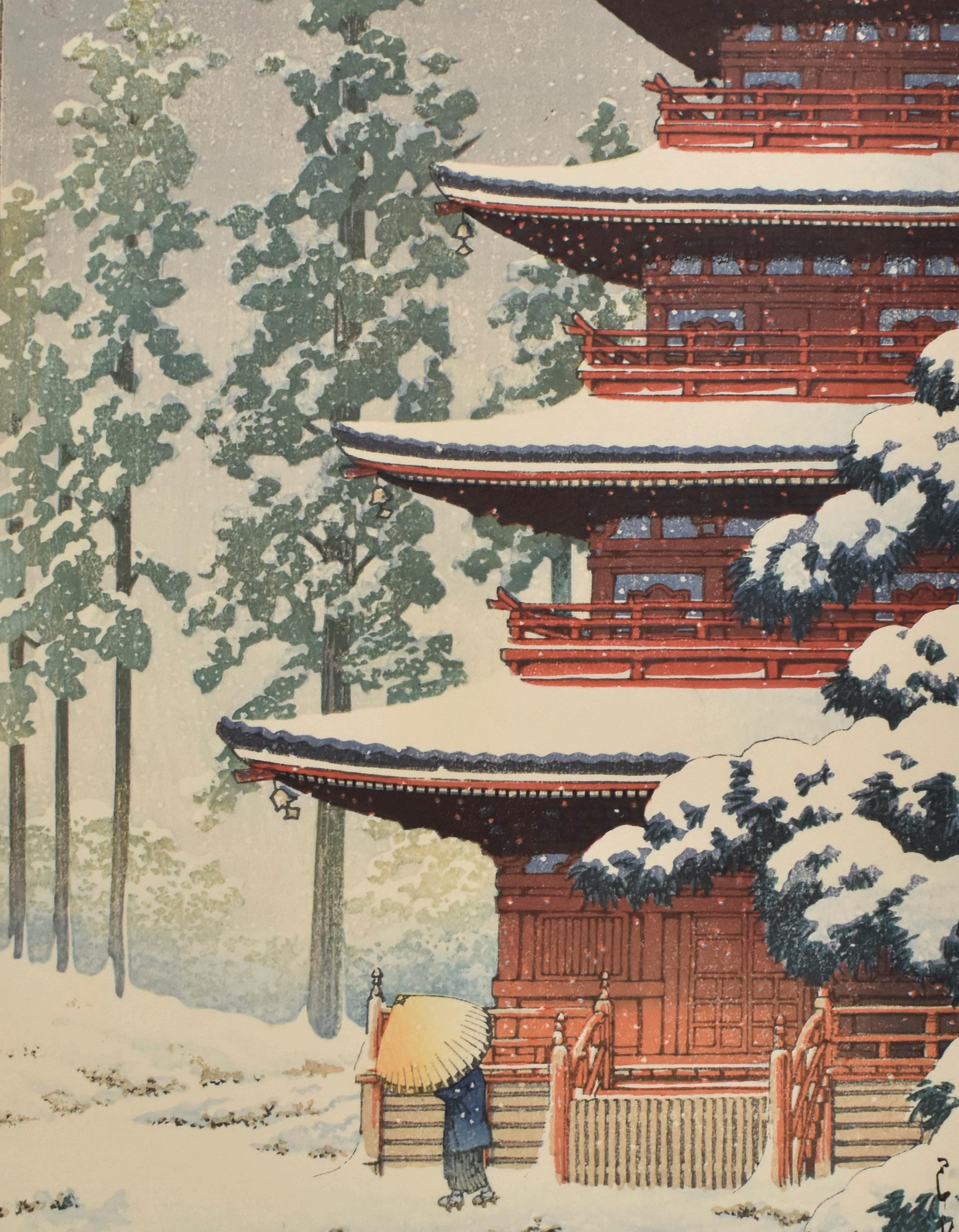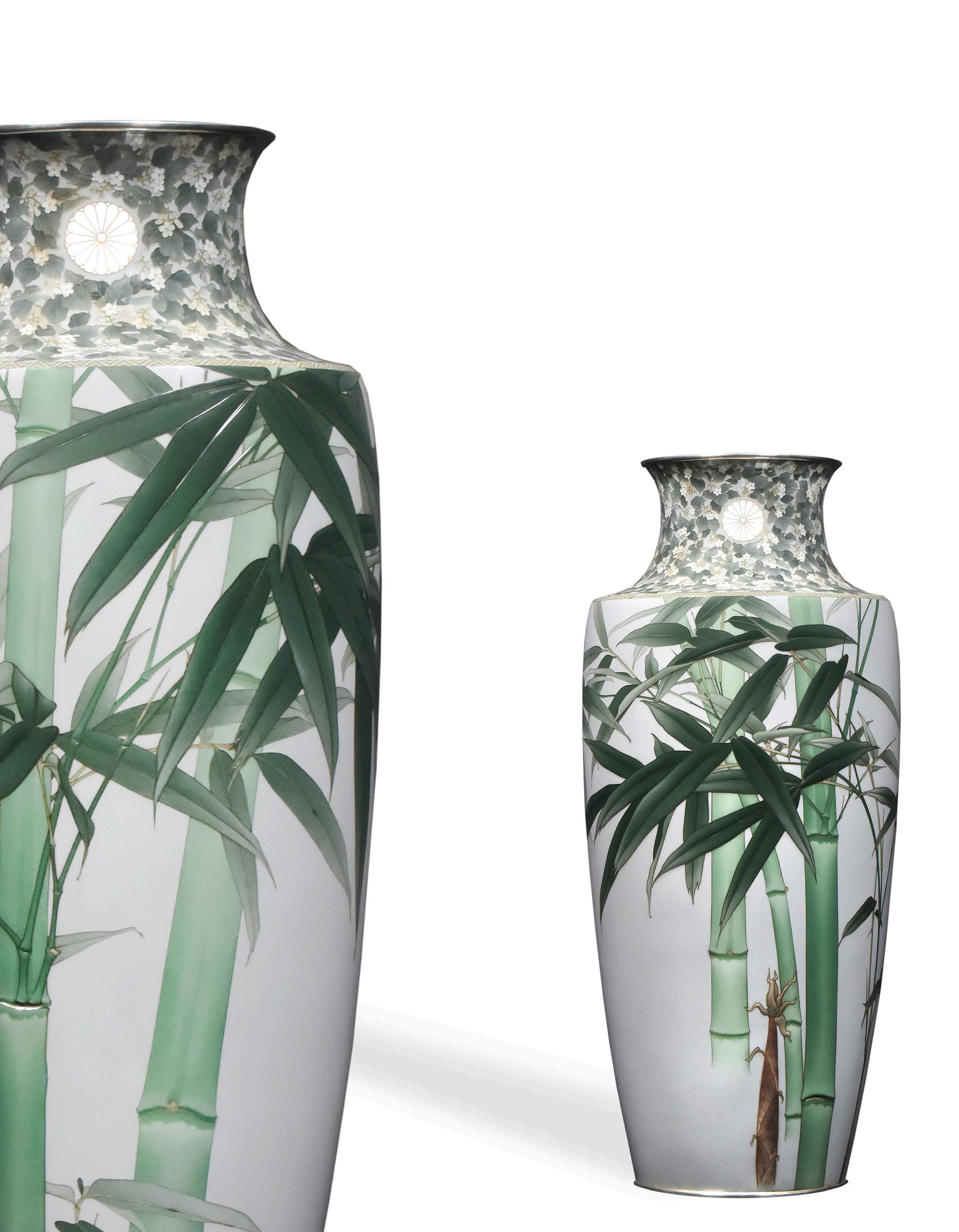
SATURDAY 6TH DECEMBER 2025 AT 11.00AM GMT in partnership with Suzannah Yip SATURDAY 6TH DECEMBER 2025 AT 11.00 AM GMT



SATURDAY 6TH DECEMBER 2025 AT 11.00AM GMT in partnership with Suzannah Yip SATURDAY 6TH DECEMBER 2025 AT 11.00 AM GMT

WEDNESDAY 6TH JULY 2022 AT 10.30 AM
LIVE AUCTION
249 - 253 Long Lane, Bermondsey, London, SE1 4PR

SATURDAY 6TH DECEMBER 2025 AT 11.00 AM GMT
ONLINE, TELEPHONE & COMMISSION BIDDING ONLY
To include:
The collection of Lt. Col. George Douglas Gray, OBE, MD RAMC (1872 - 1946), lots 1 - 62
Viewing by appointment only
The collection of Augustus Thorne (1825 - 1901), lots 66 - 71
Please contact info@alastairgibsonauctions.com to arrange directly
Registration closes at 12 noon on Friday 5th December
The Xianfeng Emperor’s (1850 - 1861) silver ‘hunting’ flask, lot 73
Selected pieces of lacquer from the Mike Healy collection, lots 76 - 78
Gerard Hawthorn Ltd, oriental art, lots 89 - 90
Snuff bottles and archers rings from the collection of H.G. Beasley (1881 - 1939), lots 106 - 139
Front cover: Lot 95

Inside Front Cover: Lot 230 (detail)
The Mujintang collection, Taipei, lots 172 - 222
Back cover: Lot 229
Inside Back Cover: Lot 232 (detail)
Viewing in London:
Monday 4th July 2022 10am - 5pm
Tuesday 5th July 2022 10am - 5pm
Registration closes at 12 noon on Tuesday 5th July 2022
www.alastairgibsonauctions.com
There will be no viewing on the morning of the sale www.alastairgibsonauctions.com
Tel: +44 (0)208 191 2 192
Tel: +44 7831 645468
Email: info@alastairgibsonauctions.com
Email: info@alastairgibsonauctions.com






If you wish to bid at this auction you will need to register online and provide two forms of identification;
1: Photographic identification – either a current passport or photographic driving licence
2: Proof of address – either a utility bill or official document showing your name and address
Please visit www.alastairgibsonauctions.com and complete the online registration form.
Identification can be provided to us in person or by email to info@alastairgibsonauctions.com
Please note: registering through thesaleroom.com does not automatically register you to bid with us.
You may be asked to pay a deposit and any deposit must be paid by bank transfer prior to the sale. Alastair Gibson Auctions must have cleared funds no later than 12 noon on the day before the sale. If you are not successful you will be refunded without interest within seven working days. Please note that refunds of payments made from non UK bank accounts may be subject to currency fluctuations.
Bank transfers should be sent to: Lloyds Bank, Week Street, Maidstone
Account name: Gibson Auctioneers
Sort Code: 30-95-37
Account: 73642760
BIC: LOYDGB21121
IBAN: GB68 LOYD 3095 3773 6427 60
Once registration is complete you will be provided with a paddle number.
Condition reports are available on request prior to the sale. Please note that the condition of lots is not stated in the catalogue descriptions. The absence of condition reports in the catalogue does not imply that the lot is free from imperfections or faults. All measurements given in the catalogue should be regarded as approximate.
Lots marked with a dagger (†) are subject to VAT on the hammer price. Lots marked with an omega (Ω) have been temporarily imported from outside the UK and are subject to VAT at a rate of 5% on the hammer price and the standard rate on the buyer’s premium
Lots marked λ will be subject to strict CITES regulations when being exported. Buyers should satisfy themselves prior to bidding that they are able to comply with these regulations before submitting any bids. For further information please visit https://www.gov.uk/guidance/ cites-imports-and-exports
Live online bidding is available via various online platforms. Additional commission on the hammer price will be payable for use of these live auction facilities. This charge will be added to your invoice automatically.
If you wish to bid by telephone please register online at www. alastairgibsonauctions.com before 12 noon on the day before the sale. Registrations for telephone bidding may not be accepted after this time.
If you are unable to bid online or by telephone you can leave a commission bid. This will be executed on your behalf by the auctioneer who will purchase the lot as cheaply as possible taking into account any reserve price and other bids. If you wish to leave a commission bid please register online at www.alastairgibsonauctions. com before 12 noon on the day before the sale. Commission bid requests may not be accepted after this time.
Bids on premium lots can be made by telephone bidding or commission bidding.
In order to bid on premium lots, you will be required to complete a premium lot registration form and pay a deposit which must be made by bank transfer. This form must be completed and the deposit received before 12 noon the day before the auction.
The buyer shall pay the hammer price together with a premium of 25% plus VAT @ 20% (totalling 30% inclusive) on the first £500,000 and 12% plus VAT @ 20% (14.4% inclusive) thereafter.
Payment is due immediately after the auction and must be paid in pounds sterling.
Payments can be made by bank transfer or cash. We are unable to accept card payments.
Please note we can only accept cash payments up to a sterling equivalent of 10,000 euros and upon receipt of photographic identification and proof of address.
We cannot accept cash payments without proof of identification
Funds must be cleared in full before purchases can be released.
Bank transfers should be sent to:
Lloyds Bank, Week Street, Maidstone
Account name: Gibson Auctioneers Sort Code: 30-95-37
Account: 73642760
BIC: LOYDGB21121
IBAN: GB68 LOYD 3095 3773 6427 60
Please be aware that all lots are removed from the auction venue immediately after the sale by our nominated shipper.
Full information regarding collection and shipping will be provided with your purchase invoice.
We reserve the right to add storage charges to all lots not collected or shipped within 30 calendar days of the sale. This will include a handling fee of £25 (plus vat) per invoice and a storage charge of £5 (plus vat) per lot per day. No goods will be released until these charges have been paid.
If you intend to export your property, import taxes, customs duties and other fees may apply at the country of destination. It is your responsibility to ensure that your shipment can be lawfully imported to the destination country. All fees relating to this are the responsibility of the buyer.
In order to qualify for a VAT refund, your lots must be exported by a shipping agent and valid export documentation must be provided prior to the VAT refund being applied.
Please note that due to the withdrawal of the Retail Export Scheme by HMRC, we are unable to provide VAT refund documentation (C88) for hand-carried exports.
拍賣須知
登記競投
由於“洗錢條例”的實施,買家需登記及提供兩種形式的身份證明 以參與競拍:
1:照片身份證明 當前護照或照片駕駛執照
2:地址證明 水電賬單或具有您姓名和住址的官方文件 同時您也可以在線下參觀拍賣預展期間親自報名,也可以致電 +44(0)7831 645468或發送電子郵件至 info@alastairgibsonauctions.com與辦事處聯系 登記時您需要出示您的身份證明,護照您也可以將文件的副本 通過電子郵件發送到辦公室 請註意:通過thesalroom.com註冊或通過我們的網站不會自動 註冊您在本場拍賣的競買資格 您可能會被要求支付競買保證金,任何保證金必須在出售前通過 借記卡/信用卡或銀行轉賬支付.Alastair Gibson拍賣公司( Alastair Gibson Auctions)將於7月5日中午12點前清算資金 如 果您沒有成功出價購買到拍品,我方將於7個工作日內將保證金 原數退還給您 請註意,從非英國銀行賬戶付款的退款可能受貨 幣波動的影響。 在線競拍者可能需要支付5000英鎊的保證金, 該款項允許在線競拍者於本次拍賣總計競拍至5萬英鎊 任何匯款應轉賬到以下銀行賬戶:
thesaleroom.com
銀行地址:Lloyds Bank, Week Street, Maidstone 賬戶名Account name : Gibson Auctioneers Sort Code:3095-37
賬戶Account: 73642760
BIC: LOYDGB21121
IBAN: GB68 LOYD 3095 3773 6427 60 在您註冊完成後您將授予競投號牌
拍品情況報告
請註意,拍品目錄中不包括拍品狀態報告 在競拍前,買家可自行
請求獲取並瀏覽拍品狀態報告 拍品目錄中沒有包括狀態報告並 不意味著拍品在真偽、品質或權利當面沒有缺陷.目錄中給出的 所有測量都應視為近似
瀕危物種的規定
請註意,如果需要從英國出口本次拍賣中的部分拍品,部分批次 在出口時將涉及《瀕危野生動植物種國際貿易公約》 (CITES) 的嚴格規定 如果可以實施,買家應在投標前確定自己能夠遵守 這些規定,然後提交投標 欲了解更多信息,請訪問 https://www.gov.uk/guidance/cites-imports-and- exports
現場競拍
如果您想要於現場競拍,您需要從我方獲得一個競買號牌 競買號 牌可以在參觀線下預展期間或在拍賣當天從辦公室獲得 電話競拍
如果您希望通過電話競拍,請於7月5日中午12點之前通過電郵聯 繫我們:info@alastairgibsonauctions.com,此後的,電話投標 將不予接受
委托競拍
如果您不能參加拍賣會,您可以留下一個傭金委托授權代理人參 加拍賣活動代為競買 以您的名義,拍賣官將考慮到保留價和其 他報價,並以盡可能低的價格競買該批拍品 在線直播競拍 在線競拍可以通過thesaleroom.com網站和51bidlive.com進行 ,額外的4.95% 的傭金加上增值稅(共5.94%)的落槌價應支付給 使用現場拍賣設施的Saleroom (ATG媒體).這筆費用將自動添加 到您的發票上
買家酬金
買方應支付落槌價以及酬金 落槌價為五十萬英鎊以下時,費率為 落槌價的25%,加上20%的增值稅(共30%).落槌價為五十萬英 鎊以上,前五十萬英鎊的費率不變,之後的價格為 12%加上20% 的增值稅(共14.4%)作為酬金
拍品符號
標有匕首符號(+)的拍品需繳納增值稅.標有歐米加符號(=)的拍 品臨時進口於英國以外地區,需額外支付按成交價和賣家酬金的 5%繳納增值稅 銷售結果
這些將在出售後不久張貼在我們的網站上
拍品交付
成功競拍後需即刻以英鎊付款 資金須於我方將拍品交與您或您 指定的托運人前結清
付款方式接受現金 借記卡/信用卡或銀行轉賬
請註意,我方只能接受最高等同於10000歐元的英鎊現金 若持卡 人不在場,我方不能接受超過1000英鎊的信用卡付款
任何匯款應轉賬到以下銀行賬戶:
Lloyds Bank, Week Street, Maidstone
Account name : Gibson Auctioneers
Sort Code:30-95-37
Account :73642760
BIC: LOYDGB21121
IBAN: GB68 LOYD 3095 3773 6427 60
包裝和運輸
Alastair Gibson拍賣行可以提供全球航運報價與指定托運公司 請註意,我方不承擔運輸過程中任何損壞或丟失的費用 如果拍品在銷售後三十天未被收集,我方保留收取對於每件拍品 相關儲存費用的權利 這將包括每張發票25英鎊(加增值稅)的手 續費和每天每件拍品5英鎊(加增值稅)的倉儲費 在支付這些費 用之前,拍品不會被放行 從英國出口您的拍品 如果您打算從英國出口您的拍品,您也許需要支付目的地國家相 關進口稅,關稅和其他費用.您有責任確保您的貨物可以合法地進 口到目的地國家 與此相關的所有費用均由買方負責 請註意,由於英國稅務海關總署撤銷零售出口計劃,我方無法提 供手提出口的增值稅退稅文件(C88).為了符合退稅條件 ,您的拍 品必須由托運公司出口,並須提供有效的出口文件 部分拍品在出口時可能受《瀕危野生動植物種國際貿易公約》 規定的約束,關於《瀕危野生動植物種國際貿易公約》的詳情請 見:https://www.gov.uk/guidance/cites-imports-and- exports
**注:本須知如有任何詮釋上的問題,一概以英文版本為準。
JOMON period
ca.10,000BC - ca.300BC
YAYOI period ca.300BC - ca.300AD
KOFUN period ca.300 - ca.593
ASUKA period ca.593 - 710
NARA period 710 - 794
HEIAN period 794 - 1185
KAMAKURA period 1185 - 1333
MUROMACHI period 1333 - 1573
NANBOKUCHO period 1336 - 1392
MOMOYAMA period 1573 - 1615
BUNROKU era 1592 - 1596
KEICHO era 1596 - 1615
EDO period 1615 - 1868
KAN’EI era 1624 - 1644
KANBUN era 1661 - 1673
GENROKU era 1688 - 1704
AN’EI era 1772 - 1781
TENMEI era 1781 - 1789
KANSEI era 1789 - 1801
KYOWA era 1801 - 1804
BUNKA era 1804 - 1818
BUNSEI era 1818 - 1830
TENPO era 1830 - 1844
KOKA era 1844 - 1848
KAEI era 1848 - 1854
ANSEI era 1854 - 1860
MAN’EN era 1860 - 1861
BUNKYU era 1861 - 1864
GENJI era 1864 - 1865
KEIO era 1865 - 1868
MEIJI era 1868 - 1912
TAISHO era 1912- 1926
SHOWA era 1926 - 1989
HEISEI era 1989 - 2019
REIWA era 2019 - present

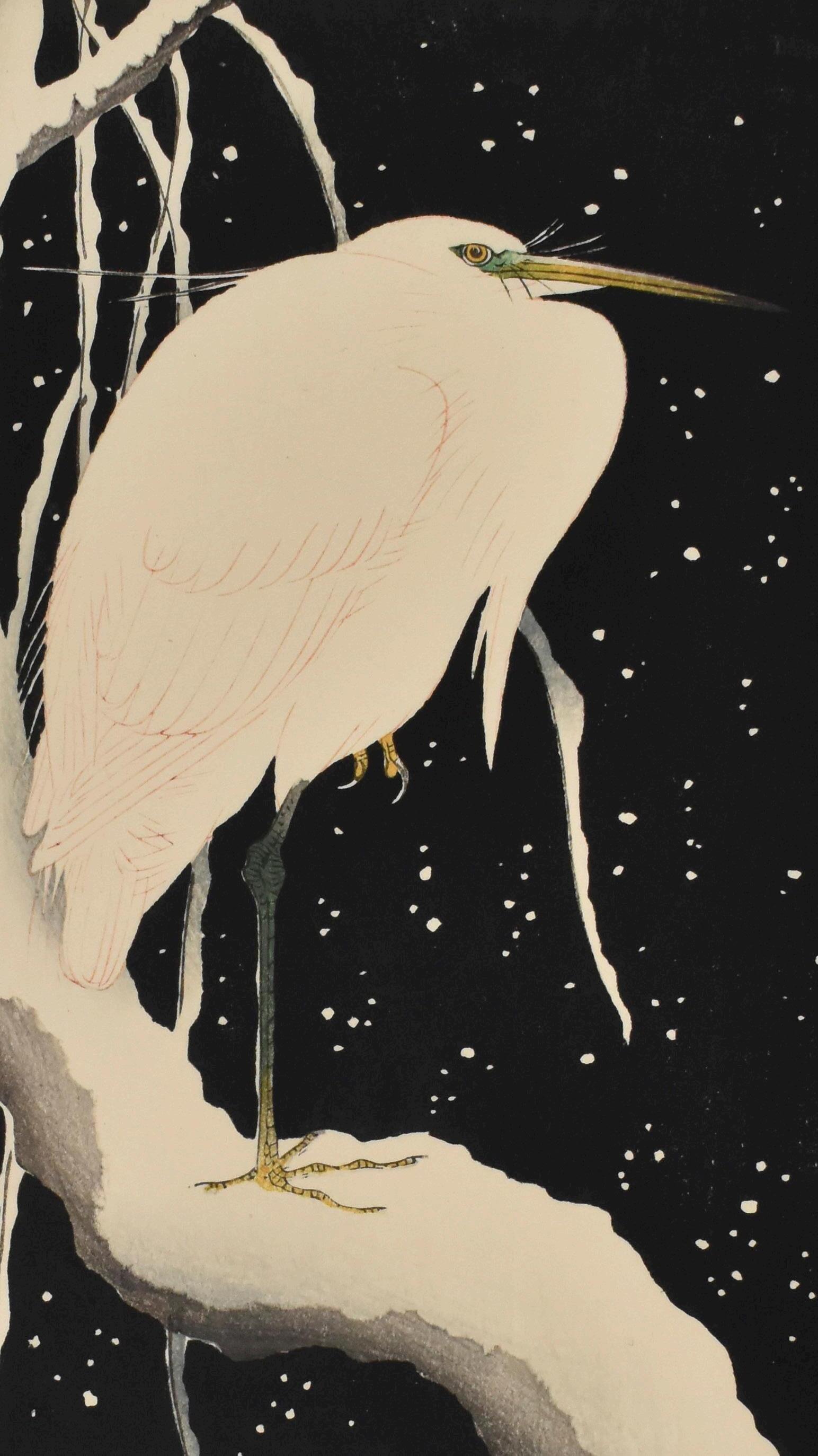
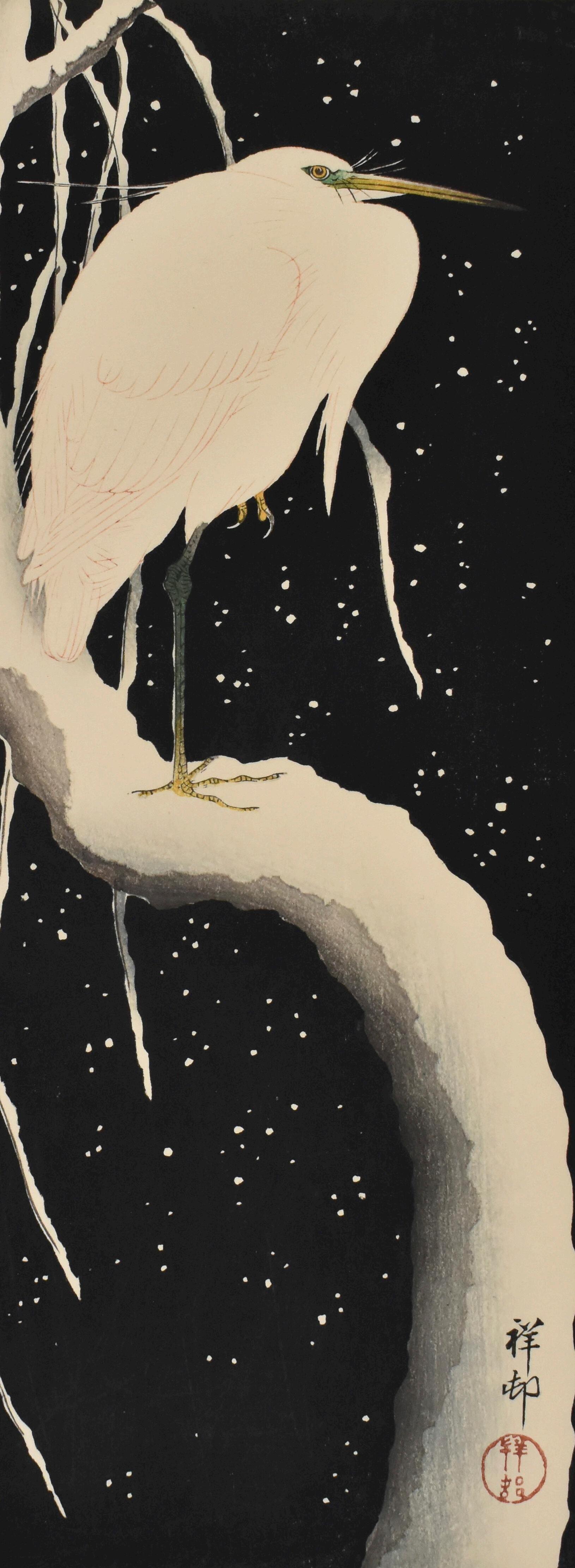
I am delighted to present my inaugural auction of Fine Japanese Art, held in partnership with Alastair Gibson Auctions. This milestone marks a significant moment in my career and would not have been possible without the trust and support of clients across three continents, whose remarkable collections I have the honour and privilege to advise, represent, and sell.
Our sale begins with English and Japanese private collections of netsuke and inro. These miniature toggles and portable interlocking medicine or seal boxes, often finely lacquered, were traditionally worn suspended from the obi sash— principally by the male inhabitants of the cities of Osaka, Kyoto, and Edo (present-day Tokyo). During the eighteenth century, Edo was quite possibly the most populous city in the world, with more than a million inhabitants.
The makers of inro catered to a wealthy and sophisticated urban clientèle who demanded not only superb execution of techniques but also an endless variety of styles and subjects. This is exemplified by the inro masterpieces once owned by the legendary American collector Charles A. Greenfield (1903–1997), celebrated for his keen connoisseurial eye and discerning taste. Lots 54, 57 and 58 demonstrate a distinct technique and exquisite design, and each come with a traceable ownership pedigree that has been documented, published and first exhibited at the Japan House Gallery, New York in 1972!
We are thrilled to present a wonderful selection of netsuke in this sale—tiny, masterful sculptures, memorably described by Edmund de Waal as “small, tough explosions of exactitude”. Several of the pieces were acquired in London during the 1920s by the mother of the current owners. Among the highlights of this diverse group is a powerfully rendered sabre-toothed tiger attributed to Naito Toyomasa (lot 13), two slumbering, inebriated Shojo (lots 43 and 45) a pair of contrasting intricate and expressive carvings of the wicked witch Kiyohime (lots 41 and 44), a deliciously-sculpted rotten nashi pear (lot 10), a pyramid of tumbling rats, mischievous demons and monkeys (lots 17, 29, 34, 38 and 40) as well as entwined snakes, frogs and slugs alluding to the folkloric symbolism of the San Sukumi (lot 9). Each netsuke bursts with personality and possesses an immediate visual appeal that cannot fail to elicit an instinctive and tactile response.
In much the same way that netsuke tell compelling stories through their carved subjects, the art of lacquer reveals another facet of japan’s aesthetic spirit: its deep-rooted culture of polishing, so fundamental to the medium of Japanese lacquer where the patient labour of the preparatory stages and the repeated application, and meticulous polishing of multiple layers of lacquer, contribute profoundly to a work’s visual impact. Artists often deliberately adopt a restrained exterior design to heighten the surprise of a more elaborate and dazzling decoration within (lot 79).
Japan’s enduring culture of polishing undoubtedly also played a part in the rapid development of the art of shippo (cloisonné-enamelling) in Japan from the mid nineteenth century onwards. Although Shippo benefited from the help of foreign experts such as the German chemist Gottfried Wagener (1831-1892), the dedicated pursuit of a brilliant, glass-like surface was surely inspired by the same aesthetic ideals found in lacquer—indeed, the same polishing materials were employed in both media. This lustrous perfection was certainly one of the aspects of shippo that captivated Rudyard Kipling when he visited the workshop of Namikawa Yasuyuki in 1889:
I saw a man who had only been a month over the polishing of one little vase five inches high. When I am in America he will be polishing still, and the rubycoloured dragon that romped on a field of lazuli, each tiny scale and whisker a separate compartment of enamel, will be growing more lovely.
(Rudyard Kipling, From Sea to Sea: Letters of Travel, Garden City, N. Y. Doubleday, Page & Company, 1912, pp.360-361).
Included among our selection of cloisonné-enamels is the star lot in this category and indeed the sale: an exceptionally fine pair of Imperial presentation vases by Hattori Tadasaburo (died 1939) of Nagoya (lot 95). Executed in the moriage (‘piled-up’) relief first shown in the fifth Domestic Industrial Exposition, held in Japan in 1903 in preparation for the Louisiana Purchase Exposition the following year, these vases exemplify Hattori’s incredible mastery of a demanding and complex process. To achieve the impressive moriage effect, the enamelled surface is meticulously built up over several firings, typically supported by concealed cloisons. The surface is then repeatedly polished and shaped to create the three-
dimensional modelling seen here: tall stalks of windswept bamboo rise in sculptural relief, rendered in subtle, contrasting tones of green, that demonstrates Hattori’s sophisticated command of nuanced, blended colour. In these works, the artist has elevated a humble natural motif into an object of extraordinary elegance and technical brilliance.
More unusually, the sale also features two deep-bowled earthenware vessels crafted by the people of Japan’s ancient Jomon culture—widely regarded as the world’s oldest continuous culture. During the Middle Jomon period, around 5000–4000 years ago, earthenware of astounding creativity and design flourished, most notably the kaengata (‘flamestyle’) vessels (lots 90 and 91). The artist and art theorist Okamoto Taro (1911-1996) once asserted that Jomon design represented “the true, original Japan,” celebrating its untamed beauty. Half a century later, contemporary artists such as Okazaki Ryunosuke (born 1995) whose Dress series JOMONJOMON—inspired by the spiritual dialogue with nature embodied in Jomon pottery and figurines— was recently exhibited at the Nakanoshima Museum of Art, Osaka, and at the Victoria and Albert Museum, London, continue to produce flamboyant works that pay homage to Japan’s earliest aesthetic tradition.
Among the highlights in the sale is also a remarkable group of four rare, early and museum-quality Gigaku masks (lots 86, 87, 88 and 89), two carved from camphor wood or paulownia, and two in dry lacquer, each evidently used in performance and evocative of a bygone era. Apart from the Karura (Garuda) mask—documented and illustrated in a respected Japanese art journal, we have exercised caution in assigning precise dates. Nevertheless, each mask displays affinities with surviving examples preserved at the Shosoin Repository and at Todaiji Temple, Nara.
No Japanese art sale in the West would be complete without decorative metalwork, and we are pleased to present two private collections—from Europe and from London. Until the middle of the nineteeth century most Japanese decoration on metal was on a miniature scale, confined to the fittings of the samurai sword, door-pulls, and other small-scale items. It is therefore all the more extraordinary that Japan’s metalworkers so rapidly developed the design strategies required to make large objects for foreign exhibition and consumption. Included in the sale is a wide range of bronzes,
monumental and miniature comprising figures, birds and animals from familiar makers such as Genruysai Seiya (lots 137, 143, 145) and Miyao Eisuke (lots 153, 154 and 155). Less well known is perhaps Asakura Fumio (lots 147 and 165) while examples of irogane (coloured metal) patination with elaborate takazogan (raised inlays) are represented by Miyabe Atsuyoshi (lot 158).
Last but not least, I am especially proud to have been entrusted with the sale of rare and early edition designs including an exceptionally rare pre-earthquake print (lot 230) by Kawase Hasui—one of the towering figures of Japan’s shin-hanga (‘new prints’) movement. Modern in aesthetic yet timeless in spirit, Hasui’s woodblock prints continue to resonate with contemporary audiences. From poetic renditions of dusk (lots 198, 201 and 236) and moonlight (lots 198 and 240) , snow blizzards (lots 196, 232, 235 and 244) to sudden rainfall (lots 199 and 200), the splendour of a season or the fleeting beauty of a moment (lot 229), his images— serene in mood and flawless in composition guide the viewer through Japan with intimacy and sensibility. These works come from three distinguished provenances: directly from the artist’s descendants, a Japanese private collection, and from the Estate of Sylvia Platt (1936-2024).
Sylvia Platt’s parents, Alice Carol Coates (1906–1992) and Eugene Haanel Cassidy (1903–1980), were both born in Tokyo to missionary families. During their years in Japan, they developed a profound and lasting appreciation for its art and culture, acquiring these prints in the 1930s before returning to Canada in 1938. The family’s enduring connection with Japan is further reflected in their later generosity: following Sylvia Platt’s death in 2024, additional Japanese artworks from the collection were bequeathed to the Pitt Rivers Museum, Oxford. Proceeds from the sale of the Sylvia Platt prints will benefit St Antony’s College, Oxford.
Suzannah Yip London, November 2025
このたび、アラステア·ギブソン·オークションズとの提携 による、初めての日本美術オークションを開催できる 運びとなりましたことを、心より光栄に存じます。本オー クションの開催は、私のキャリアにおける重要な転機で あり、世界に広がるお客様のご信頼とご支援の賜物で ございます。皆様の素晴らしいコレクションに関わらせ ていただき、アドバイス·代理·販売の機会を賜りました ことは、私にとってこの上ない名誉であり、深く感謝申 し上げます。
今回のオークションは、英国および日本の個人コレク ションによる根付と印籠から幕を開けます。これらの小 さな留め具や携帯用の薬箱·印鑑箱は、繊細な漆塗り が施されることが多く、伝統的に帯から下げて身につ けられていました。主に大阪、京都、そして江戸 (現在の東京)といった都市部の男性たちが愛用して おり、18世紀当時、江戸は人口100万人を超える世界 有数の大都市として繁栄していました。
印籠の製作に携わった名工たちは、卓越した技術を 極めるだけでなく、都市の富裕かつ洗練された趣味人 たちの多様な嗜好に応えるべく、無限ともいえる作風 と題材の展開を追求しました。その典型が、アメリカの 伝説的コレクターであり比類なき審美眼を備えたチャ ールズ·A·グリーンフィールド(1903–1997)の旧蔵品 に見られる作品群です(ロット 54 、57 、58)。いずれ の作品も独自の技法と優美な意匠を備え、記録や出 版物に明確な来歴が示されており、1972年にはニュ ーヨークのジャパン·ハウス·ギャラリーで初めて公開さ れたことでも知られています。
本オークションにおきまして、素晴らしい根付の数々を ご紹介できることを大変光栄に思っております。これら は、エドマンド·ド·ワールが「小さくも力強い精緻さの爆 発」と称したように、まさに小宇宙のような傑作彫刻で す。出品作品の中には、現所有者の母君が1920年代 にロンドンで収集された作品も含まれております。この 多彩なコレクションの見どころには、内藤豊昌作とされ る剣歯を備えた力強い虎(ロット13)、酔い潰れて眠る 猩々2点(ロット43、45)、精緻な技巧と豊かな表情の 対比が際立つ邪悪な鬼女·清姫2点(ロット41、44)、美 味を誘うように彫り上げられた腐りかけの梨(ロット10) 、豆の上に群がる鼠の家族、いたずら心あふれる鬼や猿 (ロット 17 、29 、34 、38 、40)、そして三
すくみの民俗的象徴を思わせる、絡み合う蛇·蛙·蛞蝓 (ロット9)などが挙げられます。いずれの根付も独自
の個性に満ち、見る者に直感的で触覚的な共感を呼 び起こさずにはいられません。
根付が彫刻された主題を通じて魅力的な物語を語る のと同様に、漆芸は日本の美的精神のもう一つの側面 を映し出しています。それはすなわち、日本の漆という 素材に根ざした磨き上げることの文化です。下地の準 備段階における忍耐強い労力と、漆の層を幾重にも重 ねて塗り、磨き上げる反復の作業が、作品の視覚的イ ンパクトに深く寄与しています。作家たちはしばしば、 より精巧で眩いばかりの装飾を内側に秘めているとい う驚きを高めるために、あえて控えめな外装デザインを 採用します(ロット7 9参照)。
日本に深く根ざした磨きの文化は、19世紀半ば以降 に日本で急速に発展した七宝焼(七宝釉薬)の芸術 にも間違いなく貢献しております。 七宝はドイツ人化 学者ゴットフリート·ワーゲナー(1831-1892)ら外国人 の専門家の援助を得て発展したものの、輝きを放つ ガラスのような表面を追求する姿勢は、漆芸に見られ る美意識と確かに共通しており、実際、両工芸で同じ 研磨材が用いられていました。
この艶やかな完璧さ は、1889年に並河康之の工房を訪れたラドヤード·キッ プリングを魅了した七宝の特質の一つであります:
私は、高さ五インチほどの小さな花瓶を磨き始めてから、 まだ一か月しか経っていない男を見た。
私がアメリカに戻るころにも、彼はきっと磨き続けてい ることだろう。
そして、七宝の細やかな仕切りの中に無数の鱗と髭を 持ち、瑠璃色の空を舞うルビーの龍は、いっそう美しく 輝いているに違いない。
ラドヤード·キップリング 『 From Sea to Sea: Letters of Travel 』
(ニューヨーク州ガーデンシティ:Doubleday, Page & Company, 1912年、pp.360–361)
今回の七宝焼コレクションの中でも、本カテゴリーを 代表するスターロットにして、ひいては本オークション の白眉となるのが、名古屋の服部唯三郎(1939年没) による帝室献上花瓶の極上の一対(ロット95)です。 1903年に開催された第5回国内産業博覧会(翌年の ルイジアナ購入博覧会に備えて開催)で初めて披露さ れた「盛り上げ」技法による浮き彫りで制作されたこれ らの花瓶は、困難で複雑な工程に対する服部氏の驚
異的な熟練の技を体現しています。この印象的な盛り 上げ効果を実現するため、釉薬を施した表面は通常 は数度にわたる焼成を経て、隠された仕切りの上に丹 念に盛り上げられます。その後、表面は繰り返し研磨 され、ここで見られるような立体的な造形が作り出され ます。風になびく竹のすらりと伸びた茎が、彫刻的なレ リーフとして立ち上がり、繊細で対照的な緑の色調で 表現されています。これは、服部がニュアンスのある混 色を洗練された手法で駆使していることを示していま す。これらの作品において、作家は、質素な自然のモ チーフを、並外れた優雅さと技術的な輝きを備えた作 品へと昇華させました。
さらに特筆すべきことに、今回のオークションでは、世 界最古の長期にわたって続いた文化の一つとして広く 認められている、日本の縄文時代に制作された深鉢形 土器2点も出品されております。約5000~4000年前の 縄文中期には、驚くべき創造性と独自の造形感覚を備 えた土器文化が花開き、とりわけ火焔型土器がその象 徴として知られています(ロット90 、91参照)。芸術家 であり美術理論家でもあった岡本太郎(1911–1996) は、この縄文のデザインに「真の、本来の日本」を見出 し、野性に満ちた生命の美を称賛しました。そして半 世紀を経た現代においても、岡﨑龍之祐(1995年生ま れ)のような現代作家が、縄文土器や人形に体現され た自然との精神的な対話に触発され、《ドレス》シリー ズ「JOMONJOMON」を制作しています。同シリーズは 大阪·中之島美術館やロンドンのヴィクトリア&アルバ ート博物館で発表されるなど、日本最古の美的伝統に 深い敬意を表しつつ、独自の造形表現を展開してい ます。
また、極めて稀少な初期の伎楽面で、博物館所蔵品 に匹敵する水準を備えた一群(ロット86、87、88、89) も出品されています。これらの面は、楠や桐から彫り出 されたもの、あるいは乾漆で制作されたものもあり、い ずれも明らかに演舞用に使われたもので、過ぎ去った 時代の趣を今に伝えています。権威ある日本の美術 雑誌に記録·図版掲載された迦楼羅(ガルーダ)面を 除き、正確な年代の特定には慎重を期しました。それ でも、各面には正倉院宝物館や奈良·東大寺に現存す る作例との共通性が認められます。
西洋における日本美術オークションにおいて、装飾金 工品は欠かせない存在であり、今回はヨーロッパおよ びロンドンの二つの個人コレクションをご紹介できるこ とを光栄に思っております。19世紀半ばまで、日本の 金属装飾の大部分はミニチュア規模に留まり、刀装具
や障子·襖の引手、その他の小品に限られていました。 そのため、日本の金工家たちが海外展示や輸出向け の大型作品制作に必要なデザイン戦略を急速に確立 したことは、特筆に値します。本オークションでは、源 龍斎誠谷(ロット137 、143 、145)や宮尾栄助(ロット 153 、154、155)といった馴染み深い金工家による、 人物·鳥·動物を題材とした大型·小型のブロンズ作品を 幅広く取り揃えております。あまり知られていない作家 ですが、朝倉文夫(ロット147 、165)の作品も出品され ておりますし、また、精巧な高象嵌を施した色金作品 の代表例としては、宮部篤良(ロット158)の際立った作 品もご覧いただけます。
最後に、日本の新版画運動を代表する巨匠·川瀬巴水 による、震災前の極めて稀な版画(ロット230)をはじめ とする希少な初期版画作品の販売を任されたことを、 特に誇りに思います。モダンな美意識を備えながらも、 その精神は時代を超越する巴水の木版画は、現代の 鑑賞者に今なお深く響き続けています。夕暮れ(ロッ ト198、201、236)、月明かり(ロット198 、240)、吹雪 (ロット196 、232 、235 、244)、突然の雨(ロット199 、200)といった詩的な表現から、季節の壮麗さや一瞬 の儚い美しさ(ロット229)まで、その作品は穏やかな雰 囲気と完璧な構図で観る者を日本へと誘い、永続的な 親密さと静かな感性を伝えます。これらの作品は二つ の由緒ある来歴を持ちます。ひとつは作家の親族 からの直接提供、もうひとつはシルヴィア・プラット氏 (1936–2024)の遺品コレクションからの出品です。
来歴:シルヴィア·プラット·コレクション シルヴィア・プラット氏の両親、アリス·キャロル·コーツ (1906–1992)とユージン·ハーネル·キャシディ(1903–1980)は、いずれも宣教師の家庭に東京で生まれまし た。日本在住中、彼らは日本の芸術と文化に対する深 い理解を育み、1938年にカナダへ帰国する前の1930 年代にこれらの版画を蒐集しました。この家族と日本と の長年にわたる結びつきは、その後の寛大な寄付にも 表れています。2024年にシルヴィア・プラット氏が逝去し た後、コレクションの一部はオックスフォードのピット·リ バース博物館に遺贈されました。 さらに、シルヴィア・ プッラト版画コレクションの売却益は、オックス フォード大学セント·アントニーズ·カレッジに寄付される 予定です。
スザンナ·イップ 2025年11月 ロンドンにて
1
A WOOD NETSUKE OF A RAT CLAMBERING OVER SIX CHESTNUTS
EDO PERIOD (1615-1868), 19TH CENTURY
The rodent seated, leaning forward, its body twisted slightly to the left with its tail trailing around in front, its front paws resting over two of the six chestnuts, the rat’s eyes inlaid in dark horn, signed on the base with an indecipherable signature on an oval reserve
2.5cm x 4cm
£1,000-1,500
2
A WOOD NETSUKE OF A PUPPY
EDO PERIOD (1615-1868), EARLY/MID 19TH CENTURY
Seated, its head slightly raised, scratching its cheek with its left hind paw, its eyes inlaid in dark horn; unsigned
2.7cm x 3.2cm
£1,000-1,500
3 MASANAO OF YAMADA, ISE PROVINCE A WOOD NETSUKE OF TWO FROGS
EDO PERIOD (1615-1868), MID-19TH CENTURY
Carved as a young frog clambering over its parent’s back, the adult’s eyes inlaid in dark horn, signed on the base of the larger frog Masanao
3.5cm high
£1,000-1,500
4
A WOOD NETSUKE OF A RECUMBENT HORSE,
EDO PERIOD (1615-1868), LATE 18TH/EARLY 19TH CENTURY
Shown reclined with its head raised and turned to the left, its legs drawn in for compactness, its tail lashing forward around the right flank, its eyes inlaid in pale amber with black pupils; unsigned
3.3cm x 4.7cm
£4,000-5,000
5
KOKEI, KUWANA, ISE PROVINCE A WOOD NETSUKE OF A TANUKI (RACCOON DOG)
DO PERIOD (1615-1868), EARLY 19TH CENTURY
Seated in a typical manner, its head raised with mouth open, drumming its stomach, its eyes inlaid in dark horn, its right paw held aloft, signed on the base Kokei
3.2cm x 3cm
£1,000-1,500
6
A WOOD NETSUKE OF A RECUMBENT RAT
EDO PERIOD (1615-1868), EARLY/MID-19TH CENTURY
Recumbent, its body curled to the right and its head lowered gripping its long tail, trailing beneath, forming a compact composition in slightly worn and well-toned wood, the large eyes inlaid in dark horn; unsigned 4.2cm wide
£1,500-2,000
7
A STAG-ANTLER NETSUKE OF A MONKEY
MEIJI ERA (1868-1912), LATE 19TH/EARLY 20TH CENTURY
Seated, its head turned to the left, holding protectively a leafy branch of peach in both hands, its eyes inlaid in dark horn; unsigned
3.2cm high
£600-800
8
MASATSUGU
A WOOD NETSUKE OF A TANUKI (RACCOON DOG)
EDO PERIOD (1615-1868), EARLY/MID-19TH CENTURY
The raccoon dog seated, dressed in a short jacket, laughing, drumming its corpulent belly with one paw and the other raised over its head, its pupils of dark horn; the underside signed Masatsugu
3.5cm high
£1,000-1,500

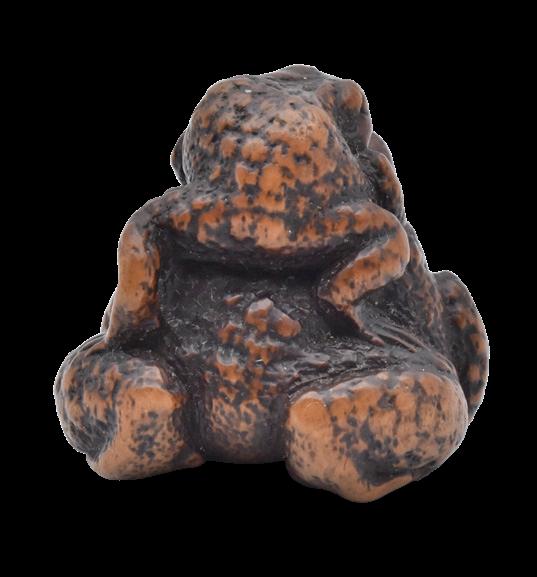

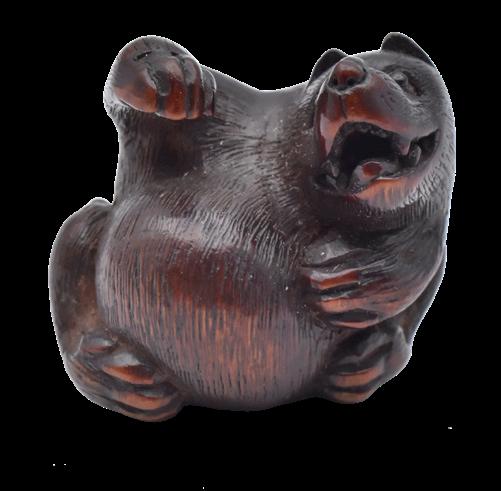



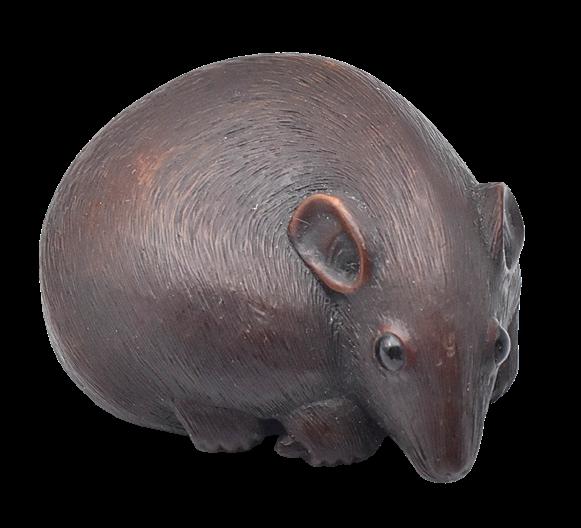


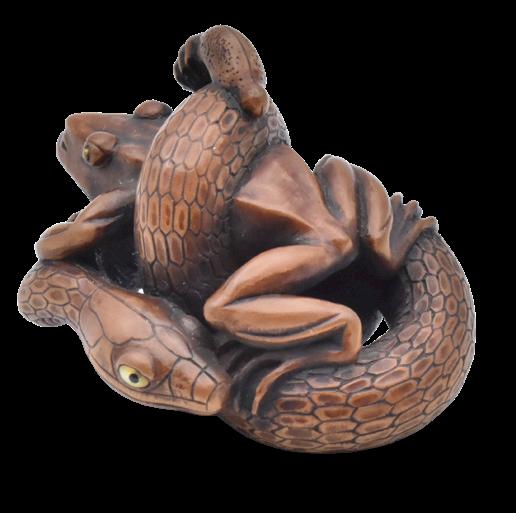
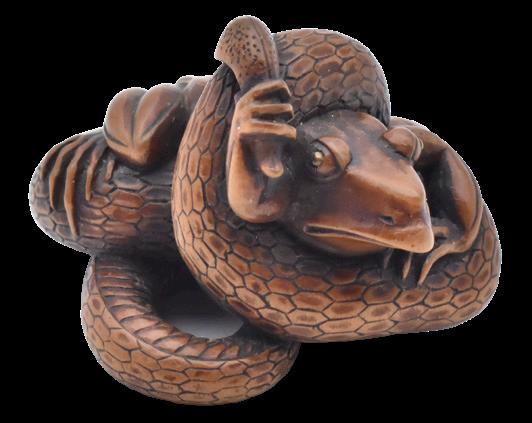
A WOOD NETSUKE OF THE SAN SUKUMI (THE THREE CREEPY THINGS)
EDO PERIOD (1615-1868), 19TH CENTURY
The giant snake ambushing its prey by wrapping its long body tightly around the defenceless toad, the toad’s head peering out of a looped coil, struggling to free itself, one hand gripping a slug slithering up the snake’s coiled loop, the eyes of the snake doubleinlaid in pale horn with dark horn pupils, the frog’s eyes of gilt; signed on the underside Masakazu within an oval inlaid horn reserve 2cm x 4cm
£3,000-4,000


San Sukumi encapsulates a folkloric or symbolic representation of a triadic standoff involving three creatures: a frog, a snake, and a snail or slug—each simultaneously predator and prey within a closed ecological loop. The frog preys upon the snail, the snake preys upon the frog, yet the cycle is complicated by a biological consequence: the snail’s toxic secretions, once ingested by the frog, render the frog fatally poisonous to the snake
SANGETSU OF NAGOYA
A WOOD NETSUKE OF A WASP INSIDE A ROTTEN NASHI PEAR
EDO PERIOD (1615-1868), MID-19TH CENTURY
The wasp carved in high relief and deeply undercut within a large gnawed cavity on the front of the fruit, the skin of the fruit carved all over with ukibori pimples; the eyes of the wasp in dark horn, the himotoshi formed by the natural rotting flesh of the pear on the reverse; signed on the reverse in a raised oval reserve Sangetsu 5.1cm high
£5,000-6,000
For a discussion on the ‘Wasp Carvers’, see Raymond Bushell, Collectors’ Netsuke, New York and Tokyo, 1971, Weatherhill, pp.8384 with similar examples by Sangetsu and Kogetsu illustrated on p.101, figs.137 and 138. Other similar examples are illustrated by Neil K. Davey, Netsuke, a Comprehensive Study Based on the M. T. Hindson Collection, London, Sotheby Parke Bernet/Faber & Faber, 1974, p.208, no.634 (by Gekko); and George Lazarnick (ed.), The Meinertzhagen Card Index, New York, Alan R. Liss Inc., 1986, p.691
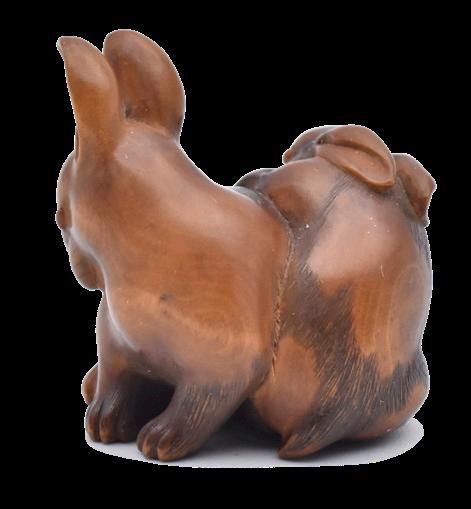
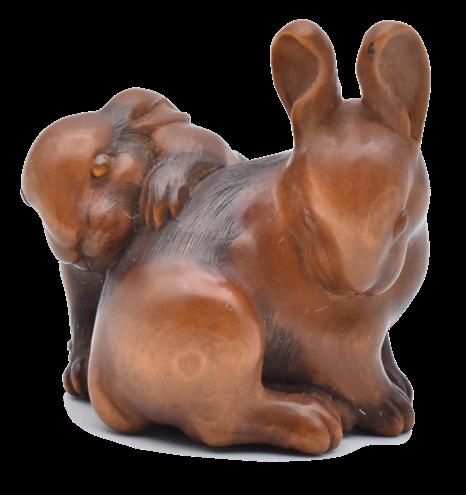
MASANAO OF YAMADA, ISE PROVINCE
A WOOD NETSUKE OF TWO PIEBALD RABBITS
EDO PERIOD (1615-1868), MID-19TH CENTURY
One rabbit seated with its ears raised in alert, its head lowered grooming itself, the other standing, nestled against its side, resting one forepaw on its partner’s back, the eyes inlaid in pale horn; signed on the underside on a polished reserve Masanao 3.7cm X 3.2cm
£4,000-5,000



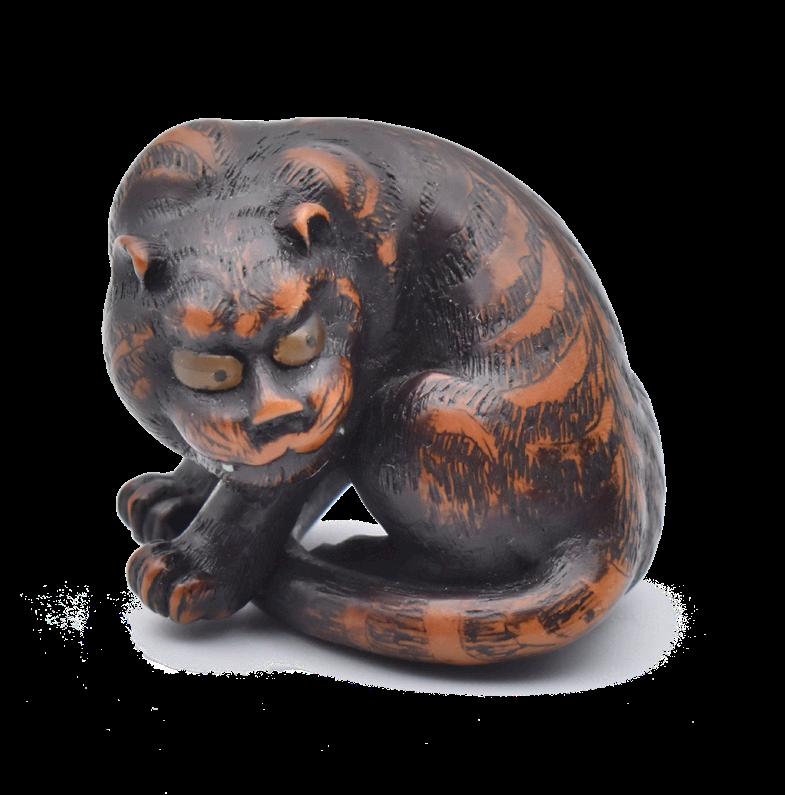
13
A WOOD NETSUKE OF AN OCTOPUS
EDO PERIOD (1615-1868), EARLY 19TH CENTURY
Resting with its tentacles rising up and curling around its large head, forming a compact composition, its eyes inlaid in dark horn, its tentacles detailed with intricately carved suckers; unsigned 4cm x 4.5cm
£2,000-3,000
£10,000-15,000 12
ATTRIBUTED TO NAITO TOYOMASA (1773-1856) OF TANBA
A WOOD NETSUKE OF A TIGER
EDO PERIOD (1615-1868), EARLY/MID 19TH CENTURY
The sabre-toothed tiger seated, turning left to look over its shoulder, its long tailed curled around and beneath its body, the tiger’s stripes finely detailed, its eyes inlaid in pale amber with black pupils; unsigned 3cm x 3.7cm
14
A LARGE WOOD NETSUKE OF A SHISHIMAI (LION DANCE) MASK
EDO PERIOD (1615-18168), 19TH CENTURY
The large shishi (Chinese mythical lion) head carved with a movable jaw and tight curls of a mane on the top, the himotoshi formed from the bar on the underside, the eyes inlaid in pale horn with black pupils; unsigned 4cm x 4.2cm
£1,200-1,500
15
RYUKEI
A LARGE WOOD OKIMONO (TABLE ORNAMENT) OF A MAN
MEIJI ERA (18168-1912), LATE 19TH/EARLY 20TH CENTURY
Seated on the ground, his head and face covered with a cloth tied around his neck, his knees bent attempting to rise beneath the weight of a large sackful of oni (demons) on his back, one demon visible on the reverse trying to break out, its eyes inlaid with ivory; signed on an inlaid ivory tablet Ryukei
5.2cm x 6.5cm
£1,500-2,000
16λ
A WOOD NETSUKE OF GAMA SENNIN
EDO PERIOD (1615-1868), LATE 18TH/EARLY 19TH CENTURY
Standing, his head slightly turned to the left, one hand clutching his exaggeratedly long rosary draped around the right side of his emaciated body and holding his toad companion climbing down his leg in the other, his long hair flowing down his back, the pouch of ivory, his eyes inlaid in pale amber; unsigned
11.5cm high
£1,500-2,000
17
HAMANO MASAYUKI (SHOZUI)
A WOOD NETSUKE OF AN ONI (DEMON
EDO PERIOD (1615-1868), EARLY/MID-19TH CENTURY)
The demon crouching beneath a large straw hat, holding a square box, attempting to hide from beans thrown during the Setsubun ceremony to exorcise demons, some beans landing on the hat; signed on the box Masayuki/Shozui
2.5cm x 4.3cm
£1,000-1,500
18
A WOOD NETSUKE OF A COOPER INSIDE A BARREL
EDO PERIOD (1615-1868) OR MEIJI ERA (1868-1912), MID/LATE 19TH CENTURY
The man naked save for a loin cloth, kneeling inside a large wooden inverted cistern, both hands gripping a tool, planing the wood intently; unsigned 4cm x 4cm
£1,000-1,500
19
A WOOD NETSUKE OF A SARUMAWASHI (MONKEY-TRAINER) AND MONKEY
EDO PERIOD (1615-1868), LATE 18TH/EARLY 19TH CENTURY
Standing with one one hand resting over his tall, conical basket carried across his chest, and the other holding a bamboo cane, his performing pet clambering playfully over his left shoulder; unsigned 7cm high
£800-1,000
20 KEISAI
A WOOD NETSUKE OF A FERRYBOAT
EDO PERIOD (1615-1868), 19TH CENTURY
The open boat poled by a kneeling boatman with five passengers on board, including a samurai, two Manzai dancers, one holding a fan, the other seated beside a drum, a sarumawashi (monkeytrainer) and his performing monkey and a female traveller wearing a straw hat; signed on the base of the boat Keisai
3.2cm X 5.8cm
£2,000-3,000
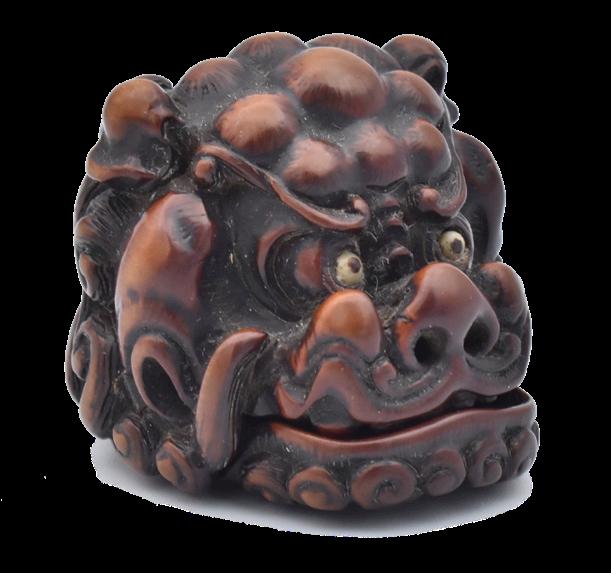


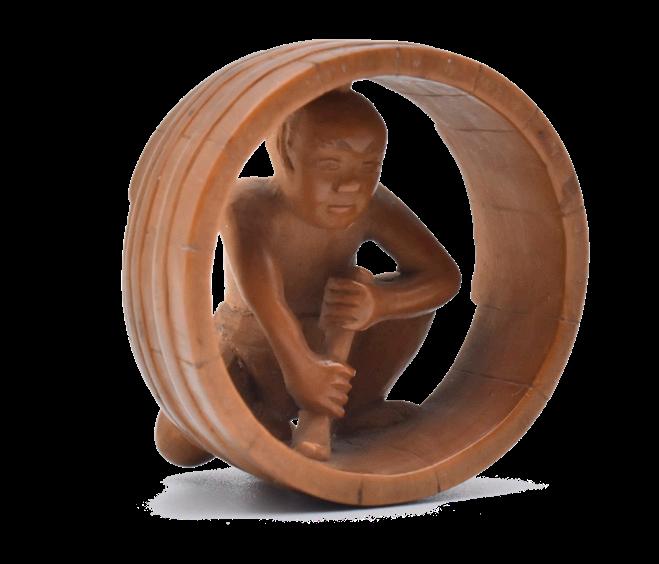

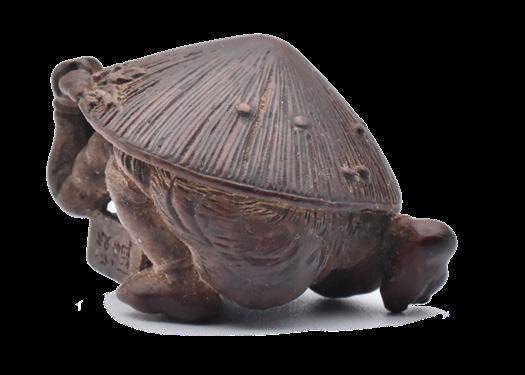
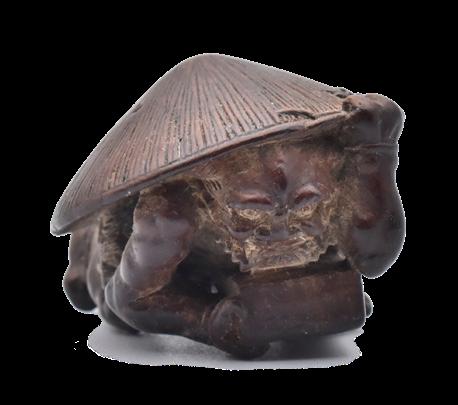
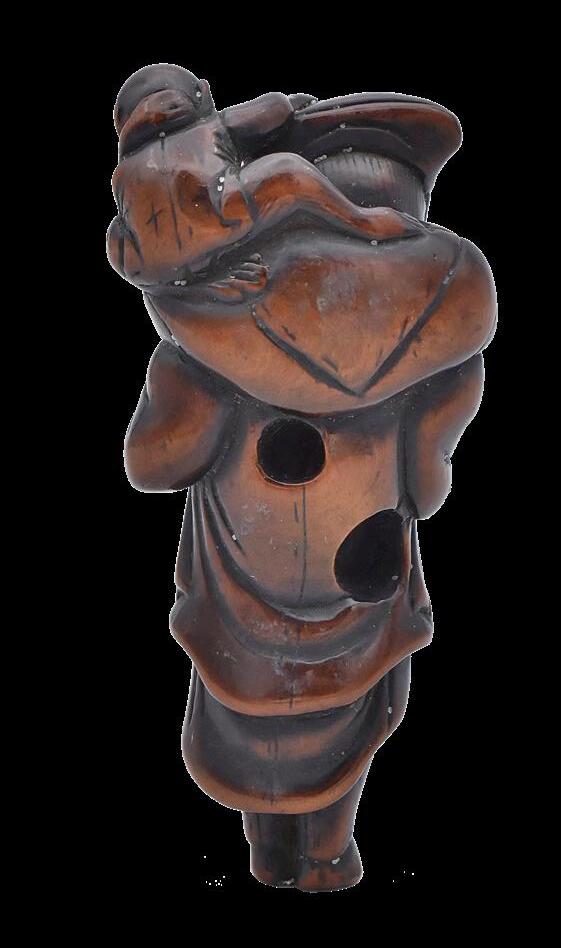


21
A WOOD NETSUKE OF REISHI FUNGI
EDO PERIOD (1615-1868), MID-19TH CENTURY
Finely carved as a bifurcated stalk of two sinuous stems of reishi fungi, forming a compact composition, the wood with a chocolatebrown patina polished to a rich sheen; unsigned
4.5cm high
£1,500-2000
22 λ
AFTER NAITO TOYOMASA OF TANBA
A WOOD AND IVORY NETSUKE OF A SLUG CRAWLING OVER A MUSHROOM
EDO PERIOD (1615-1868), EARLY/MID-19TH CENTURY
The inlaid ivory slug slithering over the head of a large mushroom, the thick stalk forming the himotoshi beneath, the slightly worn wood with a good patina; inscribed with signature Toyomasa
3.2cm x 4.1cm
£500-800
23Ω
A WOOD NETSUKE OF A TREE FROG ON A TARO LEAF
EDO PERIOD (1615-1868), 19TH CENTURY
The frog squatting with an alert expression at one end of a folded leaf, the textures of the smooth skin of the frog contrasting with the veining and details of the large leaf carved in low relief; the curved stalk forming the himotoshi, unsigned; with a wood storage box (2)
8.2cm wide
£800-1,000
24Ω
ISSAI
AN INLAID KAGAMIBUTA-STYLE NETSUKE
EDO PERIOD (1615-1868), 19TH CENTURY
The wood bowl fitted with a shibuichi plate applied in high relief of pewter and shell with three warabi (edible ferns), signed on the reverse Issai, with a wood storage box (2)
3.5cm diam.
£600-800
25Ω
A WOOD NETSUKE OF A LARGE LOTUS POD WITH MOVABLE SEEDS
EDO PERIOD (1615-1868), 19TH CENTURY
Naturalistically carved as a long lotus stalk trailing forward over the large pod fitted with several loose seeds within, the curling stalk forming the himotoshi, unsigned; with a wood storage box (2)
3.5cm x 3cm
£800-1,000
26Ω
MITSUSADA
A DARK WOOD NETSUKE REPRESENTING THE LEGEND OF THE PEARL DIVER PRINCESS TAMATORI AND THE DRAGON KING
EDO PERIOD (1615-1868), 19TH CENTURY
In the form of a conch shell enclosing within intricately carved Chinese-style architectural buildings of Ryujin, the Dragon King’s Palace, in the foreground the pearl diver Princess Tamatori being chased by the creatures of the Dragon King’s court including an octopus and a dragon, signed on the shell Mitsusada within a rectangular reserve; with a wood storage box (2)
2.5cm x 6.5cm
£3,000-4,000
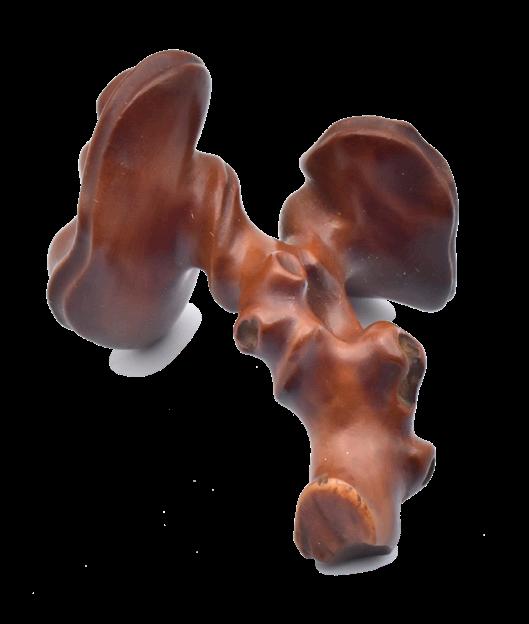
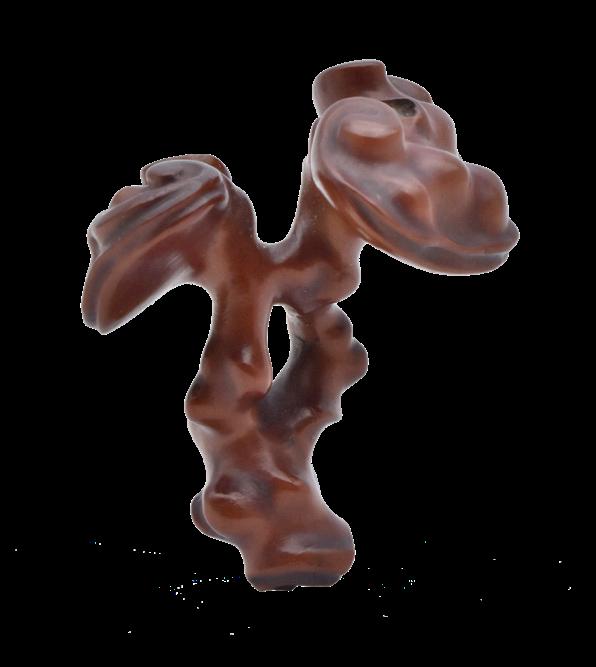
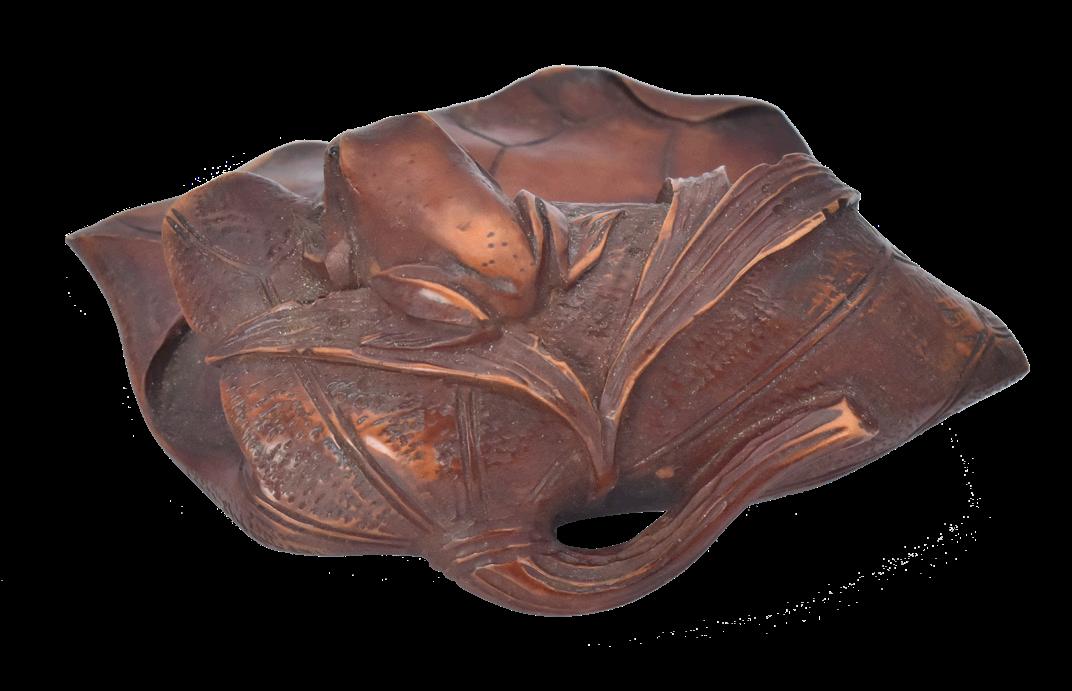
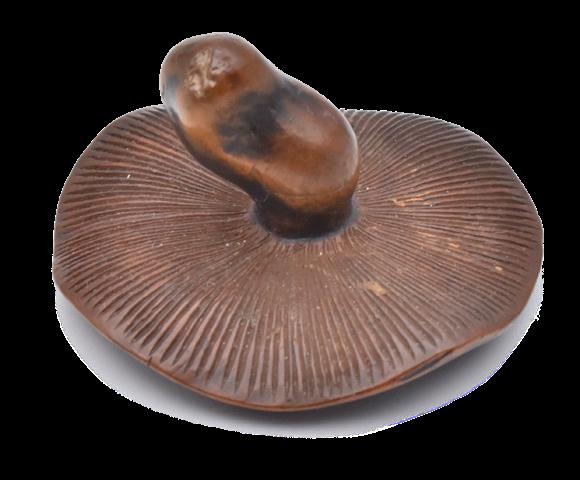
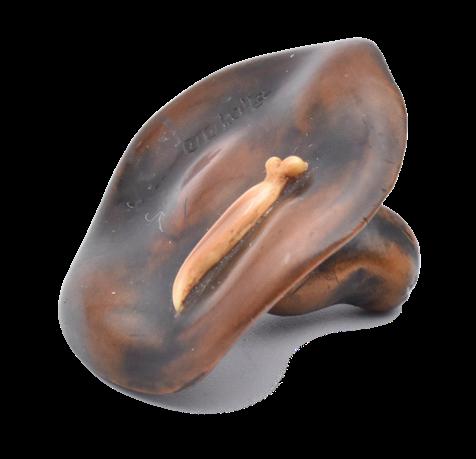
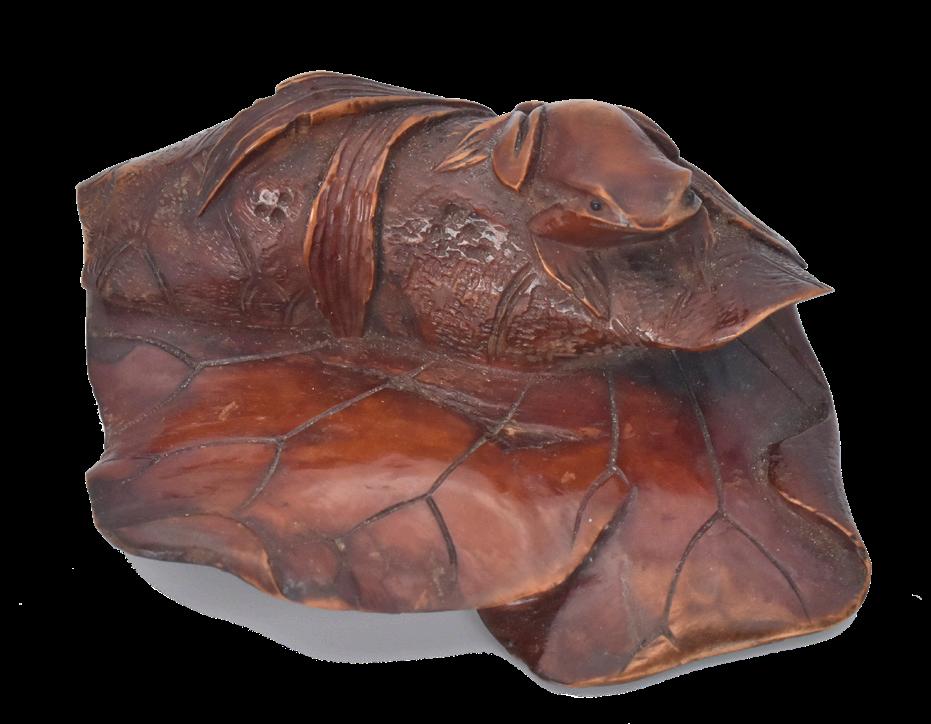
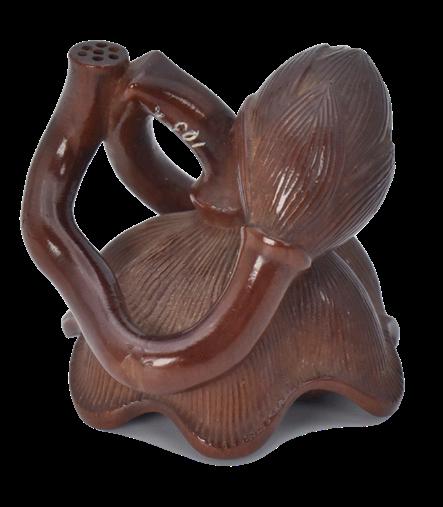
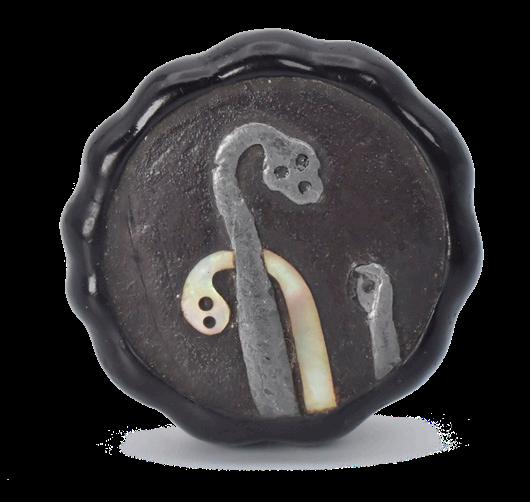
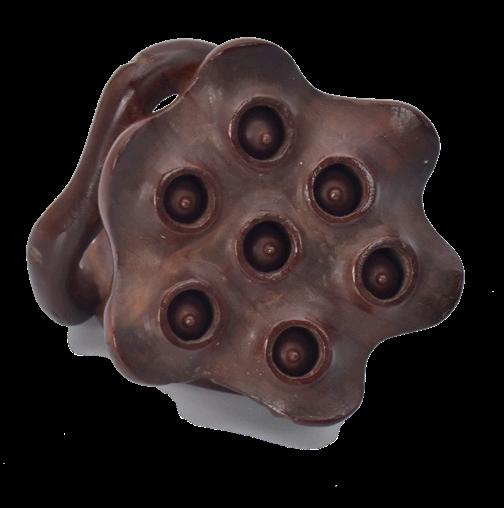
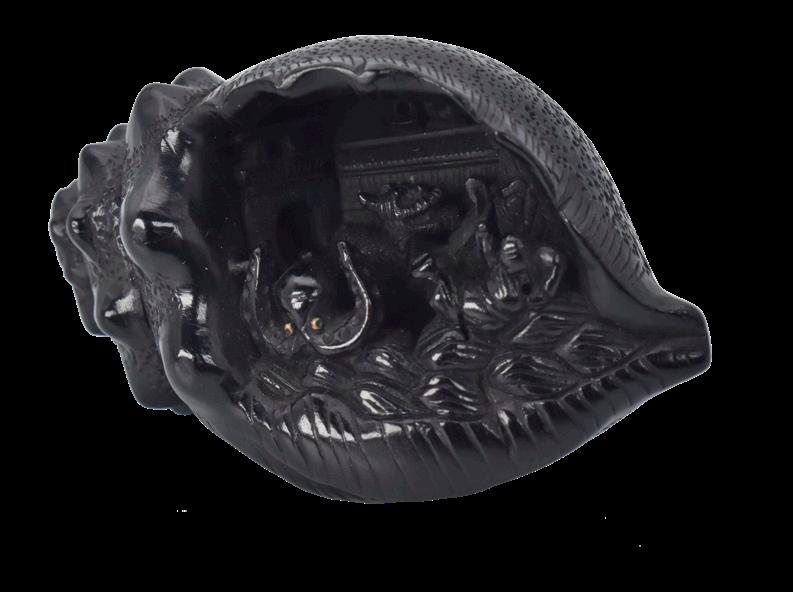

27 Ω
A WOOD NETSUKE OF A FROG ON A TORTOISE EDO PERIOD (1615-1868), 19TH CENTURY
The smooth-skinned tree frog resting, its raised head bearing an alert expression, on the back of the tortoise which is almost completely enveloped in its carapace, the slightly worn wood bearing a fine patina, unsigned; with a wood storage box (2)
2.7cm x 5cm
£1,000-1,500
28 Ω
MASATOMO
A WOOD NETSUKE OF A SHISHI
EDO PERIOD (1615-1868), 19TH CENTURY
The compact figure shown seated looking to the right, holding a pierced, brocade ball between its front paws, the hair and flowing mane finely carved, signed on the underside Masatomo, with a wood storage box (2)
3cm x 3.1cm
£1,200-1,500
29Ω
A WOOD NETSUKE OF RAIJIN
EDO PERIOD (1615-1868), 19TH CENTURY
Seated on his circular drum, pulling at the cord with one hand, peering downwards, one leg shown on the reverse through a hole in the drum, forming a compact composition in slightly worn and well-toned pale boxwood, with a wood storage box; unsigned (2)
3.5cm x 3.3cm
£1,200-1,500
30Ω
HIDETOMO
A WOOD NETSUKE OF SHOKI AND ONI (DEMON)
EDO PERIOD (1615-1868), 19TH CENTURY
The demon-queller standing, holding his broad sword with one hand and the brim of his large hat with the other, a oni (demon) sprawling on the top, trying in vain not to be noticed; signed on the reverse Hidetomo within an oval reserve; with a wood storage box (2)
6.8cm high
£1,200-1,500
31Ω
GYOKUZAN
A WOOD GROUP OF SEVEN KYOGEN AND NOH MASK NETSUKE EDO PERIOD (1615-1868), 19TH CENTURY
Clustered together and forming a compact composition, four masks on one side comprising Okame, Oni (devil), Beshimi and a young boy and three masks on the reverse, comprising Okina, Hyottoko and a grimacing warrior, signed on an oval rectangular reserve Gyokuzan; with a wood storage box (2)
3.5cm wide
£700-800
32 Ω
OSHITA YOSHIKO (KOEN, BORN 1967)
A POLYCHROME LACQUER NETSUKE IN THE FORM OF AN ITOMARI (THREAD BALL) OR TEMARI (HAND BALL
MADE FROM SILK THREAD)
HEISEI (1989-2019) OR REIWA (2019-PRESENT) ERA, 20TH/21ST CENTURY
The brocade ball decorated in polychrome lacquer with details sprinkled with silver powder with a typical geometric pattern, with a tomogire cloth stamped with the artist’s seal Koen, with a tomobako inscribed outside on the lid Mari maki-e netsuke, signed and sealed inside the lid Koen saku with seal Koen (3)
3.5cm diam.
£1,000-1,500

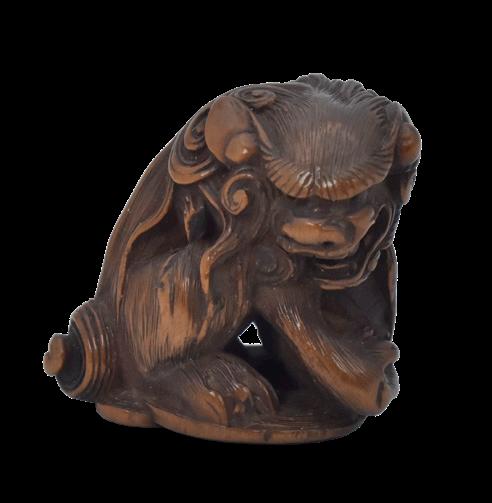
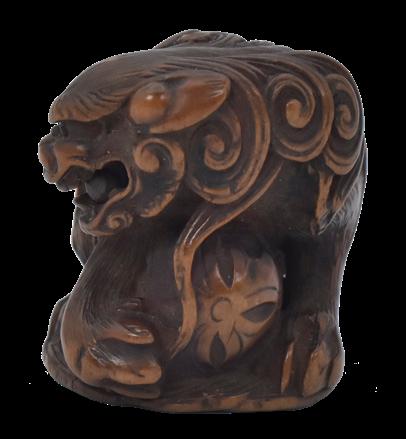

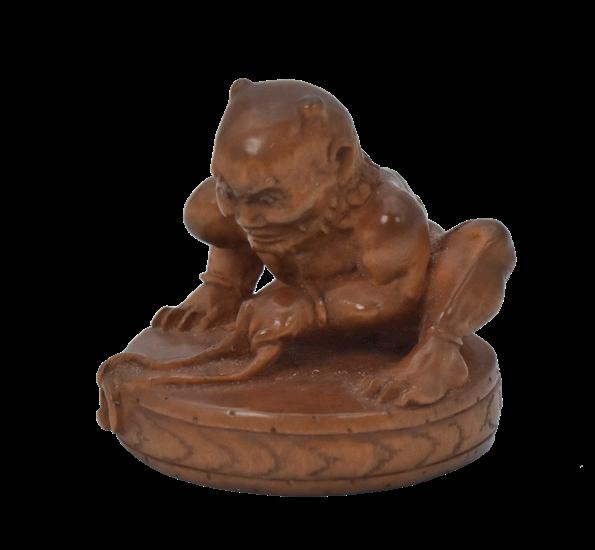
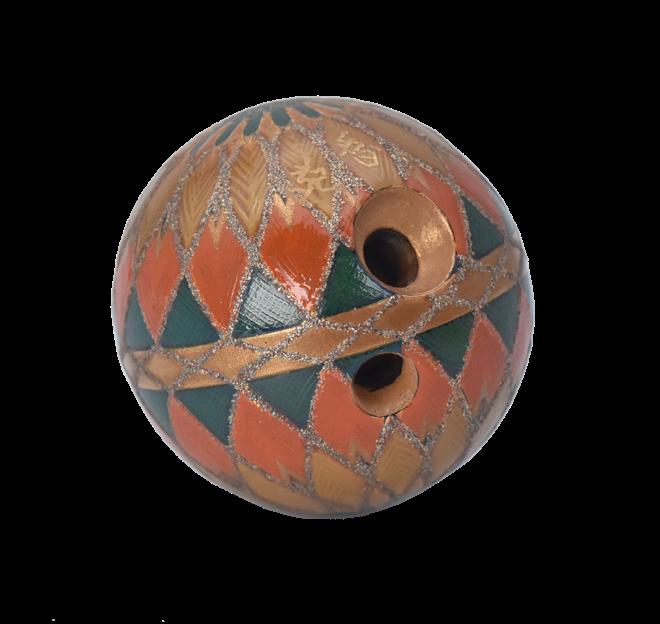


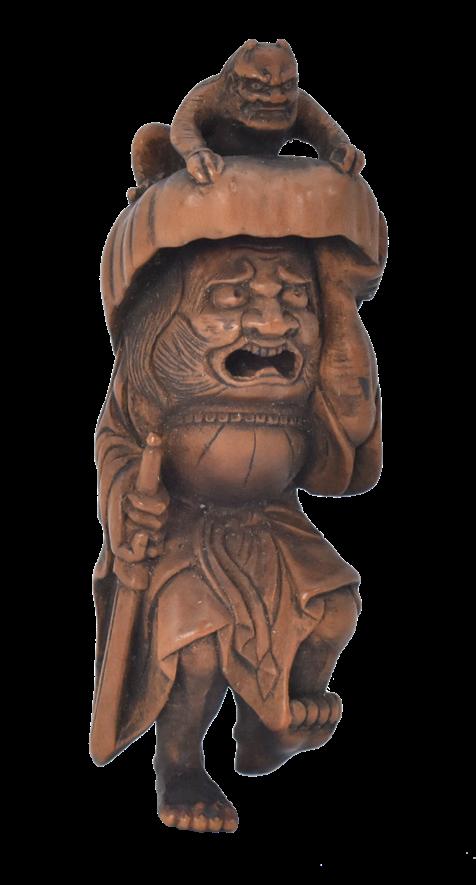
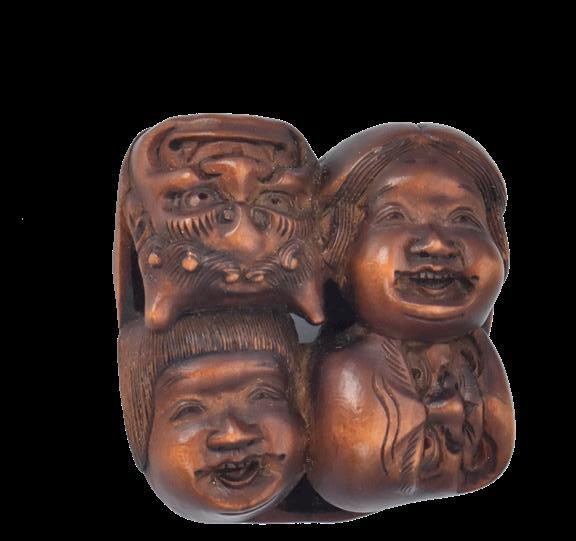
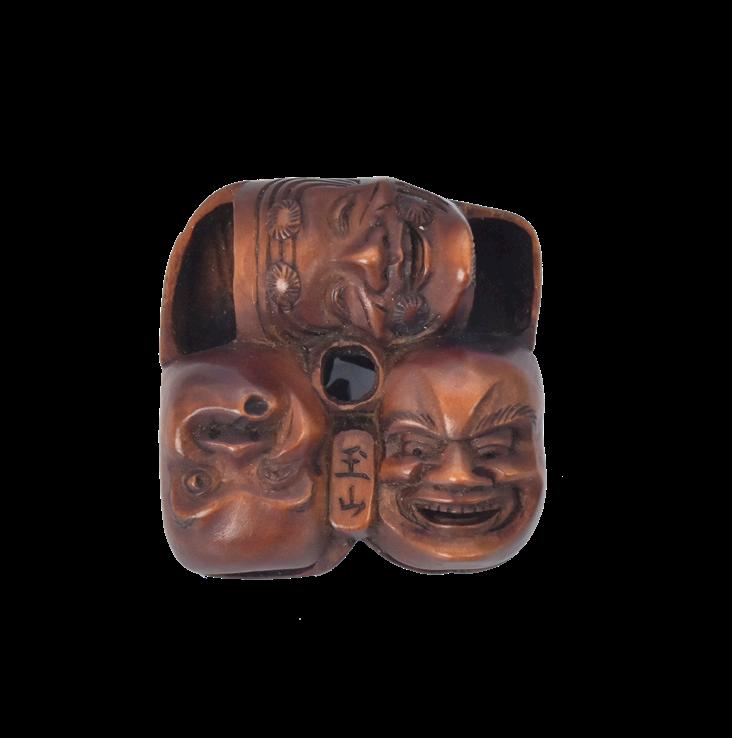
33
SHOKO OF TAKAYAMA
A WOOD NETSUKE OF SHOKI AND ONI
EDO PERIOD (1615-1868), 19TH CENTURY
Shoki, the demon-queller standing and holding a broad sword with one foot pressing down a koinobori (carp streamer) trapping the oni (demon) hiding within, the slightly-worn wood with a fine patina; signed on the underside Shoko
5.7cm high
£600-800
34 MITSUHIDE
A WOOD OKIMONO (TABLE ORNAMENT) OF A GROUP OF MONKEYS
EDO PERIOD (1615-1868), MID/LATE 19TH CENTURY
Comprising three monkeys, the adult seated and holding one offspring between its feet, playing with its leg, a second monkey climbing over the adult’s head whilst a third standing behind grabs its companion’s leg with both hands; the monkeys’ eyes inlaid in pale amber with dark pupils; signed on the base within an oval reserve Mitsuhide
6.2cm high
£1,000-1,500
35
TADAKAZU/CHUICHI
A WOOD NETSUKE OF TORTOISES IN A BASKET
EDO PERIOD (1615-1868), 19TH CENTURY
Carved with three tortoises in a basket, two clambering over the top and the third smallest tortoise crawling out from a hole on the side, signed on the base within a rectangular reserve Tadakazu/Chuichi
2.6cm x 4cm
£800-1,200
Compare with a very similar example by the artist in the Fitzwilliam Museum, Cambridge, Accession Number MAR.O.148-1912
36 KOICH
A WOOD NETSUKE OF A MONKEY, EDO PERIOD (1615-1868), MID 19TH CENTURY
The monkey seated, its head lowered, turning slightly to the left, picking fleas from its left leg, the right leg forming the himotoshi, the wood lightly stained, the eyes double-inlaid in pale amber with dark pupils; signed beneath one leg within an oval reserve Koichi
3.5cm high
£1,000 - 1,500
RYUMIN
A WOOD NETSUKE OF HANASAKA JIJI WITH A BASKET OF ASHES
EDO PERIOD (1615-1868), 19TH CENTURY
Seated on a withered tree stump and making it blossom by scattering the ashes of his deceased neighbours, both his hands holding the ashes contained in a basket, the buds inlaid with ivory; signed on the base within an ivory tablet Ryumin
4cm x 3.5cm
£300 - 500
38
A WOOD NETSUKE OF A GROUP OF RATS
EDO PERIOD (1615-1868), 19TH CENTURY
Comprising one adult rat seated on two beans and its four offspring clambering over its back, their long tails trailing beneath forming the himotoshi; the wood stained and the eyes inlaid with dark horn; signed beneath on one bean Ikko.
3.7cm
£1,000 - 1,500
39
OKATOMO OF KYOTO
A WOOD NETSUKE OF A QUAIL
EDO PERIOD (1615-1868), LATE 18TH/EARLY 19TH CENTURY
Finely carved as a plump quail standing on two millet stalks and leaves, one trailing beneath forming the himotoshi, its legs held close to its breast and its wings folded tightly to its sides in a compact composition, the surface detail lightly stained, signed on the underside Nanajuhachi o Okatomo (Made by old man of 78, Okatomo)
3.3cm x 3.8cm
£1,200 - 1,800
40
An almost identical example by the artist was sold at Bonhams, New Bond Street, London, Fine Netsuke from a French Private Collection, 4 November 2020, lot 86. 37
A WOOD NETSUKE OF ONI (DEMON)
EDO PERIOD (1615-1868), 19TH CENTURY
The demon holding and kneeling behind a large straw hat, attempting to hide from the beans thrown during the Setsubun ceremony to exorcise him and other demons, some beans landing on the crown of the hat, one bean resting between the demon’s horns; unsigned
4cm high
£600 - 800

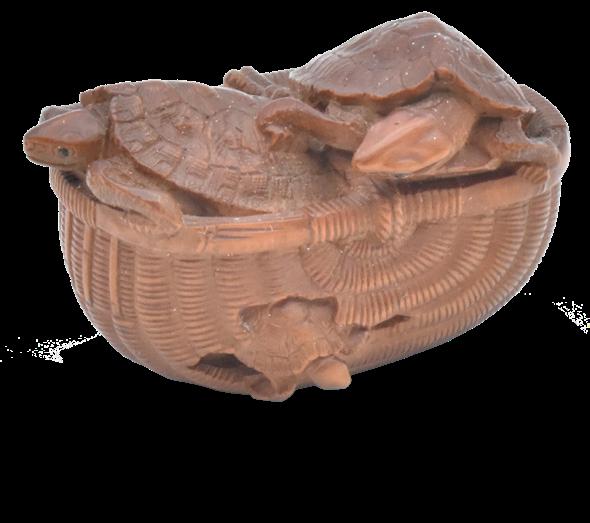
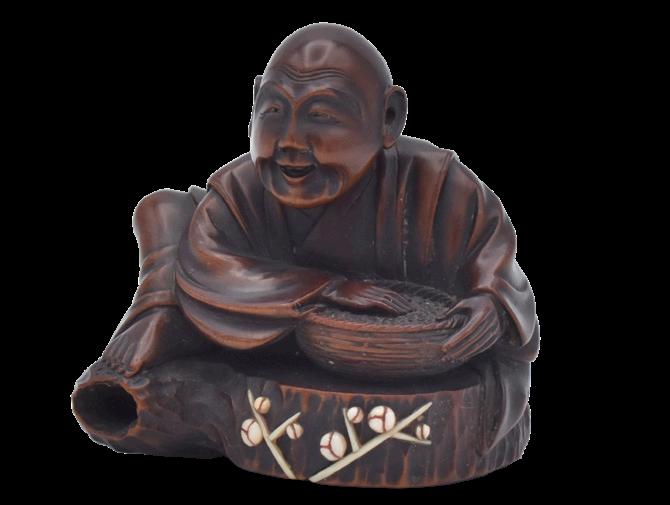
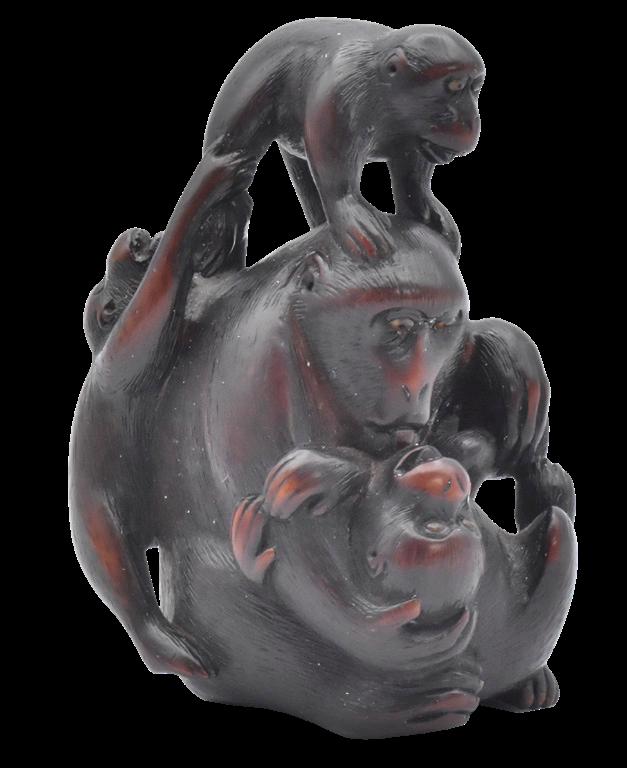


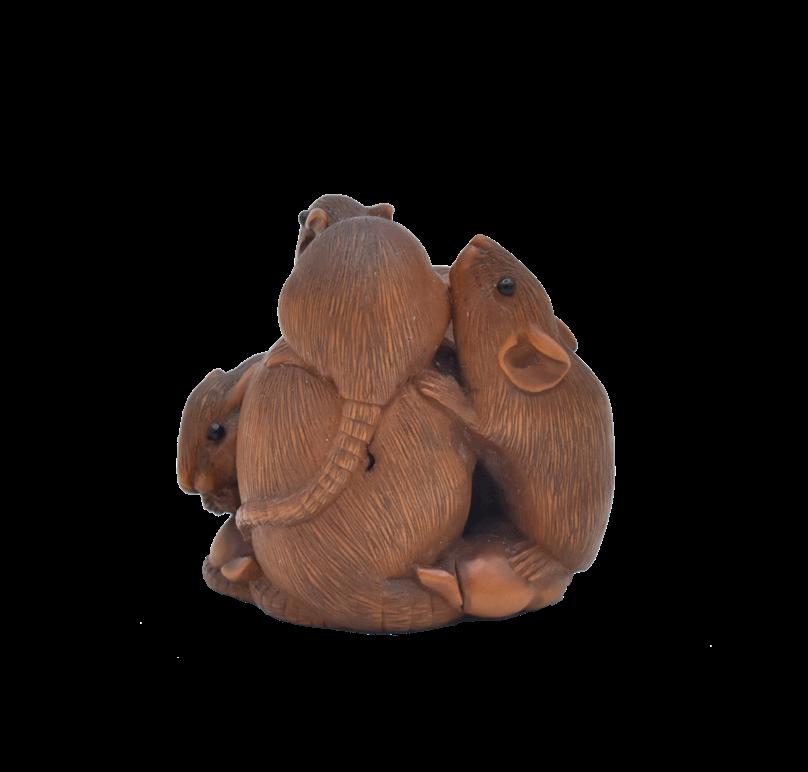
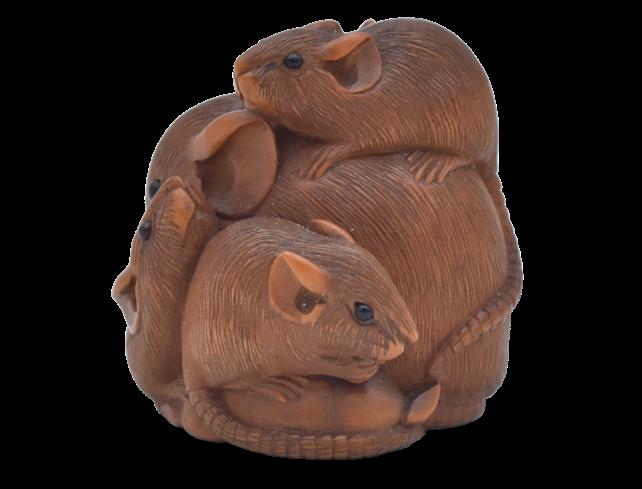
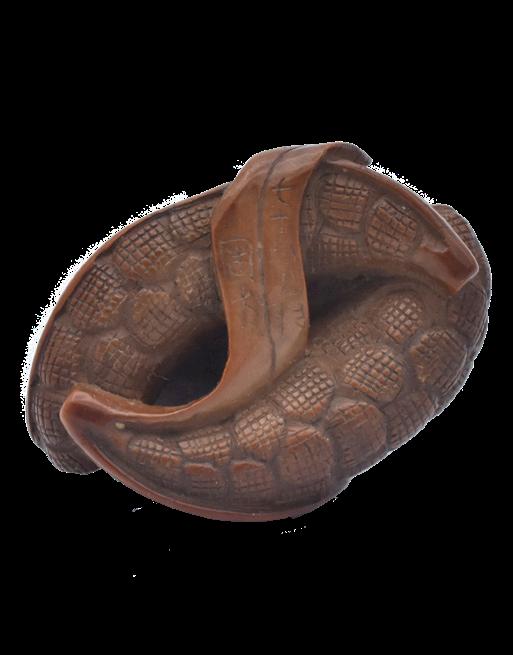
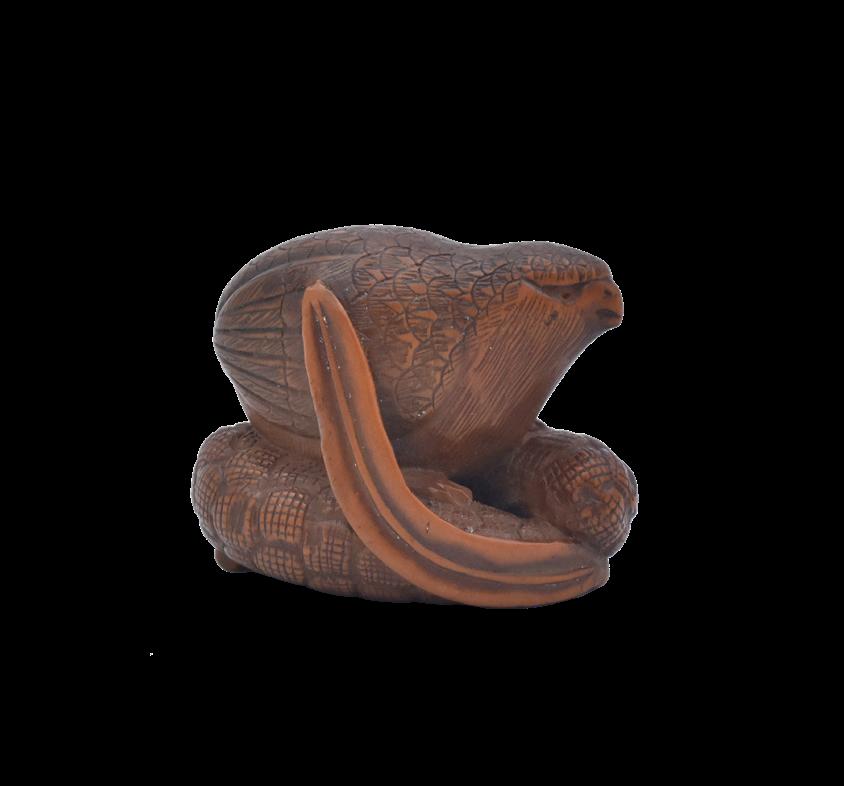


41
SHUOSAI
A WOOD NETSUKE OF KIYOHIME ON THE BELL OF DOJOJI
EDO PERIOD (1615-1868), EARLY 19TH CENTURY
Carved as Kiyohime, transformed into the serpentine demon, holding a large striker and coiling herself around the bell of Dojoji, the handle in the form of two dragon heads, the demon’s flamed tongue emanating from her mouth, peering through a crack in the bell spying on the priest Anchin within before burning him alive, the demon’s face of ivory; signed on the base Shuosai
5cm high
£2,000 - 3,000
The story of Kiyohime and her ultimately destructive unrequited passion for the priest Anchin is the subject of a Noh drama, Dojoji. See also lot 44.
42
MIWA (ACTIVE LATE 18TH/EARLY 19TH CENTURY)
A WOOD NETSUKE OF A CARPENTER
EDO PERIOD (1615-1868), DATED 1784
The artisan seated cross-legged over an upturned wheel, bending forward with both hands positioning his kanna (plane) to smooth the wood, signed and dated on the reverse, along the edge of the wheel Tenmei kinoe-tatsu Miwa tsukuru
4.6cm diam.
£1,000 - 1,500
43
TOMOCHIKA
A WOOD NETSUKE OF A SHOJO (DRUNKEN SPRITE)
EDO PERIOD (1615-1868), 19TH CENTURY
Lying asleep, her head resting on her right hand, her long hair trailing over her robe carved and engraved with diaper and swirling cloud designs; signed on the underside within a rounded rectangular reserve Tomochika
4.5cm long
£1,500 - 2,500
44
TANAKA MINKO OF TSU (1735-1816)
A WOOD NETSUKE OF KIYOHIME ON THE BELL OF DOJOJI
EDO PERIOD (1615-1868), EARLY 19TH CENTURY
Carved as Kiyohime, manifesting as the dragon witch with her long serpentine tail winding around the temple bell, showing through a crack on one side the scorched face of the entrapped priest Anchin the object of her unrequited love, the base with one himotoshi ringed with bone; signed on the base Tsuhan Minko
4.2cm x 4cm
£2,000 - 3,000 45
MASAJO OF NAGOYA
A WOOD NETSUKE OF A SHOJO (DRUNKEN SPRITE),
EDO PERIOD (1615-1868), 19TH CENTURY
Seated, her head resting on her hand and her eyes closed as she peacefully slumbers, her long hair falling over the back of her robe carved with repeated geometric and formal designs, the wood slightly worn with a fine patina, signed on the underside within a rectangular reserve Masajo
3.3cm x 3.3cm
£2,000 - 3,000
46λ
TADATOSHI
A WOOD AND IVORY NETSUKE OF A BOAT
EDO PERIOD (1868-1912), 19TH CENTURY
The dragon-prowed boat depicting probably two Chinese men, an official and attendant seated inside a covered area on deck, one looking out from the stern, the boat carved with waves in low relief, the prow, taffrail and stern of ivory; signed on the base Tadatoshi
4cm x 6cm
£500 - 600

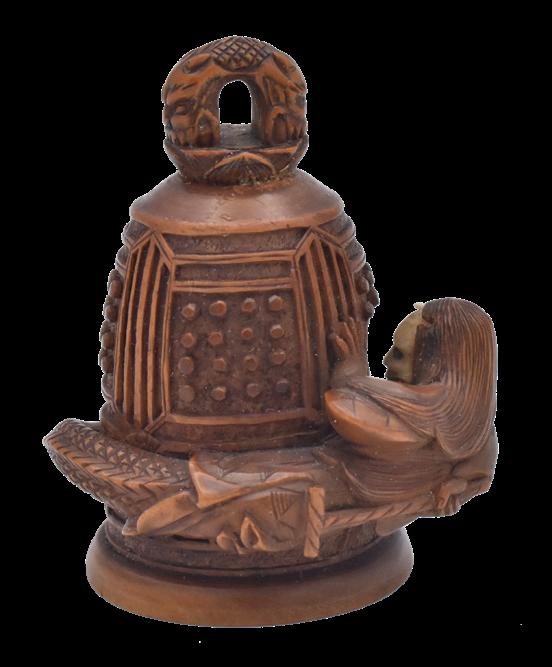
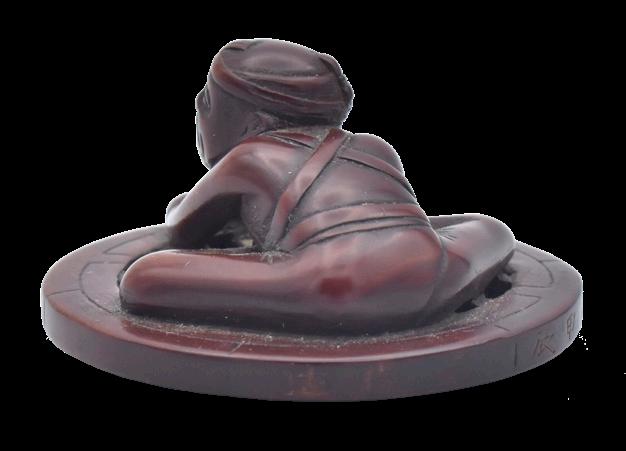

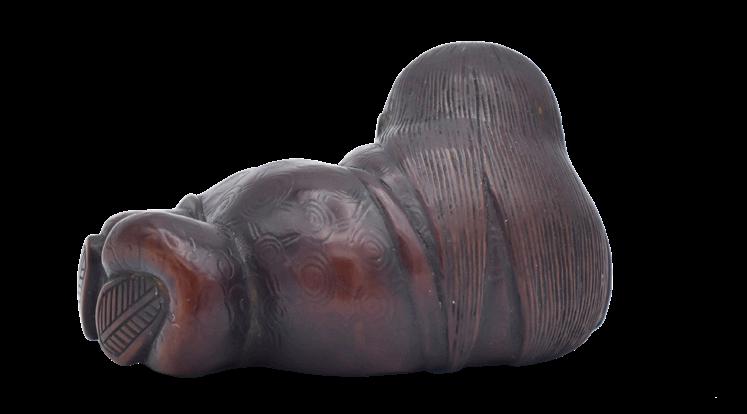
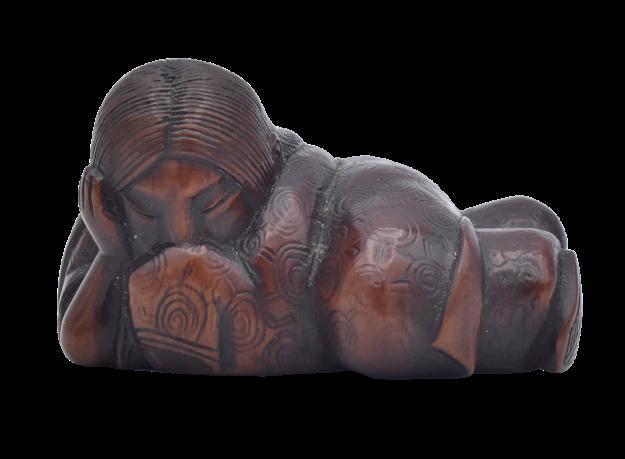
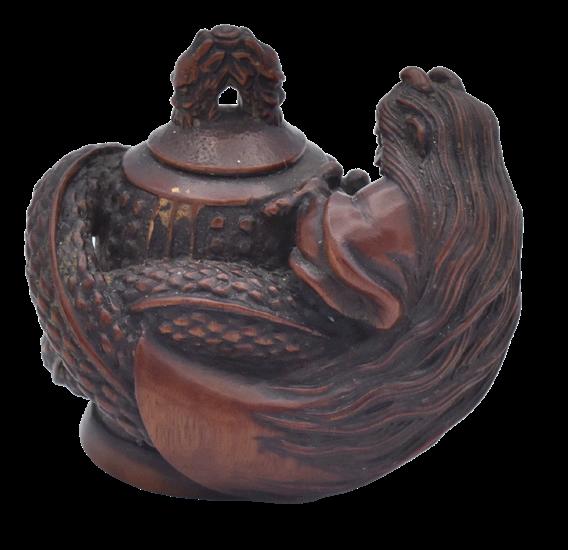

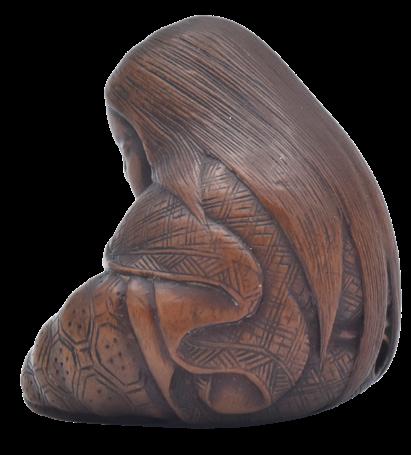
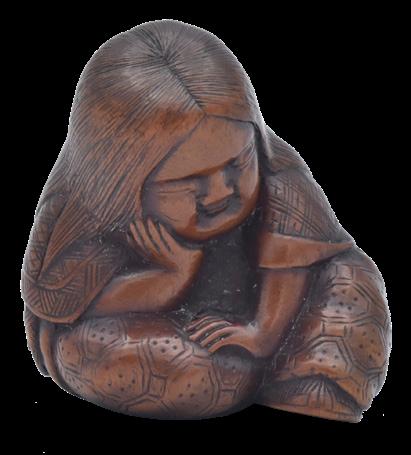
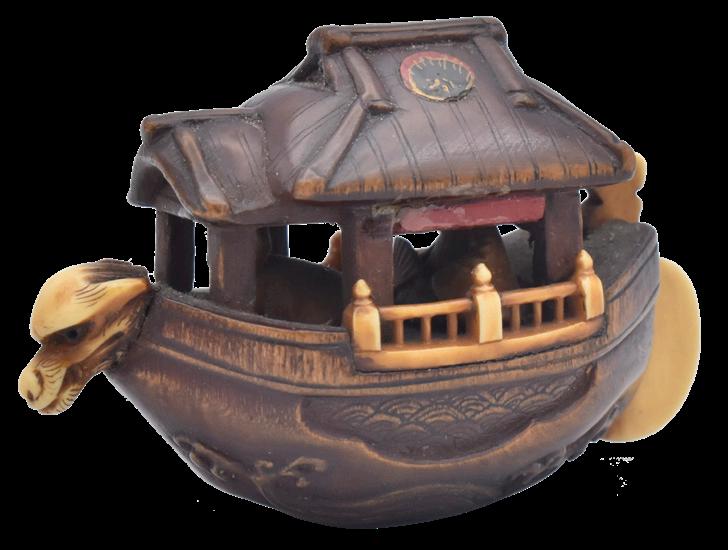
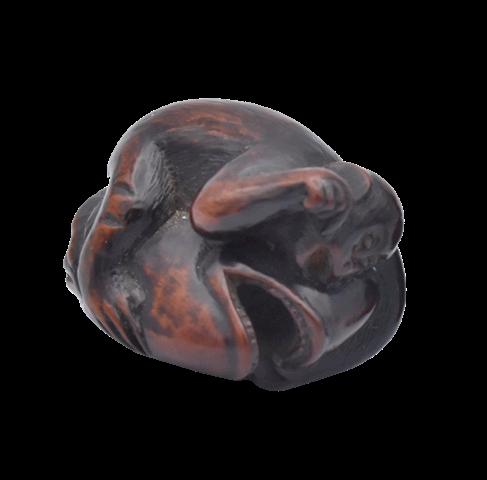


47
FIVE WOOD ANIMAL NETSUKE
EDO PERIOD (1615-1868), 19TH CENTURY
Comprising a monkey grappling with a giant carp, unsigned, 2.5cm x 3.5cm; the second an emaciated wolf seated and gnawing into a skull, signed Issai, 3.2m x 3.1cm; the third a squatting toad, its eyes inlaid in dark horn, unsigned, 2.5cm x 4cm; the fourth a seated dog, hunched over holding a ball against its chest, unsigned, 3cm x 3cm; the fifth two rabbits seated and nestled against each other, their eyes inlaid in dark horn, unsigned; 2.5cm 4.5cm (5)
£800 - 1,200
48
FIVE WOOD FIGURE NETSUKE
EDO PERIOD (1615-1868), 19TH CENTURY
Comprising a young woman seated on tied brushwood, resting, holding a pipe, signed Hozan, 4.5cm x 3.5cm; another carved as an old woman standing in a river discovering a large peach alluding to the story of Momotaro, unsigned, 3.5cm x 4,3cm; the third Handaka Sonja seated on his dragon gripping two tama (wish-granting jewels), signed with a kao, 4.3cm x 3cm; the fourth Hotei holding a tama (jewel) in his right hand out of reach from the karako (Chinese boy) standing beside him tugging at his sleeve, unsigned, 5cm high; the fifth Ikkaku Sennin carrying Lady Sendaramo on his back; unsigned; 6.2cm high. (5)
£1,000 - 1,500
49
CHIKUSAI
A WOOD OKIMONO NETSUKE OF ONO NO KOMACHI
EDO (1615-1868) OR MEIJI (1868-1912) ERA, MID/LATE 19TH CENTURY
The aged poetess depicted as a hunchbacked and emaciated woman, wearing rags with a tattered broad straw hat slung on her back, seated on a fallen bridge post with a sombre expression, both hands gripping her gnarled walking stick; signed on the base within an oval rectangular reserve Chikusai
5.2cm x 5.5cm
£800 - 1,200
50
SHUNSAI
A WOOD NETSUKE OF OKAME
EDO PERIOD (1615-1868), 19TH CENTURY
Carved as Okame, the Goddess of Mirth, bearing a gleeful expression, wearing geta (high wooden clogs) kneeling before a shallow tub of water with her skirts hiked over her thighs, washing a fundoshi (loin cloth); signed on the base of the tub Shunsai
4.3cm high
£600 - 800
51
FIVE NETSUKE OF DIFFERENT MATERIALS
EDO PERIOD (1615-1868), 19TH CENTURY
Comprising a lacquered-wood Kyogen mask of a monkey, of typical countenance with large staring eyes inlaid in pale amber, the reverse with a horizontal wood bar forming the himotoshi, unsigned, 4cm x 3.1cm; three manju-netuske: the first of guribori lacquer deeply carved with undulating scrolls, with a gilt metal loose ring himotoshi and stopper, unsigned, 4.1cm diam.; the second of carved tsuishu lacquer with dense flowers and foliage on a formal ground, unsigned, 3.2cm diam.; the third of red-and-black lacquer, carved with a large peony flower and a maple leaf, unsigned, 4cm diam.; the fifth a wood hako-netsuke inlaid with cherry blossoms and petals in shell, unsigned; 1cm x 2.7cm x 2.4cm (5)
£1,000 - 1,500
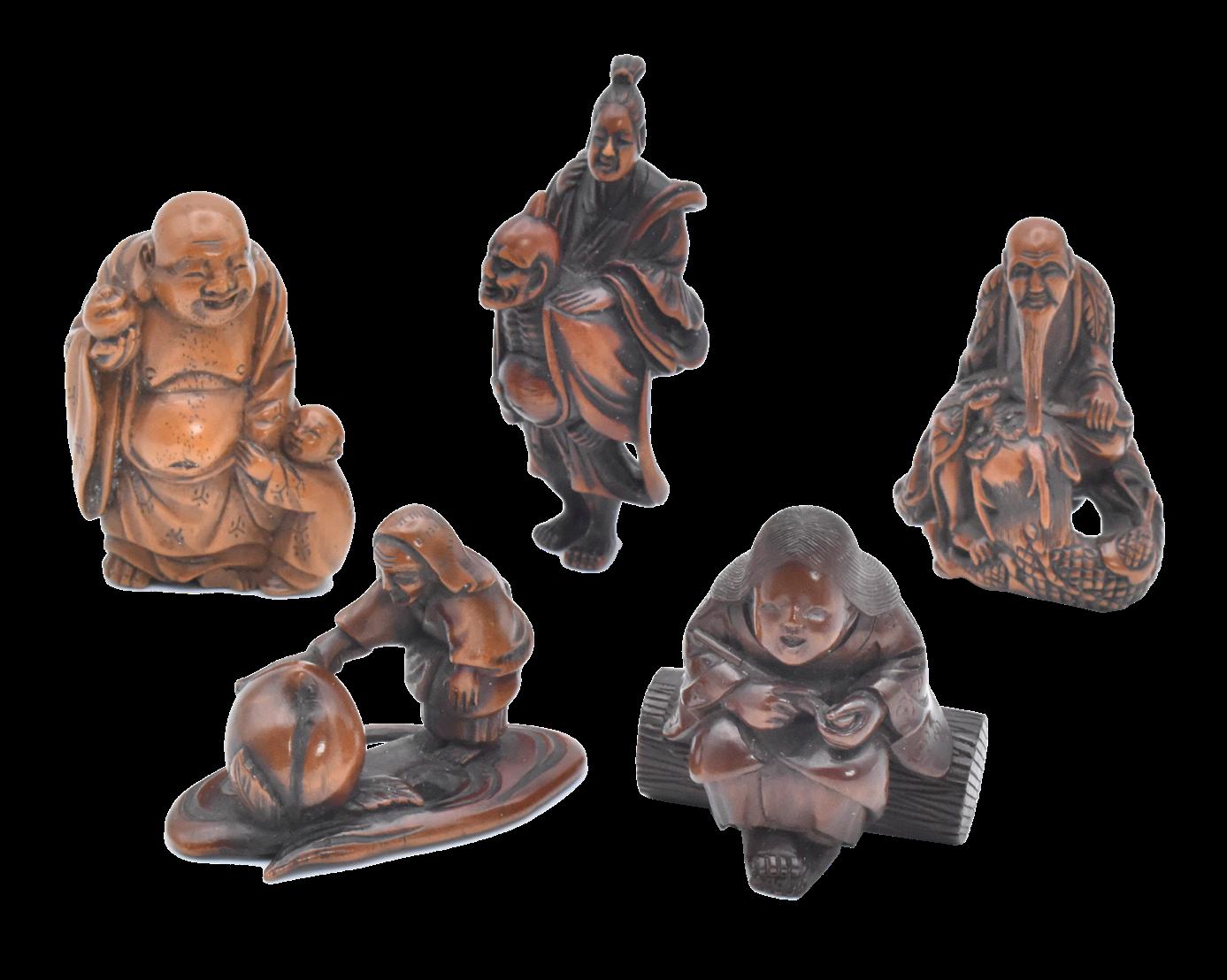
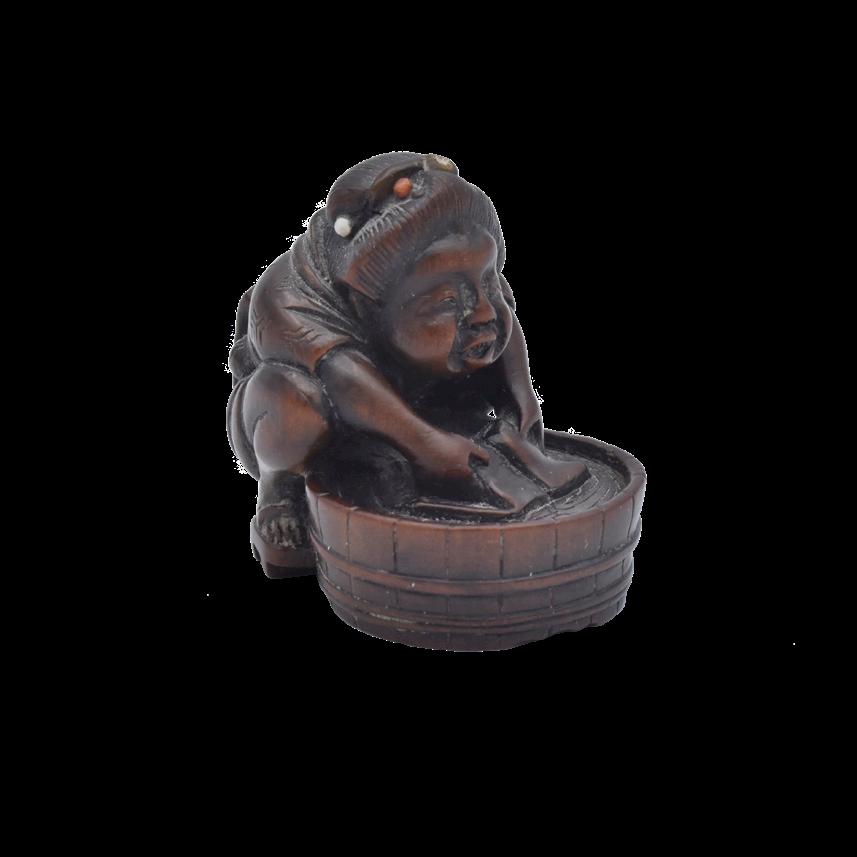
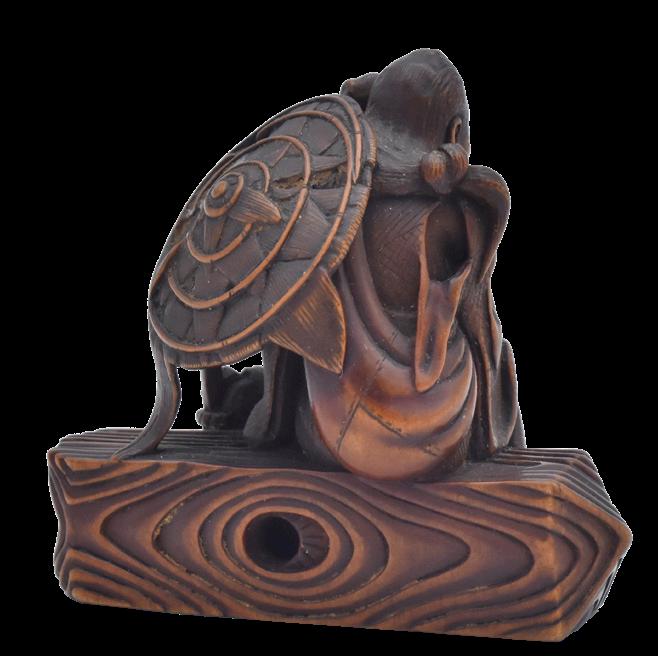


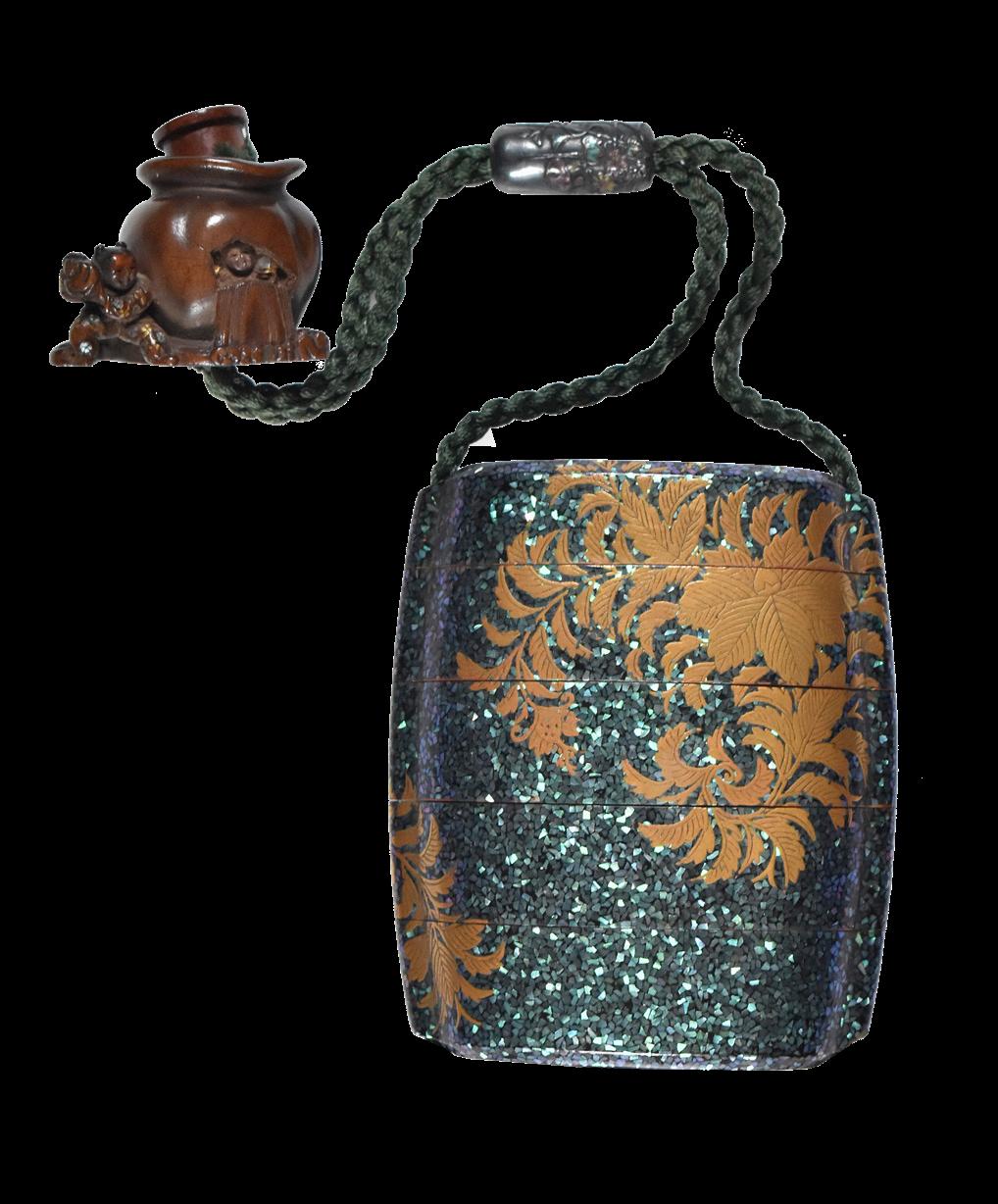

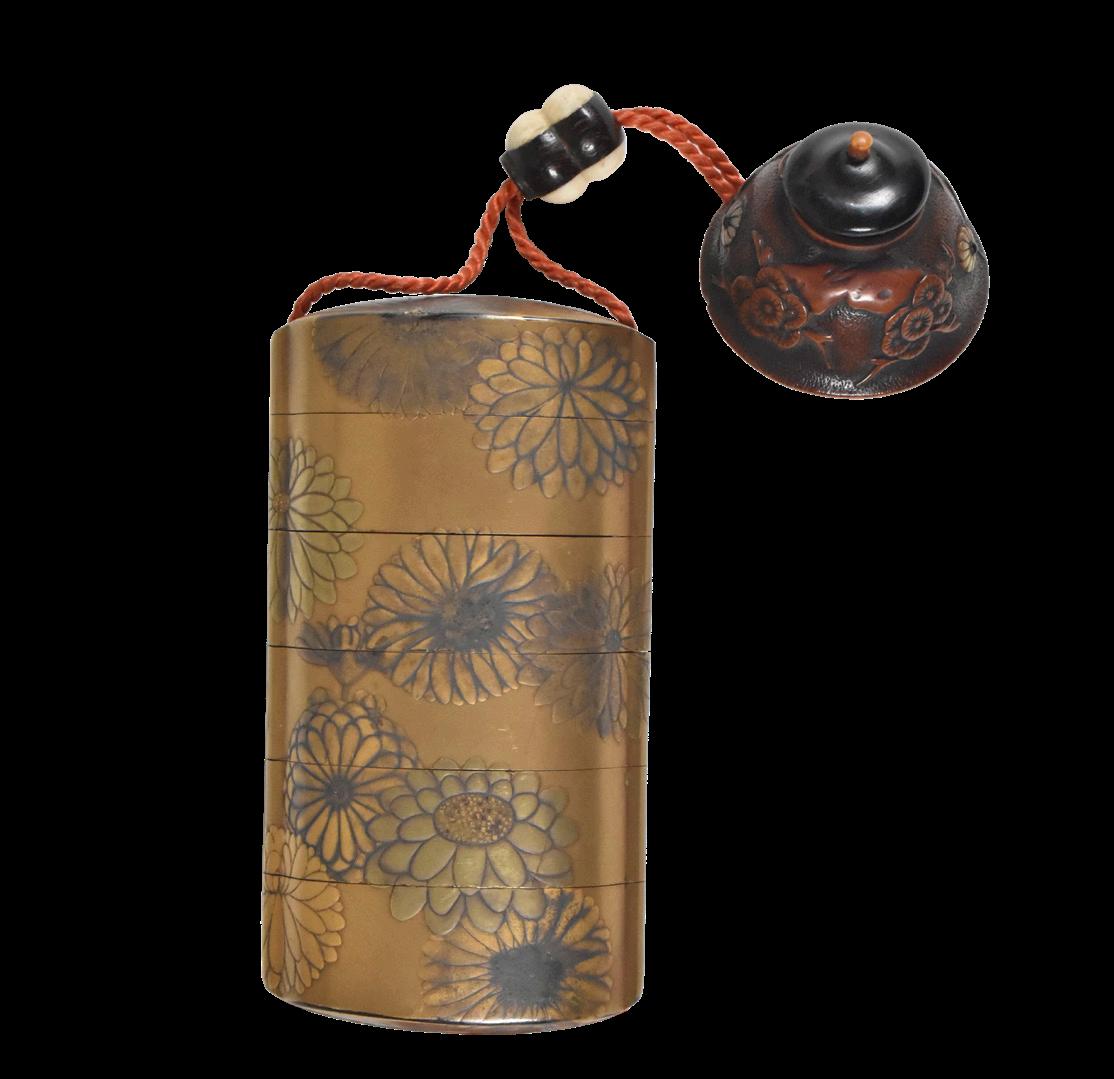
The rounded-rectangular body with a densely-inlaid shell body decorated in gold hiramaki-e issuing from opposite corners of the front and back of the the interior of rich nashiji, unsigned, 7cm high; with a shibuichi tubular ojime applied in low relief of polychrome enamel and shell with morning glories, unsigned; and a wood netsuke representing the legend of Shiba Onko, showing the boy hero standing beside a huge water jar and about to strike it with a stone as his companion struggles within, with details inlaid in shell and gold lacquer; signed possibly Iatari; 2.7cm x 3cm
£5,000-6,000
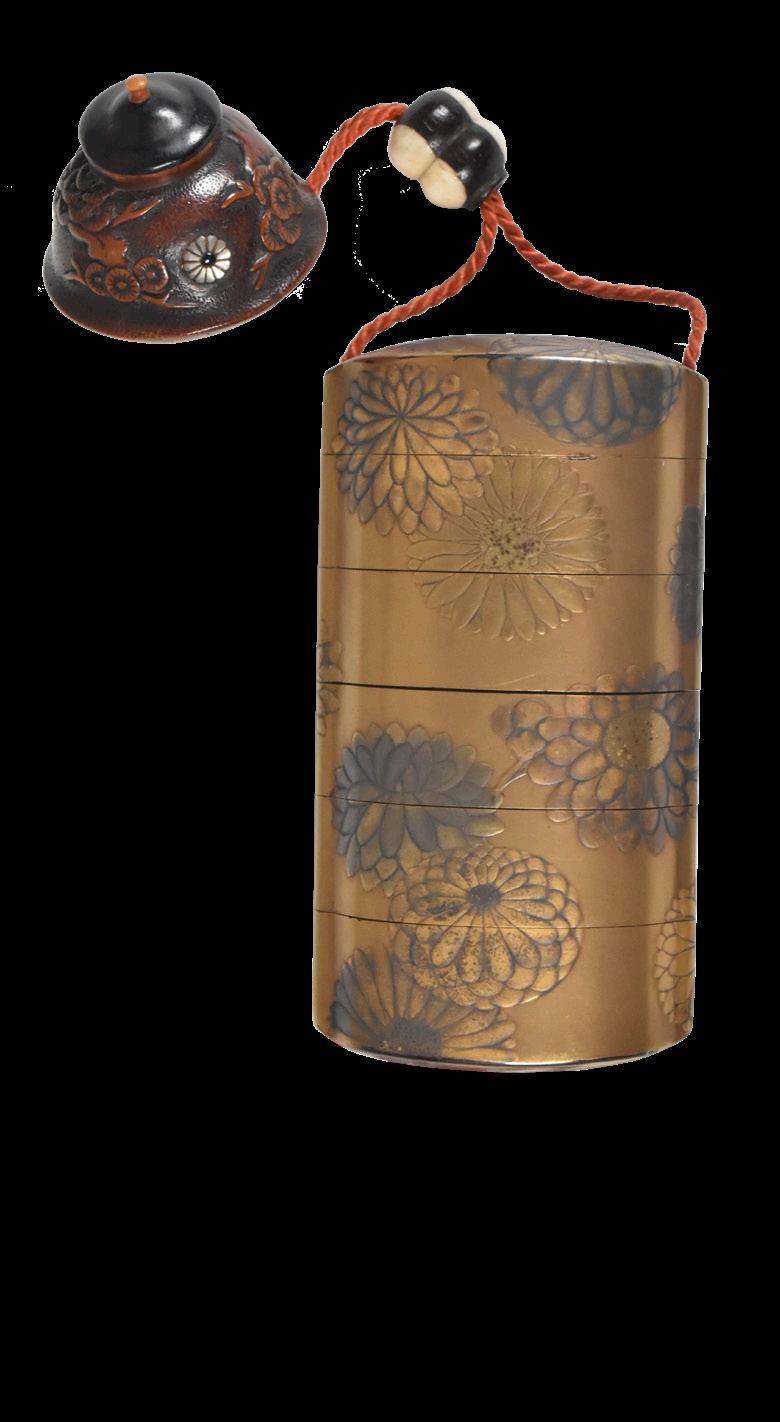
Provenance: Heber R. Bishop Collection. James F. Sutton Collection. Carll H. De Silver Collection.
Charles A. Greenfield Collection, purchased at Sotheby’s New York, March 25, 1998, lot 71
Exhibited: Japan House Gallery, Japan Society, New York, 1972.
Published: Stern, Harold P., The Magnificent Three, Lacquer, Netsuke and Tsuba, Selections from the Collection of Charles A. Greenfield, New York: Japan House Gallery, Japan Society, 1972, no.37

53
A GOLD-LACQUER FIVE-CASE INRO
EDO PERIOD (1615-1868), 18TH/19TH CENTURY
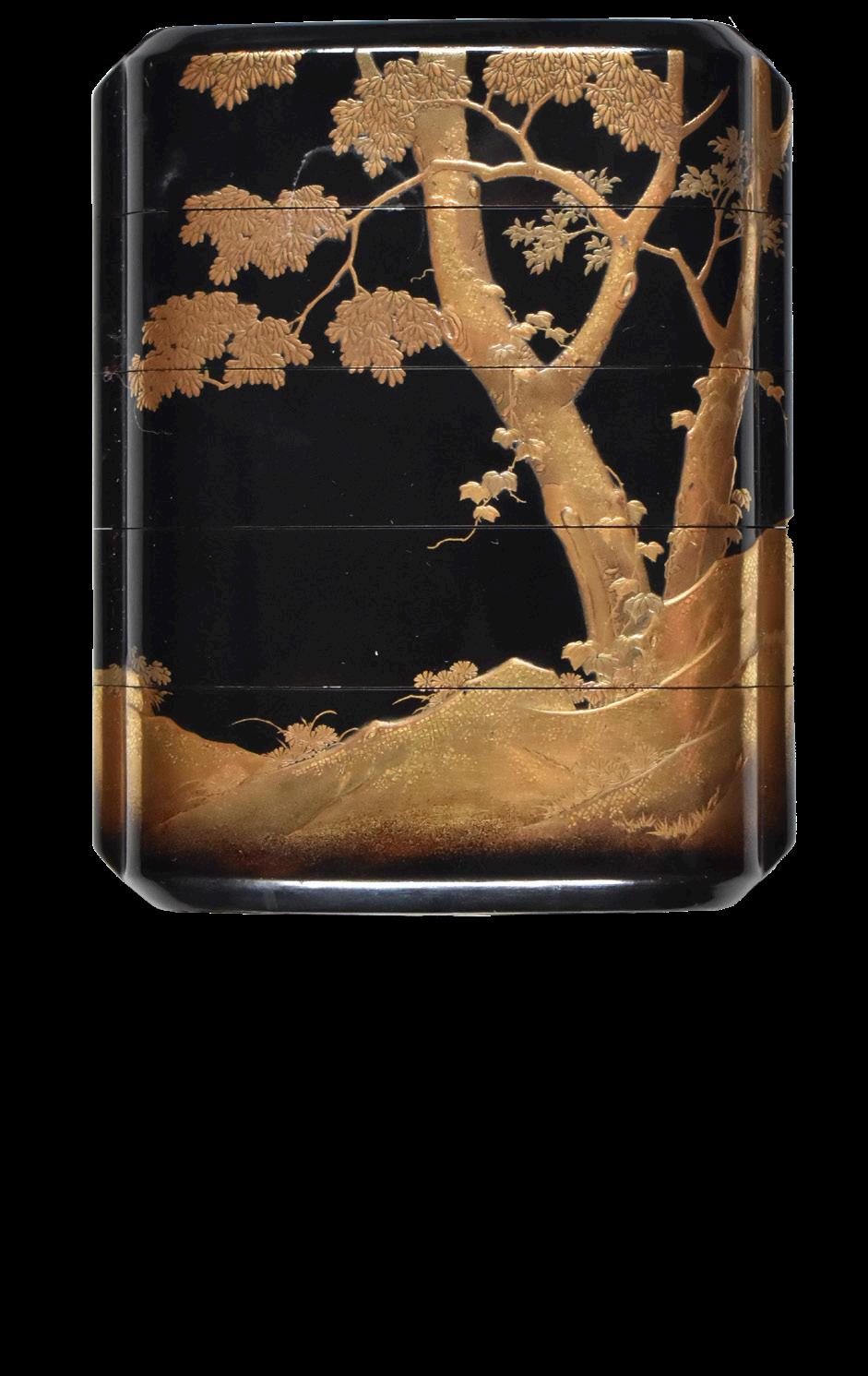
The rounded rectangular body with a kinji ground decorated in contrasting tones of gold takamaki-e and e-nashiji with an all-over design of overlapping chrysanthemum blossoms, the interior of rich nashiji, unsigned, 9.2cm high; with a bone and wood gourd ojime and an inlaid wood netsuke of a chagama (tea kettle) carved in low relief with pine branches flanking two kikumon (chrysanthemum crests) inlaid in shell; unsigned, 3.8cm x 3.8cm
£800-1,200
54
AN INLAID BLACK-LACQUER FOUR-CASE INRO
EDO PERIOD (1615-1868), 19TH CENTURY
The broad, rounded rectangular body with a roiro-nuri ground decorated in gold hiramaki-e, takamaki-e and details highlighted in kirikane and e-nashiji with an arhat cradling a dove in one hand and lifting up his voluminous sleeve with the other, sheltering it from the second predatory bird flying towards it, the figure’s face, arms and feet inlaid in high relief of silver, one bird similarly rendered in gold and the other in silver, the reverse with a vineclad sacred tree and rocks, the top and bottom embellished with a formal foliate motif, the interior of rich nashiji, unsigned; with a spherical ojime lacquered with a marbled pattern; unsigned
8.8cm high
£15,000-20,000
Provenance:
Michael Tomkinson, collection label no.448.
Charles A. Greenfield Collection, purchased at Sotheby’s New York, March 25, 1998, lot 91 (front cover).
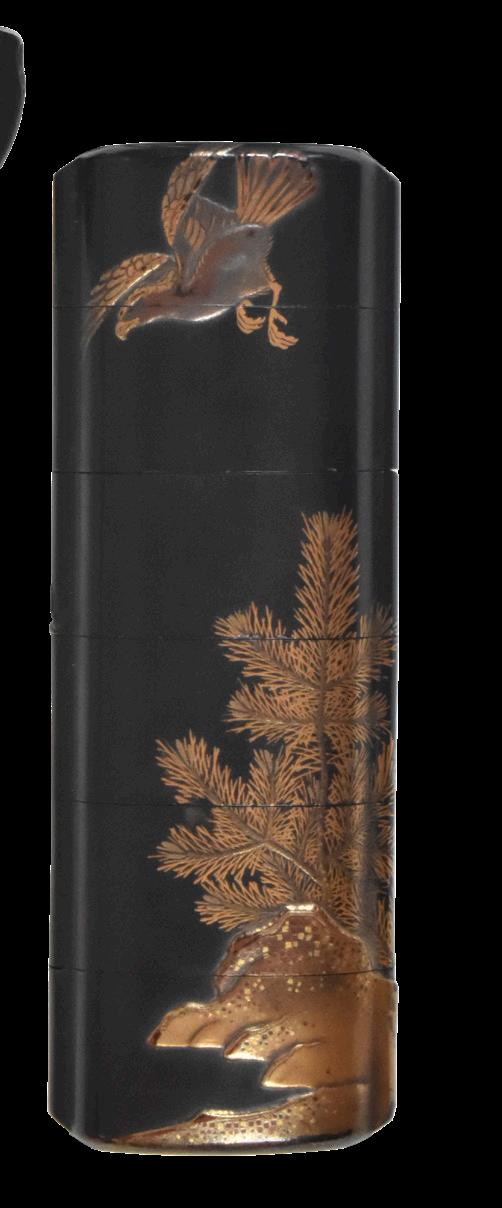
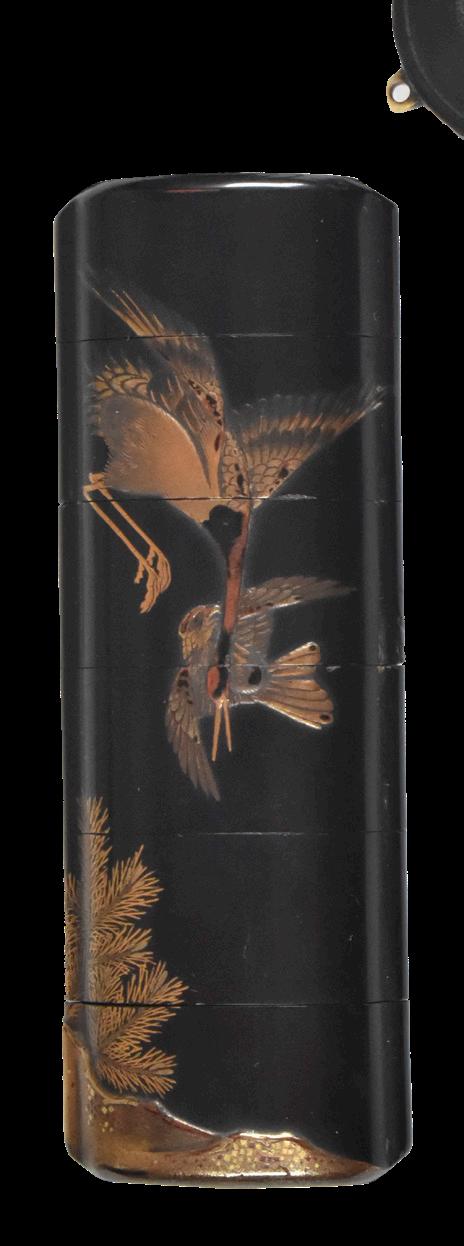

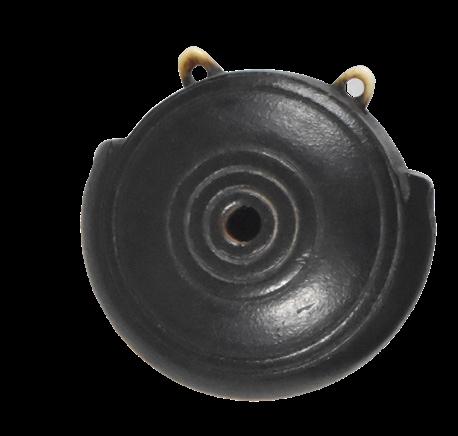
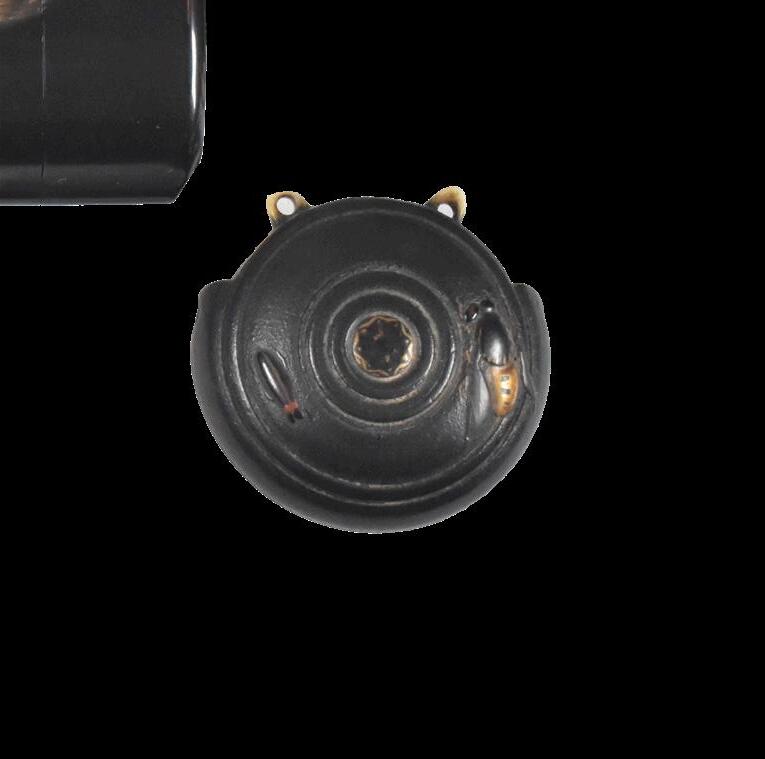
55 A BLACK-LACQUER SLENDER FIVE-CASE INRO
EDO PERIOD (1615-1868), 18TH/19TH CENTURY
The tall slender body with a roironuri ground decorated in gold and red takamaki-e, hiramaki-e and kirikane with a tancho-zuru (red-crested crane) attacking a sparrow on one side, pines and rocks in the foreground, another bird of prey descending on the other, the interior of plain black lacquer, unsigned, 10.6cm high; with a black-lacquered netsuke in the form of a mokugyo (wooden gong) decorated in black, gold and red takamaki-e with a wasp and firefly; unsigned; 3.5cm x 3.5cm (2)
£600-800
Provenance:
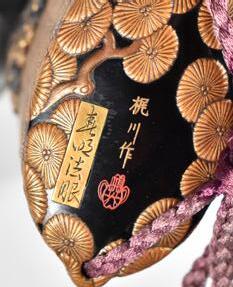
Michael Tomkinson, collection label no.399

56
KAJIKAWA LINEAGE AND TOSHIAKI HOGEN AN INLAID BLACK-AND GOLD-LACQUER FOUR-CASE INRO
EDO PERIOD (1615-1868), 19TH CENTURY
The rounded rectangular body with a roironuri ground decorated in gold takamaki-e with auspicious New Year symbols, depicting a portrait of Jurojin inlaid in high and flat relief of gold, shakudo, and shibuichi holding a sprig of plum and a crane feeding its nested chicks on a pine tree on the reverse, the crane and chicks similarly inlaid in silver, shibuichi and gold metal high relief, all on a ground of abundant pine, the interior of dense gyobu, signed on the bottom case in gold lacquer Kajikawa saku with a tsubo-shaped seal Ei and Toshiaki hogen on a gold rectangular reserve
10cm high
£5,000-6,000
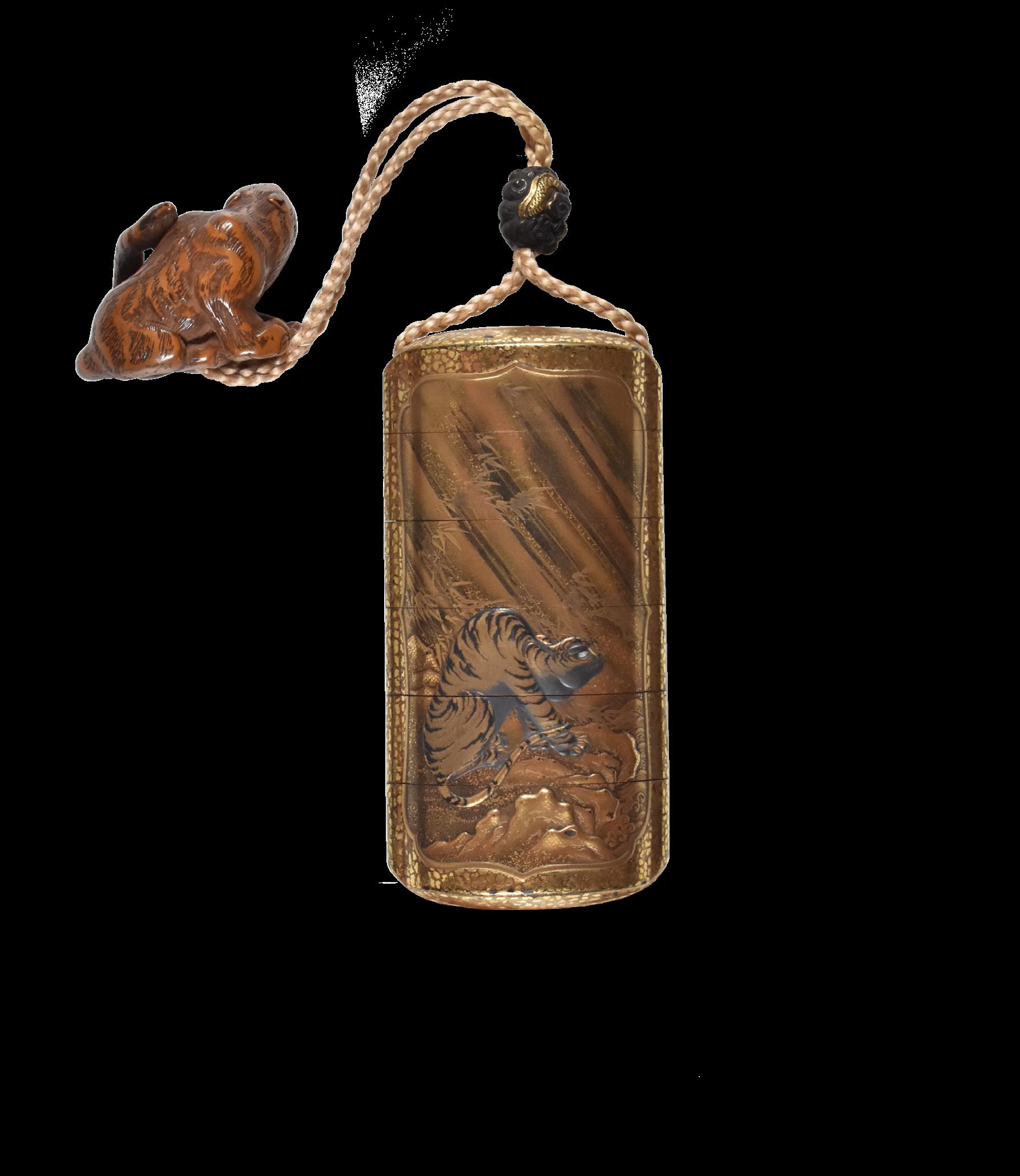
rain storm, and a dragon emerging from a swirling thunderstorm descending towards the turbulent sea on the other, signed on the base in gold lacquer Kakosai saku, 9cm high; ojime cast in high relief with a dragon among clouds, a wood netsuke of a snarling tiger, seated with its tail snaking up towards its shoulders, its eyes inlaid in pale horn, signed Kokei
3.2cm x 3.6cm
£7,000-8,000
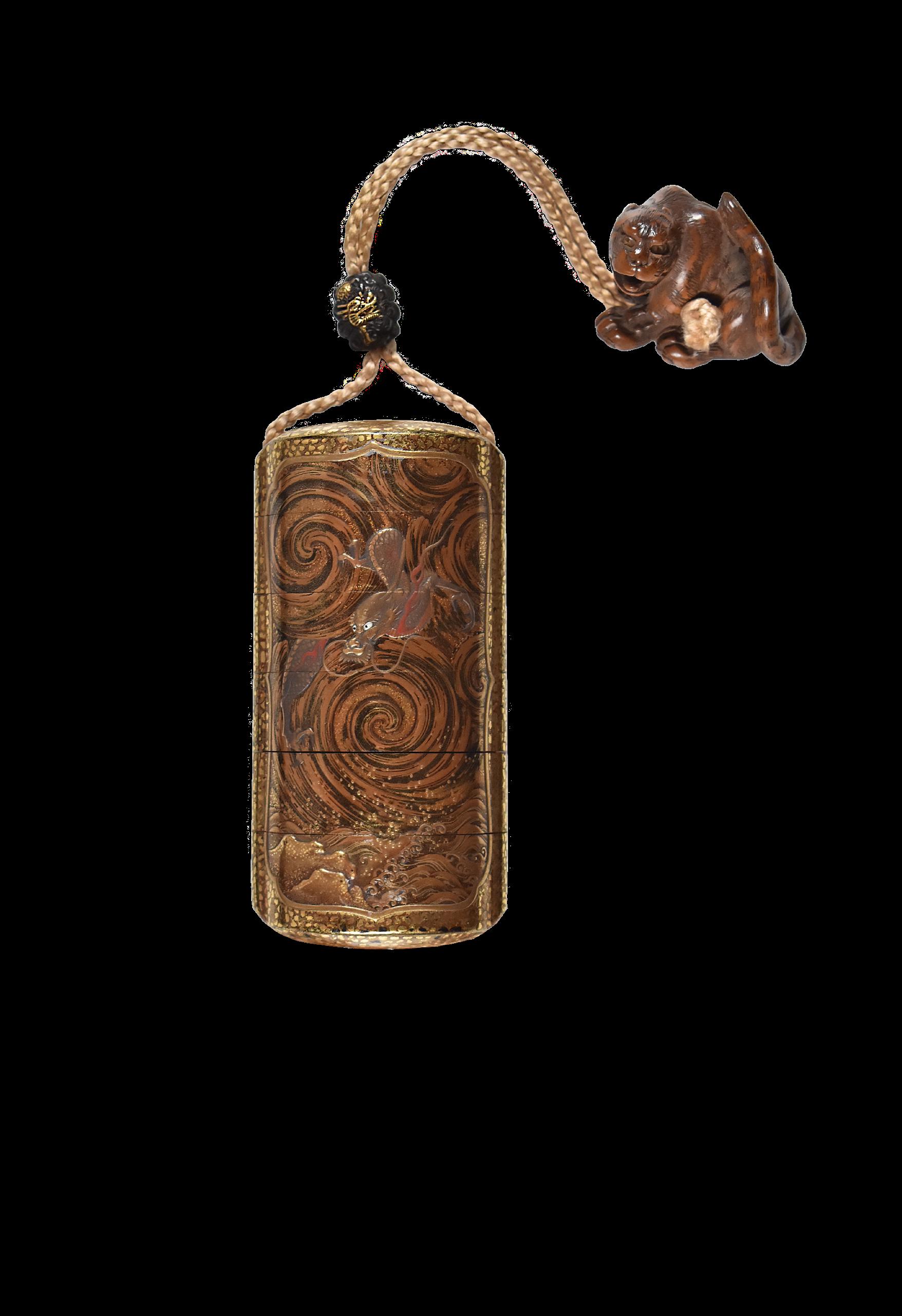
Provenance: Oscar Correia Collection. Demaree and Dorothy Bess Collection. Charles A. Greenfield Collection, purchased at Sotheby’s New York, March 25, 1998, lot 25

58
KAKOSAI LINEAGE
AN INLAID GOLD-LACQUER FOUR-CASE INRO
EDO PERIOD (1615-1868), EARLY 19TH CENTURY
The lenticular body with a takamaki-e, and sheltered beneath a gnarled pine branches overhanging a cascading waterfall flowing down a river, the third in flight on the reverse, the birds finely inlaid in high relief of translucent and coloured horn and shell, the interior of rich nashiji, signed on the bottom case in gold lacquer Kakosai; with a bronze tubular ojime inlaid in silver and gilt with a hawk, unsigned 9cm high
£7,000-8,000
Provenance:
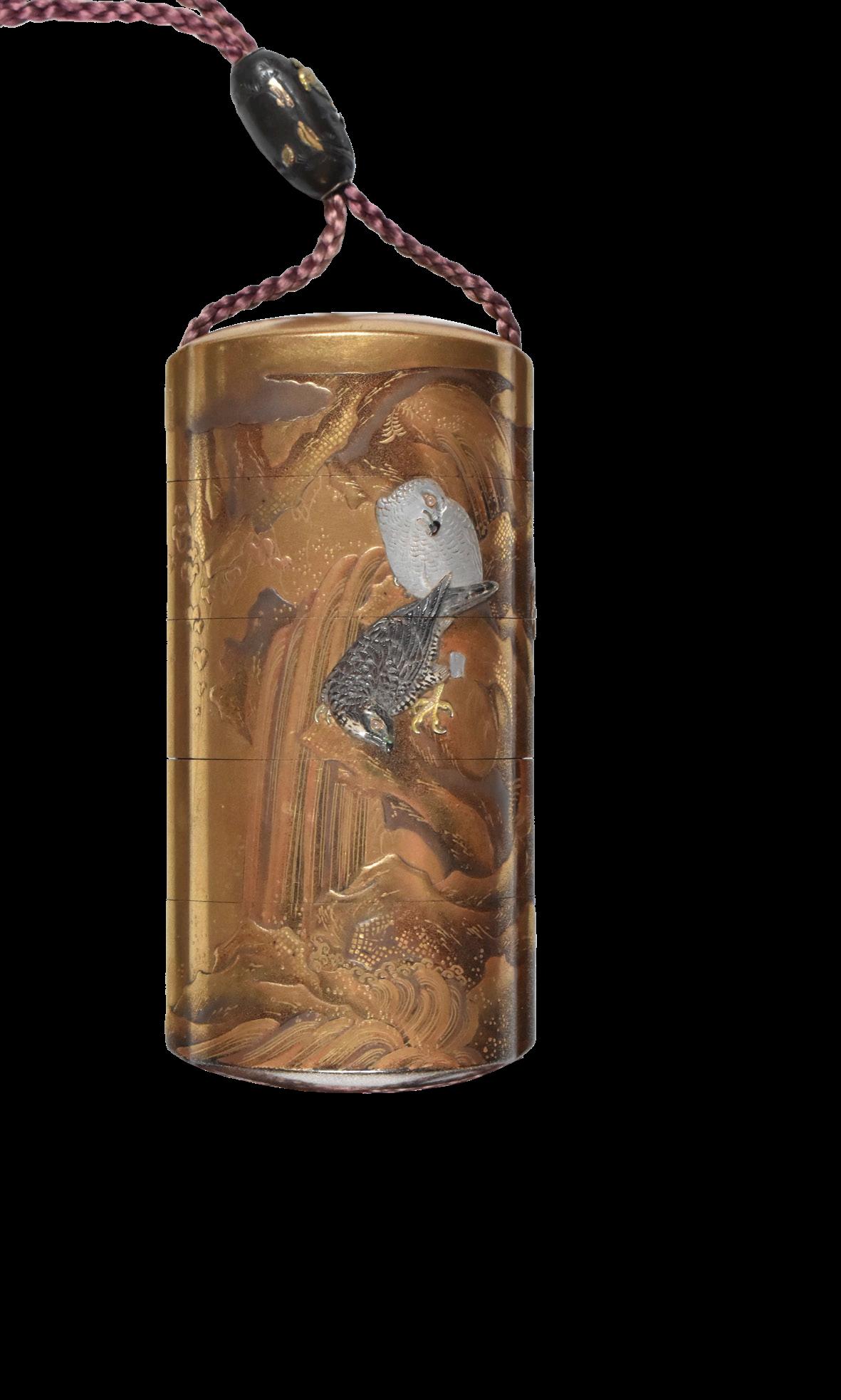

Demaree and Dorothy Bess Collection. Charles A. Greenfield Collection, purchased at Sotheby’s New York, March 25, 1998, lot 78.
Exhibited:
Japan House Gallery, Japan Society, New York, 1972.
Published:
Stern, Harold P., The Magnificent Three, Lacquer, Netsuke and Tsuba, Selections from the Collection of Charles A. Greenfield, New York: Japan House Gallery, Japan Society, 1972, no.144. 58
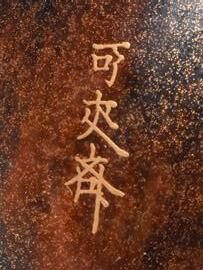
The broad, rounded rectangular body with a dense gyobu ground with subtle details inlaid in shell, depicting two pheasants, one perched on an oak tree, its mate foraging for food on the ground, the interior of rich nashiji, signed on the base with gold lacquer characters Eijusai with a kao; with a black-lacquered ojime carved with stylised flowers and a wood netsuke in the form of Daruma with a hollowed-out back, the patriarch’s face scowling as he meditates, his eyes of bone with dark pupils, the front of his robe applied in high relief with two pieces of charcoal; signed Sansui; with a wood storage box and brocade silk cover (3)
The inro: 8.5cm x 8cm
£3,500-4,000
According to the lacquer researcher Takao Yo, the name of the base of the inro refers to the late Edo-period maki-e artist Tsurushita Eijusai who lived in Edo; see Takao Yo, Kinsei makie-shi meikan (Dictionary of Early-Modern and Modern Lacquerers’ Signatures), Rokusho, 24 (March 2005), p.109.
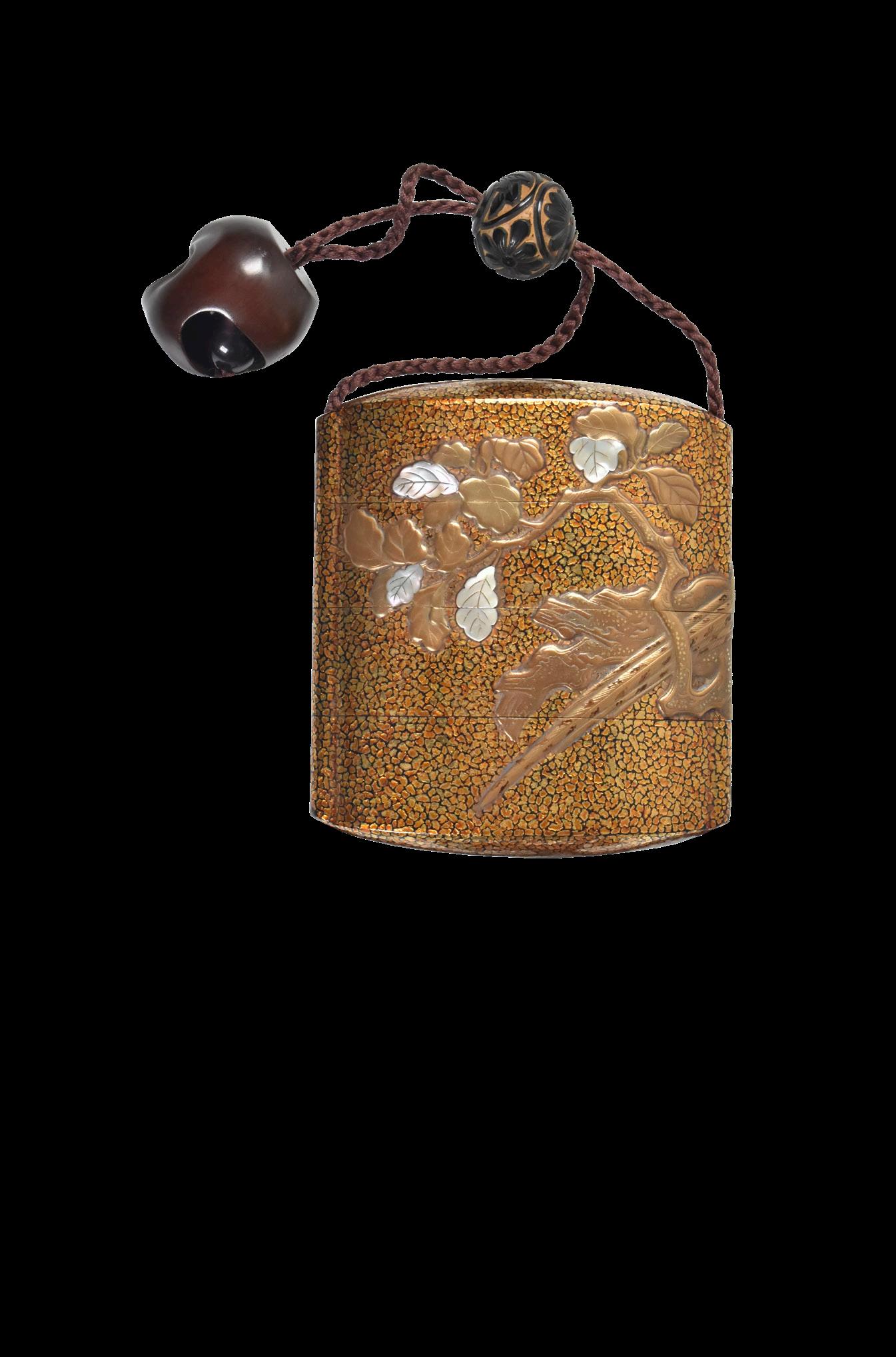


A GOLD-LACQUER FOUR-CASE INRO, EDO PERIOD (1615-1868) OR MEIJI ERA (1868-1912), MID/LATE 19TH CENTURY
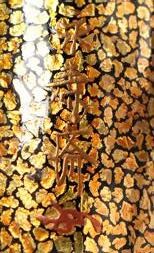

The rounded rectangular body with a kinji ground lacquered in gold and slight colour takamaki-e and hiramaki-e with a peacock with its wings outstretched perched on a branch of cherry with its elaborate tail trailing behind displaying its feathers, the design continuing on the reverse, the interior of rich nashiji, signed on the bottom case in gold lacquer Seiunsai Atsuyoshi with a red-lacquer kao; with a silvered and bronze flattened tubular ojime applied in high relief on one side with Chinese-style potted plants and
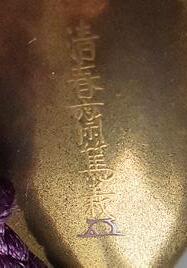
engraved in katakiribori with a mountain on the reverse, and a kagamibuta-style netsuke with a wood bowl and a metal plate case with a moonlit scene of ducks swimming beneath cherry branches; unsigned
8.2cm high
£3,500-4,500
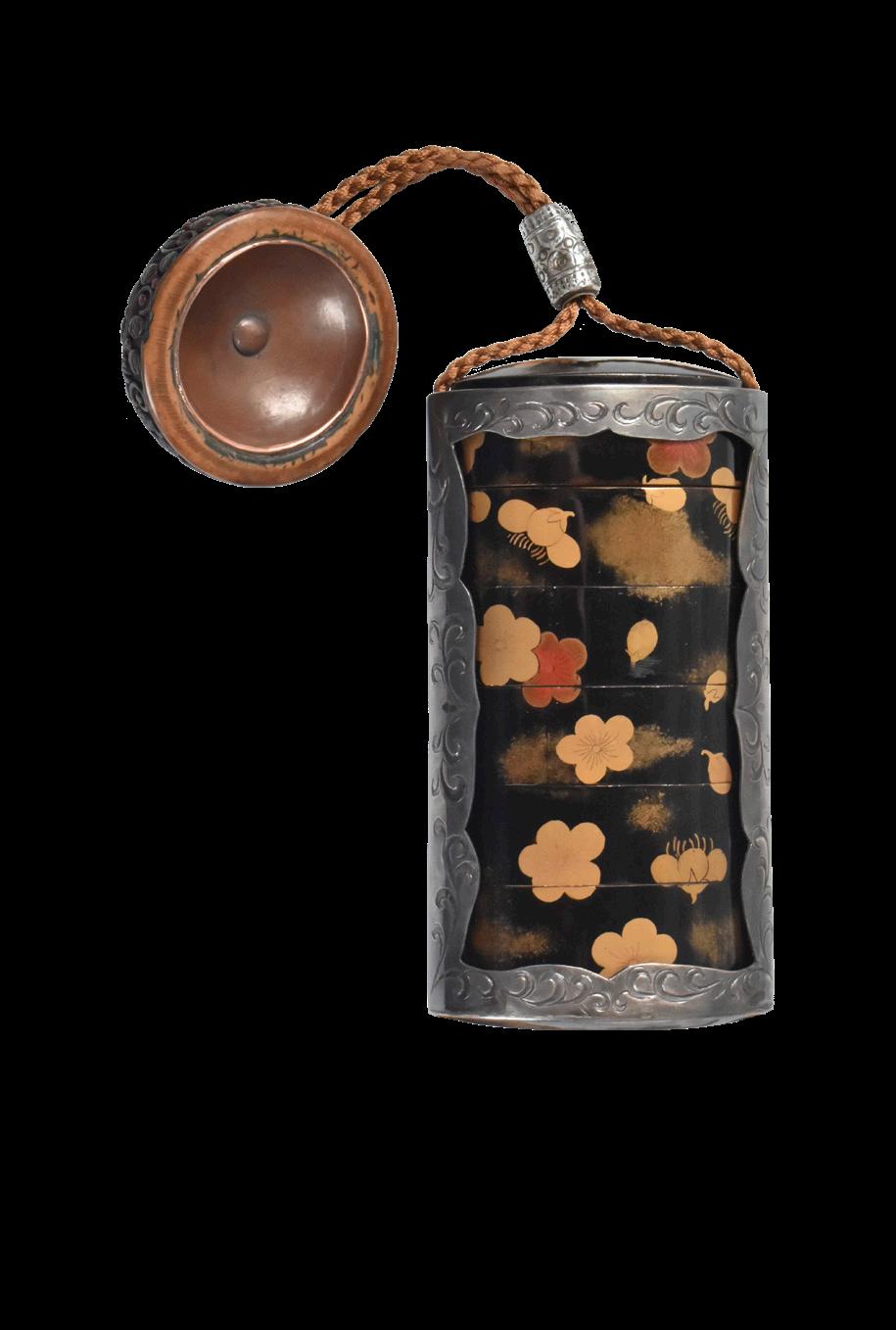
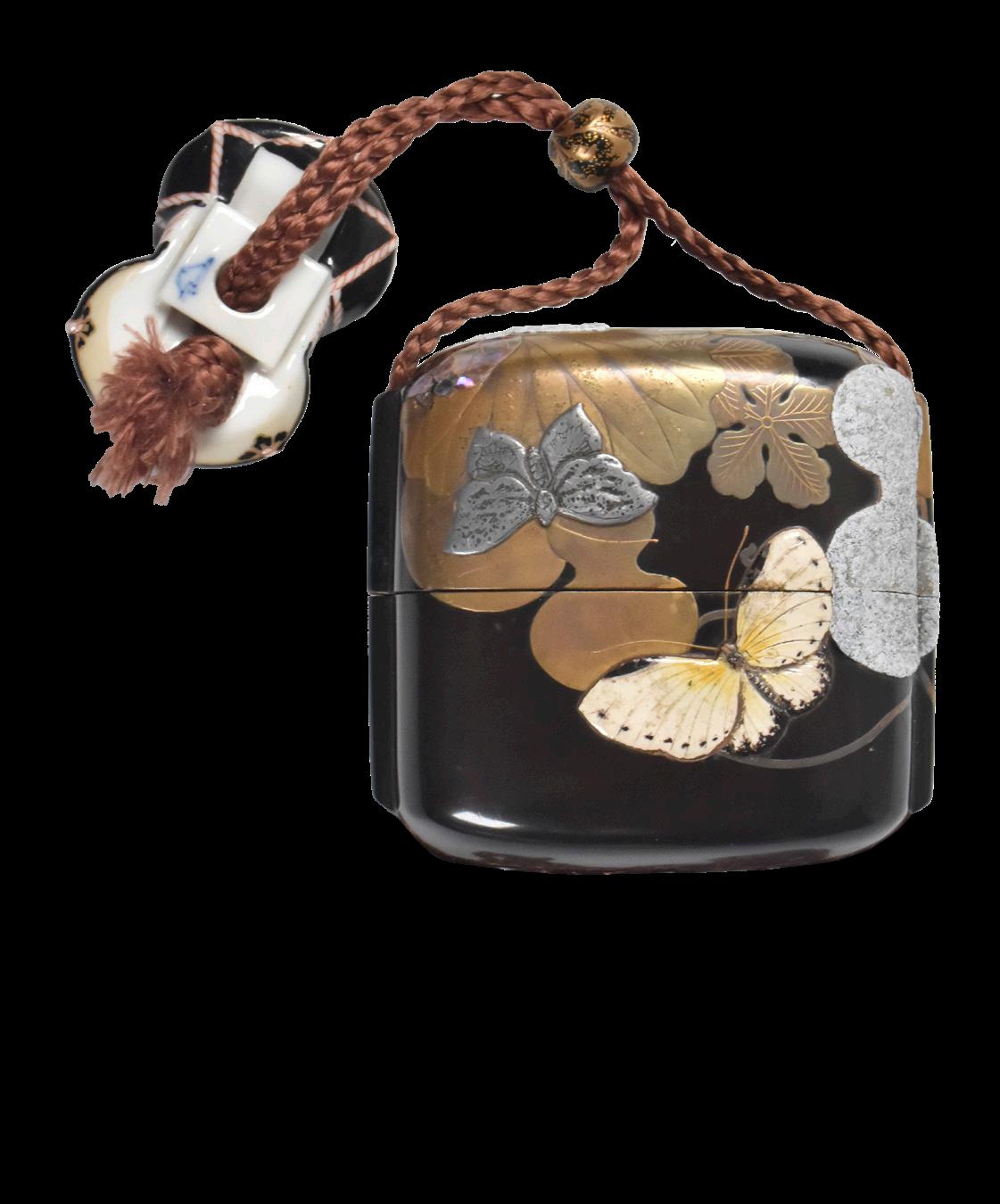
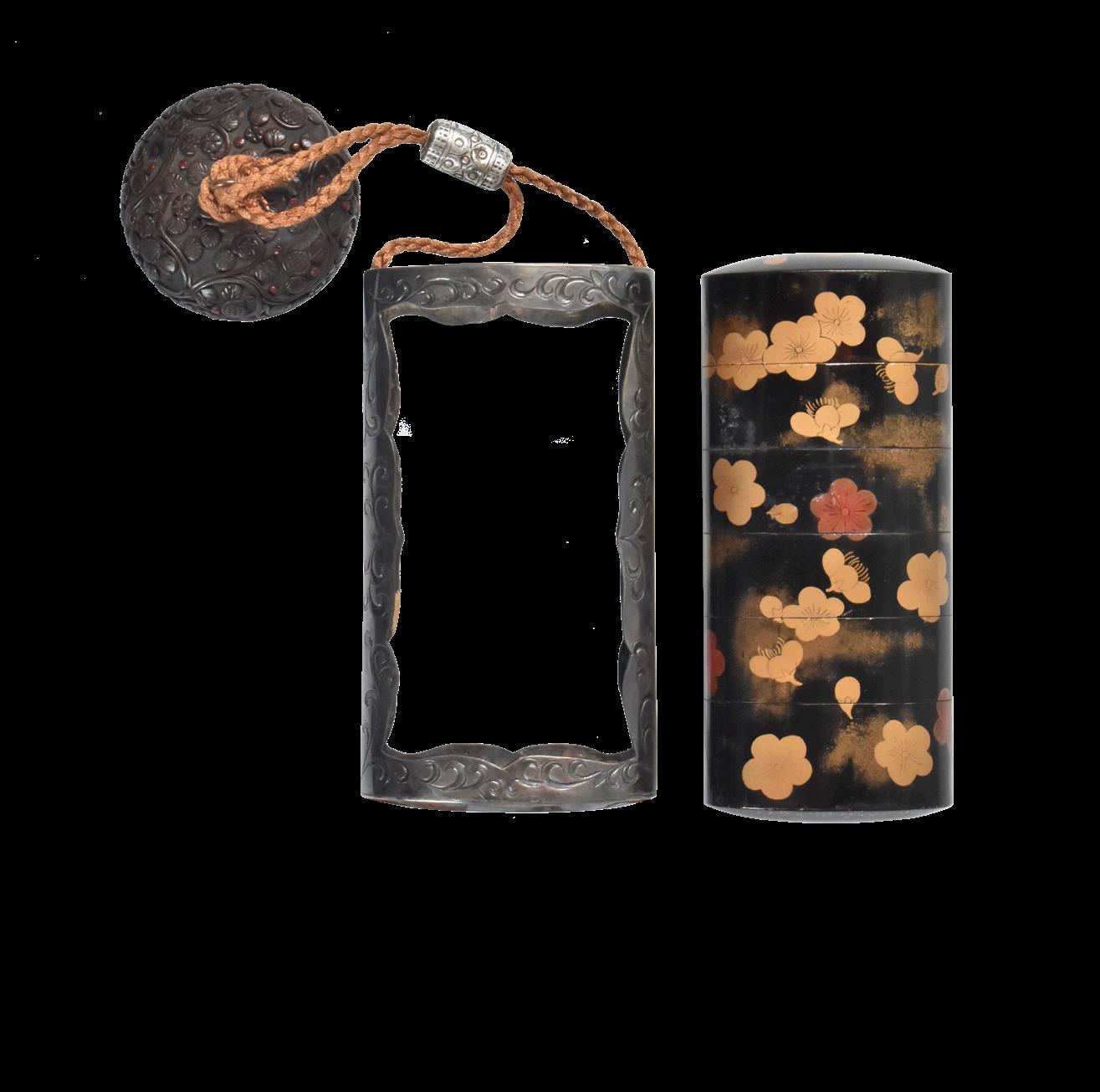
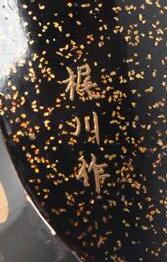

The outer silvered-metal saya (sheath) engraved with stylised tendrils housing within a five-case inro of lenticular plan with a lustrous roiro-nuri ground decorated in gold and red hiramaki-e and mura-nashiji with falling cherry blossoms and buds, the
characters Kajikawa saku; fitted with a silvered-metal cylindrical ojime decorated with geometric motifs and a wood and brass netsuke in the form of an alms bowl applied on the outside with stylised flowers and tendrils in low relief, unsigned
The inro: 10.5cm x 5.7cm
£4,000-5,000
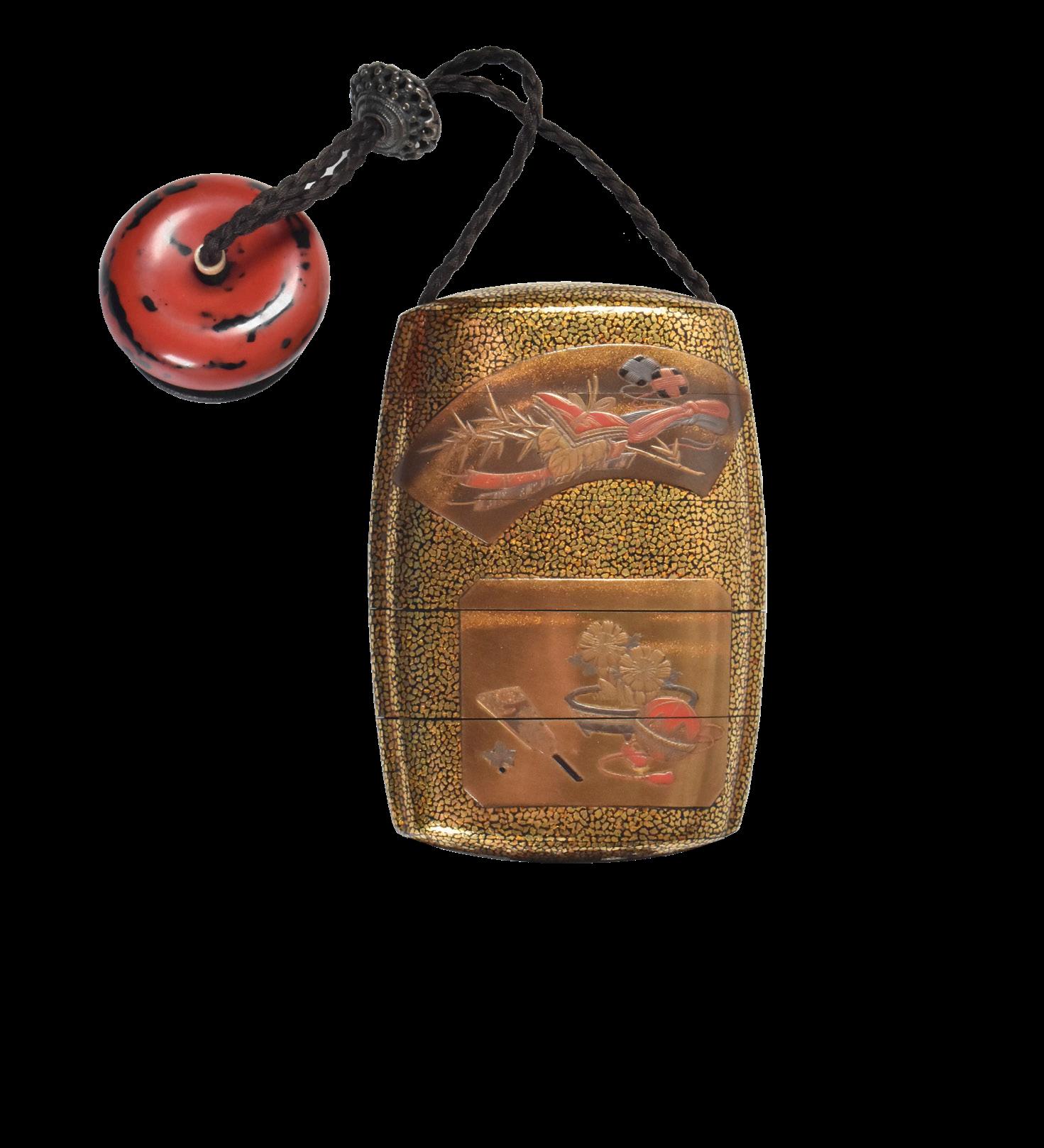
The broad rounded rectangular body with a black-lacquer ground decorated in gold hiramaki-e and applied in high relief of pewter and glazed pottery with three butterflies of different species hovering over among a loofah gourd plant suspended from a branch with large leaves and blossoms, with details inlaid in shell and e-nashiji, the design continuing over the top and onto the reverse, the interior of black-lacquer with a removable en-suite tray, signed on the base within a ceramic seal Kenya; with a gold-lacquered ojime decorated with stylised leaves, and a polychromed-glazed ceramic netsuke in the form of a tsuzumi (hand drum), signed with the mark of the Fukagawa Company
The inro: 7cm x 7cm
£3,000-4,000
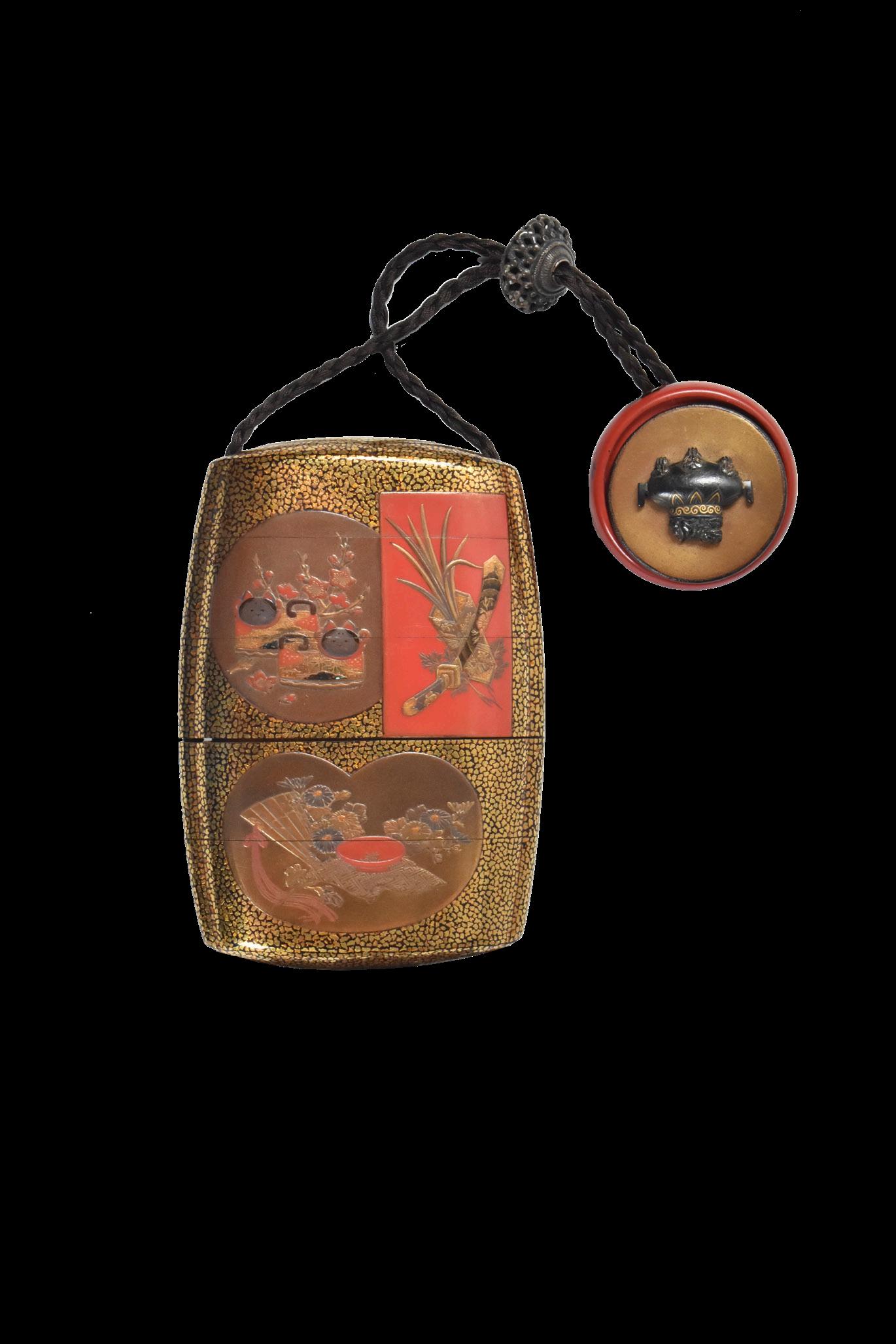
panels comprising: hagoita (battledore) and temari (silk ball thread) for Jinjitsu no sekku on the seventh day of the first month; inubako (dog-shaped papier-mâché boxes used as good luck charms for child birth) for Jomi no sekku on the third day of the third month; iris leaves wrapped in a noshi (celebratory paper) and a decorative toy sword for Tango no sekku on the fifth day of the fifth month; a kaji (paper mulberry) leaf wrapped in red paper with elaborate bows and a bamboo plant tied with two tanzaku (poem slips) for Tanabata no sekku (the Star Festival) on the seventh day of the seventh month, and chrysanthemums, a folding fan, and a sake cup for Kiku no sekku on the ninth day of the ninth month, the interior of rich nashiji, signed on the base with gold lacquer characters Koma Koryu saku; with a filigree silver ojime, and a kagamibuta netsuke, the bowl of Negoro-style fitted with a gold plate applied with an elaborate Chinese-style incense burner inlaid in high relief of shakudo with flat relief details of gold
9cm x 6cm
£5,000-6,000
64Ω

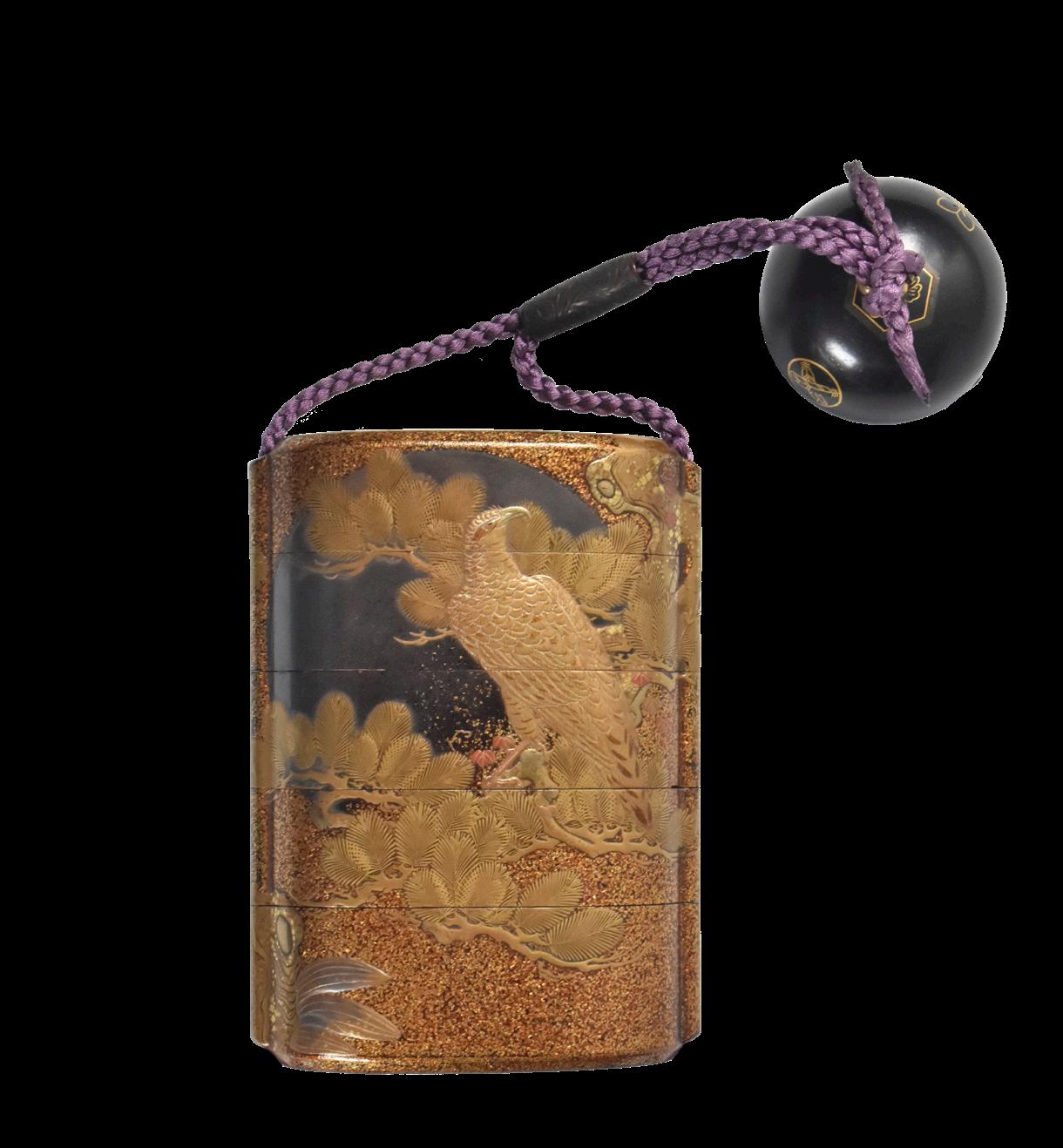
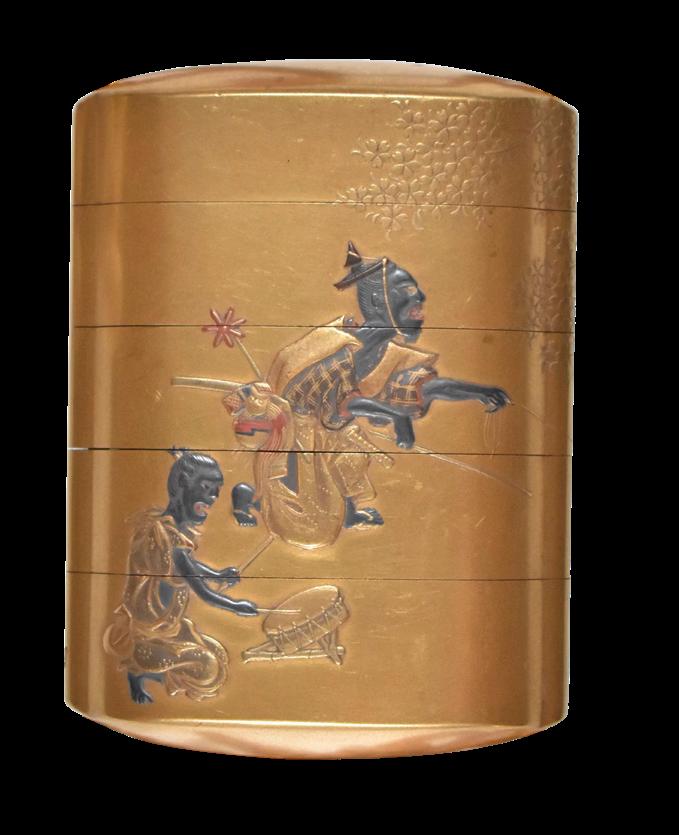
KOAMI LINEAGE
A GOLD-LACQUER FOUR-CASE INRO
EDO PERIOD (1615-1868) OR MEIJI ERA (1868-1912), 19TH/2OTH CENTURY
The wide, rounded rectangular body with a rich nashiji ground decorated in gold takamaki-e and silver hiramaki-e with highlights of kirikane and red hiramaki-e depicting a kestrel perched on a pine branch with the full moon in the background and three sparrows in flight on the reverse, the interior of rich nashiji, signed on the base with gold hiramaki-e characters Kanko Koami Inaba with a redlacquer kao; with a brass tubular ojime engraved with plants and foliage and a shakudo netsuke in the form of an alms bowl inlaid in gold flat relief with three assorted mon (crests) 9cm x 7cm
£5,000-6,000
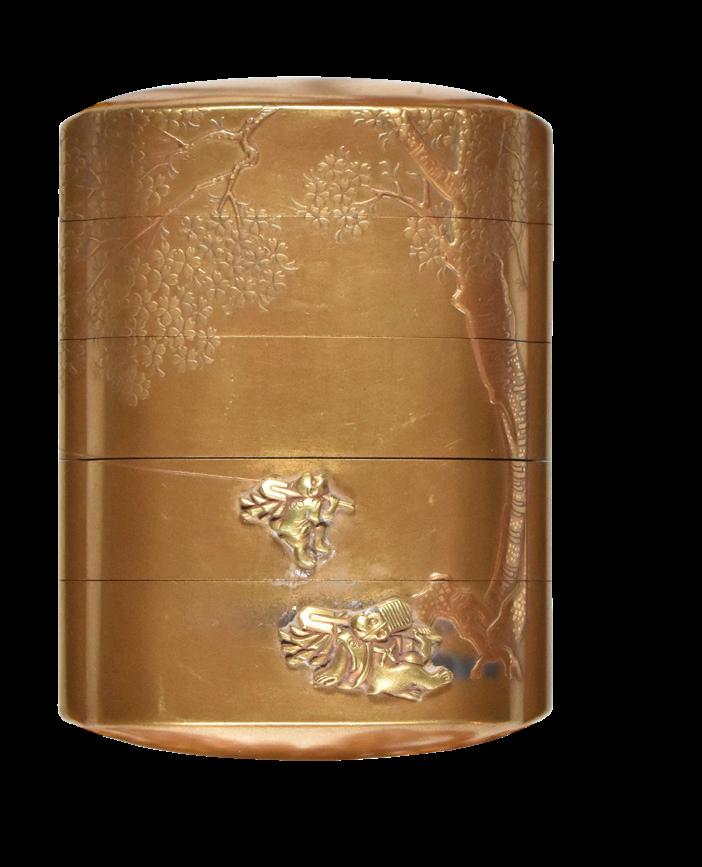
65
AN INLAID GOLD-LACQUER FOUR-CASE INRO
EDO PERIOD (1615-1868) OR MEIJI ERA (1868-1912), MID/LATE 19TH CENTURY
The rounded rectangular body with a kinji ground decorated in gold and silver takamaki-e with a humourous scene enacting a Shinto ritual, depicting a sarumawashi (monkey trainer) and two monkeys applied in high relief of gold, masquerading as a gohei zaru, one side with a man beating a drum beside the monkey trainer kneeling and holding a leash tied to his performing pet shown on the other side carrying over its shoulder a gohei (wooden wand decorated with shide [zigzagging paper streamers]), a second monkey resting at the foot of the cherry tree, the interior of rich nashiji, unsigned; with a glass bead ojime 6.8cm high
£2,500-3,500
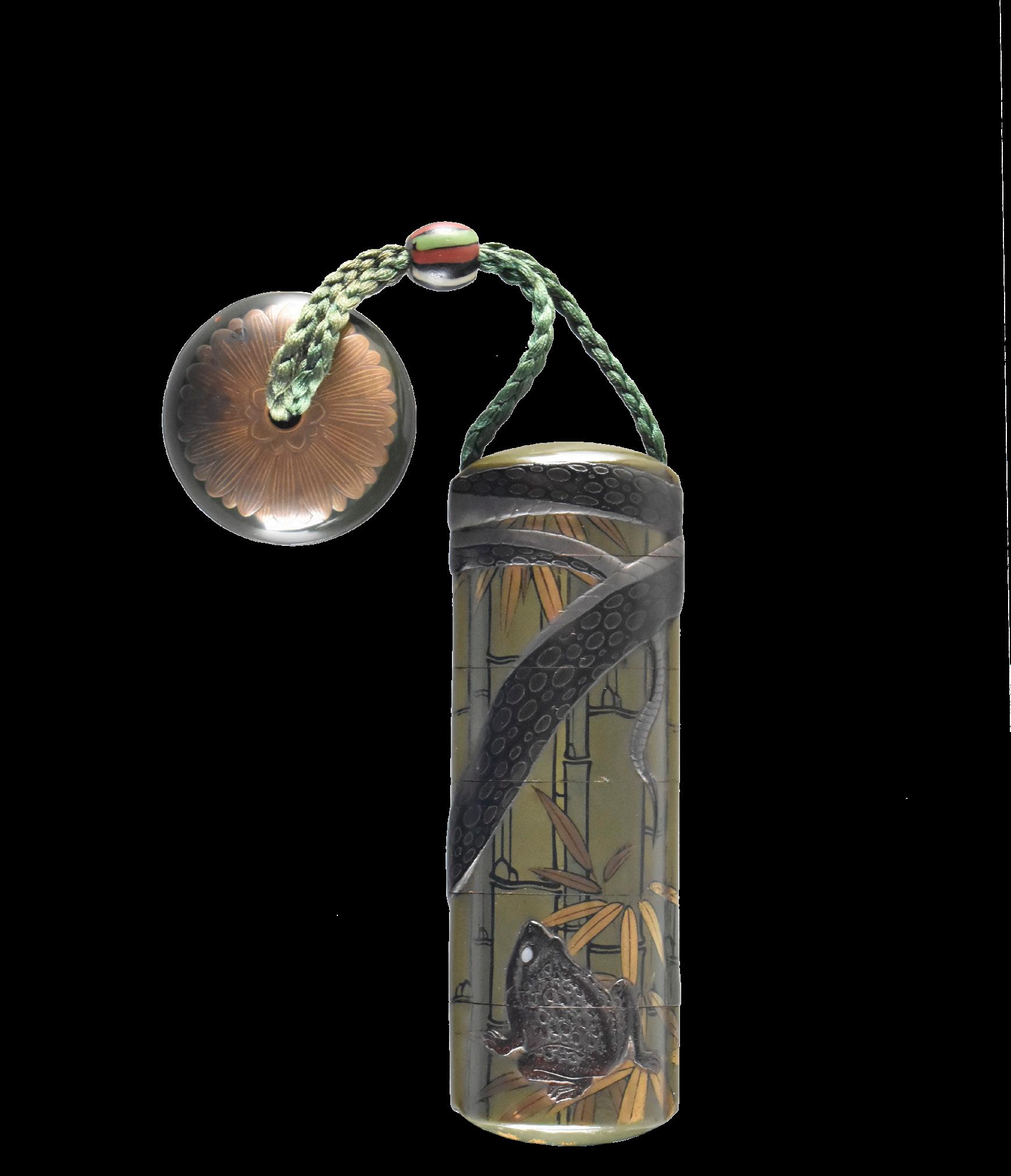
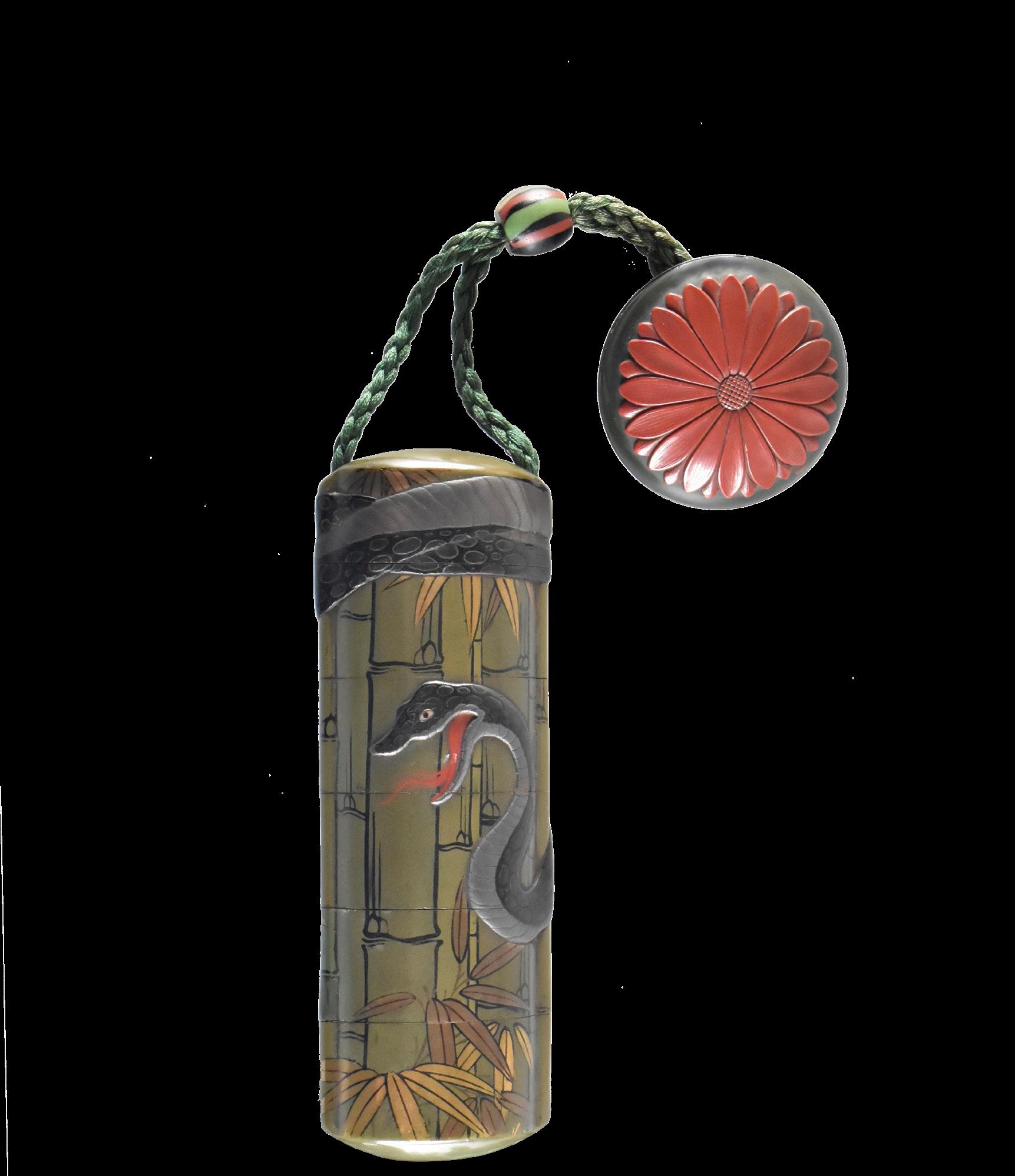
FIVE-CASE INRO
EDO PERIOD (1615-1868), 19TH CENTURY
The slender upright body with a green-lacquered ground decorated in silver, black and red takamaki-e and gold and black hiramaki-e with a snake shown with its mouth wide open in a hiss and its long body winding around a toad shown on the reverse resting on bamboo leaves, the eyes of the snake and toad inlaid, the interior of rich nashiji, the bottom case bearing gold hiramaki-e characters Yoyusai; with a polychrome striped ceramic ojime and a green-lacquer two-part manju-netsuke decorated in gold and red takamaki-e with a large chrysanthemum blossom on the front and reverse; unsigned
11cm x 4cm
£8,000-10,000
It is not immediately obvious that the toad has half swallowed a slug. The term sansukumi refers to the three creatures depicted. While the snake can devour the toad, and the toad the slug, both without adverse consequences, the slug carries a toxin which would poison the snake were it to ingest a toad that had swallowed a slug
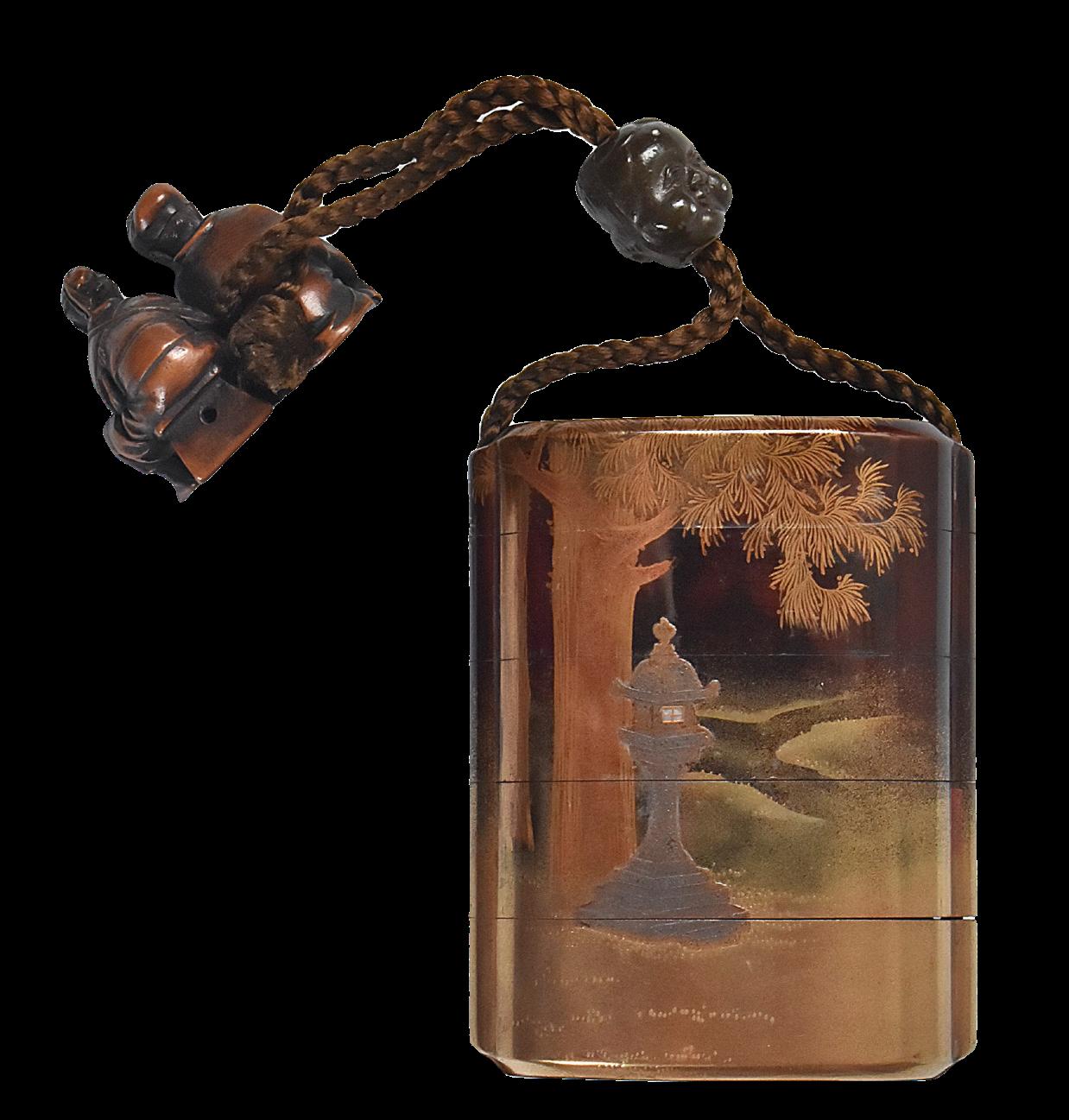

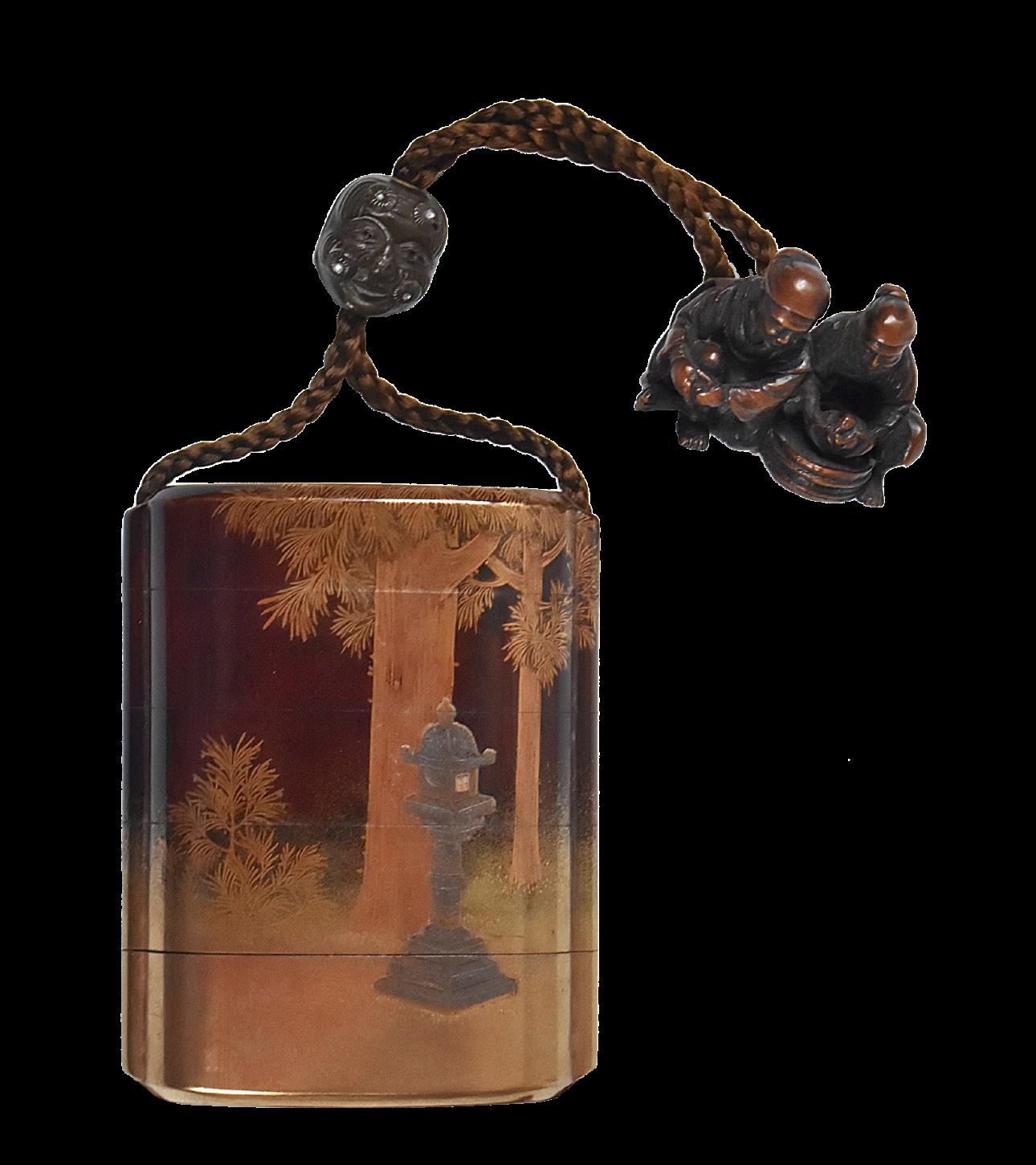
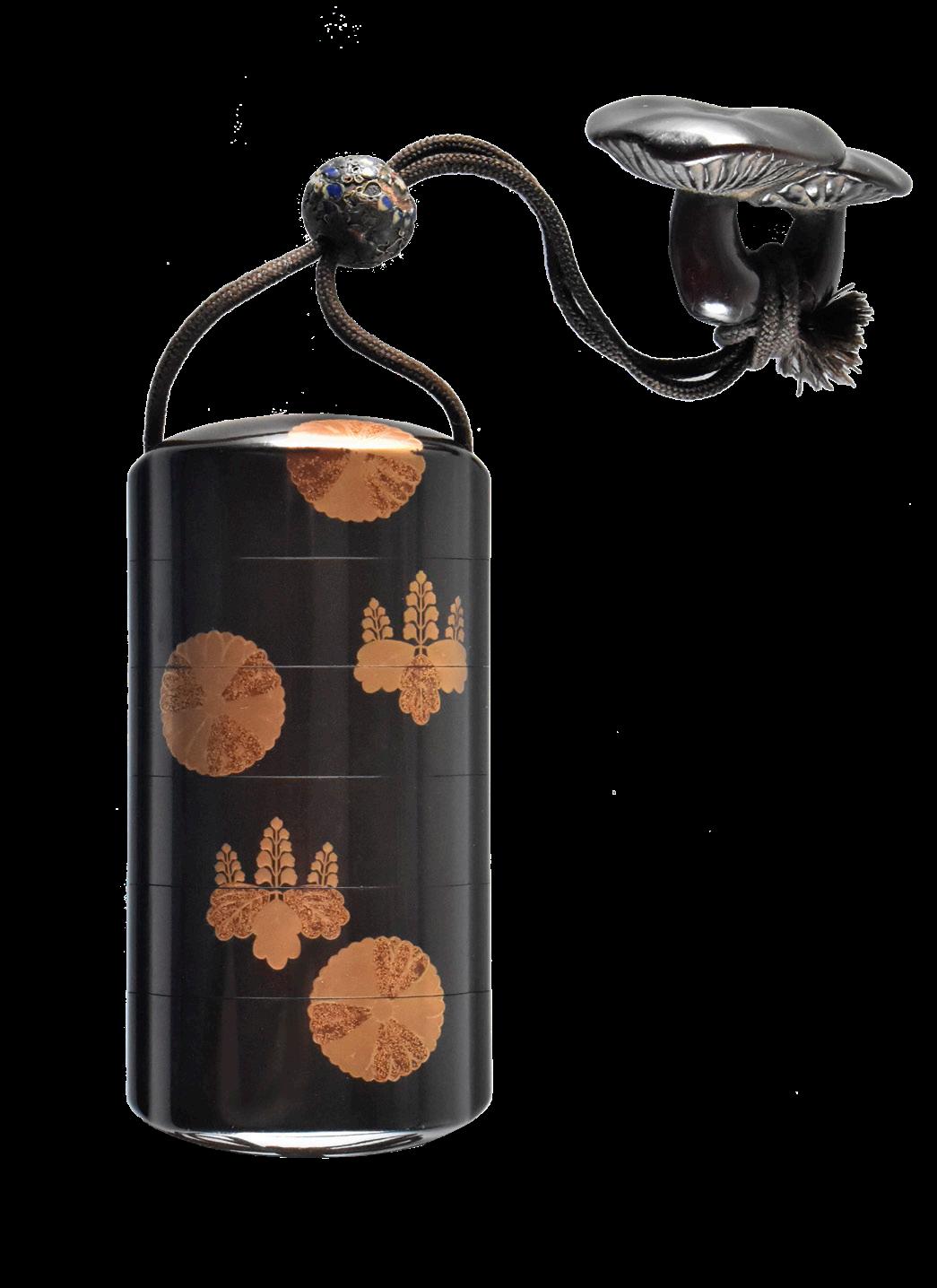
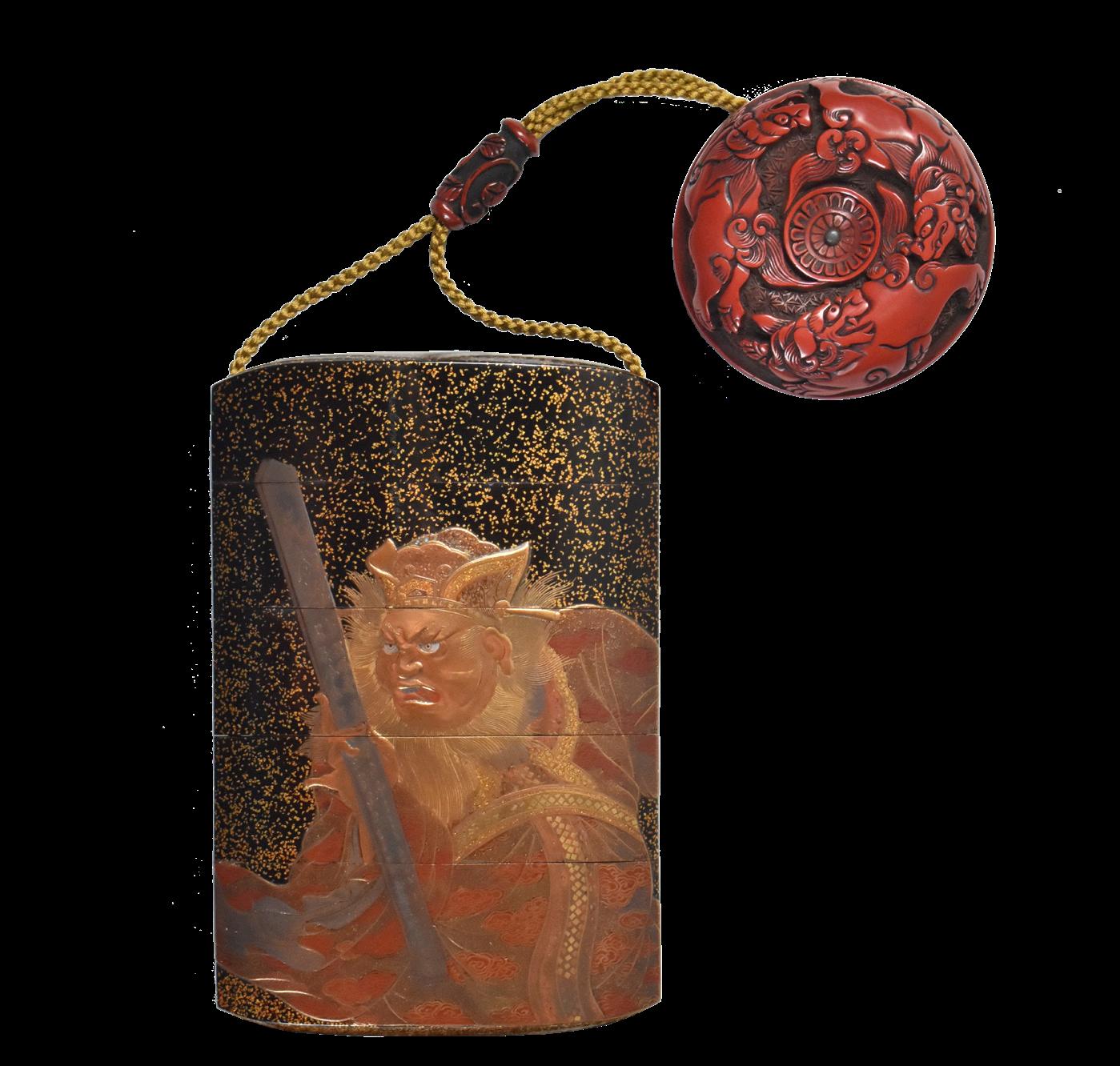

67Ω
SHIOMI MASANARI LINEAGE
A GOLD-LACQUER FOUR-CASE INRO
EDO PERIOD (1615-1868), 19TH CENTURY
The rounded rectangular body with a black-lacquer ground decorated predominantly in gold togidashi maki-e, grey hiramaki-e and e-nashiji depicting on both sides a toro (stone lantern) beside cedar trees, the interior of black lacquer, signed with a typical Shiomi-style red-lacquer seal Shiomi Masanari; with a wood ojime in the form of a double-sided Kyogen and Noh mask netsuke with Okame on one side and Okina on the other, unsigned; and a wood netsuke of an old couple seated in front of a wood wash basin the old woman holding a peach alluding to the story of Momotaro; signed on the base Masatoshi
7.7cm x 6cm
£4,000-5,000
68Ω
AFTER HARA YOYUSAI
A BLACK-LACQUER FIVE-CASE INRO, EDO PERIOD (1615-1868), 19TH CENTURY
The lenticular body with a lustrous roiro-nuri ground decorated in gold hiramaki-e and e-nashiji with scattered mon (crests) including the kiri-mon (paulownia crest), the interior of rich nashiji, inscribed on the base with gold lacquer characters Yoyusai; with a cloisonnéenamel bead ojime enamelled with a profusion of flowers and a wood netsuke in the form of two mushrooms; unsigned
The inro: 9.1cm high
£2,500-3,000


69Ω
KOMA KORYU LINEAGE AND HASEGAWA SHIGEYOSHI
A LACQUER FOUR-CASE INRO, EDO PERIOD (1615-1868), 18TH/19TH CENTURY
The broad, flattened rectangular body with a sparsely flecked gold ground finely decorated in gold, red-copper and silver hiramaki-e with highlights subtly executed in shell, e-nashiji and kirikane, with a portrait of Emma-O, judge of Hell and King of the Underworld, his eyes inlaid in glass with dark pupils, holding a tablet in one hand and a baton shown on the reverse in the other, the interior of rich nashiji, signed on the inscribed tablet Koma Koyru saku and on the base with gold lacquer characters Shigeyoshi; with a tsuishu (carved red lacquer) tubular ojime and a tsuishu (carved red lacquer) manjunetsuke carved with three prancing shishi and leafy peony blossoms on the reverse, unsigned
10cm x 7cm
£5,500-6,000
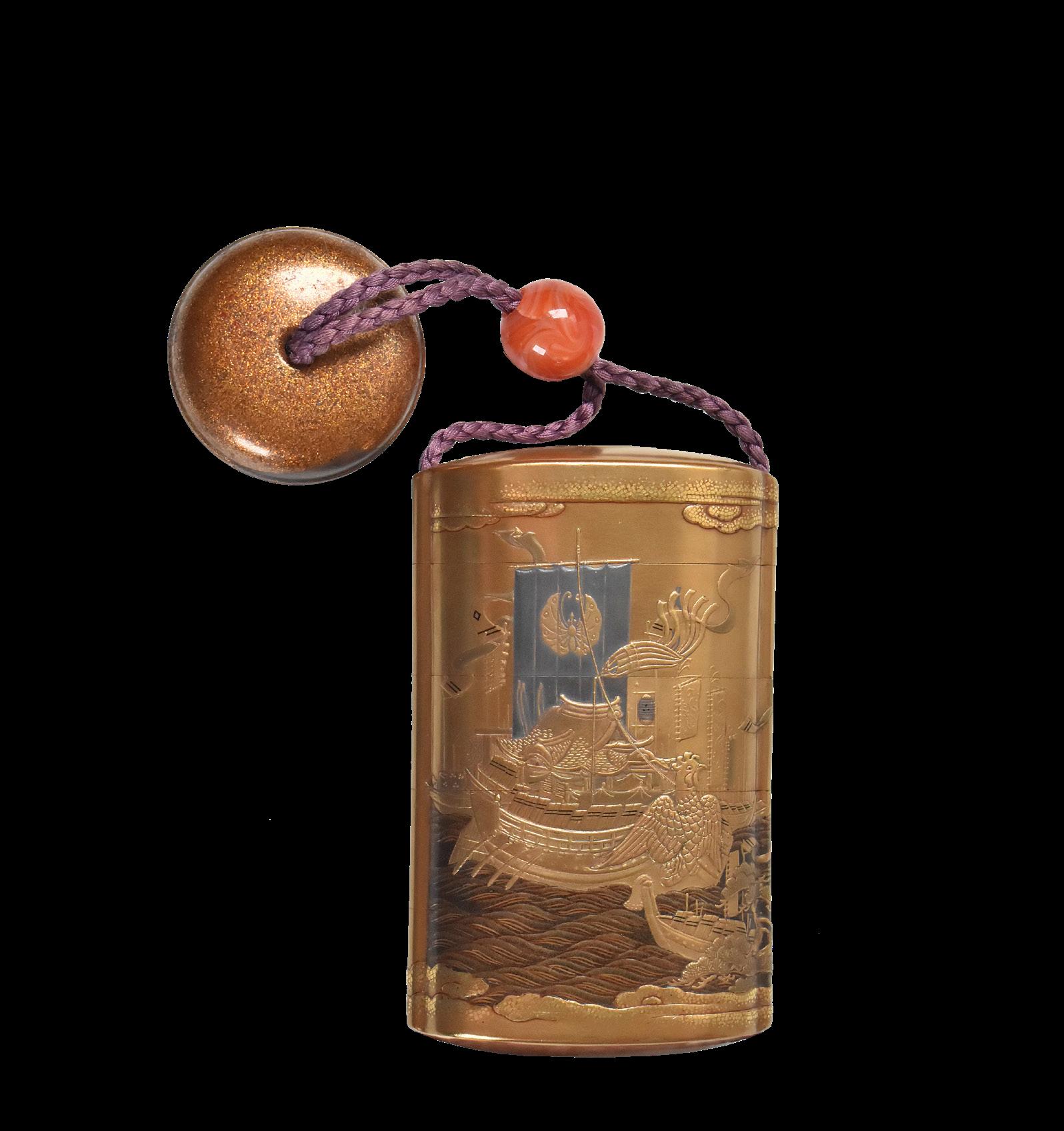
70Ω
KAJIKAWA BUNRYUSAI LINEAGE
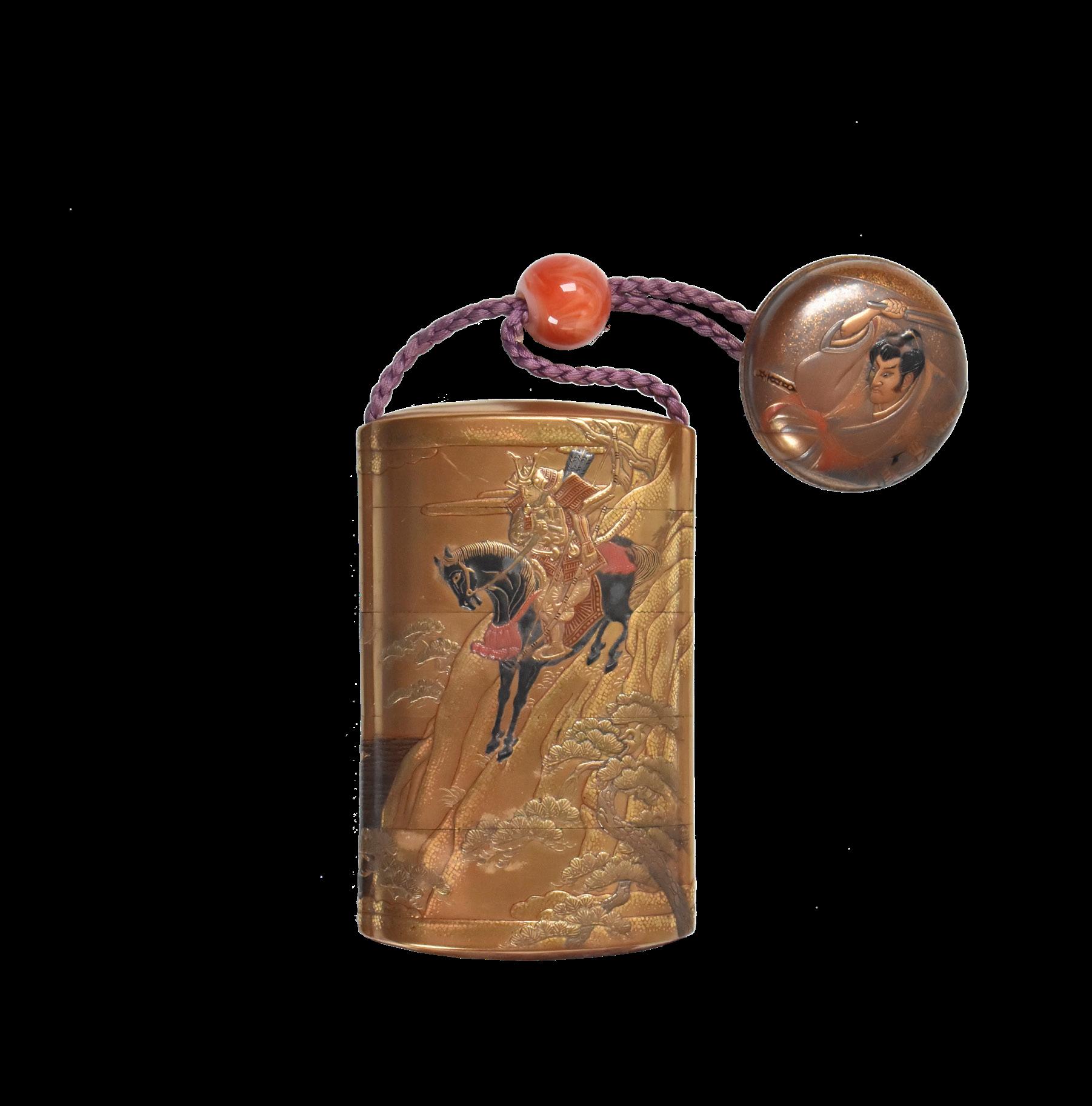
A GOLD-LACQUER FOUR-CASE INRO
EDO PERIOD (1615-1868), 19TH CENTURY
The rounded rectangular body with a kinji ground richly decorated in gold, red, black and silver takamaki-e, togidashi maki-e with extensive use of kirikane with a scene from the Battle of Ichinotani, showing Minamoto no Yoshitsune on horseback rushing down the steep ravine of Hiyodorigoe, the reverse with the enemy ships of the Taira clan, the interior of rich nashiji, the base signed with gold lacquer characters Kajikawa Bunryusai saku; with a gold lacquer two-part manju-netsuke decorated in gold, red, black and grey takamaki-e with a kabuki actor of the Ichikawa family, wielding a fan, unsigned
10cm x 6.2cm
£4,000-5,000
TADAKAZU OF OSAKA
A BOXWOOD THREE-CASE INRO IN THE FORM OF A TURTLE WITH EN-SUITE OJIME AND NETSUKE
EDO PERIOD (1615-1868) MID-/LATE 19TH CENTURY
The large turtle naturalistically carved and stained for effect, resting, almost entirely enveloped within its carapace, its head slightly protruding and turned to the right, all its legs retracted within its carapace, signed on the underside within an oval reserve Tadakazu, 9cm high; with en-suite ojime in the form of a turtle and an en-suite netsuke also in the form of a turtle; unsigned
£3,000-4,000
72Ω
SOMADA STYLE
A SHELL-INLAID YATATE (PORTABLE BRUSH AND INK CONTAINER)
MEIJI ERA (1868-1912), LATE 19TH/EARLY 20TH CENTURY
Entirely inlaid with iridescent small flakes of shell to create repeated tightly-clustered hanabishi-mon (flowery-diamond crests), the cylindrical tapered bowl inlaid with vertical bands of shell, the matching hinged shell-inlaid cover inlaid with shippotsunagi (linked-cash), unsigned 14cm long
£1,500-2,000
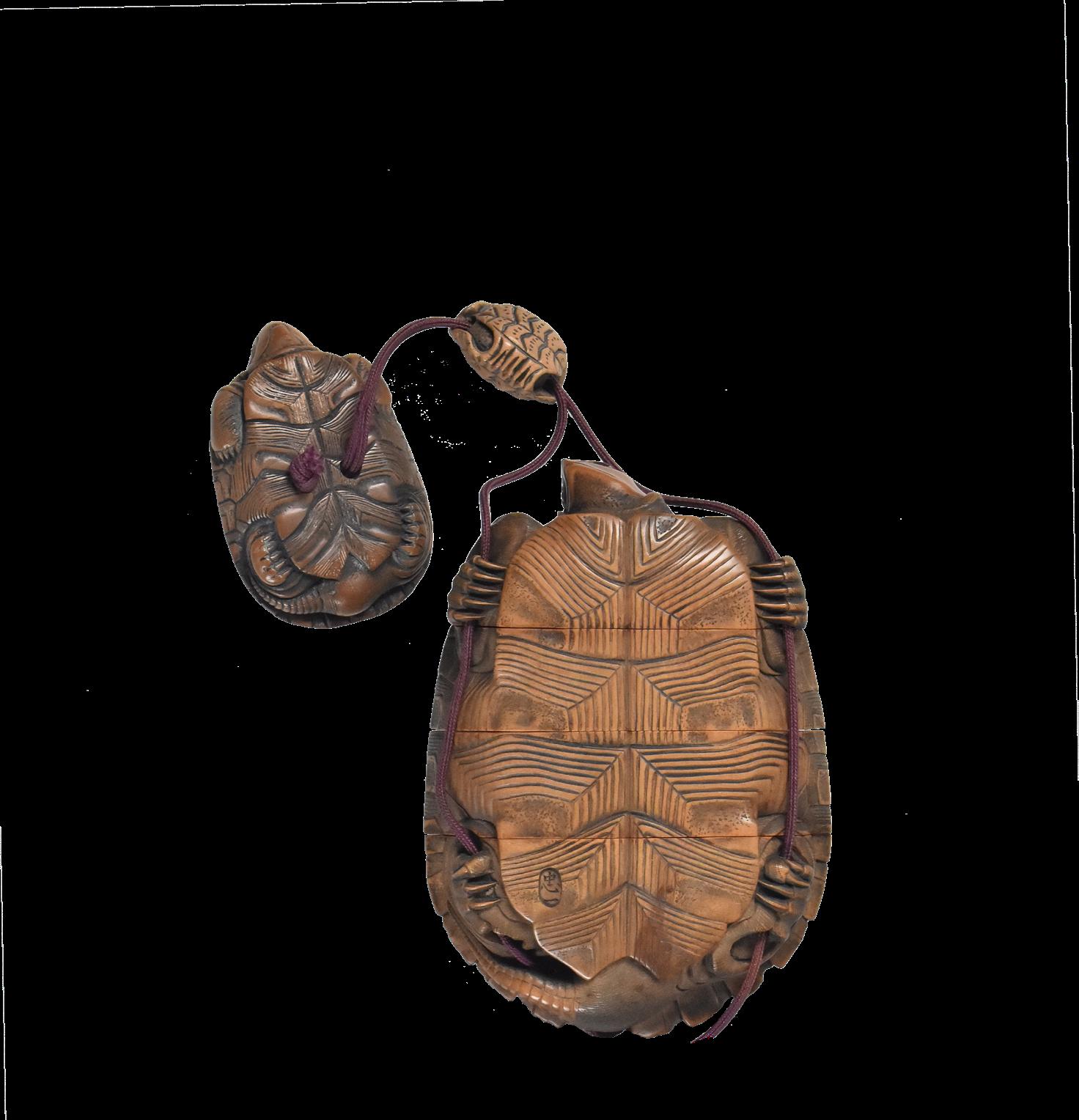
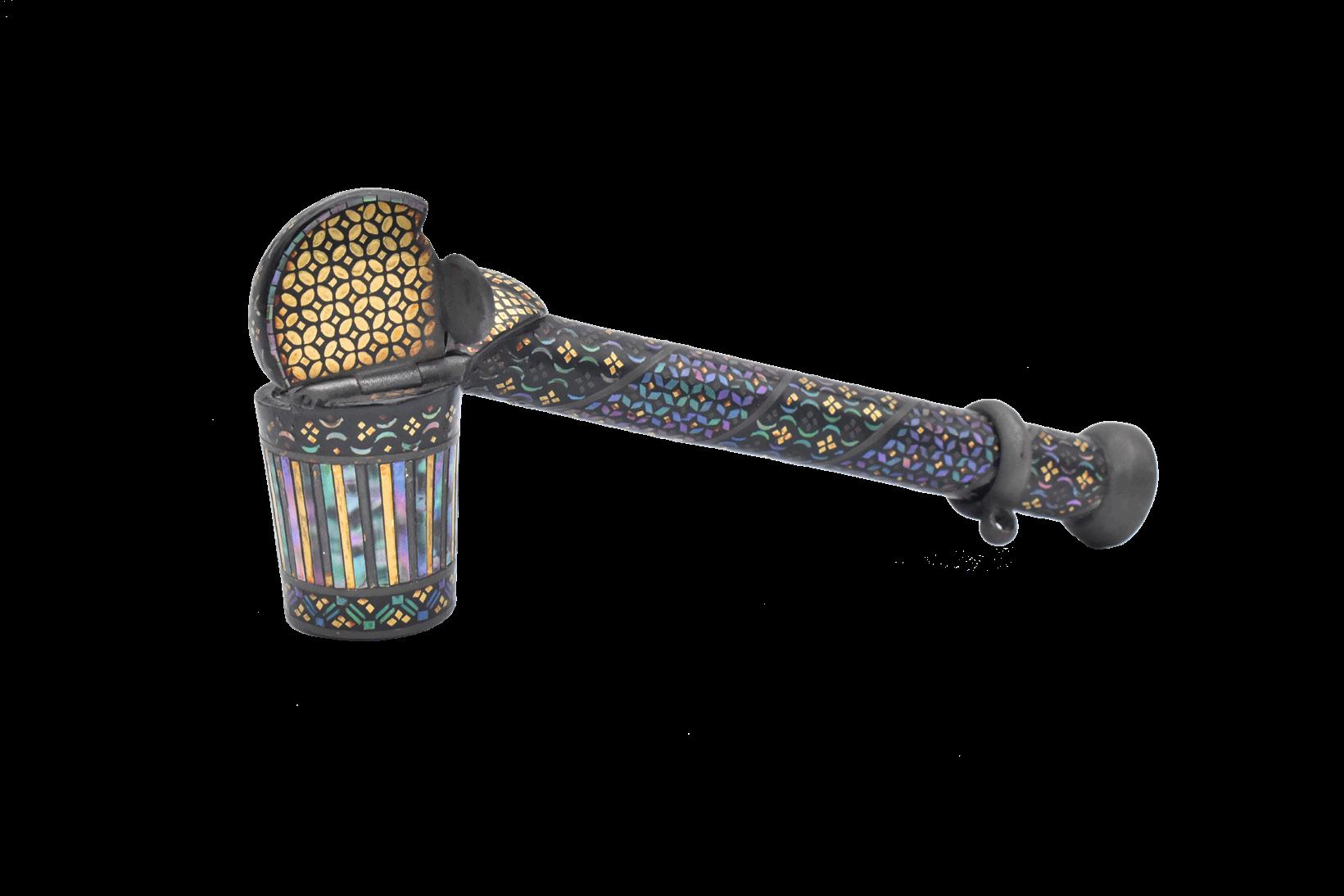
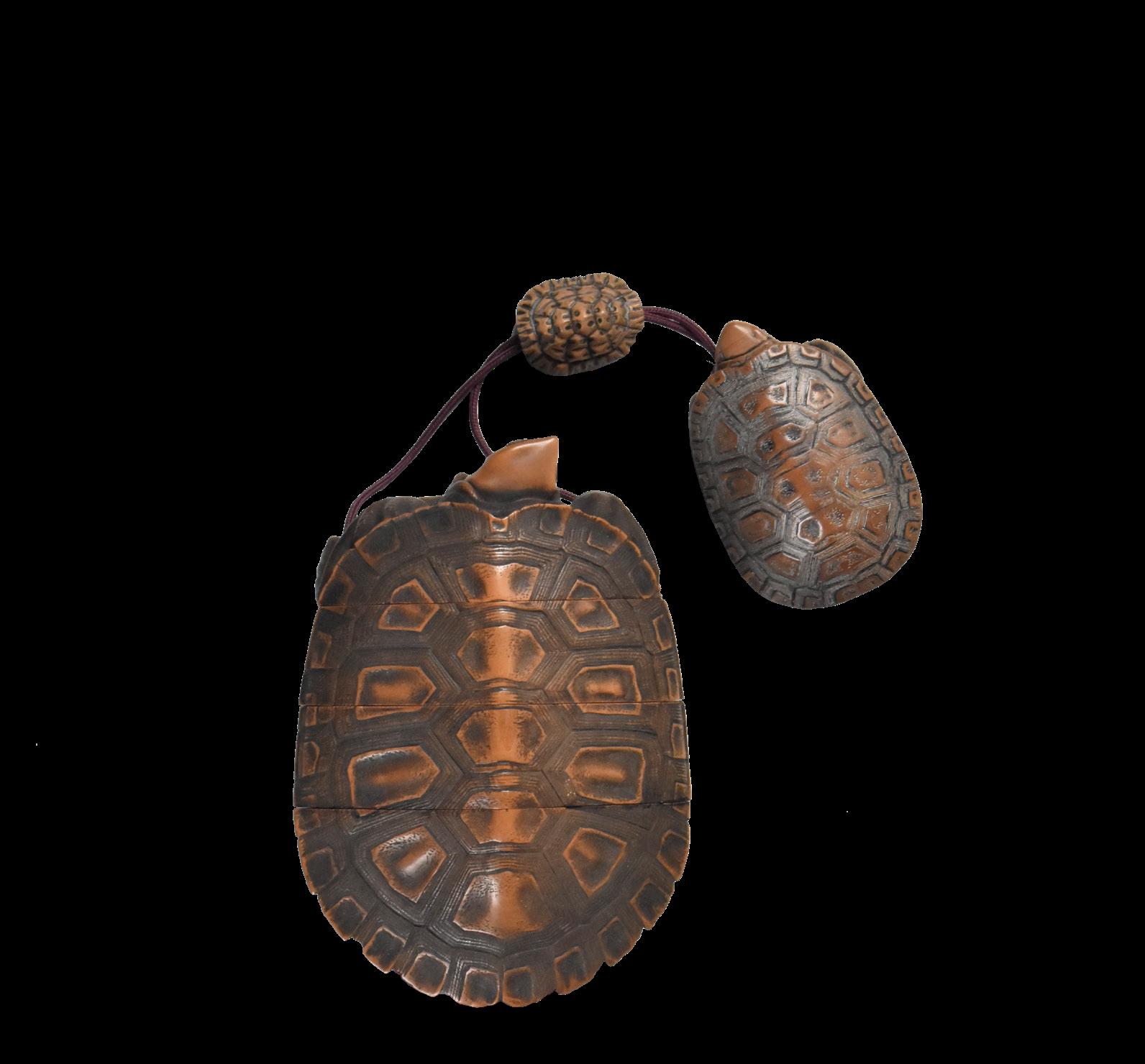
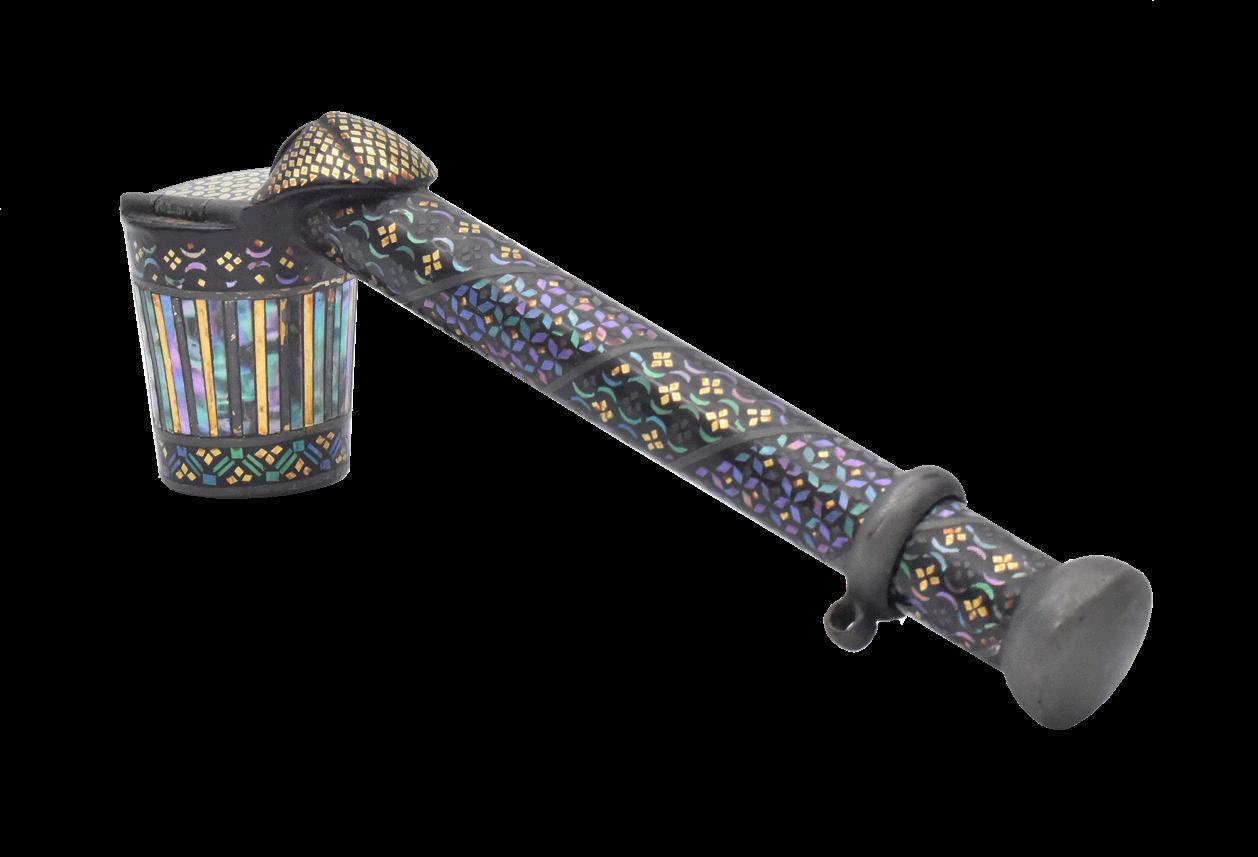
Cast with leafy vines trailing over the entire body of the gourd, one leaf forming the hinged cover opening to reveal an ink reservoir within, the screw top removable and fitted with a brush; unsigned; with a wood storage box (2)
6.5cm high
£900-1,200
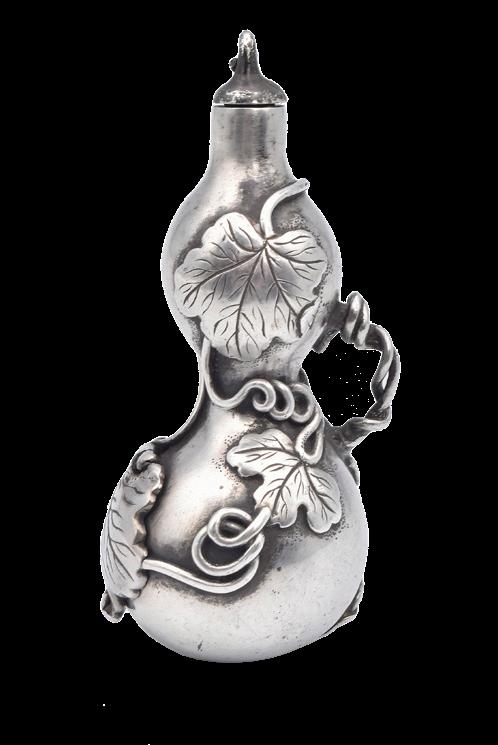
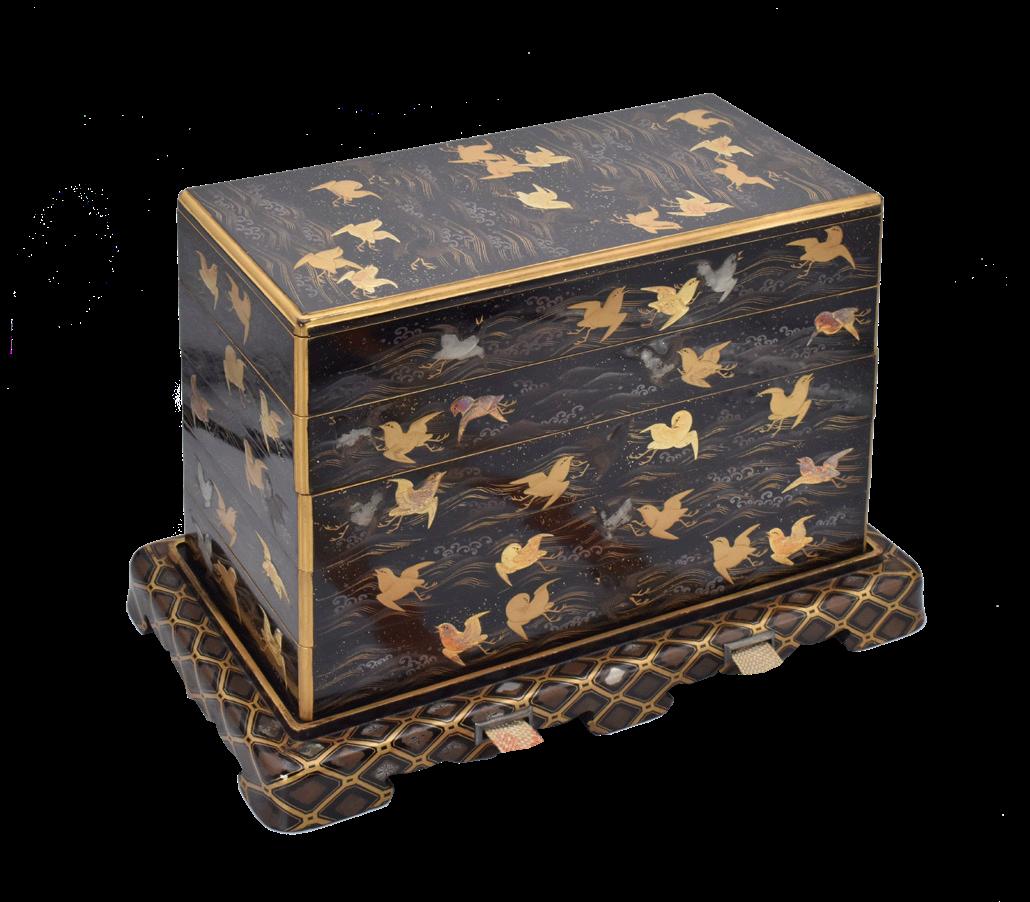
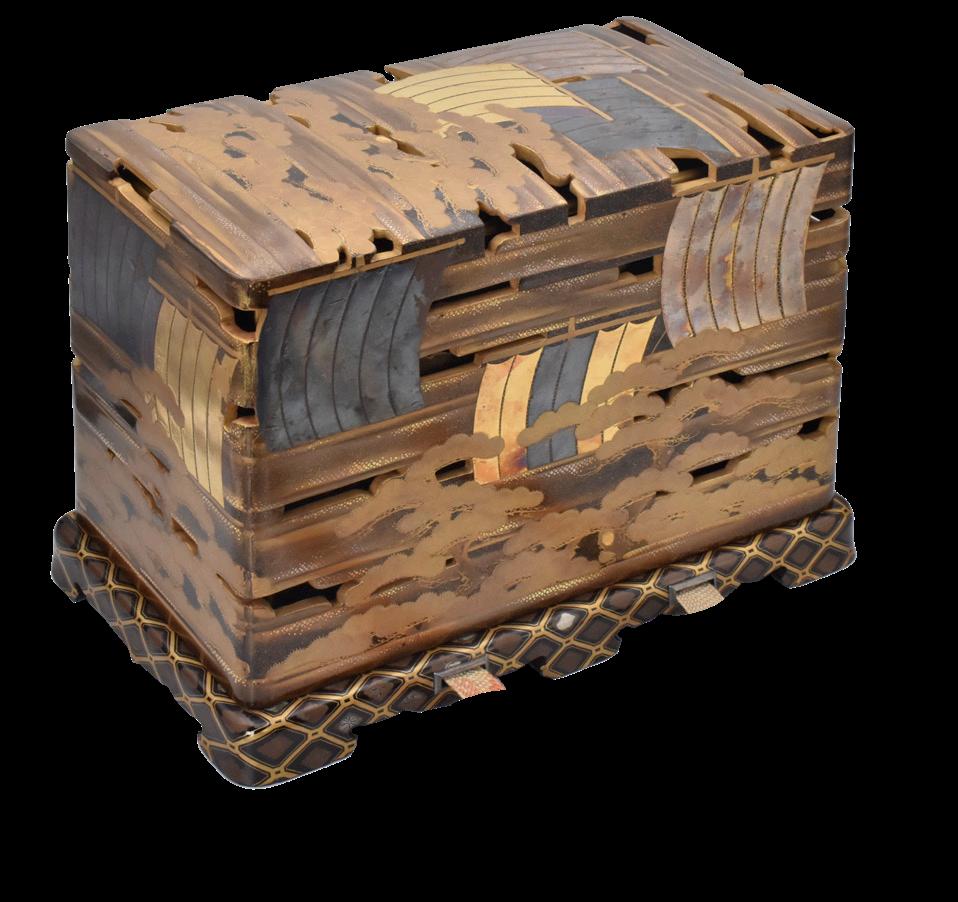
A LACQUER RECTANGULAR FIVE-TIER JUBAKO (STACKING BOX) AND EN-SUITE COVER, TAISHO (1912-1926) OR SHOWA (1926-1989) ERA, 20TH CENTURY

The box decorated in gold and silver takamaki-e and togidashi with a flock of chidori (plovers or dotterels) skimming above waves, on a detachable, lacquered-wood stand embellished hiramaki-e with repeated hanabishi-mon (flowery-diamond motifs), the en-suite removable cover reticulated and similarly lacquered with sailing boats and a pine grove on the shoreline; the sides of the stand fitted with a silvered-metal brackets to modate the tasselled silk chords; unsigned (8)
20.2cm x 27.5cm x 15.2cm
£2,500-3,000
A BLACK-LACQUER SHIKISHIBAKO (BOX FOR SQUARE POEM PAPERS) SHOWA ERA (1926-1989), 20TH CENTURY
The lustrous black lacquer ground decorated in polychrome hiramaki-e with details of shell and gold lacquer with dense peony blooms, the design extending over the sides of the lid, the interior of the box of plain roiro-nuri, unsigned; with a wood storage box inscribed outside the lid Yagumonuri shikishibako botan no e (Yagumonuri lacquer box for square poem papers with a peony design) with two seals, reading Yamamoto and Kinsei (3)
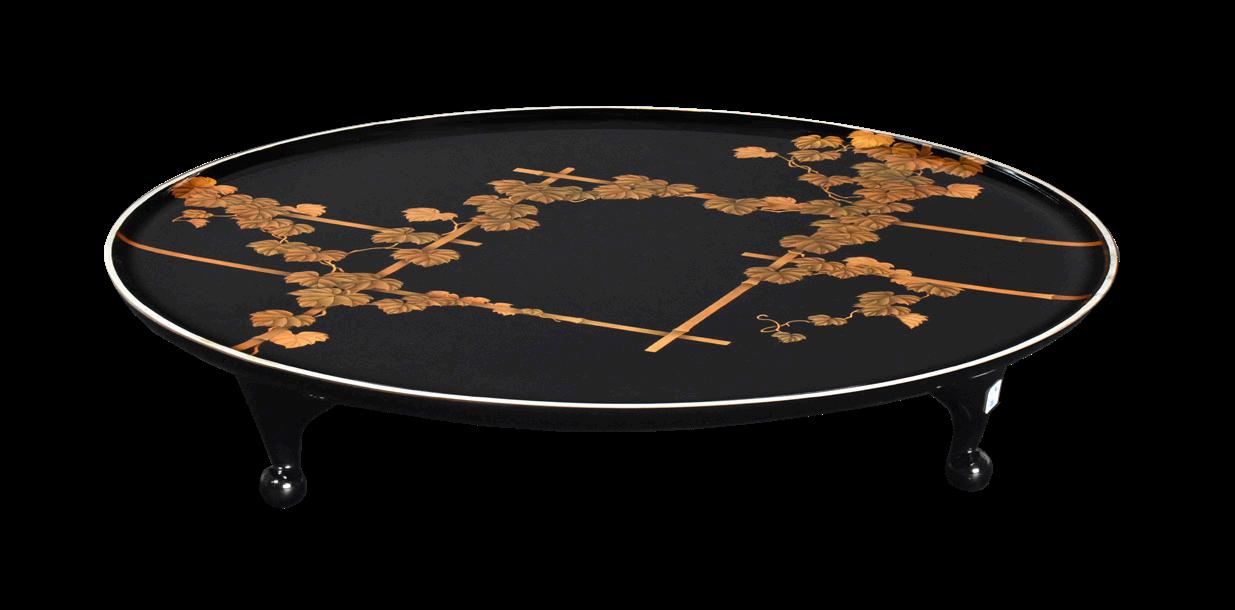
6.5cm x 28cm x 31cm
£500-800
A BLACK-LACQUER CIRCULAR CONFECTIONERY STAND
TAISHO (1912-1926) OR SHOWA (1926-1989) ERA, 20TH CENTURY
The lustrous roiro-nuri ground decorated in gold togidashi maki-e with kudzu vine trailing over a bamboo fence, unsigned; with an inscribed wood storage box (2)
7cm x 31.5cm
£300-500
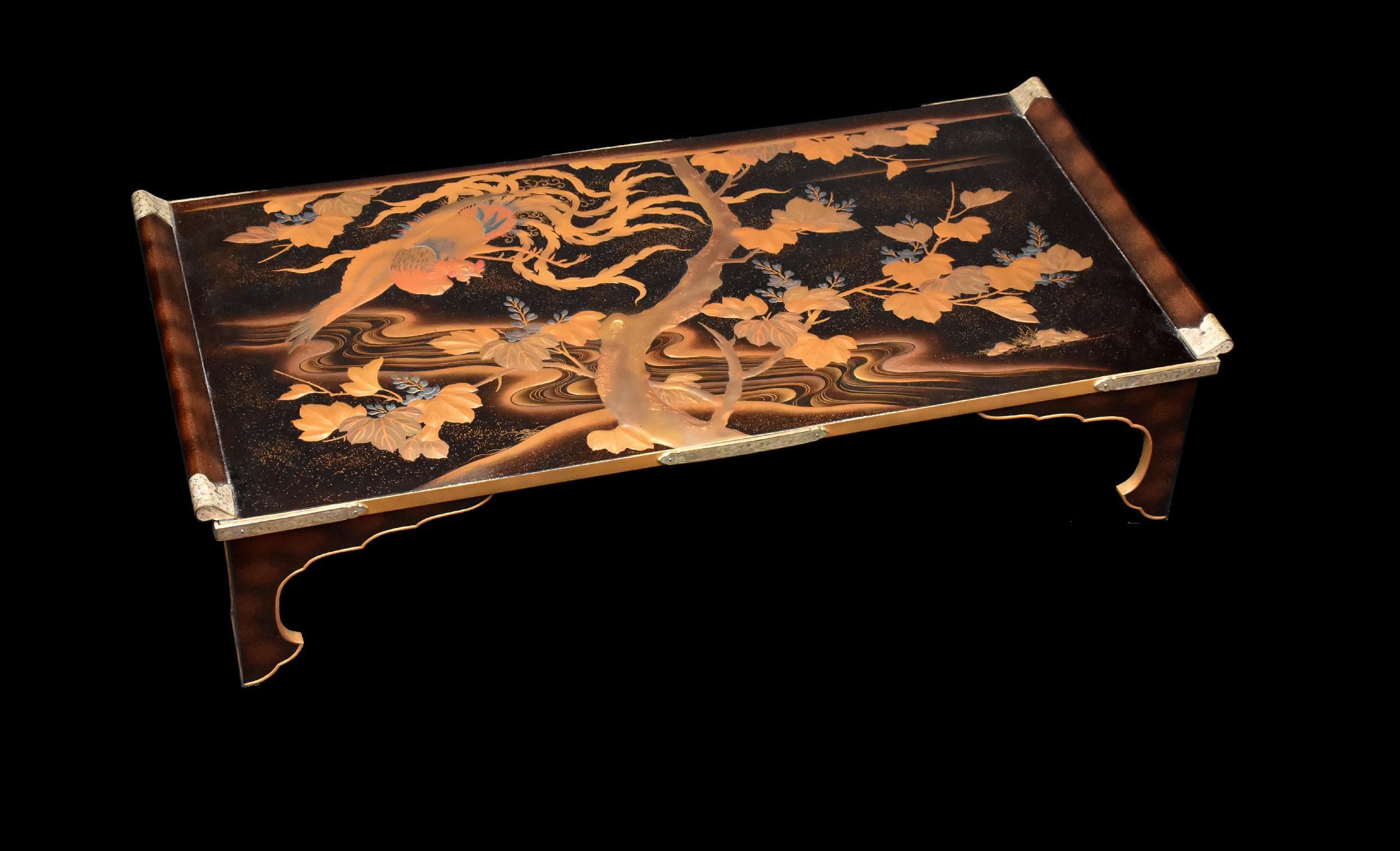
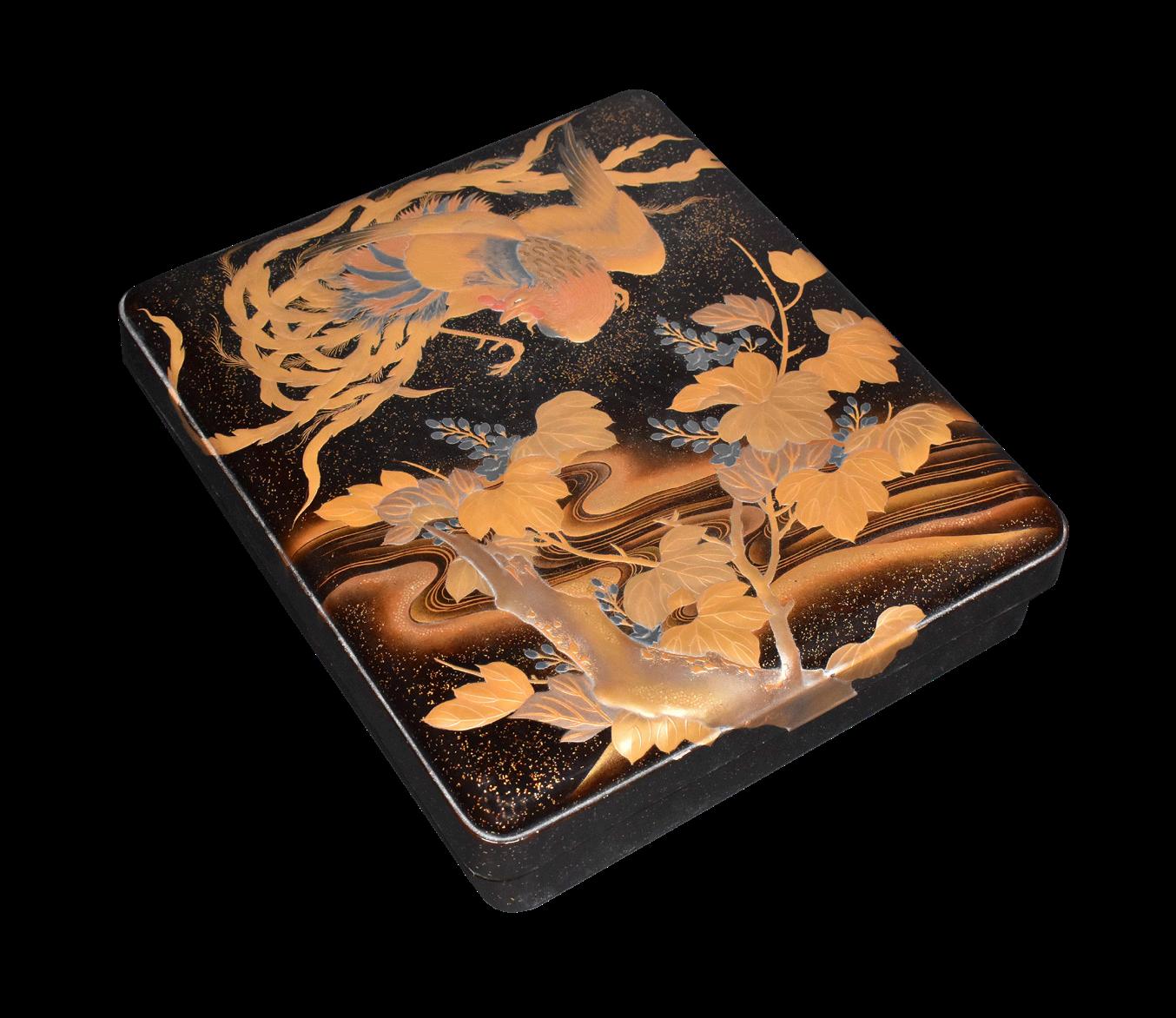
A MATCHING LACQUER SET OF A SUZURIBAKO (BOX FOR WRITING UTENSILS) AND A BUNDAI (WRITING DESK), EDO PERIOD (1615-1868) OR MEIJI ERA (1868-1912) MID/LATE 19TH CENTURY
Both decorated on the black-lacquer ground in contrasting tones of gold takamaki-e, togidashi maki-e and e-nashiji with highlights executed in kirikane, silver and red takamaki-e with a ho-o (phoenix) flying above paulownia branches overhanging a meandering stream on a sparsely-sprinkled hirame ground, the inside of the kabusebuta (overhanging lid) of the suzuribako similarly lacquered with rocks beside a stream on a mura-nashiji ground, the inside of the box embellished in mura-nashiji and
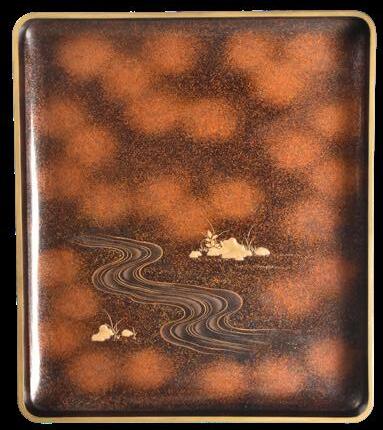

fitted with an en-suite removable ita (baseboard) containing the oval silvered metal suiteki (water-dropper) in the form of paulownia leaves, a suzuri (ink-grinding stone), an ink-stick holder and a kogatana (paper-cutting knife) decorated with engraved silver mounts, two additional unrelated gold-lacquered writing brushes, a kogatana (paper-cutting knife) and a kiri (auger); the bundai of standard form with fudegaeshi (raised sections to left and right); the silver fittings to the corners and sides of the top and the ends of the fudegaeshi chiselled with floral designs, the outside of the legs and fudegaeshi lacquered in gold mura-nashiji, the inside of the legs lined in gold lacquer, unsigned; with two inscribed wood storage boxes (14)
The suzuribako: 5cm x 26cm x 22cm; the bundai: 15cm x 63cm x 31cm
£5,000-6,000

78Ω
A BLACK-AND-GOLD-LACQUER MATCHING SET OF A LARGE RYOSHIBAKO (DOCUMENT BOX) AND SUZURIBAKO (BOX FOR WRITING IMPLEMENTS) TAISHO (1912-1926) OR SHOWA (1926-1989) ERA, 20TH CENTURY
Both boxes of rounded-rectangular form with a (overhanging lid) lacquered in gold e-nashiji and highlights of silver hiramaki-e black-lacquer ground, the ryoshibako decorated with two tennin (Buddhist angels), one playing a biwa (lute) and the other a sho (panpipes) on a ground of falling lotus petals, the interior of sparse nashiji, 13cm x 53cm x 46cm; the suzuribako decorated with one tennin holding a bowl containing a lotus, the interior fitted with a removable suzuri (ink-grinding stone) and a mixed-metal suiteki (water dropper) in the form of two overlapping shikishi-ban (square poem papers) engraved respectively with plum blossoms and pine needles, the interior and underside of sparse nashiji; unsigned; 4cm x 25cm x 21.5cm; each box with an inscribed lacquered-wood storage box (7)
20.2cm x 27.5cm x 15.2cm
£4,000-6,000
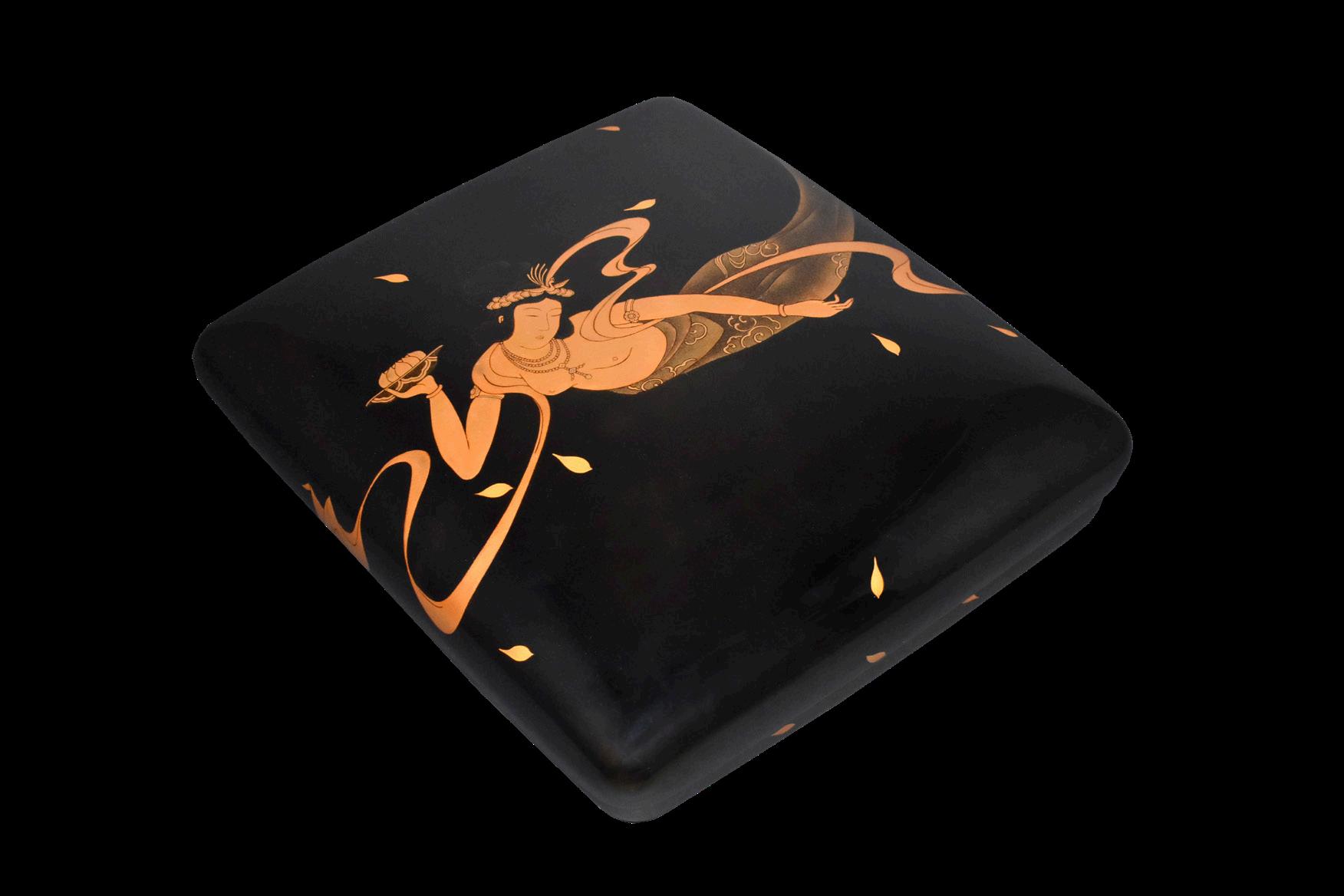

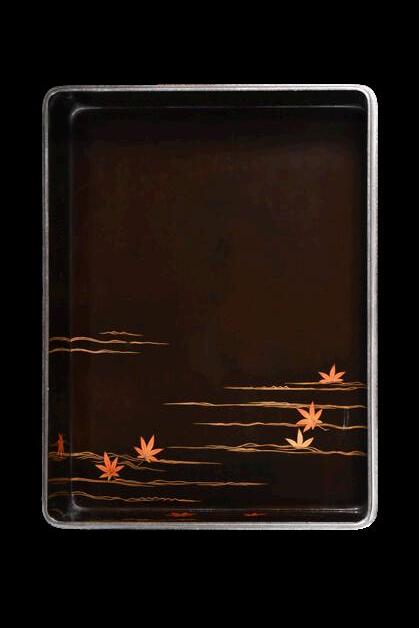



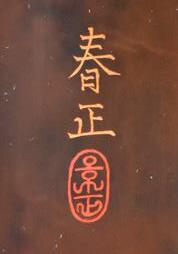
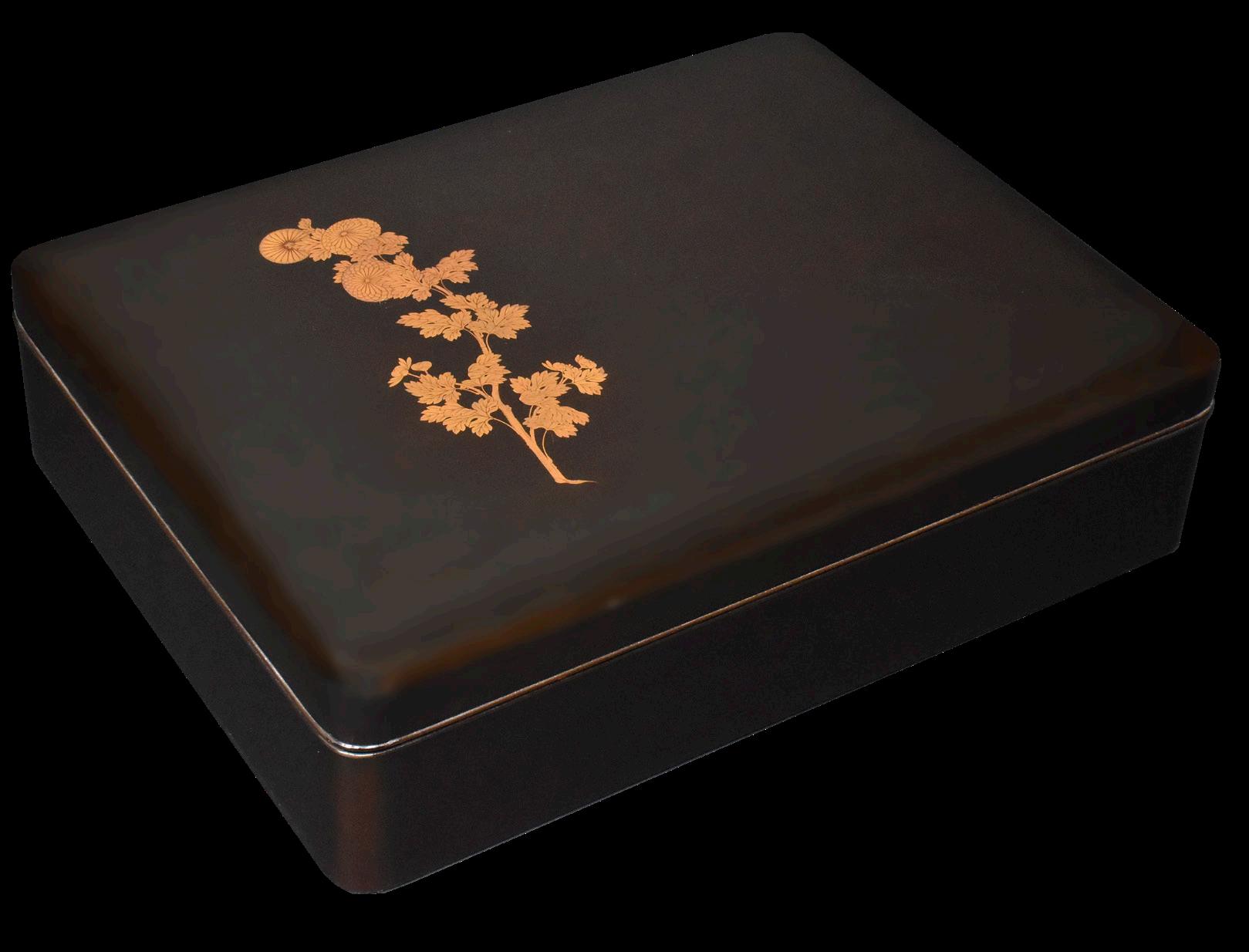

A BLACK-AND-GOLD-LACQUER MATCHING SET OF A LARGE RYOSHIBAKO (DOCUMENT BOX) AND SUZURIBAKO (BOX FOR WRITING IMPLEMENTS),
EDO PERIOD (1615-1868) OR MEIJI ERA (1868-1912), 19TH CENTURY
Both boxes of rounded-rectangular form with an inrobuta (flushfitting lid) lacquered in red and gold hiramaki-e, togidashi maki-e, e-nashiji and highlights of silver hiramaki-e and kirikane on the lustrous black-lacquer ground, the outside of both boxes decorated with a stalk of leafy chrysanthemum strewn carefully across the surface, the inside of the suzuribako lid with maple leaves floating on a river among rocks, the interior of the box with an en-suite removable tray and ita (baseboard) containing the suzuri
(ink-grinding stone) and a metal alloy suiteki (water dropper) applied in relief with chrysanthemums, the ryoshibako similarly lacquered with a matching design of maple leaves floating on the river, the mounts of silver; the ryoshibako signed along the inside left edge of the lid with gold lacquer characters Shunsho with a seal Kagemasa; with two strorage boxes (10)
The suzuribako: 3.5cm x 25cm x 17.5cm
The ryoshibako: 10cm x 39.5cm x 30cm
£3,000-5,000
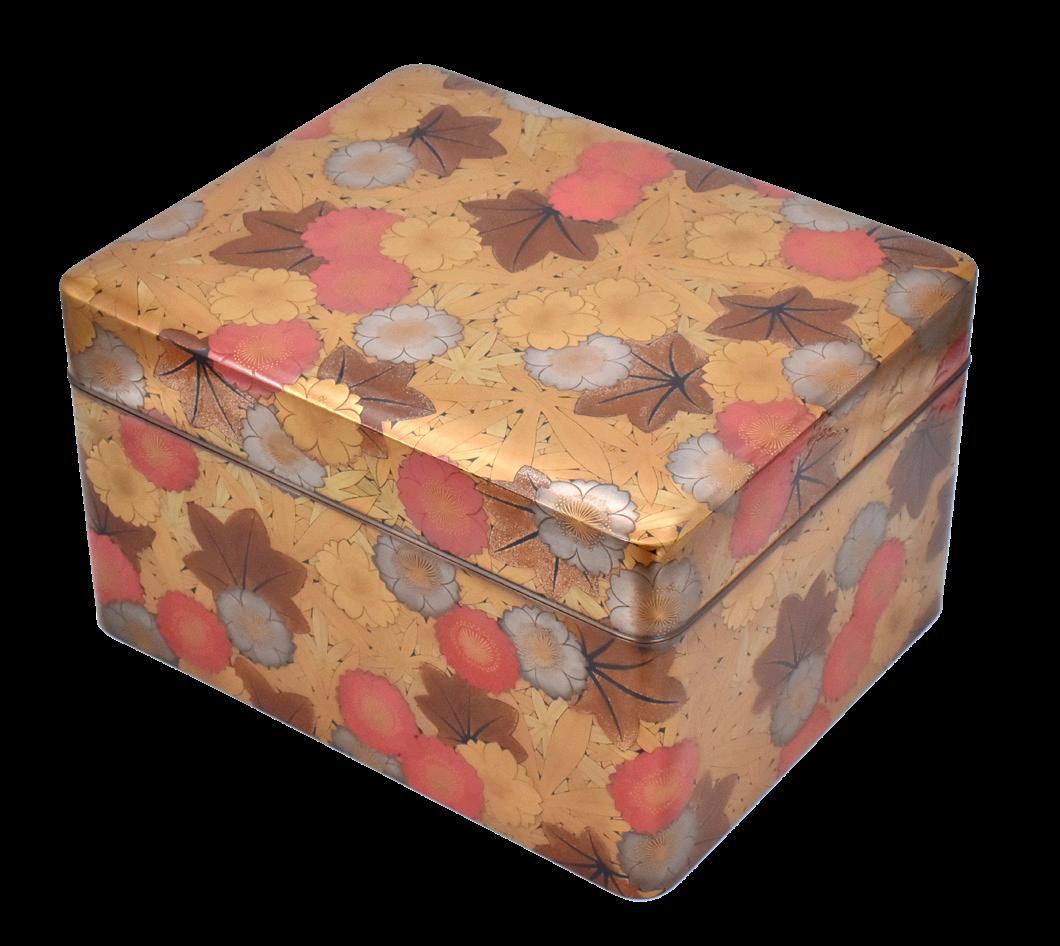


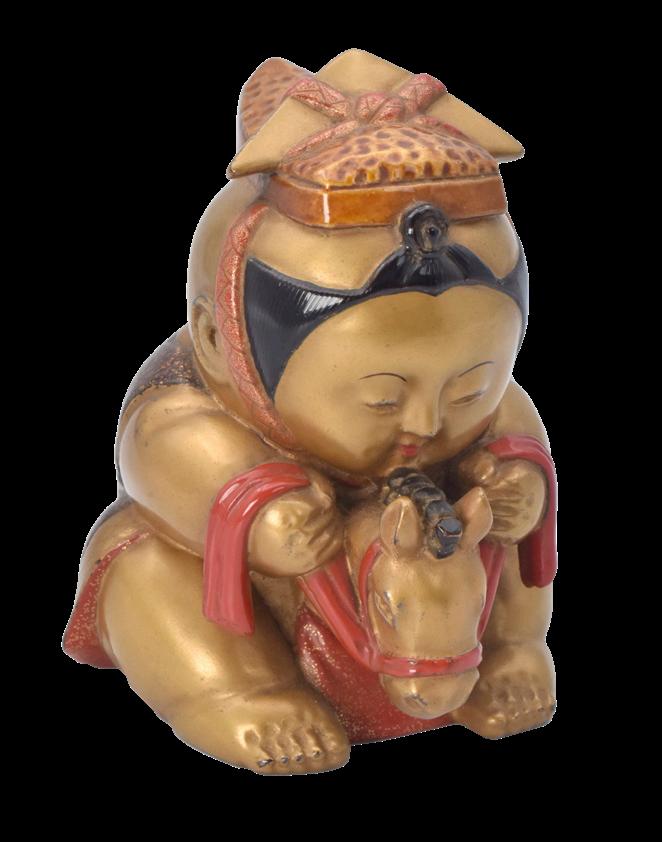
80Ω
KIZANSAI
A LACQUER ROUNDED-SQUARE RYOSHIBAKO (DOCUMENT BOX) AND EN-SUITE COVER
MEIJI (1868-1912) OR TAISHO (1912-1926) ERA, LATE 19TH/EARLY CENTURY
Of deep form, the exterior of the box decorated in gold, red and silver hiramaki-e with a continuous design of cherry blossoms overlapping with maple leaves, with highlights of nashiji and black lacquer, the interior of rich nashiji, signed on the inside of the cover in gold lacquer Kizansai with a kao; the rims of silver, with a wood tomobako storage box and tomogire wrapping cloth, each signed Kizansai with a seal (3)
14.2cm x 24.2cm x 19.7cm
£3,000-4,000
81Ω
A GOLD-LACQUER KOTSUZUMI (DRUM BODY)
EDO PERIOD (1615-1868), 18TH/19TH CENTURY
Boldy decorated in gold and slight-coloured takamaki-e with a large caterpillar, its segmented body winding around the entire body of the drum, its eyes of glass with black pupils, its mandibles of gilt, with a brocade silk storage bag and a wood storage box (3)
25cm high
£2,800-3,500
82Ω
A RARE GOLD-LACQUER GOSHO NINGYO (PALACE DOLL)
MODELLED AS A YOUNG BOY RIDING A HARUKOMA (HOBBY HORSE)
EDO PERIOD (1615-1868), 19TH CENTURY
The young plump boy formally dressed in an elaborate sleeveless jacket decorated on the rich nashiji ground with assorted crests and bamboo leaves in gold takamaki-e and wearing an eboshi playing with a harukoma (hobby horse) clutching its reins, the bamboo pole with a wheel shown at the back, unsigned; with a wood storage box inscribed on the outside of the lid Maki-e Harukoma ningyo (Maki-e doll of a hobby horse) (2)
8cm x 8cm
£2,000-3,000
83Ω
A FINE AND UNUSUAL GOLD-LACQUERED BOX AND COVER IN THE FORM OF A KANBURI (COURTIER HEADWEAR)
MEIJI ERA (1868-1912), LATE 19TH/EARLY 20TH CENTURY
The polished kinji ground embellished in gold and silver takamaki-e with scattered sprays of 16-petalled chrysanthemum crests, associated with the Imperial household, the back of the hat ornamented with a ceremonial ei (long strip of thin silk), a detachable kogai (hairpin) on either side, the underside and interior of rich nashiji, the top removable forming the cover, unsigned; with a lacquered-wood storage box (5)
21cm x 23cm x 15.5cm
£5500-6000
84Ω
A GOLD LACQUER OKIMONO (TABLE ORNAMENT) IN THE FORM OF A TSUCHI (DAIKOKU’S MAGIC MALLET)
MEIJI ERA (1868-1912), LATE 19TH/EARLY 20TH CENTURY
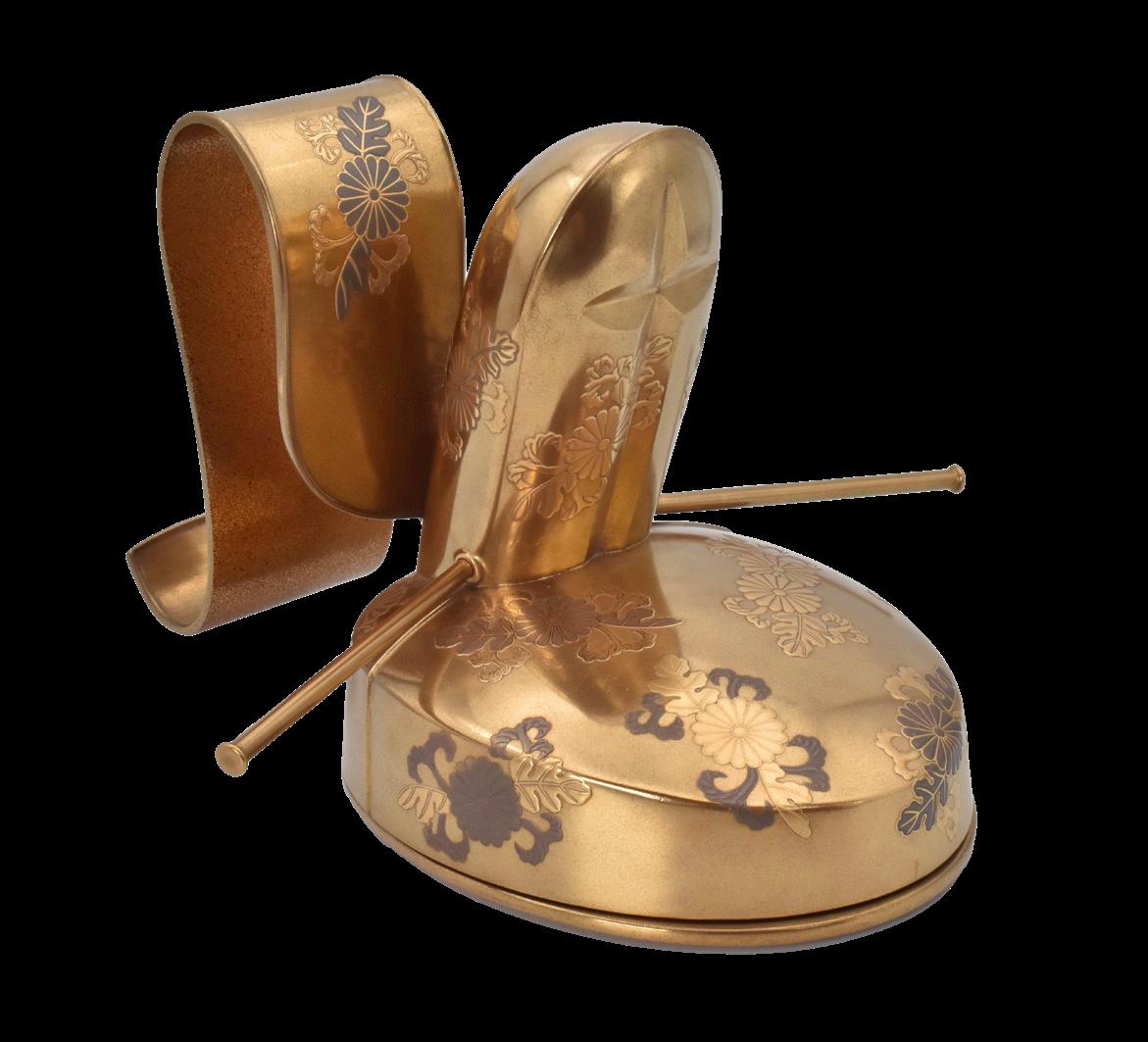
The handle decorated in gold hiramaki-e and e-nashiji with repeated hanabishi-mon (flowery-diamond crests) on a fundame ground, the body in gold hiramaki-e with floral lozenges within hexagonal reserves, with embellishments of inlaid shell on a ground of togidashi maki-e in a mokume (wood grain) pattern, the striking surfaces decorated with roundels containing stylized dragons, unsigned; with a plain wood storage box (2)
19cm x 19cm
£1500-2000
85Ω
TSU
AN OCTAGONAL KANSHITSU (DRY LACQUER) MIZUSASHI (WATER JAR AND COVER)
TAISHO (1912-19126) OR SHOWA (1926-1989) ERA, 20TH CENTURY
Decorated in orange and mustard takamaki-e with a wide band enclosing repeated hanabishi-mon (flowery-diamond crests) ground of dense tiny squares, the remaining surfaces of lustrous roiro-nuri (black lacquer), the en-suite cover surmounted by a finial in the form of two geometric shapes, signed on the base of the body Tsu saku; with a wood tomobako storage box inscribed outside the lid Kanshitsu mizusashi and signed inside the lid saku with a seal (3)
13.5cm x 16cm
£1000-1500

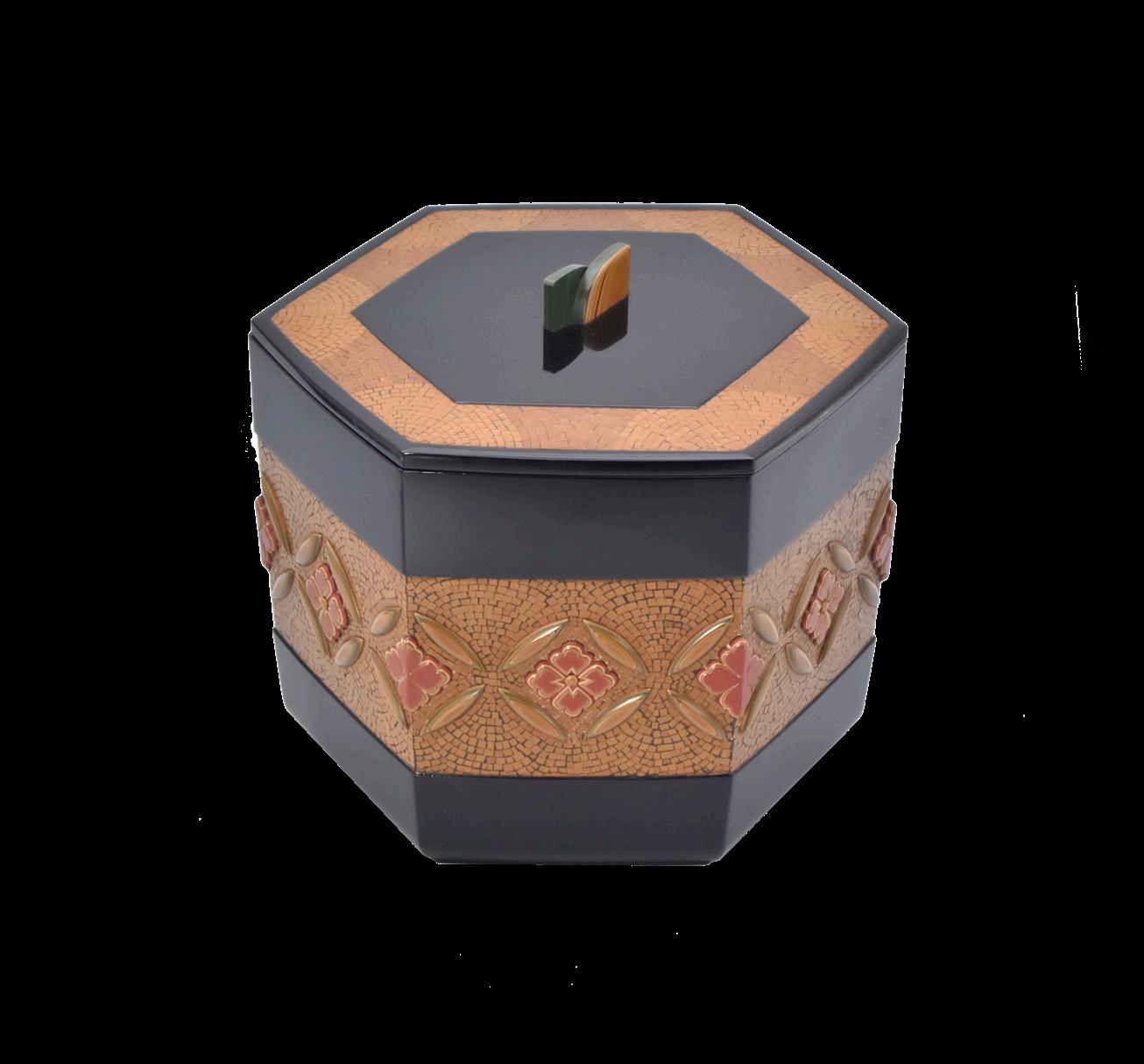


86Ω
A RARE CAMPHOR OR PAULOWNIA WOOD GIGAKU MASK OF KARURA (GARUDA)
POSSIBLY NARA PERIOD (710-794), 8TH CENTURY
The mythical giant bird carved with a rooster-like crest and layers of flesh hanging beneath its neck, its close-set eyes staring down towards the tip of its prominent open beak grasping a round bead, with traces of the original black, green, red and blue pigments; with a wood storage box (2)
30cm x 25cm x 31cm
£8,000-12,000
This striking and imposing mask represents Karura, one of the fourteen characters in the Gigaku repertoire—an early form of religious dance-drama which flourished in Japan between the 7th and 10th centuries. Gigaku, which translates literally to “skill music,” was originally introduced to Japan from China in A.D. 612 and played an important role in court ceremonies and Buddhist temple rituals. Though its precise origins remain unclear, Gigaku developed in tandem with the spread of Buddhism, blending theatrical performance with spiritual symbolism. The Karura mask, often depicting a mythical, bird-like creature as presented here, embodies the fusion of foreign religious motifs with early Japanese performance art
Published and Illustrated:
Katsuki Genichiro, Jinmen o motsu tori–karyobinga no sekai (Bird with Human Face: the World of Kalaviṅka), Nihon no bijutsu 481, Shibundo, June 2006, p.75, pl.no.124
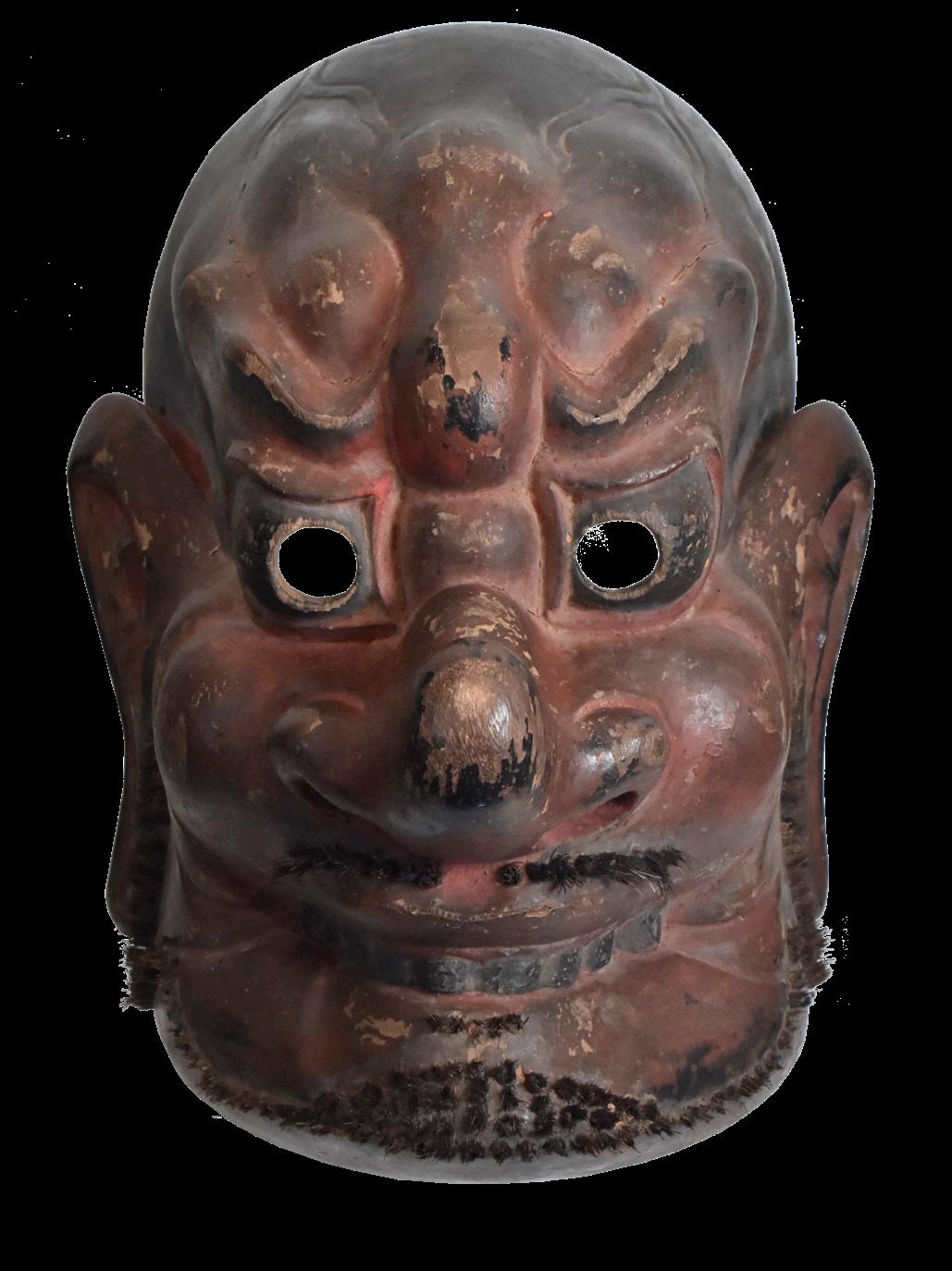
87Ω
A RARE CARVED WOOD GIGAKU MASK OF RIKISHI (GUARDIAN KING)
POSSIBLY KAMAKURA (1185-1333), MUROMACHI (1333-1573) OR MOMOYAMA (1573-1615) PERIOD, 14TH -16TH CENTURY
Carved with a broad, muscular face converging into a small protruding nose with his high forehead tense, showing prominent veins and ligaments, elongated ear lobes, his teeth clenched in a smile, his eyebrows flaring back, the reddish-brown surface with traces of the original black pigments; with a lacquered wood storage box and a cardboard lid (2)
36cm x 22cm
£6,000-8,000
For a similar Rikishi mask designated a National Treasure in the collection of the Tokyo National Museum, see https://webarchives.tnm.jp/imgsearch/show/E0066695

88Ω
A RARE KANSHITSU (DRY LACQUER) GIGAKU MASK OF CHIDO POSSIBLY KAMAKURA (1185-1333), MUROMACHI (1333-1573) OR MOMOYAMA (1573-1615) PERIOD, 14TH -16TH CENTURY
Modelled with a reddish-flesh face with distinct long, hook nose, bulging eyes and a mouth wide-open in a smile exposing its teeth, with traces of the original black pigment; with a wood storage box (2)
29.5cm x 22cm
£2,000-3,000
Chido embodies a man of impressive dignity and commanding presence, perhaps serving as the herald of the Gigaku pageant— leading the grand procession with a lion mask

89Ω
A RARE KANSHITSU (DRY LACQUER) GIGAKU MASK OF SUIKOJU POSSIBLY KAMAKURA (1185-1333), MUROMACHI (1333-1573) OR MOMOYAMA (1573-1615) PERIOD, 14TH -16TH CENTURY
Modelled with exaggerated facial features and wearing a cap, its face with an aquiline nose, elongated earlobes, prominent cheekbones and deep-set eyes surmounted by lashed eyebrows, horse hair serving in a realistic rendering of the beard and moustache, with traces of the original red pigments; with a wood storage box
28cm x 23cm
£1,500-2,000
This Suikoju mask depicts one of the eight young followers in service to Suiko-o (the drunken foreigner) in the Gigaku dance drama
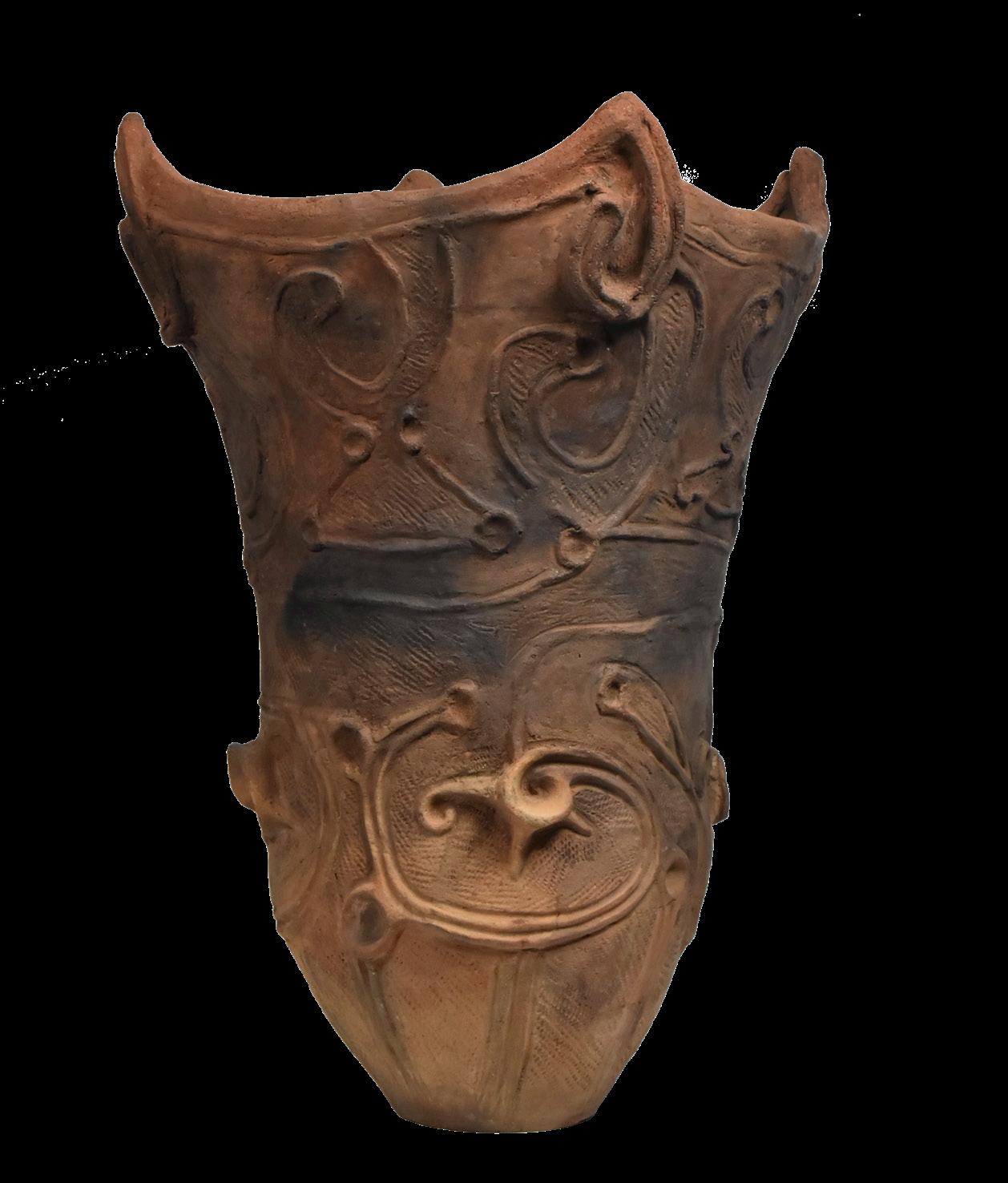
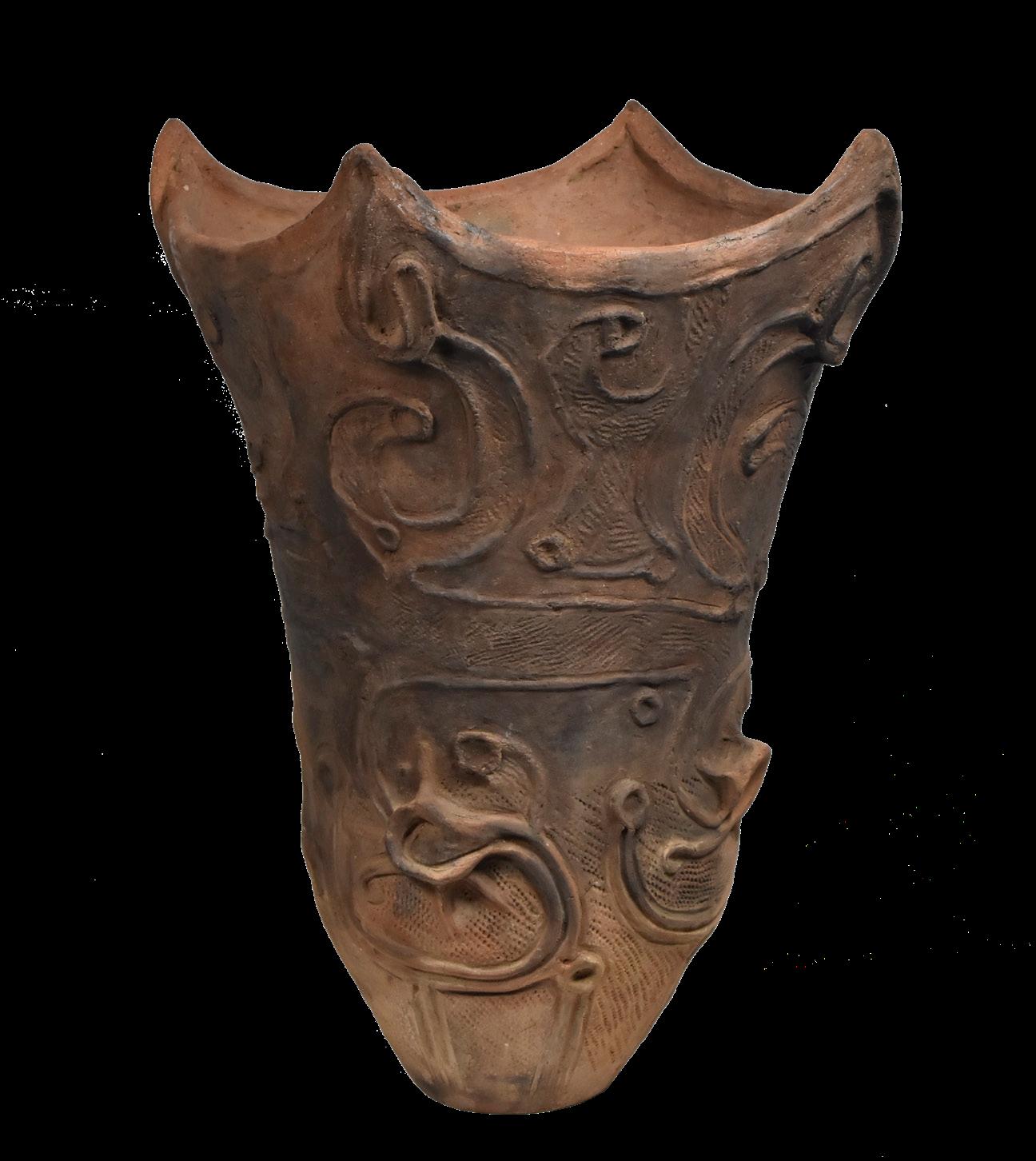
AN EARTHENWARE LARGE DEEP COOKING VESSEL
PROBABLY MIDDLE JOMON PERIOD (5500-4500 BC)

A low-fire reddish-clay pot modelled in tottetsuki fukabachi style, the tall, thick, conical cylindrical body supported on a flat, circular base, projecting upwards to an exaggeratedly wide, square mouth surmounted with triangular flame-like ornamentation, eccentrically decorated all over with elaborate, curved motifs, whorls and protuberances resembling seashells, imprints and further incised cord-marked patterns; with a plain wood storage box (2)
54cm x36.5cm.
£5,000-6,000
The exact excavation site is unknown but current research and the shape suggests that the vessel probably originated from the region of South Tohoku.
91Ω
AN EARTHENWARE DEEP STORAGE VESSEL
PROBABLY MIDDLE JOMON PERIOD (5500-4500 BC)
A low-fire reddish-clay pot modelled in tottetsuki fukabachi style, the cylindrical body supported on a flat, circular base, and divided into four sections, outlined in vertical raised borders, surmounted by an exaggeratedly wide, square mouth with triangular flame-like appendages accented with further raised borders, cord-marked patterns and incised decoration; with a plain wood storage box (2)
36.5cm x 27cm
£1,500-2,000
The exact excavation site is unknown but current scholarship and the shape suggests that the vessel probably originated from Ibaraki Prefecture.

92
A PAIR OF ARITA PORCELAIN FIGURES GROUPS OF KINTARO ON THE BACK OF A CARP
EDO PERIOD (1615-1868), LATE 17TH CENTURY
Each painted in iron-red, green and black enamels and gilt, the carp leaping (2)
Each: 23cm high
£2,000-3,000
93
AN IMARI PORCELAIN TEAPOT
EDO PERIOD (1615-1868), CIRCA 1700

Decorated in underglaze-blue and enamels with a continuous Chinese landscape scene depicting in the foreground travellers on one side followed by a dog, an oarsman poling a passenger on a boat on the other, streamers flying in the distance and buildings nestled among mountains in the background, the handle and spot painted with sprays of karakusa (‘Chinese grasses’), the cover similarly decorated and surmounted by finial in the form of a seated yellow tiger.
11cm x 16.5cm
£1000-1500
94
A HIRADO PORCELAIN PUPPY
MEIJI (1868-1912) OR TAISHO (1912-1926) ERA, EARLY 20TH CENTURY
The recumbent dog with finely incised features, covered in a white glaze
20cm long
£300-500



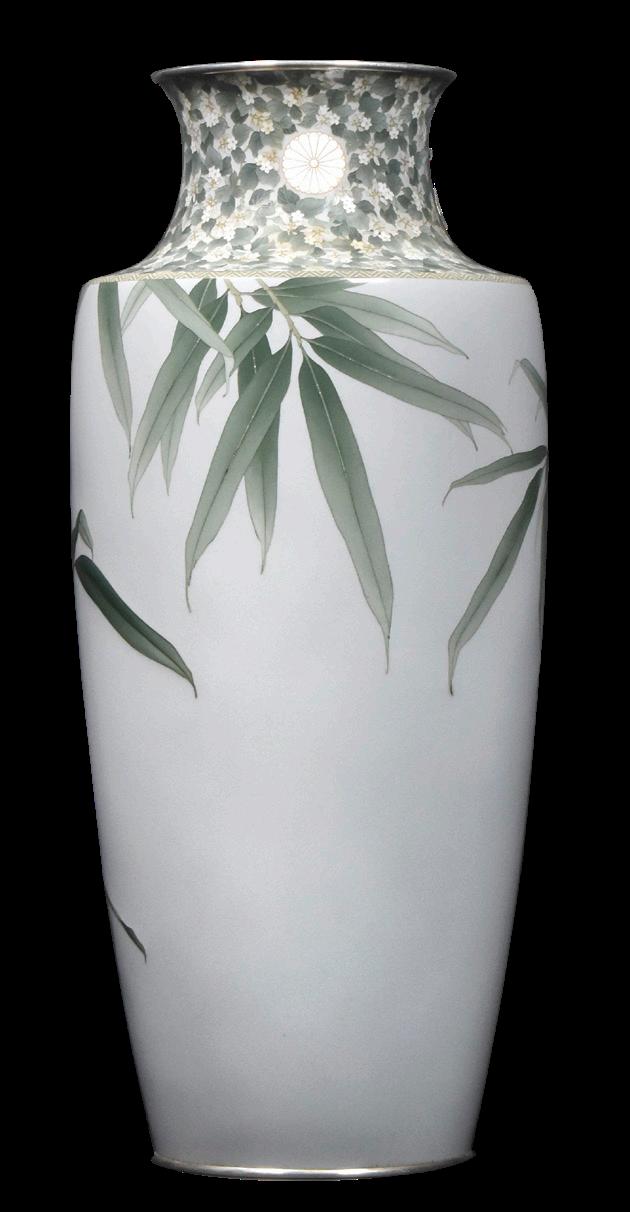
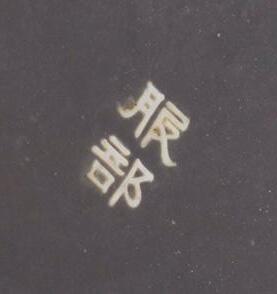
95Ω
HATTORI TADASABURO (DIED 1939) A PAIR OF IMPORTANT IMPERIAL PRESENTATION MORIAGE CLOISONNÉ-ENAMEL BALUSTER VASES
MEIJI (1868-1912) OR TAISHO (1912-1926) ERA, EARLY 20TH CENTURY
The vases with a thick cylindrical neck flaring out to the mouth, worked in standard and musen (‘wireless’) cloisonné techniques with an overall complementary design of sasa (broadleaf bamboo), depicting tall stalks of bamboo with overlapping leaves rendered in moriage (‘heaped-up’) enamels, the design continuing on the reverse, one vase with a bamboo shoot, the neck decorated with two16-petalled kikumon (chrysanthemum crest), one on either side interwoven centrally among tightly scrolling vines and white flowers, the silver wires of varying thickness delineating the fushi (joints) of the bamboo stems and veins of the leaves, the enamels in contrasting shades of green imitating the natural tones of the plant, all against a pale greyish-blue ground, applied with a silver rim and foot, the base signed with two characters Hattori, each vase with a purple silk storage bag and one wood storage box (5)
Each vase: 43.2cm high
£120,000-£150,000
Hattori Tadasaburo of Nagoya was among the finest cloisonnéenamellng masters of his day, excelling in a wide range of innovative techniques and styles. He opened his own studio in 1888 and won international honours at the 1893 Chicago World’s Columbia Exposition; at the Louisiana Purchase Exposition, held at St. Louis in 1903, his enamels were, most unusually, shown in the Art Palace rather than the larger but less prestigious Palace of Varied Industries. It is not certain whether or not he invented the demanding moriage (‘heaped-up’) technique seen here, but he was certainly among the first to exhibit it, starting at St. Louis, and is admired for the way that he succeeded in raising moriage designs to an unusually high level above the ground enamel; see Frederic T. Schneider, The Art of Japanese Cloisonné Enamel: History, Techniques and Artists: 1600 to the Present, Jefferson N.C., McFarland & Company, Inc., 2010, p.202



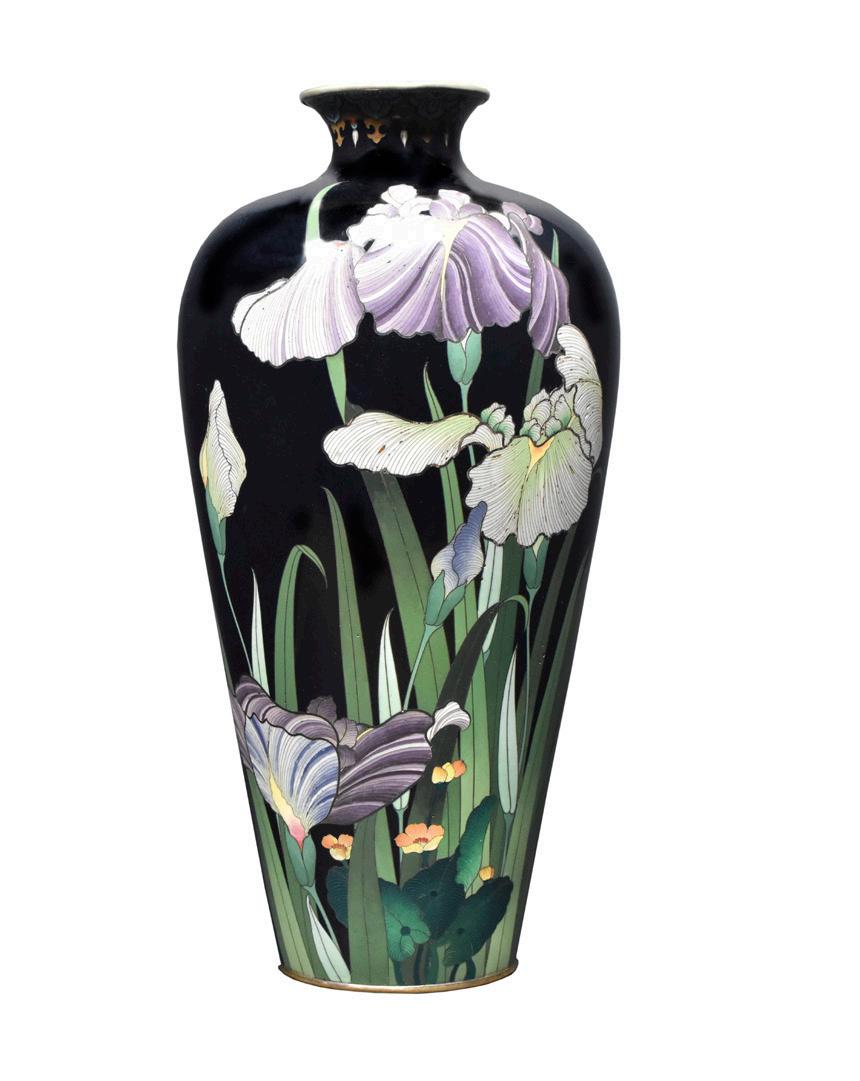


96
A CLOISONNÉ-ENAMEL OVOID VASE
MEIJI ERA (1868-1912), LATE 19TH/EARLY 20TH CENTURY
Worked in silver wire of varying gauge with tall blooming purple and white irises and yellow kohone flowers on the banks of a pond, the neck with a band of repeated foliate motifs above jewelled ornamentation, all reserved on a midnightblue ground, the rims of gilt, unsigned
31.5cm high
£1,000-1,500 97
TWO CLOISONNÉ-ENAMEL VESSELS
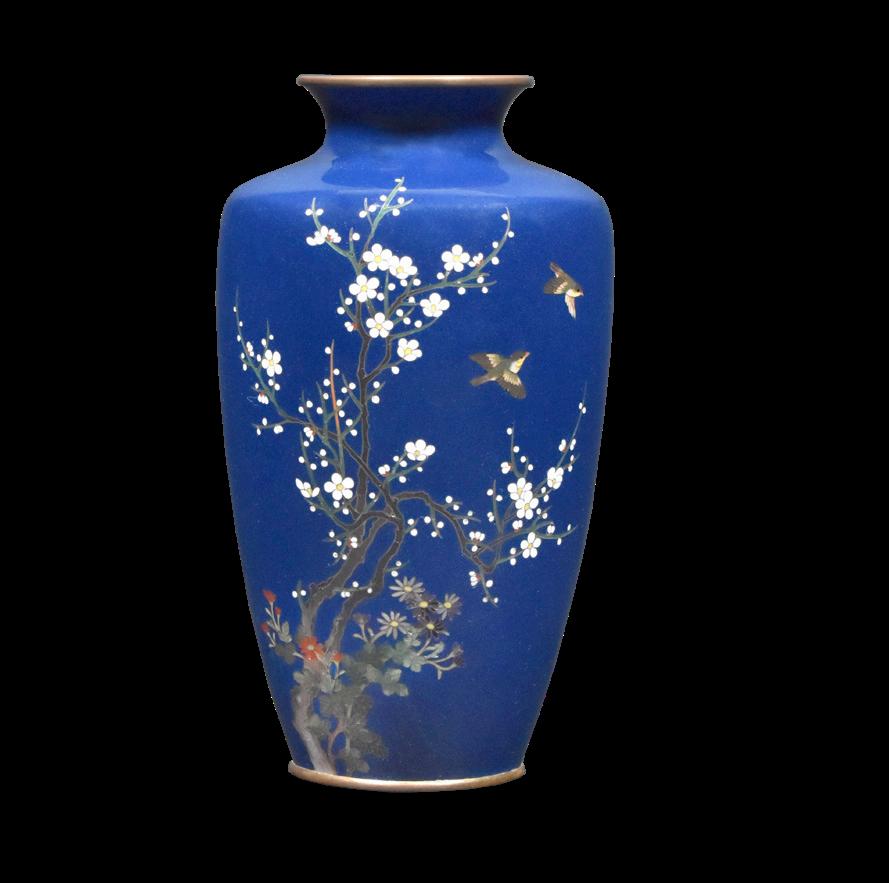
MEIJI ERA (1868-1912), LATE 19TH/EARLY 20TH CENTURY
Comprising one vase worked in gold wire of varying gauge and decorated with two sparrows in flight among white plum blossoms on a ruri (lapis lazuli) blue ground, 12.5cm high, the second a squat incense burner worked in gilt wire with stylised butterflies within a lobed panel on the lower section and auspicious motifs on the shoulder, with a domed cover, unsigned; 8.5cm high (2)
£300-500 98
A CLOISONNÉ-ENAMEL BALUSTER VASE
MEIJI ERA (1868-1912), LATE 19TH/EARLY 20TH CENTURY
Worked in gilt and silver wire, of varying gauge, decorated with a white hawk perched on wave-lashed rocks, its wings outstretched preparing to take flight, reserved on a midnight-blue upper ground and a lower transparent enamel ground flecked with aventurine, with brass mounts; unsigned
25cm high
£800-1,000
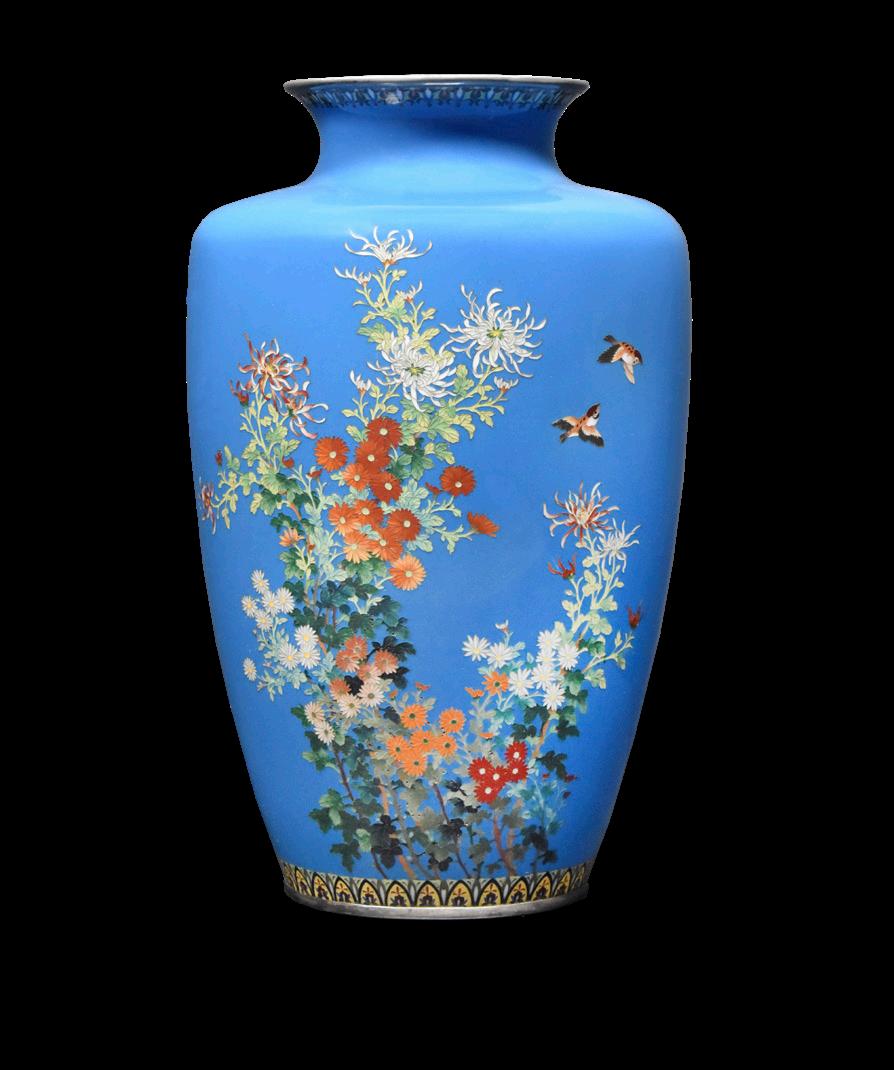
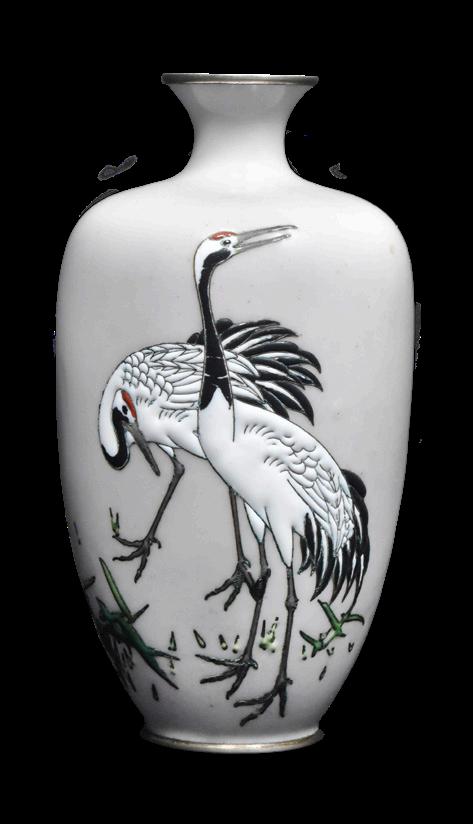
99
A CLOISONNÉ-ENAMEL BALUSTER VASE
MEIJI ERA (1868-1912), LATE 19TH/EARLY 20TH CENTURY
Worked in gilt wire of varying gauge with a pair of sparrows in flight among different species of chrysanthemums on a wisteriablue ground, the neck and foot with a band of repeated foliate motifs, the rim and foot of silver; unsigned
25cm high
£800-1,200
100
A CLOISONNÉ-ENAMEL MORIAGE BALUSTER VASE
MEIJI ERA (1868-1912), LATE 19TH/EARLY 20TH CENTURY
The slender ovoid body worked in silver wire with a pair of tancho-zuru (red-crested cranes) standing among bamboo grasses rendered in moriage (heaped-up) enamels, the rim and foot of gilt; unsigned
15.7cm high
£500-600

101

A CLOISONNÉ-ENAMEL BALUSTER VASE
MEIJI ERA (1868-1912), LATE 19TH/EARLY 20TH CENTURY
Worked in gold wire of varying gauge, decorated with a sparrow perched on a maple tree, whilst three sparrows fly above shrubs of flowering wild chrysanthemums, a stalk of red flower on the back, all reserved on a midnight-blue ground, the neck with a band of repeated geometric motifs, the foot with a band of scattered flowers on a whorl ground, beneath above band of repeated lappets, unsigned; with a wood stand (2)
25.5cm high
£800-1,200
102
A CLOISONNÉ-ENAMEL BALUSTER VASE
MEIJI ERA (1868-1912), LATE 19TH/EARLY 20TH CENTURY
Worked in gilt wire of varying gauge with three tancho-zuru, (red-crested cranes) standing on wave-lashed rocks, another five descending in flight on the right, all reserved on a grey-blue ground, the neck with a band of repeated lappets enclosing floral motifs; unsigned
24.5cm high
£600-800
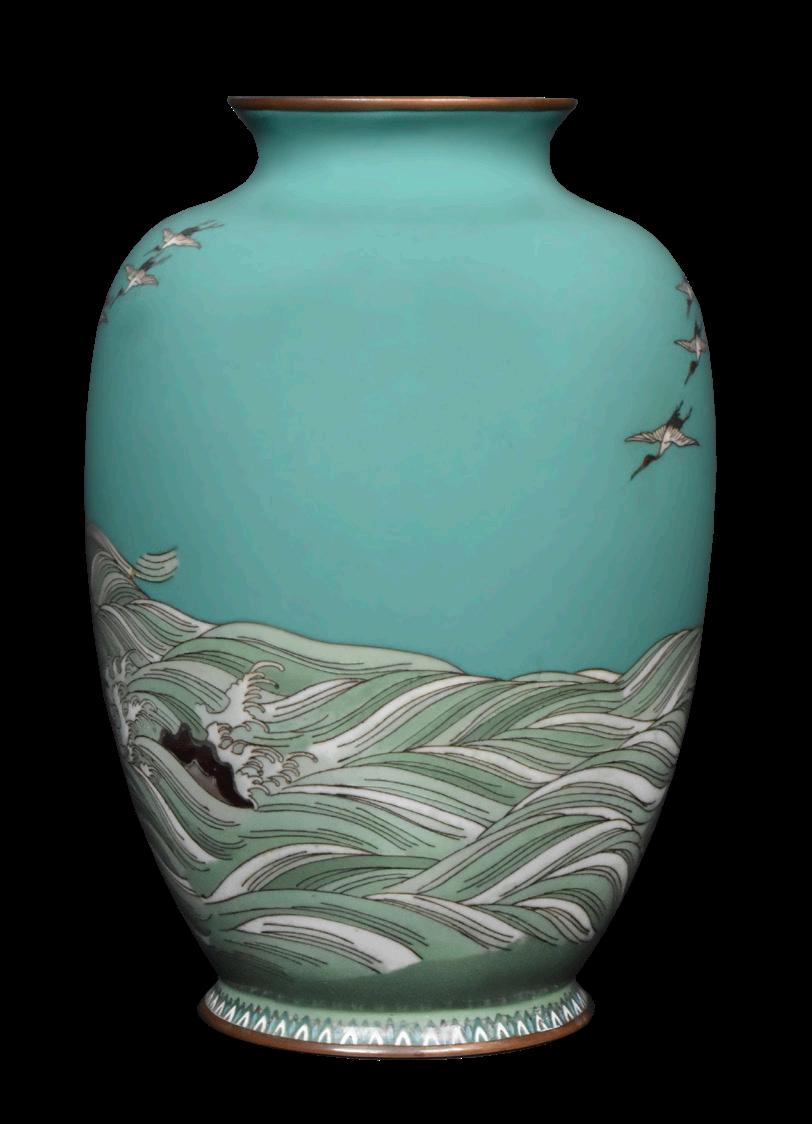
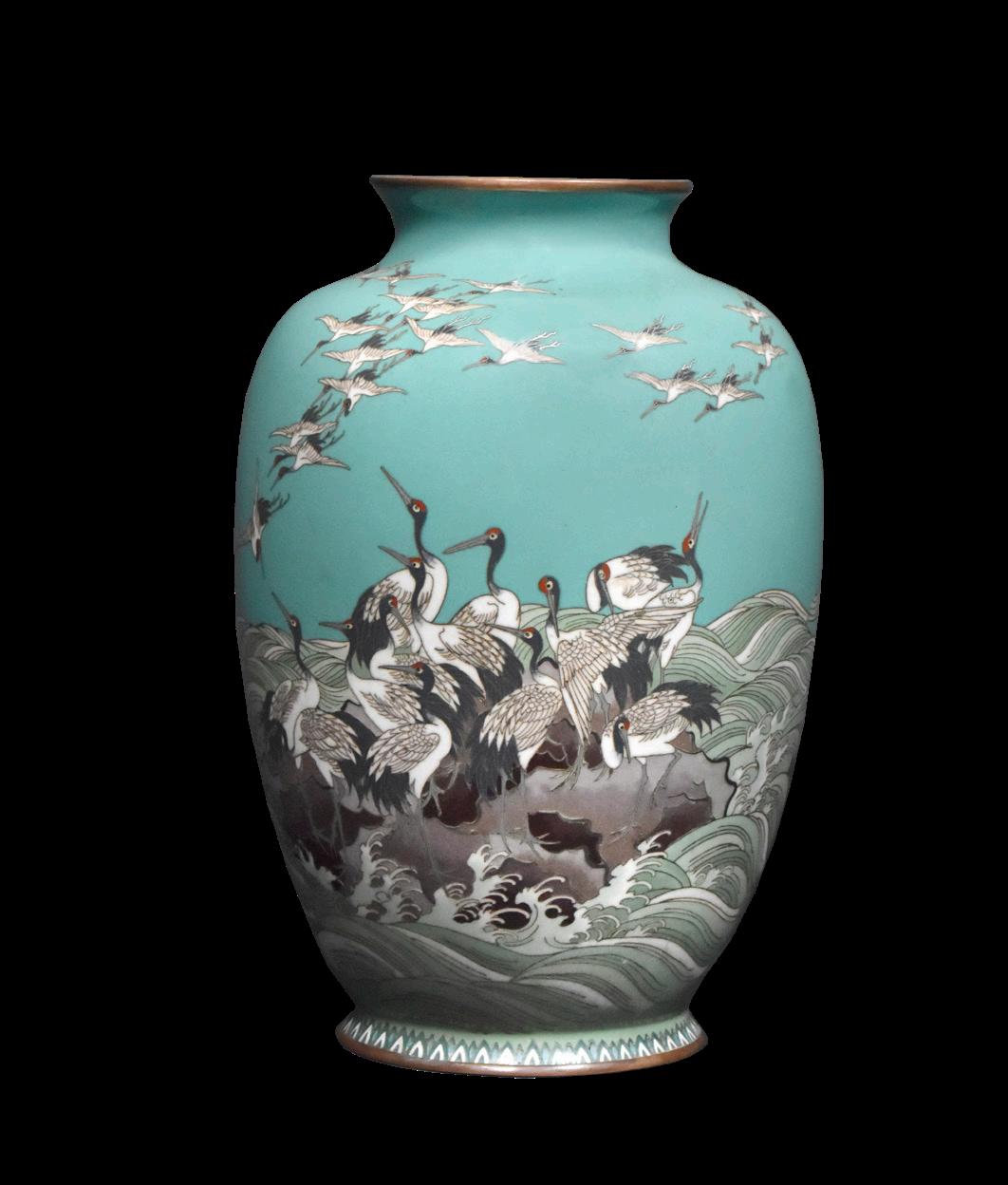
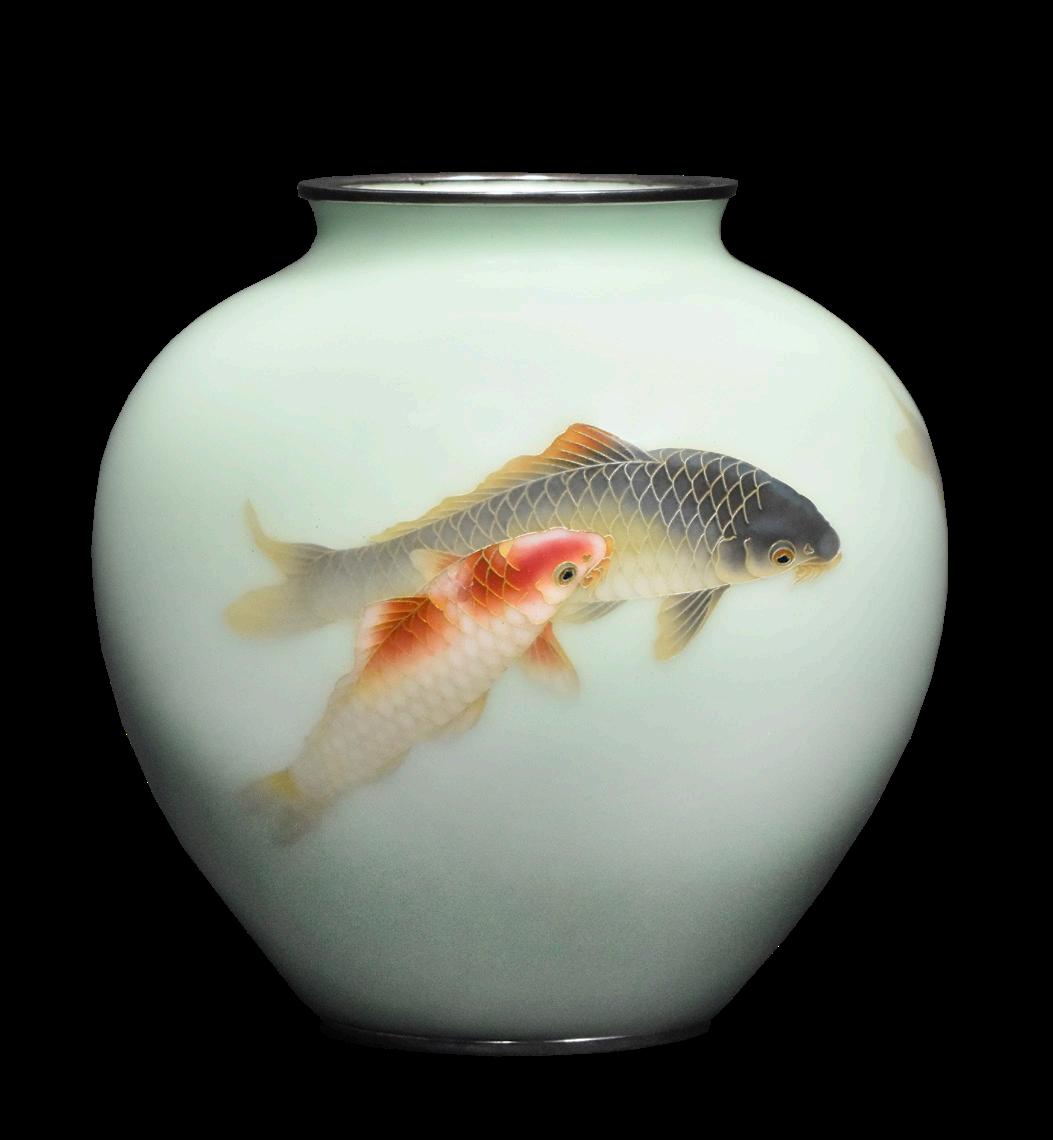
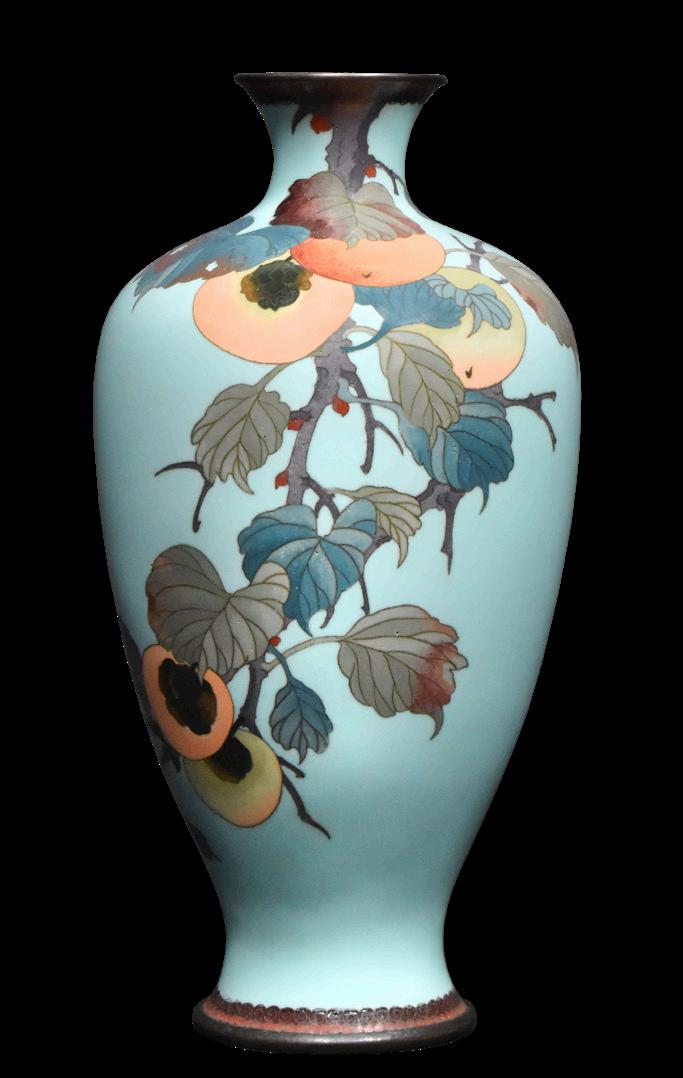
Worked in silver wire of varying gauge, decorated with several tancho-zuru (red-crested cranes) huddled together standing on waved-lashed rocks, a flock of other cranes descending in flight above, all reserved on a dark celadon ground; signed on the base with an undeciphered mark
20cm high
£1,000-1,500

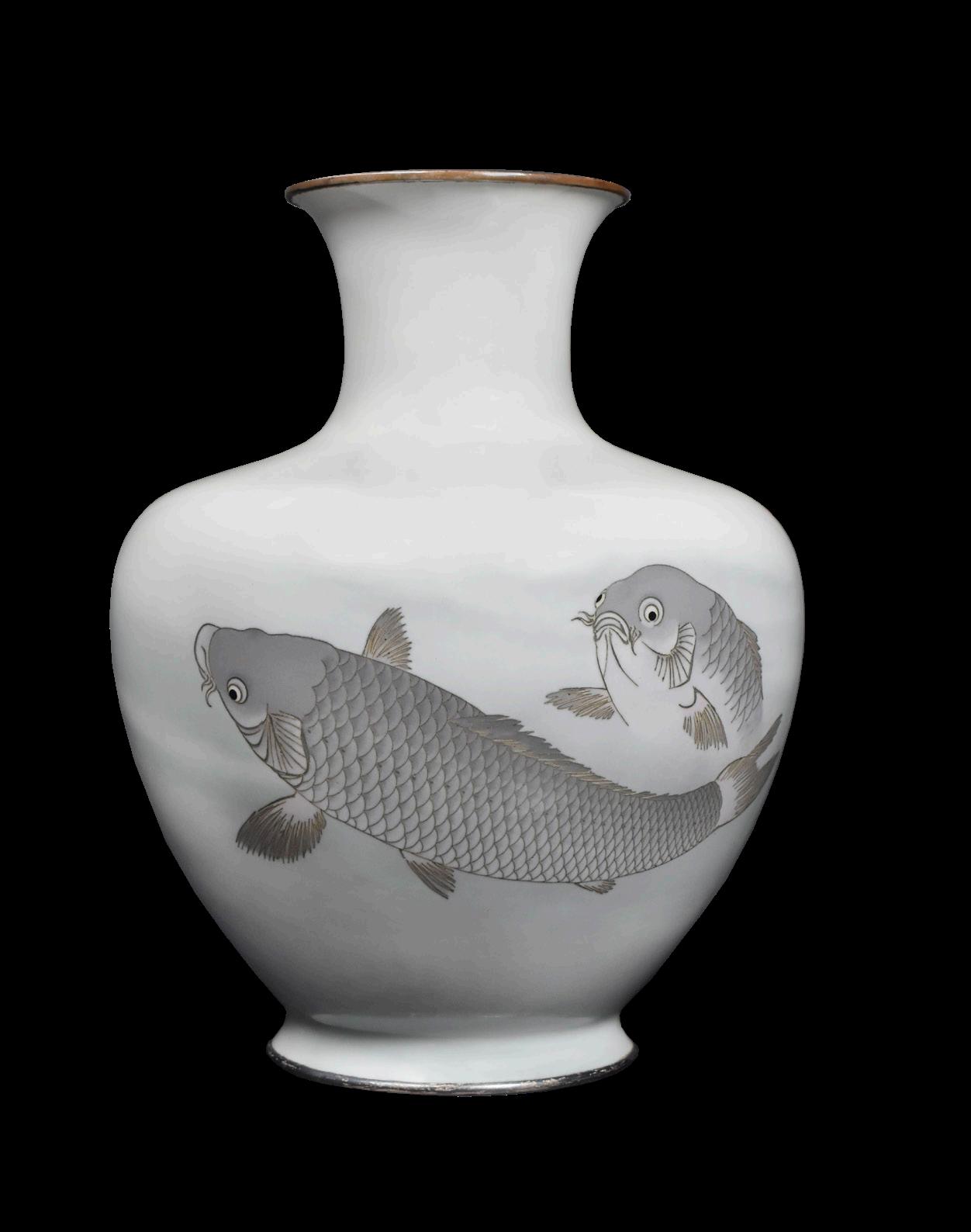
KAWADE SHIBATARO (1856-1921) FOR THE ANDO JUBEI COMPANY
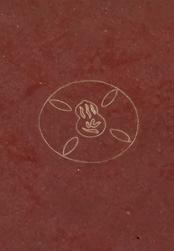
104 ANDO JUBEI COMPANY
A CLOISONNÉ-ENAMEL BALUSTER VASE
MEIJI (1868-1912) OR TAISHO (1912-1926) ERA, EARLY 20TH CENTURY
The compressed baluster vase worked in gold wire and coloured enamels in standard and musen (‘wireless’) technique with two swimming carp just below the water’s surface and a third more deeply submerged, all against a pale green ground, the rim and foot of silver, signed on the base with the wire mark of the Ando Company
16cm high
£2,000-3,000
105
A CLOISONNÉ-ENAMEL BALUSTER VASE, MEIJI ERA (1868-1912), LATE 19TH/EARLY 20TH CENTURY
Worked in gilt wire of varying gauge with leafy branches of persimmon fruit reserved on a pale turquoise-green ground; unsigned.
20.5cm high
£700-900
A PAIR OF CLOISONNÉ-ENAMEL BALUSTER VASES, MEIJI (1868-1912) OR TAISHO (1912-1926) ERA, EARLY 20TH CENTURY
Each vase finely worked in silver wire and decorated with three koi (carp) forming a complementary design, two large swimming carp on the front creating ripples as they rise to the surface of the water, and a single carp on the reverse, reserved on a pale-grey ground, each vase applied with silver rims, each vase signed on the base in silver wire Kawade within a gourd seal and additionally within the Ando company mark, each with a separate, pierced wood stand and wood storage box (6)
Each vase: 34.5cm high; each wood stand: 5cm x 19cm
£8,000-12,000
The signature on the underside of this piece is evidence of an association between Kawade Shibataro and the workshop of Ando Jubei, though the precise nature of the relationship remains unclear. After achieving some degree of success and international recognition in his own factory, Shibataro joined the Ando workshop in 1900 and continued to be one of Ando’s principal craftsmen until 1910 when he resigned. During his tenure with Ando he is credited with the development of several key enamelling techniques, such as moriage and plique-a-jour. His importance within the Ando organization is borne out by the fact that, among the craftsmen employed by Ando, only Shibataro’s name appears in conjunction with the company mark (see Frederic T. Schneider, The Art of Japanese Cloisonné Enamel: History, Techniques and Artists: 1600 to the Present, Jefferson NC, McFarland, 2010, pp.123-124)
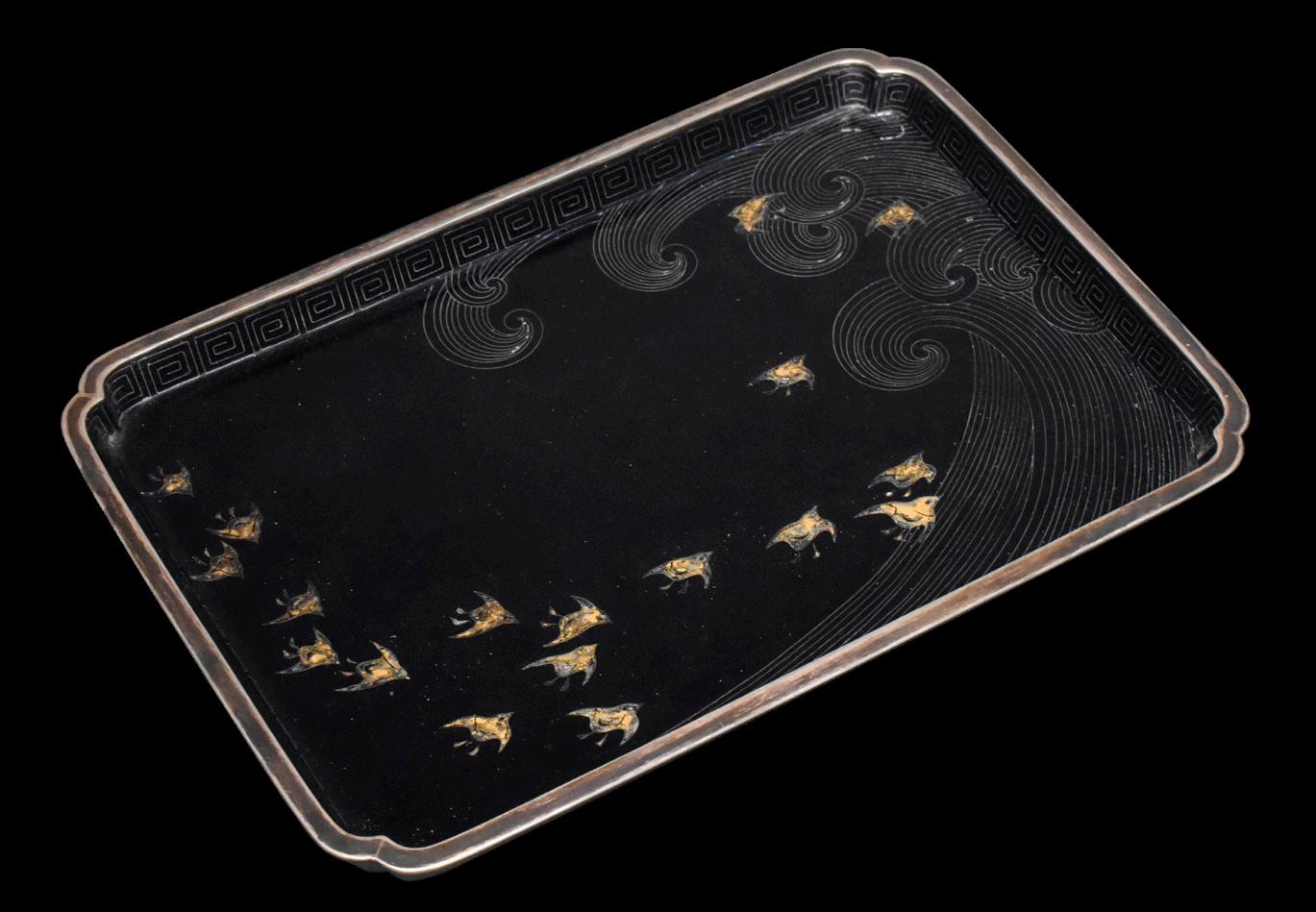
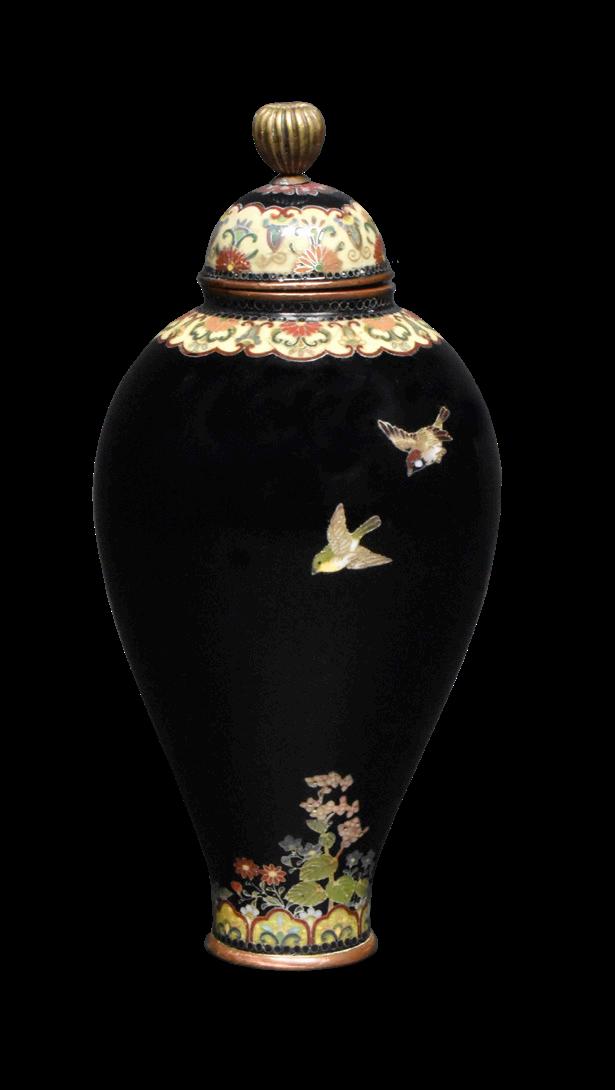
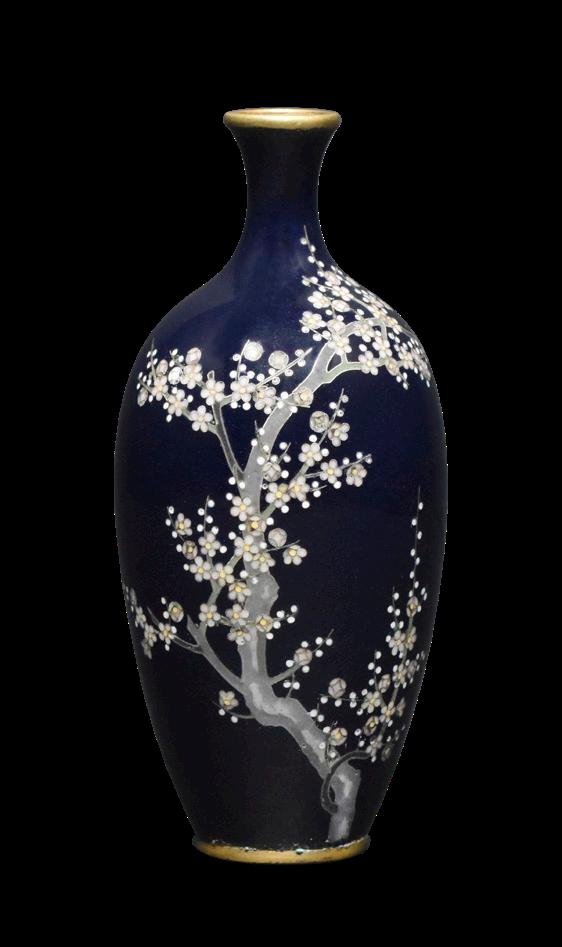


HATTORI TADASABURO (DIED 1939)
A MORIAGE CLOISONNÉ-ENAMEL MATCHING BOX AND TRAY TAISHO (1912-1926) OR SHOWA (1926-1989) ERA, EARLY 20TH CENTURY
Each worked in silver wire and gold moriage (heaped-up enamels) with a matching design of a flock of chidori (plovers or dotterels) flying over stylised Korin-style waves on a black ground, the mounts of silver, signed in silver wire on the base of the box Shippo Korin within a gourd seal, signed on the tray in silver wire with a round seal Korin, with a wood tomobako storage box inscribed inside the lid Shippo kuroji namichidori moriage kitsuengu (Blackground cloisonné moriage tobacco set with waves and plover design) and signed […] do Korin tsukuru with a seal Korin (4)
The box: 6.5cm x 14.5cm x 11cm
The tray: 2cm x 21cm x 15cm
£3,000-4,000
110
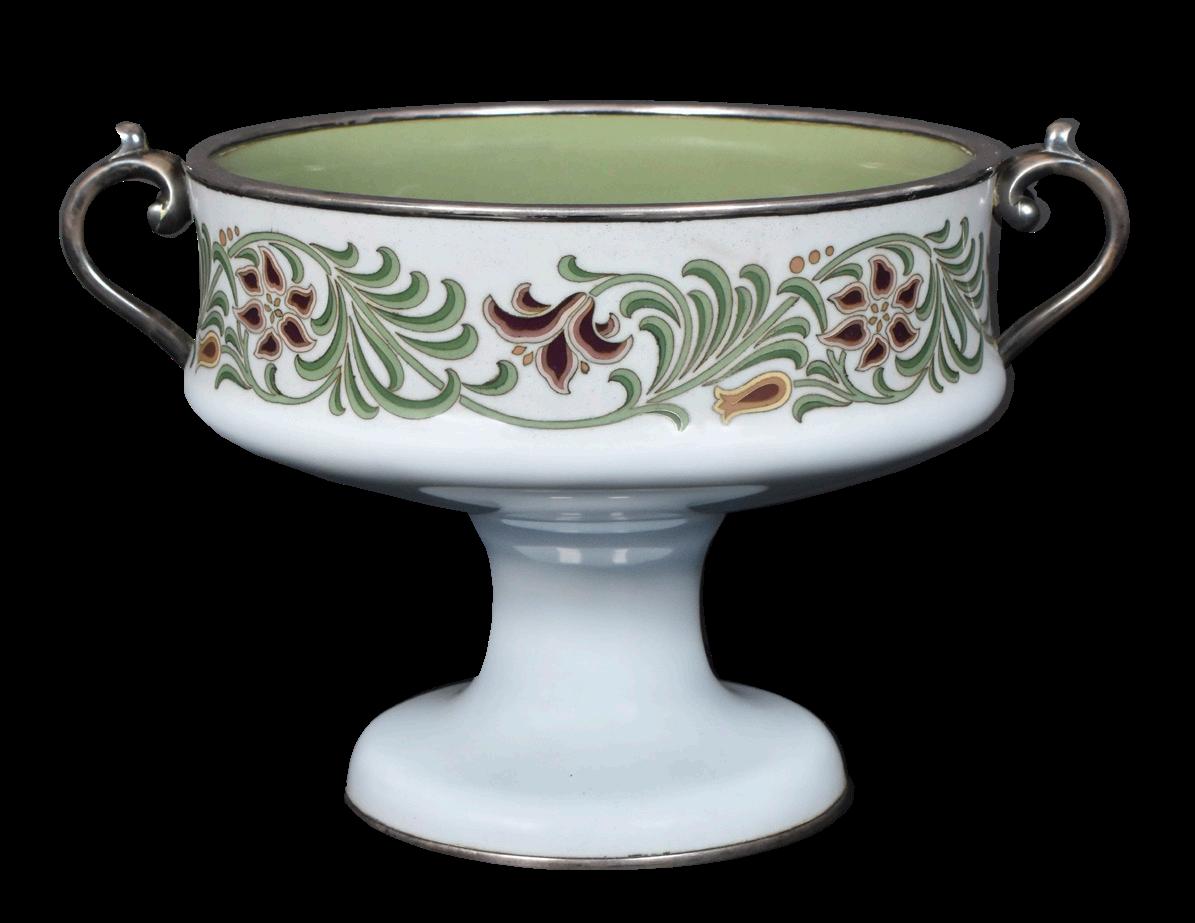
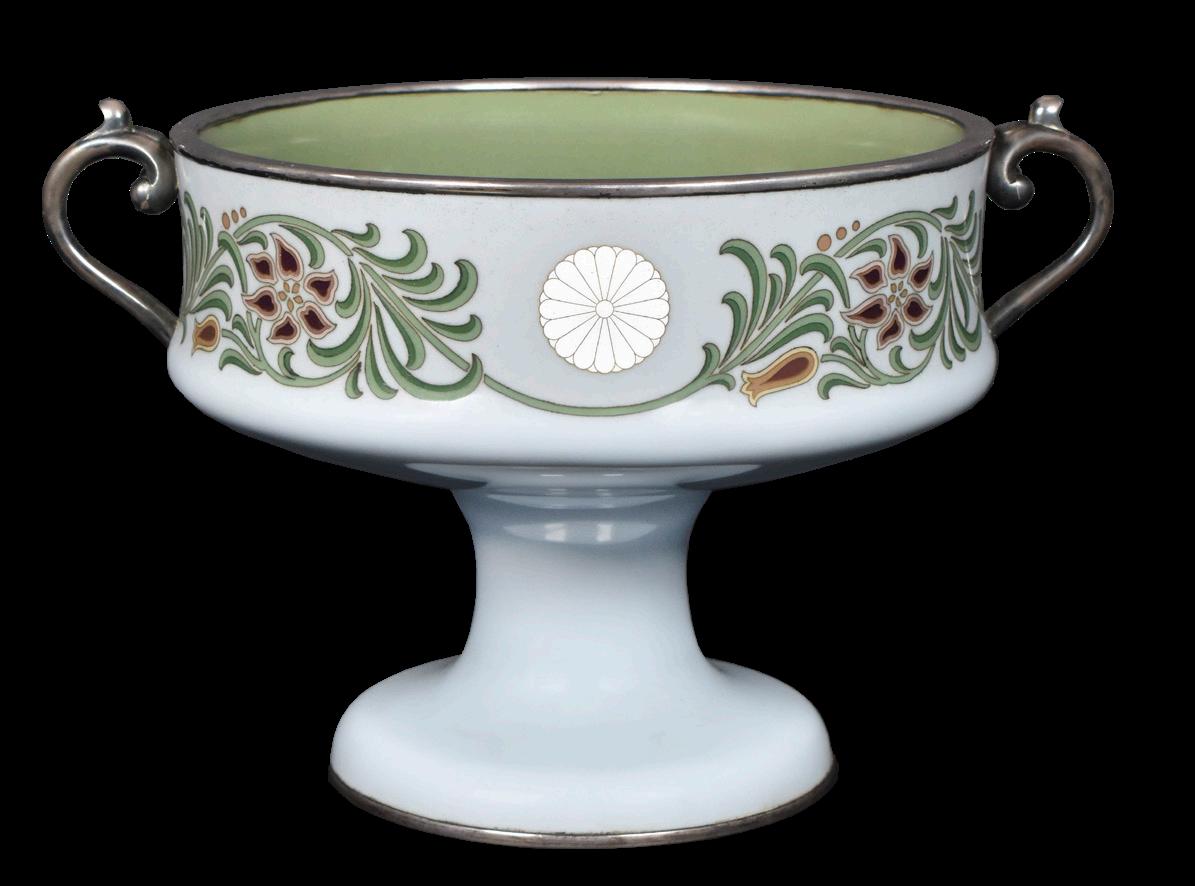
108Ω
SHIBATA WORKSHOP
A MINAITURE CLOISONNÉ-ENAMEL
BALUSTER VASE
MEIJI ERA (1868-1912), LATE 19TH/EARLY 20TH CENTURY
Of meiping form flaring slightly at the base and worked in silver wire of varying gauge and polychrome enamels with stalks of chrysanthemums at the front, an uguisu (warbler) and two sparrows in flight over flowering sakuraso (primrose) on the reverse against a black ground, the shoulder and cover similarly decorated with formal floral bands, the foot with stylized stiff leaf patterns, copper fittings; the base signed on a silver tablet Kyoto Shibata; with a blue cloth covered storage box (3)
11.5cm high
£2,000-3,000
109
A CLOISONNÉ-ENAMEL MINIATURE VASE
MEIJI ERA (1868-1912), LATE 19TH/EARLY 20TH CENTURY
Worked in silver wire of varying gauge with a flowering plum tree reserved on a midnight-blue ground; unsigned
8.3cm high
£200-300
To be sold without reserve
110Ω
ANDO JUBEI COMPANY
A CLOISONNÉ-ENAMEL FOOTED BOWL
MEIJI PERIOD (1868-1912), LATE 19TH/EARLY 20TH CENTURY
Finely worked in gilt wire with stylised stalks of purple lilies and buds positioned horizontally around the body flanking a large 16-petalled white kiku mon (chrysanthemum crest) worked in gold wire reserved on a pale-blue ground, the sides with a silver handle in the form of a lily stalk echoing the decoration on the body; the interior and underside of olive green, the rim and foot of silver, the base marked in silver wire with the Ando Jubei logo; with a wood storage box (2)
18cm x 28cm
£3,000-5,000
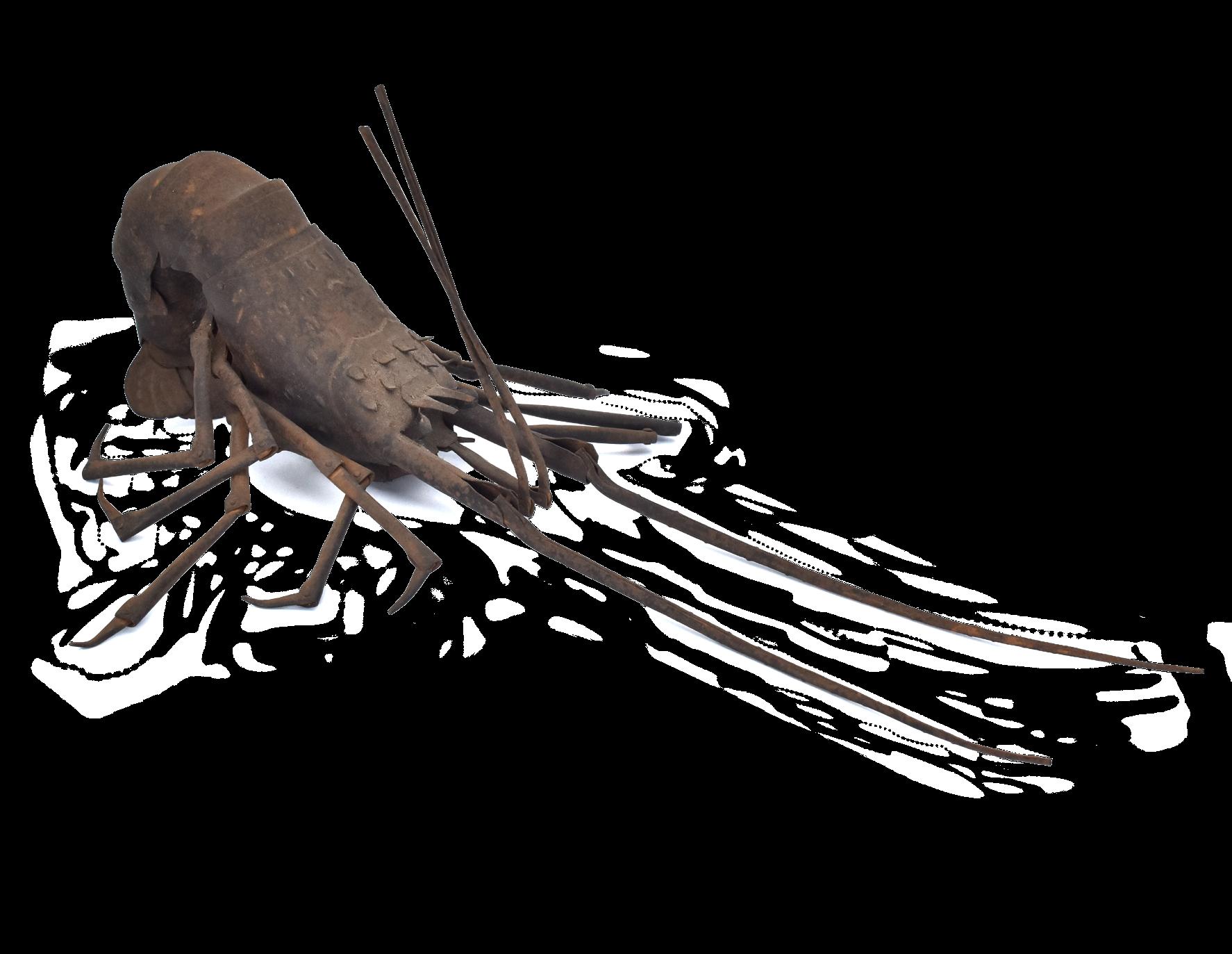

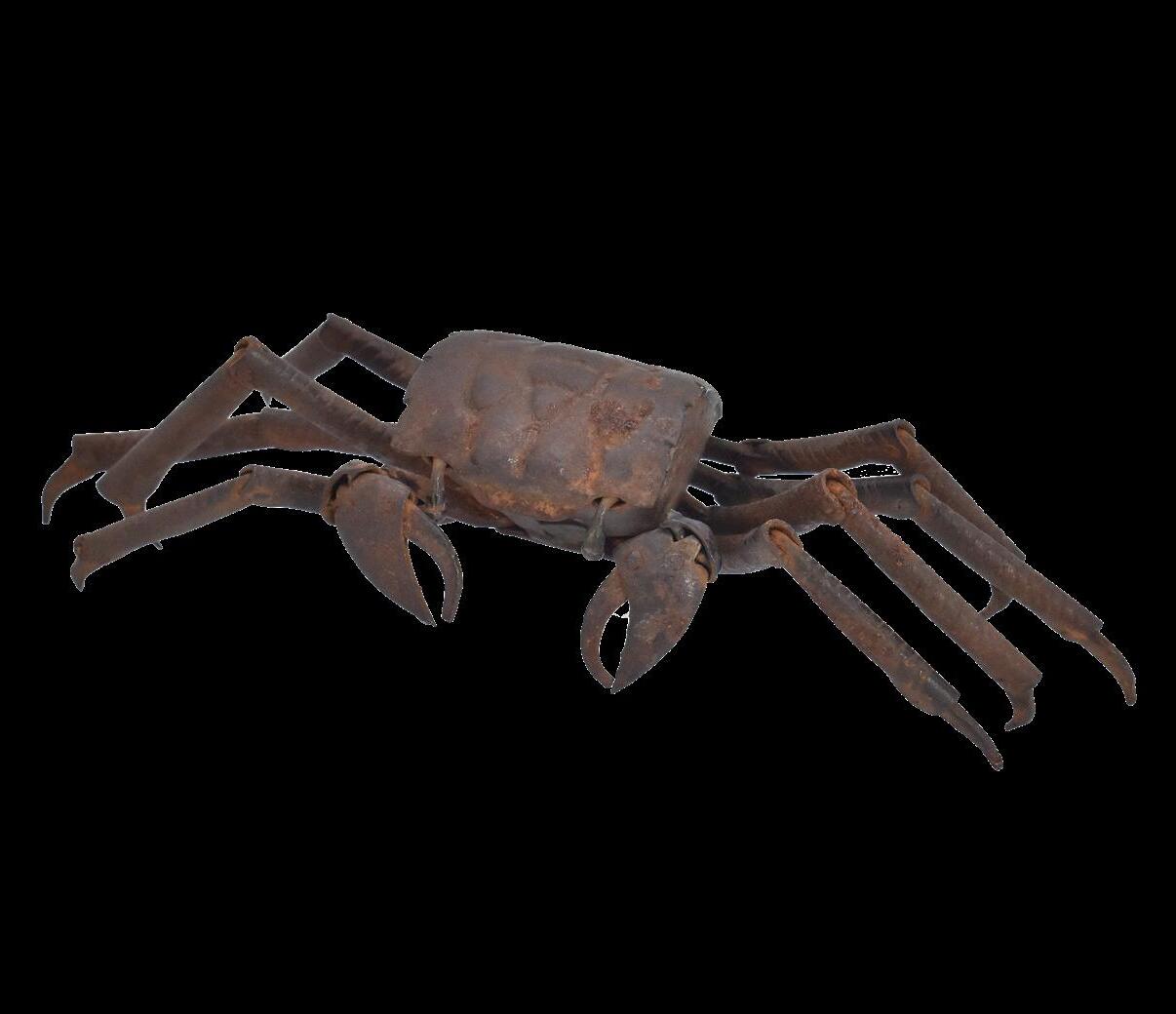
MYOCHIN WORKSHOP
AN ARTICULATED IRON MODEL OF A SPINY LOBSTER
EDO PERIOD (1615-1868) OR MEIJI ERA (1868-1912), 19TH CENTURY
Assembled from hammered sheets of iron with fully-articulated tail and limbs, the surface worked to resemble the natural shell, signed on the underside Myochin; with a wood storage box (2)
21cm long with retracted antennae
£1,000-1,500

112Ω
MYOCHIN MUNEHARU
AN ARTICULATE IRON OKIMONO (TABLE ORNAMENT) OF A CRAB
EDO PERIOD (1615-1868), MID-/LATE 19TH CENTURY
The soft-shell crustacean separately cast and assembled, the legs and claws fully articulated, the surface worked to resemble the crab’s natural shell, patinated to a dark brown finish; signed on the abdomen
Myochin Muneharu
15cm wide, including distended legs
£1,200-1,800
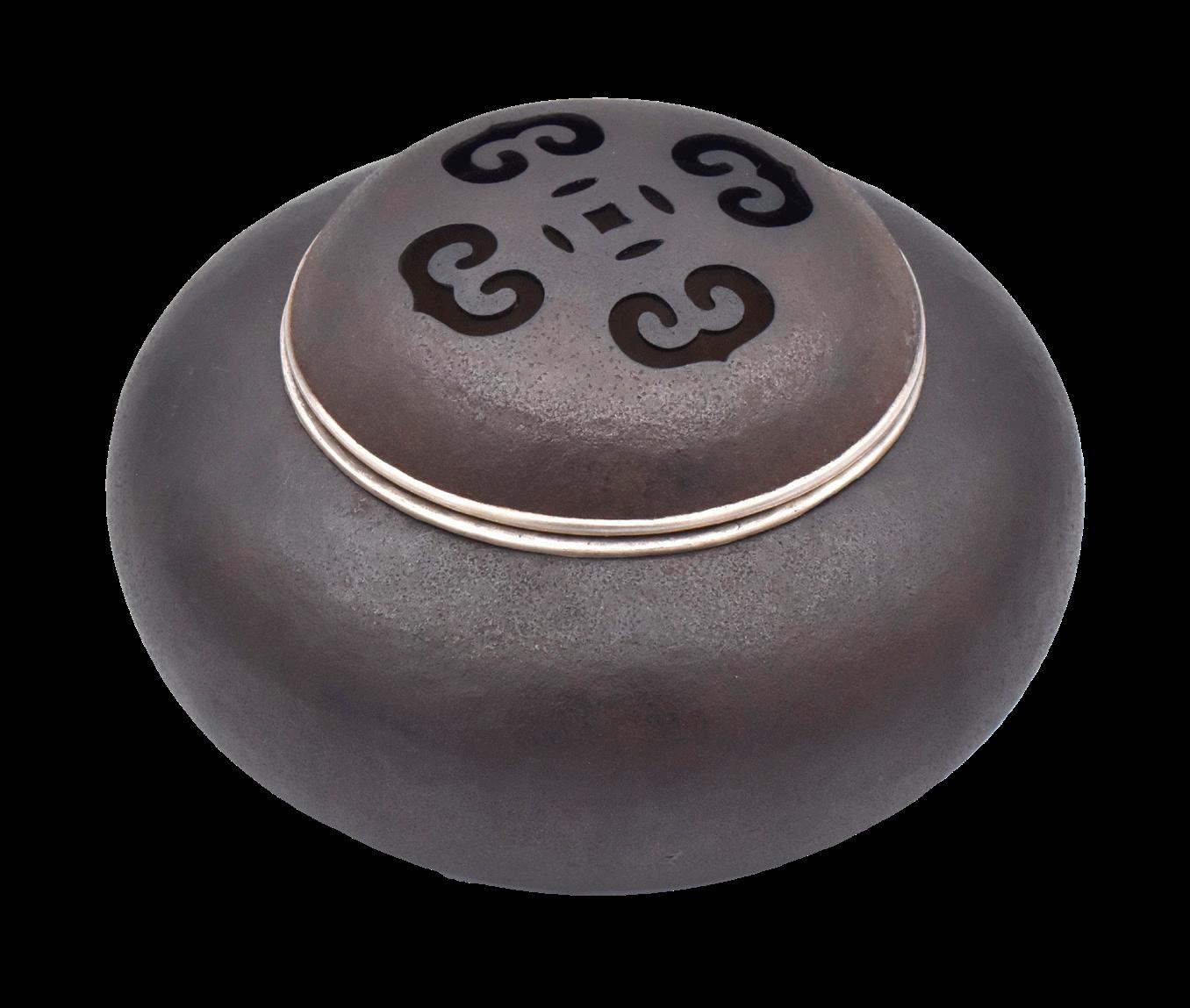

SEIRYUDO
A CARVED TETSUBIN (IRON KETTLE)
MEIJI (1868-1912), TAISHO (1912-1926) OR SHOWA (1926-1989)
ERA, LATE 19TH/EARLY 20TH CENTURY
The cylindrical body cast in iron, simulating a rocky surface, decorated in high relief with a Rakan beneath pine branches on one side and a four-line poem on the reverse, the handle inlaid in gold and silver flat relief with wisps of clouds; the cover finished in a mottled red and brown patina surmounted by a finial in the form of a lotus flower, the inside of the cover signed with chiselled characters Seiryudo tsukuru
14cm high excluding handle
£800-1,000
114
RYUBUNDO
A CARVED TETSUBIN (IRON KETTLE)
MEIJI (1868-1912), TAISHO (1912-1926) OR SHOWA (1926-1989)
ERA, LATE 19TH/EARLY 20TH CENTURY
The cylindrical body cast in iron and decorated in low relief, the body with continuous design simulating bundles of tied rice among which are crawling two batta (grasshoppers), the lobed handle inlaid in silver flat relief with grapes and vine, the cover finished in a mottled red and brown patina surmounted by a finial in the form of a pierced flower, signed on the inside of the cover with chiselled characters Ryubundo tsukuru
17cm high excluding handle
£800-1,000
A HAMMERED IRON SQUAT GLOBULAR KORO (INCENSE BURNER)
MEIJI ERA (1868-1912), EARLY 20TH CENTURY
The uchidashi (repoussé hammered) body unadorned, supported on three stubby, curved feet, with a removable en-suite iron cover reticulated with four stylised hearts surrounding smaller geometric shapes, the interior with a hammered silver liner, signed on the base Sobi (2)
8.3cm x 12cm
£5,000-8,000
Yamada Sobi was born in Ishikawa Prefecture and studied under his father, Yamada Soko (1831-1908). He was renowned for his mastery of the hammered iron technique which he used to produce three-dimensional, sculptural works from a single ingot of iron. He won several prizes including the Gold Medal Prize at the Paris International Exhibition of 1900 and the First Prize at the fifth Naikoku Kangyo Hakurankai (National Exhibition for the Encouragement of Industry) in 1905
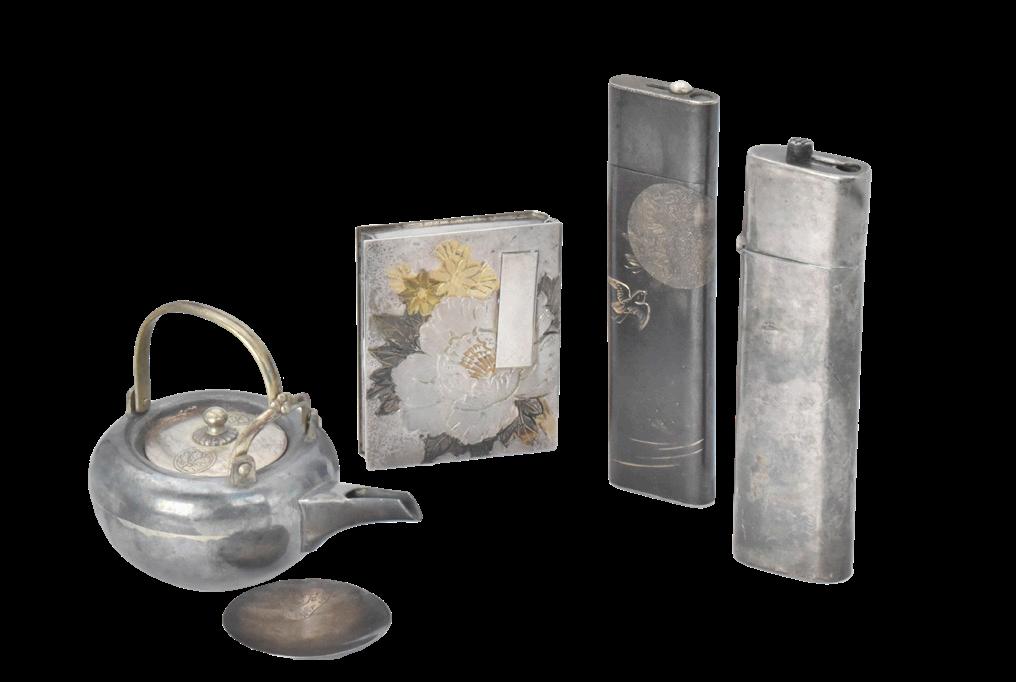
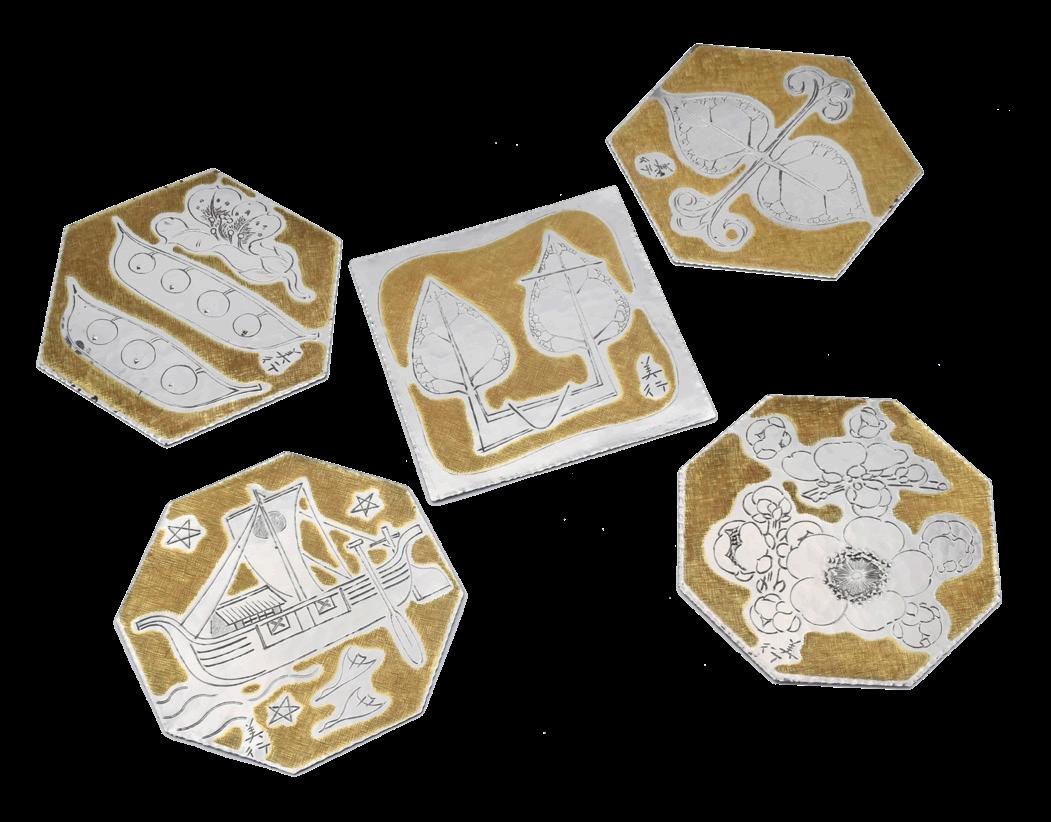
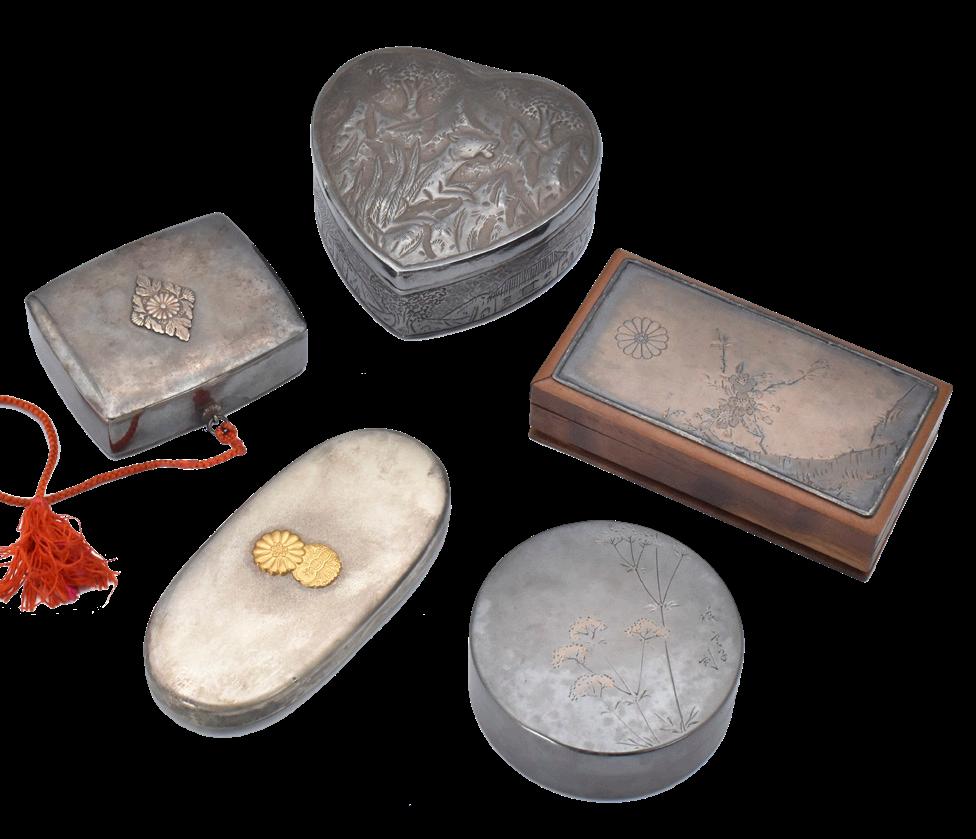

117Ω
FIVE SILVER BONBONNIÈRE (MINIATURE CONTAINERS FOR CONFECTIONERY)
MEIJI (1868-1912) OR TAISHO (1912-1926) ERA, LATE 19TH/EARLY 20TH CENTURY
116Ω
FOUR SILVER MINIATURE VESSELS
MEIJI (1868-1912) OR TAISHO (1912-1926) ERA, EARLY 20TH CENTURY
Comprising two yoji-ire (toothpick holders), one of plain silver, the other also of silver and engraved with three chidori (plovers or dotterels) flying towards the full moon, each 6.8cm high; the third a jintan-ire (medicine box) in the form of a book, engraved with a large leafy peony, 4cm x 3cm; the fourth a miniature sake ewer, 5.5cm high, and en-suite sakazuki engraved in katakiribori with a rock on water, 2.4cm diam., all in a wood storage box (6)
£800-1,000
Comprising five special gift containers of different shapes: the first heart-shaped, the hinged cover cast in low relief with a dog in the undergrowth, the sides carved with buildings and trees, unsigned; 3cm x 7cm x 7cm; the second circular and engraved in katakirbori (engraving with an angled chisel emulating brushstrokes) with flowering stalks of ominaeshi (valerian), signed Shounshi koku, the base stamped Jungin (Pure silver), 2.2cm x 6cm; the third a rectangular box and cover applied in low relief with a silver 16-petalled kiku-mon (chrysanthemum crest) surrounded by foliage and other chrysanthemums forming a diamond shape, the base signed Kobayashi sei within an irregular reserve and stamped Jungin (Pure silver), 2cm x 5.5cm x 4.7cm; the fourth a long oval box and cover, applied in gold relief with a stylised butterfly roundel overlapping with a 16-petalled kiku-mon, signed on the base Ishifuku kinsei, 0.5cm x 8.2cm; the fifth rectangular, the body of wood and the cover inset with a shibuichi panel engraved in katakiribori with a 16-petalled kiku-mon floating above a cherry tree, unsigned, 2.3cm x 8.5cm x 4.5cm; each with a wood storage box (10)
£1,200-1,800
118Ω
CHOSA YOSHIYUKI (1915-2002)
SIX SETS OF FIVE WHITE METAL AND GILT COASTERS
SHOWA ERA (1926-1989), 20TH CENTURY
Comprising six sets of five coasters of different shapes, two octagonal, two hexagonal and one square, each decorated with a stylised foliate or vegetal motif except for one decorated with a ship, each coaster signed Yoshiyuki, five coasters contained in a square fitted, compartmentalised, wood box, inscribed on the exterior Musubu kokoro (‘Knotted Heart’) and signed and sealed by the artist Chosa Yoshiyuki with seal Yoshiyuki (36)
Each coaster approx. 9cm x 9cm.
£300-500
To be sold without reserve
119Ω
FOUR SILVER MINIATURE VESSELS
MEIJI (1868-1912) OR TAISHO (1912-1926) ERA, EARLY 20TH CENTURY
Comprising two compact mirror cases, one engraved in katakirbori (engraving with an angled chisel emulating brushstrokes) with flowering stalks of chrysanthemums, the reverse with two sparrows, signed […] masa to, 7cm x 6.5cm; the second of square form and engraved with a stylised foliate motif, 7cm x 6cm; the third a snuff bottle engraved with the design shochikubai (pine, bamboo and plum, the ‘Three Friends of Winter’), stamped silver on the base, 6cm x 4.3cm; the fourth a Chinese snuff bottle in the form of a dragon-handled gourd, with a screw top, with a Chinese silver mark on the base, 8cm high; with one wood storage box (5)
£800-1,000
120Ω
A SILVER KODANSU (CABINET)
MEIJI (1868-1912) OR TAISHO (1912-1926) ERA, EARLY 20TH CENTURY

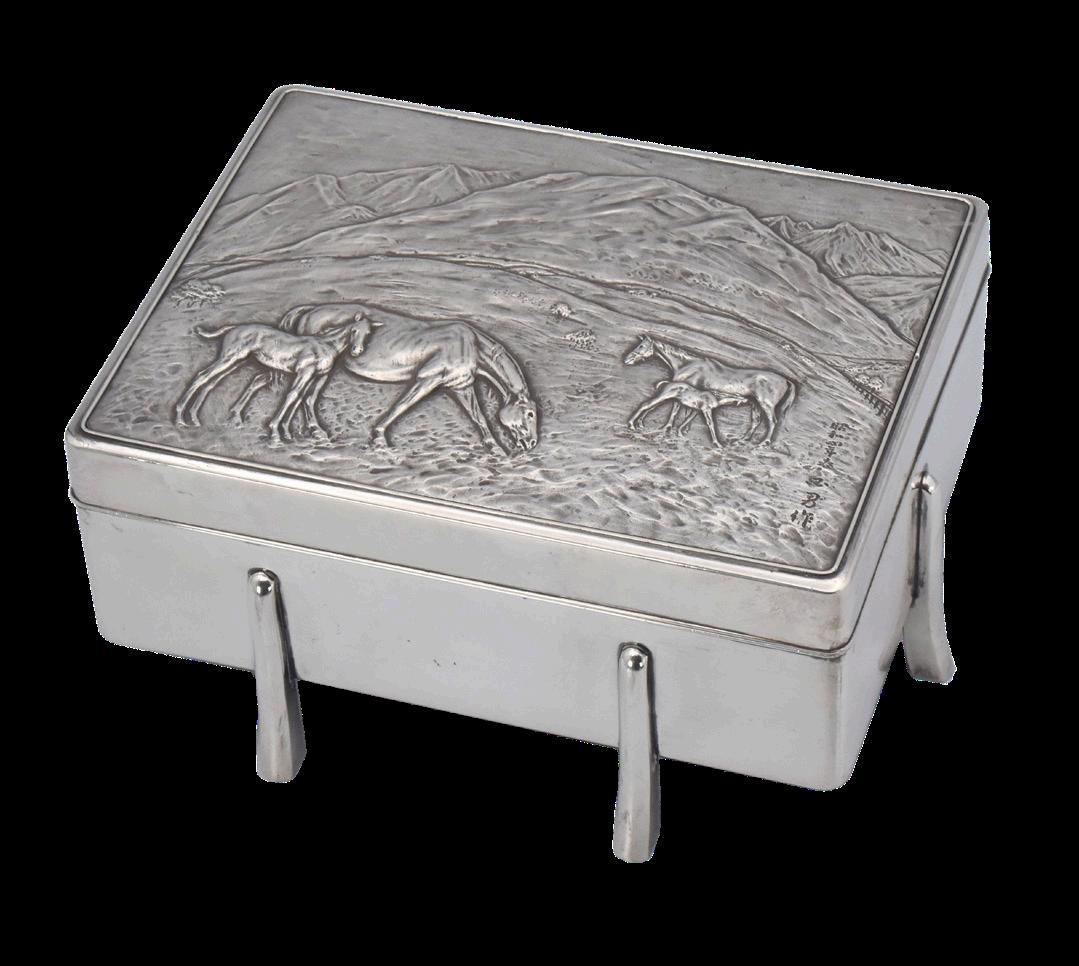
The rectangular body engraved all over with repeated floral designs of chrysanthemums, roses and foliage enclosed within triangular panels, the front hinged doors opening to reveal within a set of three drawers of plain black lacquer applied with silver bracket handles, with metal mounts and the top with a carrying handle, stamped on the base Jungin (Pure silver) and in Roman letters Sterling 950 silver
11.5cm x 20cm x 12.3cm
£3,000-4,000
121Ω
KUNIO
A RECTANGULAR SILVER SIX-LEGGED BOX SHOWA ERA (1926-1989), DATED 1929
Decorated in low relief on the outside of the cover with four horses grazing in mountainous landscape, the interior and underside of rich nashiji; stamped on the base jungin (Pure silver), signed with chiselled characters Showa yonen haru Kunio saku (Made by Kunio in spring 1929) 7cm x 13.5cm x 10.2cm
£800-1,000
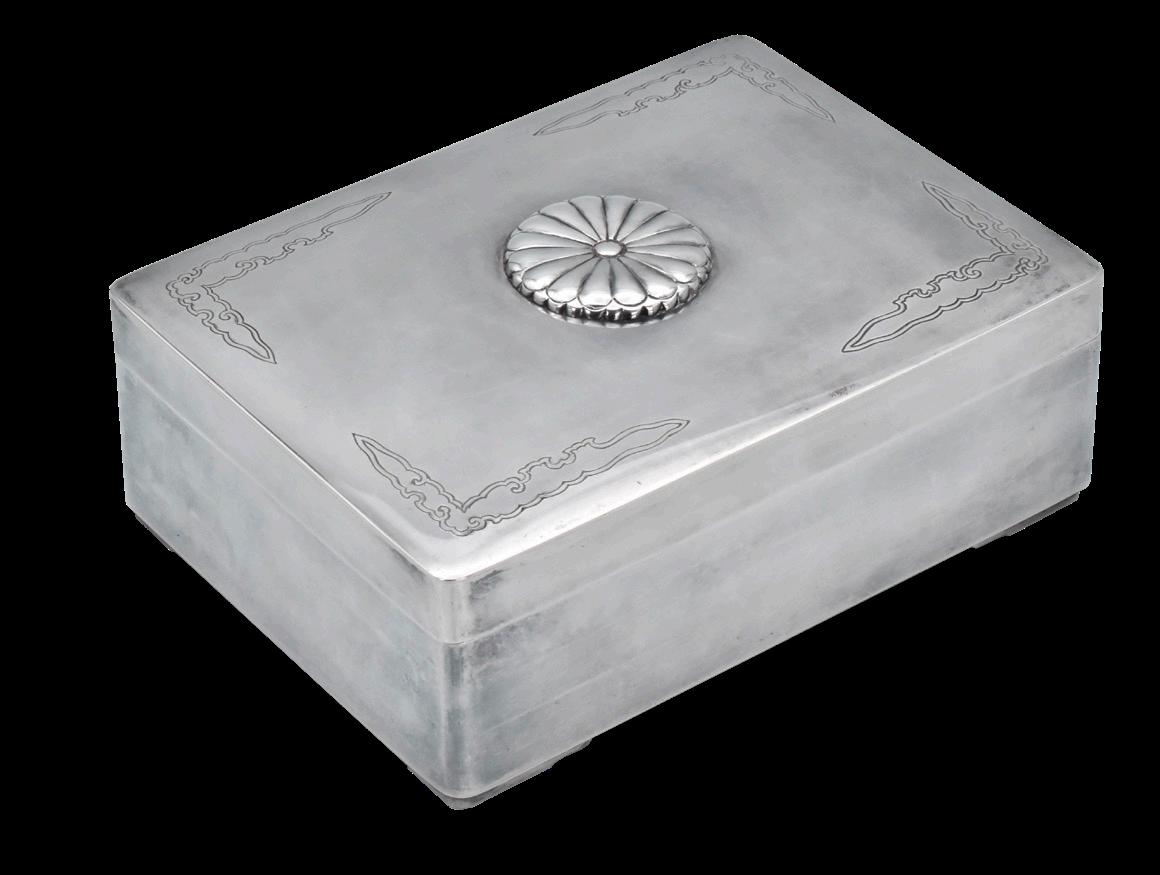
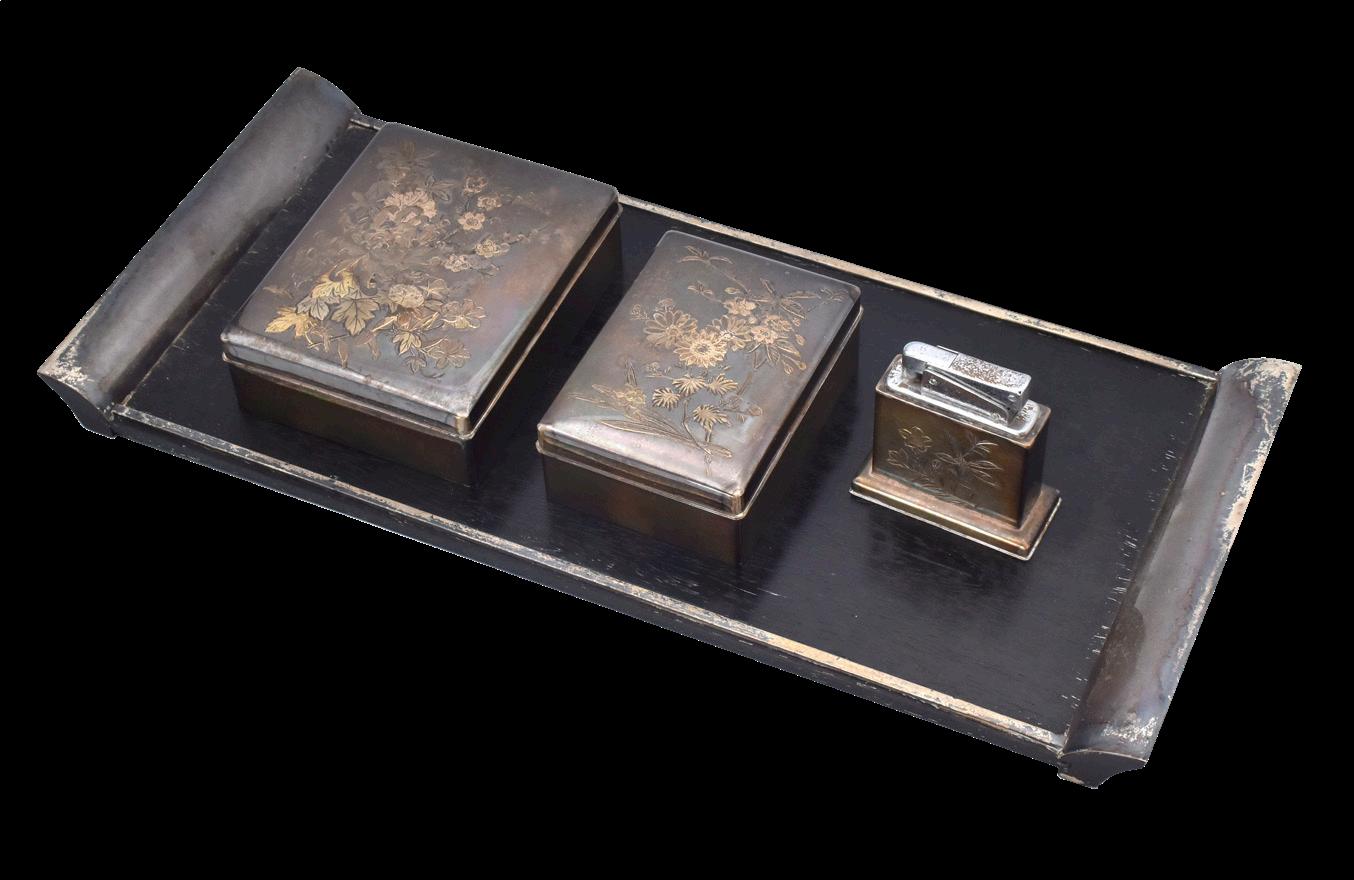
A SILVER CIGARETTE BOX
MEIJI ERA (1868-1912), LATE 19TH/EARLY 20TH CENTURY
The rectangular body with an inrobuta (flush-fitting) lid, applied in low relief on the top with a 16-petal chrysanthemum crest in silver, the corners engraved with decorative flourishes, the underside stamped with two seals Kinsei (respectfully made) and Jungin (Pure silver), unsigned; with a wood storage box (3)
4.8cm x 14cm x 10.1cm
£800-1,000 illustrated on page 63

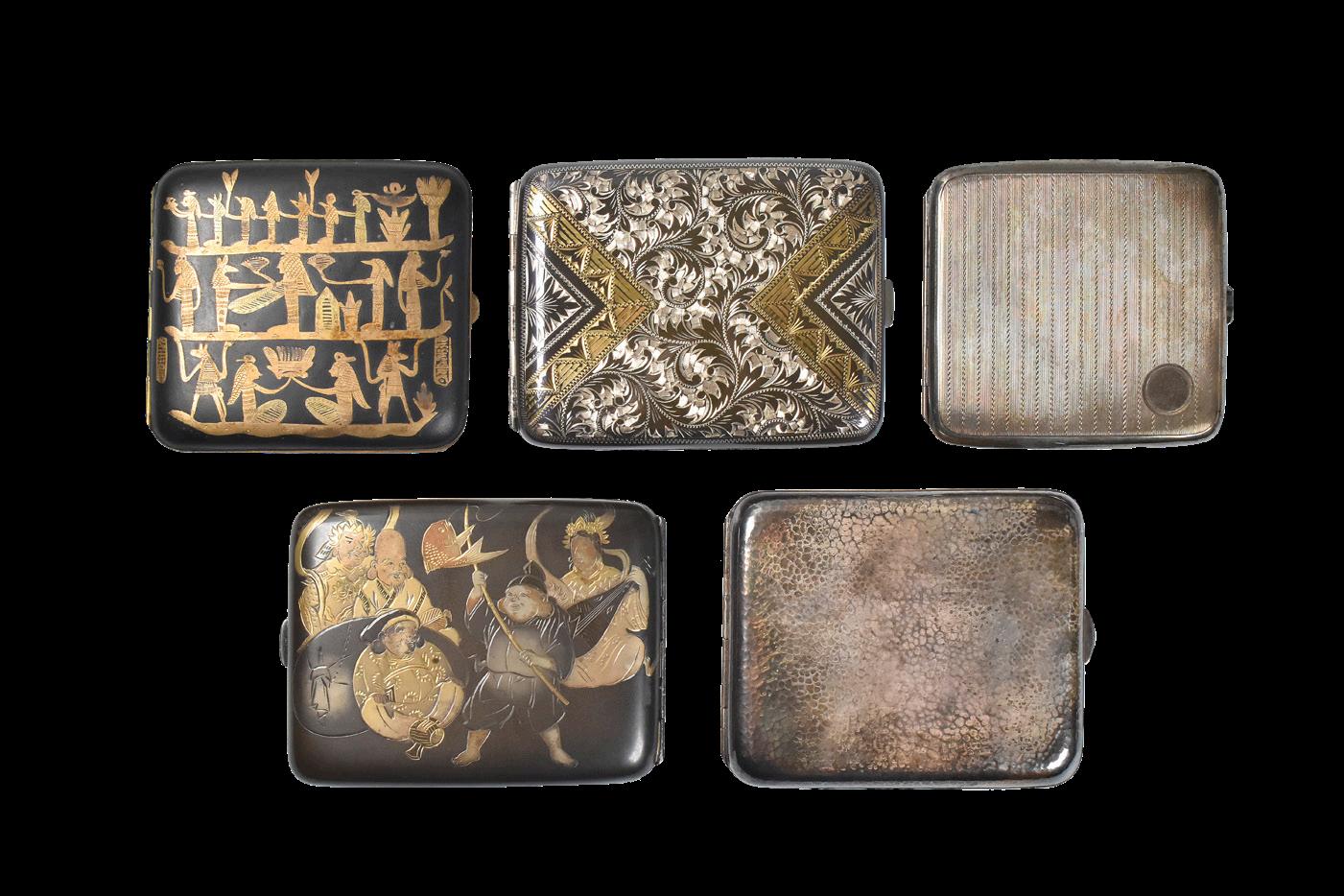
FOUR-PIECE SILVER SMOKING SET
TAISHO (1912-1926) OR SHOWA (1926-1989) ERA, 20TH CENTURY
Comprising a cigarette box and cover, 3.2cm x 8.2cm x 10.5cm; an ashtray, 3.2cm x 6.5cm x 9cm; a lighter, 5.9cm high; and a rectangular tray, 2.5cm x 35cm; each engraved on the exterior with assorted flowers of the four seasons, the tray plain with a wood surface, each stamped ginsei (silver) (4)
£800-1,000
124Ω
A FOUR-PIECE SILVER SMOKING SET
TAISHO (1912-1926) OR SHOWA (1926-1989) ERA 2OTH CENTURY
Comprising a cigarette box and cover, signed with chiselled characters Masahiro koku, 4cm x 8cm x 14cm; an ashtray, 4cm x 7.5cm x 10cm; a lighter, 4cm x 5cm; and a rectangular tray, each piece engraved with the details of a chrysanthemum, each stamped silver 950 on the base (4)
£800-1,000
125Ω
FIVE MIXED-METAL CIGARETTE BOXES,
MEIJI (1868-1912) OR TAISHO (1912-1926) ERA, LATE 19TH/EARLY 20TH CENTURY
Each of conventional form, comprising one engraved with the Shichifukujin (the ‘Seven Gods of Good fortune’), each depicted with their respective attributes on a shibuichi ground, signed on the reverse with chiselled characters Yoshihiro koku; the second decorated on the shakudo ground with Egyptian style motifs applied in gilt, the third of plain silver with a hammered ground, stamped silver 995; the fourth of shibuichi decorated with vertical wavy lines, with a cloth-lined fitted square storage box; the fifth engraved with stylised foliage and geometric designs (6)
Each approx. 7.5cm x 10cm
£1,200-1,800
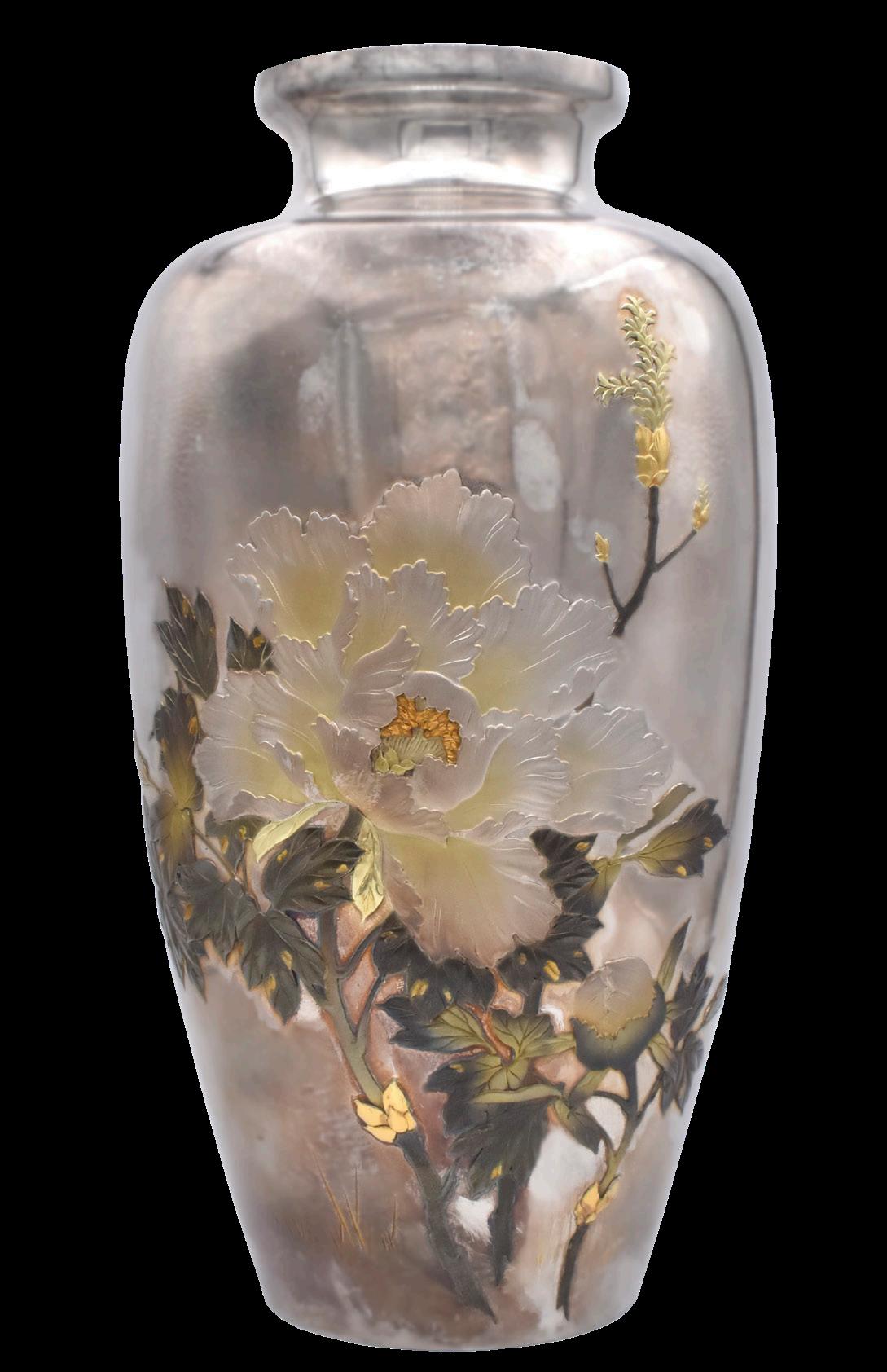
126Ω
YOSHIMINE FOR THE KOBAYASHI COMPANY
AN INLAID SILVER BALUSTER VASE, MEIJI ERA (1868-1912), LATE 19TH/20TH CENTURY
The front decorated in high relief of gold, silver and shibuichi alloys with flowering stalks of peonies and buds beside grasses rendered in katakiribori (engraving with an angled chisel emulating brushstrokes); signed on the reverse with chiselled characters Yoshimine with a gold seal reading Jun and on the base Jungin (Pure silver) Kobayashi kinsei (Respectfully made by Kobayashi) within a square reserve; with a wood stand and an inscribed wood storage box (3)
31cm high
£3,000-5,000

127Ω
A BRONZE AND SILVER OKIMONO (TABLE ORNAMENT) OF A DRUM SURMOUNTED BY A COCKEREL (KANKODORI), MEIJI ERA (1868-1912), LATE 19TH/EARLY 20TH CENTURY
The detachable, silver cockerel standing on the top of a drum, raised on a four-legged tall stand, the body of the drum of bronze chiselled with a simulated mokume (wood grain) design, the ends of the drum chiselled with a coiled three-clawed dragon within a circular panel, the edges applied with studs, the legs of the stand embellished with trailing vine applied in low relief, the cockerel’s belly stamped gin (silver) above 900; the base of the stand stamped with an indecipherable seal; with a plain wood storage box (3)
28cm high overall
£2,500-3,000
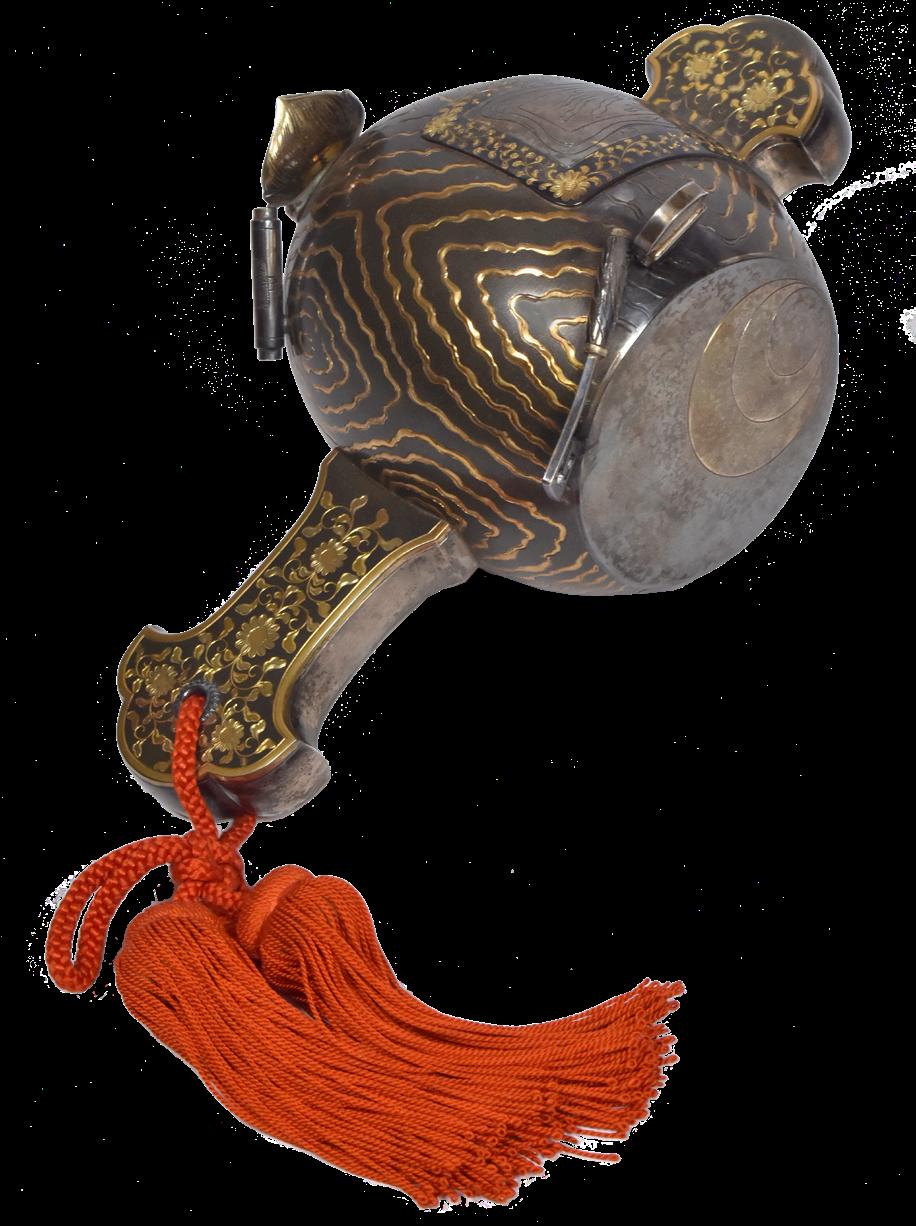
128Ω
AN INLAID GOLD, SILVER AND SHAKUDO OKIMONO (TABLE ORNAMENT) IN THE FORM OF A TSUCHI (DAIKOKU’S MAGIC MALLET)
MEIJI ERA (1868-1912), LATE 19TH/EARLY 20TH CENTURY
The handle inlaid in gold with chrysanthemums interwoven among karakusa (‘Chinese grasses’) the body inset with a silver rectangular panel engraved with stylised ho-o (phoenixes) bordered by a narrow inlaid shakudo band of chrysanthemums among karakusa, all on a ground of simulated mokume (woodgrain) pattern, the striking surfaces engraved with a tama (wish-granting jewel), the sides of the body applied in high relief of silver with a different set of auspicious objects resting against it, respectively, a scroll and a kakuremino (raincoat of invisibility), a fundo (weight), and a straight bracket handle in the form of a key to the ‘Storehouse of the Gods’, with a red silk tassel running through a silver chrysanthemum-shaped eyelet on the base of the handle, unsigned; with black-lacquer lobed stand and a plain wood storage box (3)
The mallet: 21.5cm x 10.5cm
The lacquer stand: 6.5cm x 29cm
£2,000-3,000
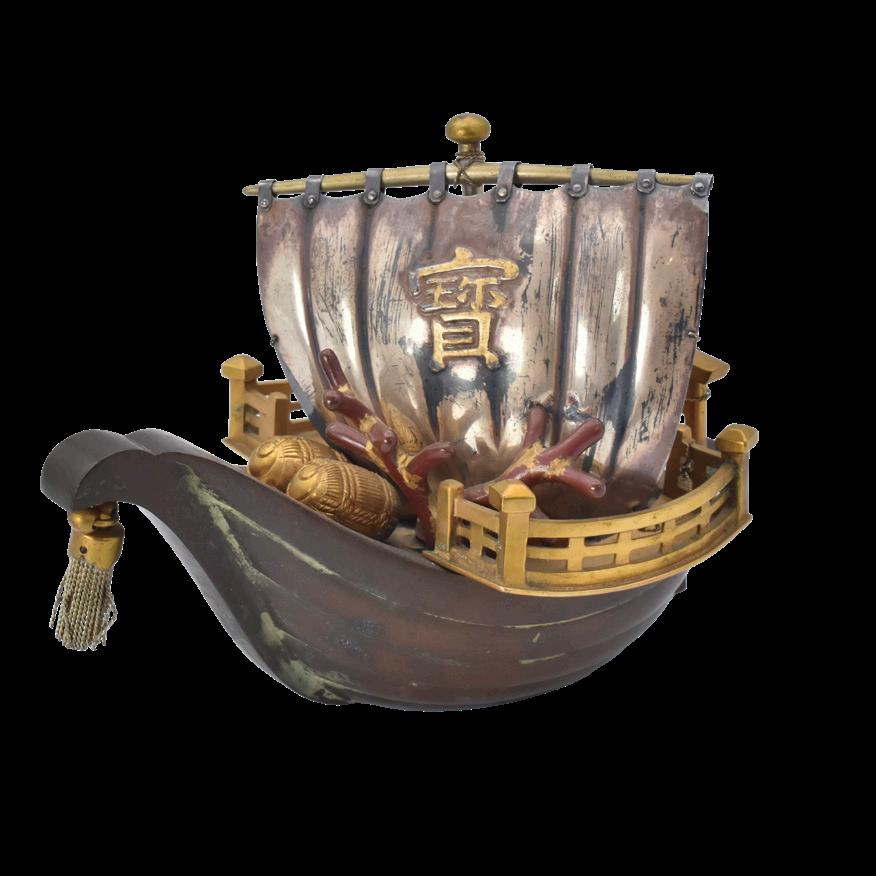
129Ω
TAKASE KOZAN (1869-1934)
A MIXED-METAL OKIMONO (TABLE ORNAMENT) OF A TREASURE SHIP
MEIJI (1868-1912) OR TAISHO (1912-1926) ERA, EARLY 20TH CENTURY
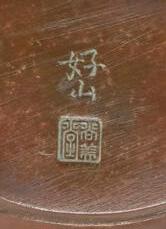
Modelled as the takarabune (treasure ship), laden with the accoutrements including bales of rice, tama (wish-granting jewel), sticks of coral, koban (oval gold coin) and bundo (balance weight) pertaining to the Shichifukujin (‘Seven Gods of Good Fortune’) in bronze, gold, silver and copper, signed on the underside Kozan and sealed Shobido; with a large black-lacquered, oval stand and an inscribed wood tomobako storage box (3)
8.5cm x 11.5cm
£1,500-2,000
Born in Kanazawa the eldest son of Takase Kanatake, Kozan started working in the export department of Ikeda Seisuke’s export company in Kobe, in 1883 and transferred in 1887 to the metalworking division of the factory’s Kyoto branch, where he learned metalworking techniques from Tomiki Isuke. In 1893, he became independent and started a business selling metalwork both domestically and abroad, soon becoming famous for his articulated studies of sea life and insects In 1910, the artist was honoured when the Crown Prince (later the Taisho Emperor) purchased several of his astonishingly realistic articulated insects during a visit to Kyoto
130Ω
A GOLD-LACQUERED WOOD MAEDATE (FORECREST) IN THE FORM OF A SHACHI (DRAGON-HEADED WINGED FISH)
EDO PERIOD (1615-1868) OR MEIJI ERA (1868-1912), MID-LATE 19TH CENTURY
Carved and assembled from wood, the imaginary sea creature modelled with an exaggeratedly stylised large dragonhead, body of a carp and prominent whiskers, its up-raised tail curling over its head, facing ahead with its mouth closed and its fangs exposed, its eyes gold-lacquered with black pupils, other details red-lacquered; displayed on a detachable rectangular black-lacquered wood stand; with an inscribed wood storage box (3)
15cm x 24cm
£2,500-3,500
131Ω
A GOLD-LACQUERED IN THE FORM OF A DRAGON
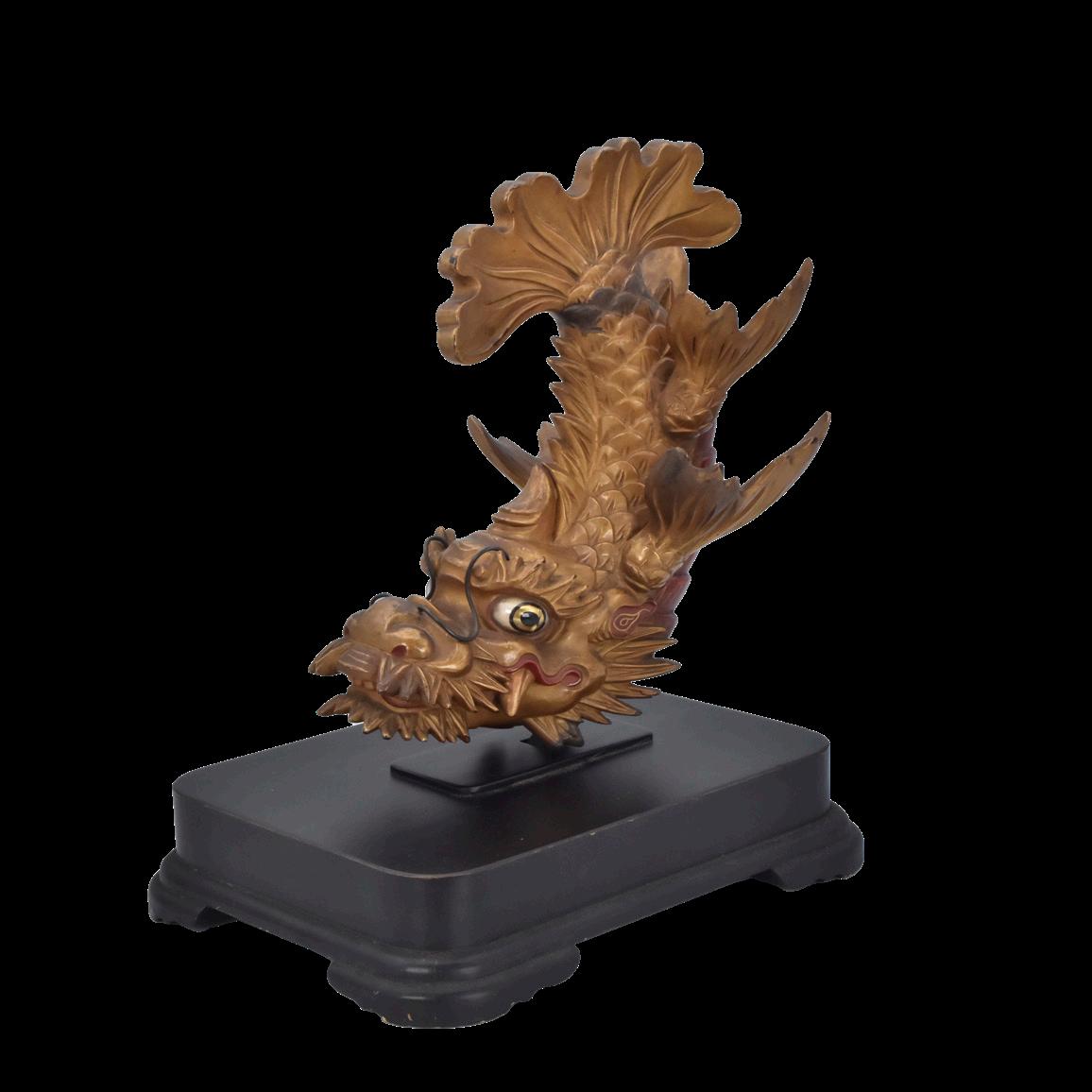
EDO PERIOD (1615-1868) OR MEIJI ERA (1868-1912), MID-LATE 19TH CENTURY
Carved and assembled from wood and decorated in red and gold lacquer as a snarling dragon in a writhing upright position, the eyes gold-lacquered with black pupils, the whiskers of wire, the flames of red lacquer; with a wood storage box (2)
31.5cm long
£2,000-3,000
132Ω
A GOLD-LACQUERED WOOD MAEDATE (FORECREST) IN THE FORM OF A LARGE STYLISED BUTTERFLY
TAISHO (1912-1926) OR SHOWA (1926-1989) ERA, 20TH CENTURY
Carved and assembled from wood, the wings spread out and perforated with circular apertures, the surface lacquered gold, the pair of bulging eyes of brass, the antennae of wire
29cm x 32cm
£800-1,000
133Ω
TAKEHIKO LINEAGE, A MIXED-METAL MINIATURE KABUTO (HELMET) FOR THE BOY’S DAY FESTIVAL
SHOWA ERA (1926-1989), 20TH CENTURY

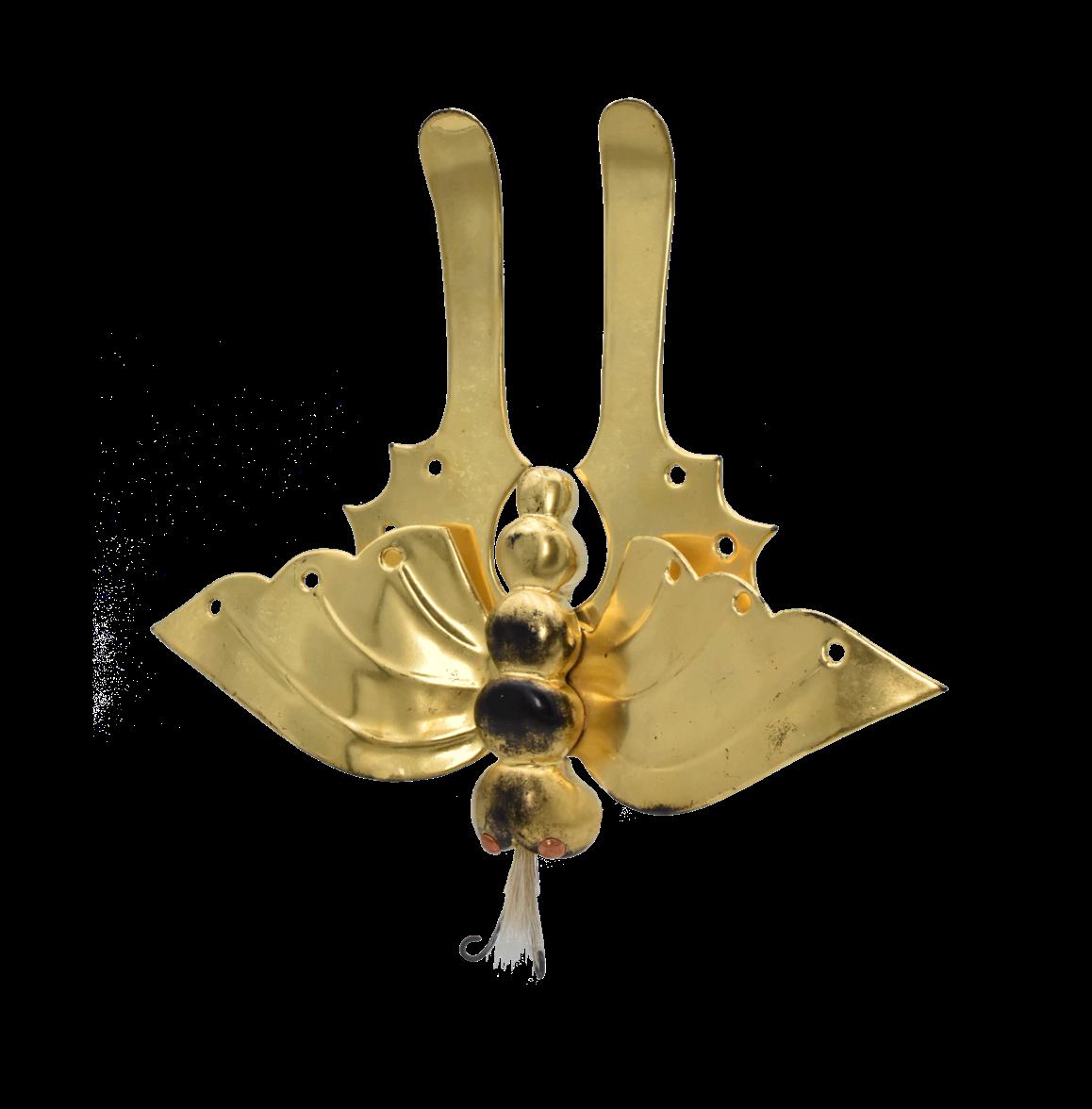
The forty-two plate suji kabuto mounted with gilt-copper tehen kanamono and shinodare, the bowl mounted with a monju-style four-lame shikoro laced in orange silk, with large fukigaeshi in the classical style, decorated with large peony blossoms and applied with a gilt-copper hardware in form of a chrysanthemum crest, the mabizashi and kuwagatadai decorated to match and fitted with gilt-copper kuwagata engraved with repeated stylised foliate motifs and a silvered-metal dragon maedate, signed on the reverse of the right fukigaeshi stamped with signature Jungin Takehiko (Pure silver by Takehiko), with a black-lacquered conical stand, a signed and sealed wood display stand, and a wood storage box (7)
Approx., 7.5cm high
£1,200-1,500
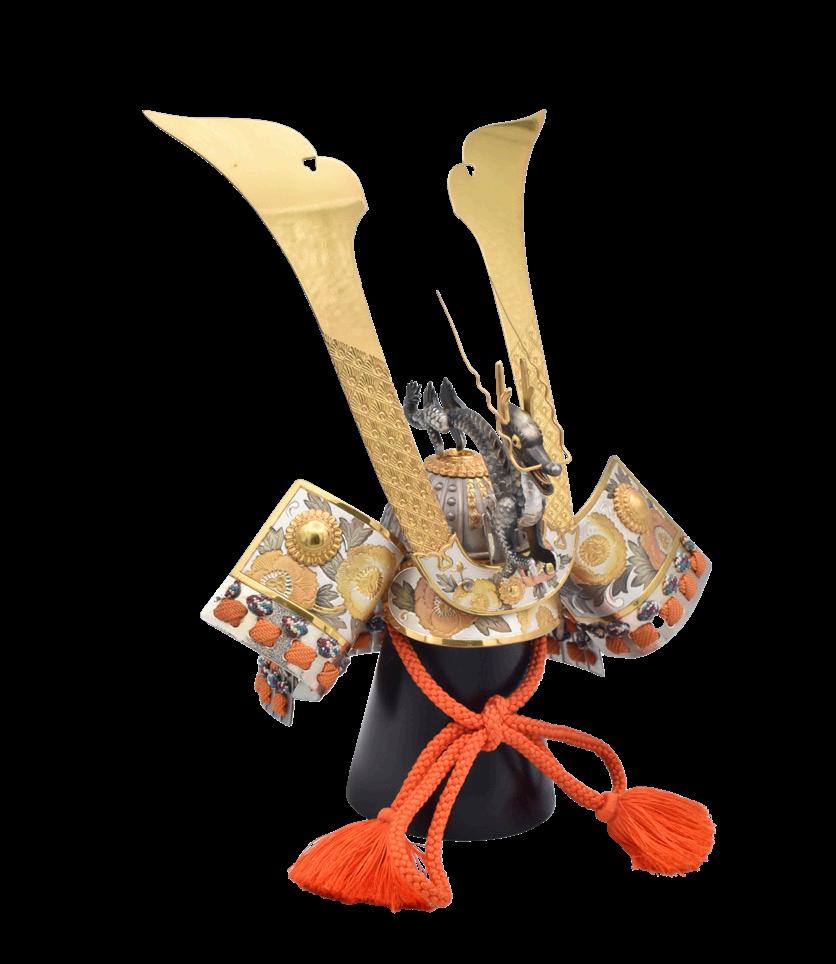
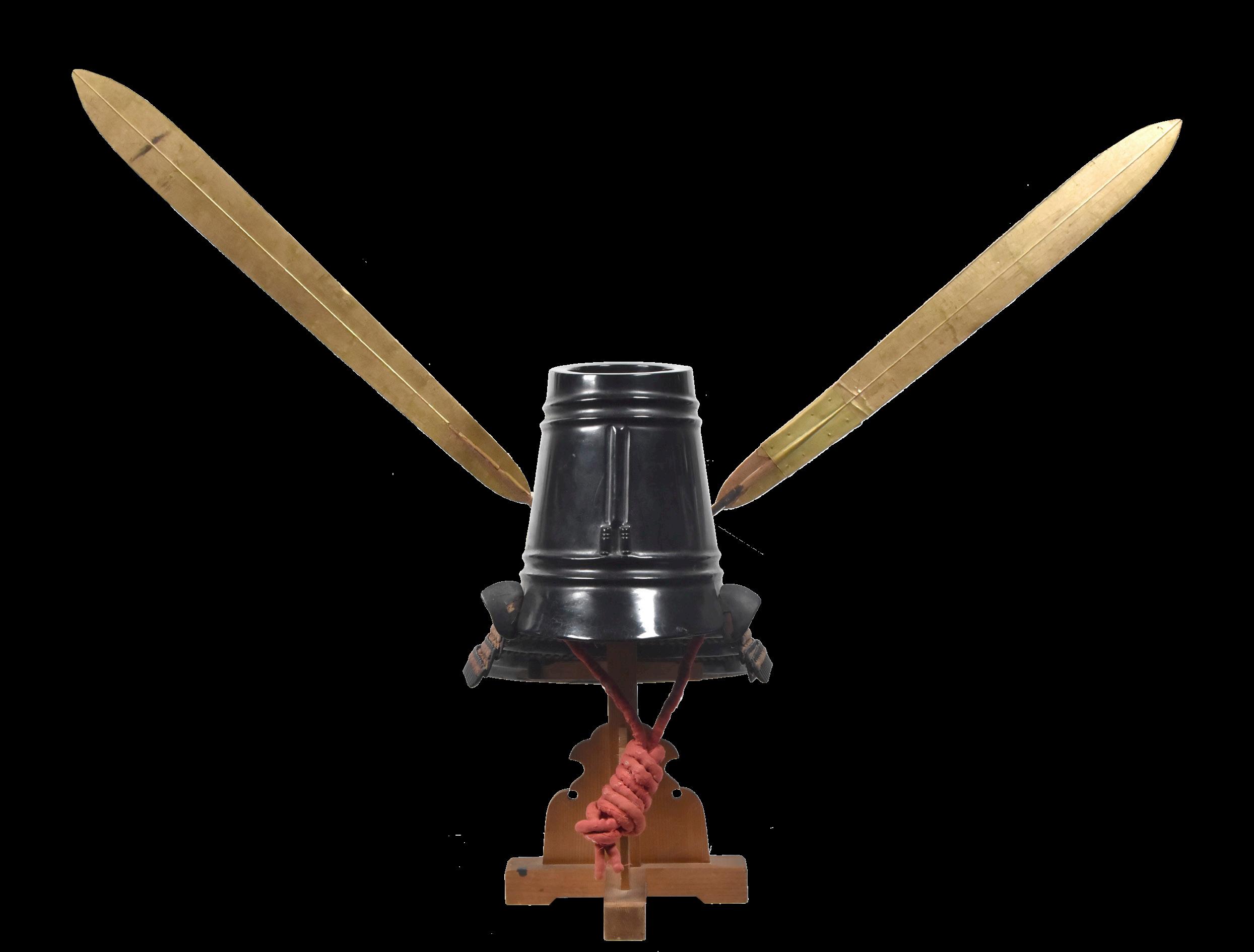
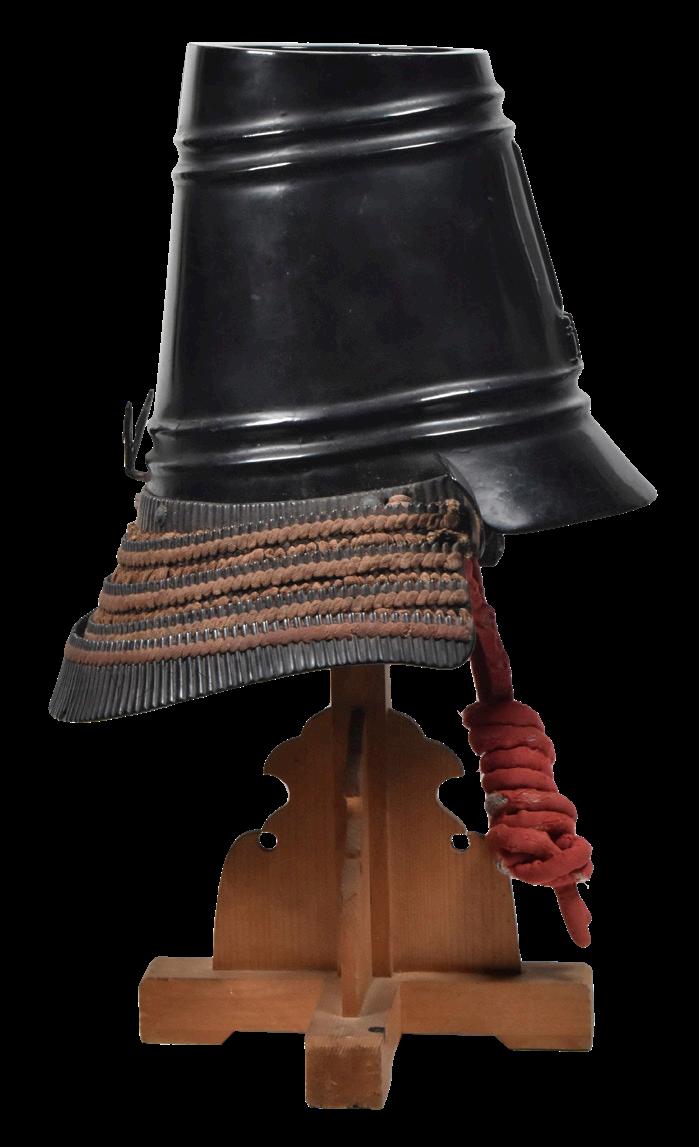
134Ω
A RARE AND UNUSUAL BLACK-LACQUER KAWARI KABUTO (AN ECCENTRIC HELMET)
EDO PERIOD (1615-1868), 18TH/19TH CENTURY
The glossy black-lacquered iron helmet bowl modelled as a section of bamboo, on the front a deep mabisashi (peak), fitted to the rear a five-lame komanju jikoro (small, rounded neck guard) of kitsuke kozane (false lamellae) lacquered black and laced with silk kebiki odoshi (close lacing), on the back of the helmet a removable ushirodate (rear crest) of exaggeratedly long gilded bamboo leaves, the interior with a cloth lining and a chin cord, unsigned; with a lacquered storage box for the helmet and a wood storage box for the bamboo leaves crest (5)
The helmet: 26cm x 14cm
Each bamboo leaf approx. 70cm x 6cm
£8,000-10,000
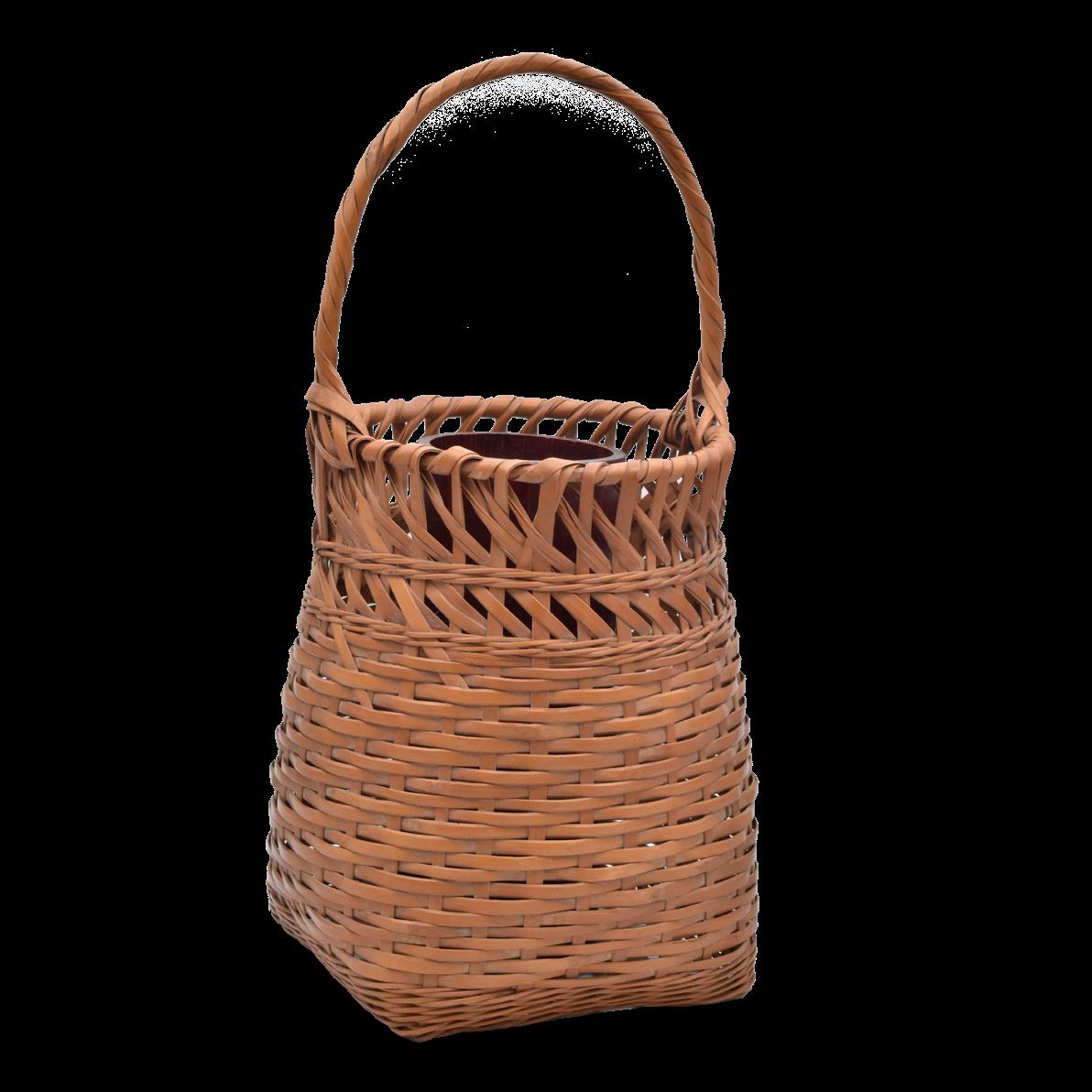
135
TANABE CHIKUUNSAI I (1877-1937), TANABE CHIKUUNSAI II (1910-2000) AND SUEMURA SHOBUN (1917-2000), THREE BAMBOO BASKETS

TAISHO (1912-1926) OR SHOWA (1926-1989) ERA, 20TH CENTURY
The first with a bulbous body, primarily executed in yotsume-ami (square plaiting) and gozame-ami (mat plaiting) over split grasses, together with a cylindrical lacquered bamboo otoshi (water container); signed on the base Chikuunsai kore o tsukuru, high, with a plain wood storage box; the second a cylindrical handled basket by Chikunsai II, executed primarily in nawame-ami (twill plaiting) and gozame-ami (mat plaiting), signed on the base Shochikuunsai kore o tsukuru, 34cm high; with a wood tomobako storage box, signed inside the lid Shochikuunsai kore o tsukuru with seal; the third of squat globular form, executed in yotsumeami, with a lacquered-bamboo otoshi, signed on the base utsusu, 13cm high; with a wood tomobako storage box (9)
£600-800
136λ
A SILVER AND SHIBAYAMA-INLAID TEAPOT
MEIJI ERA (1868-1912), LATE 19TH/EARLY 20TH CENTURY
Of conventional form with a flush-fitting cover, decorated overall with millefleurs in inlays of shell, the interior and base of with a silver body simulating rattan work and raised on three elaborately shaped silver feet in the shape of bamboo nodes; the cover surmounted by a knop in the form of a rose, the handle of ivory; unsigned 12cm x 10cm
£1,500-2,000
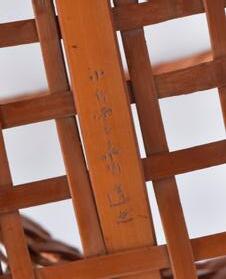
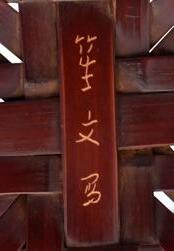

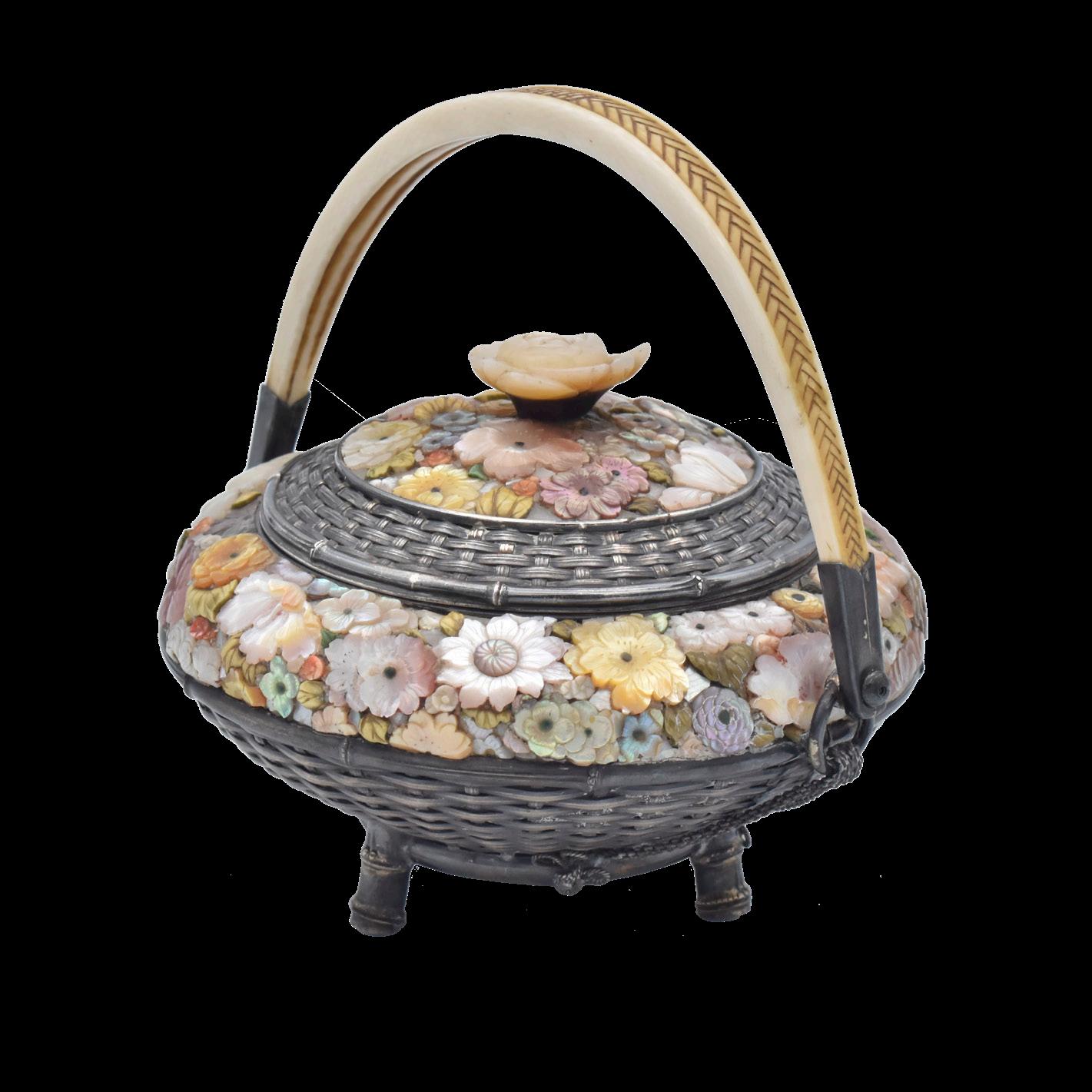

137Ω
GENRYUSAI SEIYA
A BRONZE OKIMONO (TABLE ORNAMENT) OF TWO FIGHTING TIGERS
MEIJI ERA (1868-1912), LATE 19TH/EARLY 20TH CENTURY
One snarling tiger on its hind quarters pressing its front paws onto its adversary’s chest lying on its back, trapping the tiger beneath its front paws, signed on the belly of one tiger within a rectangular reserve Seiya chu
16cm x 33cm
£2,000-3,000
138Ω
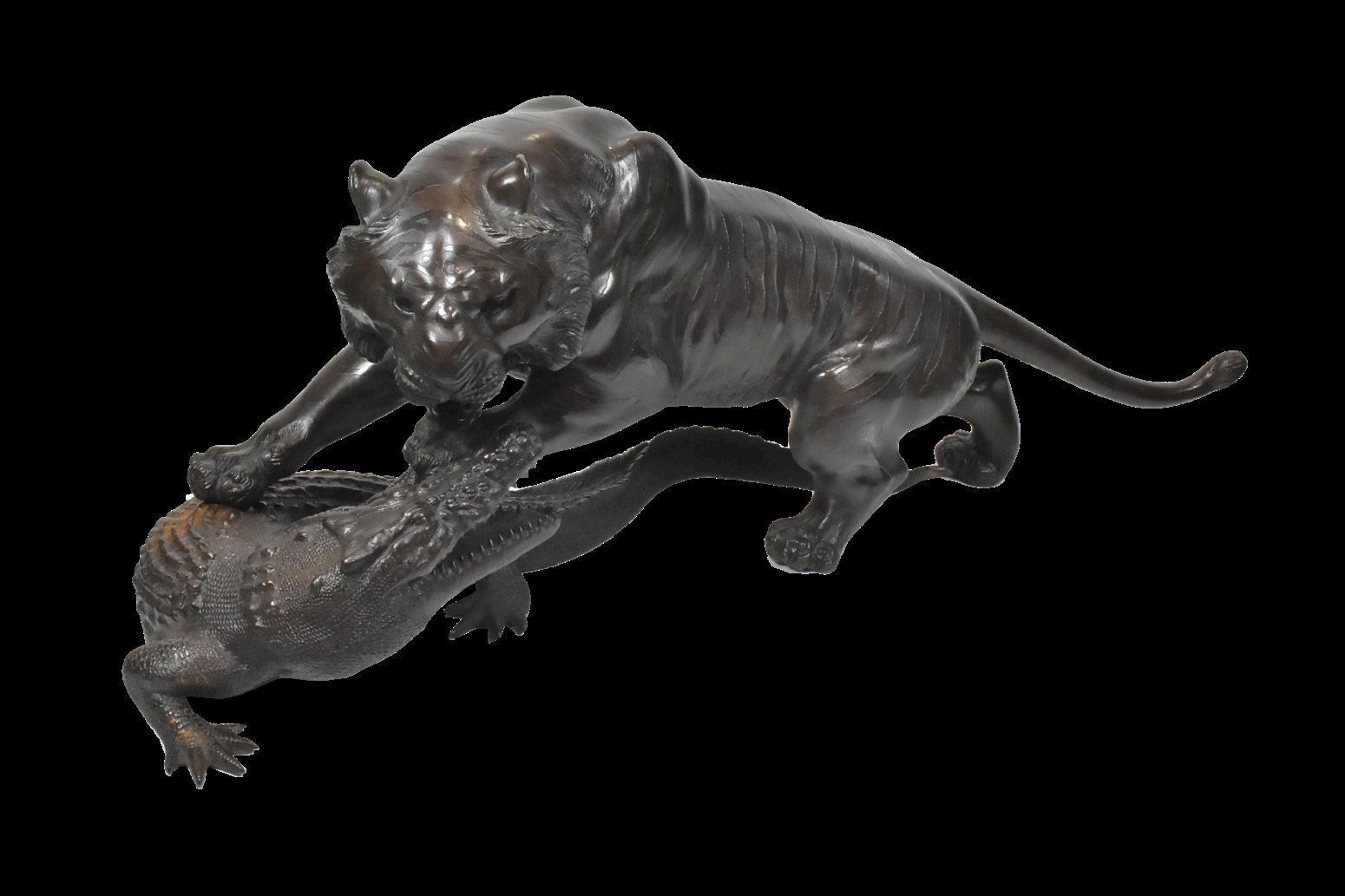
SEIUNSAI YOSHITANI
A BRONZE GROUP OKIMONO (TABLE ORNAMENT) OF A TIGER AND CROCODILE
MEIJI ERA (1868-1912), LATE 19TH/EARLY 20TH CENTURY
Finely and naturalistically cast, the tiger on its hind legs and pressing one foot subjugating the snarling crocodile, the surfaces of the beasts finely worked with contrasting textures, the tiger stripes and crocodile scales realistically rendered, each signed on the belly with chiselled characters within an oval reserve Dai Nippon Isho toroku jukenhyo (Japan Design Registration Certificate) and Seiunsai Yoshitani zo (Made by Seiunsai Yoshitani) within a square reserve (2)


139
JONAN
A BRONZE OKIMONO (TABLE ORNAMENT) OF A TIGER
MEIJI ERA (1868-1912), LATE 19TH/EARLY 20TH CENTURY
Naturalistically modelled, shown striding forward with its tail trailing behind, its mouth wide open in a snarl, the stripes delineated in subtly-toned patination, its eyes double-inlaid in glass and black pupils, signed on its belly with chiselled characters Jonan; on a separate, unrelated natural wood stand (2)
The tiger: 15cm x 50cm
The wood stand: 33cm x 62cm
£1,500-2,000
140
MORIMITSU
A MONUMENTAL BRONZE TIGER
MEIJI ERA (1868-1912), LATE 19TH/EARLY 20TH CENTURY
Typically cast, the prowling beast shown striding purposefully, his mouth open wide in a snarl, the stripes on its body boldly delineated in relief, the eyes inlaid in glass with black pupils, signed on the belly with chiselled characters Morimitsu
41cm x 97cm
£3,000-4,000

A BRONZE OKIMONO (TABLE ORNAMENT) OF A BACTRIAN CAMEL MEIJI ERA (1868-1912), LATE 19TH/EARLY 20TH CENTURY
The domesticated creature naturalistically rendered with its head raised slightly to the left, characteristic thick coat and long legs; signed on the belly with chiselled characters Masamitsu
22cm x 42cm
£2,000-3,000
This choice of subject exemplified the Japanese fascination with foreign lands, especially the Silk Road, where the camel was an important vehicle for trade
YAMAKAWA KOJI II (1860-1930) OR YAMAKAWA KOJI III (1884-1938)

A BRONZE OKIMONO (TABLE ORNAMENT) OF A CARP MEIJI (1868-1912) OR TAISHO (1912-1926) ERA, 20TH CENTURY
Naturalistically rendered in a swimming attitude with their fins threshing the water, the details on the body, fins, gills and tails finely incised, the eyes inlaid in gilt with dark pupils, the silver carp signed on its belly with chiselled characters Koji
£2,000-3,000
143Ω
GENRYUSAI SEIYA
A BRONZE OKIMONO (TABLE ORNAMENT) OF TWO FIGHTING TIGERS
MEIJI ERA (1868-1912), LATE 19TH/EARLY 20TH CENTURY
One snarling tiger on its hind quarters leaping onto its adversary’s flank, trapping the second tiger beneath its front paws, the tigers’ stripes finely delineated, one tiger signed on its belly Seiya saku within a rectangular reserve
18cm x 47cm
£2,000-3,000


A BRONZE OKIMONO (TABLE ORNAMENT) OF TWO TIGERS
MEIJI ERA (1868-1912), LATE 19TH/EARLY 20TH CENTURY
Naturalistically cast nestled against each other, the male seated on its haunches with its long tail snaking up its back, its head turned to the right snarling, its mate recumbent staring ahead, signed on the back of the male’s hind foot in hiragana script Kaniya Kuniharu saku
22cm x 50cm
£3,000-4,000
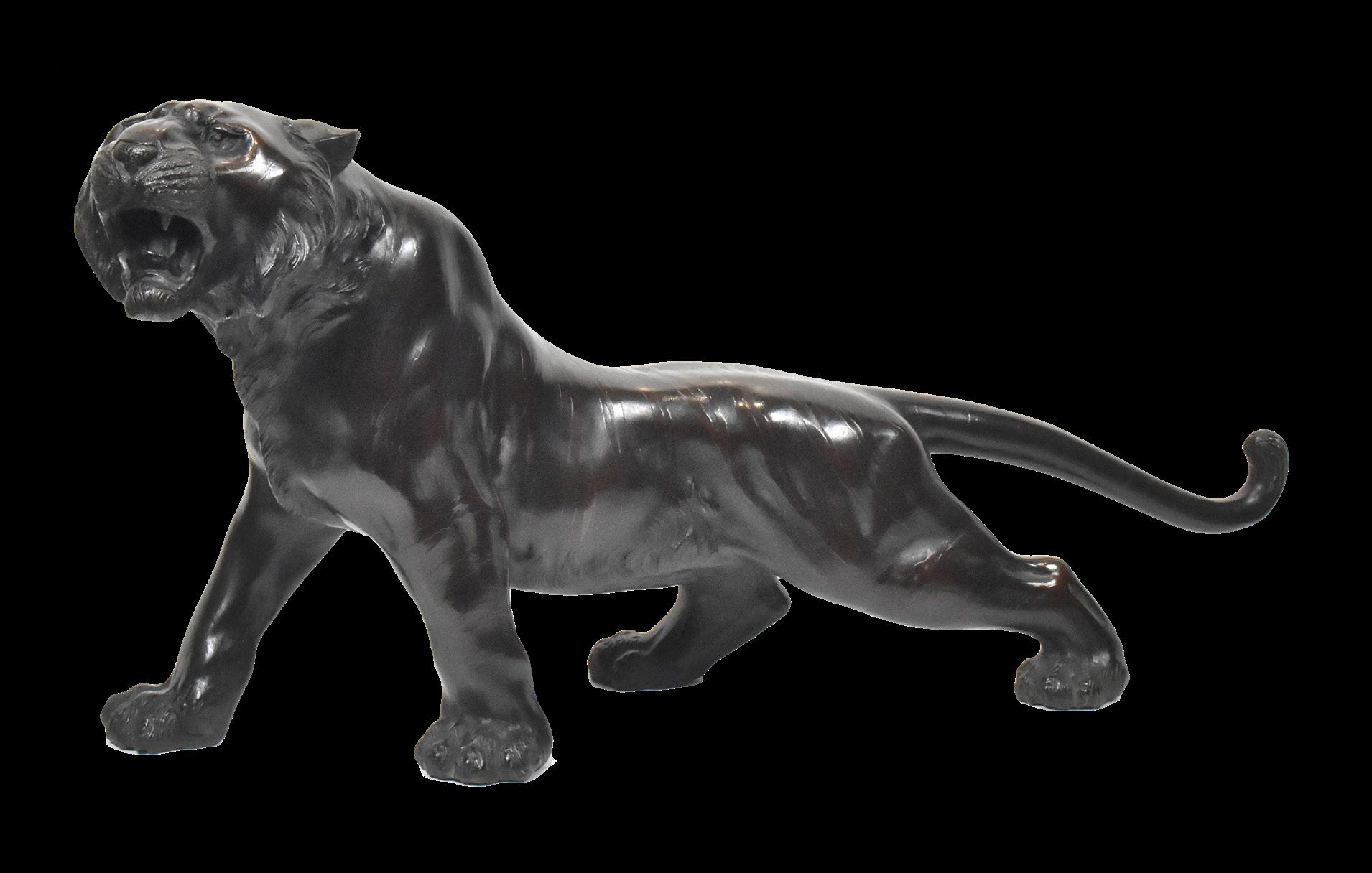
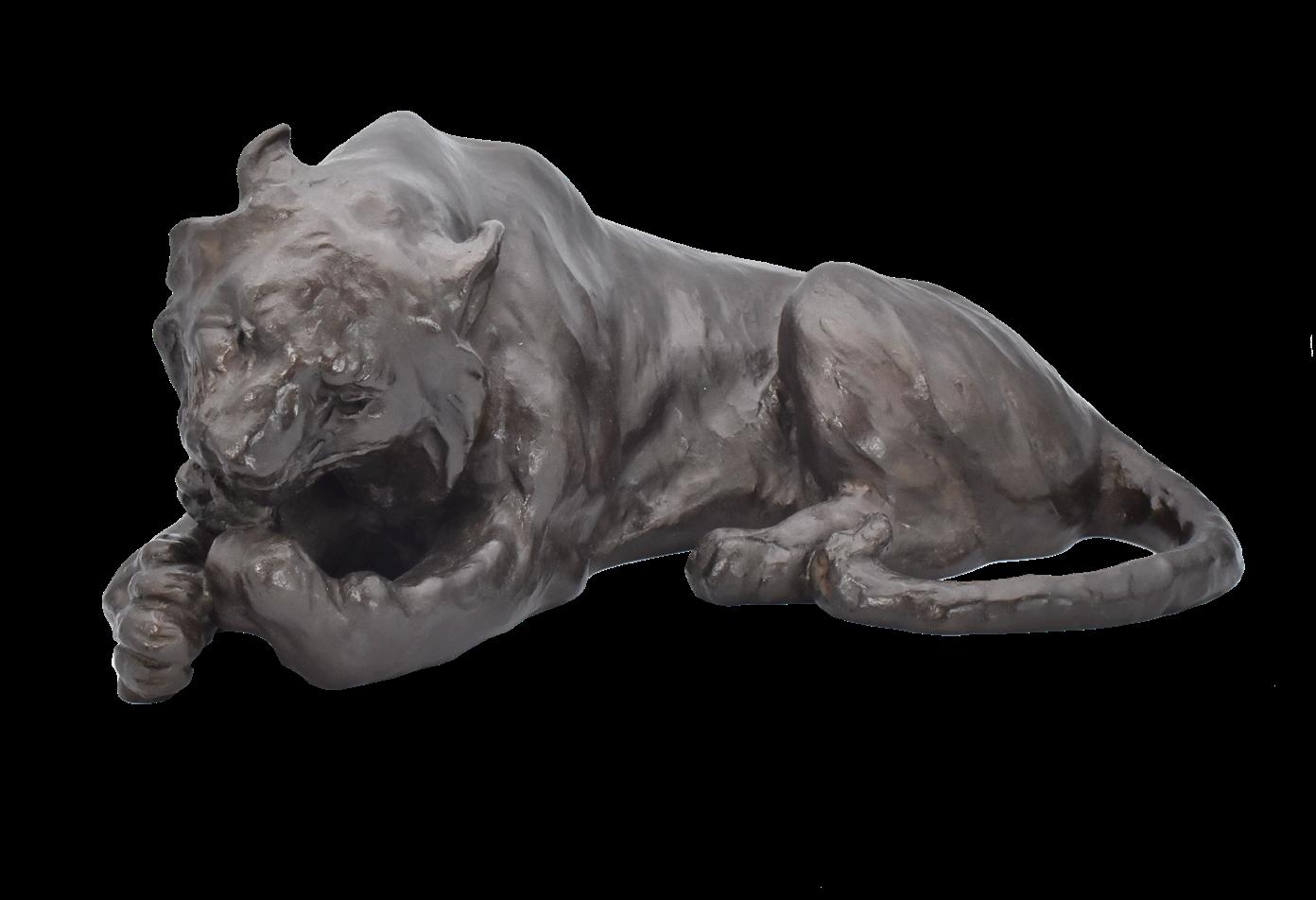
A BRONZE OKIMONO (TABLE ORNAMENT) OF A TIGER, MEIJI ERA (1868-1912), LATE 19TH/EARLY 20TH CENTURY
The roaring beast depicted in full stride with glossy, well delineated stripes and incised naturalistic mane; signed on the belly Seiya saku within a rectangular reserve
25cm x 52cm
£2,000-3,000

A BRONZE OKIMONO (TABLE ORNAMENT) OF A RECUMBENT TIGER, TAISHO (19121926) OR SHOWA ERA (1926-1989), EARLY 20TH CENTURY
Naturalistically cast with its head lowered and licking its front paw, its long tail curled around to the front, signed on the base within a rectangular reserve Masazane/ Shoshin
14.5cm x 34cm
£1,200-1,800
ASAKURA FUMIO (1883-1964)
A BRONZE OKIMONO (TABLE ORNAMENT) OF A KOMA-INU (SHRINE GUARDIAN LION DOG), TAISHO (1912-1926) OR SHOWA (1926-1989) ERA, EARLY/MID 20TH CENTURY
Cast imitating Bizen ware, seated upright on its rear haunches and freely modelled with a bushy tail, long curving manes and rather grotesque facial features bearing a fierce expression, its mouth closed forming the syllable “um”; signed on the base with a large seal Fumio saku
34cm x 23cm
£3,000-4,000
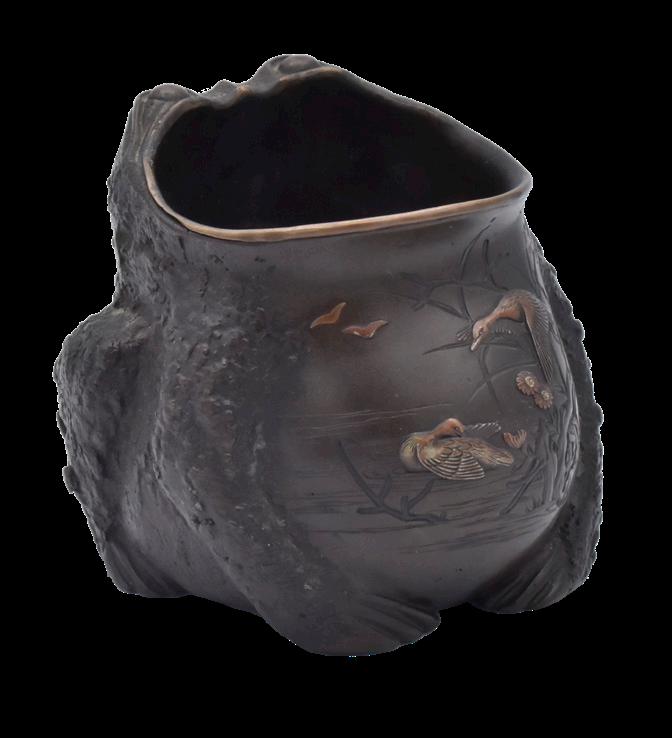
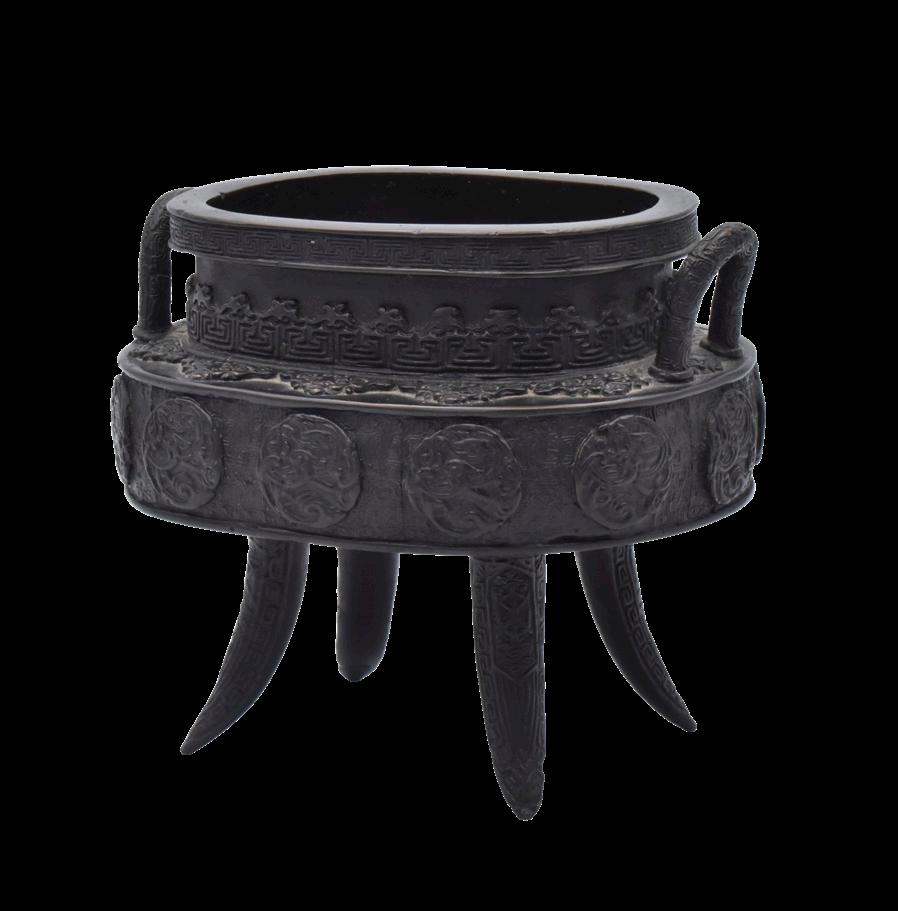
148
IKKODO
A BRONZE BRUSH POT IN THE FORM OF A TOAD
MEIJI ERA (1868-1912), LATE 19TH/EARLY 20TH CENTURY
Cast squatting with its mouth wide open forming the receptacle, its belly decorated in high relief of copper, gilt and bronze with two wild geese on a lake beside a withered tree and flowers, two birds in flight on the right; signed on the base with a round seal Ikkodo
9.5cm x 9cm
£600-800
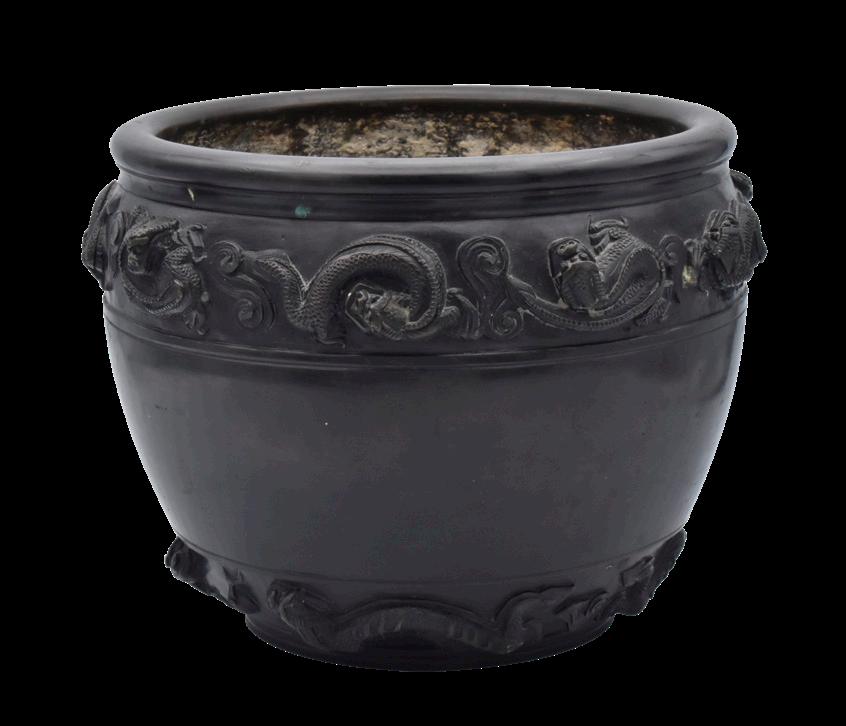
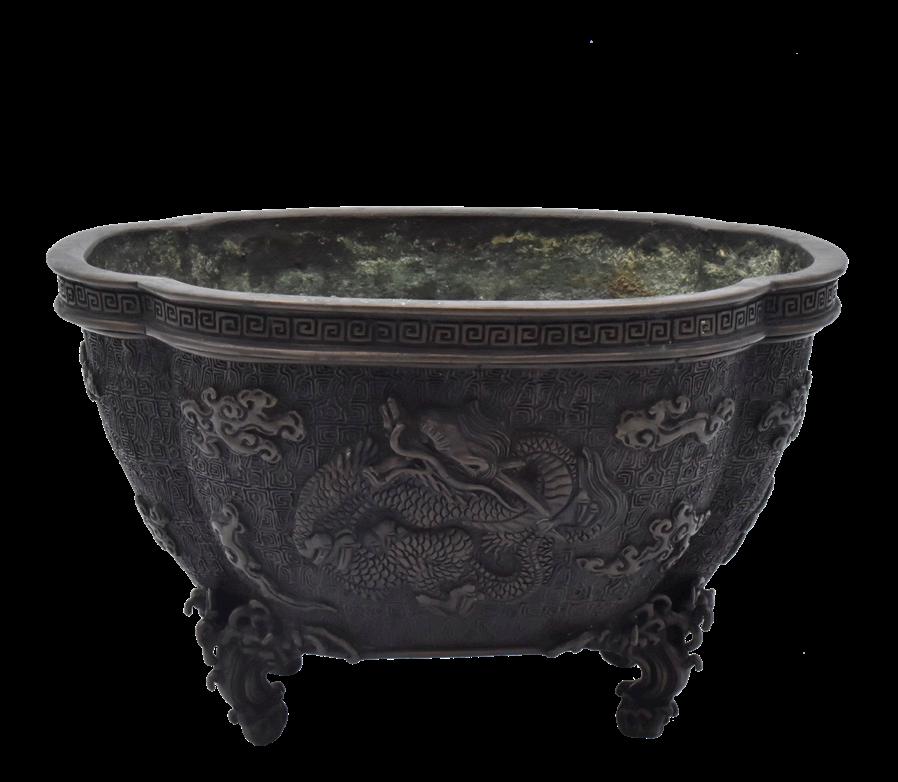
149
A SMALL BRONZE JARDINÈRE
PROBABLY EDO PERIOD (1615-1868), 19TH CENTURY
The deep vessel decorated around the shoulder and above the foot in relief with a band enclosing dragons among clouds chasing a tama (wish-granting jewel), signed on the base with an apocryphal Chinese Xuande mark
16.5cm x 19.2cm
£800-1,000
150
TWO BRONZE VESSELS
EDO PERIOD (1615-1868), 19TH CENTURY
The first of lobed form raised in four feet in the form of waves, decorated in high relief around the body with two coiled dragons surrounded by clouds on a ground carved with dense archaic patterns, signed on the base Suiun chu within a rectangular reserve, 11cm x 18cm; the second raised on four tall feet, similarly cast with roundels enclosing stylised birds and other mythological creatures against an archaic-patterned ground; unsigned (2)
£500-600
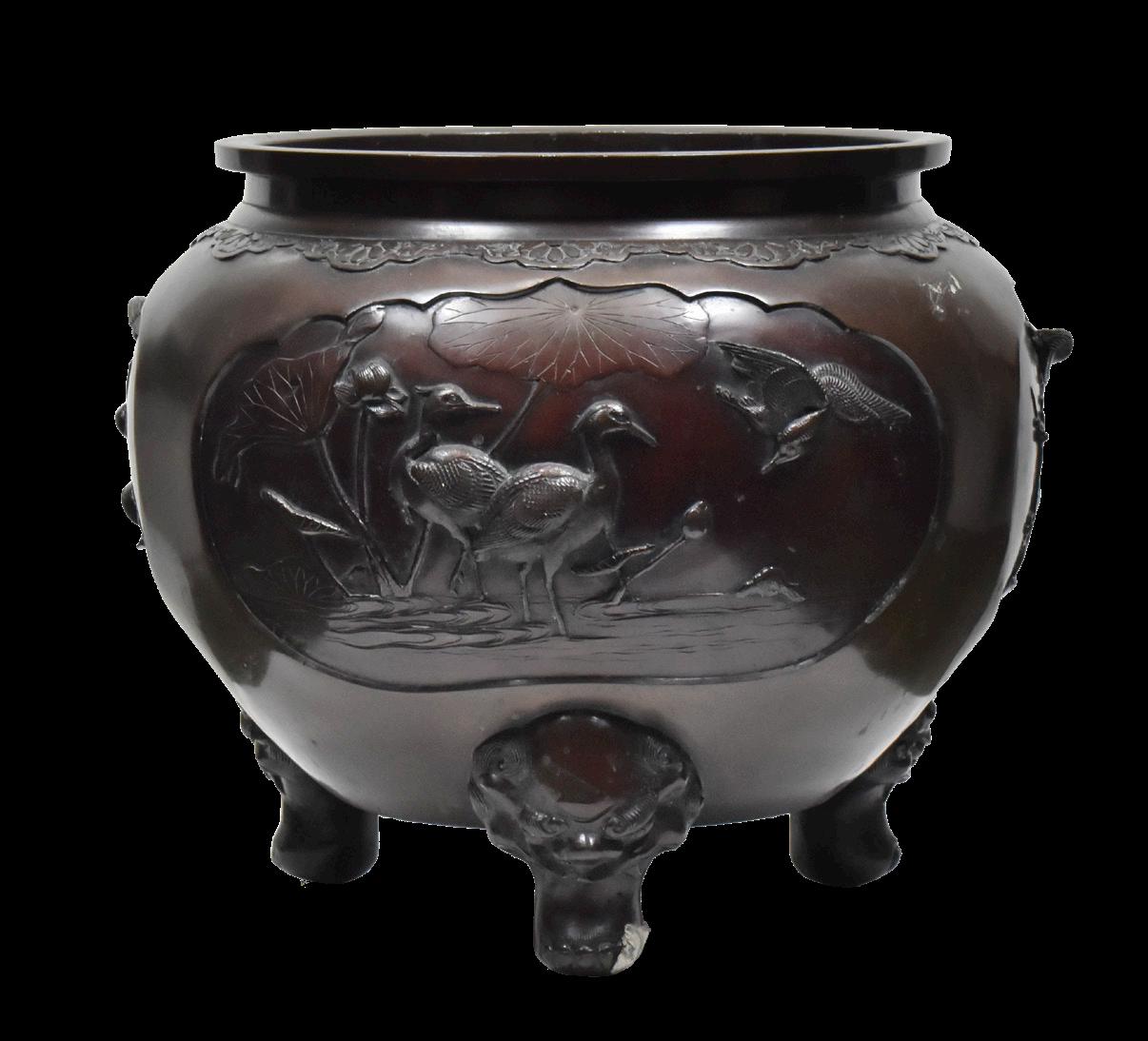
151
LATE 19TH/EARLY 20TH CENTURY
Raised on three tall feet in the form of mythological creatures, decorated around the body with three panels enclosing different kacho-ga (bird-and-flower scenes) applied in high relief, one depicting sagi (egrets) wading in a lotus pond, the second with a family of uguisu (warblers) perched on plum branches, and the third with suzume (sparrows) among peonies; unsigned
28.7cm x 33.5cm
£800-1,000
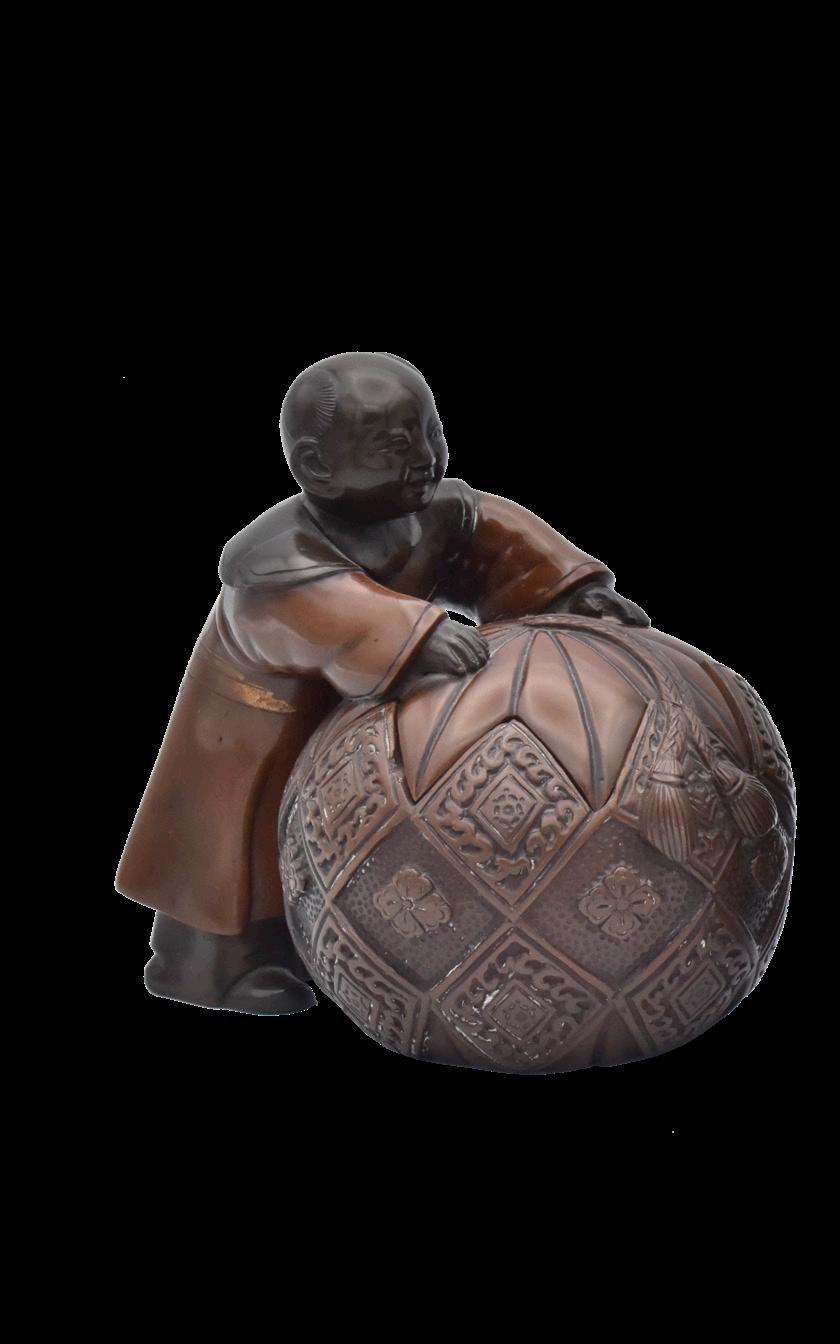
152
Each cast as a karako (Chinese boy) standing and leaning over with their hands resting over an elaborately tasselled kusudama (brocade hand ball), the top of the ball removable forming the cover, the balls carved in high relief with a matching design of repeated hanabishi-mon (flowery-diamond crests) among foliage, the boys’ robes decorated respectively with flowers and foliage and waterwheel designs; unsigned (4)
Each: 11cm x 9.5cm
£1,000-1,500
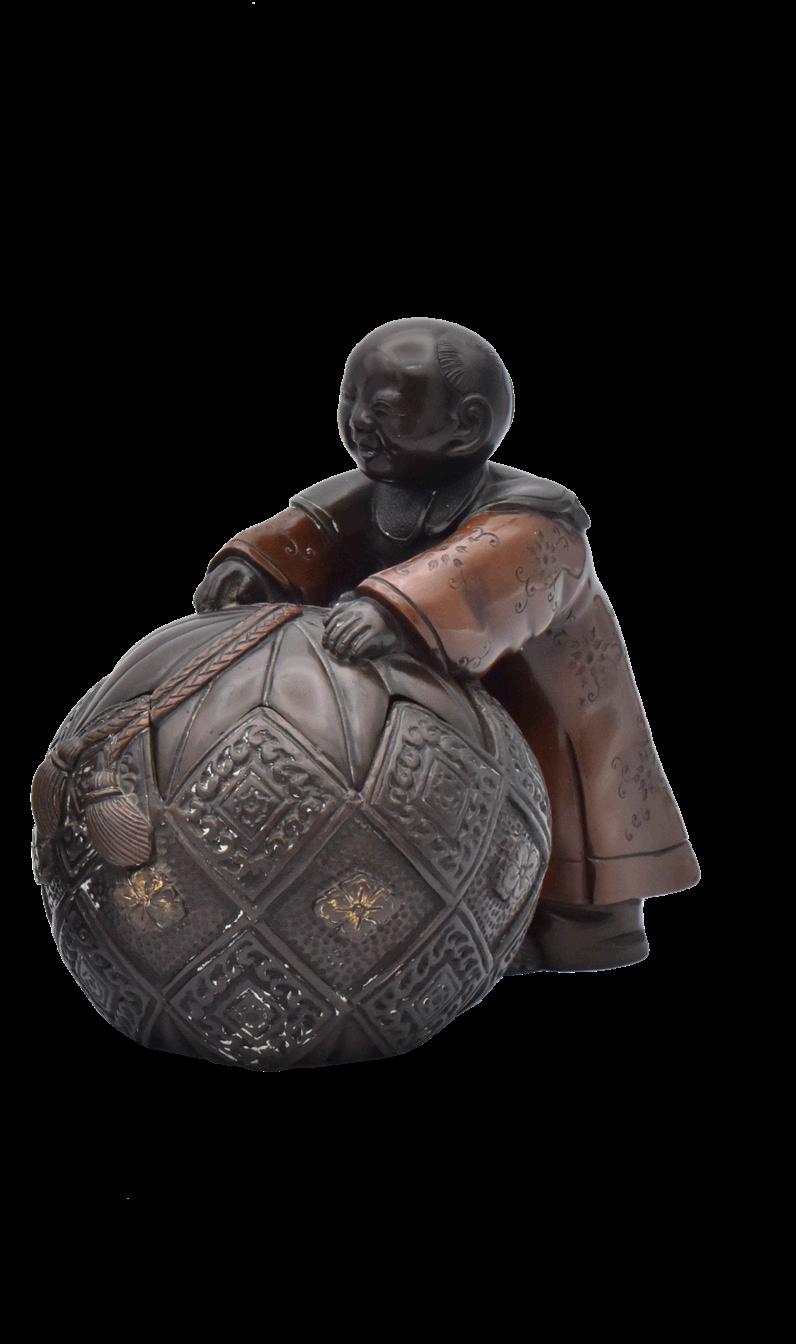
153
MIYAO EISUKE COMPANY OF YOKOHAMA
AN INLAID LARGE BRONZE CHARGER
MEIJI ERA (1868-1912), LATE 19TH/EARLY 20TH CENTURY
Finely cast, engraved, textured and carved, supported on a short foot ring, meticulously worked in high relief bronze, gold, copper, and shakudo inlays, the centre with three variously-shaped panels, two in the form of unfurled hand scrolls depicting different legendary figural scenes, including on the top right a scene taken from the legend of Yamabuki no sato (Village of Japanese Yellow Rose) showing a girl offering a stalk of yamabuki (Japanese yellow rose) to Ota Dokan standing in the rain asking for a straw coat, on the top left, the legend of Shuten Doji depicting Minamoto no Yorimitsu (Raiko) and his attendant disguised as Yamabushi priests on their way to Mount Oe and encountering a princess washing a bloodied kimono, the lower foreground alluding to the story of Yoshitsune and Benkei on Gojo Bridge, on a ground flowering leafy chrysanthemums and peonies and rocks, bordered by a band of stylised bats and other mythological creatures; signed on the underside Miyao sei within a gilt rectangular reserve
51cm diam.
£4,000-6,000
154
MIYAO EISUKE COMPANY OF YOKOHAMA
A GILT-BRONZE FIGURE OF A KAWARABAN (NEWSPAPER SELLER)
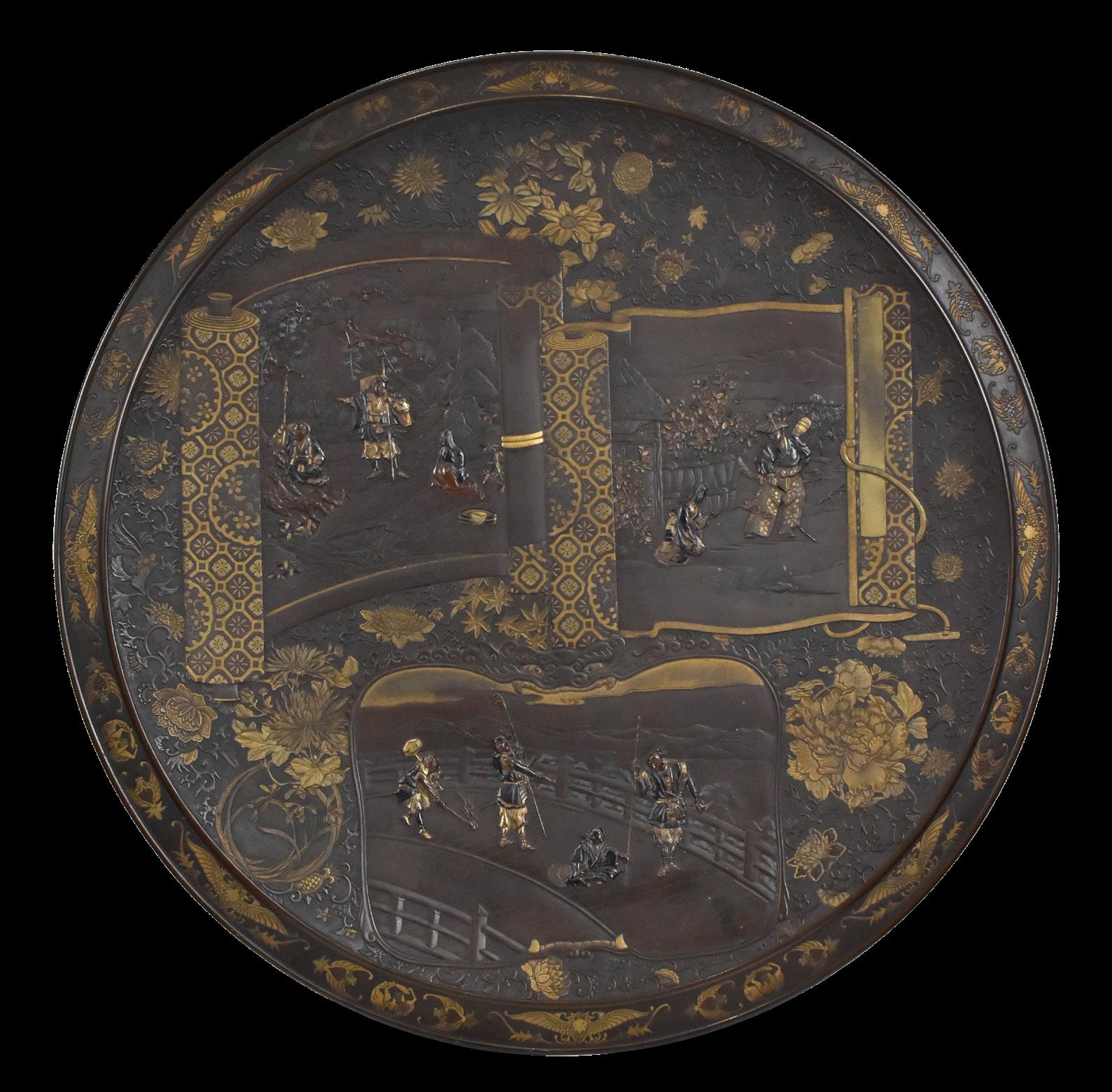
MEIJI ERA (1868-1912), LATE 19TH/EARLY 20TH CENTURY
Standing and wearing long jacket over a kimono decorated with cherry blossoms, beating an upturned wood bucket carried over his right shoulder, calling out for customers, affixed to a typical Miyao-style wood stand lacquered in gold takamaki-e with a stylised ho-o (phoenix) amid karakusa (‘Chinese grasses’); the reverse signed in a gold rectangular reserve Miyao
Overall: 22cm high
£1,500-2,000
155
MIYAO EISUKE COMPANY OF YOKOHAMA
A GILT-BRONZE FIGURE OF A LABOURER
MEIJI ERA (1868-1912), LATE 19TH/EARLY 20TH CENTURY
The muscular man wearing a fundoshi (loin-cloth) and a vest decorated with flowers and whorl patterns standing with feet apart carrying a rice bale over his left shoulder, affixed to a typical Miyao-style wood stand lacquered in gold takamaki-e with a stylised butterfly amid karakusa (‘Chinese grasses’); the reverse signed in a gold rectangular reserve Miyao
Overall: 16cm high
£1,000-1,500
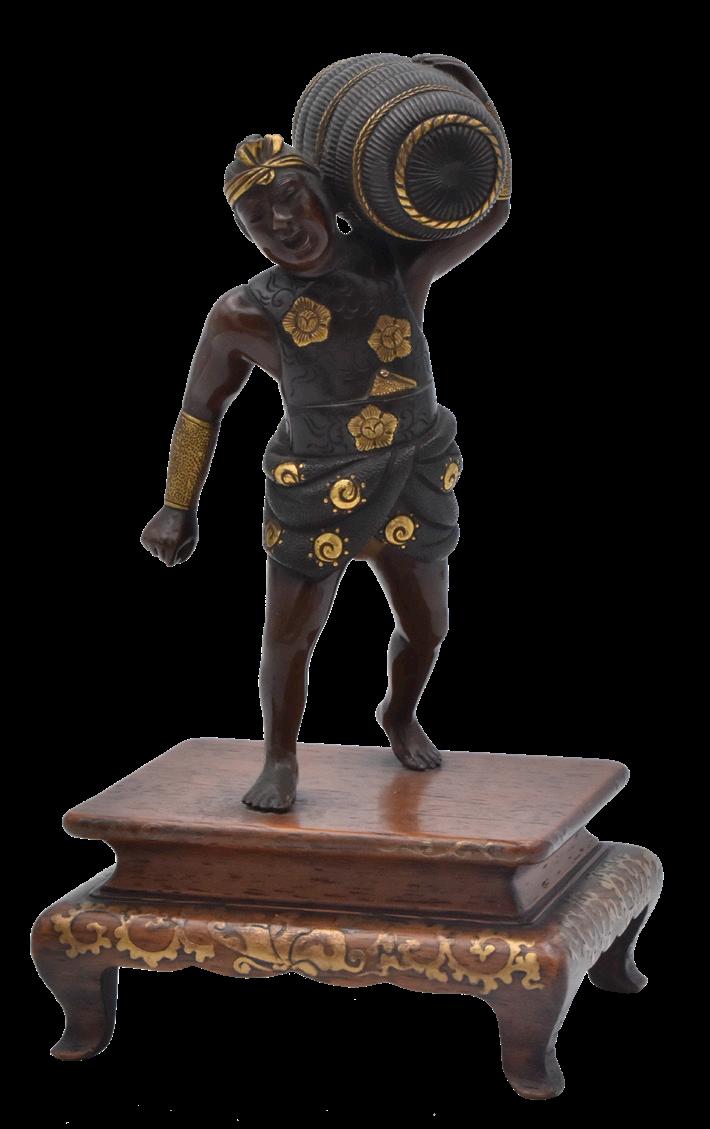
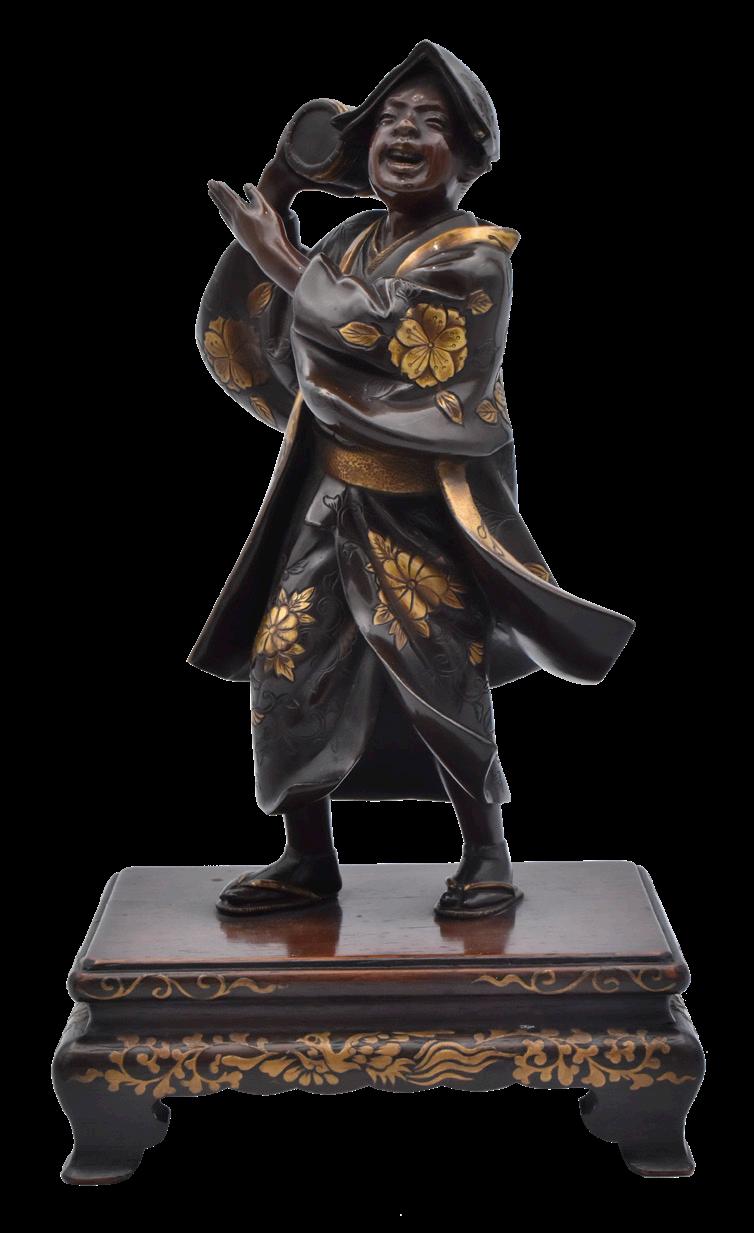
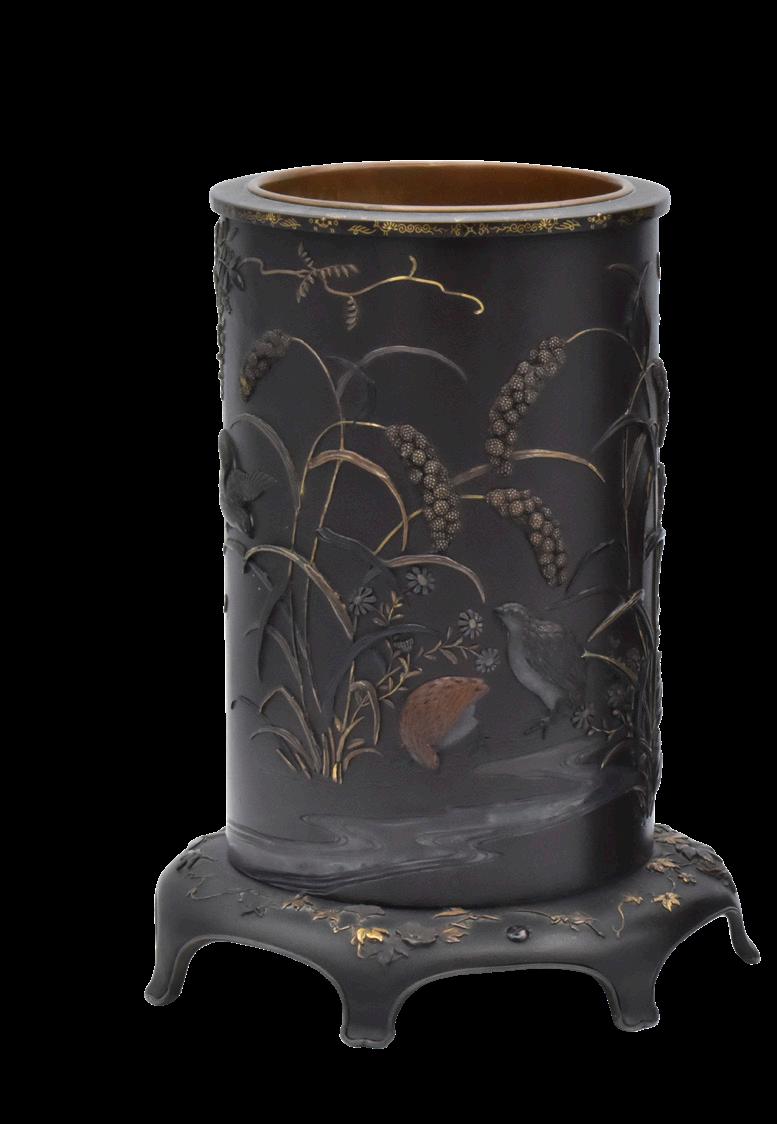
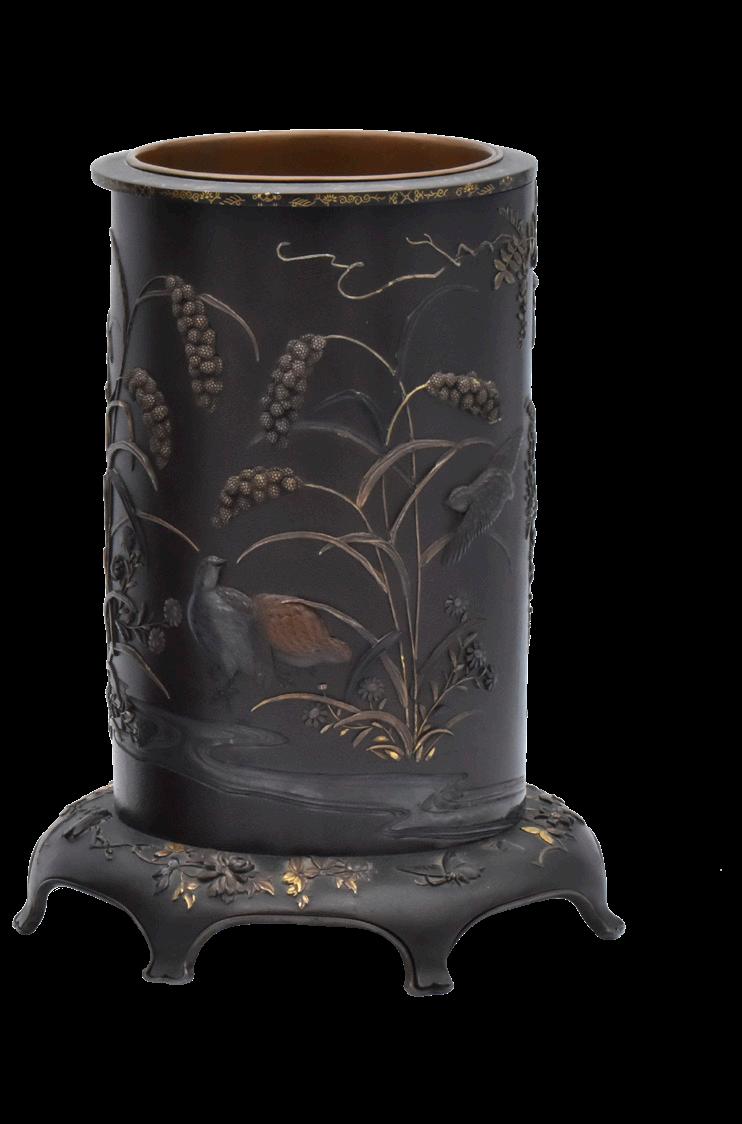
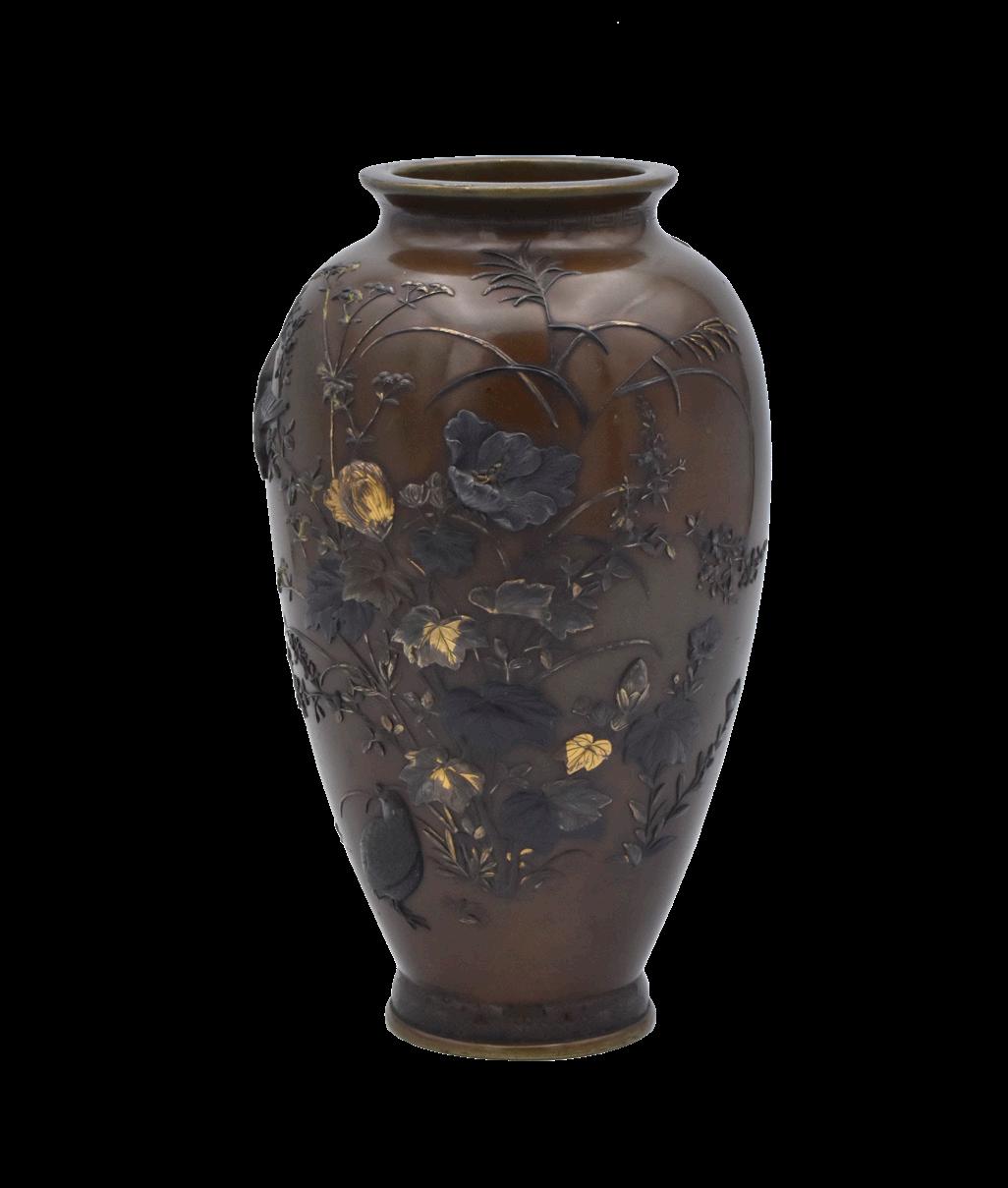
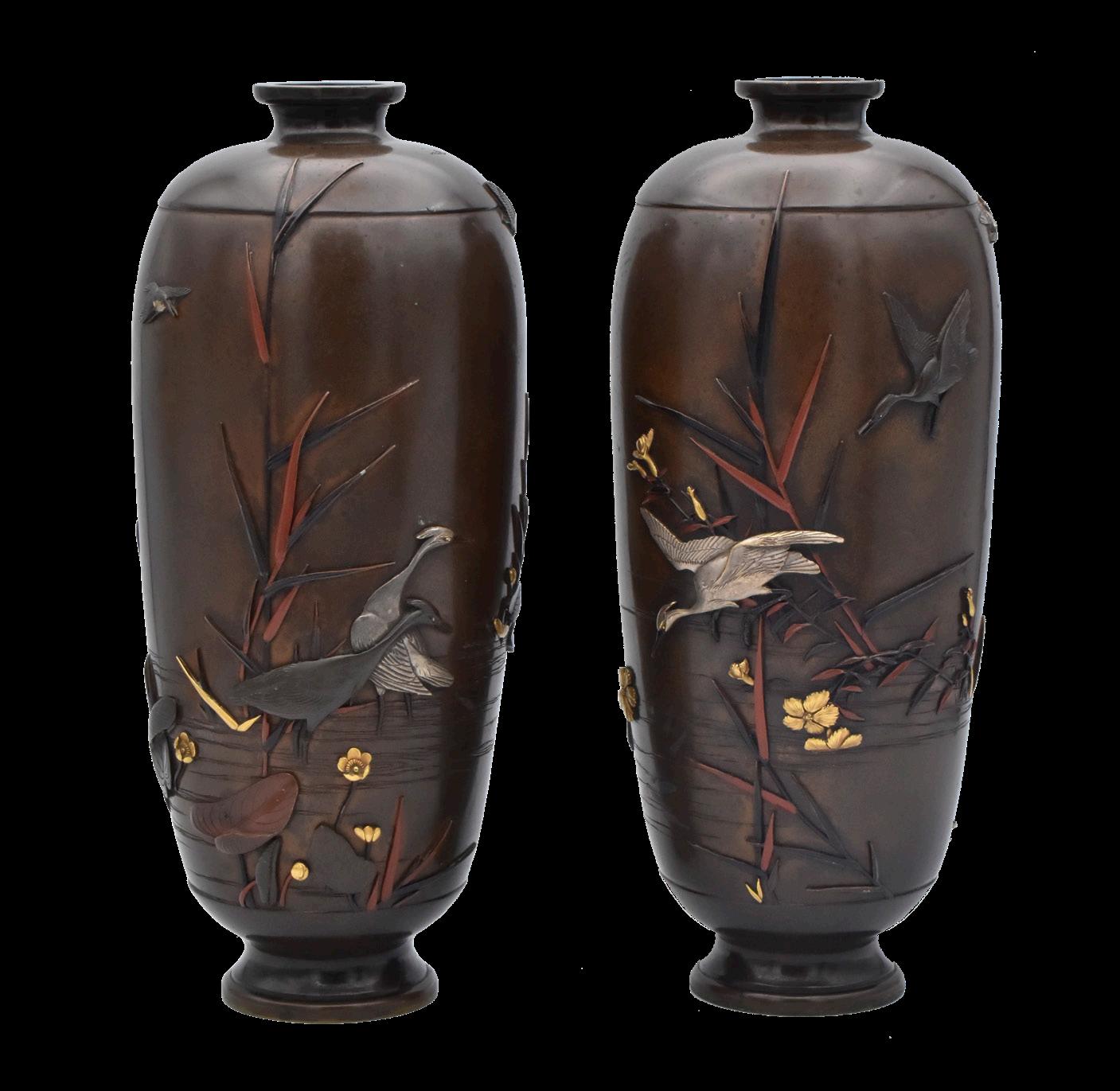
Each decorated with a matching continuous scene applied in high relief of shakudo, gilt and copper depicting quail in flight and foraging for food among stalks of windswept millets on one side and swallows perched and flying among branches of trailing wisteria, the seven-footed circular stand of each brushpot decorated with different insects and plants including ladybirds, grasshoppers, and beatles among morning glory, one brushpot with additional butterflies, and cicadas and bees among flowering tessen (Asian virginsbower) and grapes; unsigned (2)
Each brushpot: 17cm high
£2,000-3,000
MEIJI ERA (1868-1912), LATE 19TH/EARLY 20TH CENTURY
Decorated in high relief of shibuichi, gilt, copper and shakudo inlays with a continuous scene depicting three quail, two in flight and one foraging for food among flowering autumn stalks of fuyo (cotton rose), ominaeshi (valerian), hagi (bush clover) and susuki (autumn grasses), signed on the base Mitsunori within a silver rectangular reserve
15.8cm high
£1,000-1,500
158
MIYABE ATSUYOSHI (1870-1911) OF KYOTO
A PAIR OF INAID BRONZE OVOID VASES
MEIJI ERA (1868-1912), LATE 19TH/EARLY 20TH CENTURY
Each vase worked in gold, silver, shibuichi, shakudo and copper high relief inlays forming a complementary continuous autumnal scene, both vases decorated with kingfishers in flight above egrets wading among reeds and flowering kohone (nuphar japonicum); each vase signed on the base with chiselled signature Dai Nippon Kyoto ju Ikkodo Miyabe Atsuyoshi with a kao (2)
Each vase: 22.5cm high
£4,000-6,000
159
GYOKKO/TAMAHIRO
A WALRUS IVORY BRUSHPOT
MEIJI ERA (1868-1912), LATE 19TH/EARLY 20TH CENTURY
Craved in high relief with a continuous scene depicting an oxherd leading Saigyo Hoshi mounted on an ox, the poet and monk turning back to admire Mount Fuji in the distance, a peasant woman carrying brushwood walking behind, the base decorated in gold takamaki-e with maple leaves floating on a stream; signed on the base Tamahiro/Gyokko with a kao
14cm x 9cm
£1,000-1,500
160
SEIMIN
A BRONZE AND IVORY OKIMONO (TABLE ORNAMENT) OF URASHIMA TARO AND A MINOGAME (BUSHY-TAILED TURTLE)
MEIJI ERA (1868-1912), LATE 19TH/EARLY 20TH CENTURY
The former depicted in old age, seated on the back of a large minogame (bushy-tailed turtle) cradling under his right arm the tamatebako (treasure box) given to him by the Dragon King’s daughter, which she had commanded him not to open; the man’s face, leg and arms of ivory; signed on the base with a seal
12.5cm x 20.5cm
£1,000-1,500
161Ω
KABUKI HIDEAKI/SHUNMEI (DATES UNKNOWN)
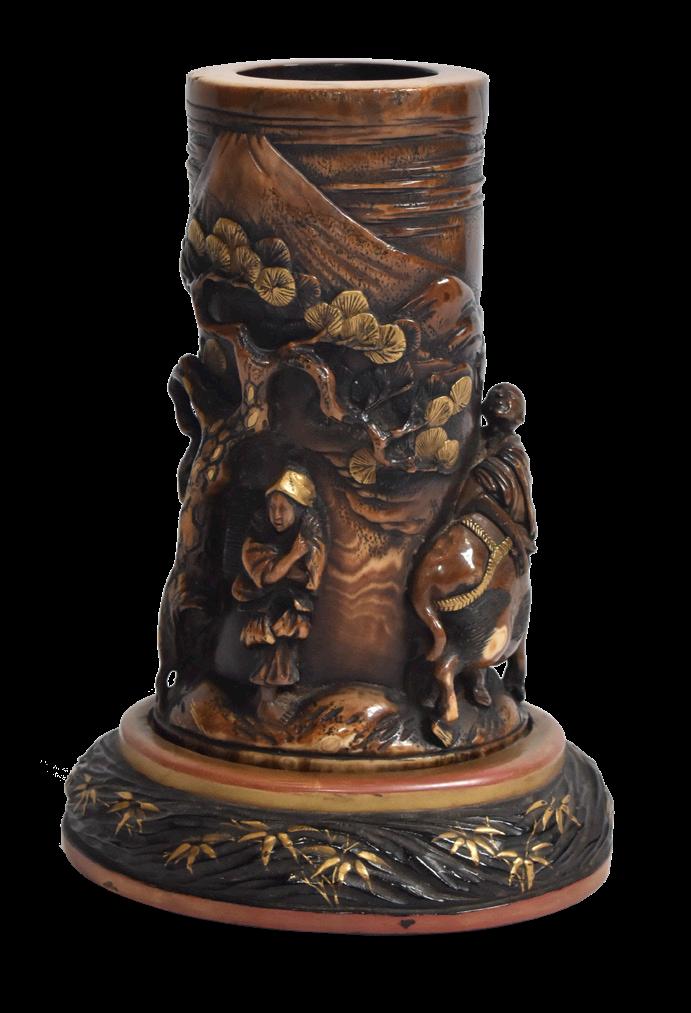

A BRONZE OKIMONO (TABLE ORNAMENT) OF A PANTHER SHOWA (1926-1989) OR HEISEI (1989-2019) ERA, EARLY 20TH CENTURY
Cast in Art Deco style with a green patina, striding purposefully with its head sightly raised, its long tail trailing behind and curling at the tip; signed on the belly with chiselled characters Hideaki/Shunmei saku
12.5cm x 39cm
£800-1,200

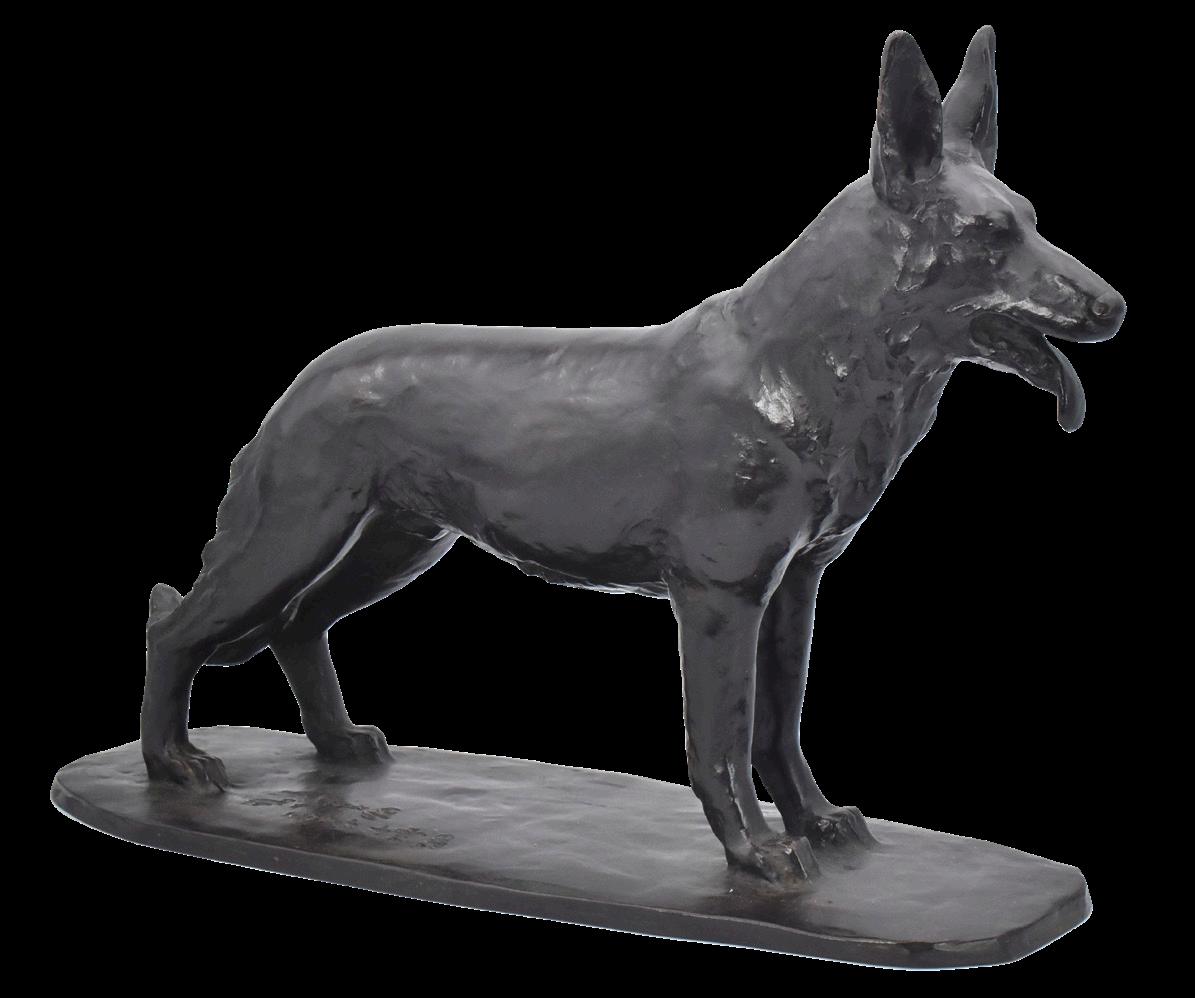

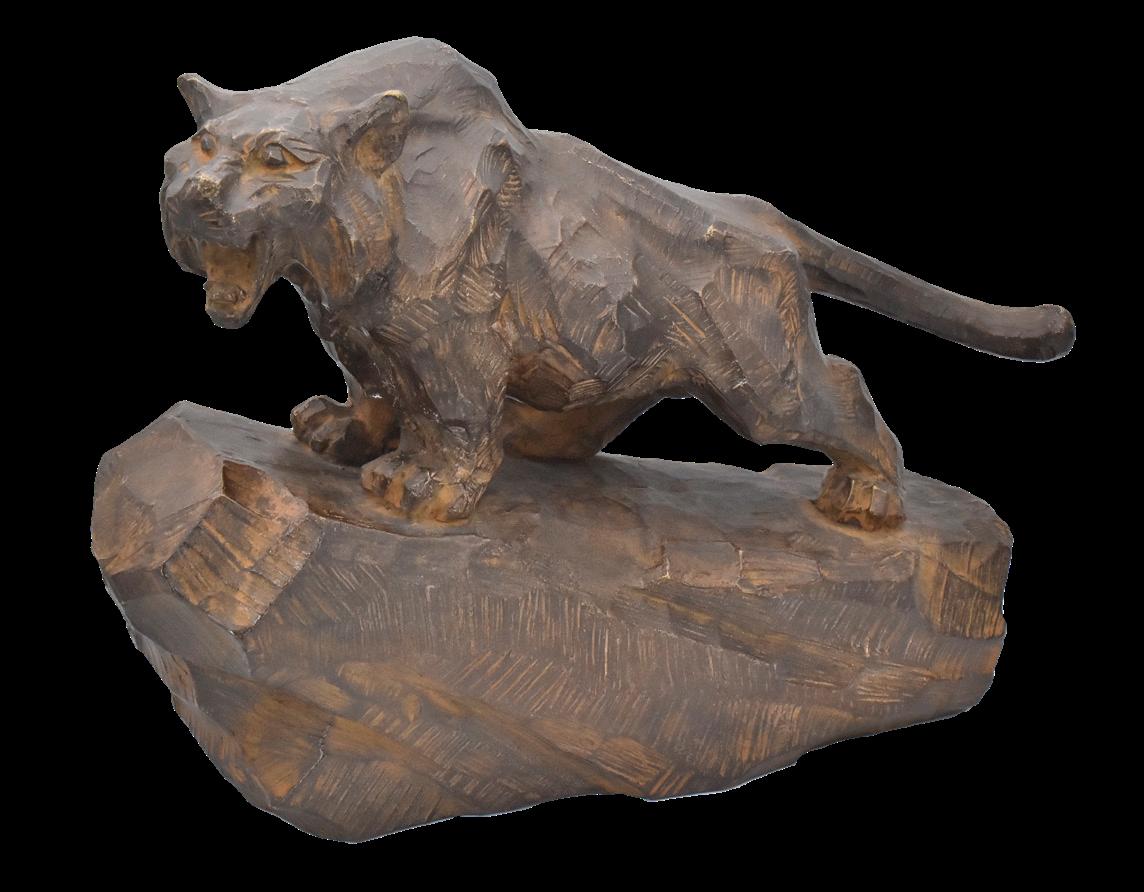
162Ω
TERAHATA SUKENOJO (1892-1970)
A BRONZE OKIMONO (TABLE ORNAMENT) OF A GERMAN SHEPHERD ALASATIAN DOG SHOWA ERA (1926-1989), DATED 1942
Naturalistically cast on an en-suite oval stand, standing with an alert expression, its mouth slightly open with its tongue exposed as though waiting for a command from his master, signed on the base with chiselled characters Showa jushichinen Sukenojo saku (made by Sukenojo, Showa 17 [1942])
26cm x 34.5cm
£800-1,200
163Ω
TSUDA EIJU (1915-2001)
A BRONZE OKIMONO (TABLE ORNAMENT) OF A PANTHER
SHOWA (1926-1989) OR HEISEI (19892019) ERA, 20TH CENTURY
Naturalistically cast with a green patina, striding purposefully with its head sightly raised, its long tail trailing behind and curling at the tip; signed on the belly with chiselled characters Eiju
21cm x 42cm
£1,000-1,500
164Ω
ATTRIBUTED TO TSUJI SHIRO (1932-2003)
A BRONZE OKIMONO (TABLE ORNAMENT) OF A TIGER ON AN EN-SUITE STAND SHOWA (1926-1989) OR HEISEI (19892019) ERA, 20TH CENTURY
The tiger cast prowling on an en-suite stand, its mouth wide open in a snarl, the texture of the bronze imitating the ittobori technique; unsigned 11cm x 34cm
£1,500-2,000
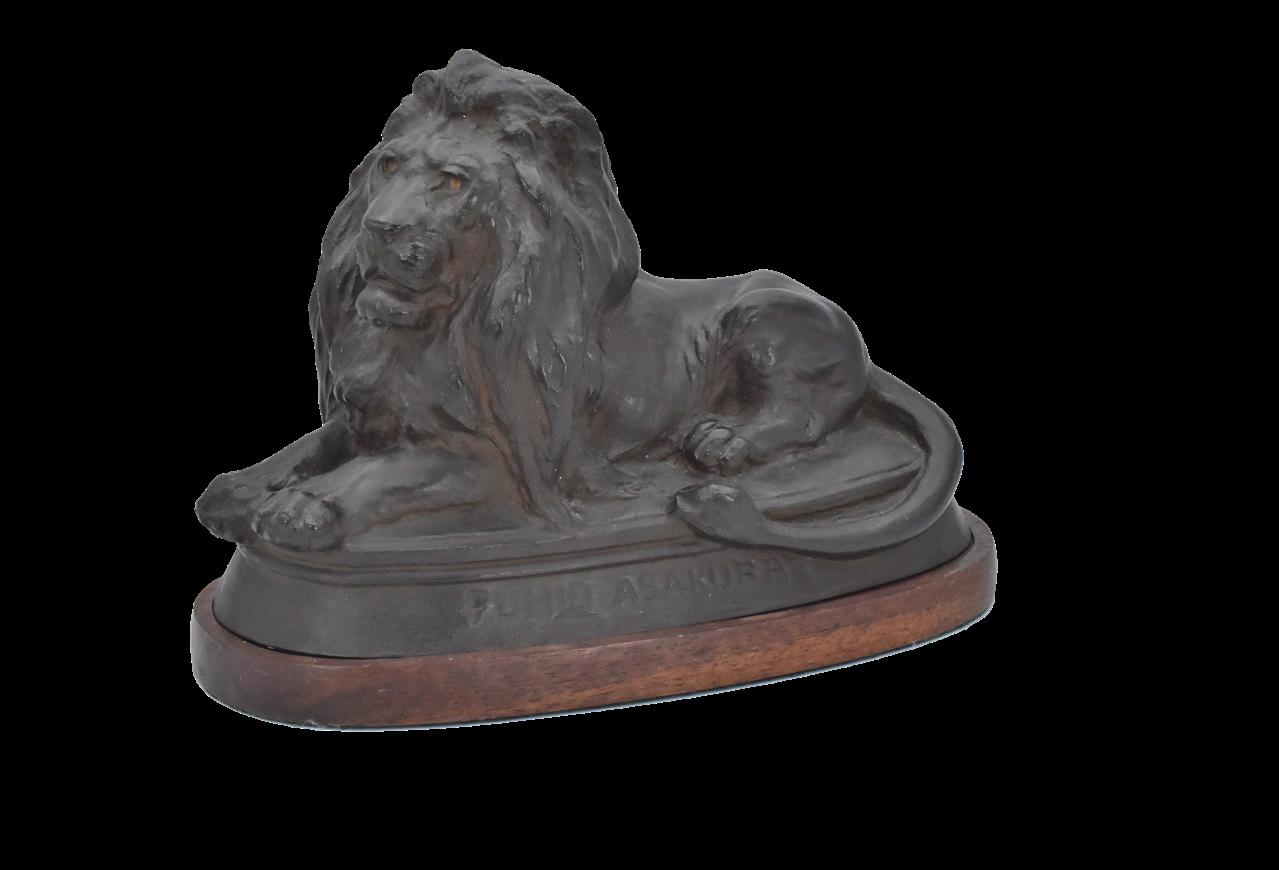
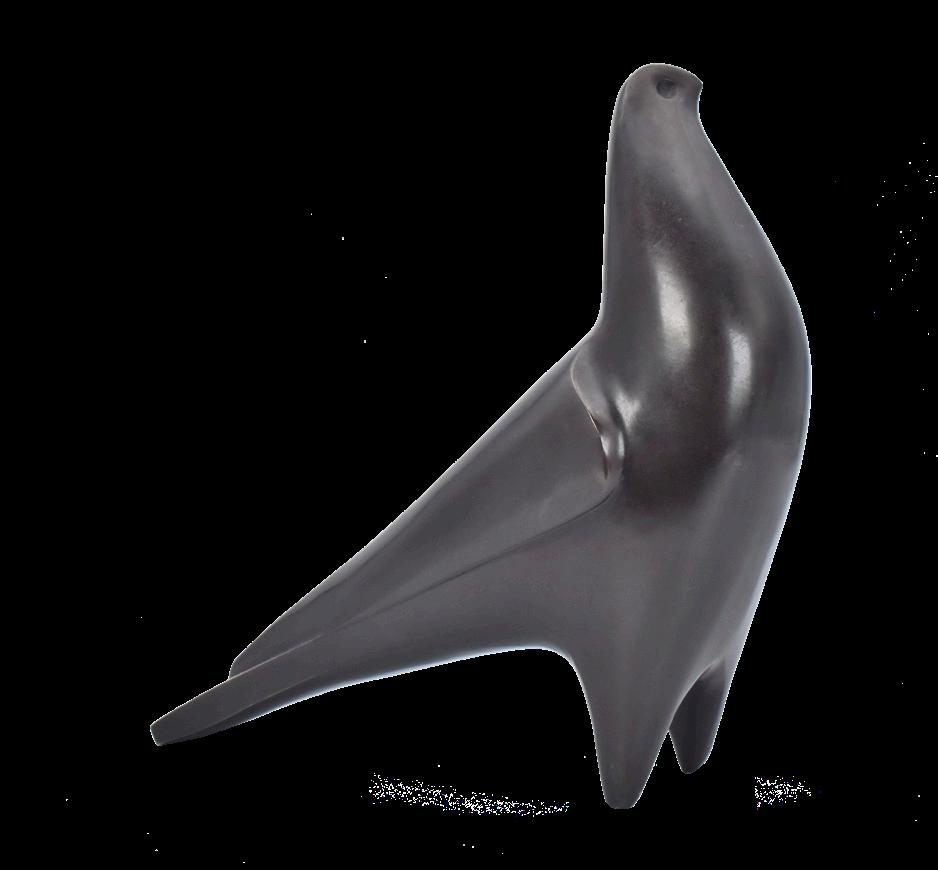
165
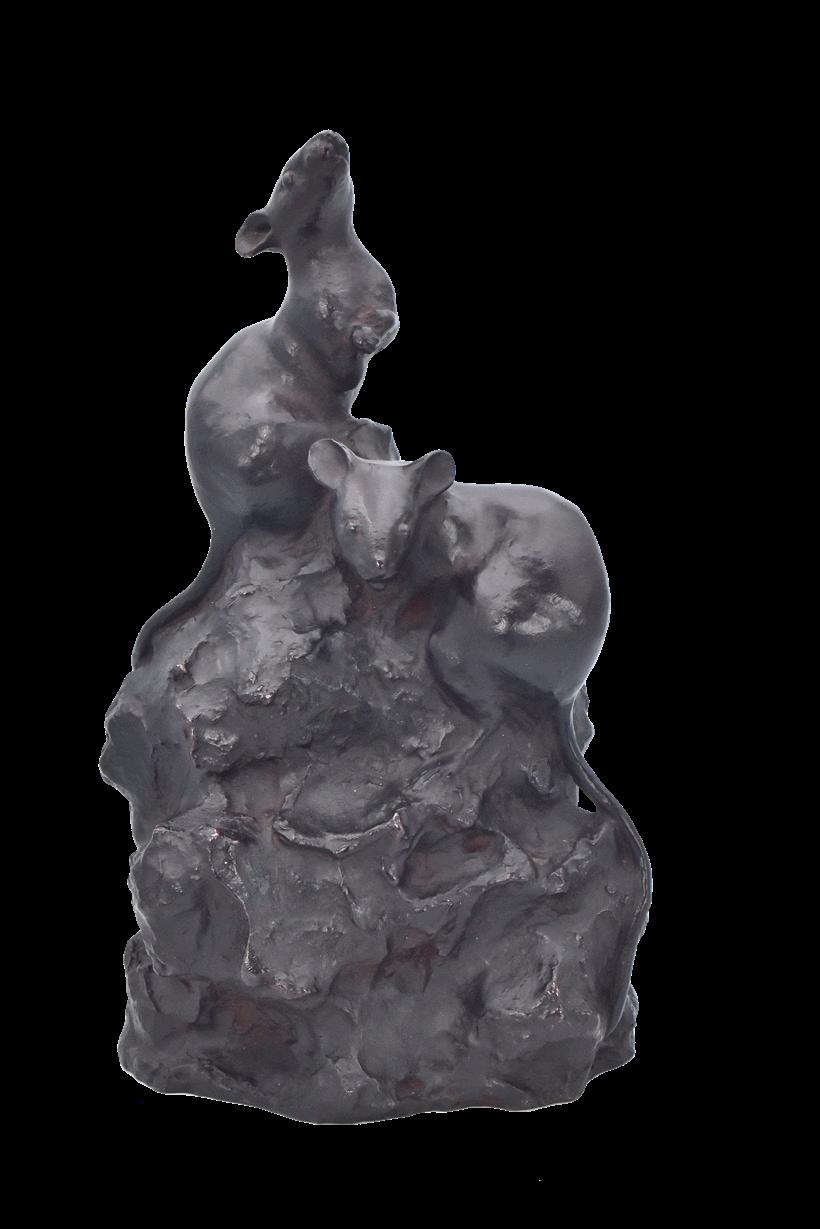

THE BRONZE BY ASAKURA FUMIO (1883-1964) AND SUPERVISED BY HOSOYA RYOKO (BORN 1868)
A BRONZE OKIMONO (TABLE ORNAMENT) OF A LION
TAISHO (1912-1926) OR SHOWA (1926-1989) ERA, EARLY/MID
20TH CENTURY
Cast recumbent on an en-suite stand staring ahead with its front paws outstretched and its long tail curling around to to the front, signed on one side of the stand in Roman script Fumio Asakura and in Chinese characters on the other side Ryoko kan (Supervised by Ryoko); with a separate wood stand (2)
The lion: 16cm x 21cm
The wood stand: 22cm long
£1,000-1,500
166Ω
SAEGUSA SOTARO (1911-2006)
A BRONZE OKIMONO (TABLE ORNAMENT) OF A DOVE
SHOWA (1926-1989) OR HEISEI (1989-2019) ERA, 20TH CENTURY
Cast in a simplified abstract manner in Art Deco style; signed on the back of the tail with a chiselled character So
22cm x 18cm
£1,000-1,500
167Ω
NAKAMURA SHINYA (BORN 1926)
A BRONZE OKIMONO (TABLE ORNAMENT GROUP OF TWO RATS), SHOWA (1926-1989) OR HEISEI (1989-2019) ERA, 20TH CENTURY
The two rodents cast clambering over a rocky mound, their long tails trailing behind; signed in Roman script Shinya on the reverse of the rock
25.5cm x 14cm
£300-500
168Ω
ATTRIBUTED TO MIYATA RANDO II (1902-1988)
A BRONZE OKIMONO (TABLE ORNAMENT) OF A TOBIUO (FLYING FISH), SHOWA ERA (1926-1989), 20TH CENTURY
Naturalistically cast with a long and slender body and pectoral like wings on an integral bronze stand simulating waves, signed on the base with a seal Rando
12cm x 20cm
£1,000-1,500
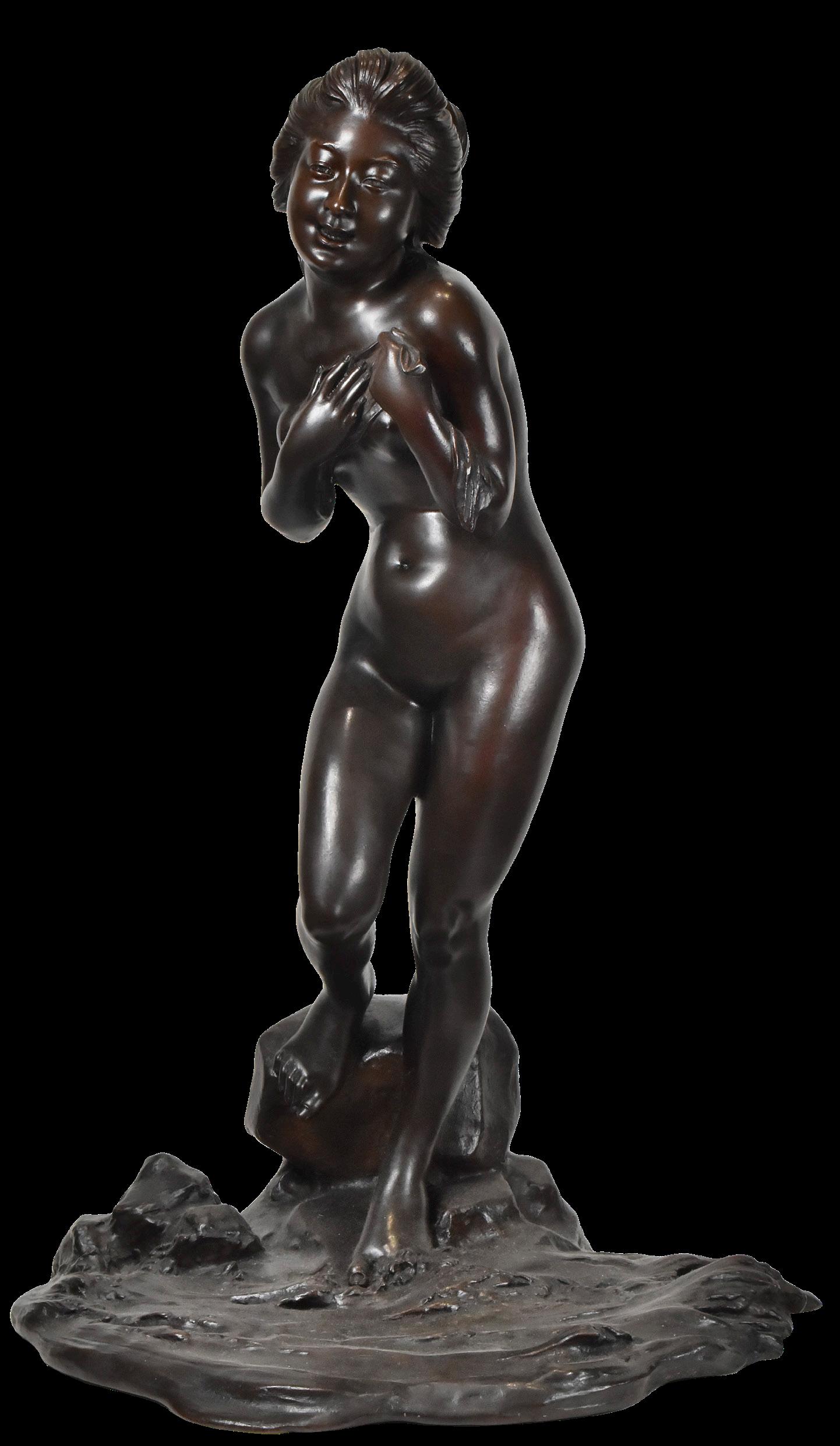
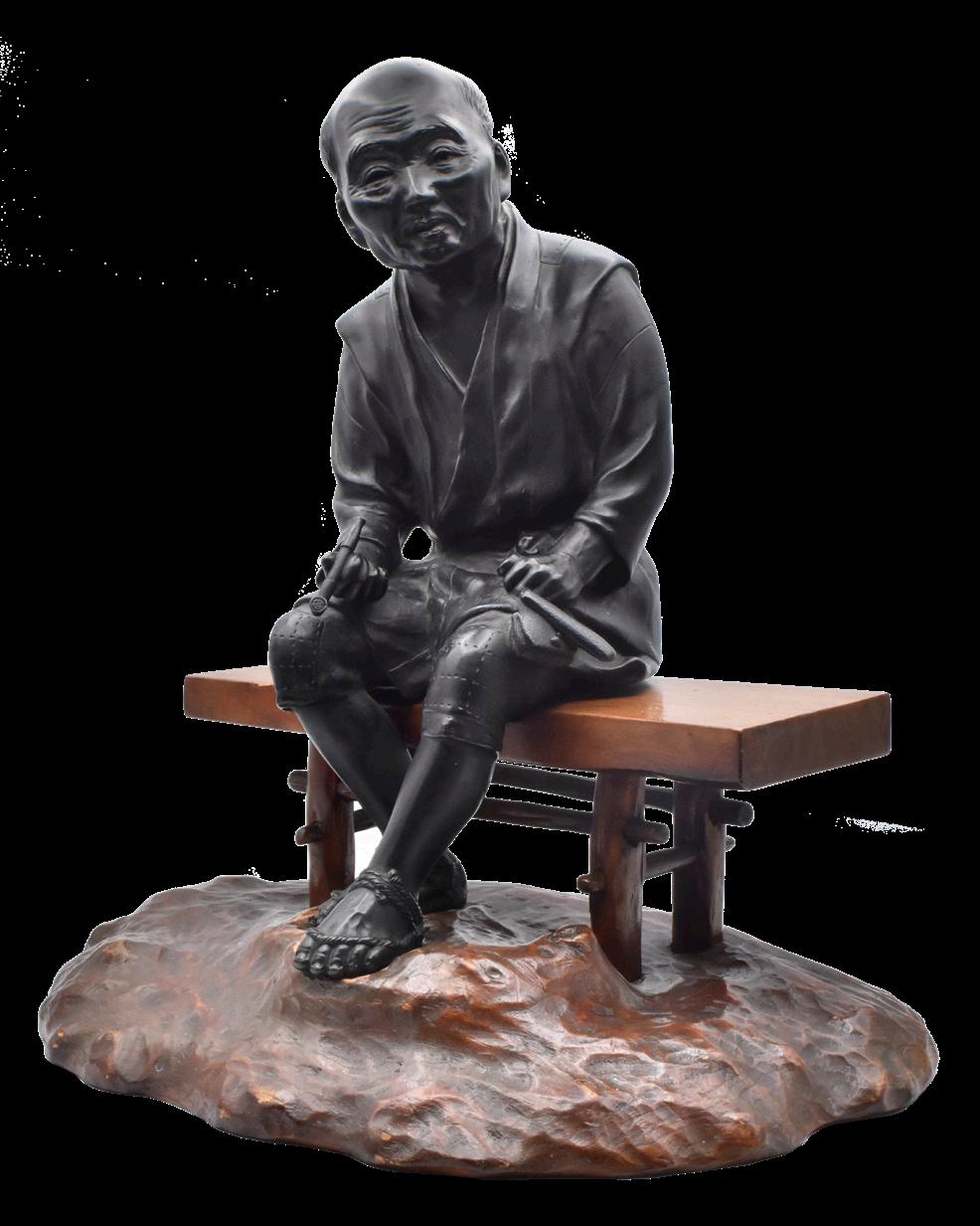
OKAZAKI SESSEI (1854-1921)
A TALL BRONZE OKIMONO (TABLE ORNAMENT) OF A NUDE LADY MEIJI (1868-1912) OR TAISHO (1912-1926) ERA, EARLY 20TH CENTURY
The young woman cast standing with a coy expression, one foot resting on a rock, preparing to step into the stream, both hands (hand towel) to her breasts, signed on the back Sessei saku within a rectangular reserve
A BRONZE OKIMONO (TABLE ORNAMENT) OF AN ELDERY MAN MEIJI ERA (1868-1912), LATE 19TH/EARLY 20TH CENTURY
The old man resting and seated on a removable wood bench and wood stand, his left leg outstretched, clutching in his left hand a portable ashtray attached to a tobacco pouch and pipe case, holding a pipe in the other; signed on the underside with chiselled Takaaki saku (2)
The figure: 32cm high; the wood stand: 13cm x 36cm

171Ω
KANE KOSEI (1903-1980) OF KANAZAWA
A BRONZE OKIMONO (TABLE ORNAMENT) OF A SEATED YOUNG GIRL
SHOWA ERA (1926-1989), EARLY/MID 20TH CENTURY
Modelled seated cross-legged, on an irregular-shaped, en-suite stand, her robes draping over her left shoulder, hunched over, massaging the sole of her left foot after a day’s hard work; signed on the reverse of the stand with chiselled characters Kosei with a stamped seal Kane
20cm x 25.5cm
£2,000-3,000
172
A BRONZE OKIMONO (TABLE ORNAMENT) OF AN ELDERY MAN
MEIJI ERA (1868-1912), LATE 19TH/EARLY 20TH CENTURY
The old man resting and seated on a separate wood stand and wood stand, his left leg outstretched, clutching over his knee in his left hand a portable ashtray attached to a tobacco pouch and pipe case, holding a pipe in the other; unsigned (2)
The figure: 22.5cm high; the wood stand: 9.5cm x 20.5cm
£800-1,200
173Ω
NAGAMINE TAKESHIRO (1904-1984)
A BRONZE OKIMONO (TABLE ORNAMENT) OF A NUDE
SHOWA ERA (1926-1989), MID 20TH CENTURY
The woman cast standing on an en-suite circular bronze stand, her left hand raised, covering her breast, a long scarf draping over her left arm and trailing behind partially concealing her bottom, signed on the base with chiselled characters Takeshiro 44cm tall including stand
£2,000-3,000
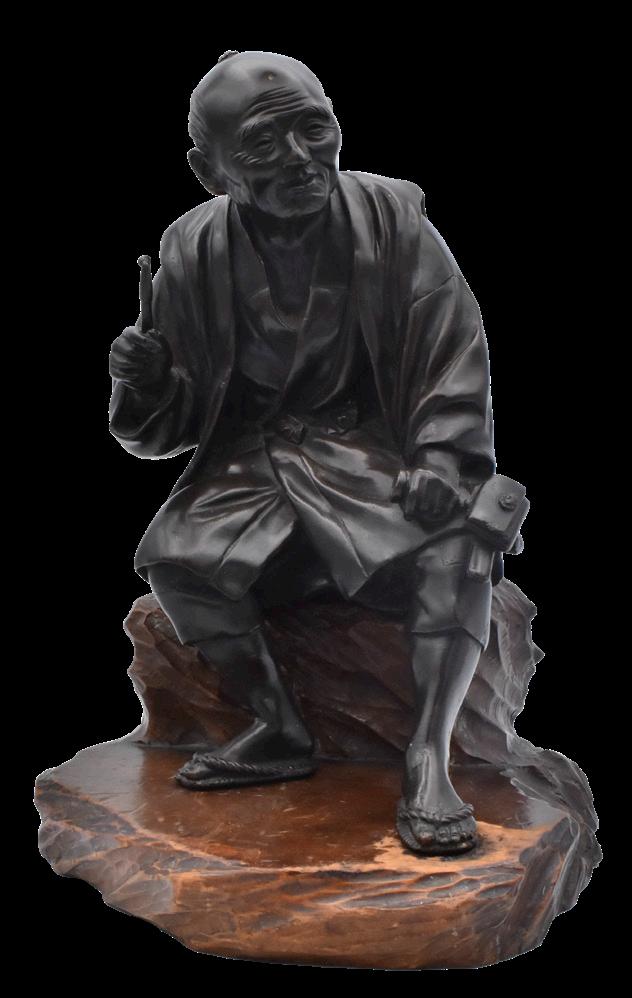
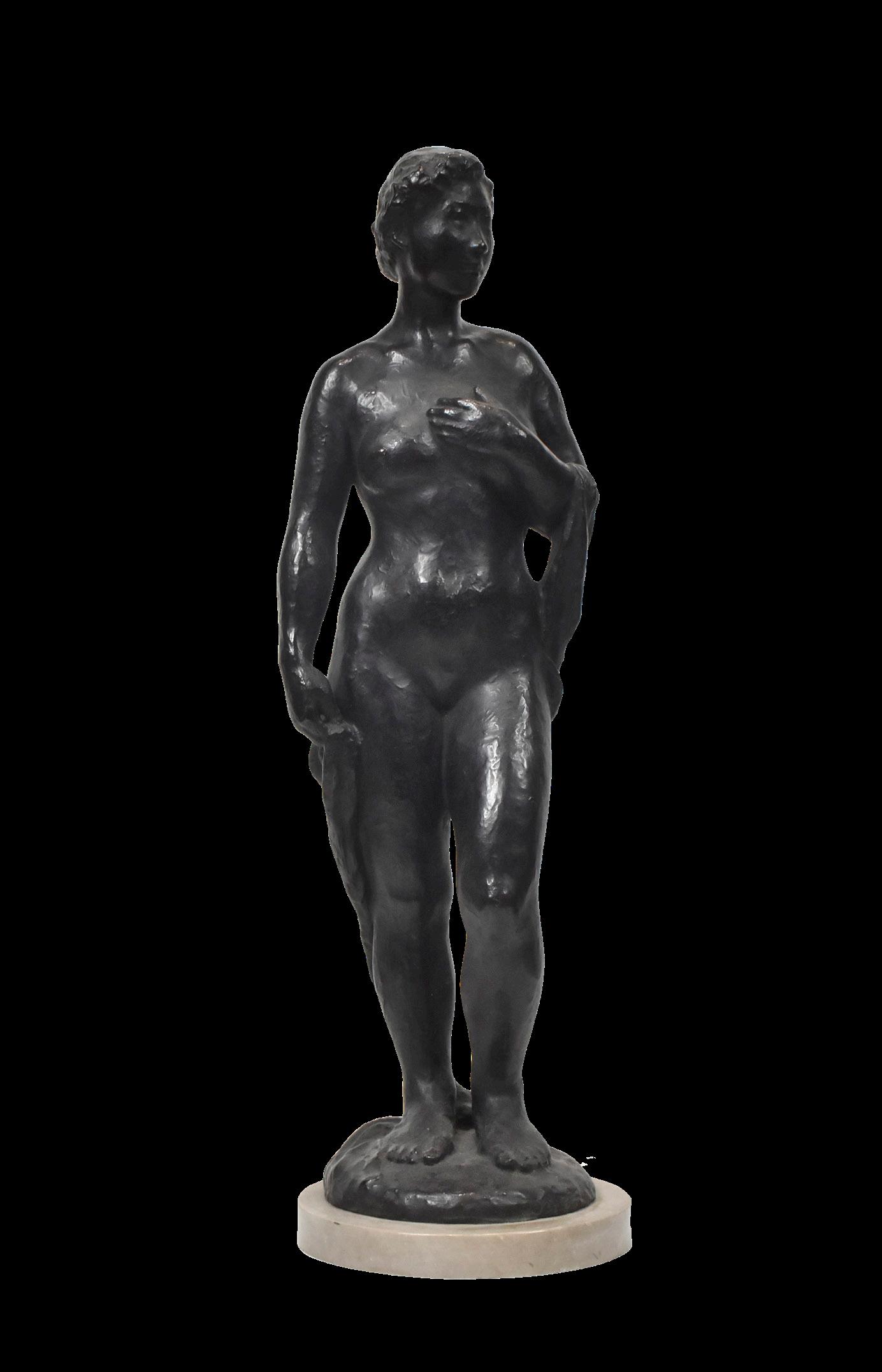


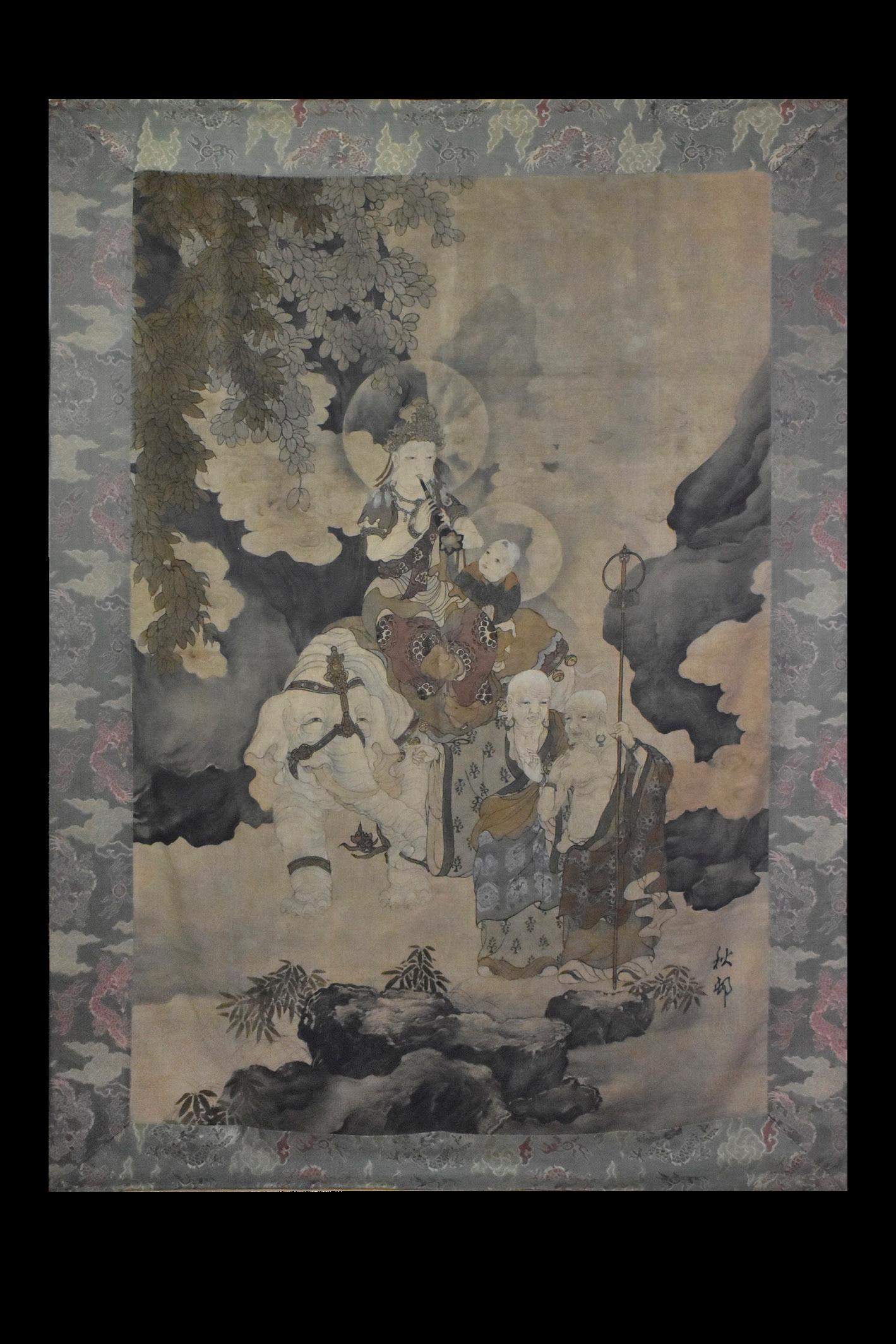
174Ω
HARA ZAISEN (1849-1916)
MEIJI (1868-1912) OR TAISHO (1912-1926) ERA, LATE 19TH/EARLY 20TH CENTURY
A two-panel furosaki byobu (folding screen used for the tea ceremony), ink, kirikane, gold wash, gofun and colours on silk mounted on wooden lattices, edged with silk brocade, and with a black-lacquered frame, depicting a panorama of the multiple buildings within the grounds of the shrine complex of Kamigamo (Upper Kamo) surrounded by flowering cherry trees and pine trees during the spring season, a wood sign post in front of the torii inscribed kozoku gejo (members of the Imperial Family disembark here) signed Zaisen with seal Zaisen no in; with a cardboard storage box (2)
Overall: 72.8cm x 189cm
Image: 56.1cm x 172.2cm
£1,500-2,000
175
DESIGNED BY SHUSON
A YUZEN-DYED CUT VELVET WALL HANGING
MEIJI ERA (1868-1912) LATE 19TH/EARLY 20TH CENTURY
Woven in variously coloured silk threads, depicting the bodhisattva Fugen seated on her customary white elephant beneath a tree amongst rocks, playing an oboe-like instrument, with a boy attendant and two rakan (direct disciples of the Buddha); silk brocade border; signed and sealed Shuson
207cm x 141cm
£1,000 - 1,500

176Ω
ANONYMOUS
EDO PERIOD (1868-1912), MID/LATE 18TH CENTURY
A section of a hand scroll mounted as a kakejiku (hanging scroll), ink, colour, gofun and gold kirikane on paper, depicting three mounted samurai engaged in horse training, three retainers and other members of the household watching from the mansion in the background, the chumawashi (surrounding mount) silkembroidered with cranes in flight among plum blossoms and bamboo leaves; unsigned; with a wood storage box (2)
Overall: 114cm x 61cm
Image: 30cm x 45.5cm
£1,800-2,500


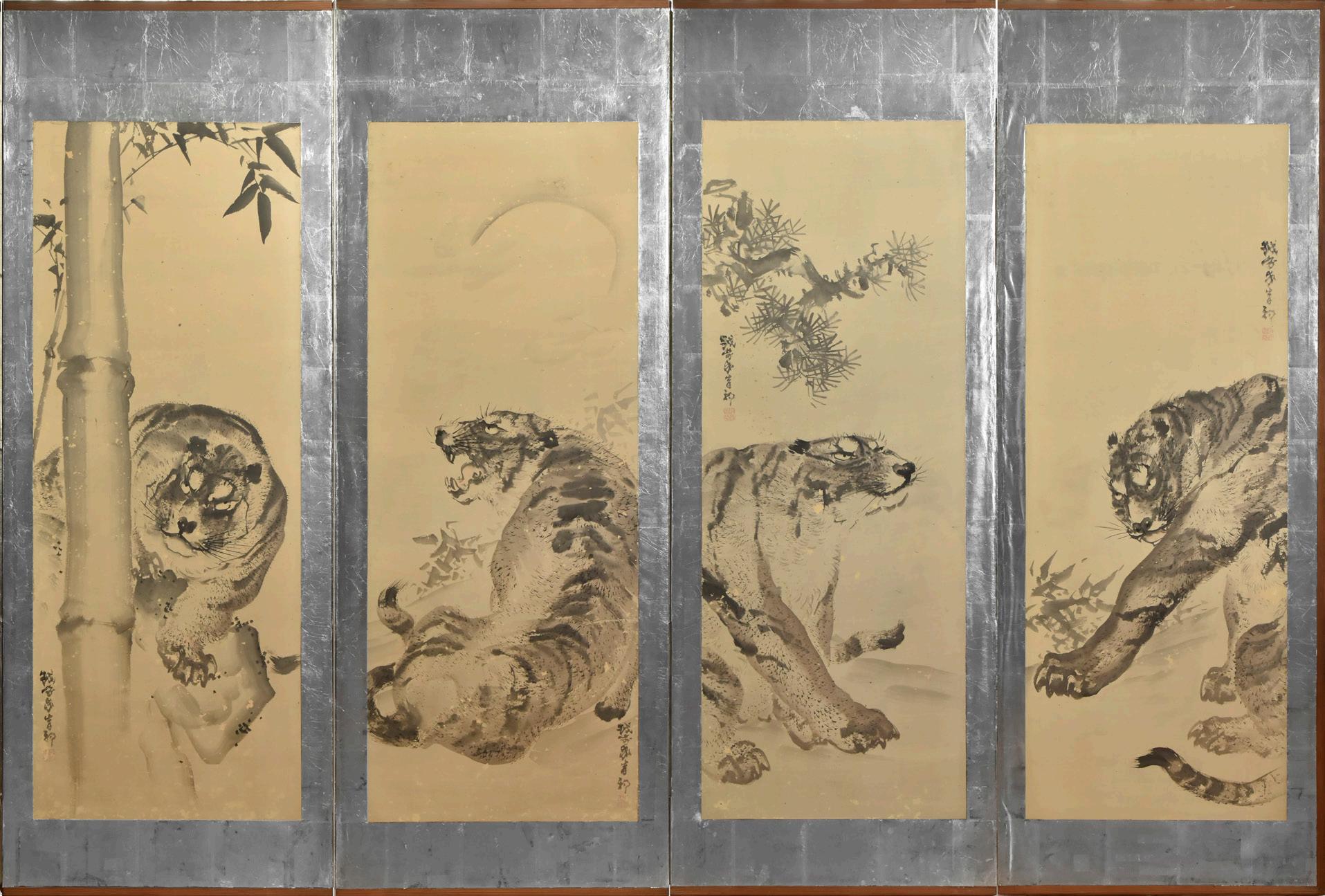
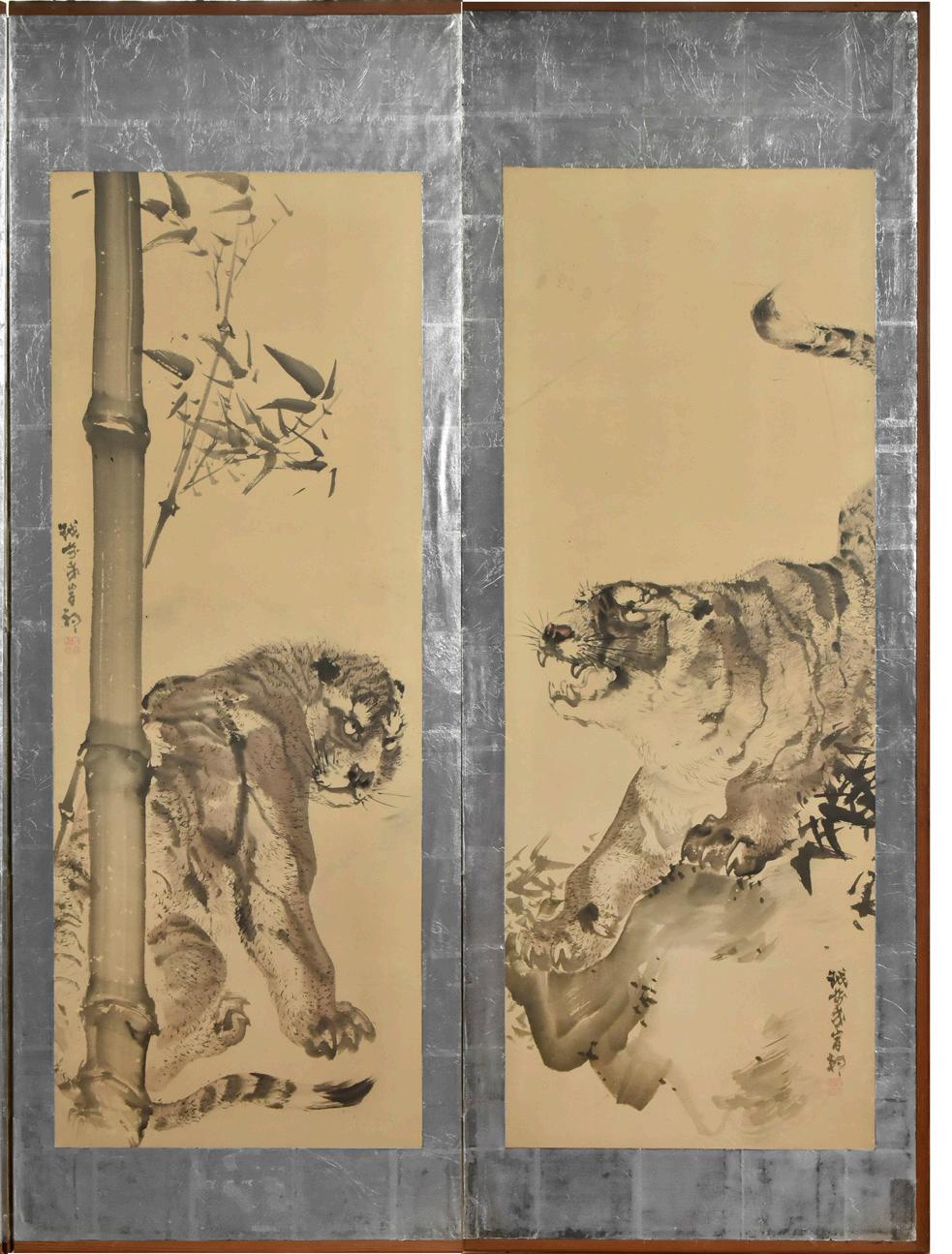
177Ω
KISHI GANKU (1749-1838)
TWELVE TIGERS
EDO PERIOD (1615-1868), LATE 18TH/EARLY 19TH CENTURY
A pair of six kakejiku (vertical hanging scrolls) mounted as a six-panel byobu (folding screen), ink, and slight colour on paper, within a silver leaf mount, each depicting a tiger in dramatic Kishi-school style: the first screen showing (1) tiger looking left among bamboo leaves, (2) tiger seated beneath a pine tree (3) tiger snarling beneath the full moon (4) tiger peeking behind a robust bamboo tree (5) tiger crouching on a rock (6) tiger stretching its limbs in the rain; the second screen depicting (7) tiger growling on a rock (8) tiger behind a bamboo tree looking back (9) tiger seated and roaring among bamboo leaves (10) tiger lying sprawled beside a skinny bamboo tree (11) tiger grooming itself beneath a gingko tree (12) tiger prowling and looking towards the right, a waterfall in the background; each painting signed Echizen no Suke Ganku with two seals
Kishi Ganku and Hizen (2)
Overall: 152cm x 330cm; each painting: 118.5cm x 44cm
£10,000 - 15,000

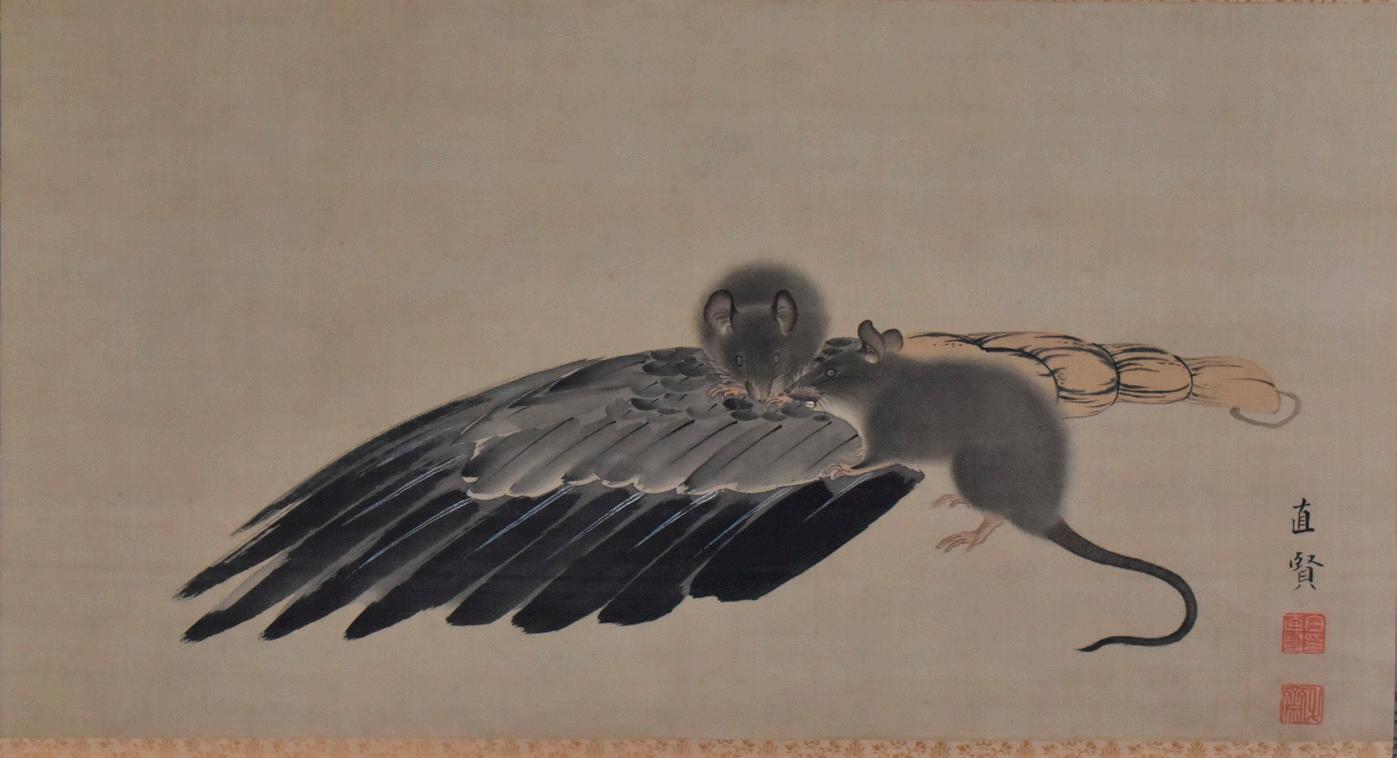
178Ω
MIKI SANRYU (DATES UNKNOWN)
EDO PERIOD (1615-1868), 18TH CENTURY
Kakejiku (hanging scroll), ink and dolour on silk, in silk mounts, depicting different types of freshly caught fish including, karei (flat fish), tai (sea bream), kasago (marbled rockfish), and iseebi (spiny lobster), signed with two seals, one reading Sanryu; with a plain wood storage box (2)
Overall: 127cm x 47cm; image: 43cm x 56cm
£1,200-1,500
SHIRAI NAOKATA (1756-1833)
EDO PERIOD (1615-1868), LATE 18TH/EARLY 19TH CENTURY
Kakejiku (hanging scroll), ink and slight colour on silk, in silk mounts, depicting two mice and a haneboki (feather duster), signed Naokata with two seals Shiro Naokata no in and Shisai; with a plain wood storage box (2)
Overall: 120.6cm x 66.4cm; image: 29cm x 55cm
£1,000-1,500

SUZUKI KASON (1860-1919)
MEIJI (1868-1912) OR TAISHO (1912-1926) ERA, LATE 19TH/EARLY 20TH CENTURY
Kakejiku (hanging scroll), ink and slight colour on silk, in silk mounts, depicting a sparrow perched on the leaf of a banana plant on which climb vines of red morning glory, signed Kason with a seal Kason; with a tomobako wood storage box titled outside the lid Basho suzume (Banana Plant and a Sparrow), signed inside the lid Kason hitsu with a seal Kason (2)
Overall: 206cm x 55cm; image: 112cm x 35cm
£600-800
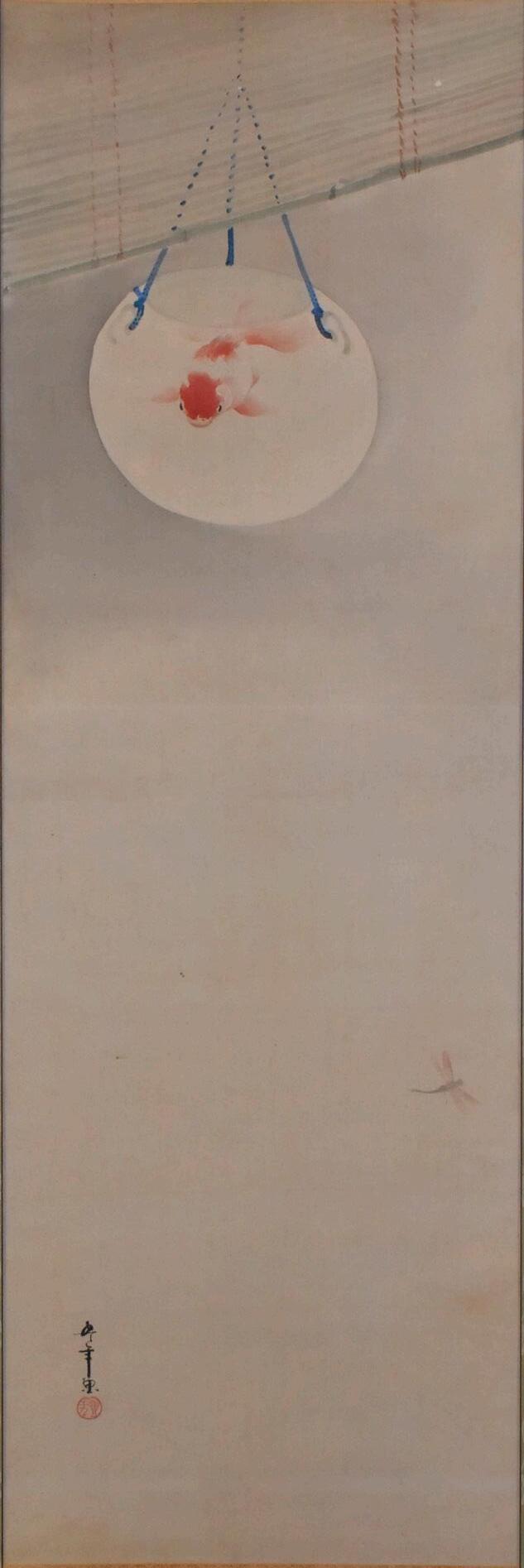
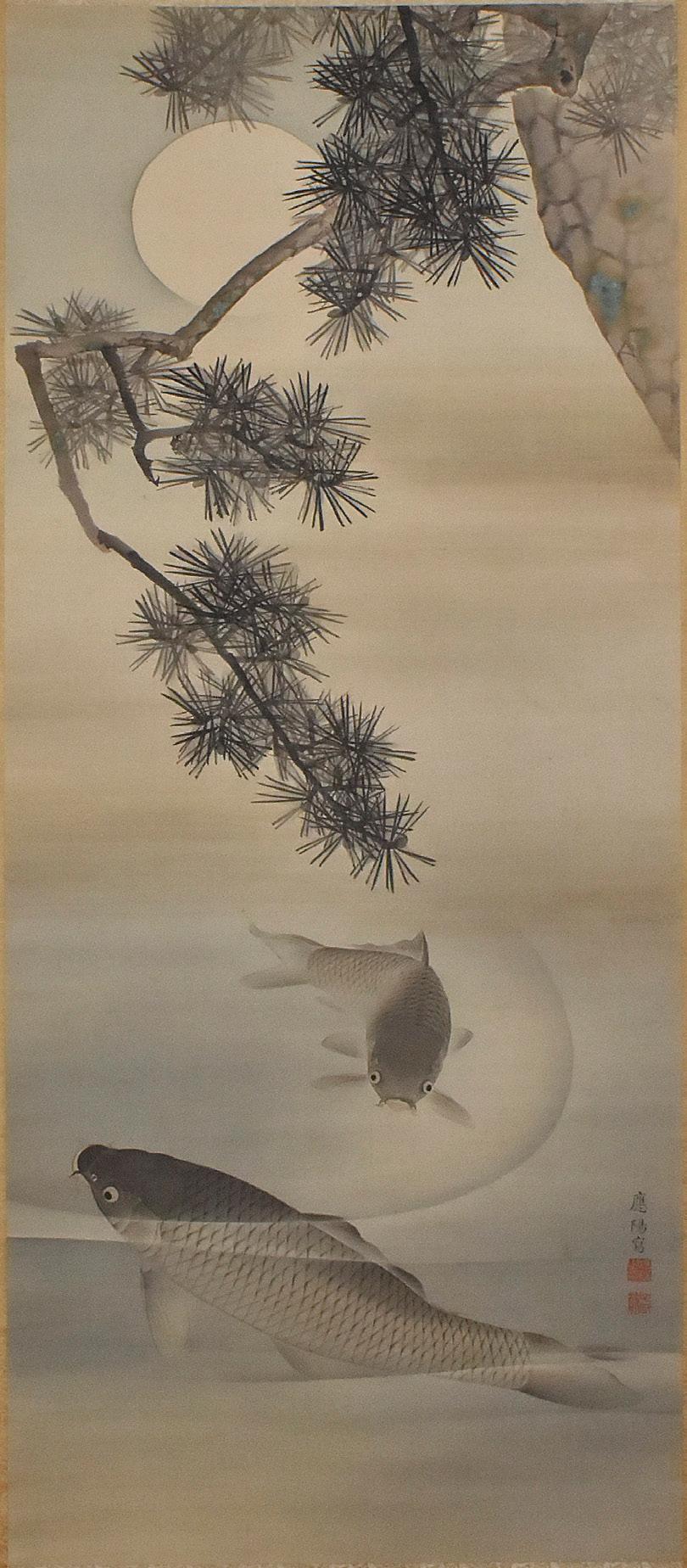
181Ω
TSUBAOTA HONEN (1889)
TAISHO (1912-1926) OR SHOWA (1926-1989) ERA, EARLY 20TH CENTURY
Kakejiku (hanging scroll), ink and colour on silk, in silk mounts, depicting a kingyobachi (goldfish bowl) suspended from the edge of eaves behind a rolled-up sudare (bamboo blind) on a summer evening, a dragonfly hovering below, signed Honen with a seal Honen; with a plain wood storage box (2)
Overall: 191cm x 56.6cm; image: 124cm x 41cm
£1,000-1,500
182Ω
KUNII OYO (1868-1923)
MEIJI (1868-1912) OR TAISHO (1912-1926) ERA, LATE 19TH/EARLY 20TH CENTURY
Kakejiku (hanging scroll), ink and slight colour on silk, in silk mounts, depicting two carps swimming in a pond beneath an ancient pine tree, the full moon in the distance, signed Oyo sha with two seals, one reading Oyo no in; with a wood storage box inscribed outside the lid Tsukiyo rosho ni koi, Oyo hitsu (Ancient Pine Tree and Carps in the Moon-lit Night) (2)
Overall: 204.2cm x 64cm; image 119cm x 50cm
£1,000-1,500
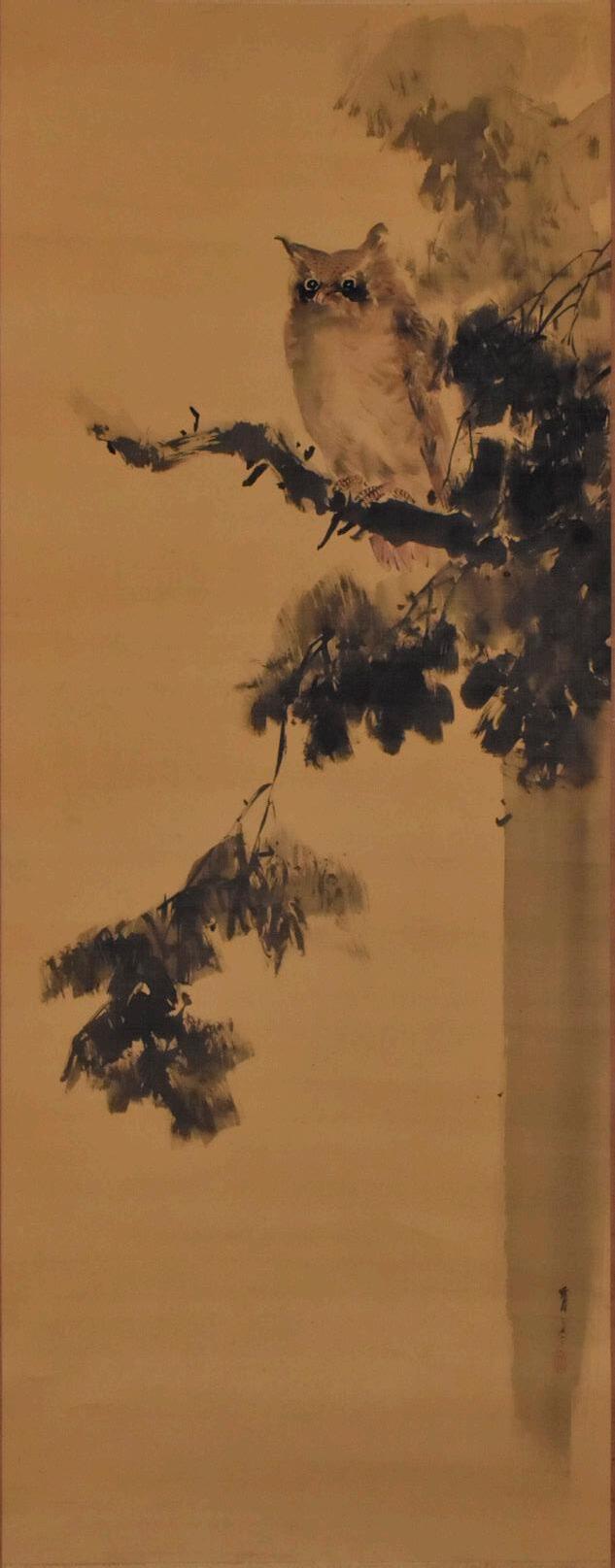
183Ω
WATANABE SEITEI (1851-1918)
MEIJI ERA (1868-1912), LATE 19TH/EARLY 20TH CENTURY
Kakejiku (hanging scroll), ink on silk in silk mounts, depicting a mimizuku (horned owl) resting on the branch of a cedar tree, signed Seitei with a seal; with a plain wood storage box (2)
Overall: 182cm x 51.2cm; image: 104cm x 40.5cm
£800-1,200

184Ω
MANO KYOTEI (1874-1934)
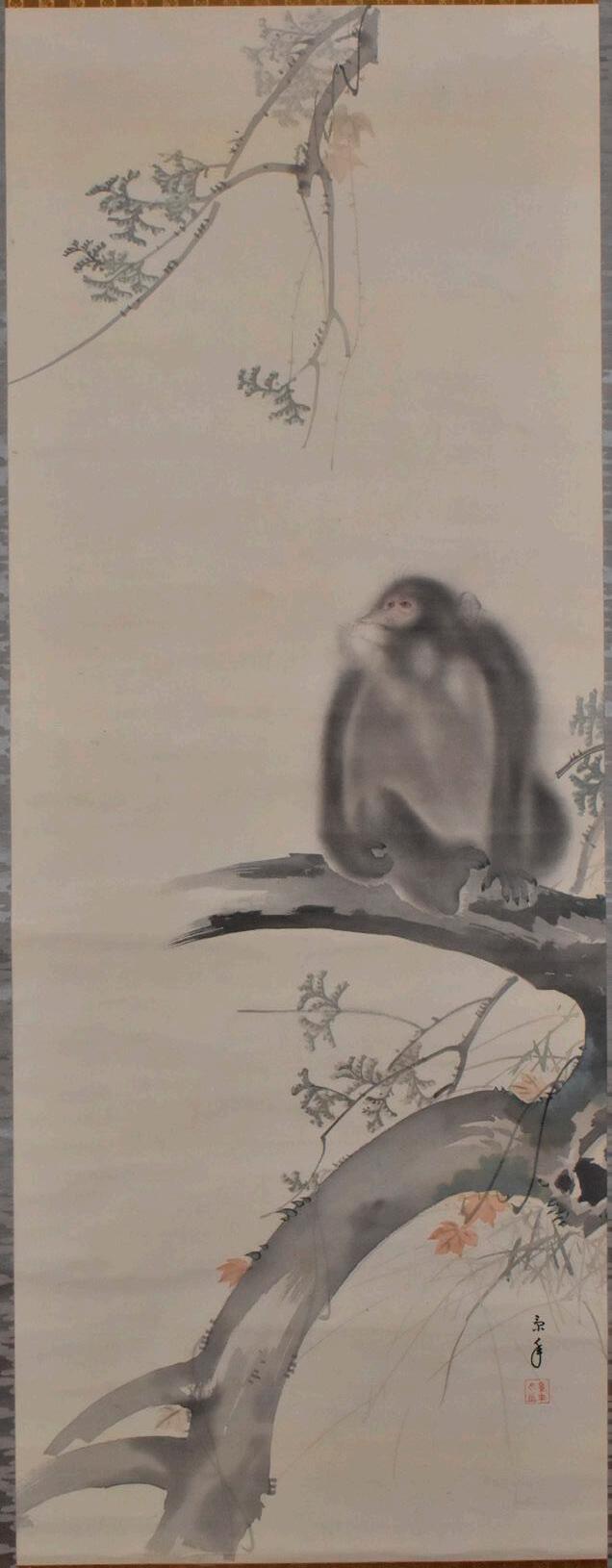
IMAO KEINEN (1845-1924)
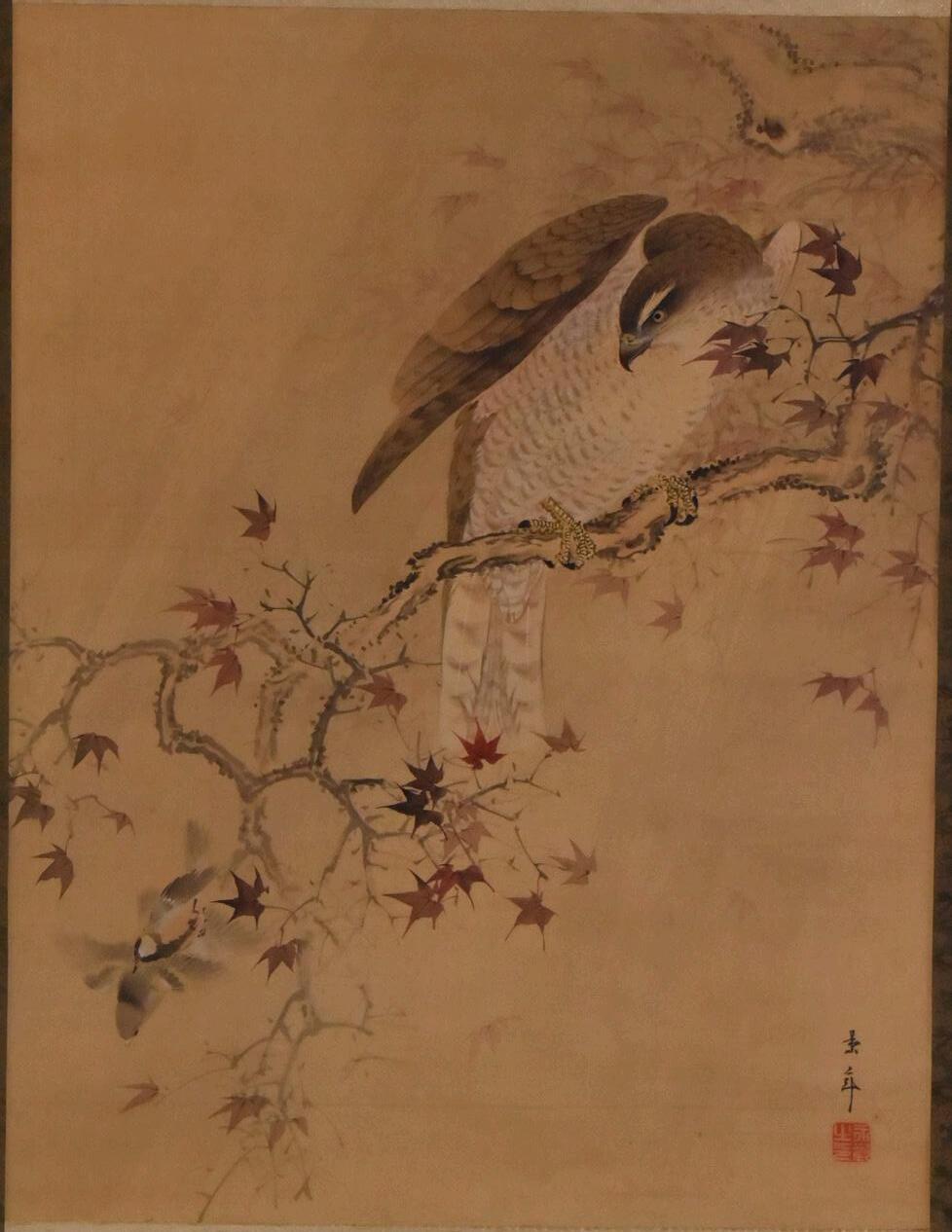
186Ω
IMAO KEINEN (1845-1924)
MEIJI (1868-1912), TAISHO (1912-1926) OR SHOWA (1926-1989) ERA, EARLY 20TH CENTURY
Kakejiku (hanging scroll), ink and slight colour on paper, depicting an onagadori (long-tailed cockerel) perched on a wood stand, its extensively long feathers forming its tail trailing behind, signed Kyotei with a round red seal; with a plain wood storage box (2)
Overall: 207.7cm x 51cm; image: 141cm x 37.5cm
Born in Tokyo, Mano Kyotei was a student of Kawanabe Kyosai (1831-1889).
£600-800
MEIJI (1868-1912) OR TAISHO (1912-1926)
ERA, EARLY 20TH CENTURY
Kakejiku (hanging scroll), ink and slight colour on silk, in silk mounts, depicting a monkey sitting on a gnarled tree branch, preparing to jump to higher branches above, the green moss on the branch rendered in the tarashikomi technique, signed Keinen with a seal Keinen no ga; with a wood storage box inscribed outside the lid Saru no zu, Imao Keinen hitsu (Picture of a Monkey, painted by Imao Keinen), inside the lid with a date Showa yonju[…]nen kugatsu tsuitachi (1st September 196[…] or 197[…]) and a signature possibly reading Tora no ya shujin (Master of Tora no ya shop) (2)
Overall: 182.7cm x 56.5cm; image: 110.5cm x 42cm
£600-800
MEIJI (1868-1912) OR TAISHO (1912-1926) ERA, EARLY 20TH CENTURY
Kakejiku (hanging scroll), ink and slight colour on silk, in silk mounts, depicting a hawk perched on a gnarled maple branch, preparing to dive for small birds, signed Keinen with a seal Eikan no in; with a plain wood storage box (2)
Overall: 131.3cm x 49cm; image: 58.5cm x 45cm
£800-1,200
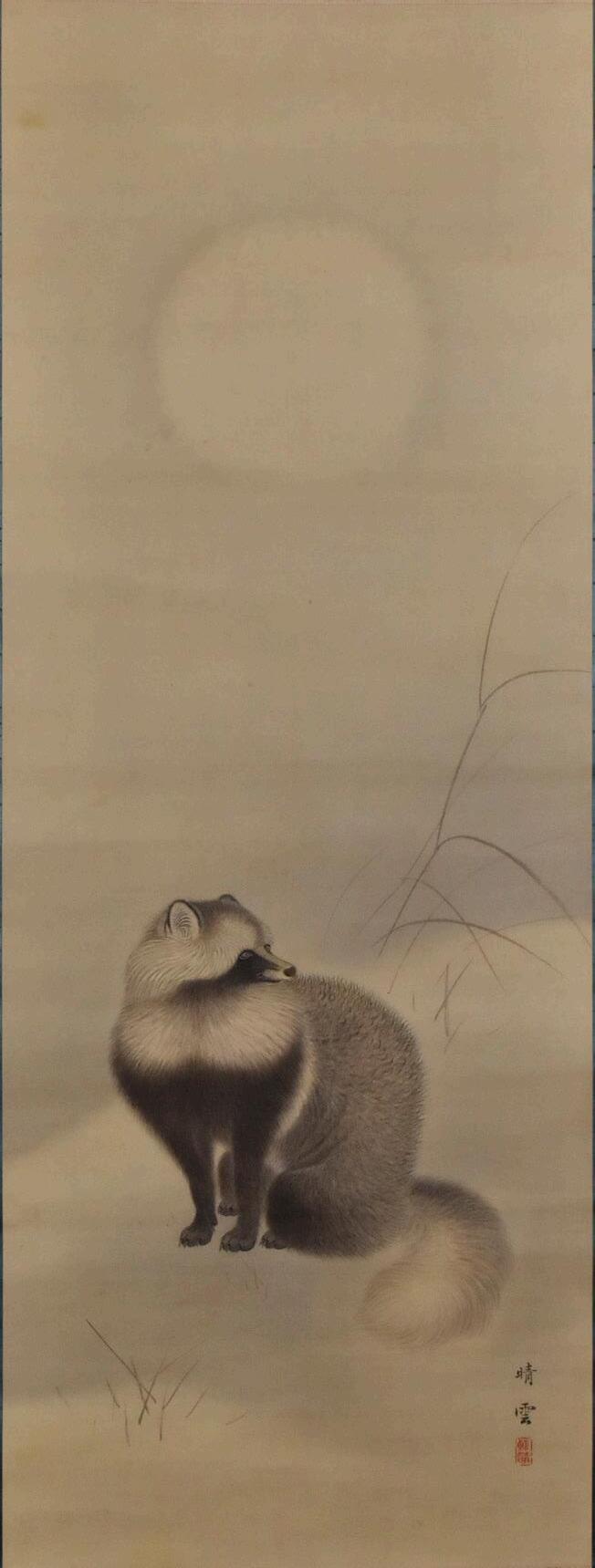
187Ω
EMORI SEIUN (1854-?)
PROBABLY TAISHO ERA (1912-1926), EARLY 20TH CENTURY
Kakejiku (hanging scroll), ink and slight colour on silk, in silk mounts, depicting a tanuki (raccoon dog) sitting among withered stalks of wild plants, looking towards its left side, the full moon rising in the distance, signed Seiun with a seal; with a wood storage box titled outside the lid Tanuki […] tsuki no zu (Picture of a Raccoon Dog and Moon), inside the lid with an inscription and a date Taisho juninen sangatsu (March 1923) (2)
Overall: 194.5cm x 54cm; image: 107.5cm x 40.5cm
£800-1,200

188Ω
YOSHIMURA NAOKATA (DATES UNKNOWN)
PROBABLY TAISHO (1912-1926) OR SHOWA (1926-1989) ERA, EARLY/MID- 20TH CENTURY
Kakejiku (hanging scroll) in ink, colour, gofun, and lacquer on silk, in silk mounts, depicting a spiny lobster and five shrimps, signed Naokata with a seal at upper left, and an additional seal at lower right; with a wood tomobako storage box titled outside the lid Ise’ebi no zu (Picture of a Spiny Lobster), inside the lid signed by the artist possibly reading Naokata daito (titled and painted by Naokata) with two seals (2)
Overall: 192.3cm x 49.2cm; image: 114cm x 36cm
£600-800
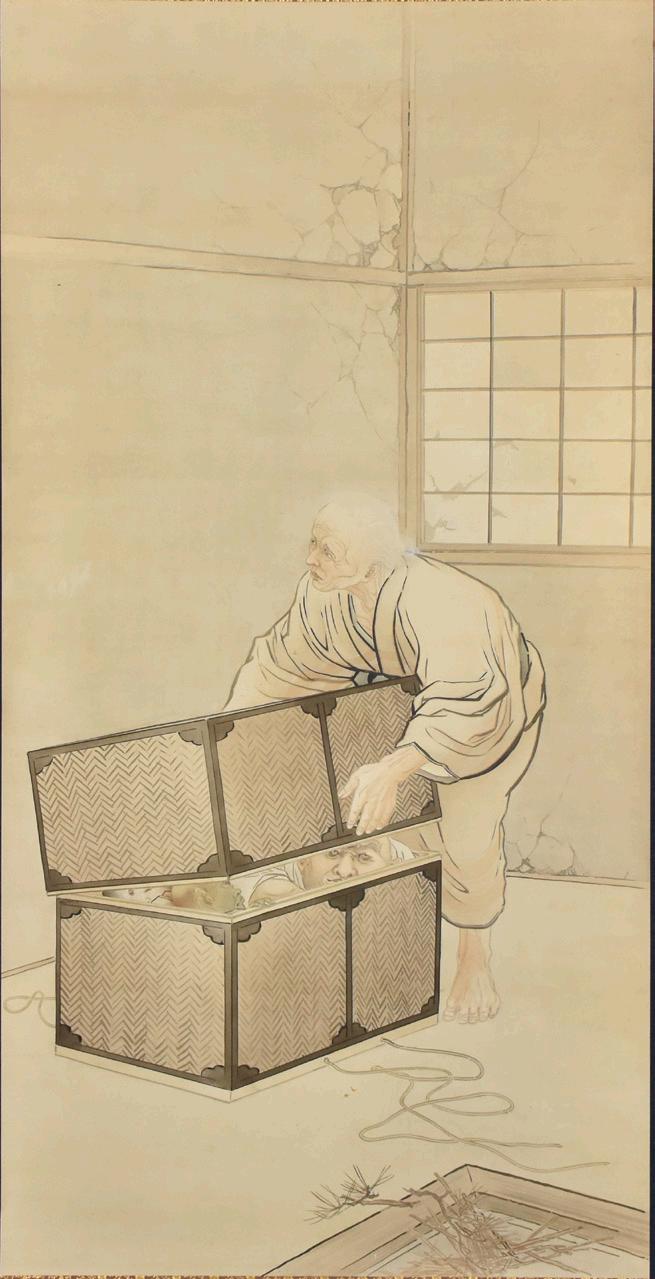
189Ω ANONYMOUS
MEIJI (1868-1912) OR TAISHO (1912-1926) ERA, EARLY 20TH CENTURY
Kakejiku (hanging scroll), ink and colour on paper in silk mounts, depicting a scene from the folktale Shitakiri suzume (The Tongue-Cut Sparrow) in which the greedy old woman attempts to open a giant cage, unaware that it is filled with terrifying monsters, unsigned; with a plain wood storage box (2)
Overall: 214cm x 96cm image: 146cm x 74cm
£600-800
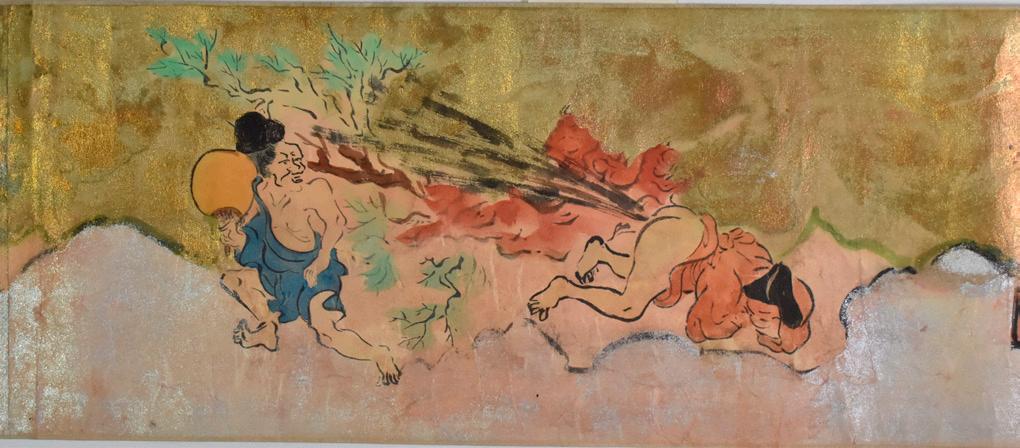


190Ω
ANONYMOUS
EDO PERIOD (1615-1868), LATE 19TH CENTURY
Makimono (hand scroll) paintings, ink and colours with gold and silver mica on paper, depicting 10 humorous scenes of Hekurabe (A Farting Contest), inscribed Tsutaya Juzaburo at the end section of the scroll, mounted on paper, the outer silk wrapper with a label Hekurabe emaki (Illustrated Hand Scroll of a Farting Contest); with a wood storage box inscribed Hekurabe e-maki (2)
Overall: 337cm x 17.2cm; image: 295cm x 17.2cm
£1,500-2,000


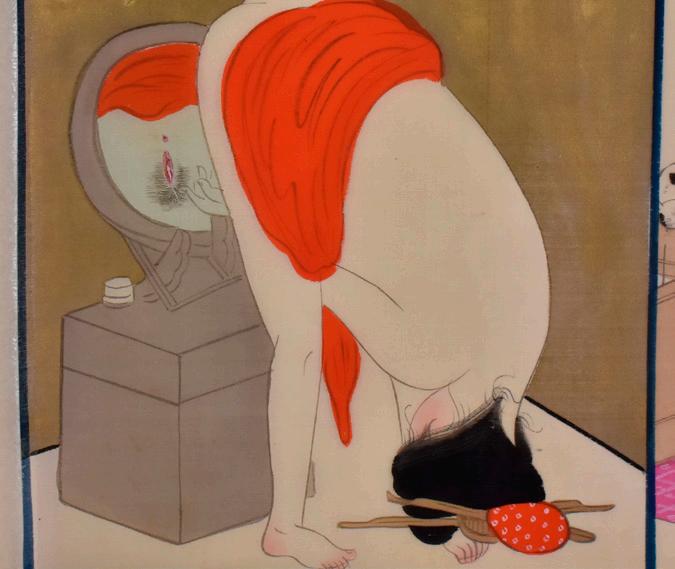
191Ω
ANONYMOUS, MEIJI (1868-1912) OR TAISHO (1912-1926) ERA, EARLY 20TH CENTURY
Makimono (horizontal scroll) paintings, ink, colours, and gofun on silk, depicting 12 scenes of love-making, including a courtesan and her client, a young man and an older woman, and a priest and a courtesan, mounted on paper; with a plain wood storage box (2)
Overall: 316cm x 24cm; image: approx. 300cm x 21cm
£500-600
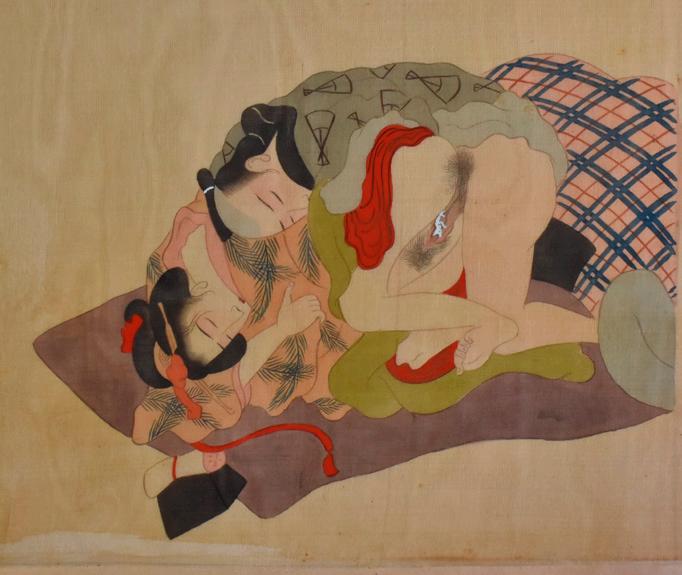
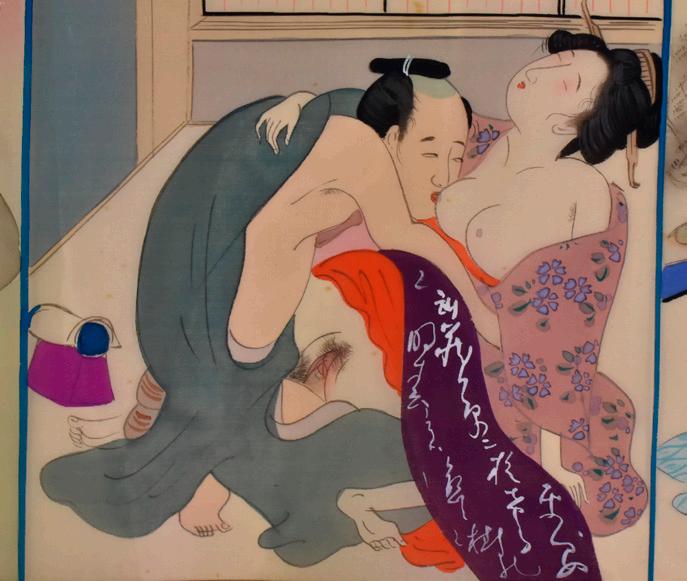
192Ω
ANONYMOUS
TAISHO (1912-1926) OR SHOWA (1926-1989) ERA, EARLY 20TH CENTURY
Makimono (hand scroll) paintings, ink, colour, and gofun on silk, depicting 12 love-making scenes including a samurai with his female attendant, a courtesan and her client, and a couple making love while a woman takes a bath outside the house, unsigned, mounted on paper, with an outer brocade wrapper; with a plain wood storage box (2)
Overall: 270.5cm x 26cm; image: 242.5cm x 21cm
£500-600

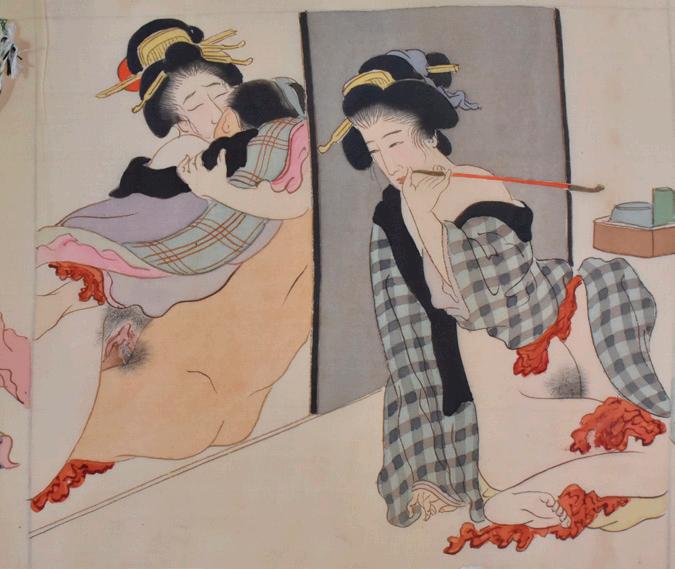
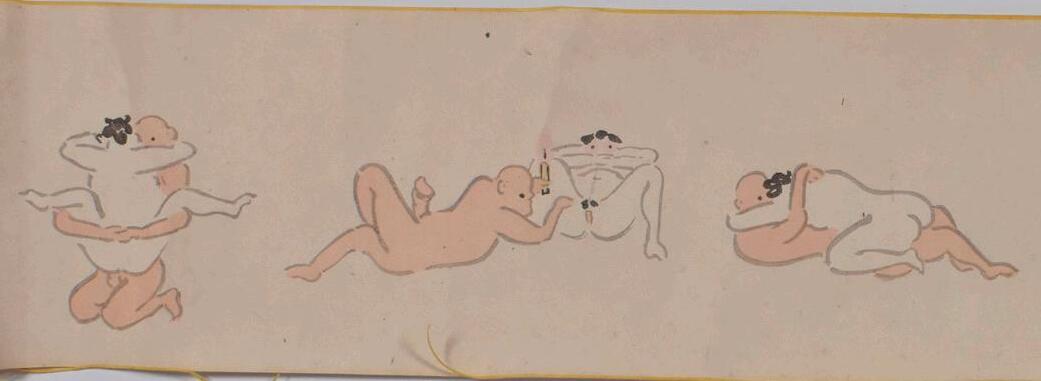
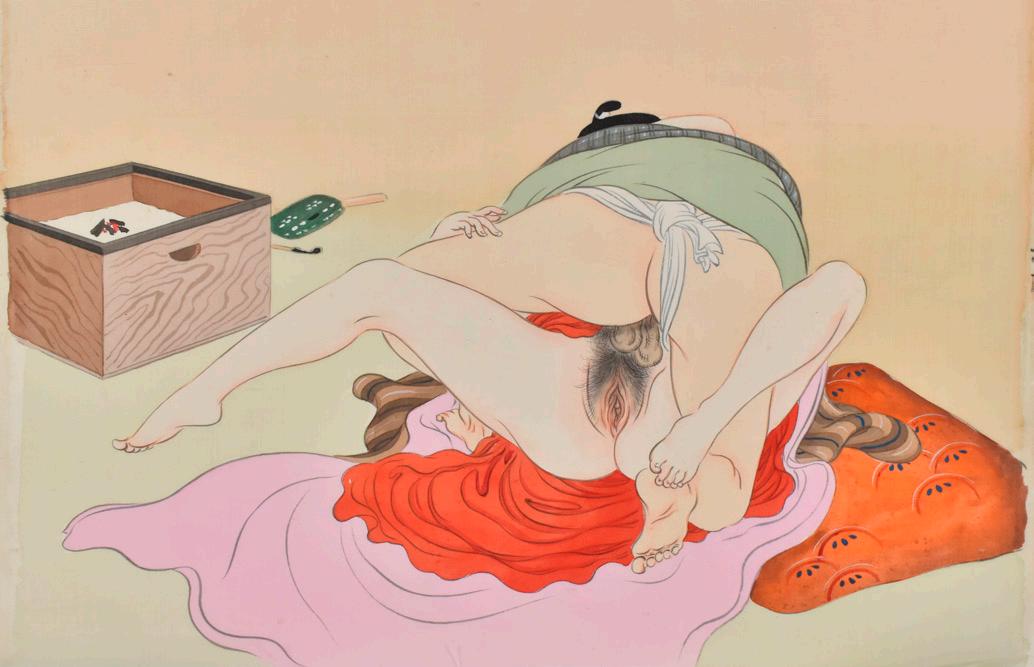
193Ω
ANONYMOUS
MEIJI (1868-1912) OR TAISHO (1912-1926) ERA, EARLY 20TH CENTURY
Makimono (hand scroll) paintings, ink, colours, and gofun on silk, depicting 12 scenes of love- making, including an adolescent boy and an older woman, a priest and a courtesan, and a woman spying on a couple making love in the next room, mounted on paper; with a plain wood storage box (2)
Overall: 289.5cm x 27cm; image: approx. 254.5cm x 21cm
£500-600

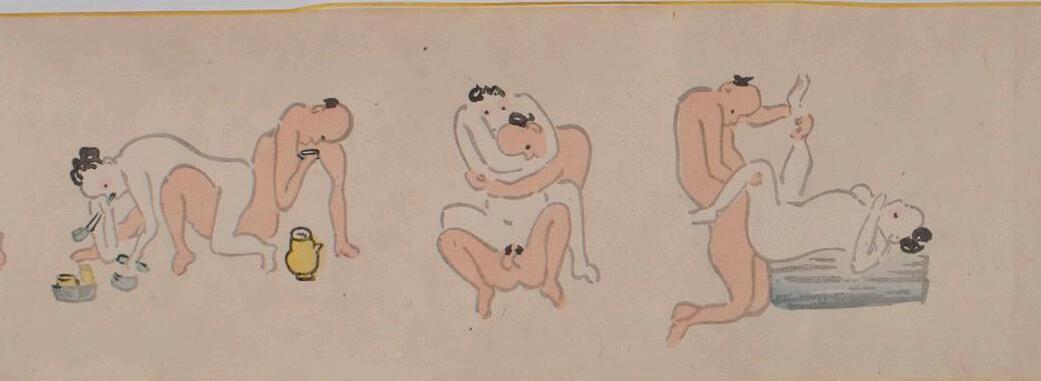
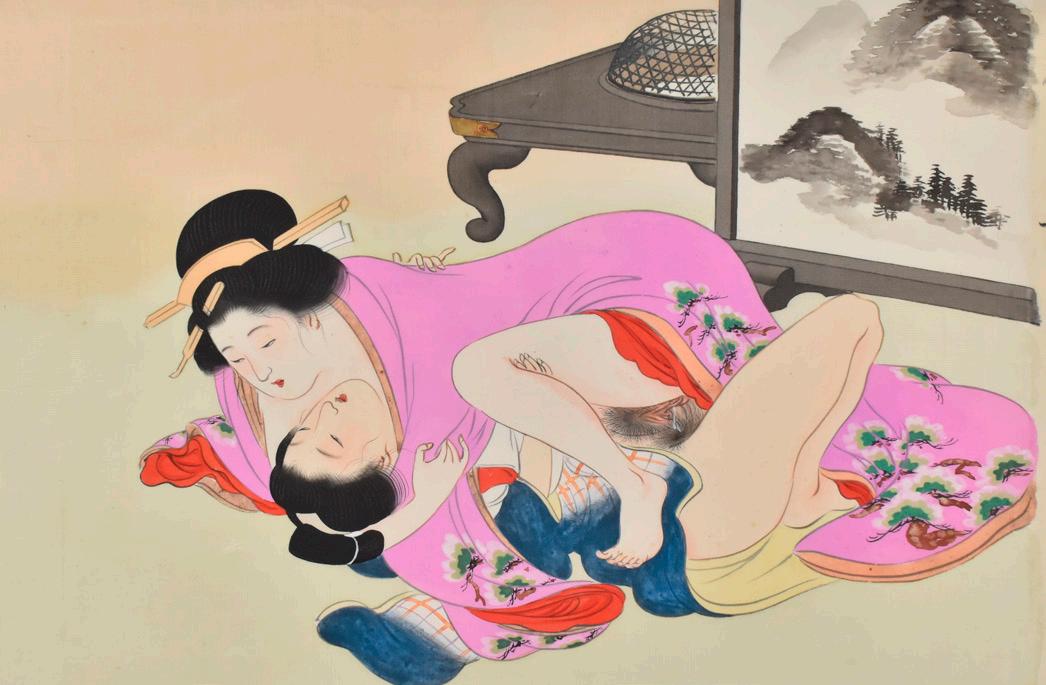
194Ω
ANONYMOUS
EDO PERIOD (1615-1868), 19TH CENTURY
Makimono (hand scroll) woodblock prints, ink and colours on paper, illustrating 14 love-making scenes of naked couples rendered in a humorous manner, the beginning of the scroll with a 17-line preface/forward by Ji[…]do shujin, mounted on paper, with an outer brocade wrapper; with a plain wood storage box (2)
Overall: 265.5cm x 15cm; image: 233cm x 14.5cm
£800-1,200
195
AFTER TOMIOKA EISEN (1864-1905)
TAISHO (1912-1926) OR SHOWA (19261989) ERA, EARLY 20TH CENTURY
Two shunga paintings, ink, colours on silk, each depicting a couple making love, comprising: an older courtesan and an adolescent boy beside a tsuitate (standing screen) and a townsman-class couple beside a hibachi (brazier); unsigned (2)
Both approx. 27.2cm x 39.2cm
£400-600
To be sold without reserve

The Sylvia Platt (1936-2024) Collection of Japanese Woodblock Prints: Purchased in Japan during the 1930s by Sylvia Platt’s parents Alice Carol Coates (1906-1992) and Eugene Haanel Cassidy (1903-1980), and thence by descent (Lots 196 - 228)
196
KAWASE HASUI (1883-1957)
TAISHO ERA (1912-1926), DATED 1925
An oban tate-e print; titled along the left margin Shiba Zojo-ji (Zojo-ji Temple in Shiba), from the series Tokyo nijukkei (20 Views of Tokyo), depicting a woman walking past the iconic vermilion facade of the Zojo-ji Temple, huddled beneath an umbrella during a snow blizzard, dated Taisho juyonen saku (Taisho 14 [1925]), published by Watanabe Shozaburo, with Hanken shoyu Watanabe Shozaburo seal along the right margin, signed Hasui with Kawase seal; the reverse of the print adhered with Watanabe Shozaburo’s diamond-shaped address label: 9 Nishi 8- chome, Ginza, Tokyo in English
39cm x 26cm
£10,000-15,000
197
KAWASE HASUI (1883-1957)
SHOWA ERA (1926-1989), DATED 1933
An oban tate-e print; titled along the right margin Sendai Aobajo (Aoba Castle, Sendai) from the series Nihon Fukei shu higashi Nihon hen (Collection of Scenic Views of Japan, Eastern Japan Edition), dated Showa hachinen junigatsu saku (Work of December, Showa 8 [1933]), published by Watanabe Shozaburo, with Hanken shoyu Watanabe Shozaburo seal along the left lower margin; signed Hasui with Kawase seal
38cm x 26cm
£2,000-3,000

198
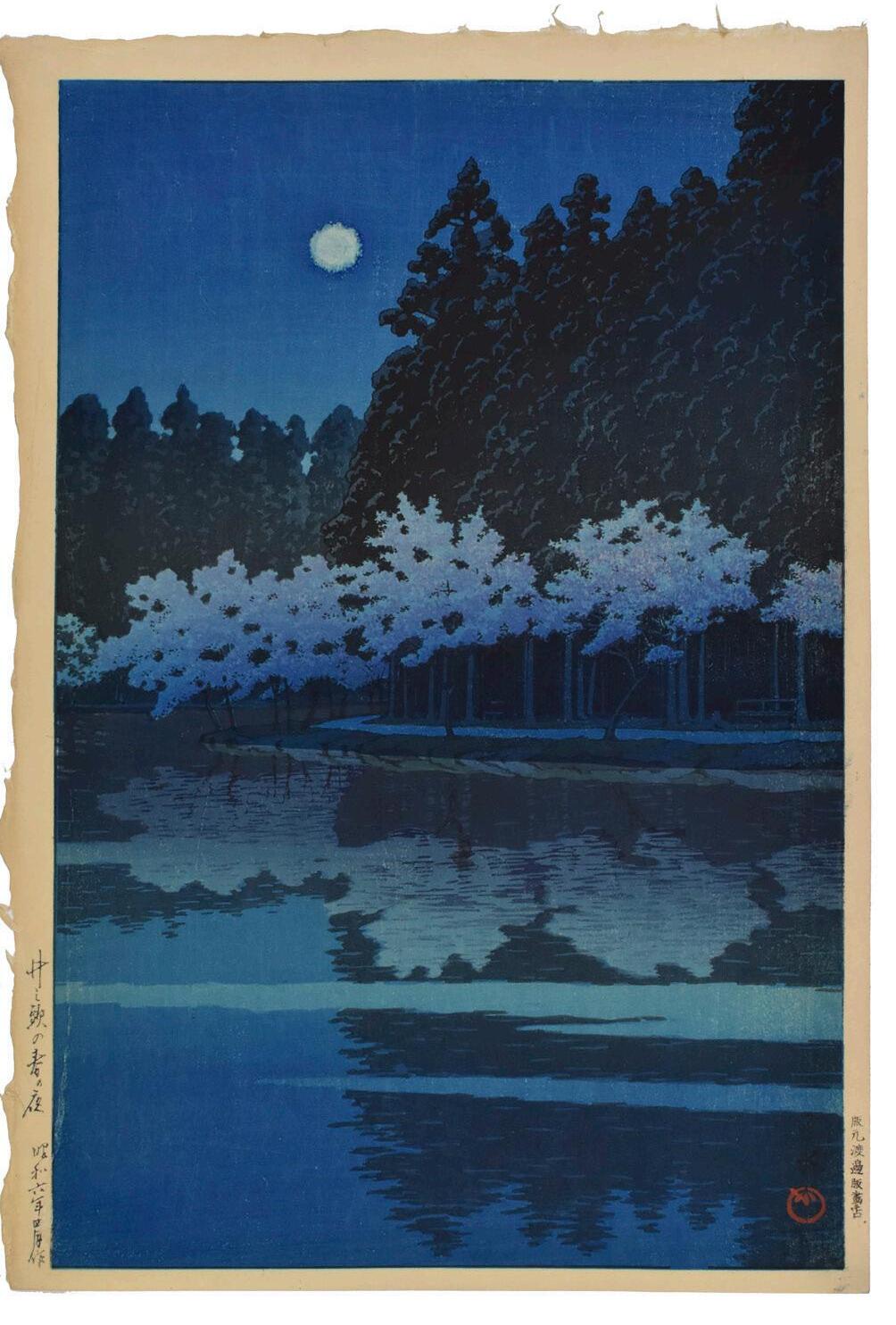
KAWASE HASUI (1883-1957)
SHOWA ERA (1926-1989), DATED 1931
An oban tate-e print; titled along the lower left margin Inokashira no haru (Spring Evening at Inokashira Park), dated Showa rokunen shigatsu saku (Work of April, Showa 6 [1931]), published by Watanabe Shozaburo, with Hanmoto Watanabe hangaten seal; signed Hasui with Kawase seal
38.5cm x 27cm
£2,000-3,000 197
199
KAWASE HASUI (1883-1957)
TAISHO ERA (1912-1926), DATED 1923
An aiban tate-e print, titled along the left margin Okayama Uchisange (Uchisange, Okayama) from the series Nihon fukei senshu (Selected Views of Japan), depicting a rainy street scene, two women sheltering beneath umbrellas approaching at the bottom right corner, a man in a yellow raincoat coming out of the castle gate at the top left, dated Taisho juninen saku (Work of Taisho 12 [1923]), published by Watanabe Shozaburo, with a round Watanabe seal at middle left on the castle wall; signed Hasui with Kawase seal
30.5cm x 22.7cm
£2,000-3,000
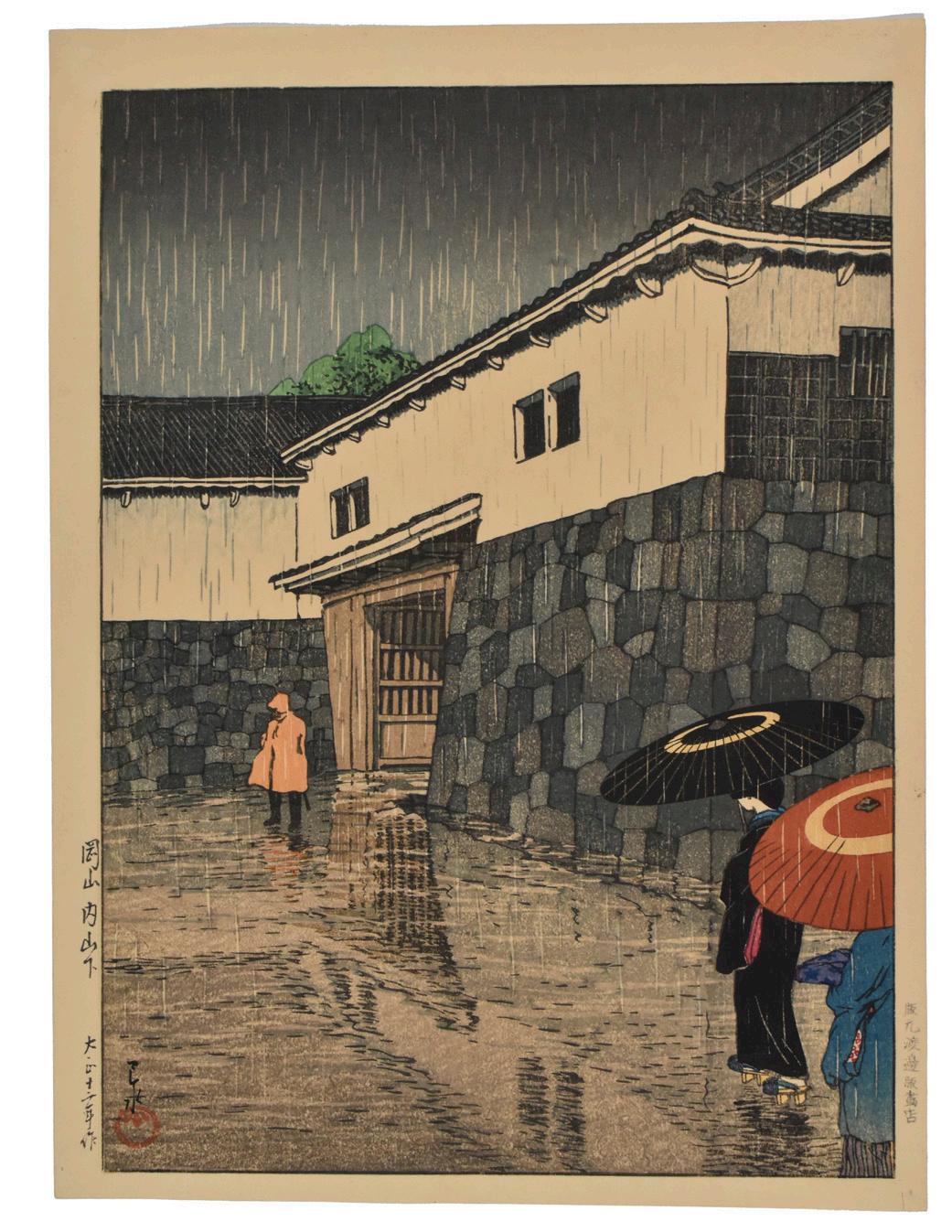
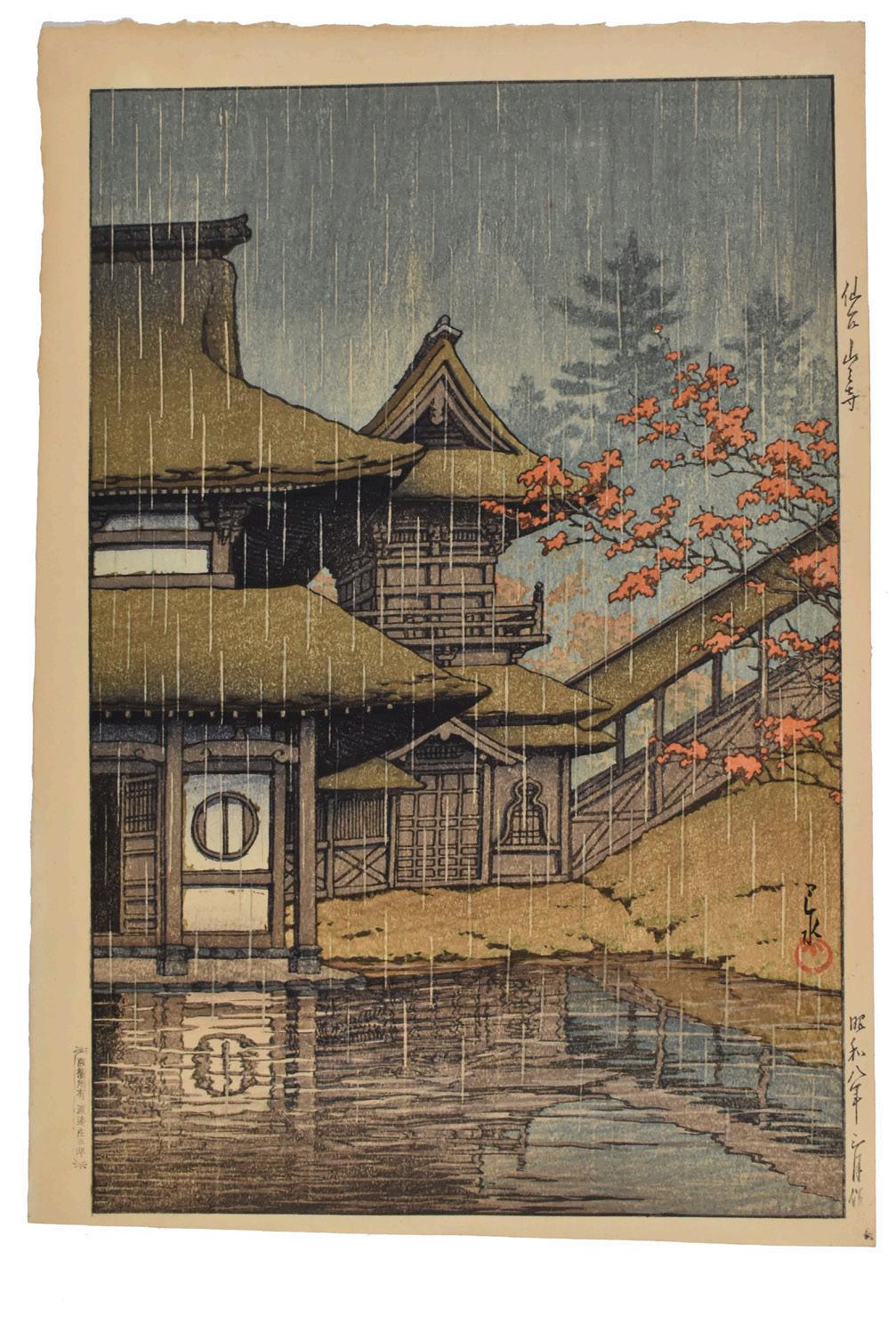
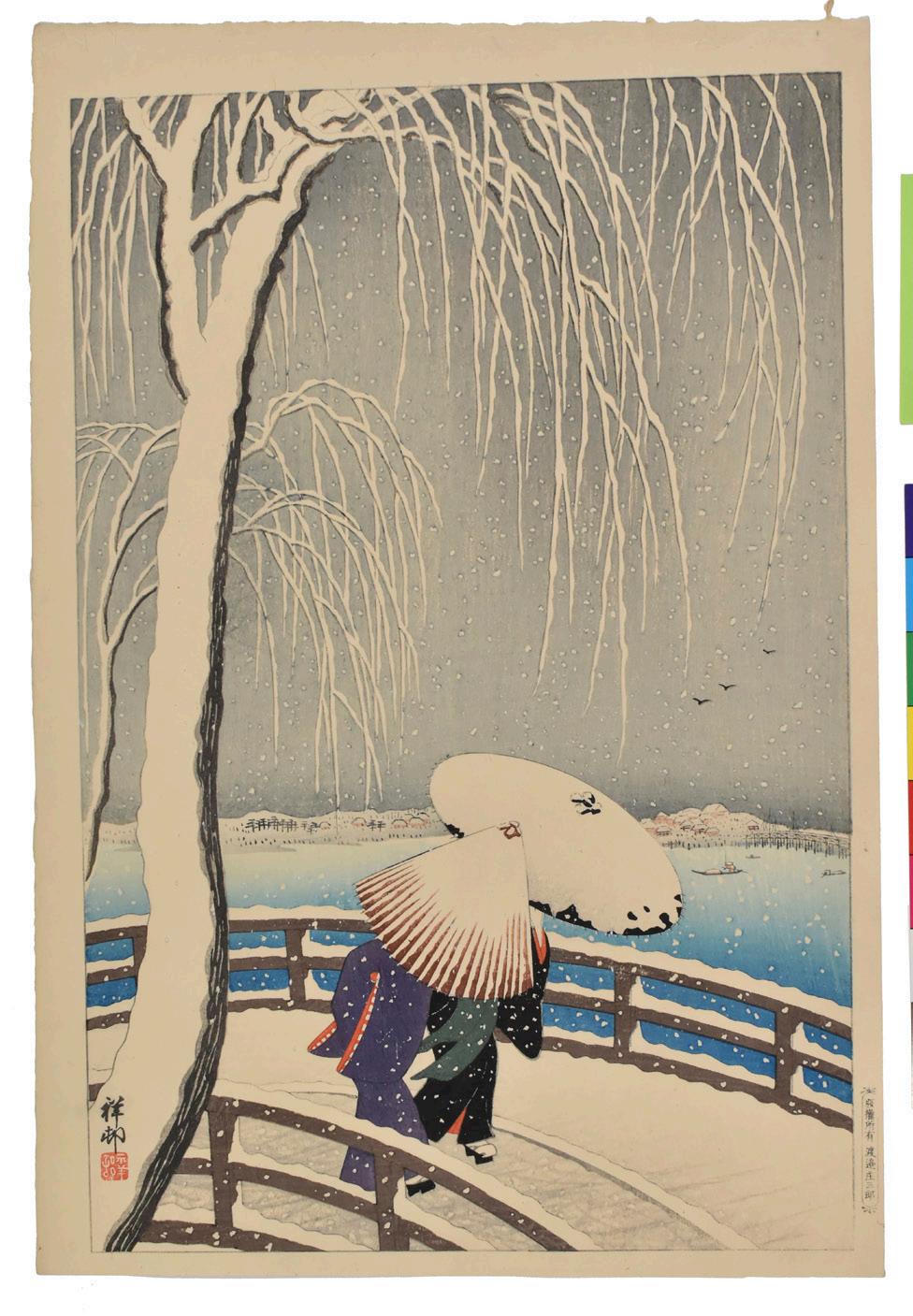
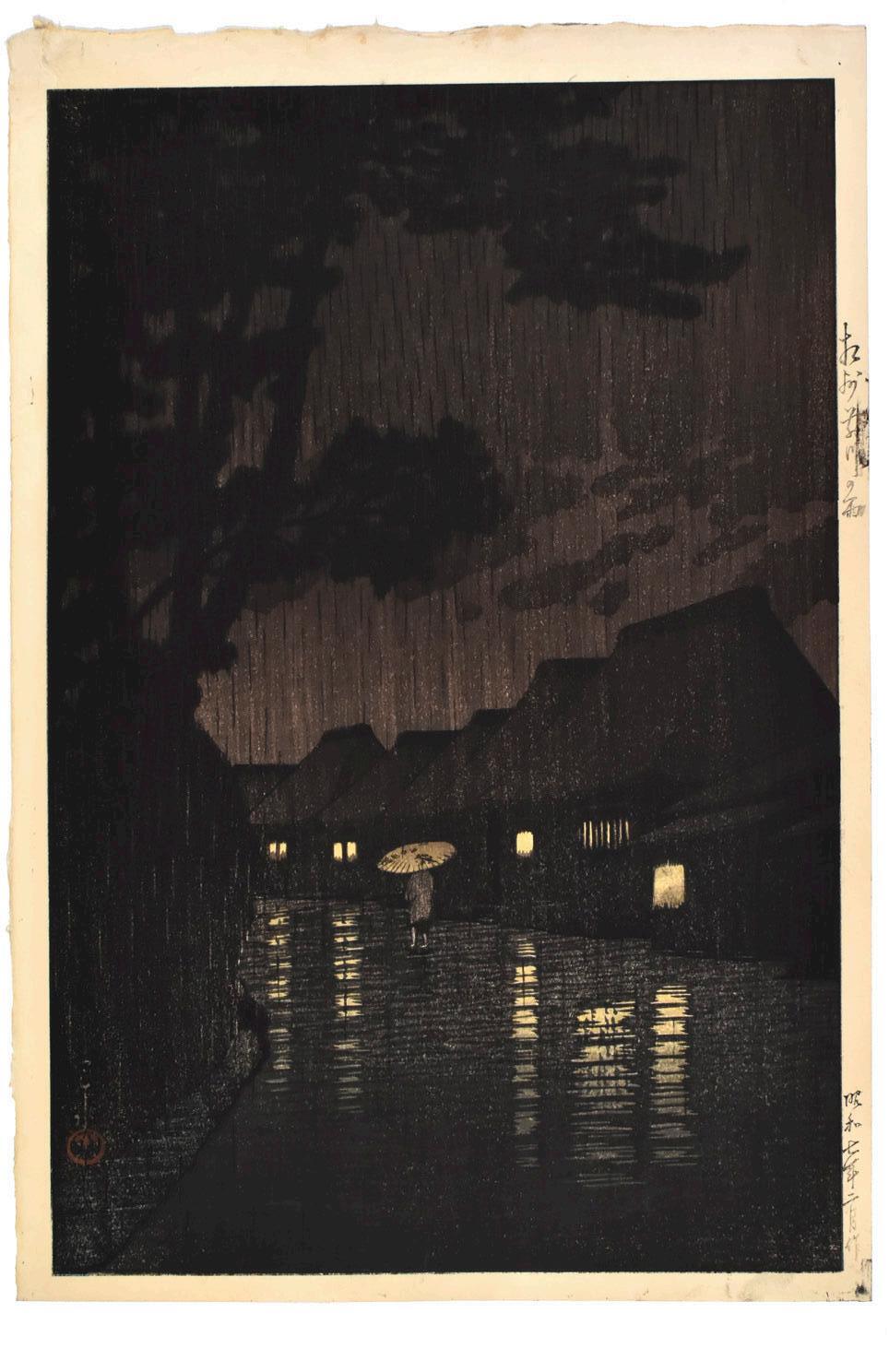
200
KAWASE HASUI (1883-1957)
SHOWA ERA (1926-1989), DATED 1933
An oban tate-e print; titled along the right margin Sendai yamadera (Mountain Temple at Sendai) from the series Nihon Fukei shu higashi Nihon hen (Collection of Scenic Views of Japan, Eastern Japan Edition), dated Showa hachinen sangatsu saku (Work of March, Showa 8 [1933]), published by Watanabe Shozaburo, with Hanken shoyu Watanabe Shozaburo seal along the left margin; signed Hasui with Kawase seal
38.2cm x 27cm
£2,000-3,000
201
KAWASE HASUI (1883-1957)
SHOWA ERA (1926-1989), DATED 1932
An oban tate-e print; titled along the right upper margin Soshu Maekawa no ame (Rain in Maekawa, Sagami Province) from the series Tokaido fukei senshu (Selections of Views of Tokaido), dated Showa shichinen nigatsu saku (Work of February, Showa 7 [1932]), published by Watanabe Shozaburo, lacking publisher’s seal; signed Hasui with Kawase seal
38.3cm x 26cm
£1,000-1,500

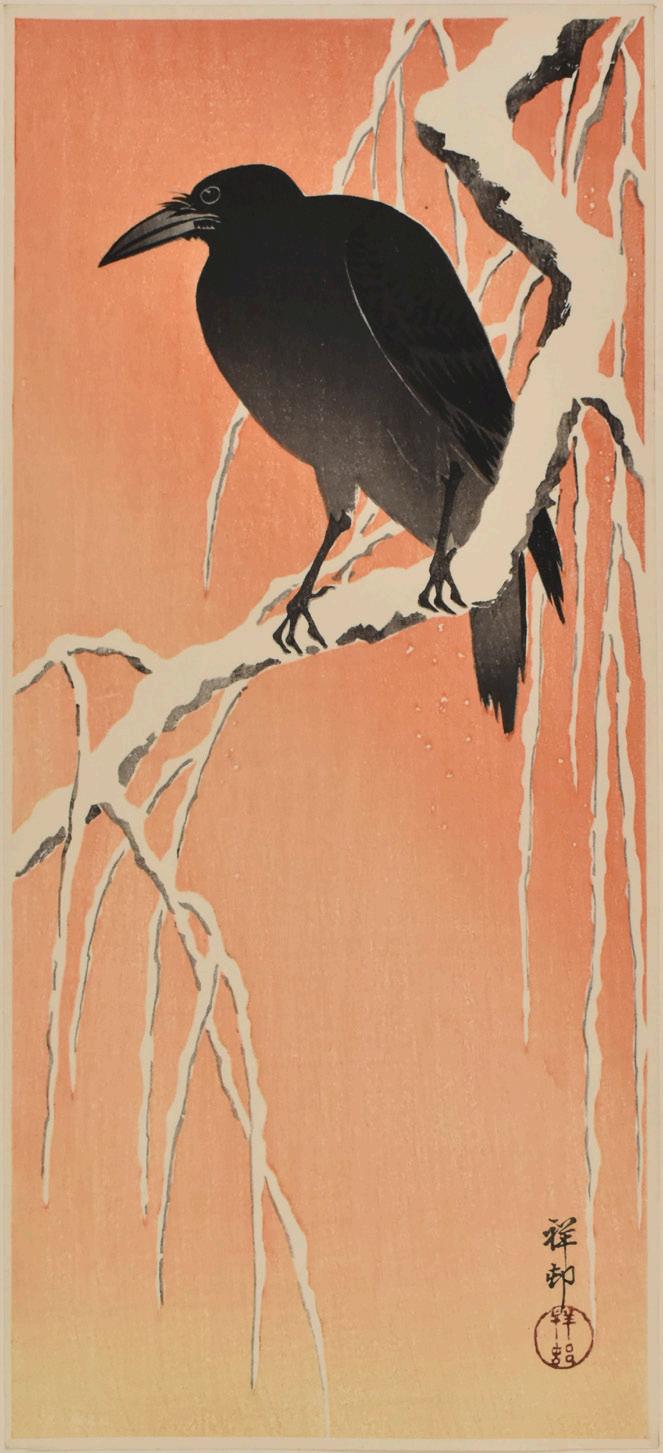
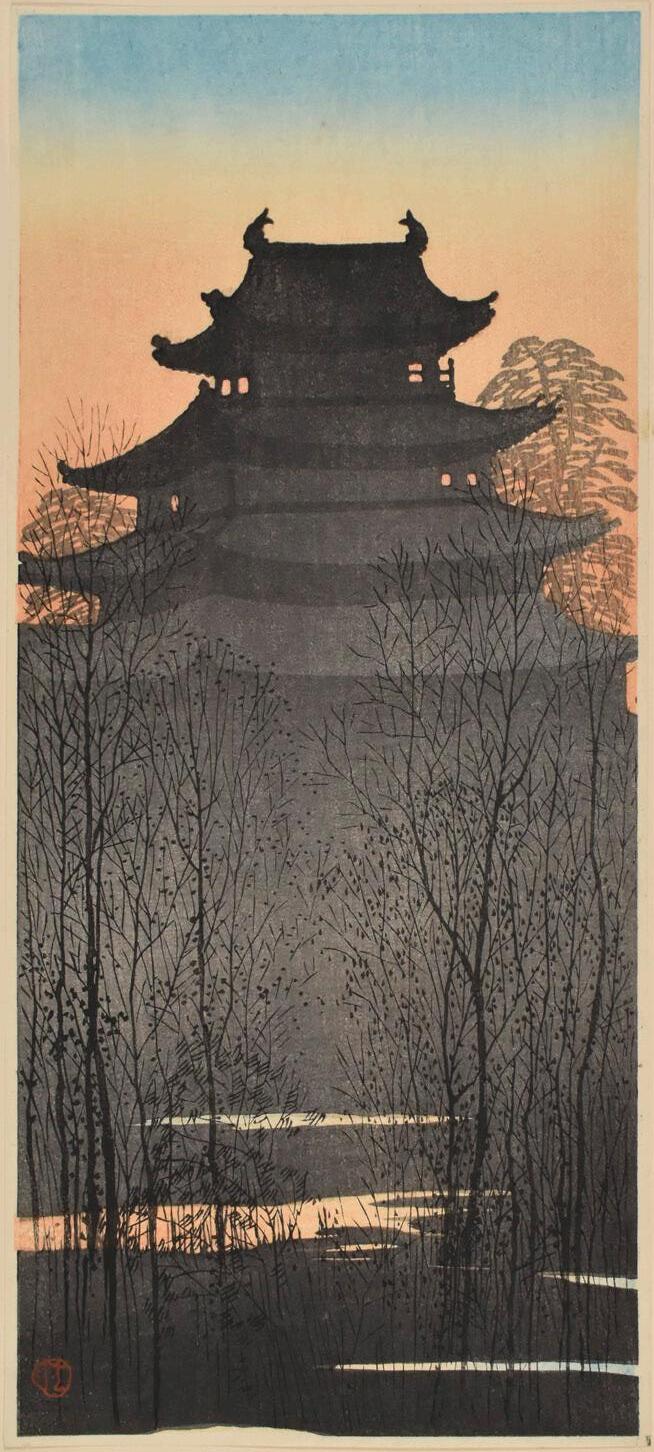
205
202
OHARA KOSON/SHOSON (1877-1945)
SHOWA ERA (1926-1989), CIRCA EARLY 1930S
A dai oban tate-e print, depicting in the foreground two women walking in a heavy snowfall huddled beneath umbrellas, and crossing Yanagibashi (The Willow Bridge) over the Sumida River in Asakusa, published by Watanabe Shozaburo, with Hanken shoyu Watanabe Shozaburo seal along the right margin, signed Shoson with a large red seal Shoson
38.4cm x 26.5cm
£1,500-2,000
Figural and landscape scenes are are relatively rare among Koson’s oeuvre. The original edition was issued by Watanabe in 1927, numbering 300 copies, but since then many editions have been issued. The seal used here dates circa 19311933.
For another impression of the same print in the collection of the Museum of Fine Arts, Boston, accession number 47.56, see: https://collectionis. mfa.org/objects/19702
203
OHARA KOSON/SHOSON (1877-1945)
TAISHO ERA (1912-1926), CIRCA 1910
An otanzakuban print: depicting a solitary egret perched on one leg on the snowcovered trunk of a willow tree, reserved against a pitch-black sky night peppered with snowflakes drifting in the background, published by Watanabe Shozaburo; signed Shoson with a large red seal Shoson
37.7cm X 17.2cm
£1,500-2,000
Universally recognised as one of the iconic images within the artist’s oeuvre, this print ranks among Koson’s most sought-after works. The distinguished Japanese print scholar Richard Illing once hailed it as a “masterpiece of graphic art”. The rare and early impression offered here is notable for its superb printing quality and remarkable preservation of colour—most strikingly, the survival of green pigment on the bird’s beak
A comparable impression of this same design is held in the collection of the Rijksmuseum, Amsterdam, (object no. RP-
P-2003-220;) another impression though lacking the vivid green on the beak—is illustrated by Amy Newland et. al., Crows, Cranes & Camellias: The Natural World of Ohara Koson 1877-1945, 2001, p.52, cat. no.156
204
OHARA KOSON/SHOSON (1877-1945)
TAISHO ERA (1912-1926), CIRCA 1920
An otanzakuban print: depicting a solitary crow perched on the snow-covered branches of a willow tree, reserved against an orange-red ground representing dawn, published by Watanabe Shozaburo; signed Shoson with a large red seal Shoson 37cm X 18cm
£800-1,200
For another impression of the same design (but comparably less well preserved), held in the collection of the Museum of Fine Arts, Boston, (accession number RES.51.143), see: https://collections.mfa. org/objects/321525



205
UEHARA KONEN (1878-1940), PROBABLY SHOWA ERA (1926-1989), EARLY 20TH CENTURY
A mitsugiriban tate-e print of Nagoyajo (Nagoya Castle), depicting a silhouette of the castle in the evening glow, publisher unknown; signed with the artist’s seal
38cm x 17cm
£600-800
Illustrated on page 97
206
YOSHIDA HIROSHI (1876-1950)
SHOWA ERA (1926-1989), DATED 1928
An oban yoko-e print, titled Sancho, Kengamine (The Summit of Kengamine) from the series Fuji jukkei (Ten Views of Mount Fuji), dated Showa 3 (1928), the English title Summit of Fujiyama, with a jizuri (self-printed) seal; signed in ink Yoshida with seal Hiroshi at the lower left, and signed in pencil in Roman script Hiroshi Yoshida, along the lower right margin
27.3cm x 41cm
£1,500-2,000
207
YOSHIDA HIROSHI (1876-1950)
SHOWA ERA (1926-1989), DATED 1930
An oban yoko-e print, titled Seto naikai shiomachi (Waiting For The Tide), from the series Seto naikai (Seto Inland Sea), dated Showa gonen saku (Work of Showa 5 [1930]), the English title Waiting for the tide with a jizuri (self-printed) seal; signed in ink Yoshida with seal Hiroshi, signed in pencil in Roman script Hiroshi Yoshida, along the lower left margin
27.2cm x 40.3cm
£1,500-2,000
208
ODA KAZUMA (1881-1956)
TAISHO ERA (1912-1926), DATED 1924
An oban yoko-e print, tilted Matsue Ohashi (the Great Bridge in Matsue), depicting a group of five figures including a vegetable seller trudging through heavy snow in the foreground, other figures walking over the bridge in the distance, dated Taisho jusannen saku (Work of Taisho 13 [1924]), published by Watanabe Shozaburo; signed Kazuma hitsu beside a circular artist ’s seal reading Oda
26cm x 38.6cm
£1,500-2,000
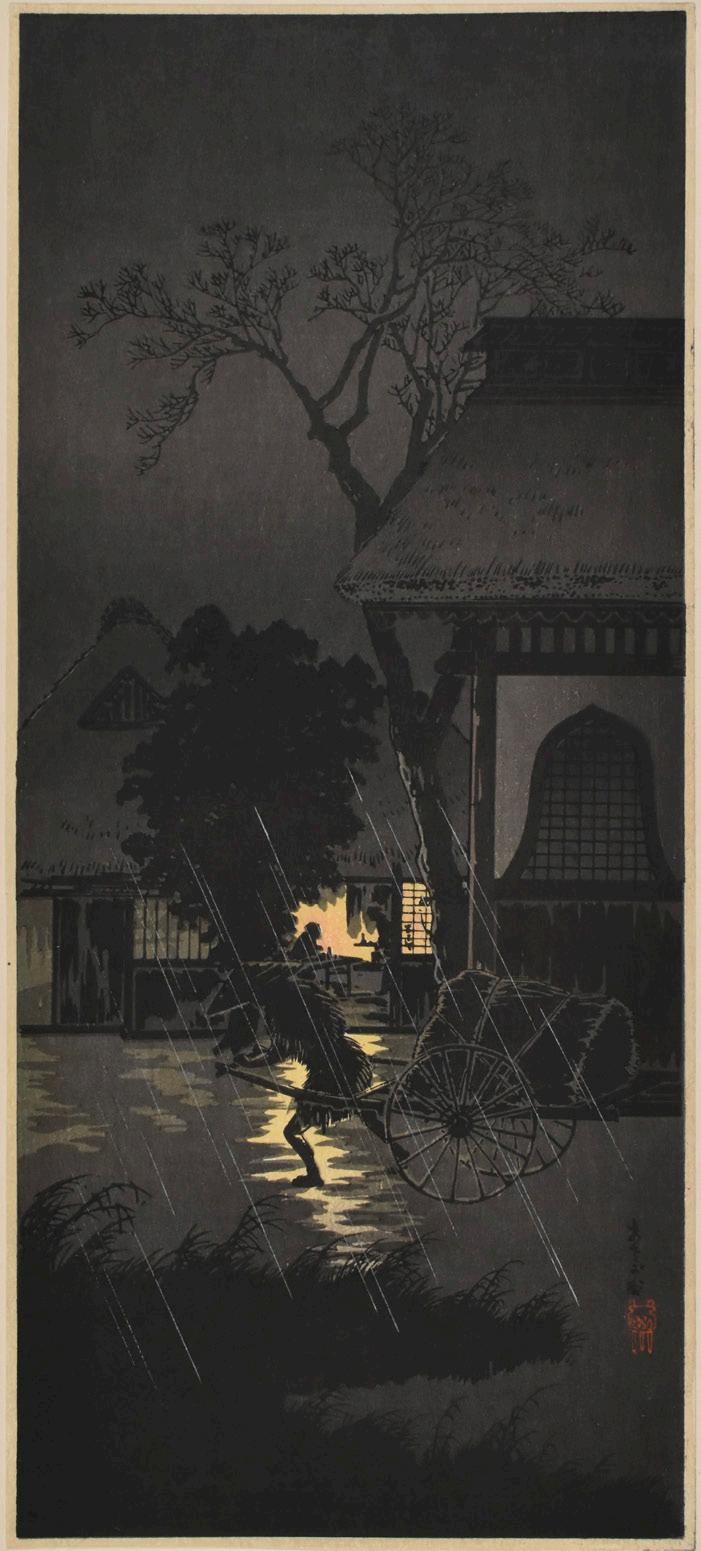


209
TAKAHASHI SHOTEI/HIROAKI (1871-1945)
TAISHO (1912-1926) OR SHOWA (1926-1989) ERA, EARLY 20TH CENTURY
A mitsugiriban tate-e print, titled Asagaya (Asagaya), depicting a wagon puller passing in front of a tea house on a dark rainy night in Asagaya, published by Watanabe Shozaburo; signed with a red pot seal Hiroaki
38cm x 17cm
£600-800
210
TAKAHASHI SHOTEI/HIROAKI (1871-1945)
TAISHO (1912-1926) OR SHOWA (1926-1989) ERA, EARLY 20TH CENTURY
A mitsugiriban tate-e print, titled Sato no aki (Village in the Autumn), depicting a mother and a child carrying a vegetable basket heading home, a tree laden with ripe red persimmons in the foreground, published by Watanabe Shozaburo; signed with a red seal Shotei
37.7cm x 17cm
£600-800
211
TAKAHASHI SHOTEI/HIROAKI (1871-1945)
TAISHO (1912-1926) OR SHOWA (1926-1989) ERA, EARLY 20TH CENTURY
A mitsugiriban tate-e print, titled Goju no to (Five-Storey Pagoda), depicting a porter or courier and two travellers walking past the tall structure in the hail storm rendered in gofun, published by Watanabe Shozaburo; signed with a rounded rectangular red seal Shotei
37.6cm x 17.2cm
£800-1,200
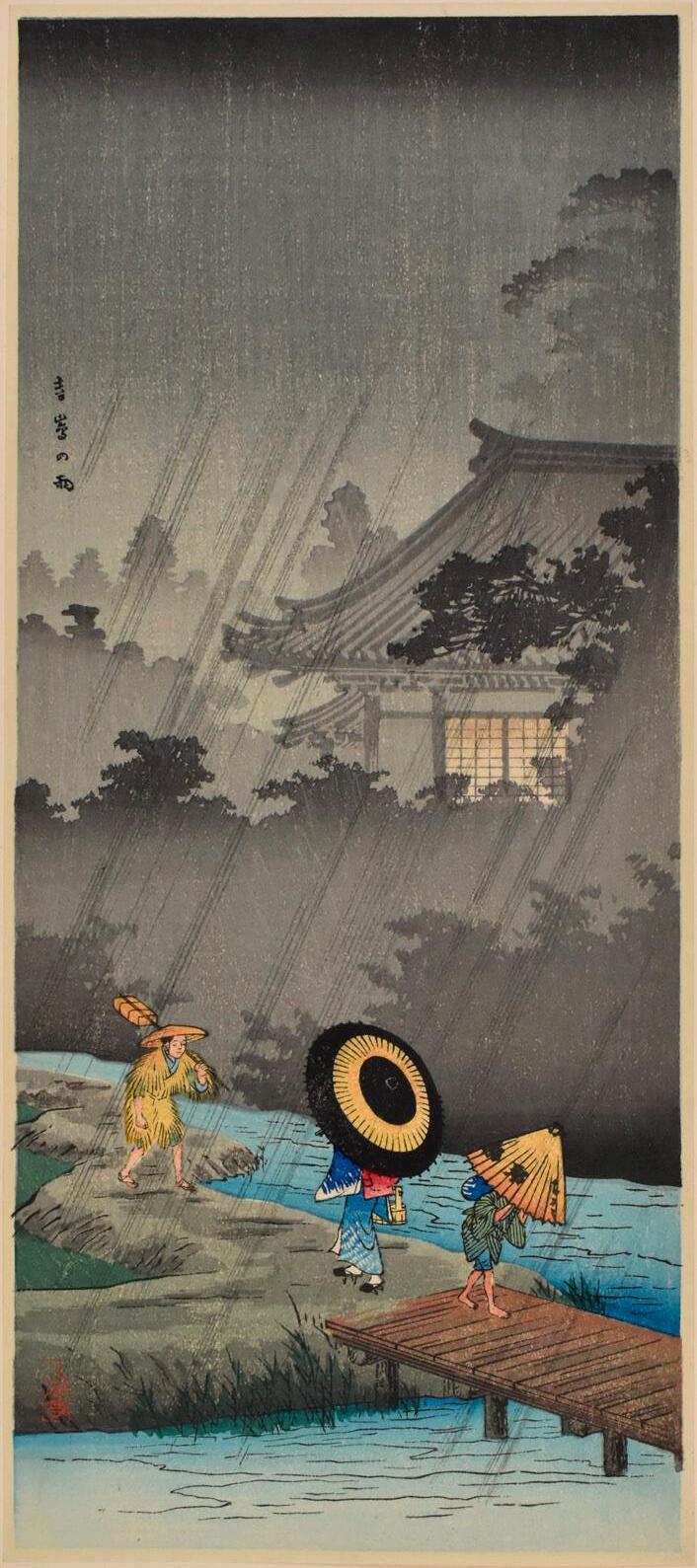

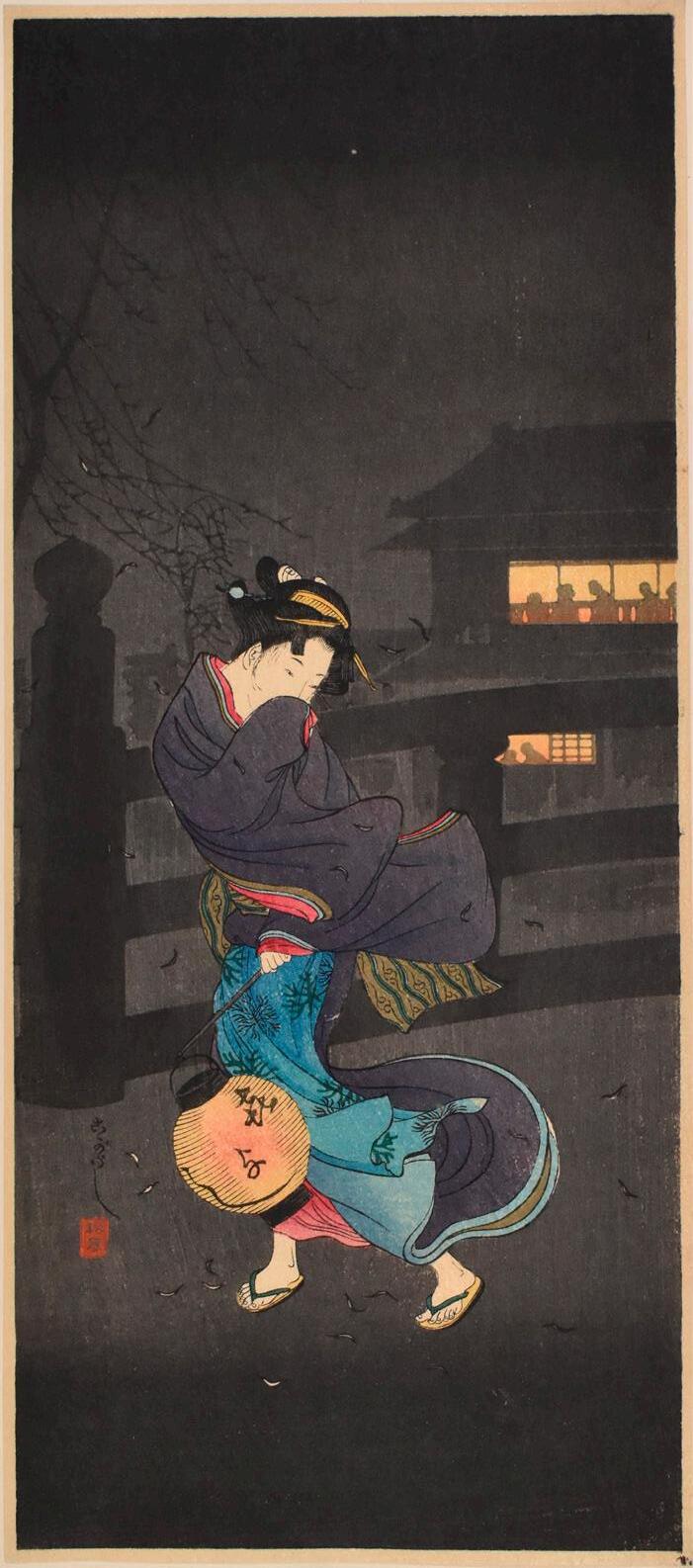
212
TAKAHASHI SHOTEI/HIROAKI (1871-1945)
TAISHO (1912-1926) OR SHOWA (1926-1989) ERA, EARLY 20TH CENTURY
A mitsugiriban tate-e print, titled Terashima no ame (Shower at Terashima), depicting three passersby walking under the torrential rain in Terashima, published by Watanabe Shozaburo; signed with a red seal Shotei
37.7cm x 16.5cm
£600-800
213
TAKAHASHI SHOTEI/HIROAKI (1871-1945)
TAISHO (1912-1926) OR SHOWA (19261989) ERA, EARLY 20TH CENTURY
A mitsugiriban tate-e print, titled Nagareyama (Nagareyama), depicting sailboats on the Tone River near Mount Nagare at sunset, published by Watanabe Shozaburo; signed with a square red seal Shotei
37.7cm x 17.2cm
£700-900
214
TAKAHASHI SHOTEI/HIROAKI (1871-1945)
TAISHO (1912-1926) OR SHOWA (1926-1989) ERA, EARLY 20TH CENTURY
A mitsugiriban tate-e print, titled Kogarashi (Cold Winter Wind), depicting a geisha walking with a lantern on a cold windy night, the silhouettes of revellers visible from the restaurant on the opposite riverbank, published by Watanabe Shozaburo; signed with a red seal Shotei
37.6cm x 16.8 cm
£600-800

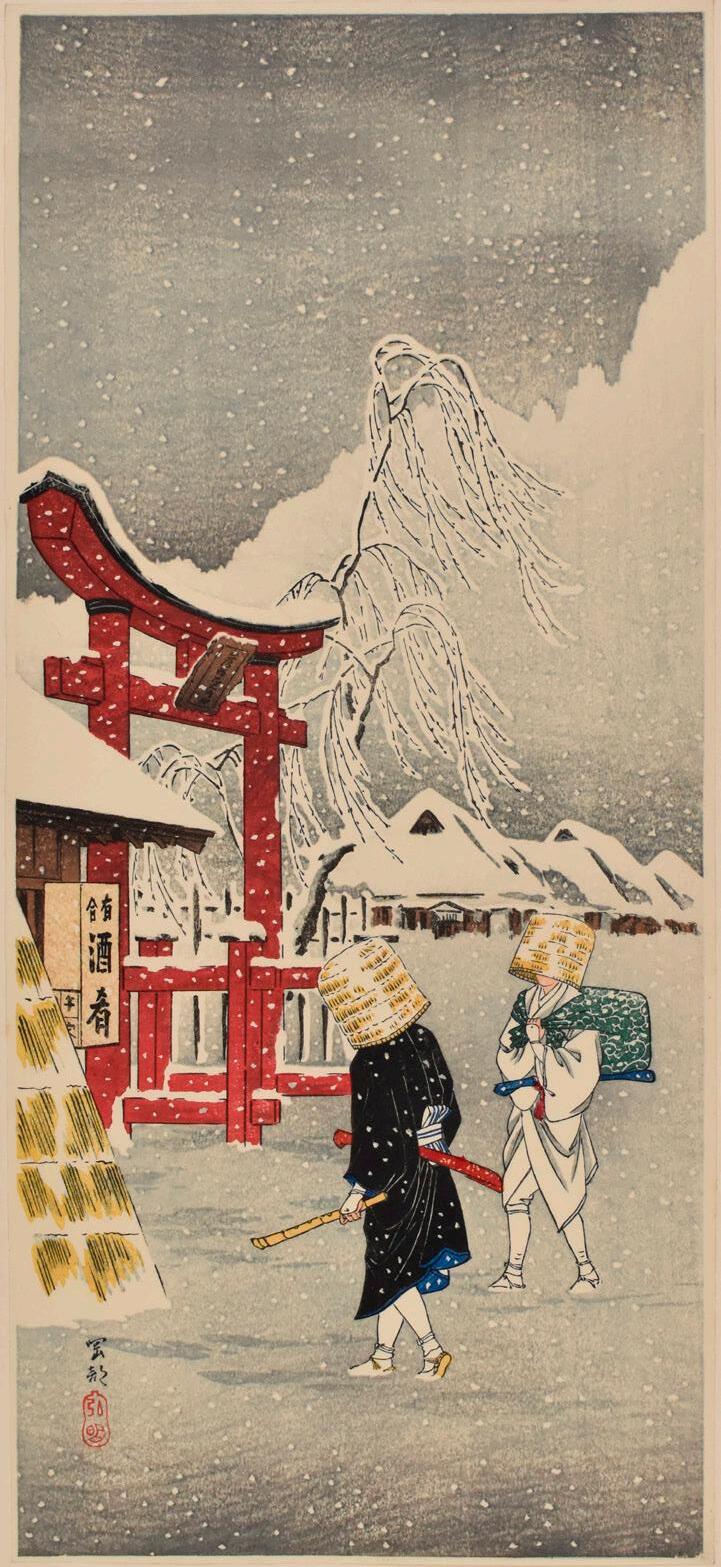

215
TAKAHASHI SHOTEI/HIROAKI (1871-1945)
TAISHO (1912-1926) OR SHOWA (1926-1989) ERA, EARLY 20TH CENTURY
A mitsugiriban tate-e print, titled Haru no yoi (Spring Evening), depicting a female figure walking in a misty spring evening, carrying a large lacquer box hanging from her left shoulder and holding a lantern with her left hand, published by Watanabe Shozaburo; signed with a red seal Shotei
37.5cm x 17cm
£600-800
216
TAKAHASHI SHOTEI/HIROAKI (1871-1945)
TAISHO (1912-1926) OR SHOWA (1926-1989) ERA, EARLY 20TH CENTURY
A mitsugiriban tate-e print, titled Okabe (Okabe), depicting two komuso (mendicant Zen monks) walking towards a restaurant/ inn in the snow at Okabe, one holding a shakuhachi in his hand, the snow-laden red torii gate standing behind, published by Watanabe Shozaburo; signed with a red double-gourd seal Hiroaki
37.7cm x 17cm
£800-1,000
217
TAKAHASHI SHOTEI/HIROAKI (1871-1945)
TAISHO (1912-1926) OR SHOWA (1926-1989) ERA, EARLY 20TH CENTURY
A mitsugiriban tate-e print, titled Shuu (Sudden Shower), depicting people caught in a sudden shower attempting to find shelter near a bridge, published by Watanabe Shozaburo; signed with a red double-gourd seal Hiroaki
38cm x 17cm
£600-800

TAKAHASHI SHOTEI/HIROAKI (1871-1945)
TAISHO (1912-1926) OR SHOWA (1926-1989) ERA, EARLY 20TH CENTURY
A chuban yoko-e aizuri-e print, titled Naganuma no tsuki (Moon at Naganuma), depicting a nighttime scene with a silhouetted village and a large moon, published by Watanabe Shozaburo; signed with a red square seal Shotei
16cm x 25.2cm
£600-800
219
UTAGAWA HIROSHIGE IV (1849-1925)
OR ARAI YOSHIMUNE II (1863-1941)
TAISHO (1912-1926) OR SHOWA (1926-1989) ERA, EARLY 20TH CENTURY
An otanzakuban tate-e print of Suma Beach at night, depicting a labourer collecting seawater for processing into salt, walking along the shore with buckets over his shoulder, with a full moon glowing in the distance; signed Hiroshige ga
36.8cm x 16.5cm
£300-500
To be sold without reserve
220
ITO SOZAN (1884-?)
PROBABLY SHOWA ERA (1926-1989), EARLY 20TH CENTURY
An otanzakuban tate-e print, depicting a night scene with a group of fireflies glowing in the dark against a background of tall reeds, published by Watanabe Shozaburo; signed Sozan with a seal Sozan
37.8 ccm x 16.5 cm
£300-500
To be sold without reserve
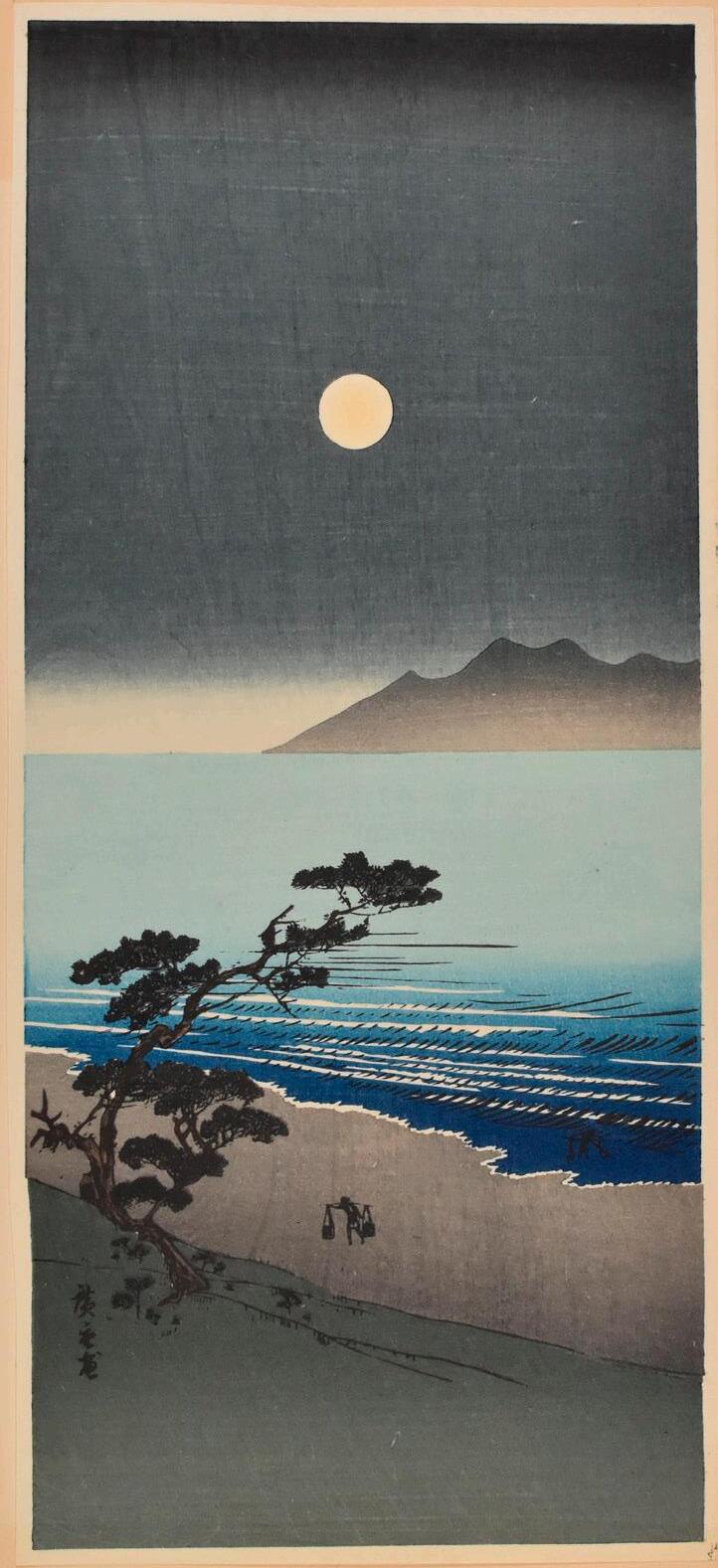
219
221
ITO SOZAN (1884-?)
PROBABLY SHOWA ERA (1926-1989), EARLY 20TH CENTURY
An otanzakuban tate-e print, depicting a pair of wild geese standing in a marshland with reeds, looking up, as if watching the full moon through the evening mist, published by Watanabe Shozaburo; signed Sozan with a seal Sozan
38cm x 17cm
£300-500
To be sold without reserve
222
ITO SOZAN (1884-?)
PROBABLY SHOWA ERA (1926-1989), EARLY 20TH CENTURY
An otanzakuban tate-e print, depicting a white egret perched on the large branch of a wind-swept willow tree on a stormy day, published by Watanabe Shozaburo; signed Sozan with a seal Sozan
38cm x 17cm
£300-500
To be sold without reserve
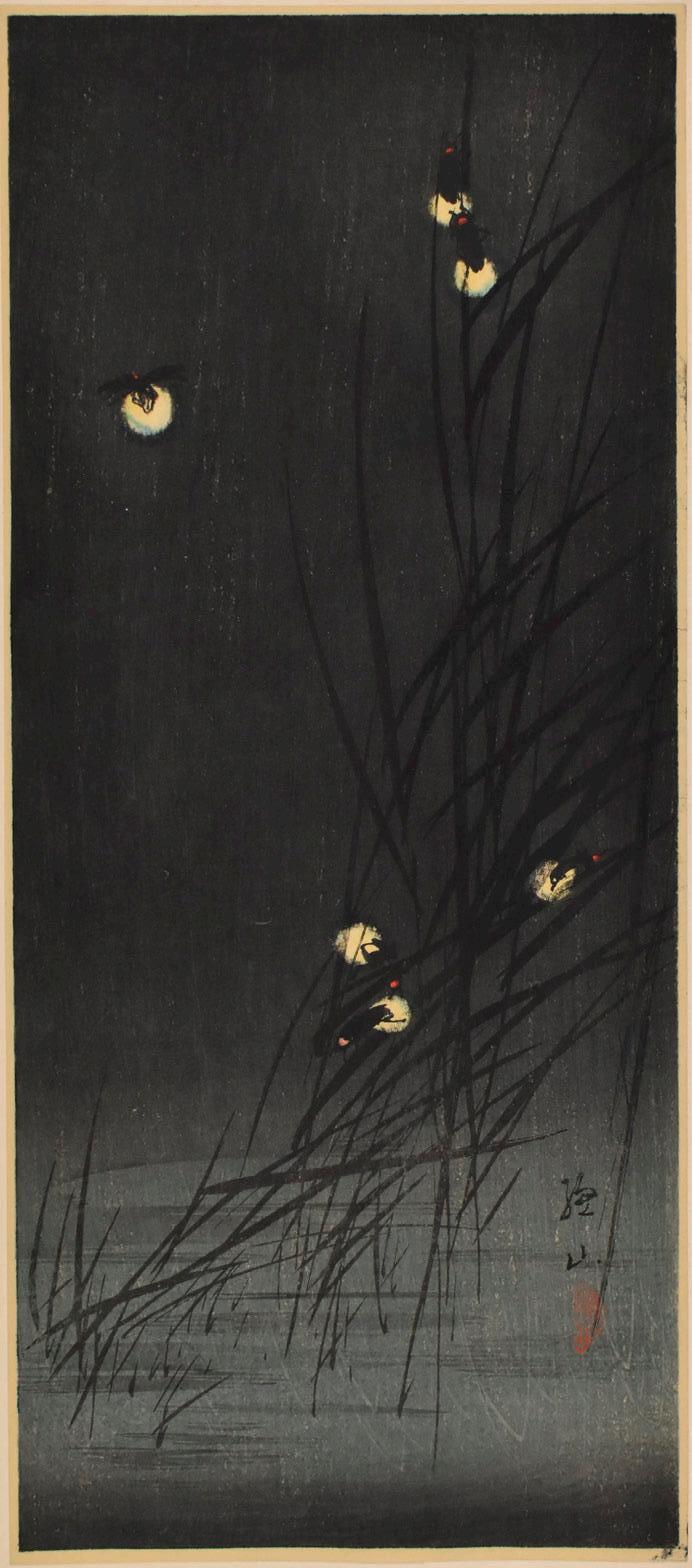
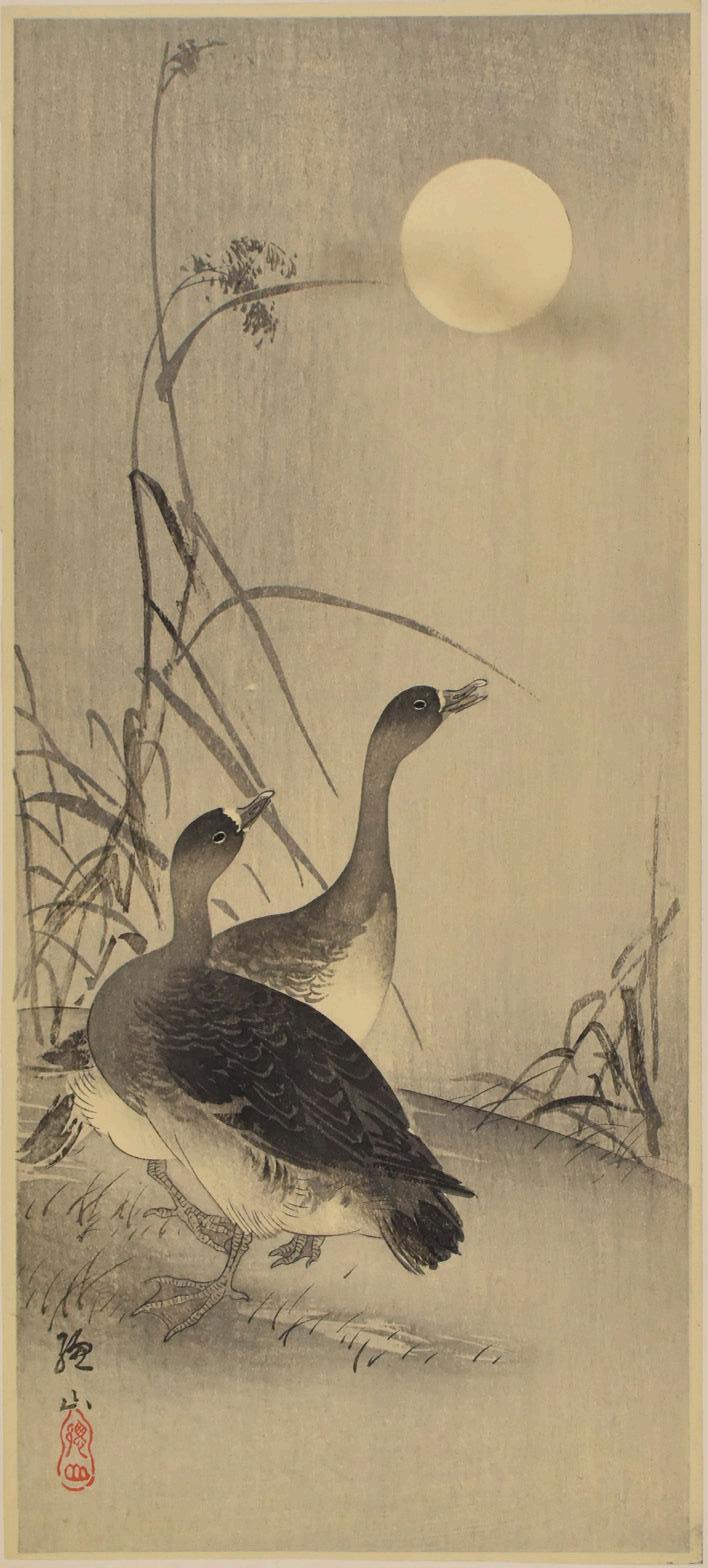
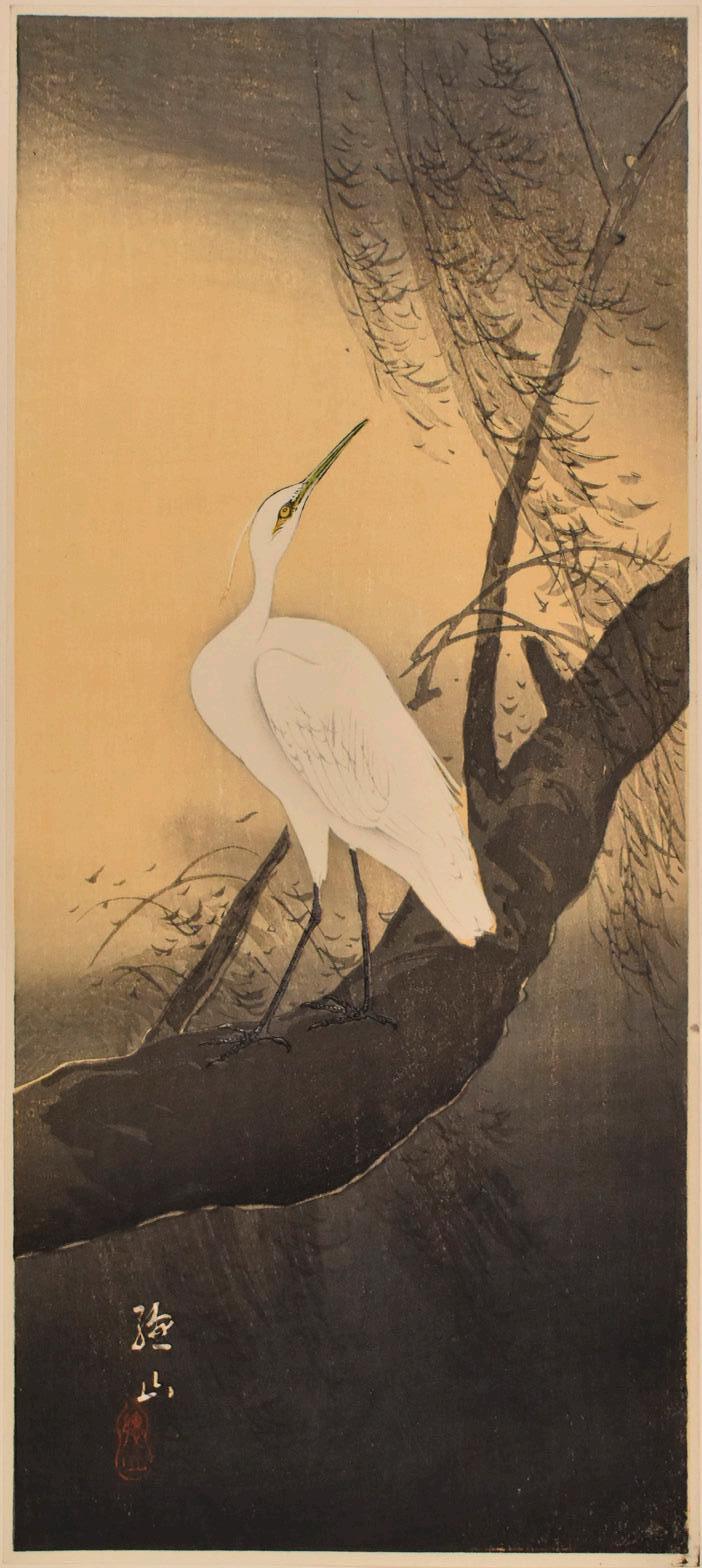
223
K. HAYASHI (DATES UNKNOWN)
MEIJI (1868-1912) OR TAISHO (1912-1926) ERA, EARLY 20TH CENTURY
Two etchings with dry point on paper depicting famous places in Kyoto, comprising: Kyoto Chion’in (Chion’in Gate, Koto), overall: 36.7cm x 30.7cm; the plate: 20.5cm x 17.5cm and Kyoto Kiyomizudera (Kiyomizu Temple, Kyoto), overall: 36.5cm x 31cm; the plate: 22.5cm x 18.5cm; both signed in Roman script K. Hayashi in pencil, with a red square seal Kan (2)
£300-500
To be sold without reserve

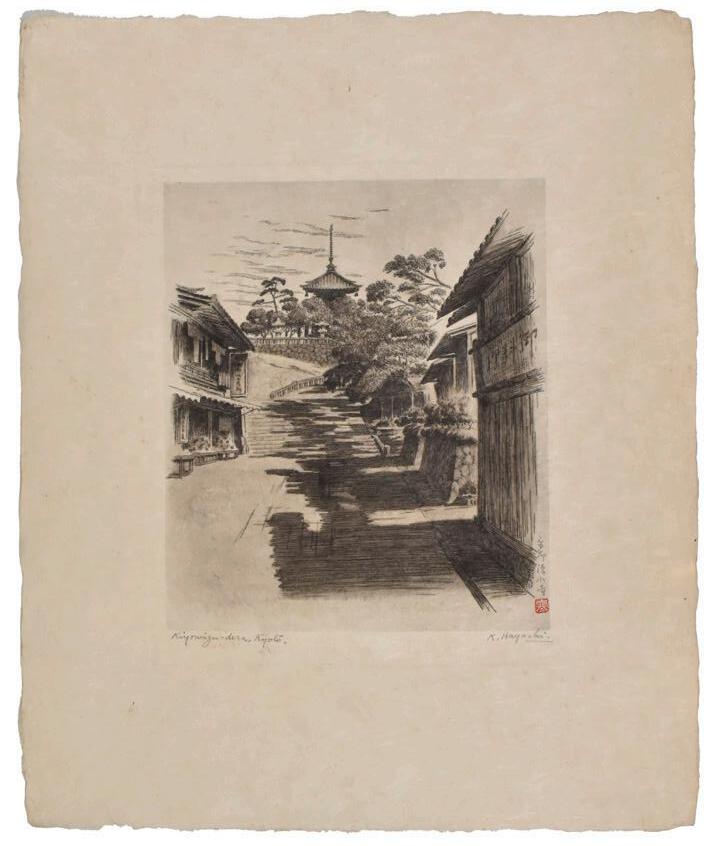
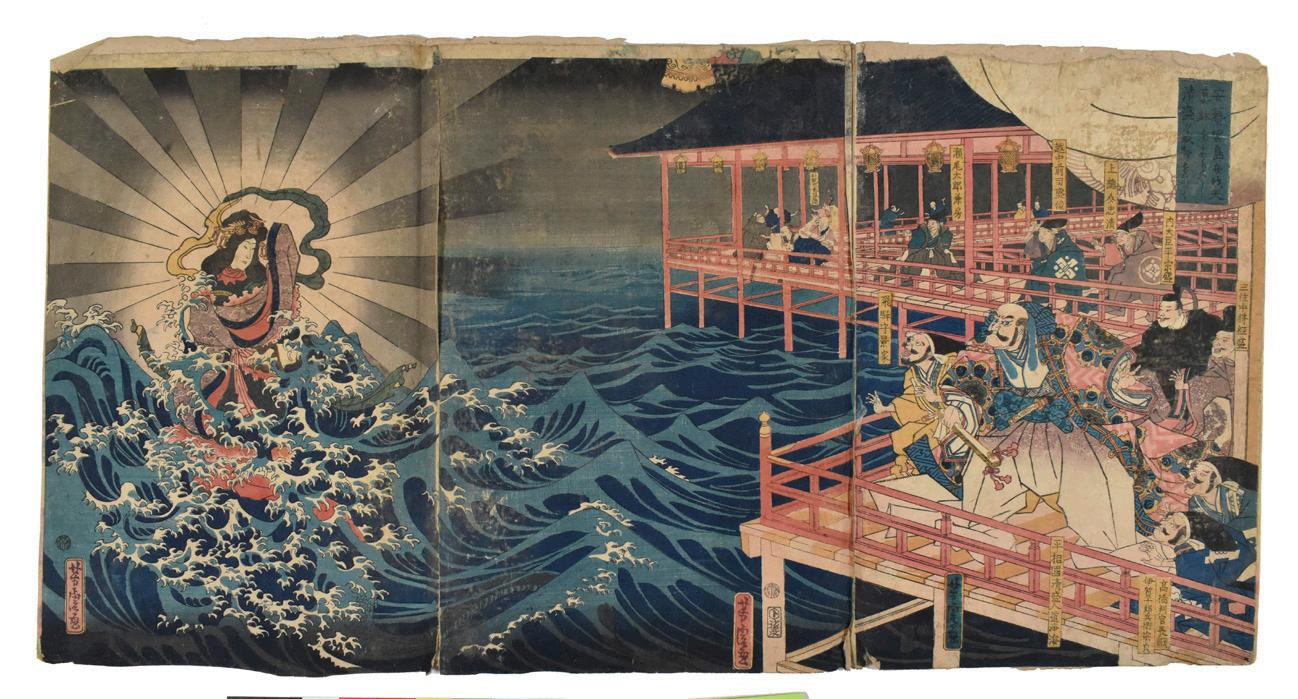

224
SUZUKI HARUNOBU (1725-1770), UTAGAWA HIROSHIGE (1797-1858), UTAGAWA TOYOKUNI (1769-1825), UTAGAWA KUNISADA (UTAGAWA TOYOKUNI III, 1786-1865), UTAGAWA KUNIYOSHI (1797-1861), UTAGAWA YOSHITORA (ACTIVE CIRCA 1836-1887), AND OTHERS, EDO PERIOD (1615-1868) TO MEIJI ERA (1868-1912), MID-18TH TO EARLY 20TH CENTURY
25 prints and three triptych prints of various sizes, formats, and subject matter by various artists, comprising: 13 prints and one triptych print of bijin-ga, consisting of two chuban by Harunobu from the series Keisei mugen no kane, one oban from the series Omi hakkei (Eight Views of Omi) and one oban tate-e triptych titled Gotenyama hanami no zu (Cherry Blossom Viewing at Gotenyama) by Hiroshige, and 10 additional oban by Kunisada, Eizan, Eisen, and others; two oban tate-e triptych prints and two oban prints of musha-e by Kuniyoshi and Yoshitora, including a triptych titled Aki Miyajima Benzaiten shintai o arawashi Kiyomori ga isei o kujiku (Benzaiten of Miyajima Appearing and Overpowering Taira no Kiyomori [1118-1181]) by Yoshitora and one oban tate-e from the series Date moyo kekki kurabe (Comparisons of Physical Energy, Date Style) by Kuniyoshi; six oban actor prints by Toyokuni, Kunisada, and Kuniyoshi, the majority incomplete sheets from triptychs; four additional miscellaneous prints of various formats and subjects, including a facsimile; all variously published and variously signed, some unsigned (30)
The smallest: 34cm x 6.5cm; the largest: 37cm x 73.5cm
£800-£1,000
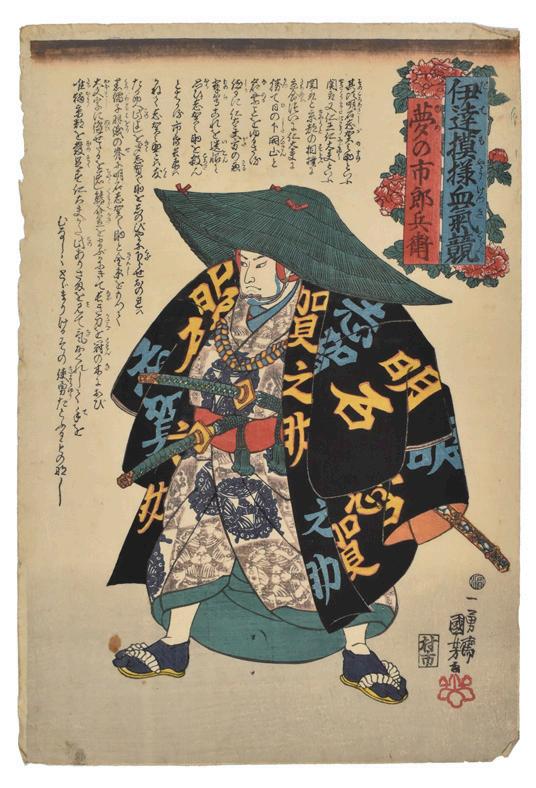
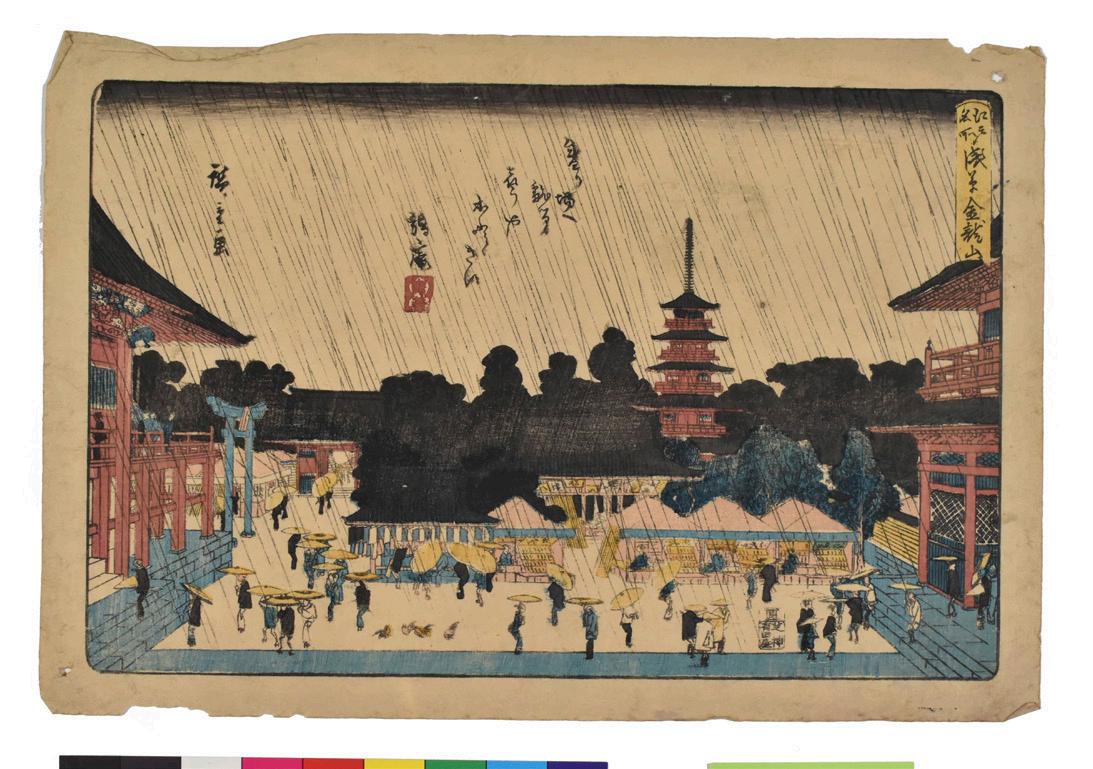
225
UTAGAWA HIROSHIGE (1797-1858), UTAGAWA HIROSHIGE II (1826-1869), UTAGAWA HIROSHIGE III (1842-1894), AND UTAGAWA YOSHIKAZU (ACTIVE CIRCA 1850-1870)
EDO PERIOD (1615-1868) AND MEIJI ERA (1868-1912), 19TH/EARLY 20TH CENTURY
Eight oban yoko-e prints, one oban tate-e triptych print, one tate-e diptych (two incomplete sheets from a triptych) print, and one aitanzakuban print, all depicting landscapes of Edo or Tokyo, comprising: four oban and one aitanzakuban by Hiroshige, mostly from the various Edo meisho (Famous Places in Edo) series; two oban by/attributed to Hiroshige II from the series Toto meisho (Famous Places in the Eastern Capital) and Edo meisho (Famous Places in Edo); two oban by Yoshikazu, both from the series Toto meisho (Famous Places in the Eastern Capital); one triptych and one diptych of kaika-e by Hiroshige III, showing and celebrating the Westernisation of Tokyo; all variously published and variously signed (14)
The smallest: 33cm x 11cm; the largest: 37.5cm x 25.3cm
£300-500
To be sold without reserve

226
AFTER UTAGAWA HIROSHIGE (1797-1858),
PROBABLY SHOWA ERA (1926-1989), 20TH CENTURY
Five oban reproduction prints, comprising: one tate-e of Ohashi atake no yudachi (Sudden Shower over the Ohashi Bridge); two yoko-e of Shono and Kameyama from the series Tokaido gojusantsugi (53 Stations of the Tokaido Road); one yoko-e of Arashiyama manka (Cherry Tree in Full Blossom at Arashiyama) from the series Kyoto meisho (Famous Views of Kyoto); and one yoko-e of Seba from the series Kisokaido rokujukyutsugi (69 Stations of the Kisokaido Road); all variously published, one with a round Watanabe seal; all inscribed Hiroshige ga (5)
The smallest: 37cm x 24.5cm; the largest: 37.7cm x 25.5cm
£200-300
To be sold without reserve
227
AFTER KITAGAWA UTAMARO (1753-1806), AFTER KATSUSHIKA HOKUSAI (1760-1849), AND AFTER UTAGAWA HIROSHIGE (1797-1858)
PROBABLY SHOWA ERA (1926-1989), 20TH CENTURY
Five oban reproduction prints after three ukiyo-e masters, comprising: a yoko-e of Kanagawa oki namiura (Under the Wave off Kanagawa) from the series Fugaku sanjurokkei (36 Views of Mount Fuji) after Hokusai; two yoko-e prints of Yui and Kambara from the series Tokaido gojusantsugi (53 Stations of the Tokaido Road) after Hiroshige; and two tate-e bijinga after Utamaro; all variously published, two with a round Watanabe seal; all variously inscribed (5)
The smallest: 25.2cm x 38cm; the largest: 25.7cm x 38.5cm
£200-300
To be sold without reserve
228
AFTER KATSUSHIKA HOKUSAI (1760-1849), AFTER RYURYUKYO SHINSAI (1764?-1820), AND AFTER YANAGAWA SHIGENOBU (17871832), MEIJI ERA (1868-1912), CIRCA 1890S
Three facsimiles of shikishiban surimono, comprising: one depicting precious crystals and a sickle after Hokusai: one of a monkey costumed for a new year’s dance after Shinsai, and one of a beauty and her male attendant after Shigenobu, all variously inscribed (3)
Each approx., 20.3cm x 17.8cm
£150-200
To be sold without reserve
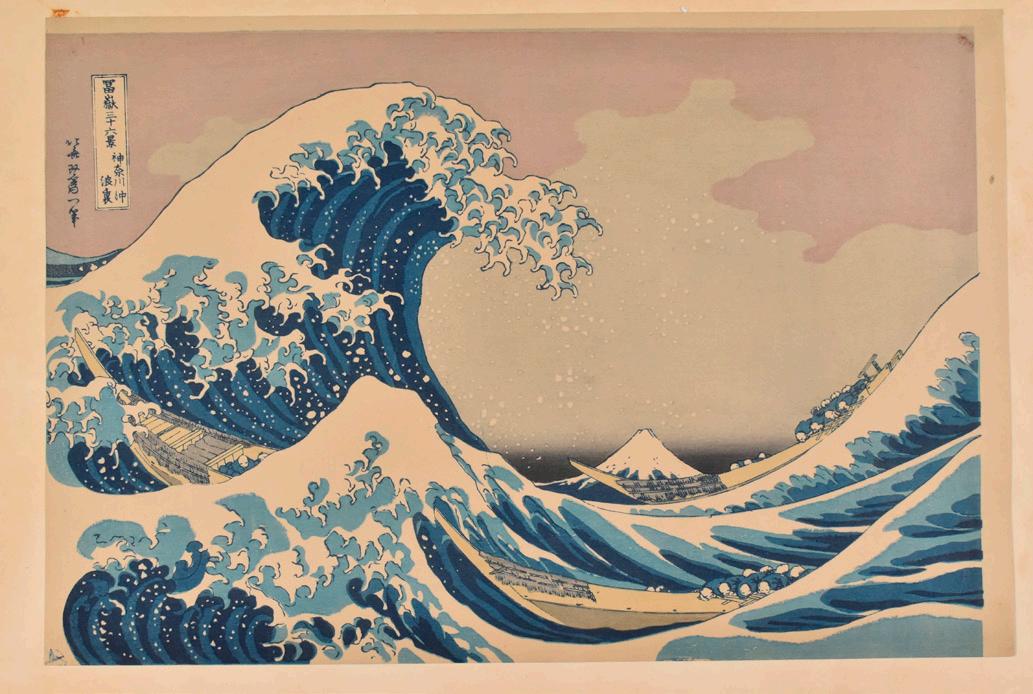
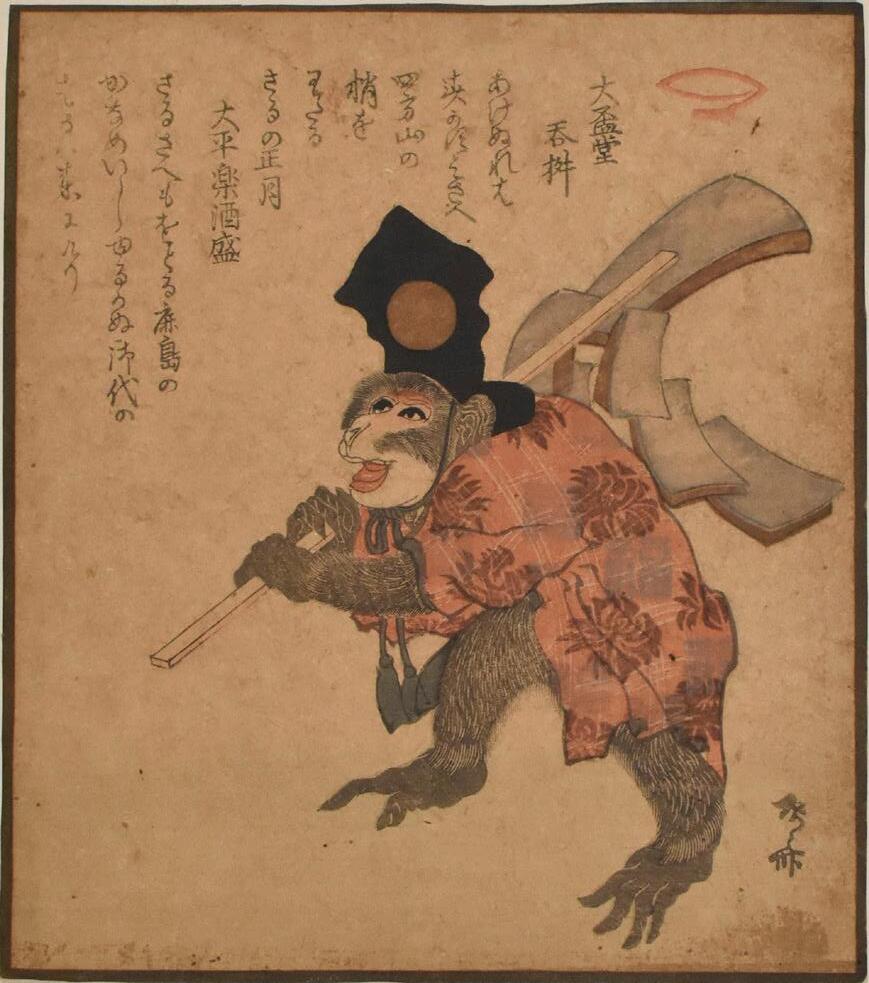
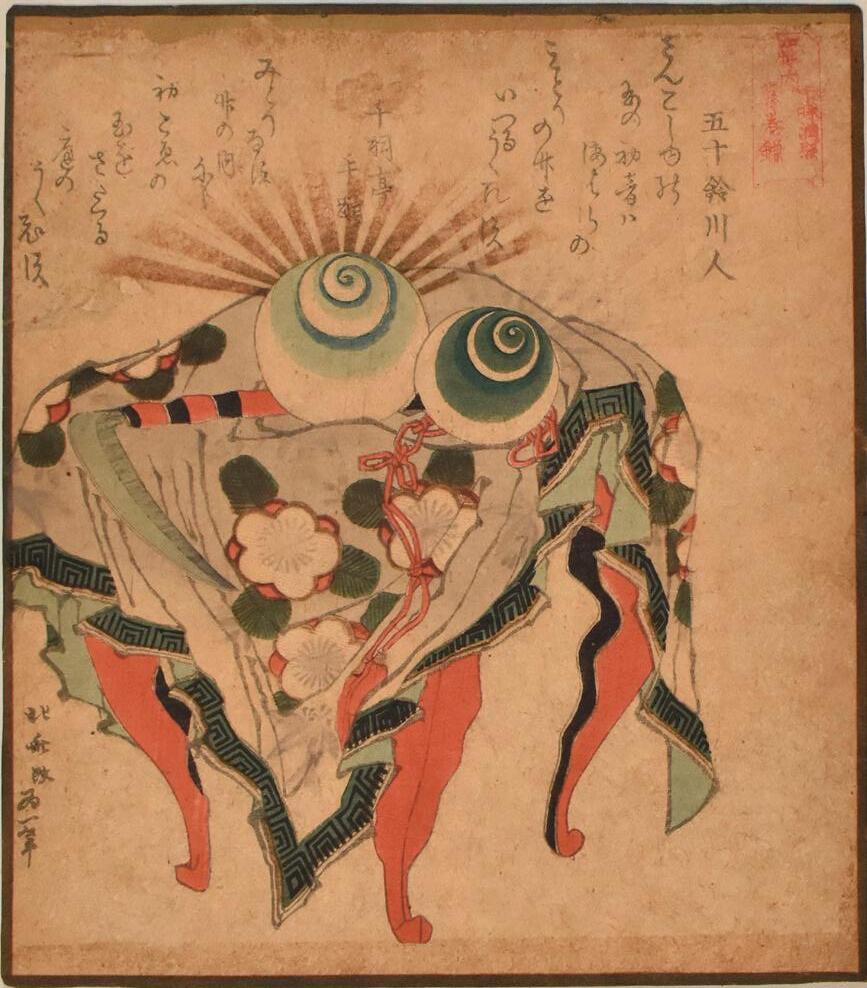



Front row, from left to right:
1) The artist Kawase Hasui (1883-1957)
2) Clara Ruth Kawase (née Greenfield, 1892-1941), Hasui’s sister-in-law
3) Kasuke Kawase (1889-1957), Hasui’s younger brother
4) Kathleen Hana Kawase (1926-2019), Hasui’s niece
5) Mume (Umeyo) Kawase (1898-1986), Hasui’s wife.
6) Naka Shimaoka (née Kawase, 1879-1946), Hasui’s sister
The Kawase Family Collection of Prints by Kawase Hasui (Lots 229-233)
An oban tate-e print titled along the left margin Urabandai Aonuma no asa (Morning at Ao Marsh, Ura Heights), depicting a rustic hut nestled among trees resplendent in autumn colours reflected in the water, dated Showa nijuyonen saku (Work of Showa 24 [1949]), published by Watanabe Shozaburo, with a round Watanabe seal at bottom right corner; signed Hasui with Kawase seal
39cm x 26.5cm
Compare with a similar impression in the collection of Ota City Folk Museum, see exhibition catalogue, Ota City Folk Museum, Hasui, Tokyo, 2021, p.246, no.355; and another identical but faded impression in the collection of the Art Institute of Chicago, reference number: 1990.607.584
£3,000-5,000
Provenance:
A gift from the artist to his niece Kathleen Hana Kawase (1926-2019), the daughter of Kasuke Kawase (18891957), Hasui’s younger brother, and thence by descent.

KAWASE HASUI (1883-1957)
TAISHO ERA (1912-1926), DATED 1922
An aiban tate-e print titled along the left margin Okayama-jo (Okayama Castle) from the series Nihon fukei senshu (Selected Views of Japan), depicting the black structure of the donjon of Okayama Castle, nicknamed the ‘Crow’s Castle’ rising discreetly over trees as three rowers pole in unison along the calm Asahi River, dated Taisho juichinen saku (Work of Taisho 11 [1922]), published by Watanabe Shozaburo, with a round Watanabe seal at the middle lower left, numbered on verso in ink within a red stamp Sanbyakumai kagiri zeppan, dai yonjukyu ban (49 of a limited edition of 300); signed Hasui with Kawase seal
31cm x 23cm
£15,000-20,000
A scarce pre-earthquake design, for a comparable impression where the publisher’s seal is rubbed in the Rene and Carolyn Balcer Collection, see Kendall Brown, Water and Shadow, Kawase Hasui and Japanese Landscapes, exhibition catalogue, Richmond, Virginia, Virginia Museum of Fine Arts, 2014, plate IV:91; see another impression in the collection of the Museum of Fine Arts, Boston, accession number: 35.1909; a third impression is in the collection of the British Museum, number 1929,0731,0.21, currently on display in The Mitsubishi Corporation Galleries
Provenance:
A gift from the artist to his niece Kathleen Hana Kawase (1926-2019), the daughter of Kasuke Kawase (1889-1957), Hasui’s younger brother, and thence by descent

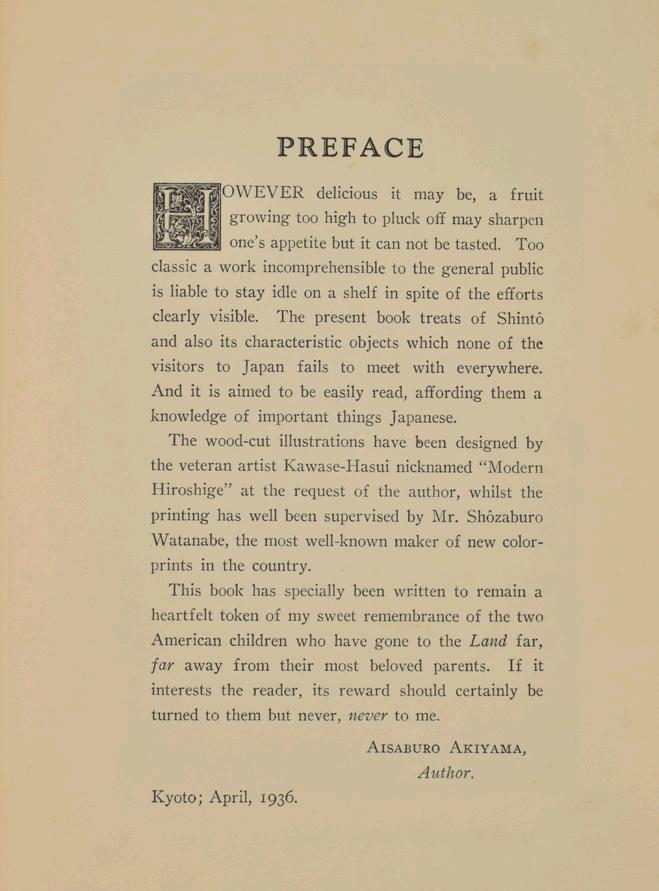

231

AKIYAMA AISABURO, THE AUTHOR (ACTIVE CIRCA 1916-1940) AND KAWASE HASUI (1883-1957), THE ARTIST, PRINTS SUPERVISED BY WATANABE SHOZABURO (1885-1962)
SHINTO AND ITS ARCHITECTURE
SHOWA PERIOD (1926-1989), DATED 1936
English text, comprising twelve tipped-in original ‘post-card’ sized woodblock prints depicting different shrines by Hasui; black-and-white line illustrations, black-and-white photographs, published by Kinki Kanko Kyokai, Kyoto in 1936, first edition with its original sleeve, the inside with a dated, dedicatory handwritten note by the artist reading: Tei Kawase Hanako kun Showa juichinen gogatsu, Kawase Hasui (gift to Miss Kawase Hanako, May, Showa 11 [1936], Kawase Hasui)
The book: 26cm x 18.5cm
Each print approx.18.7cm x 12.8cm
£2,500-3,500
Compare with another first edition copy in the collection of Ota City Folk Museum, see exhibition catalogue, Ota City Folk Museum, Hasui, Tokyo, 2021, pp.210-211; for an example of the second edition in the collection of the British Museum, museum no: 2003,0315,0.1, see: www.britishmuseum.org/collection/object/A_2003-0315-0-1
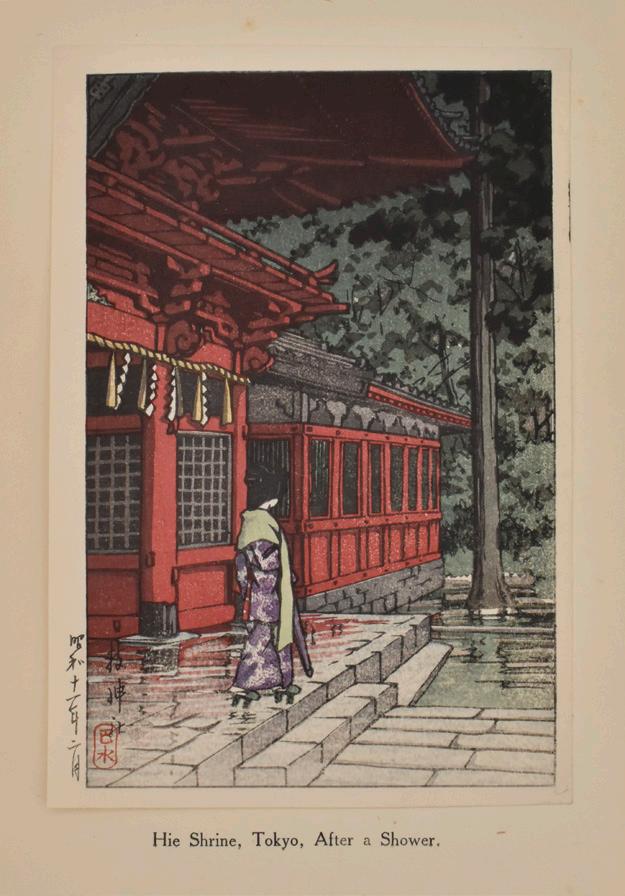


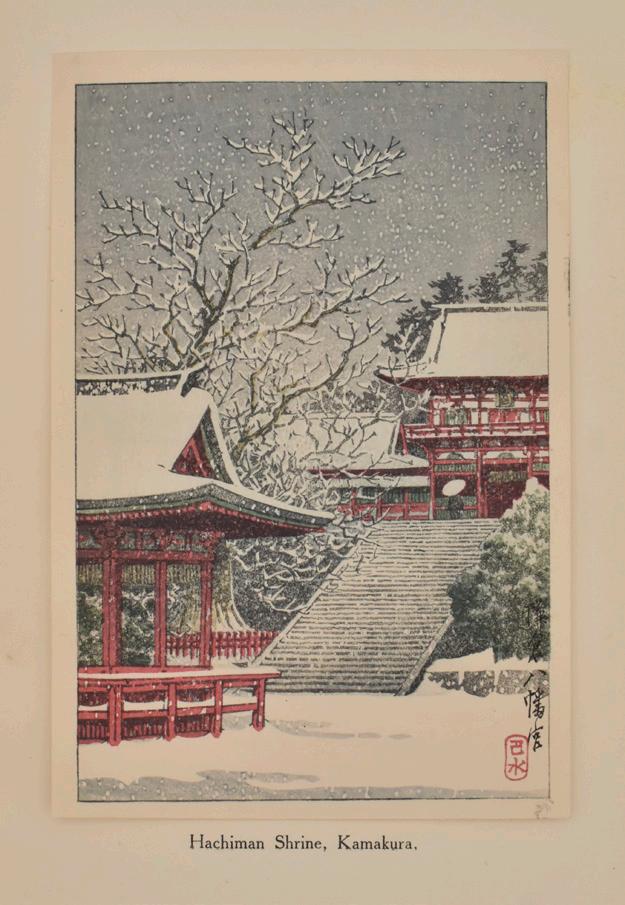
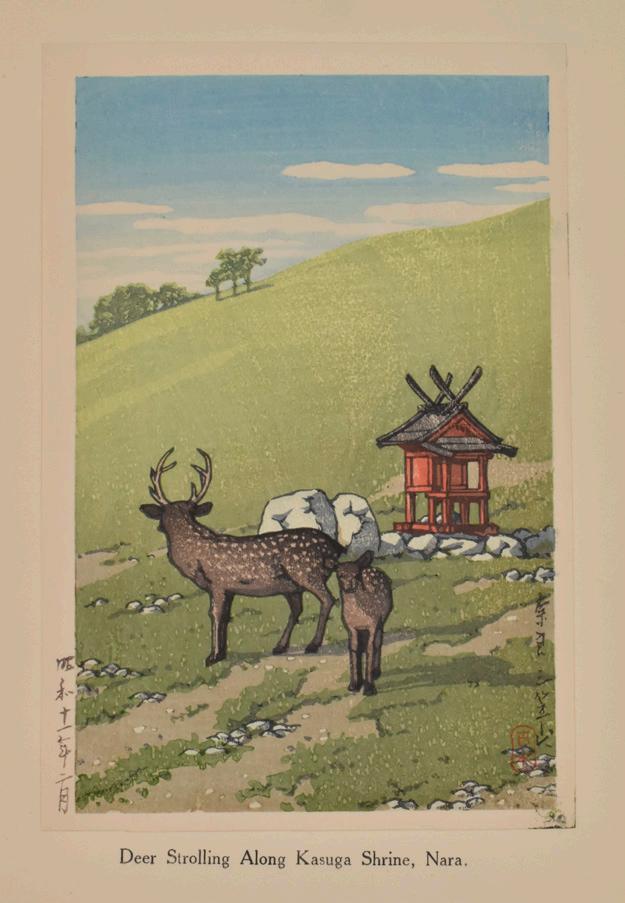
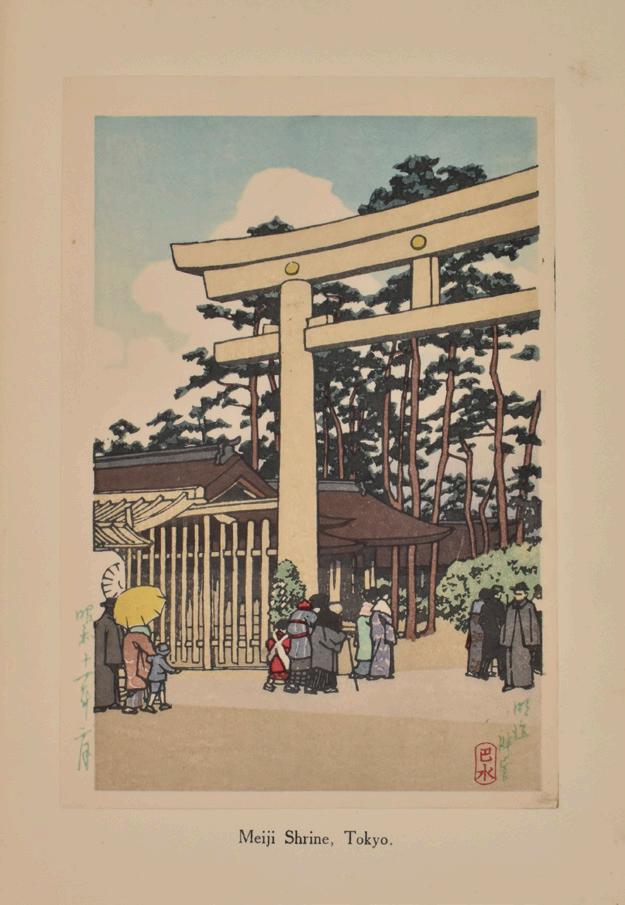
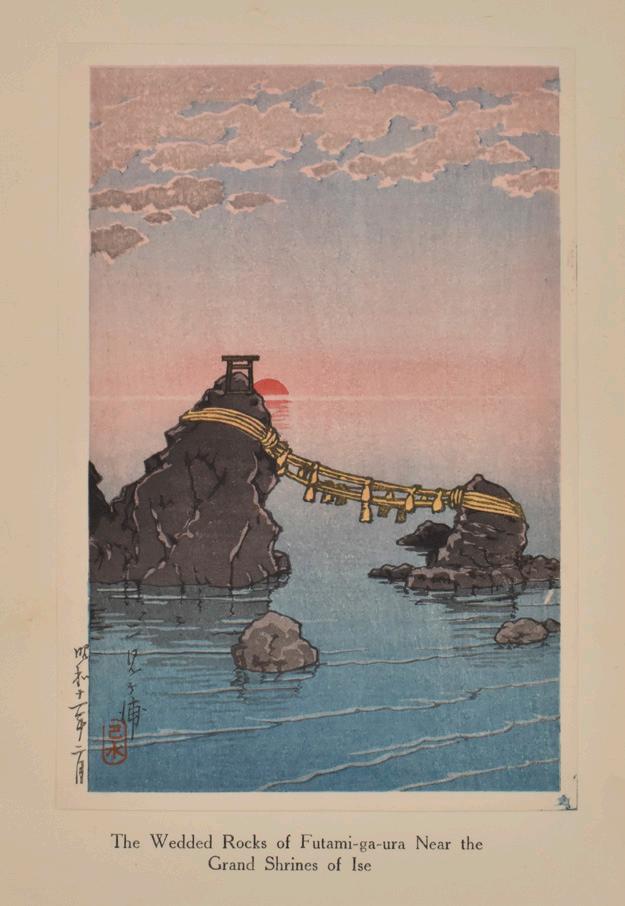
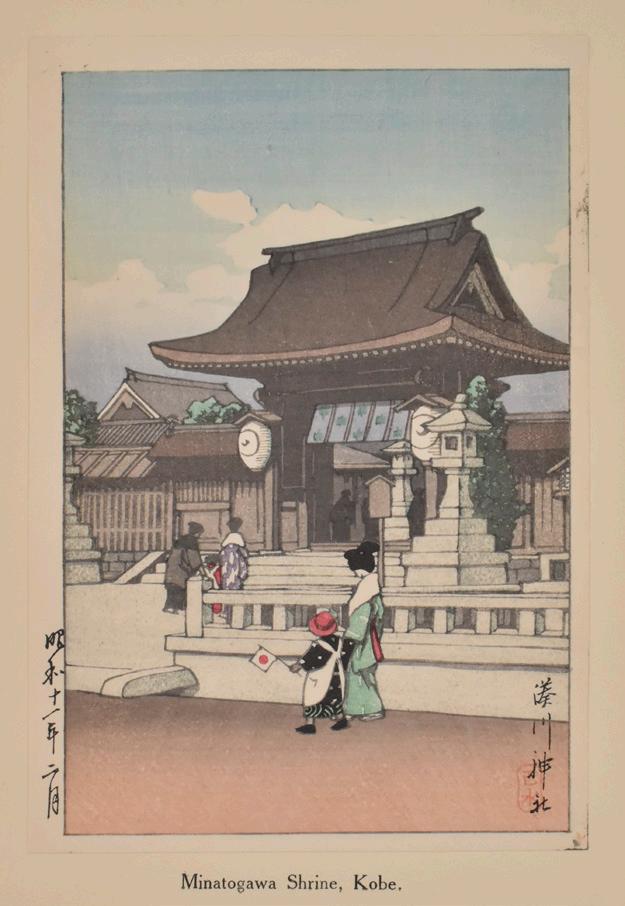

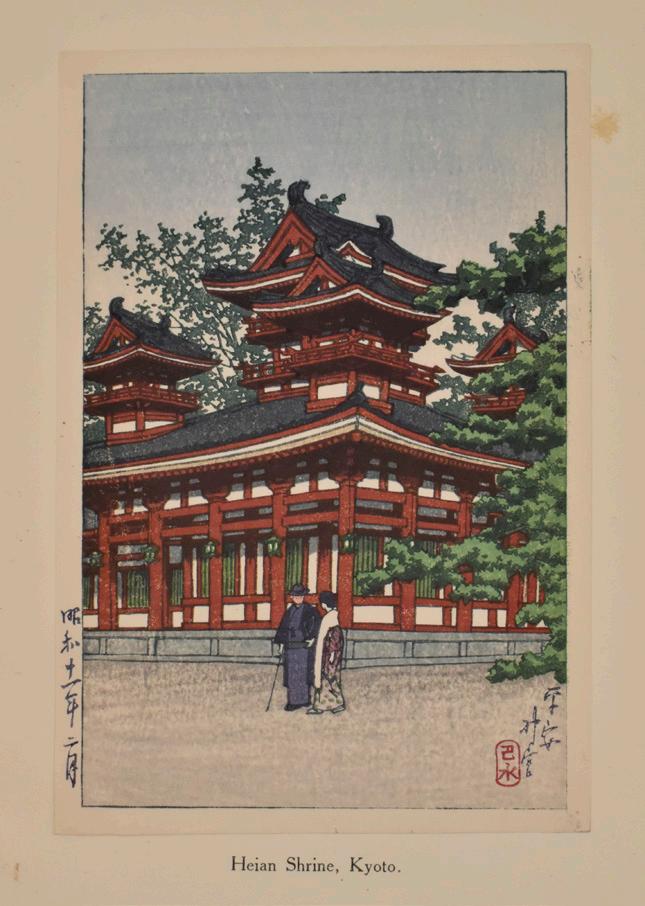
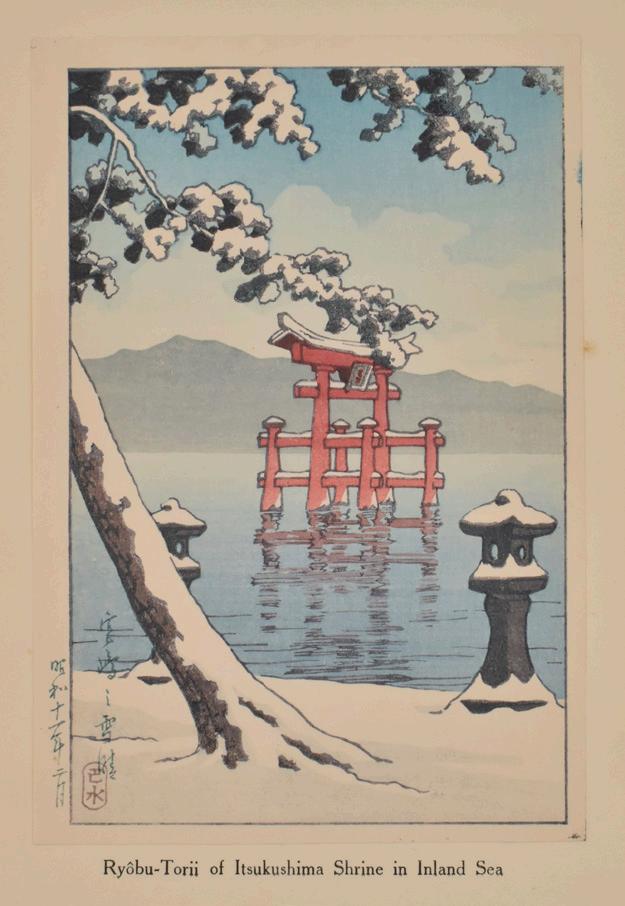
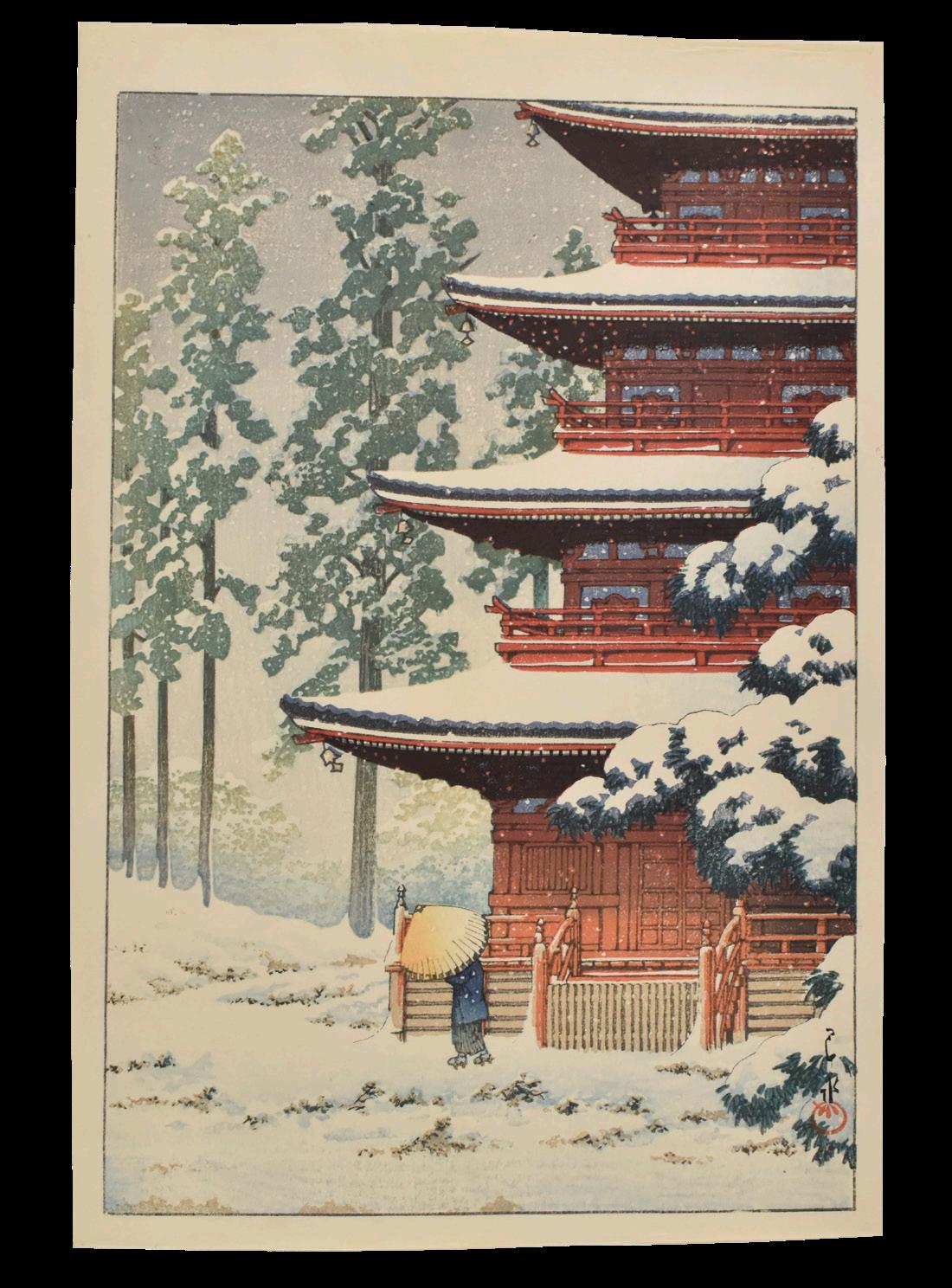
232
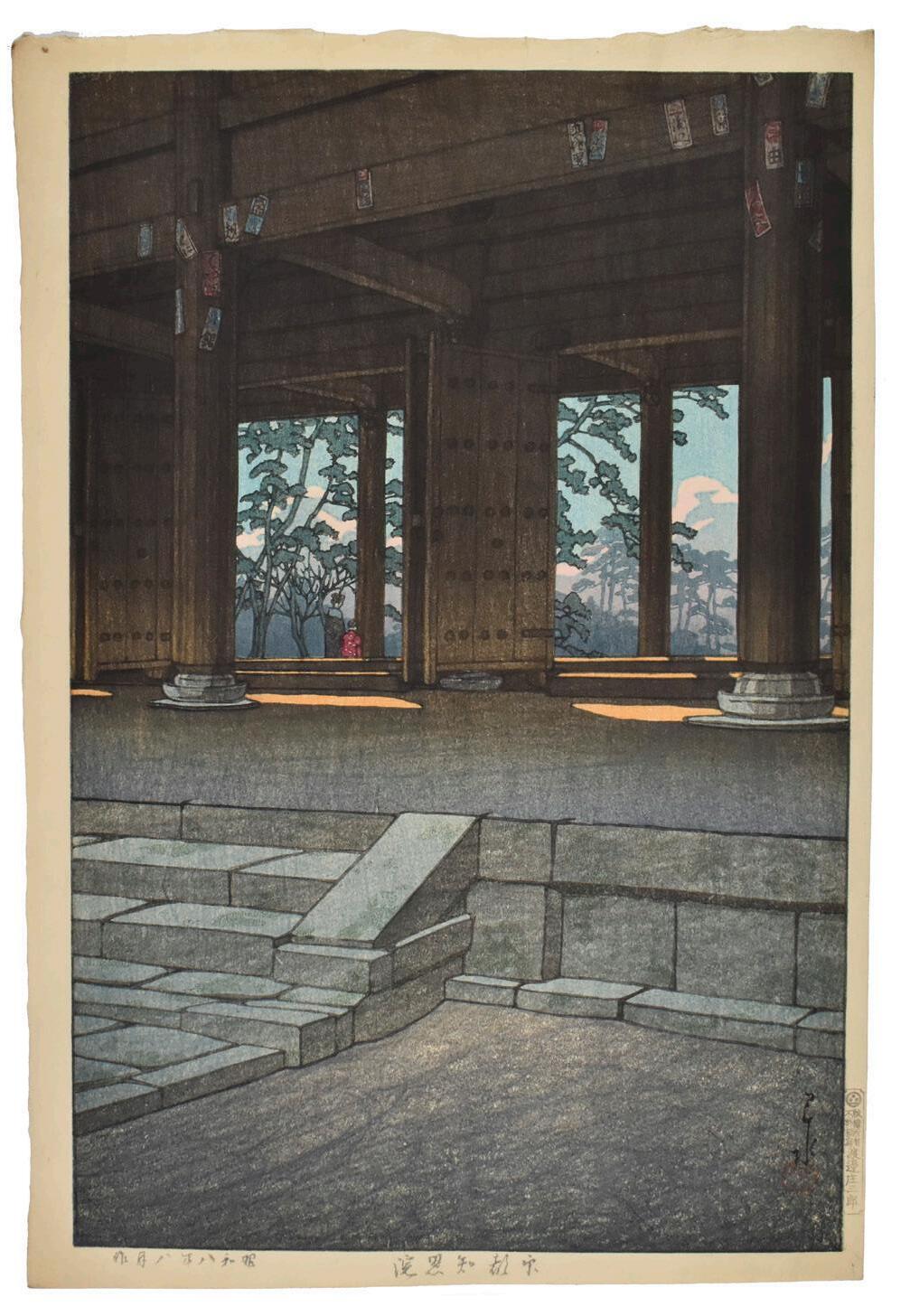
233
232
KAWASE HASUI (1883-1957)
SHOWA ERA (1926-1989), DATED 1936
An oban tate-e print from the series Nihon fukei shu higashi Nihon hen, Hirosaki Saishoin (Collection of Scenic Views of Japan, Eastern Japan Edition), depicting a solitary figure huddled beneath an umbrella in the falling snow, walking in front of the five-storied pagoda of the Saisho Temple in Hirosaki, the snowcovered boughs of the tall cypress trees in the distance; published by Watanabe Shozaburo, signed Hasui with seal Kawase
39.5cm x 26.5cm
£3,000-5,000
Provenance:
A gift from the artist to his niece Kathleen Hana Kawase (1926-2019), the daughter of Kasuke Kawase (1889-1957), Hasui’s younger brother, and thence by descent.
233
KAWASE HASUI (1883-1957)
SHOWA ERA (1926-1989), DATED 1933
An oban tate-e print titled along the bottom margin Kyoto Chionin (Chionin Temple in Kyoto) from the series Nihon fukei shu II Kansai hen (Collected Views of Japan II, Kansai Edition), dated Showa hachinen hachigatsu saku (Work of August, Showa 8 [1933]), published by Watanabe Shozaburo, with Hankyu shoyu fukyo mosha Watanabe Shozaburo seal along the right margin; signed Hasui with Kawase seal
39cm x 26cm
£2,500-3,500
Provenance:
A gift from the artist to his niece Kathleen Hana Kawase (1926-2019), the daughter of Kasuke Kawase (1889-1957), Hasui’s younger brother, and thence by descent.
KAWASE HASUI (1883-1957)
SHOWA ERA (1926-1989), DATED 1930
An oban tate-e print, titled on the left margin Nikkokaido (The Nikko Highway) depicting in the foreground a solitary figure carrying a basket and walking along the highway bordered with huge cryptomeria trees, one of the avenues leading to the famous shrines at Nikko, dated Showa gonen saku (Work of Showa 5 [1930]), probably a post-war printing, published by Watanabe Shozaburo, with a round Watanabe seal on lower bottom left corner, signed Hasui with Kawase seal
39.5cm x 26.5cm
£1,500-2,000
Provenance:
A Japanese private collection
235Ω
KAWASE HASUI (1883-1957)
TAISHO ERA (1912-1926), DATED 1925
An oban tate-e print, titled along the left margin Shiba Zojo-ji (Zojo-ji Temple in Shiba), from the series Tokyo nijukkei (20 Views of Tokyo), depicting a woman walking past the iconic vermilion facade of the Zojo-ji Temple, huddled beneath an umbrella during a snow blizzard, dated Taisho juyonen saku (Taisho 14 [1925]), published by Watanabe Shozaburo, with Hanken shoyu Watanabe Shozaburo seal along the right margin, signed Hasui with Kawase seal
39cm x 26cm
£8,000-12,000
Provenance:
A Japanese private collection
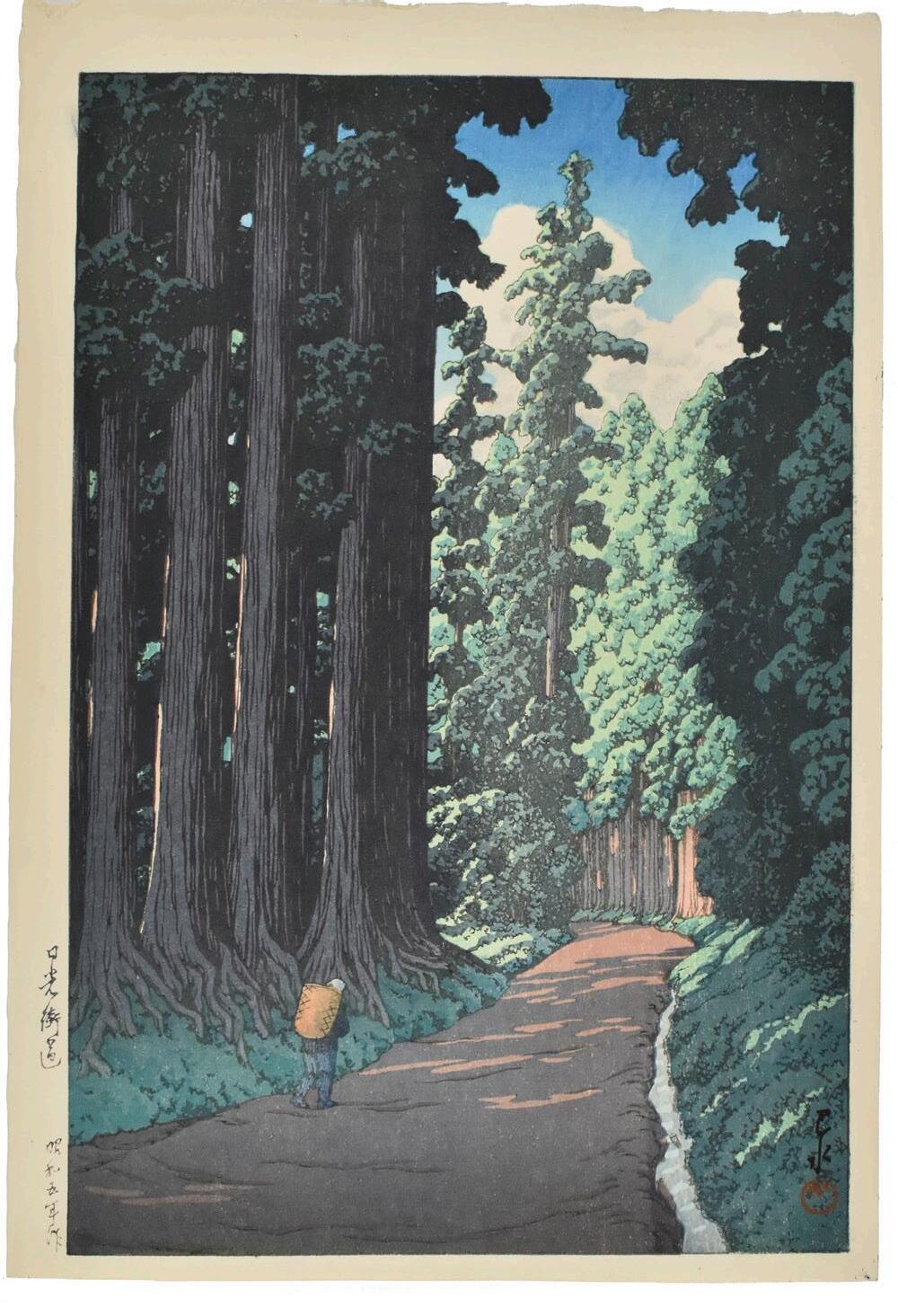
236Ω
KAWASE HASUI (1883-1957)
SHOWA ERA (1926-1989), DATED 1931
An oban tate-e print titled Sengakuji (Sengaku Temple) along the right margin from the series Tokaido fukei senshu (Selection of Views of the Tokaido), depicting a woman walking towards the entrance gate to Sengaku Temple in the evening, a small child on her back, dated Showa rokunen ichigatsu saku (Work of January, Showa 6 [1931]), published by Watanabe Shozaburo, with a shizuri (trial print) seal along the left margin, an additional trial seal and an unidentified collector’s seal on verso; signed Hasui with Kawase seal
38.5cm x 26.1cm
£1,000-1,500
Provenance:
A Japanese private collection

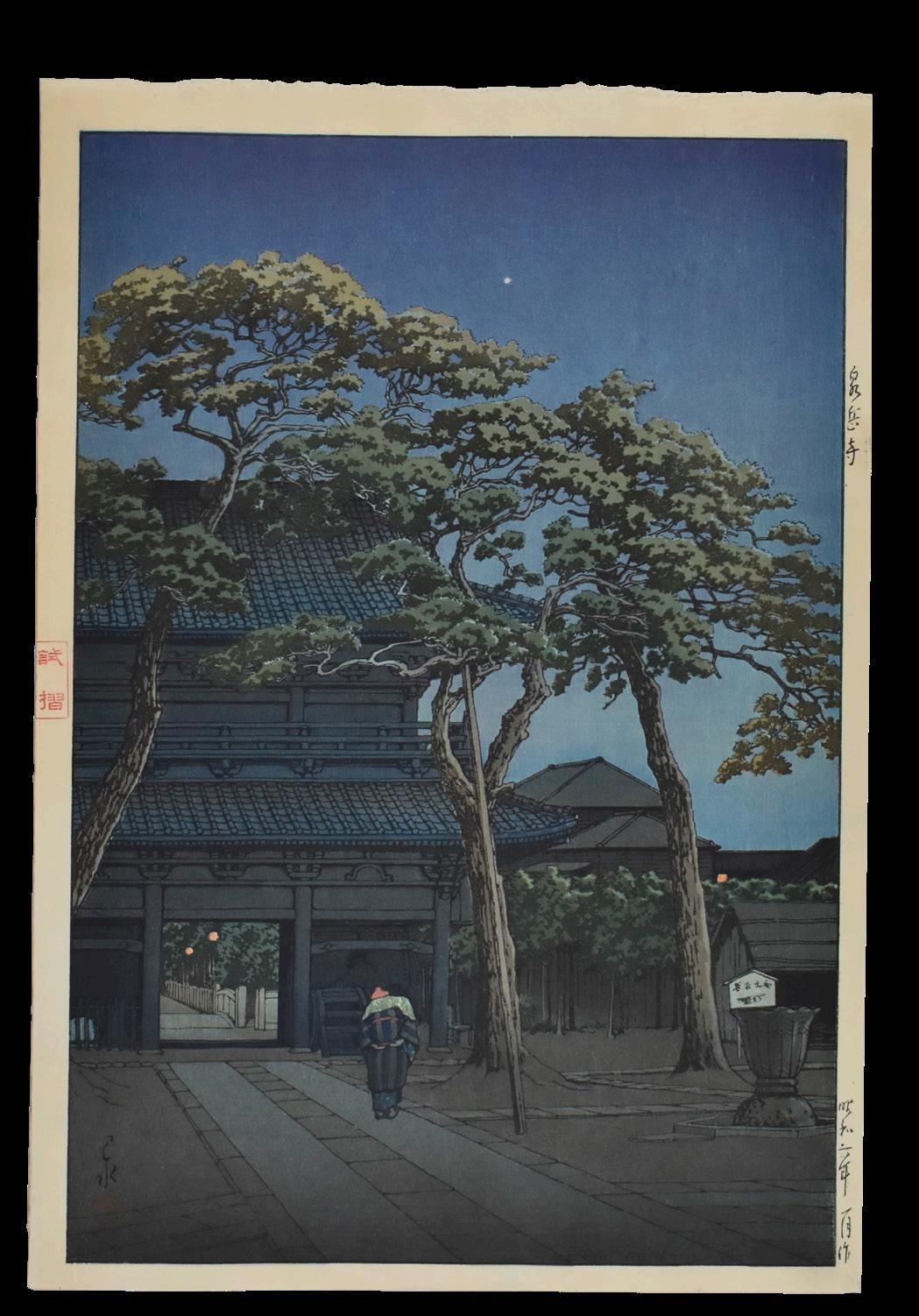
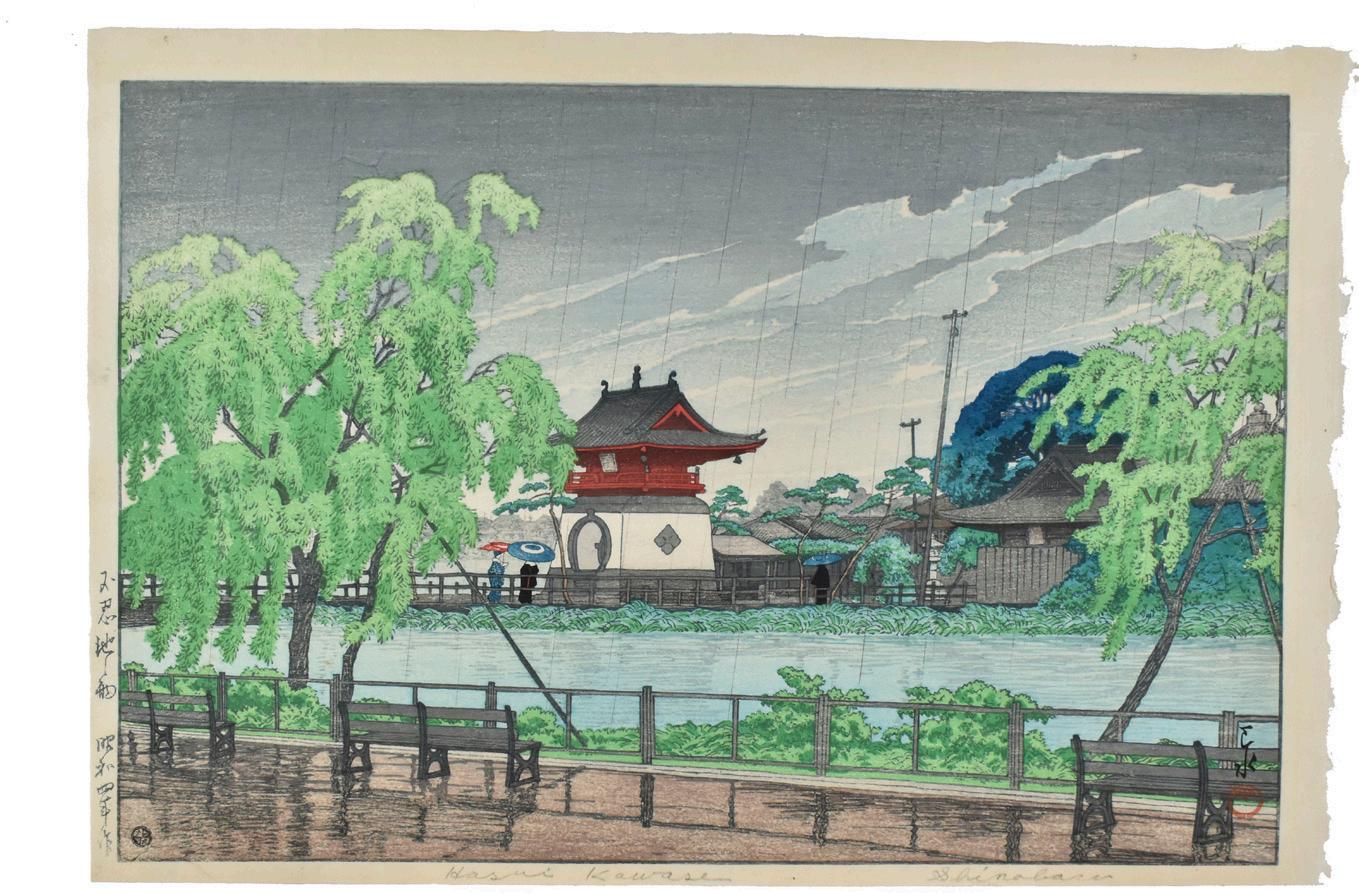
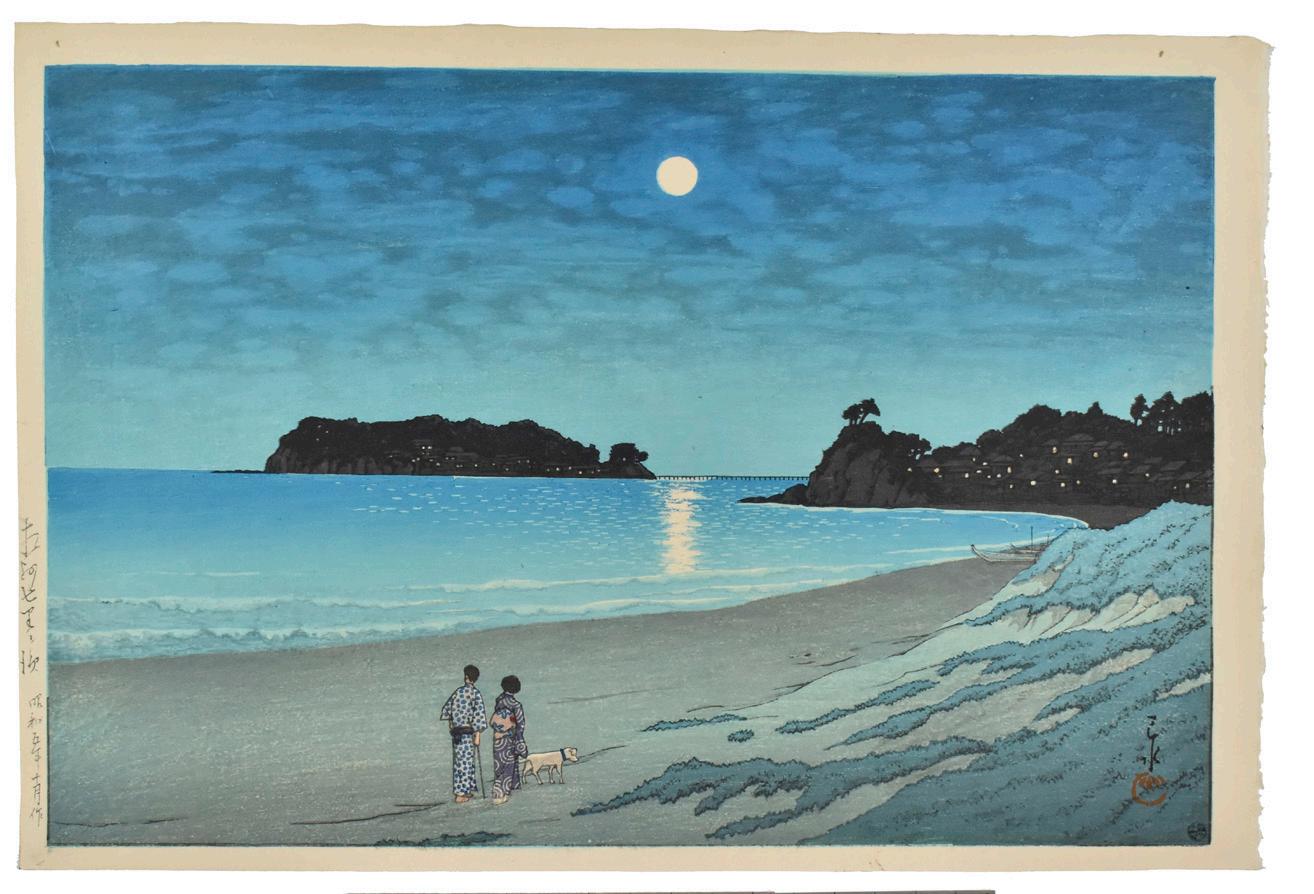
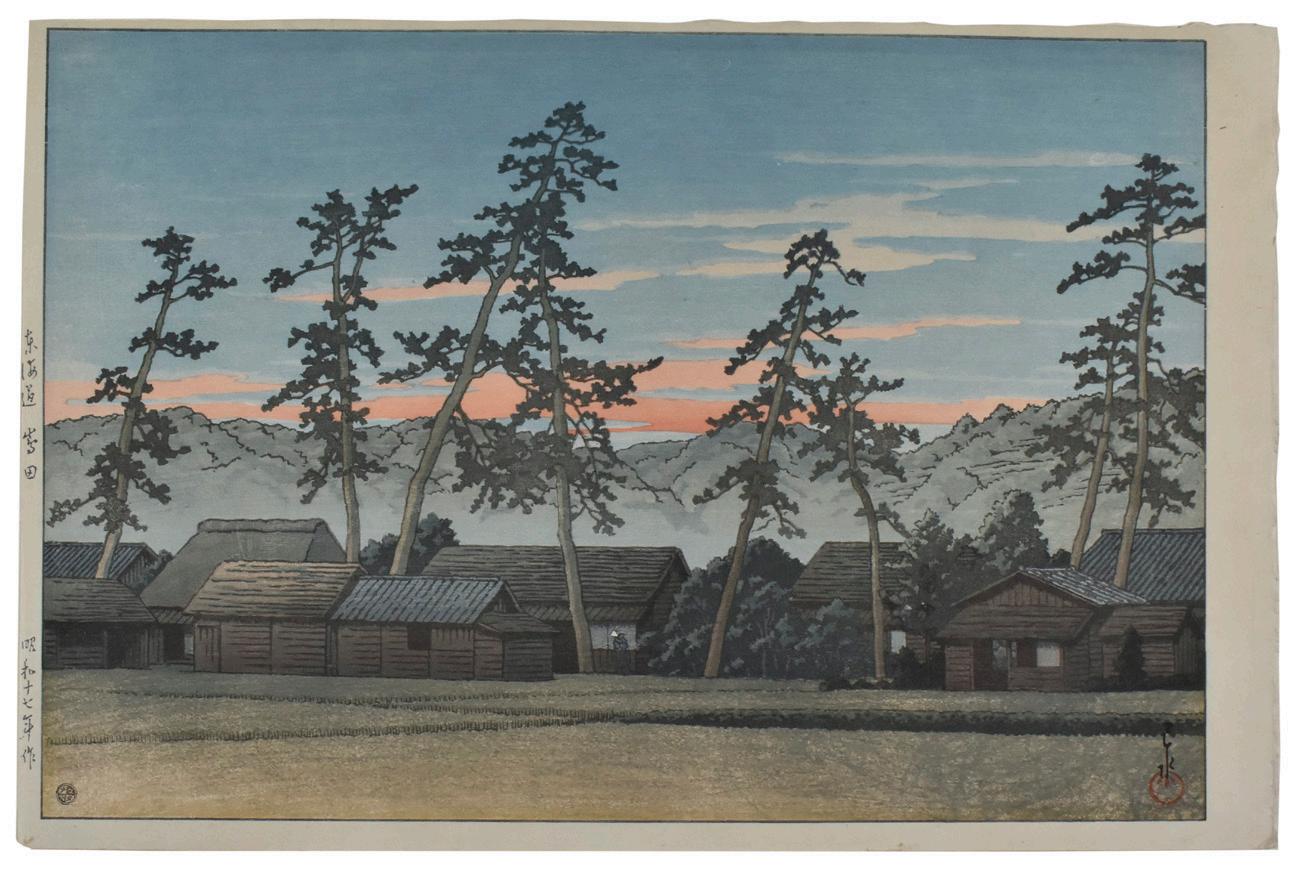
237Ω
KAWASE HASUI (1883-1957)
SHOWA ERA (1926-1989), DATED 1929
An oban yoko-e titled along the left margin Shinobazu no ike no ame (Rain at Shinobazu pond) from the series Tokyo nijukei (Twenty Views of Tokyo), dated Showa yonen saku (Work of Showa 4 [1929]), probably a post-war printing, published by Watanabe Shozaburo, with a Watanabe round seal at bottom left corner; signed Hasui with Kawase seal
26.5cm x 39cm
£2,000-3,000
Provenance: A Japanese private collection
238Ω
KAWASE HASUI (1883-1957)
SHOWA ERA (1926-1989), DATED 1930
An oban yoko-e print, titled along the left margin Soshu Shichirigahama (The SevenLeague Beach in Sagami Province) depicting a man and woman dressed in yukata walking their dog along the beach on a moonlit summer’s evening, dated Showa gonen jugatsu saku (Work of October, Showa 5 [1930]), probably a post-war printing, published by Watanabe Shozaburo, with a round Watanabe seal at bottom right corner; signed Hasui with Kawase seal 26cm x 39cm
£1,500-2,000
Provenance: A Japanese private collection
239Ω
KAWASE HASUI (1883-1957)
SHOWA ERA (1926-1989), DATED 1942
An oban yoko-e print Tokaido Shimada (Shimada, Tokaido Road) along the left margin from the series Tokaido fukei senshu (Selection of Views of the Tokaido), depicting the quiet town of Shimada, a station along the Tokaido Road, at sunset, dated Showa jushichinen saku (Work of Showa 17 [1942]), but a post-war printing, published by Watanabe Shozaburo, with a round Watanabe seal at the bottom left corner; signed Hasui with Kawase seal 26cm x 39.2cm
£1,500-2,000
Provenance:
A Japanese private collection
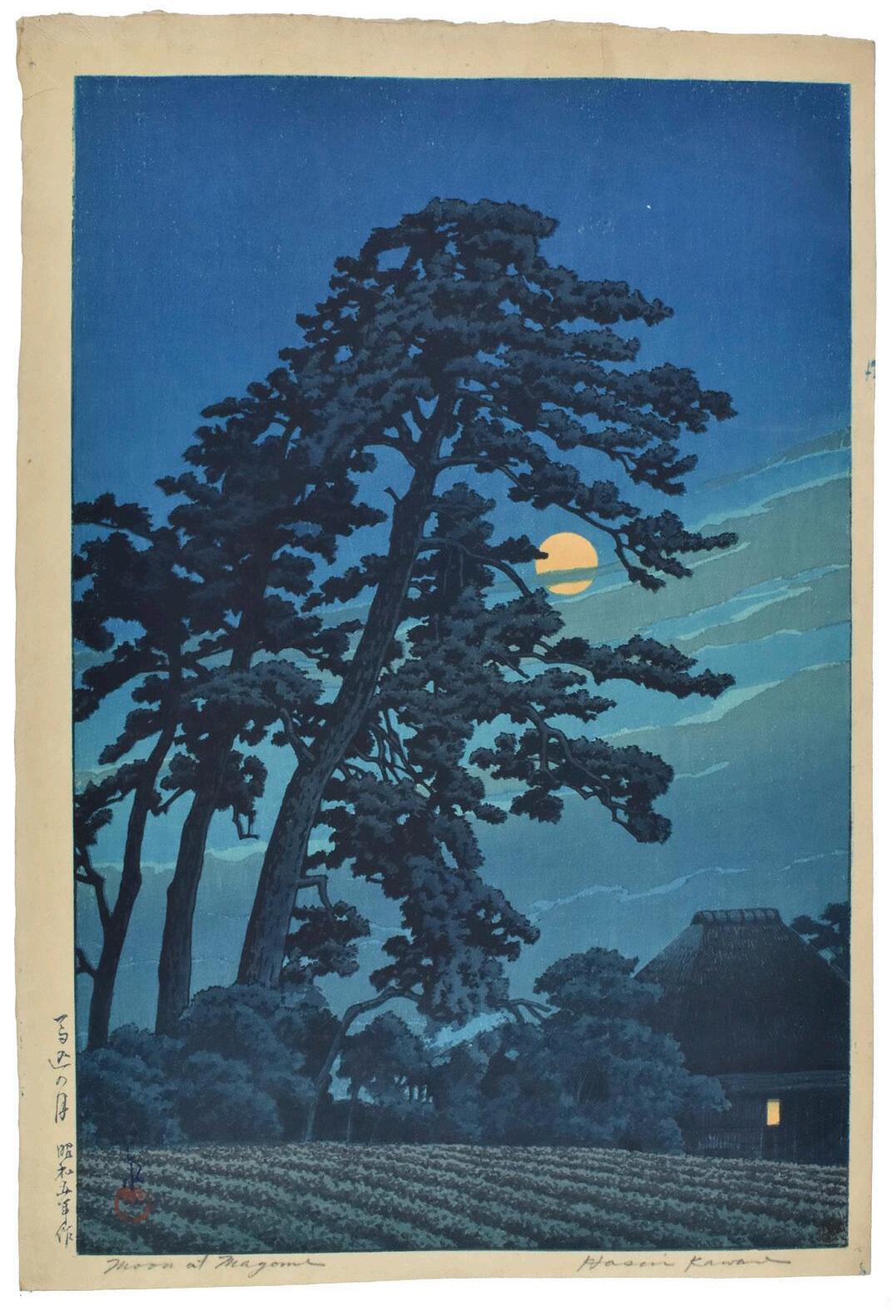
240Ω
KAWASE HASUI (1883-1957)
SHOWA ERA (1926-1989), DATED 1930
An oban tate-e print, titled along the left margin Magome no tuski (Moon at Magome) from the series Tokyo nijukkei (20 Views of Tokyo), depicting a clear full moon seen through pine branches, a light shining from the window of a thatched farmhouse in the lower foreground, dated Showa gonen saku (Work of Showa 5 [1930]), published by Watanabe Shozaburo, with a round Watanabe seal at bottom right corner; signed Hasui with Kawase seal
39.2cm x 27cm
£2,000-3,000
Provenance:
A Japanese private collection

241Ω
KAWASE HASUI (1883-1957)
SHOWA ERA (1926-1989), DATED 1936
An oban tate-e print, titled on the left margin Benkeibashi no harusame (Spring Rain at Benkei Bridge) from the series Shin Tokyo hyakkei (One Hundred Views of New Tokyo), dated Showa juichinen shigatsu utsusu (Sketched April, Showa 11 [1936]), published by Watanabe Shozaburo, with a Hanken shoyu Watanabe Shozaburo seal; signed Hasui with Kawase seal
34.3cm x 24.2cm
£1,500-2,000
Provenance:
A Japanese private collection

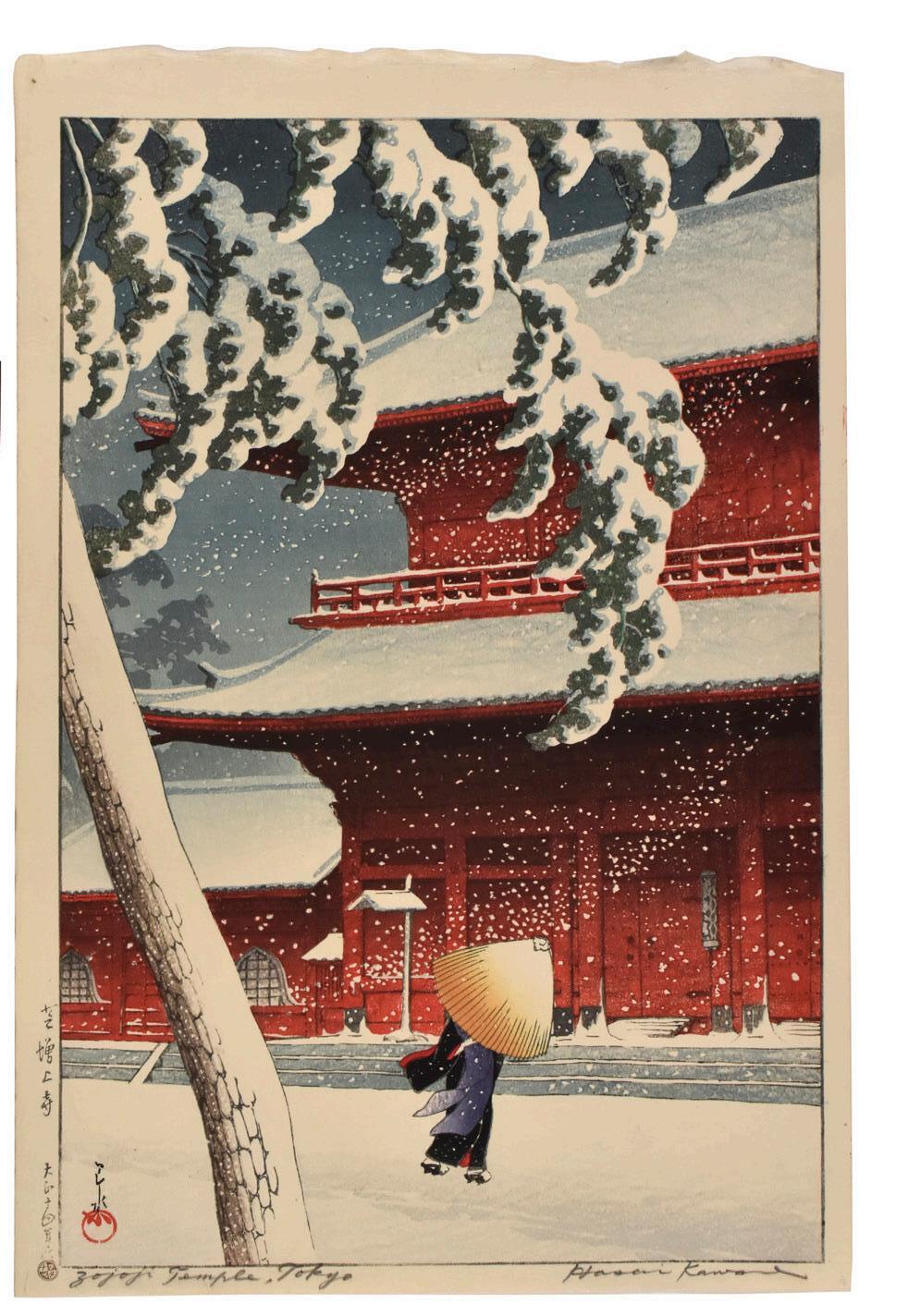
242Ω
KAWASE HASUI (1883-1957)
SHOWA ERA (1926-1989), DATED 1931
An oban tate-e print, titled along the left margin Temari (A Brocade Ball) from the series Kodomo junidai (Twelve Subjects of Children), depicting a young girl in an ornate kimono decorated with open fans, seated and playing with an embroidered temari or ‘hand ball’, dated Showa rokunen nigatsu saku (Work of February, Showa 6 [1931]), but probably a post-war printing, published by Watanabe Shozaburo, with a round Watanabe seal at bottom right corner; signed Hasui with Kawase seal
40cm x 26.5cm
£1,000 - £1,500
243Ω
KAWASE HASUI (1883-1957)
TAISHO ERA (1912-1929), DATED 1925
An oban tate-e print; titled along the left margin Shiba Zojo-ji (Zojoji Temple in Shiba), from the series Tokyo nijukkei (20 Views of Tokyo), depicting a woman walking past the iconic vermilion facade of the Zojo-ji Temple, huddled beneath an umbrella during a snow blizzard, dated Taisho juyonen saku (Taisho 14 [1925]), but a postwar printing, published by Watanabe Shozaburo, with a round Watanabe seal at the bottom left corner on the margin, signed Hasui with Kawase seal
38.5cm x 26cm
£3,000-5,000
244Ω
KAWASE HASUI (1883-1957)
SHOWA ERA (1926-1989), DATED 1934
An oban tate-e print, titled along the left margin Bishu, Seto (Seto, Owari Province) from the series Tokaido fukei senshu (Selection of Views of the Tokaido), depicting a porcelain factory and its kilns under the pale light of the crescent moon, dated Showa kyunen sangatsu saku (Work of March, Showa 9 [1934]), with carver’s seal Hori Tadasu (Watanabe Tadasu), published by Watanabe Shozaburo, with the publisher’s seal Hanken shoyu fukyo mosha Watanabe Shozaburo seal along the lower right margin, stamped Shozuri (First print) on verso; signed Hasui with Kawase seal
39cm x 26cm
£1,000-1,500
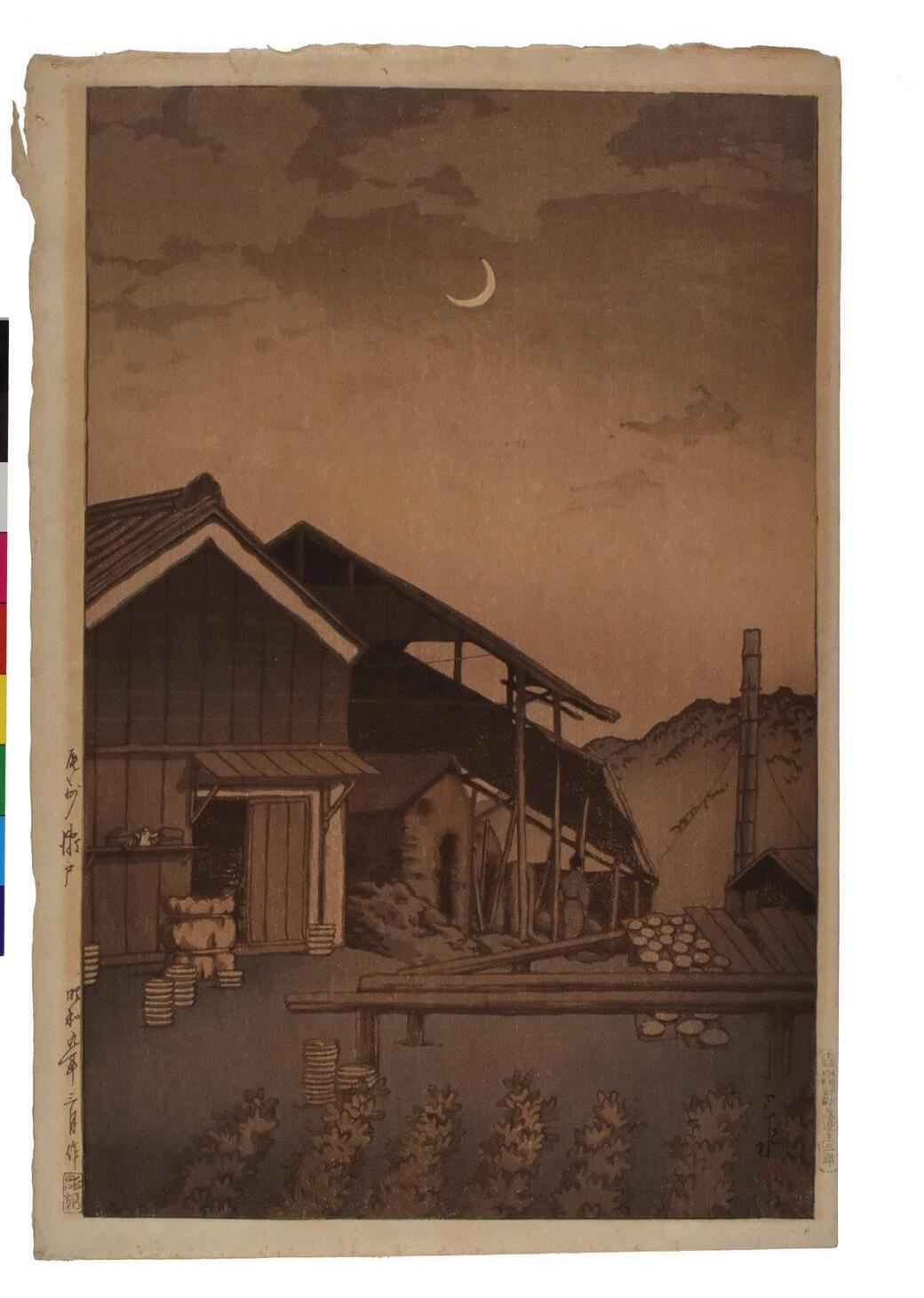
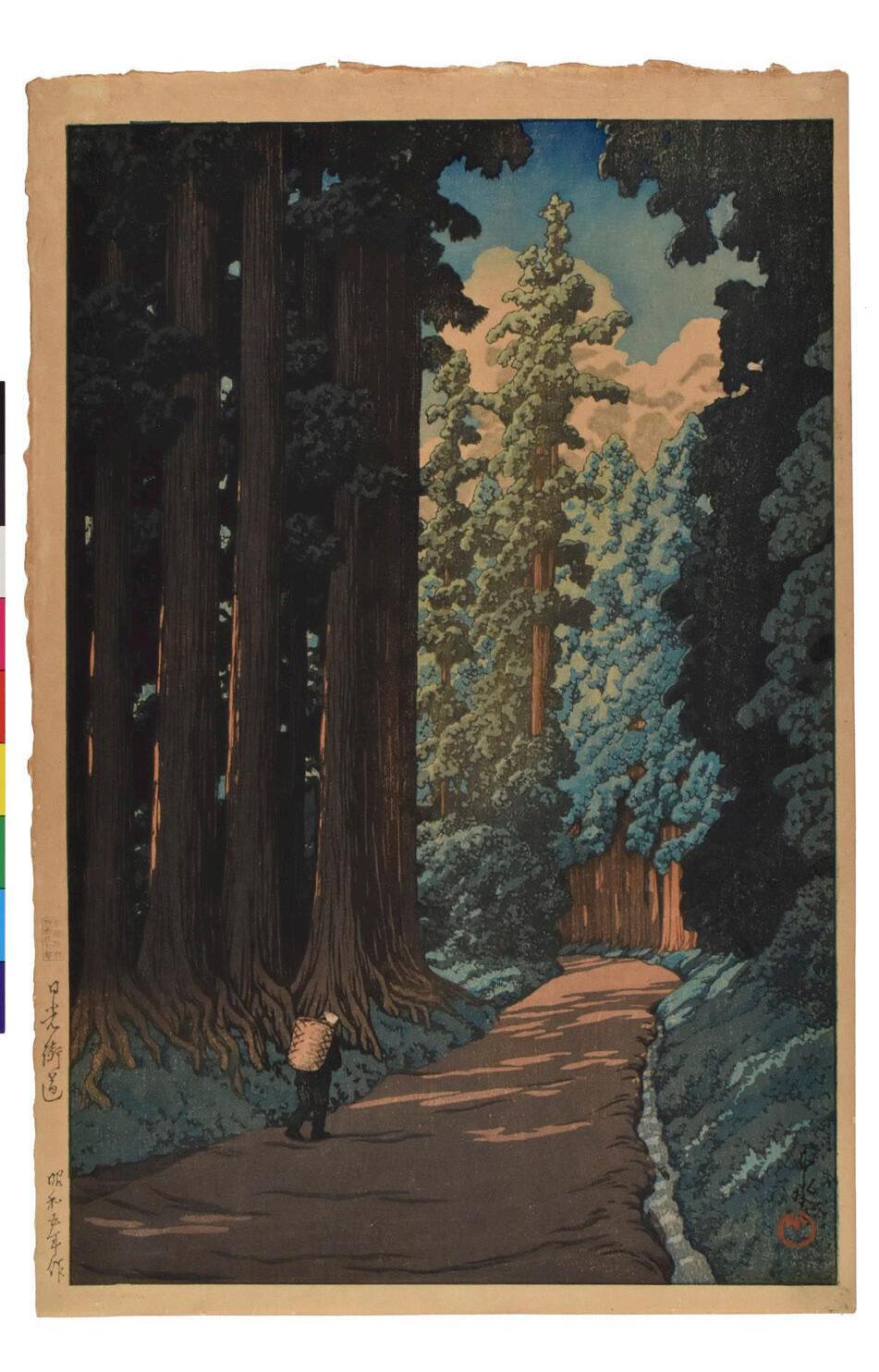
KAWASE HASUI (1883-1957) AND NOËL NOUËT (1885-1969) SHOWA ERA (1926-1989), DATED 1930 AND 1936
Two oban tate-e prints: the first by Hasui, titled along the left margin Nikko kaido (Road to Nikko), dated 1930, published by Watanabe Shozaburo, with a square Hanken shoyu Watanabe Shozaburo seal on the left margin, signed Hasui with Kawase seal, stamped MADE IN JAPAN along the bottom-left margin, 39cm x 26cm; the second by Nouët, titled along the right margin Kameido (Kameido Bridge), from the series Tokyo fukei zen nijuyon mai (Scenes of Tokyo, Twenty-four Views), dated and signed 1936 Noël Nouët along the bottom edge within the image, published by Doi Sadaichi, with publication notations along the bottom margin (from left to right), To Ikeda (carver Ikeda), Suri Yokoi (Printer Yokoi), Nuetto saku (made by Nouët), and Hanmoto doi (publisher Doi), with publisher’s watermark Do at the upper left corner.
39.5cm x 26.5cm (2)
£1,000-1,500


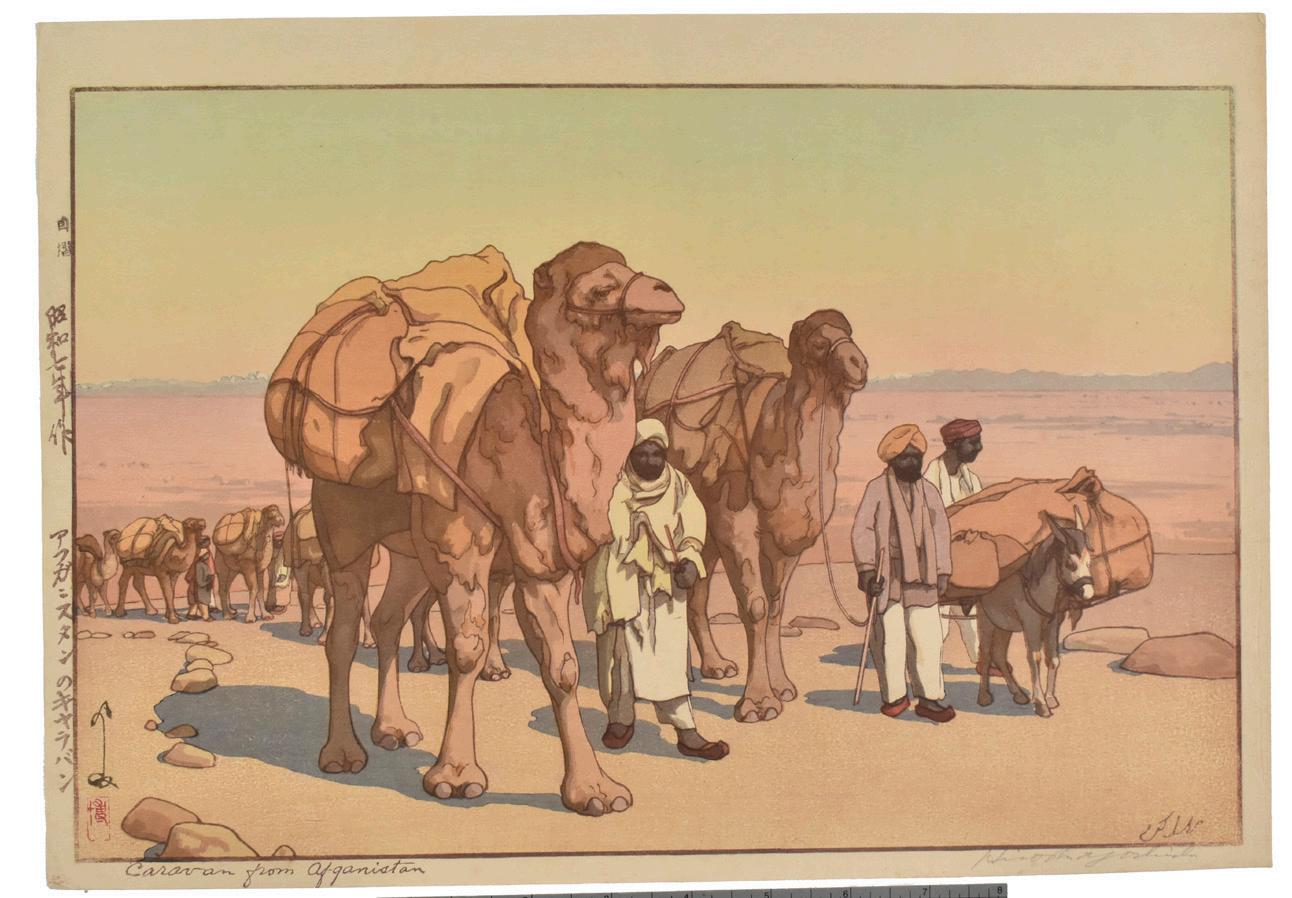


246Ω
HASHIGUCHI GOYO (1881-1921) TAISHO ERA (1912-1929), DATED 1920
An oban yoko-e print depicting a pair of Mandarin ducks, one Mandarin duck diving underwater for food, the other keeping a watchful eye on its partner, dated Taisho kyunen hachigatsu (August, Taisho 9 [1920]); signed Goyo ga with a seal GY
26.2cm x 39cm
£2,000-3,000
247
YOSHIDA HIROSHI (1876-1950) SHOWA ERA (1926-1989), DATED 1932
An oban yoko-e print, titled along the left margin Afuganisutan no kyaraban (Caravan from Afghanistan), depicting a caravan travelling through the desert, dated Showa 7 (1932), with a jizuri seal, signed in ink Yoshida with seal Hiroshi; and signed in pencil Hiroshi Yoshida along the bottom margin
28cm x 40cm
£1,500-2,000
248
OHARA KOSON/SHOSON (1877-1945), YOSHIDA HIROSHI (1876-1950), KAWASE HASUI (1883-1957), AND TSUCHIYA KOITSU (1870-1949)
TAISHO (1912-1926) TO SHOWA (1926-1989) ERA, 20TH CENTURY
Nine prints of various sizes, formats and subjects, comprising: six kachoga prints by Koson/Shoson, consisting of four otanzakuban, one shikishiban, and one small rectangular-shaped print; two oban tate-e by Hiroshi of Suginamiki (Cryptomeria Avenue), dated 1937 and Nikko kirino hi (Misty Day in Nikko), dated 1937; an oban tate-e by/after Hasui of Ame no Ushibori (Rain at Ushibori), dated 1929, but probably a post-war printing/reproduction (vertically torn into two); and an oban tate-e by Koitsu of Yotsuya Araki yokocho (Araki Street, Yotsuya), dated 1935 (lacking the lower section, approx. 4cm from the bottom edge), variously published and variously signed (9)
The smallest: 18.5cm x 12.7cm; the largest: 40cm x 27.3cm
£1,000 - £1,500
249
TAKAHASHI SHOTEI/HIROAKI (1871-1945)
PROBABLY SHOWA ERA (1926-1989), EARLY 20TH CENTURY
Two mitsugiriban tate-e prints: the first titled Katsushika (Katsushika), depicting a fisherman returning home with his catch at Katsushika, signed with a red square seal Shotei; the second titled Yoru no Shinagawa (Shinagawa at Night), depicting a pair of musicians, singing and playing the shamisen, walking down a city street in the early evening, signed with a red square seal Shotei; both published by Watanabe Shozaburo; both framed and glazed (2)
Overall: each approx. 47.5cm x 27.3cm; image: each approx. 36cm x 16cm
£800-1,000
250
TAKAHASHI SHOTEI/HIROAKI (1871-1945)
SHOWA ERA (1926-1989), PROBABLY SHOWA ERA (1926-1989), EARLY 20TH CENTURY
Two mitsugiriban tate-e prints: the first of Sekiguchi no tsuki (Moon at Sekiguchi) depicting a mother and her daughter returning home after firefly hunting, signed Hiroaki with a red gourd seal Shotei; the second of Oji Inari (Inari Shrine at Oji), depicting a daikon (radish) vendor and a woman at the entrance gate to Inari Shrine in Oji, signed with a red square seal Shotei; both published by Watanabe Shozaburo; both framed and glazed (2)
Overall: each approx. 47.5cm x 27.3cm; image: each approx. 36cm x 16cm
£800-1,000

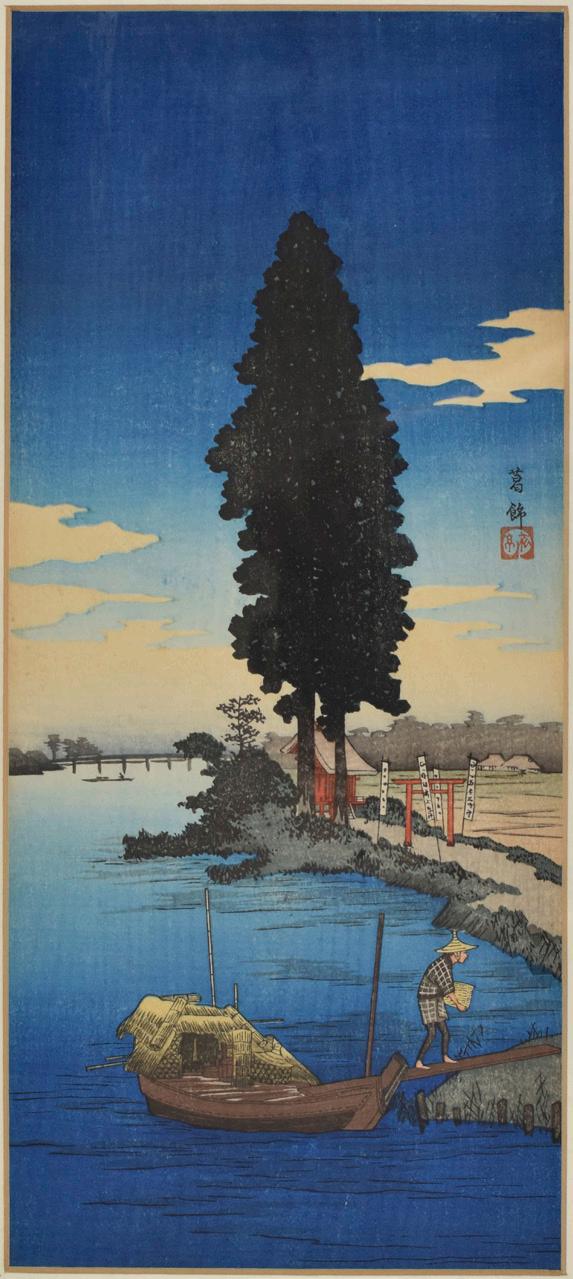

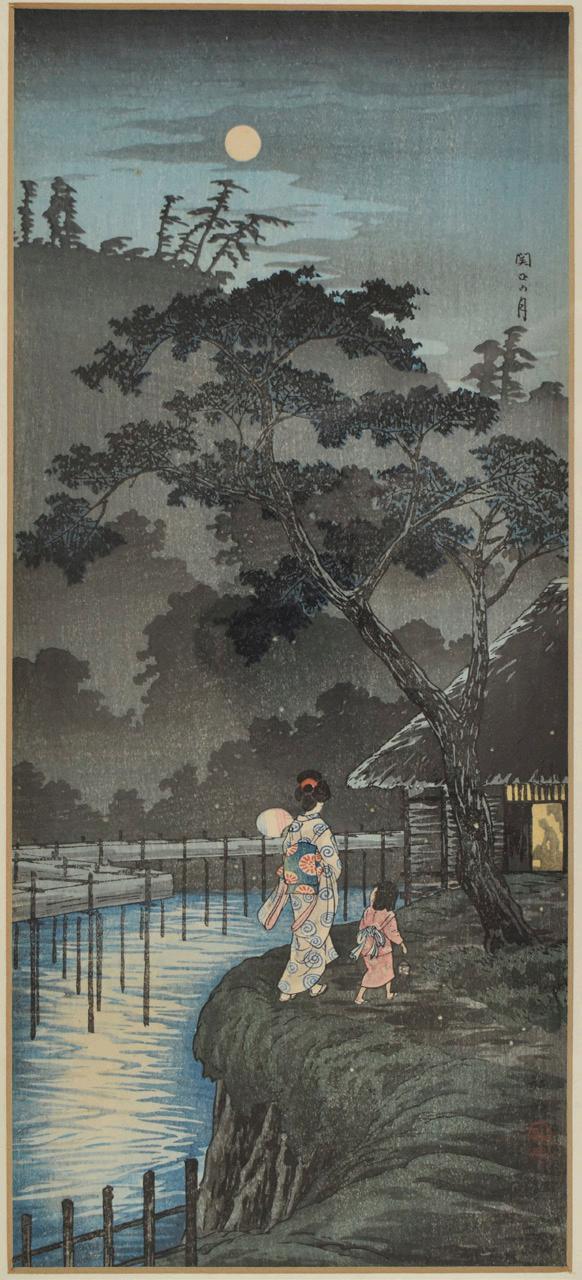



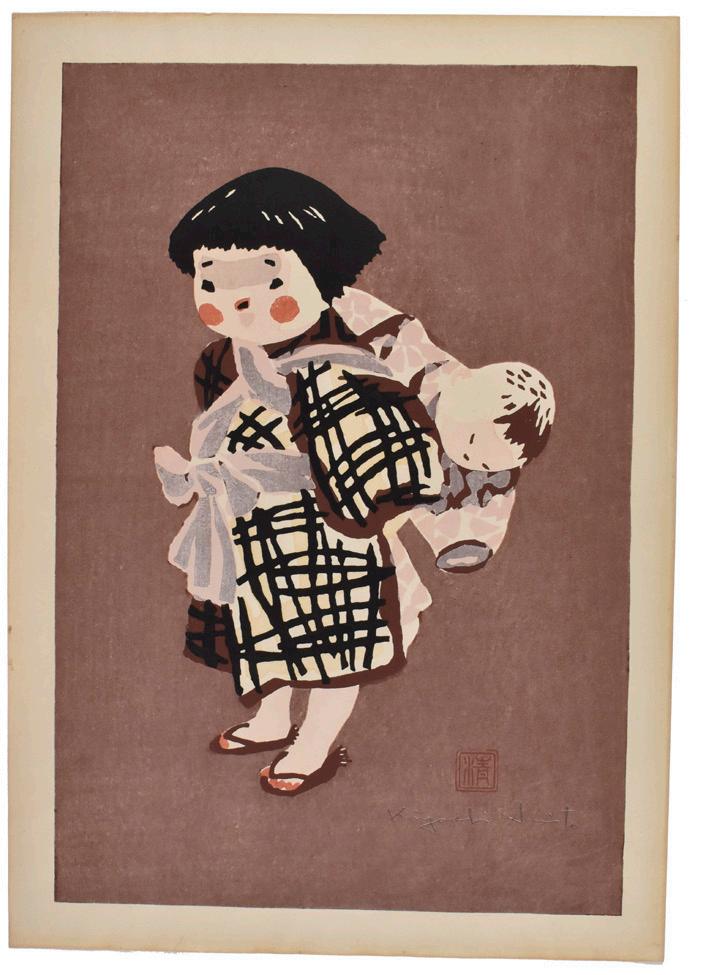
251
KOBAYASHI EIJIRO (1870-1946) AND SHODA KOHO (1871-1946), TAISHO (1912-1926) OR SHOWA (1926-1989) ERA, CIRCA 1910-1930S
Two chuban tate-e prints in sepia colour from the Yakei (Night Scene) series published by Hasegawa-Nishinomiya or Nishinomiya circa 1910-1930s, comprising one by Eijiro depicting a moonlit river scene showing the silhouette of a woman about to board a small pleasure boat on the Sumida River, signed with a seal Eijiro, 25.7cm x 18.9cm and one by Koho depicting a moonlit canal, signed with two seals Ko and Ho, 26.2cm x 19.2cm (2)
£600-800
To be sold without reserve
253
SAITO KIYOSHI (1907-1997)
SHOWA ERA (1926-1989), MID-TO LATE 20TH CENTURY
Two daioban tate-e woodblock prints: the first “Steady Gaze”, depicting a seated black and grey striped cat, signed in Roman script Kiyoshi Saito along the lower edge and stamped Kiyoshi on verso, 40.5cm x 27cm; the second from the series depicting children in Aizu, featuring a young girl carrying her baby brother on her back, signed in pencil in Roman script Kiyoshi Saito with a seal Kiyoshi, stamped on verso Suri: Ikegami (Printed by Ikegami), 40.4cm x 28.5cm (2)
£800-1,000
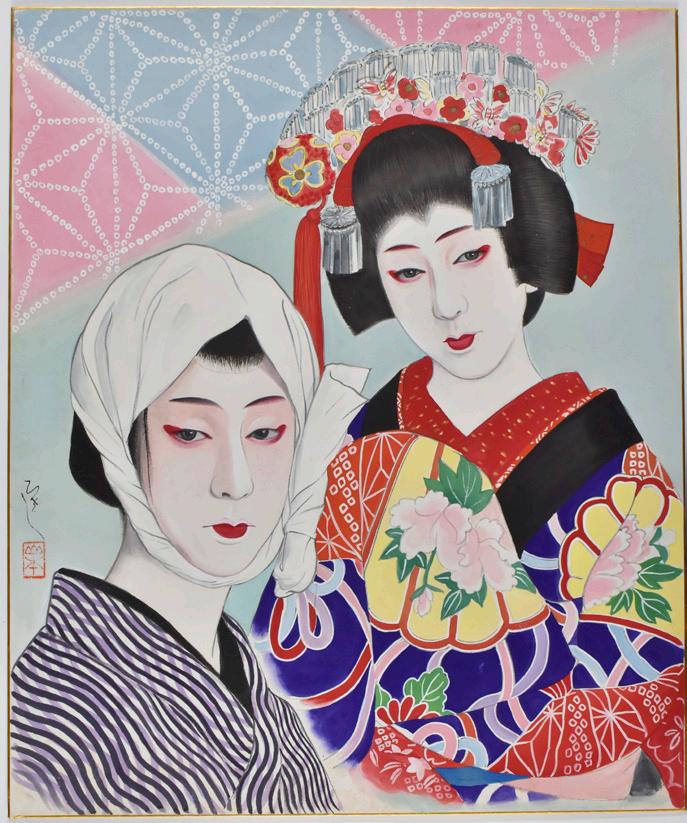
252
YOSHU CHIKANOBU (1838-1912), SAITO KAORU (BORN 1931), AND YAMAMOTO HISASHI (1905), MEIJI ERA (1868-1912) AND SHOWA ERA (1926-1989), CIRCA 1898 AND 20TH CENTURY
Two prints and one painting of various sizes and techniques: the first, an oban tae-e woodblock diptych print of Rikuzen Matsushima (Matsushima in Rikuzen Province) from the series Meisho bijin awase (Beauties Matched with Famous Places) by Chikanobu, published by Matsuki Heikichi, circa 1898, each sheet approx. 35.2cm x 23.7cm; the second, a double oban yoko-e mezzotint print by Saito Kaoru, titled SNOWY NIGHT, dated ’89, edition number 48/93, signed in pencil in Roman script Kaoru. S, 37.8cm x 46cm; the last a watercolour painting by Yamamoto Hisashi, depicting kabuki actors in the roles of the ill-fated lovers Jihei and Koharu from the play Shinju Ten no Amijima (Double Suicide in Amijima), signed Hisashi with a seal Yamamoto, 45.5cm x 38cm (4)
£600-800
To be sold without reserve
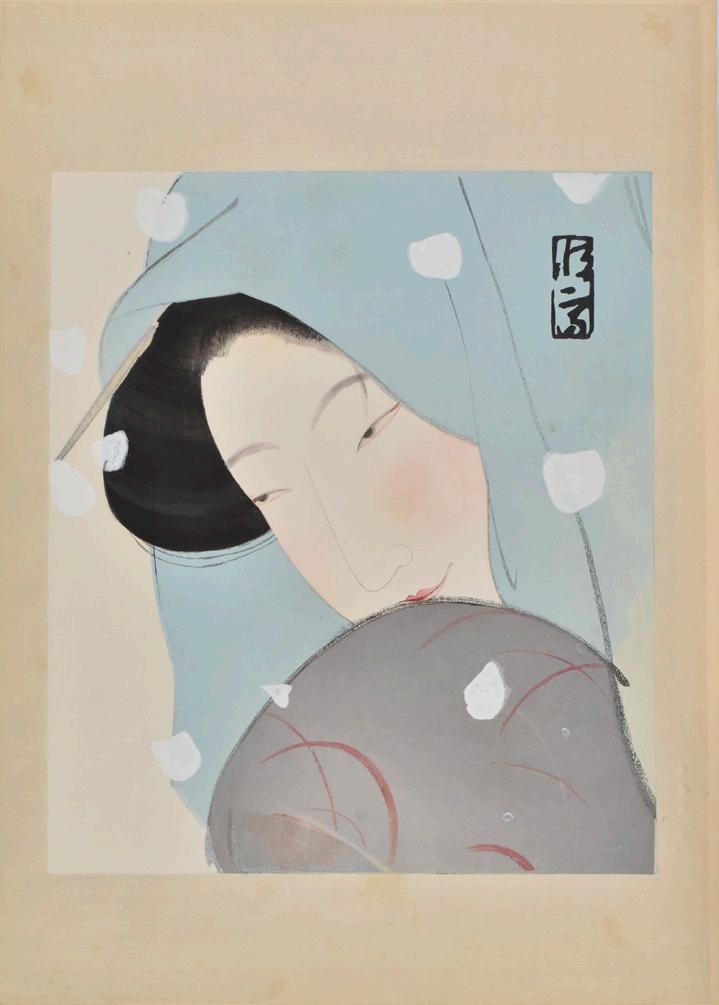


254
KITANO TSUNETOMI (1880-1947), KABURAGI KIYOKATA (1878-1972), NATORI SHUNSEN (1886-1960), SHIMURA TATSUMI (1907-1980), AND YAMAKAWA SHUHO (1898-1944)
TAISHO (1912-1926) AND/OR SHOWA (1926-1989) ERA, 20TH CENTURY
Five woodblock prints by various artists: comprising two oversized oban tate-e prints from supplements to a set of Chikamatsu Monzaemon’s work titled Dai Chikamatsu zenshu (Complete Works of Chikamatsu), the first depicting the heroine Umekawa from the play Meido no hikyaku, signed with seal Tsunetomi, circa 1923, and second of Osai from the play Yari no Gonza Kasane Katabira, signed Kiyokata saku with seal, dated 1923; an oban tate-e portrait of Ichikawa Sadanji II as Marubashi Chuya, signed Shunsen with seal, circa 1931; an oversized oban tate-e print of Oibane (Playing Battledore and Shuttlecock) from the series Gendai bijin fuzoku gotai (Five Figures of Modern Beauties), signed and sealed Tatsumi, circa 1952; and an oban tate-e print titled Tasogare (Twilight) from the series Fujin yondai (Women in Four Settings), signed Shuho with seal, dated 1928; all variously published (5)
The smallest: 38cm x 26.5cm; the largest: 46cm x 29.4cm
£800-1000
255
FUJITA FUMIO (BORN 1933) AND OTHERS SHOWA ERA (1926-1989), LATE 20TH CENTURY
Five large woodblock prints, comprising: three by Fujita Fumio, consisting of one yoko-e titled Kishibe no hayashi (Forest on the Shore), dated 1982, edition number 10/200, signed F. Fujita, all in pencil along the lower margin, 43cm x 58cm, one tate-e titled Mizu’umi A (Lake A), dated 1978, edition number 25/150, signed F. Fujita, all in pencil along the lower margin, 57.7cm x 43.5cm, and one tate-e titled Yukage B (Evening Shadow B), dated 1974, edition number 94/200, signed F. Fujita, all in pencil along the lower margin, 60.5cm x 45.5cm; two large Chinese tate-e prints by different artists, both depicting a nostalgic waterside town in China, all titled, numbered, and signed in pencil, together with a facsimile print of the same subject, the smallest: 59cm x 47.5cm; the largest: 59.5cm x 49.5cm (6)
£600-800

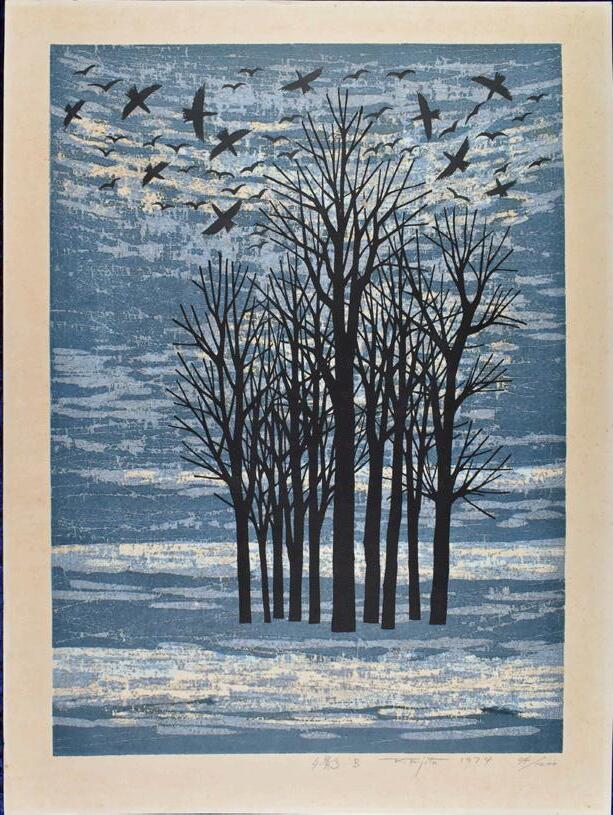

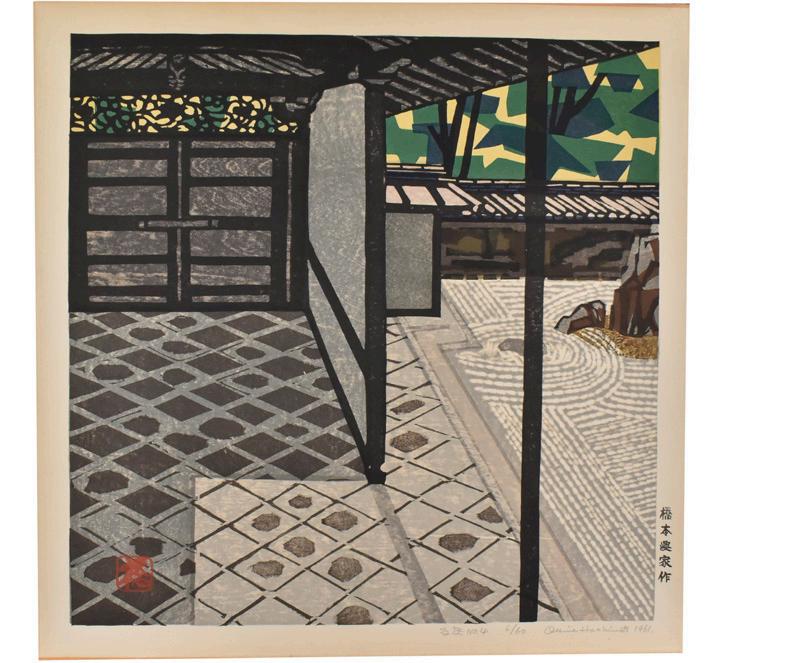
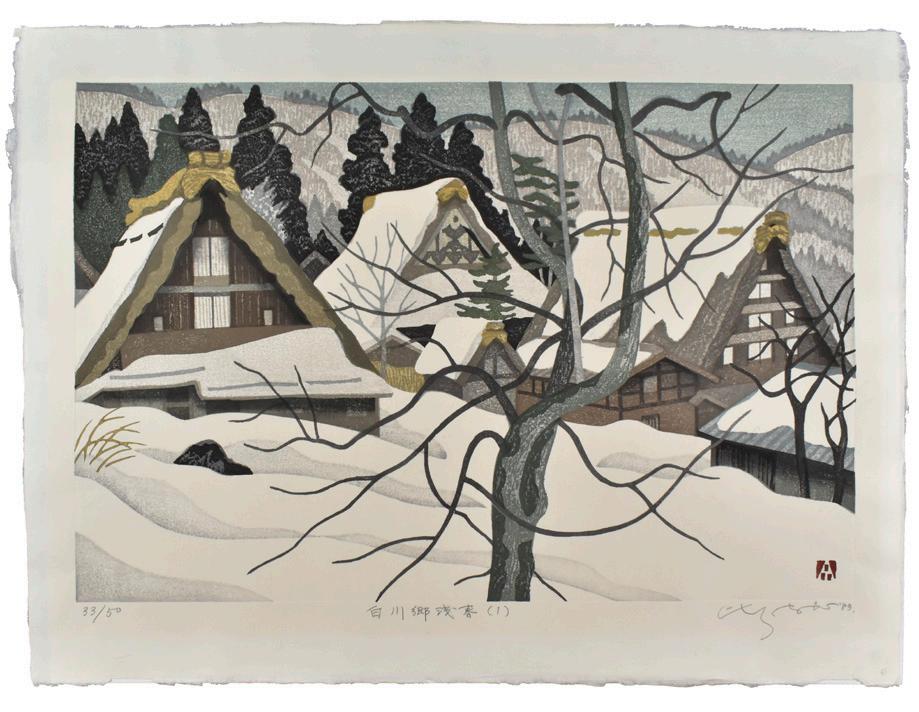
256
Four woodblock prints of various sizes, comprising: two square prints by Okiie, the first titled Sekitei No.4 (Stone Garden, No.4), dated 1961, edition number 6/60, signed in Roman script Okiie Hashimoto, all in pencil along the lower right margin, an additional printed signature along the right margin in kanji script Hashimoto Okiie saku, with artist ’s red seal on the lower left within the image, 44.2cm x 44.3cm; the second titled Maeniwa (Front Garden), dated 1958, edition number Toku 6/30, signed in Roman script Okiie Hashimoto, all in pencil along the lower right margin, an additional printed signature Hashimoto Okiie saku along the right margin, with artist’s red seal on the lower right of the image, 44.2cm x 44cm; two large tate-e prints by Mabuchi Toru, comprising one titled in hiragana script Yuri to bara (Lilly and Rose), dated 1968, edition number 90/110, all in pencil along the lower margin, signed in Roma script Toru Mabuchi, 62cm x 46.8cm; and one titled in Japanese Doki to haniwa, No.1 (Earthenware and Haniwa, No.1), dated 1960, edition number 7/50, all in pencil along the lower margin, signed in Roman script Toru Mabuchi with a seal Toru 62cmx 47cm (4)
£500-800
To be sold without reserve
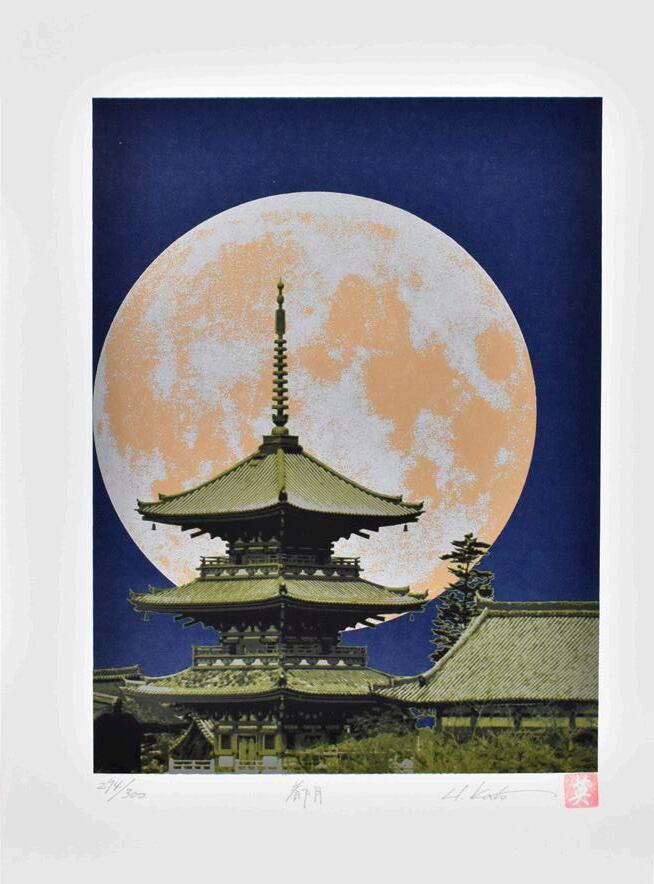
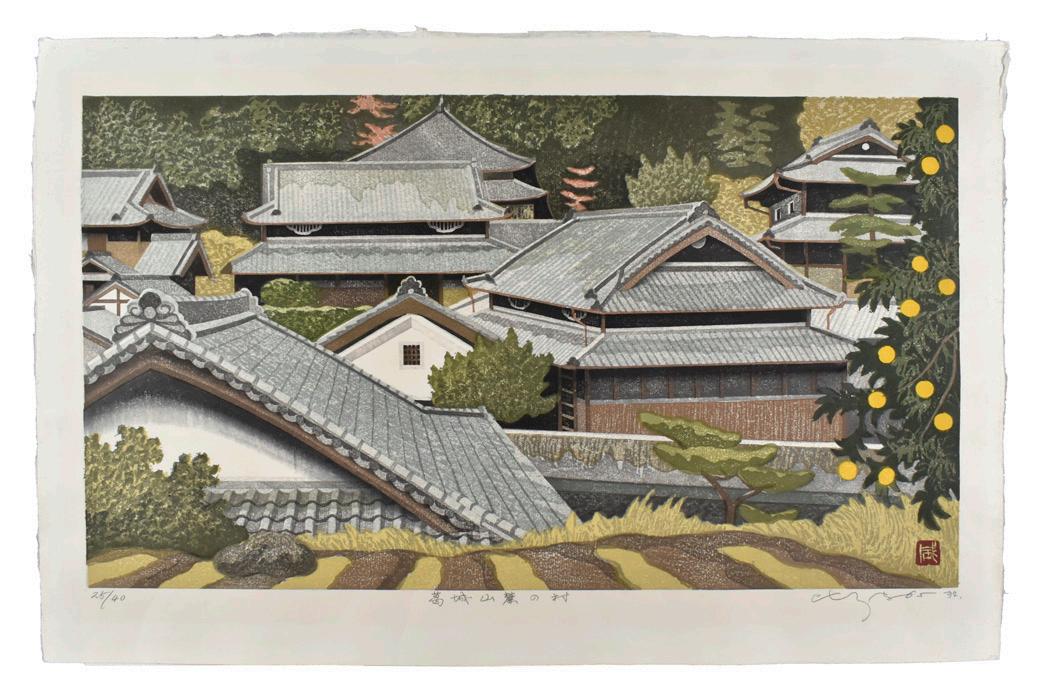
Three oban silkscreen prints: the first, a tate-e titled Miyakozuki (Moon over Kyoto), edition number 274/300, 39.2cm x 31.1cm; the second, a yoko-e titled Madoromi (Dozing Off), edition number 128/300, 31cm x 39.5cm; the third a yoko-e, titled To’an (Small Tea House), edition number A.P. 1/7, 31cm x 39.5cm; all signed in pencil in Roman script H.Kato along the lower margin, with a red seal Hide (3)
£300-400
To be sold without reserve
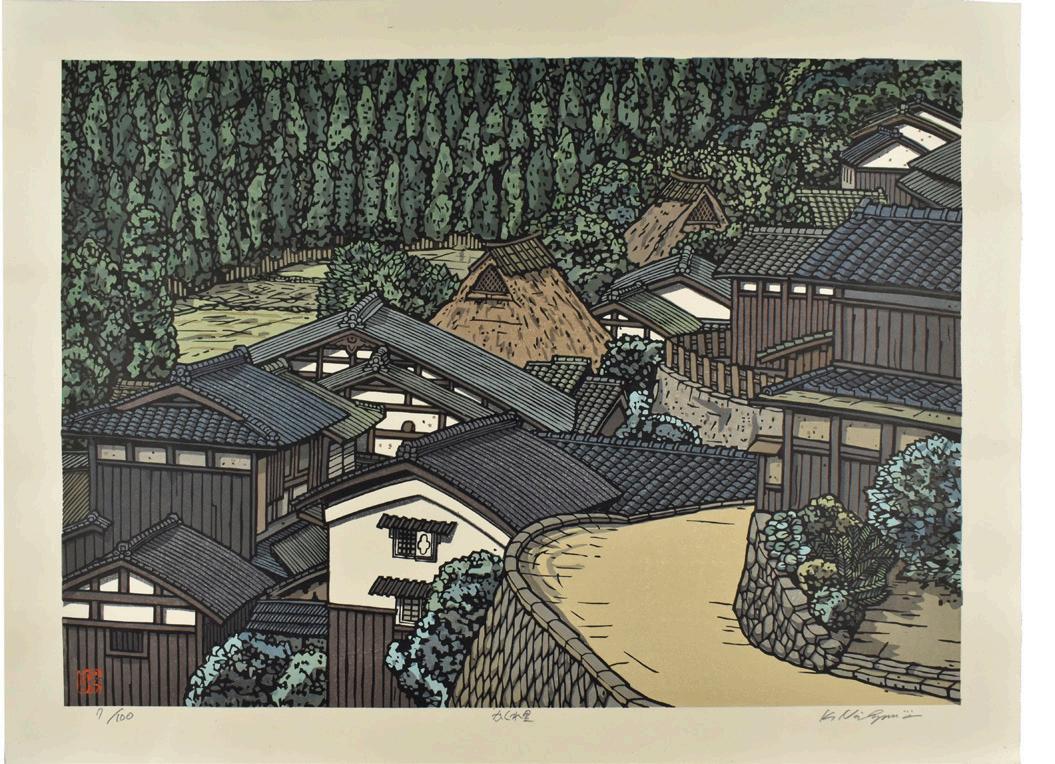
258
HIRONAGA TAKEHIKO (BORN 1935)
SHOWA (1926-1989) AND HEISEI (1989-2019) ERA, DATED BETWEEN 1987 TO 1997
Four large yoko-e woodblock prints depicting traditional Japanese houses, the first titled Kawachi Asuka (Kawachi Asuka, Osaka Prefecture), dated ’97, edition number 26/50, with the artist’s seal Take, 48.3cm x 62cm; the second, titled Katsuragizan fumoto no mura (Village at the Foot of Mount Katsuragi, Nara and Osaka Prefectures), dated ’92, edition number 25/40, with artist’s seal Take, 44cm x 66.3cm; the third titled, Shirakawago senshu, No.1 (Early Spring in Shirakawago, No.1, Gifu Prefecture), dated ’89, edition number 33/50, with artist’s seal, 45 x 61cm; the last, titled Omihachiman (Omihachiman, Old Merchant Town, Shiga Prefecture), dated ’87, edition number 40/50, with artist’s seal, 45cm x 60.5cm; all signed in Roman script along the lower right margin (4)
£600-800
259
OKAZAKI SHINTARO (FL. CIRCA 1950S) AND NISHIZIMA KATSUYUKI (BORN 1945)
SHOWA (1926-1989) AND/OR HEISEI (1989-2019) ERA, CIRCA 1950S AND LATE 20TH/EARLY 21ST CENTURY
Two woodblock prints: the first, an oban tate-e by Okazaki Shintaro, titled Yuki no hi, Ueno Gojunoto (Snowy Day, Five-Storey Pagoda at Ueno), published by Unsodo, circa 1950s, signed with a seal Shintaro, 40.5cm x 27.4cm; the second, a large yoko-e print by Nishijima Katsuyuki, titled Kakurezato (Secluded Village), edition number 7/100, signed in pencil in Roman script K. Nishijima with a red seal Shima, 46.7cm x 62cm (2)
£200-300
To be sold without reserve
260
TAJIMA HIROYUKI (1911-1984)
SHOWA ERA (1926-1989), DATED 1970 AND 1971
Two large tate-e abstract woodblock prints: the first of red colour, titled Red Square B in English and Akai Shikaku B in Japanese, dated ’70, edition number 50-8 (8/50), signed Hiroyuki Tajima in Roman script, all in pencil along the lower margin. 62.8cm x 49.8cm; the second of green colour, titled Donsuke in Roman script, dated ’71, edition number 50-2 (2/50), signed Hiroyuki Tajima in Roman script, all in pencil along the lower margin, 62.7cm x 49.6cm (2)
£600-800

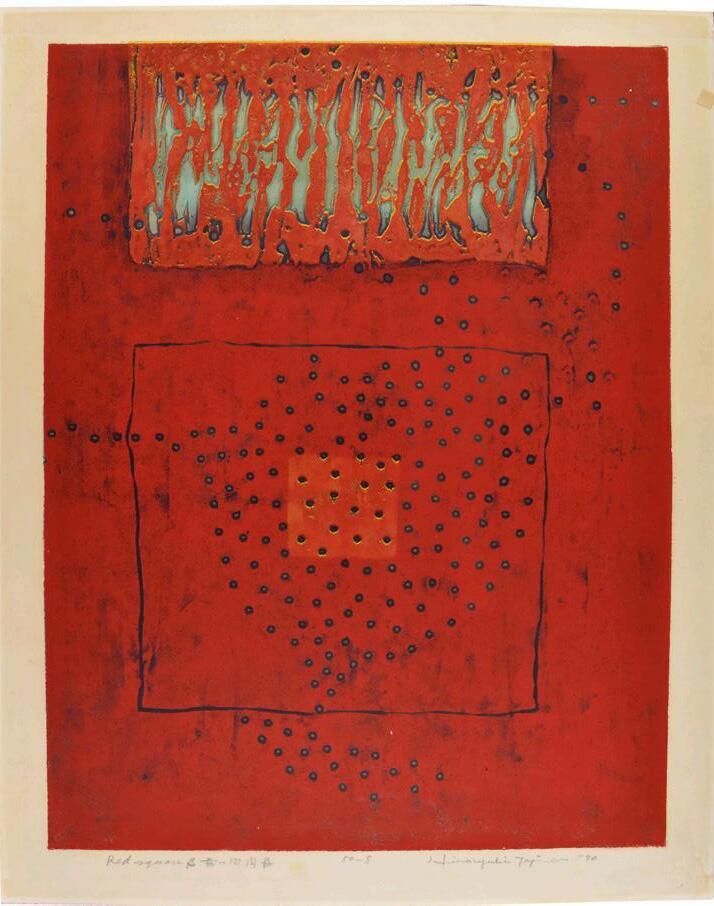
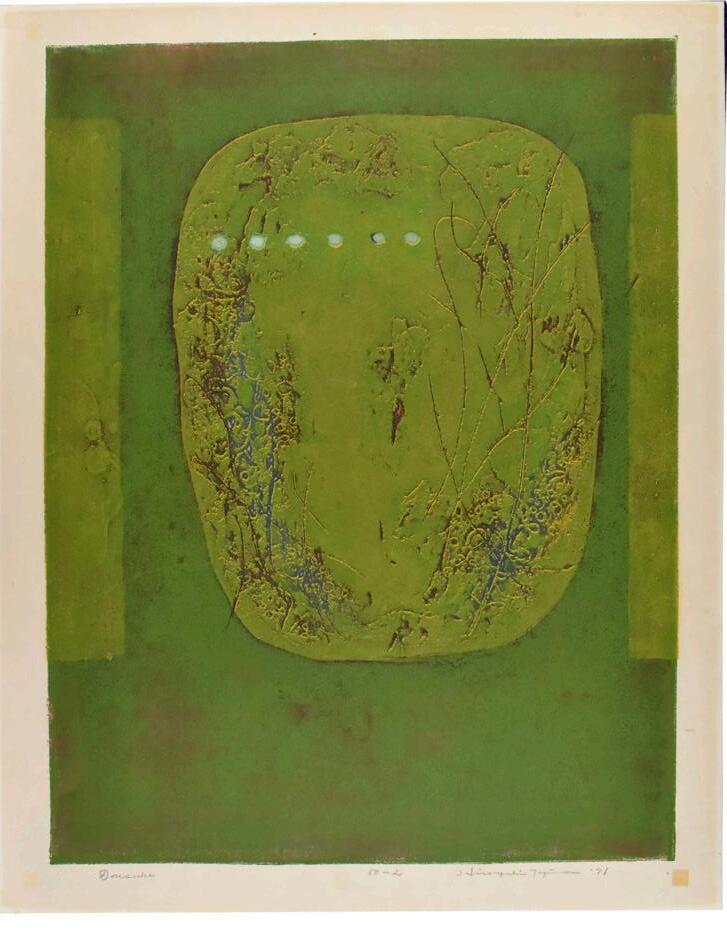



261Ω
UTAGAWA HIROSHIGE (1797-1858)
EDO PERIOD (1615-1868), 1830S
An oban yoko-e triprych print titled Onna gyoretsu Takanawa no zu (Female Processions: the View of Takanawa), depicting a wedding procession consisting entirely of women traveling along the Tokaido Road, creating a splendid scene against the coastline of Takanawa, censor’s seal kiwame, published by Sanoya Kihei; signed Hiroshige ga (3)
The right sheet: 25.5cm x 38.3cm; the middle sheet: 26cm x 38.5cm; the left sheet: 26.2cm x 38.5cm
£6,000-8,000
For another impression, see Alfred Haft, Hiroshige: artist of the open road, exhibition catalogue, London, The British Museum Press, 2025, pp.82 and 83, cat.no.48
262Ω
UTAGAWA HIROSHIGE (1797-1858)
EDO PERIOD (1615-1868), DATED 1858
An oban tate-e print of Nihonbashi itchome ryakuzu (View of Nihonbashi-Tori 1-chome) from the series Edo meisho hyakkei (100 Famous Views of Edo), depicting a hot summer day on the bustling main street of Edo near Nihonbashi Bridge, where townspeople seek shade under parasols, including a group of Sumiyoshi dancers under a huge two-tiered parasol, with date seal Horse 8 (1858), published by Uoya Eikichi, signed Hiroshige ga
35.6cm x 23.5cm
£12,000-15,000
For another comparable first edition print and similarly well-preserved colours, see Ichikawa Shinya et al., Hara Yasusaburo Korekushon: Hiroshige bibiddo (Hara Yasusaburo Collection: HIROSHIGE VIVID), exhibition catalogue, Tokyo, TBS Television, 2016, p.189
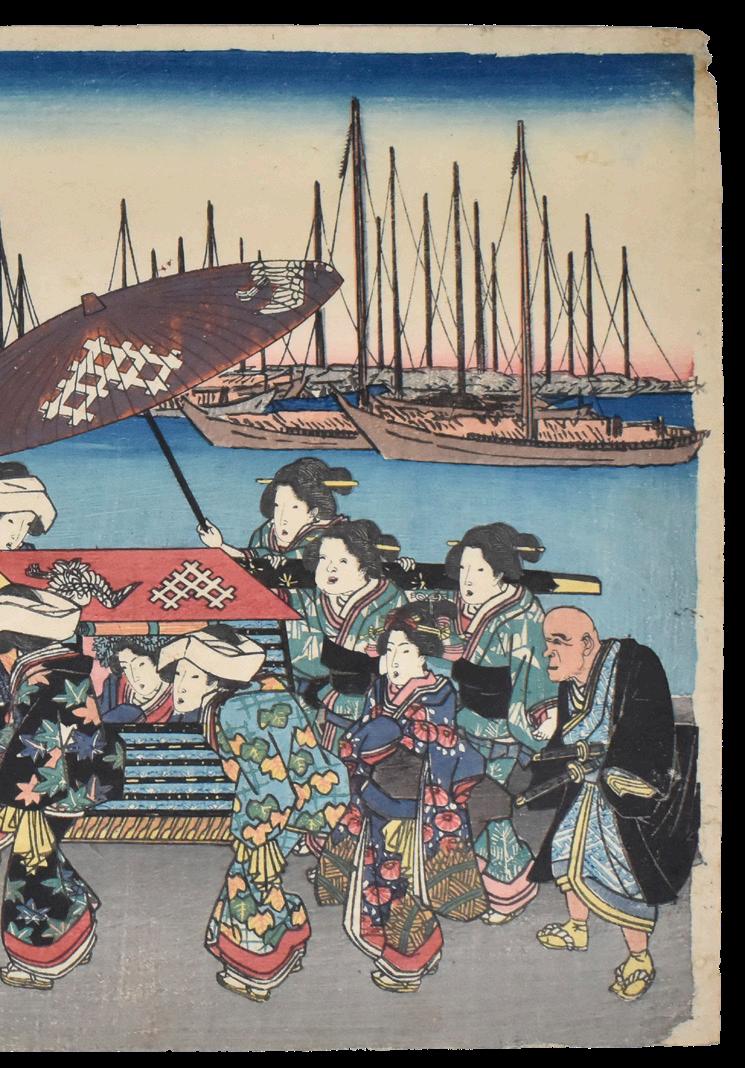

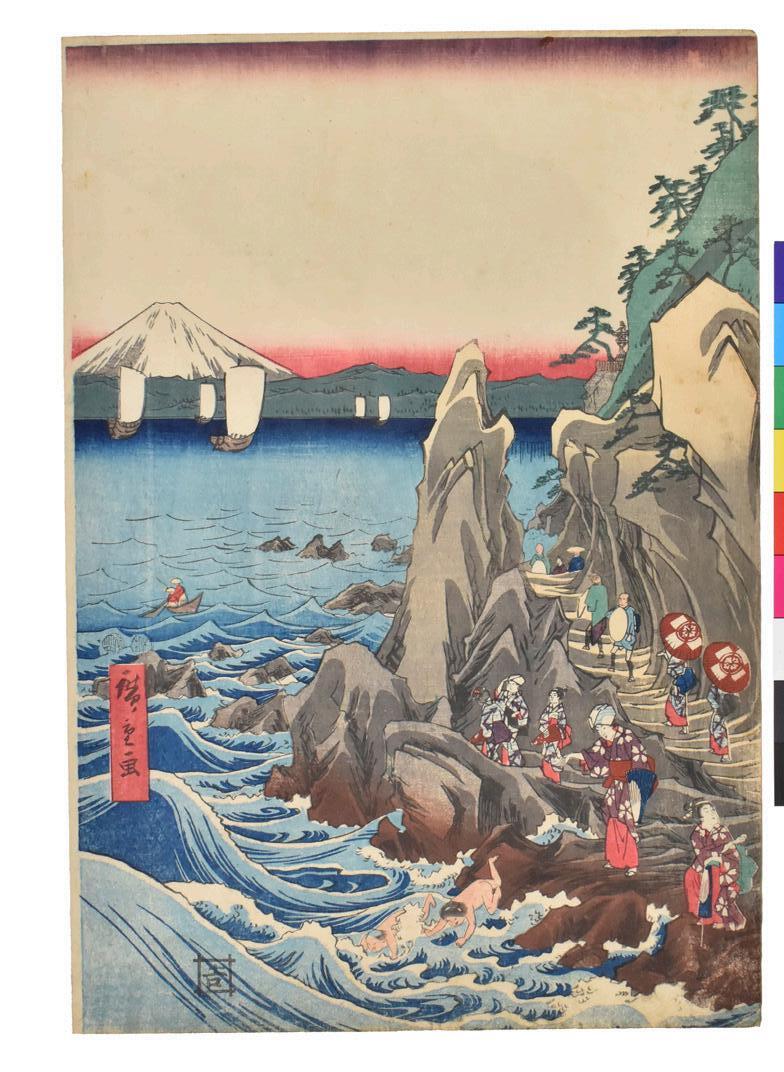
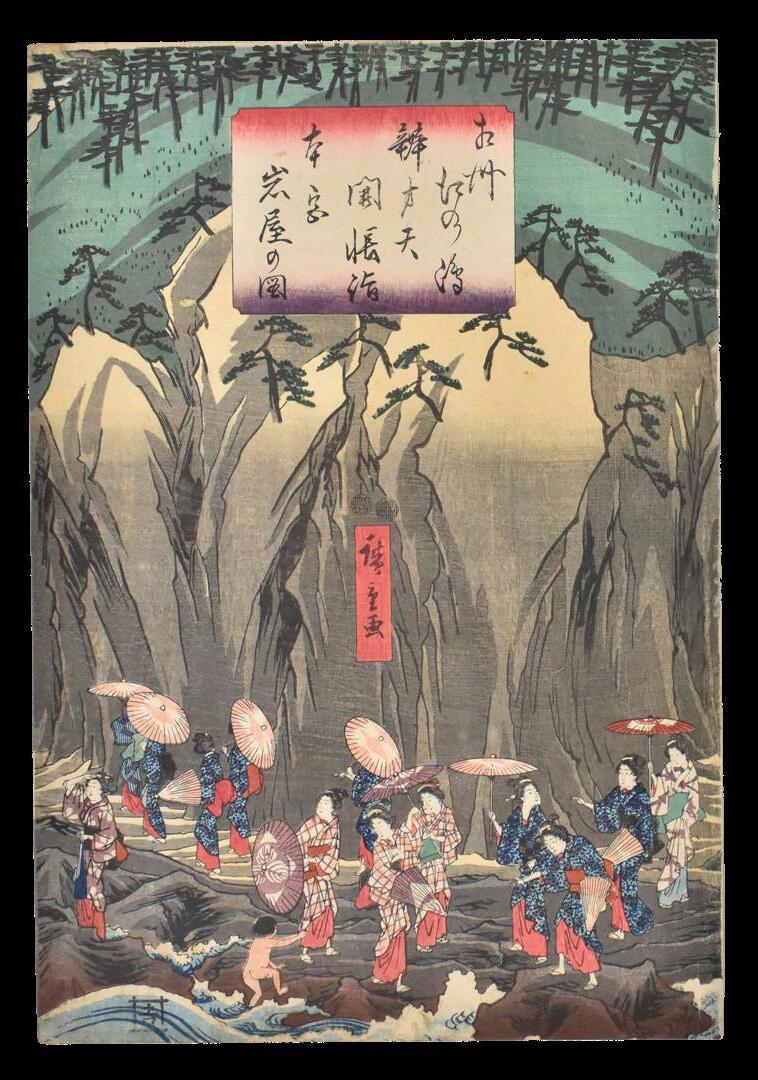

UTAGAWA HIROSHIGE (1797-1858)
EDO PERIOD (1615-1868), CIRCA 1851
An oban tate-e triptych print titled Soshu Enoshima Benzaiten kaicho moude Hongu Iwaya no zu (Pilgrimage to the Exhibition at Benzaiten Shrine on Enoshima, Sagami Province: Picture of the Grotto at the Main Shrine), showing groups of pilgrims crossing a rocky causeway to visit the Benzaiten Shrine at low tide, censor’s seals Murata and Kinugasa, published by Sumiyoshiya Masagoro; signed Hiroshige ga (3)
Each sheet approx. 36.6cm x 25cm
£9,000-12,000
NEOLITHIC 新石器時代
c.6500-1700 BC
XIA DYNASTY 夏
c.2100-1600 BC
SHANG DYNASTY 商
c.1600-1100 BC
ZHOU DYNASTY 周 c.1100-221 BC
Western Zhou 西周 c.1100-771 BC
Eastern Zhou 東周 770-256 BC
Spring and Autumn Period 春秋 770-476 BC
Warring States Period 戰國 475-221BC
QIN DYNASTY 秦 221-206 BC
HAN DYNASTY 漢 206 BC-AD 220
Western Han西漢 206 BC - AD 8
Eastern Han 東漢 AD 25-220
THREE KINGDOMS 三國
220-280
Wei 魏 220-265
Shu Han 蜀漢 221-263
Wu 吳 222-280
JIN DYNASTY 晉 265-420
Western Jin 西晉 265-317
Sixteen Kingdoms 十六國 304-439
Eastern Jin 東晉 317-420
SOUTHERN DYNASTIES 南朝 420-589
Liu Song 劉 宋 420-479
Southern Qi 南齊 479-502
Liang 梁 502-557
Chen 陳 557-589
NORTHERN DYNASTIES 北朝
386-581
Northern Wei 北 魏 386-534
Eastern Wei 東魏 534-550
Western Wei 西魏 535-556
Northern Qi 北齊 550-577
Northern Zhou 北周 557-581
SUI DYNASTY 隋 581-618
TANG DYNASTY 唐 618-907
FIVE DYNASTIES 五代 907-960
Later Liang 後梁 907-923
Later Tang 後唐 923-936
Later Jin 後晉 936-946
Later Han 後漢 947-950
Later Zhou 後周 951-960
LIAO DYNASTY 遼 907-1125
SONG DYNASTY 宋 960-1279
Northern Song 北宋 960-1127
Southern Song 南宋 1127-1279
JIN DYNASTY 金 1115-1234
YUAN DYNASTY 元 1271-1368
MING DYNASTY 明1368-1644
Hongwu 洪武 1368-1398
Jianwen 建文 1399-1402
Yongle 永樂 1403-1425
Hongxi 洪熙 1425
Xuande 宣德 1462-1435
Zhengtong 正統 1436-1449
Jingtai 景泰 1450-1456
Tianshun 天順 1457-1464
Chenghua 成化 1465-1487
Hongzhi 弘治 1488-1505
Zhengde 正德 1506-1521
Jiajing 嘉靖 1522-1566
Longqing 隆慶 1567-1572
Wanli 萬曆 1573-1620
Taichang 泰昌 1620
Tianqi 天啓 1621-1627
Chongzhen 崇禎 1628-1644
QING DYNASTY 清 1644-1911
Shunzhi 順治 1644-1661
Kangxi 康熙 1662-1722
Yongzheng 雍正 1723-1735
Qianlong 乾隆 1736-1795
Jiaqing 嘉慶 1796-1820
Daoguang 道光 1821-1850
Xianfeng 咸豐 1851-1861
Tongzhi 同治 1862-1874
Guangxu 光緒 1875-1908
Xuantong 宣統 1908-1911
REPUBLIC OF CHINA 中華民國 1912Hongxian (YUAN SHI KAI) 洪憲 (袁世凱) 1915-1916
PEOPLE’S REPUBLIC OF CHINA 中華民國 1949-

Collectors and collections are esoteric things…. Some people purely collect for the beauty of the object, some collect thematically in colour to match their interior decorator’s scheme, some people chose to collect for the social history that the objects represent. Chinese Export Armorial porcelain encompasses all the aspects above.
The Davidson Collection has focused on looking at the officers, captains and directors of the Honourable East India Company the largest trading company in the world at the time. Specialising on those members involved in the India and China Trade.
The collection has been laid out in this catalogue in chronological order, demonstrating the technical advancement of the Chinese potter in the 18th century, illustrating changes in palette reflecting the change in fashion in Britain throughout the century from imari, famille-verte through to famille-rose decoration.
Simon Davidson has focused on his own maritime interest, Captains, Governors and Supercargoes (the representative of the ship’s owner on board ship) all of which were involved in the trade between Britain and China in the 18th century.
The first piece he bought was a table salt that was commissioned by Captain Sir Robert Preston, (lot 302), who first visited Canton in 1768 as Captain of the Asia. Thus the journey began, researching
and travelling further back in time. Using the seminal works on the subject written by David Sanctuary Howard, Chinese Armorial Porcelain, volumes I & II as a trusty guide to navigate his way around this field.
Davidson went one step further than that, and you will be able to read his extensive research notes listed on each families history in their entirety on the-saleroom.com as the internet is not governed by the constraints of print as we are.
Worthy of note is the voyage of the East Indiaman the Marlborough which was at Canton in 1716. It was commanded by Captain Mathew Martin who ordered an imari service with his arms emblazoned to the centre (lot 268). He was accompanied by John Horsmonden, Supercargo on the same voyage who also ordered another imari service with his arms too (lot 269). Many of these early armorial services are linked by marriages and partnerships, of officers and brothers who served together on the East Indiamen. For those new to this field, I would encourage you to delve into David and Angela Howard’s extensive research on this fascinating subject. The present selection of armorial services with its focus on members of the Honourable East India Company may take you too on your own journey of discovery.

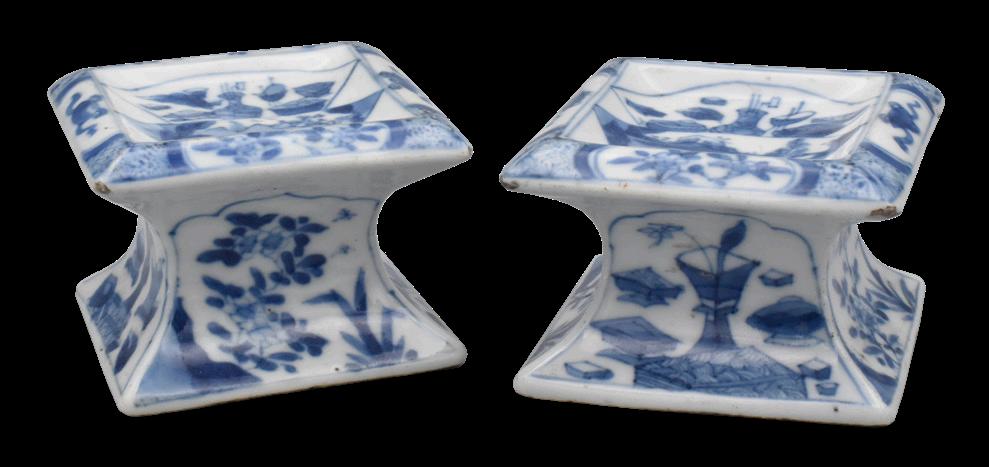

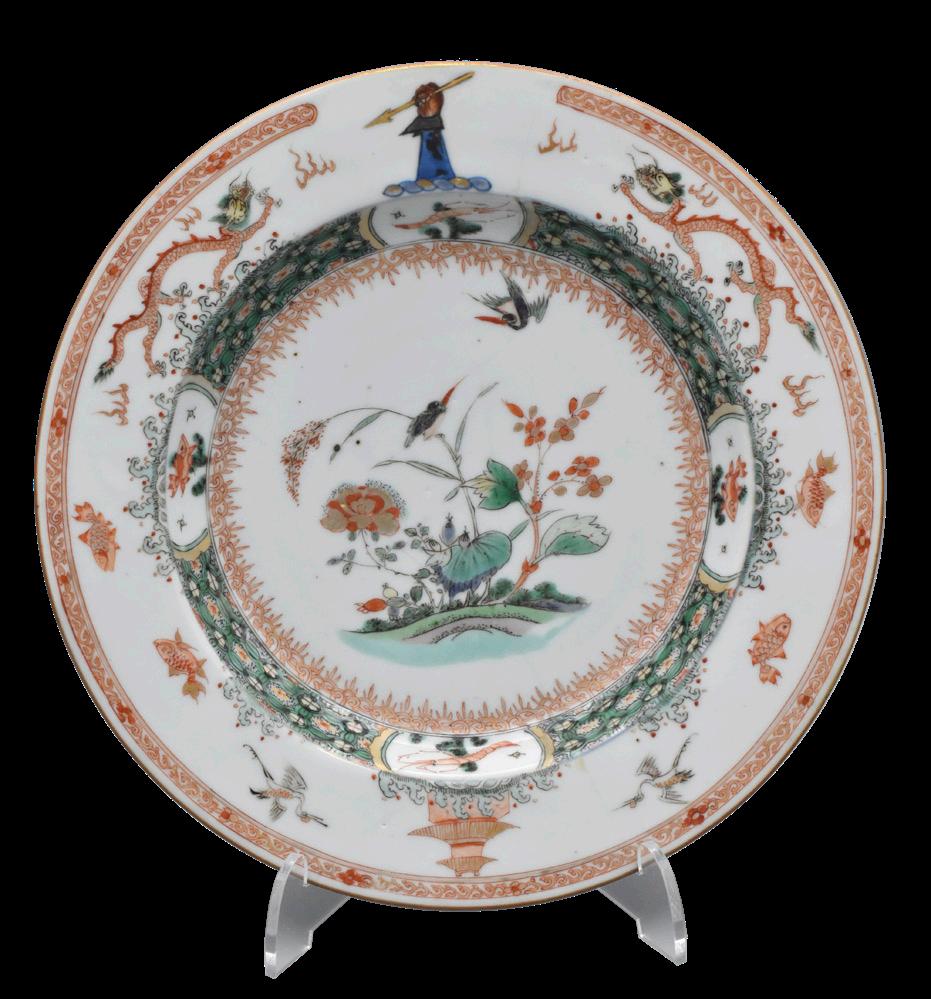
264
KANGXI PERIOD, 1662-1722
Each of waisted square section, well painted with fan-shaped panels of classical antiques and river landscapes
7.5cm by 5cm
Davidson Collection no: 44
Provenance:
Guest & Gray, Y146. A copy of the invoice is available
£200 – 300
265
KANGXI PERIOD, CIRCA 1705
with the arms of Pitt of Ewerne, Stapleton, Dorset, granted in 1604.
Diameter 20cm
Davidson Collection no: 20
Provenance:
Heirloom & Howard, 43363. A copy of the invoice is avalable
This is one of the three earliest Chinese services decorated with British armorials. The service was made for Thomas Pitt, Governor of Fort St. George in Madras 1689-1709. See Chinese Armorial Porcelain, David Sanctuary Howard, London 1974, Vol 1, p.187
£800 – 1,200
266
KANGXI PERIOD, CIRCA 1715
painted with the crest of Edward Harrison, Governor of Fort St George, Madras, 1711-1717, the border painted with dragons, goldfish, cranes and a pagoda, within rouge-de-fer and gilt borders, two floral sprigs to the reverse
Diameter 22.5cm
Davidson Collection: no: 34
Provenance:
Weld Collection
Heirloom & Howard, XSCW25. A copy of the invoice is available
See Chinese Armorial Porcelain, David Sanctuary Howard, London 1974, Vol 1, p.187, C3
£300 – 500
267
A CHINESE PORCELAIN ARMORIAL ‘FAMILLLE-VERTE’ CHARGER,
KANGXI PERIOD, CIRCA 1715
painted with the arms of Harrison impaling Bray within a familleverte border with phoenix, peonies, shrimps and carp, all within blue-line bands
Diameter 35.5cm
Davidson Collection no: 15
Provenance:
This service was made for Governor Edward Harrison, Madras, circa 1715. See Chinese Armorial Porcelain, David Sanctuary Howard, London 1974, Vol 1, p.187, C3
£500-700
268
A CHINESE EXPORT ARMORIAL IMARI PORCELAIN PLATE
KANGXI PERIOD, CIRCA 1716
Painted in the Imari palette with the arms of Captain Matthew Martin, two floral sprigs to the reverse in underglaze-blue
Diameter 22.5cm
Davidson Collection no: 39
Provenance:
Kingschina.co.uk
This service was made for Captain Matthew Martin, who commanded the 34-gun East Indiaman Marlborough which was in Canton in 1716. See Chinese Armorial Porcelain, David Sanctuary Howard, London 1974, Vol 1, p.176--7, B1
£300-500
269
A PAIR OF CHINESE EXPORT ARMORIAL ‘IMARI’ TEA CANNISTERS
KANGXI PERIOD, CIRCA 1716
Painted with the arms of John Horsmonden, supercargo, each of octagonal form painted in the Imari palette
Height 10.5cm
Davidson Collection no: 59
Provenance: Guest & Gray, W484. A copy of the invoice is available
John Horsmonden was the second Supercargo with Captain Matthew Martin on the Marlborough on its voyage to Canton, during the 1715/16 season.
See Chinese Armorial Porcelain, David Sanctuary Howard, London 1974, Vol I, p.176-7, B1
A dish with the Horsmdonden arms can be found in the Victoria & Albert Museum, accession number: FE44-1978
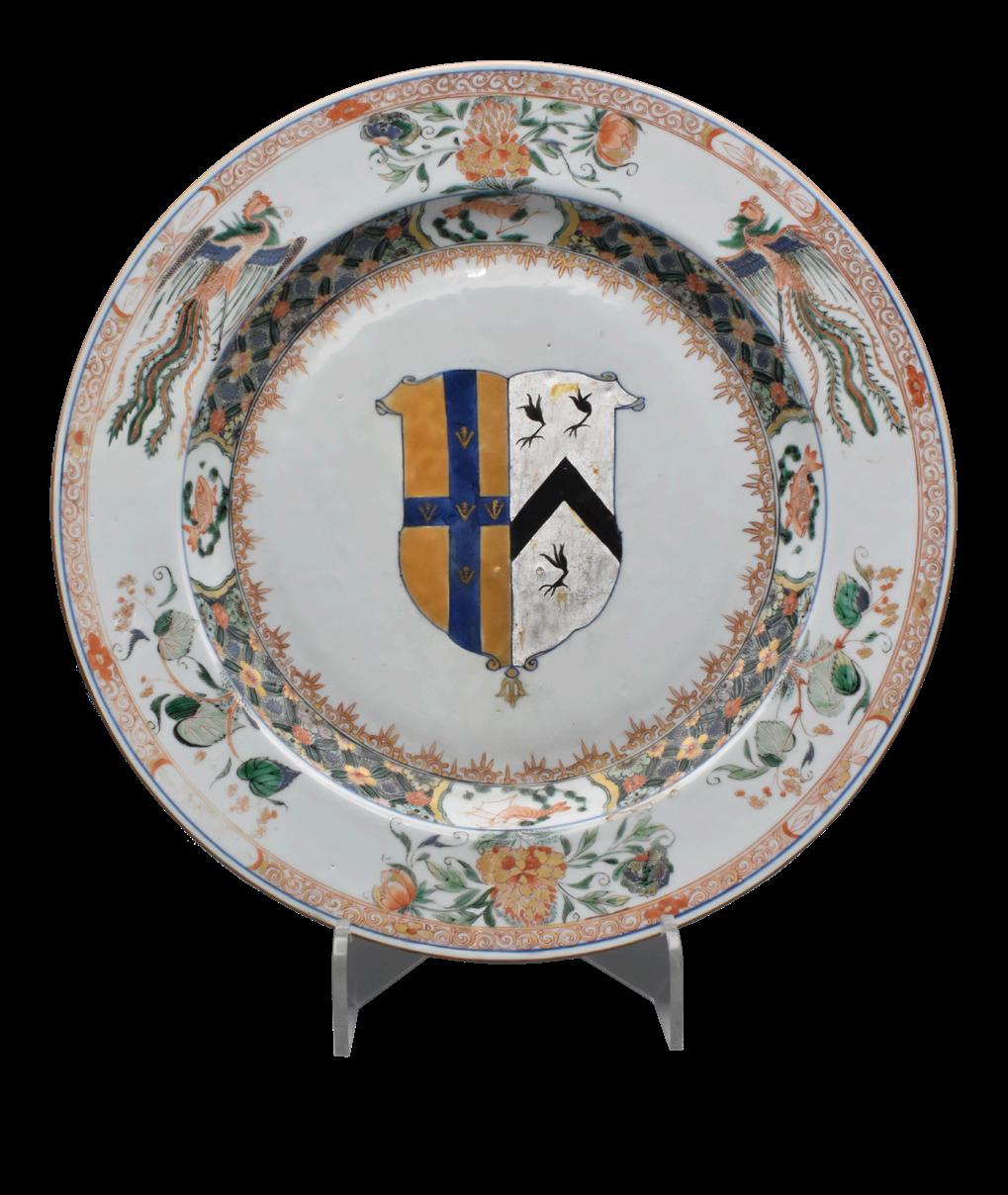

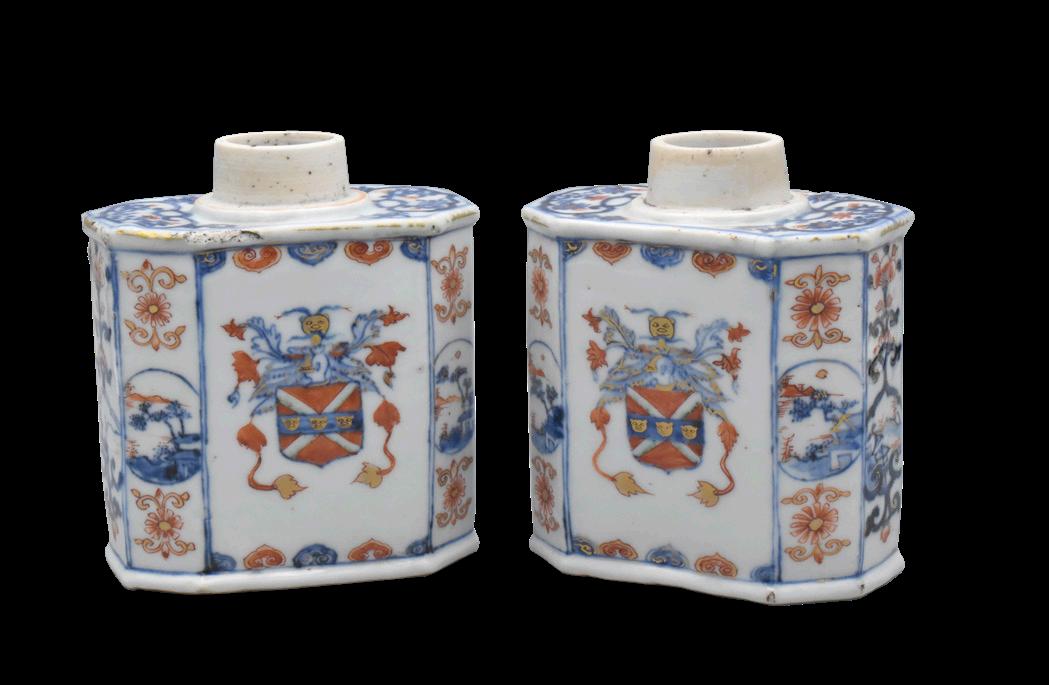
£500-700
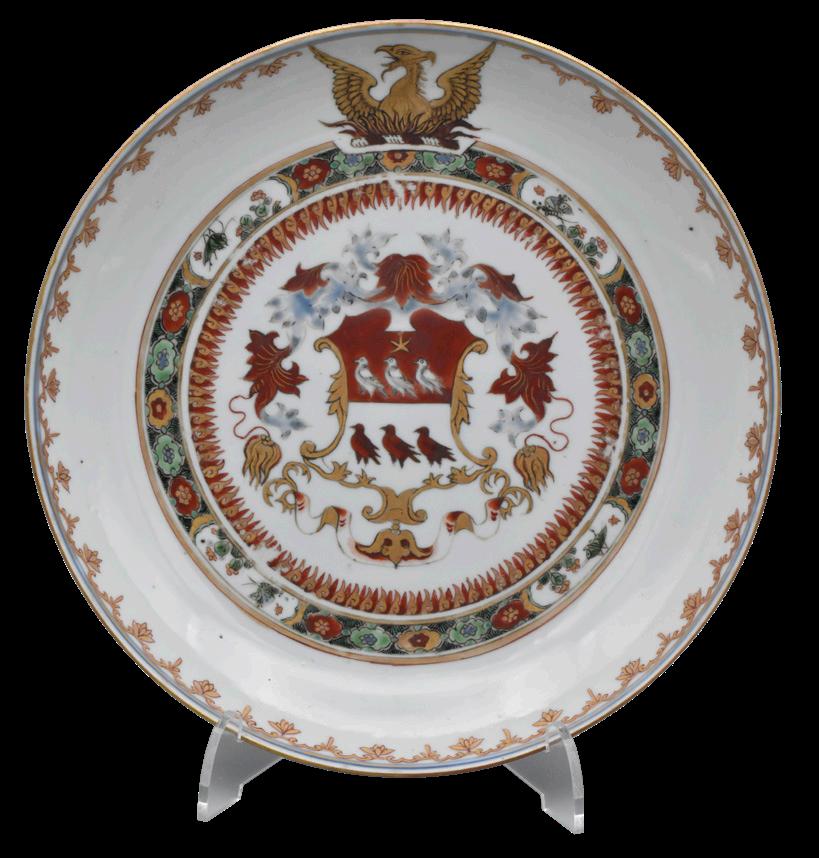
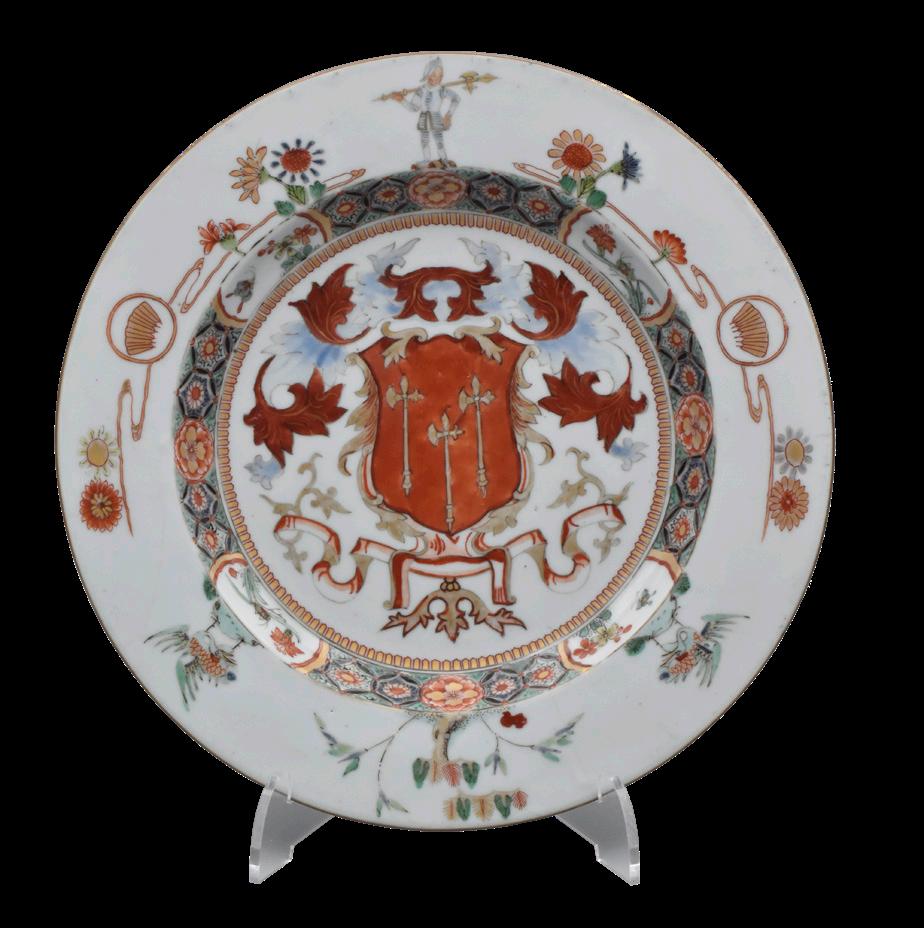
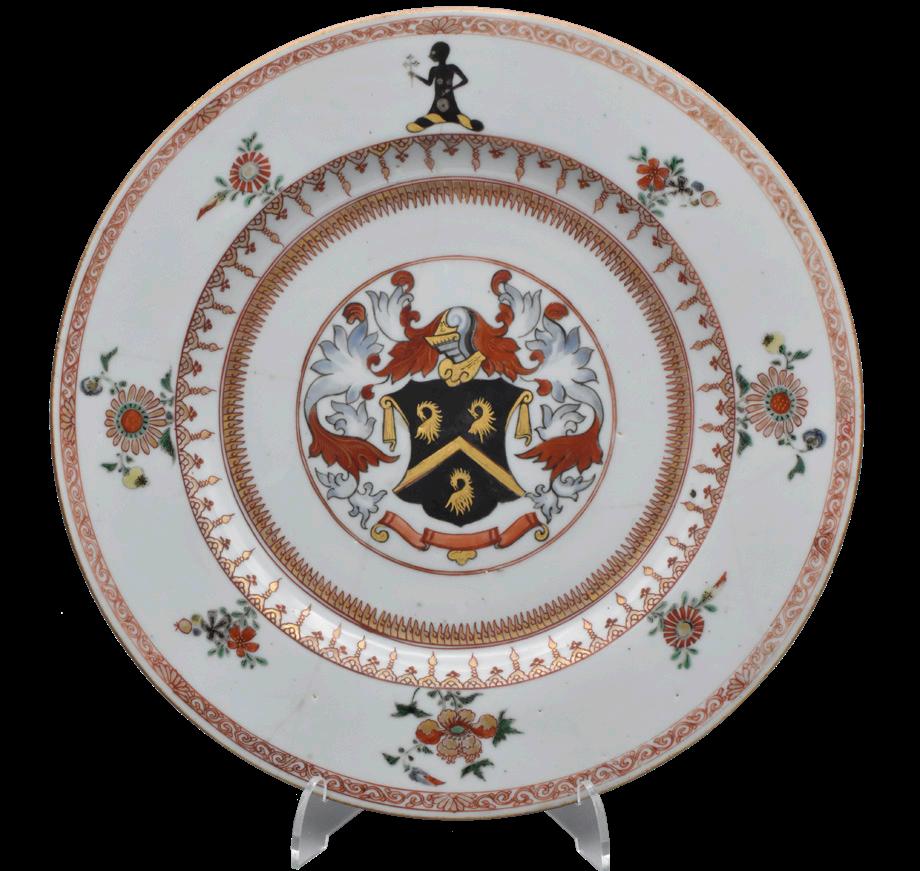
270
A CHINESE EXPORT ‘FAMILLE-VERTE’ PORCELAIN ARMORIAL SAUCER DISH
KANGXI PERIOD, CIRCA 1717
Painted with the arms of Fenwick of Northumberland, within a famille-verte floral band set with four cartouches containing flowers and insects, the cavetto with a phoenix crest, the reverse with a floral border and three rouge-de-fer sprigs
Diameter 21.5cm
Davidson Collection no: 45
Provenance: Guest & Gray, Y573. A copy of the invoice is available. This service was probably made for Mr Fenwick, Chief Supercargo on the East Indiaman Marlborough at Canton in 1716. The other supercargoes on board were: Peter Godfrey and Rowland Ainsworth. See Chinese Armorial Porcelain, David Sanctuary Howard, London 1974, Vol 1, p.188, C3
£400-600
271
A CHINESE EXPORT ‘FAMILLE-VERTE’ ARMORIAL PORCELAIN PLATE
KANGXI PERIOD, CIRCA 1718
Painted with the arms of Ainsworth of Lancashire in the famille-verte palette with a foliate border to the cavetto enclosing four vignettes with flowers and insects, the rim with a crest flanked by flowers, cloud scrolls and cranes, the reverse with three floral sprigs
Diameter 22.5cm
Davidson Collection no: 35
Provenance: Heirloom & Howard, 43393
This service was almost certainly made for Rowland Ainsworth, (his father was a Director of the Honourable East India Company) See Chinese Armorial Porcelain, David Sanctuary Howard, London 1974, Vol 1, p.188, C3
£300 – 500
272
A CHINESE EXPORT ‘FAMILLE-VERTE’ PORCELAIN ARMORIAL PLATE
KANGXI PERIOD, CIRCA 1720
Painted with the arms of Godfrey predominantly in rouge-de-fer, with a crest and chrysanthemum flowers to the border, two floral sprigs to the reverse
Diameter 28.4cm
Davidson Collection no: 43
Provenance: John Foster Collection
Weld Collection
Heirloom & Howard, XSCW202
Literature: Chinese Armorial Porcelain, Vol. I, illustrated p. 190. This service was made for Peter Godfrey, who was supercargo for voyage season 1715-16 on the East Indiaman the Marlborough, bound for Madras and Canton. See Chinese Armorial Porcelain, David Sanctuary Howard, London 1974, Vol 1, p.190 C3
£300-500
273
A CHINESE EXPORT ARMORIAL ‘IMARI’ PORCELAIN CREAM JUG
KANGXI PERIOD, CIRCA 1720
Painted to one side with the arms of Raymond in a circular cartouche, the other side with day Lillies and chrysanthemums
Height 10.5cm
Davidson Collection no: 61
Provenance: Heirloom & Howard, 43769
This service was made for Col. Hugh Raymond who was one of the central figures in the management of the East India Company.
See Chinese Armorial Porcelain, David Sanctuary Howard, London 1974, Vol 1, p.182, B6
£300-500
274
A CHINESE EXPORT ‘FAMILLE-VERTE’ PORCELAIN ARMORIAL DISH
YONGZHENG PERIOD, CIRCA 1723
Of octagonal form, painted with the arms of Burrell impaling Raymond within a rouge-de-fer border of prunus and peony
Diameter 30.6cm
Davidson Collection no: 7
Hugh Raymond of Saling Hall, Essex and Langley Park, Kent had been an East India Company Commander and was Captain of the Duchess (1). See Chinese Armorial Porcelain, David Sanctuary Howard, London 1974, Vol 1, p.192, D1.
1: A Farrington, Biographical Index of East India Company Maritime Service 1600-1834, London 1999, p 652
£400-600
275
A CHINESE EXPORT ‘ROSE VERTE’ PORCELAIN ARMORIAL PLATE
YONGZHENG PERIOD, CIRCA 1724
painted with the arms of Pinnell impaling Hambley in a circular cartouche, the rim with a band of precious objects and stylised lotus flowers, the reverse with four floral sprigs
Diameter 24.5cm
Davidson Collection no: 46
Provenance:
The Weld Collection
Heirloom & Howard XSCW212
This service was made for Captain Richard Pinnell of the East India Company who died at the end of January 1738. See Chinese Armorial Porcelain, David Sanctuary Howard, London 1974, Vol 1, p.183, B7
£300-500
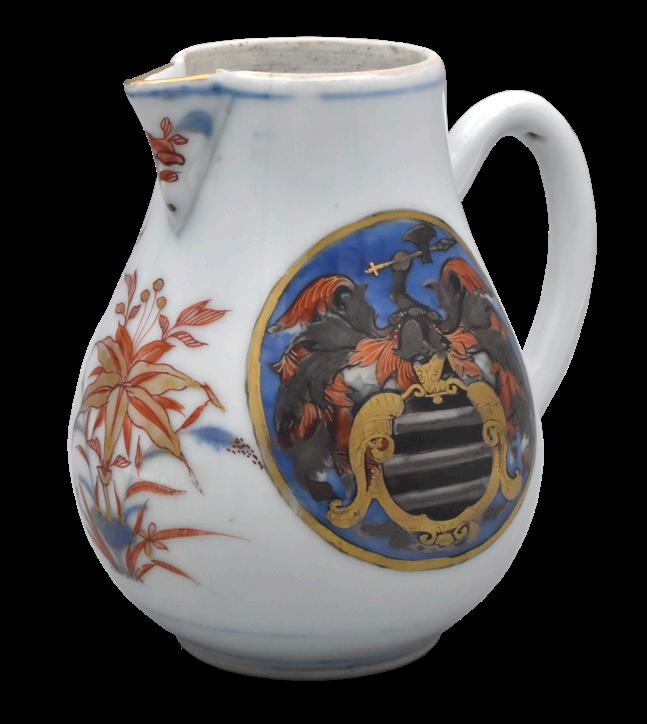

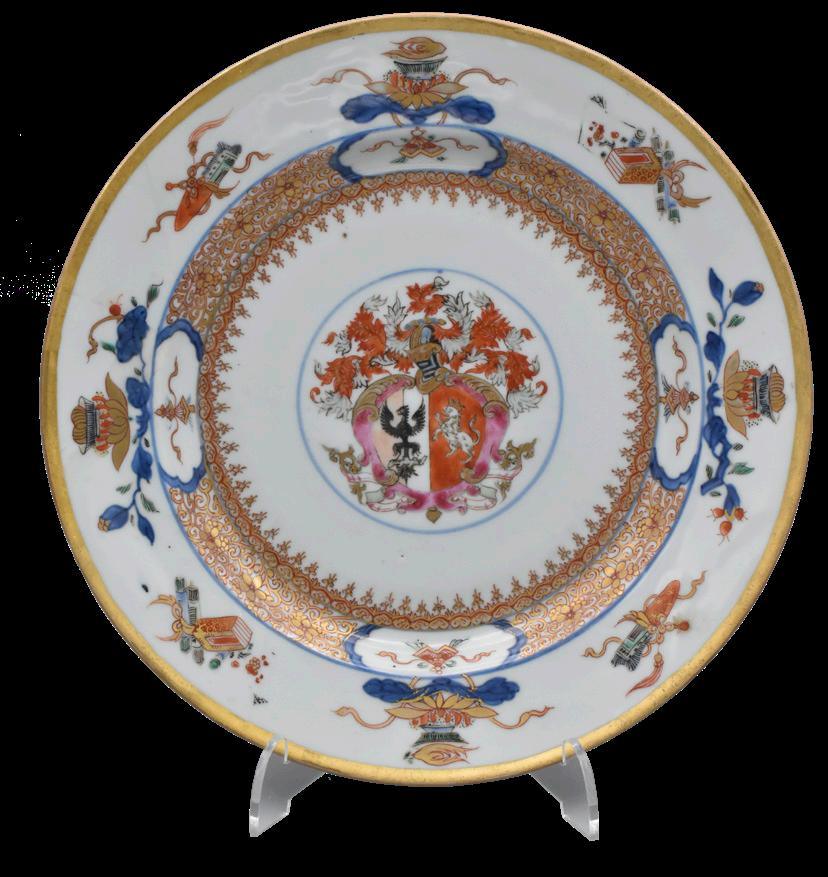
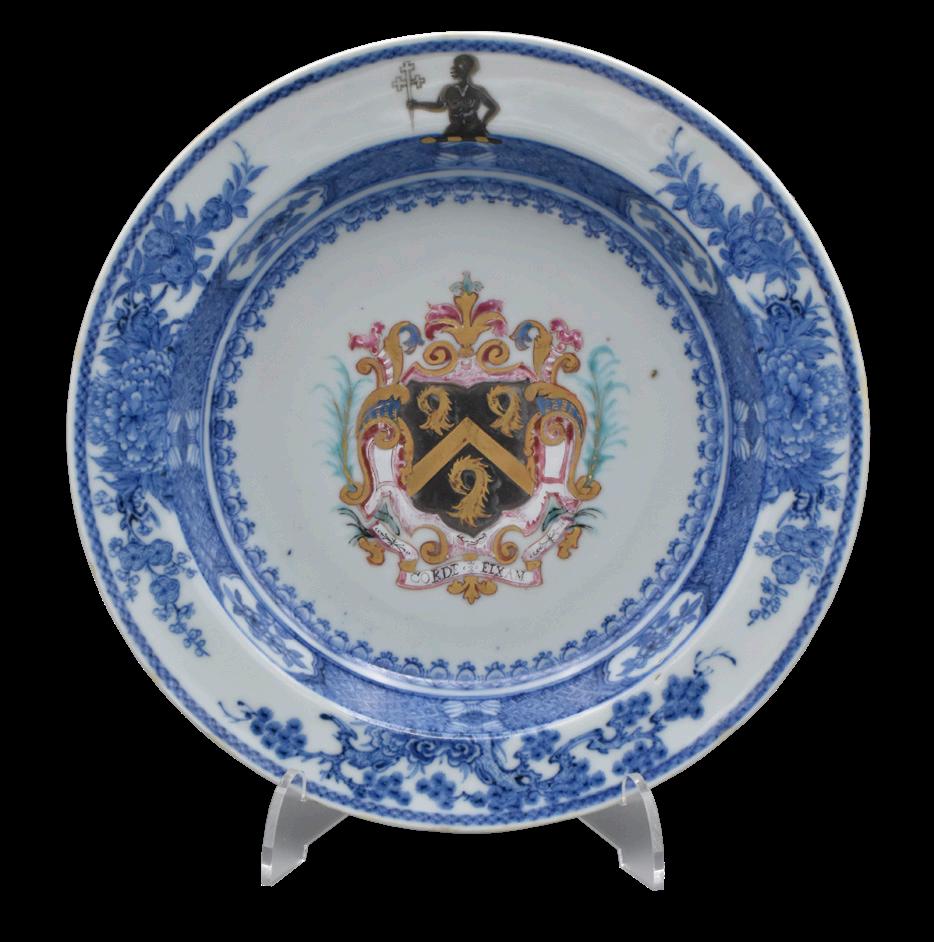

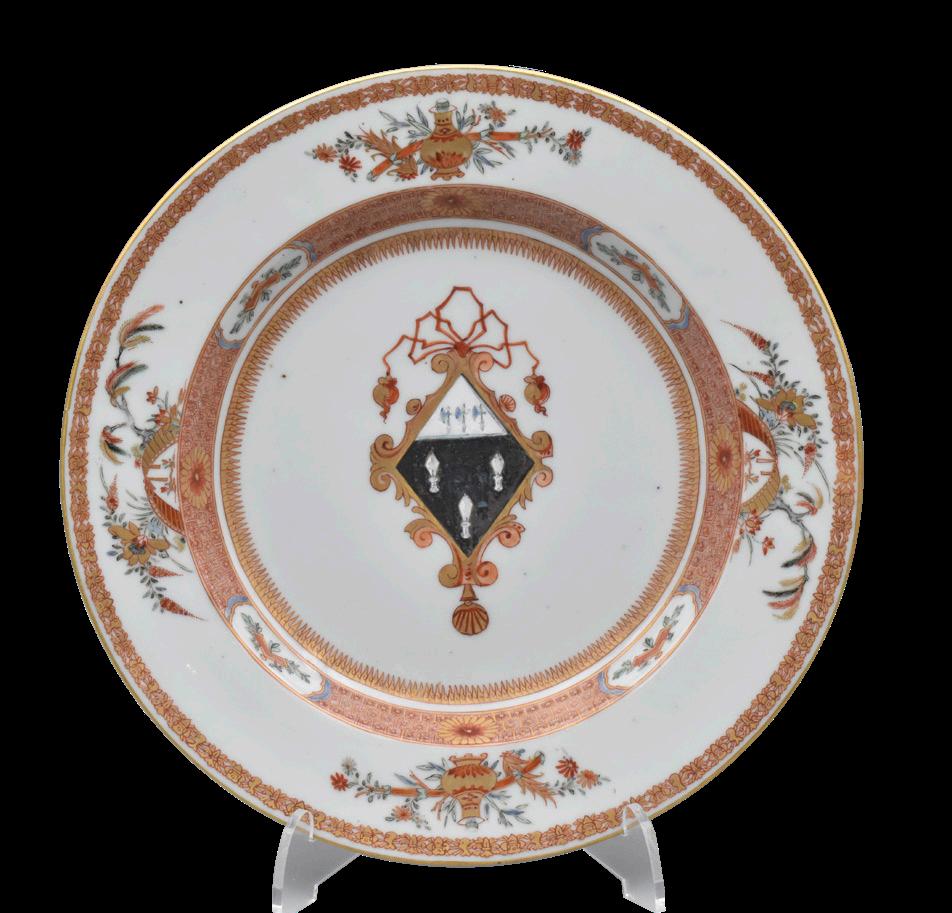
276
YONGZHENG PERIOD, CIRCA 1725
Painted with the arms of Godfrey in famille-rose enamels within an underglaze-blue border set with a crest
Diameter 21.7cm
Davidson Collection no: 40
Provenance:
Weld Collection
Heirloom & Howard, XSCW259
One of five services ordered at this time by the family of Peter Godfrey, Chief Supercargo in Canton, Chief of Council in 1728. This service possibly ordered by Edmund Godfrey, who was supercargo on the Prince Augustus in the 1726/27 voyage season. See Chinese Armorial Porcelain, David Sanctuary Howard, London 1974, Vol 1, p.172, A5
£200-300
277
KANGXI PERIOD, CIRCA 1725
of footed baluster form, boldly painted with peonies, pomegranate and finger citron, issuing from a rocky mound
Height 12cm
Davidson Collection no: 62
Provenance:
Phillip Carrol. A copy of the invoice is available
£80 - £120
278
A CHINESE EXPORT ‘ROSE VERTE’ ARMORIAL PORCELAIN PLATE, YONGZHENG PERIOD, CIRCA 1727
Painted with the arms of King, all within a rouge-de-fer and gilt floral border with classical antiques and bamboo bridges
Diameter 22.5cm
Davidson Collection no: 47
Provenance:
Heirloom & Howard, 43489
This service was made for the daughter of Baron King of Ockham, Lord Chancellor who ordered a similar service for himself. Uniquely for any armorial set, these two services are listed in the Canton Journal of 20th December 1727, where it is recorded that they were loaded that day onto the East Indiaman Prince Augustus. See Chinese Armorial Porcelain, David Sanctuary Howard, London 1974, Vol 1, pages 202-203, D2
£400-600
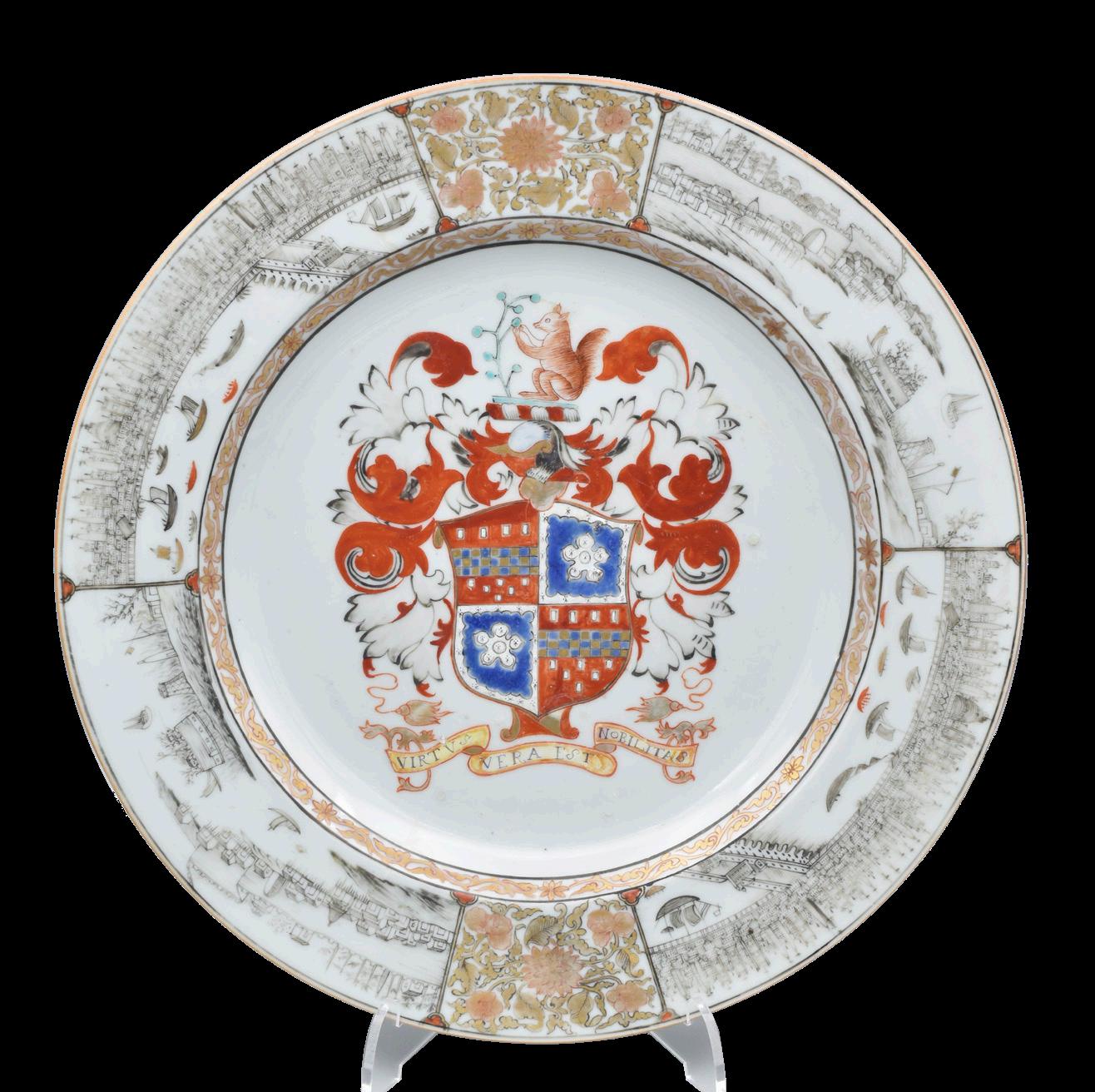
279
A RARE CHINESE EXPORT ARMORIAL PORCELAIN PLATE
YONGZHENG PERIOD, CIRCA 1735
Painted with the arms of Lee of Coton quartering Astley, the rim with a unique design of opposing scenes of the Canton waterfront with the Dutch folly fort and the City of London from the Thames with St Pauls Cathedral and the many spires of the Wren churches, with rouge-de-fer and gilt floral borders
Diameter 28.5cm
Davidson Collection no 9
Provenance:
Heirloom & Howard, XSMC1
Made for Eldred Lancelot Lee. Eldred Lancelot Lee of Coton Hall, near Bridgenorth, Shropshire was born in 1650 and married Isabella Gough in 1713, sister of Captain Harry Gough of the East India Maritime service and from 1730 a Director of the Company. Almost certainly Captain Gough organized the ordering and delivery of the armorial service from Canton. See Chinese Armorial Porcelain, David Sanctuary Howard, London 1974, Vol 1, p.329, J6
£1,000-1,500
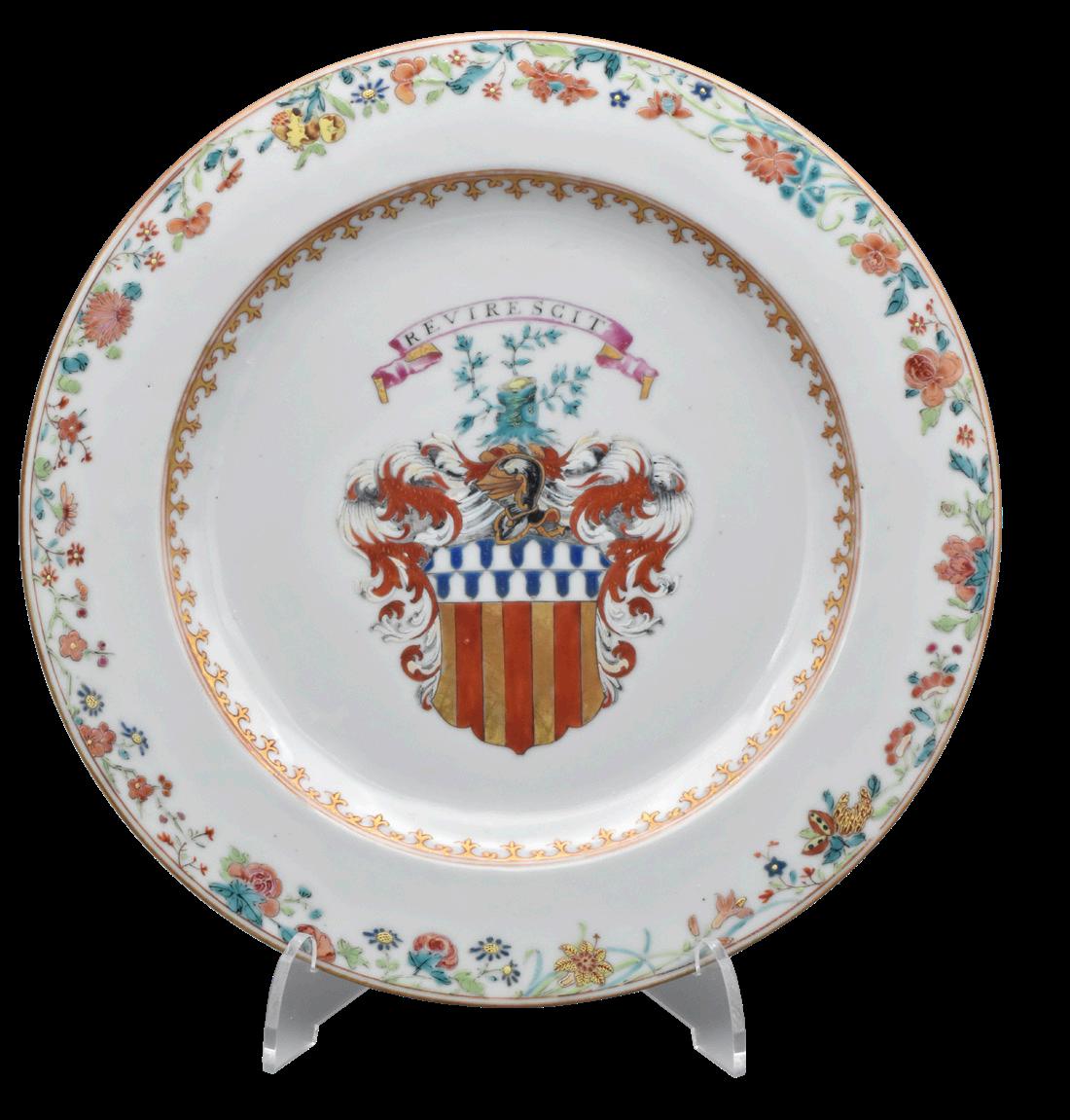
280
A CHINESE EXPORT ‘FAMILLE-ROSE’ ARMORIAL PORCELAIN PLATE
QIANLONG PERIOD, CIRCA 1740
Painted with the arms of Belcher or Belshes family, within a rouge-de-fer and gilt spearhead band, the rim with flowers and pomegranates
Diameter 22.8cm
Davidson Collection no: 38
Provenance: Jorge Welsh, invoice no 0111
This service was ordered by William Belsches a surgeon, resident in Calcutta from 1740 and later from 1742 at Fort St David, Cuddalore, south of Madras. See Chinese Armorial Porcelain, David Sanctuary Howard, London 2003, Vol II, p.289, P8
£300-500

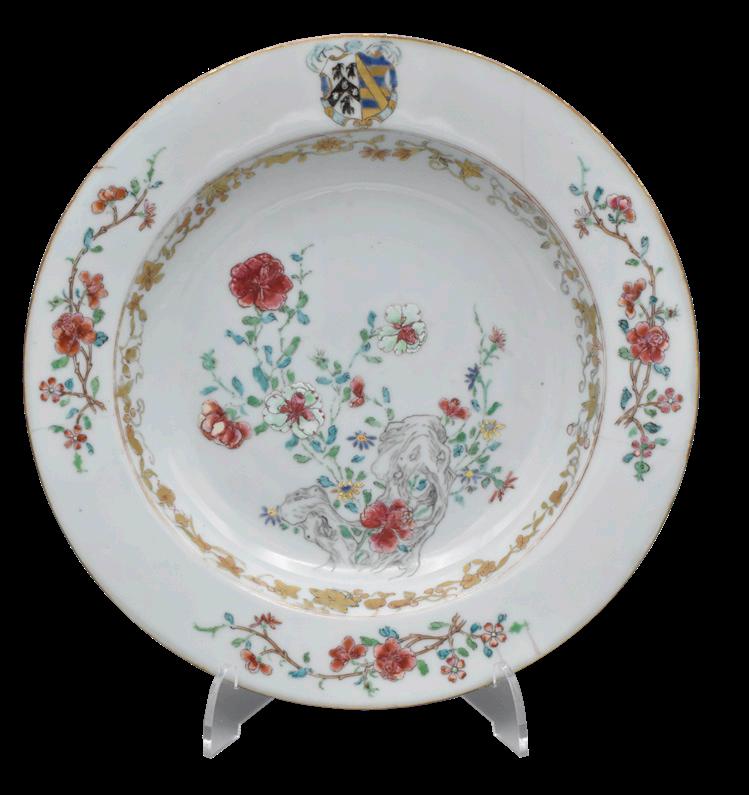


281
A CHINESE EXPORT ‘FAMILLE-ROSE’ ARMORIAL PLATE
QIANLONG PERIOD, CIRCA 1740
Painted with the arms of Ramsay in a rococo cartouche with the face of a chinaman, the rim set with three finely painted floral sprays, gilt spearhead border
Diameter 22.6cm
Davidson Collection no: 50
Provenance:
Christopher M. Weld Collection Heirloom & Howard, 44231
This service was made for Captain John Ramsay of the East India Company. The unusual rococo shield, with a Chinaman’s head at the apex, is unique on Chinese armorial porcelain. See Chinese Armorial Porcelain, David Sanctuary Howard, London 1974, Vol I, p.484, P20
£300-500
282
A CHINESE EXPORT ‘FAMILLE-ROSE’ ARMORIAL SOUP PLATE
QIANLONG PERIOD, CIRCA 1740
Painted with the arms of Samuel Benson to the rim, the centre painted with peony issuing from rockwork
Diameter 22.6cm
Davidson Collection no: 63
Provenance:
Ben Cooper Antiques, P10
See Chinese Armorial Porcelain, David Sanctuary Howard, 2003, Vol II, P.268, O4
£100-200
283
A CHINESE EXPORT ‘FAMILLE-ROSE’ PORCELAIN ARMORIAL SALT
QIANLONG PERIOD, CIRCA 1745
Painted with the arms of Hibbs of Kent and the motto: ‘Love and Fidelity’ surrounded by cranes and mandarin ducks in a lotus pond
Diameter 8cm
Davidson Collection no: 32
Provenance: Heirloom & Howard, 43633
See Chinese Armorial Porcelain, David Sanctuary Howard, London 1974, Vol I, p.292, G2
£200 – 300
283A
A CHINESE EXPORT ‘BURGHLEY HOUSE’ BLUE AND WHITE PORCELAIN PLATE
QIANLONG PERIOD, CIRCA 1745
Well painted in underglaze-blue with a representation of the Elizabethan country house, near Stamford, Lincolnshire
Diameter 22.5cm
Davidson Collection no: 23
Provenance:
Jorge Welsh, invoice no. 1/891
£150 – 200
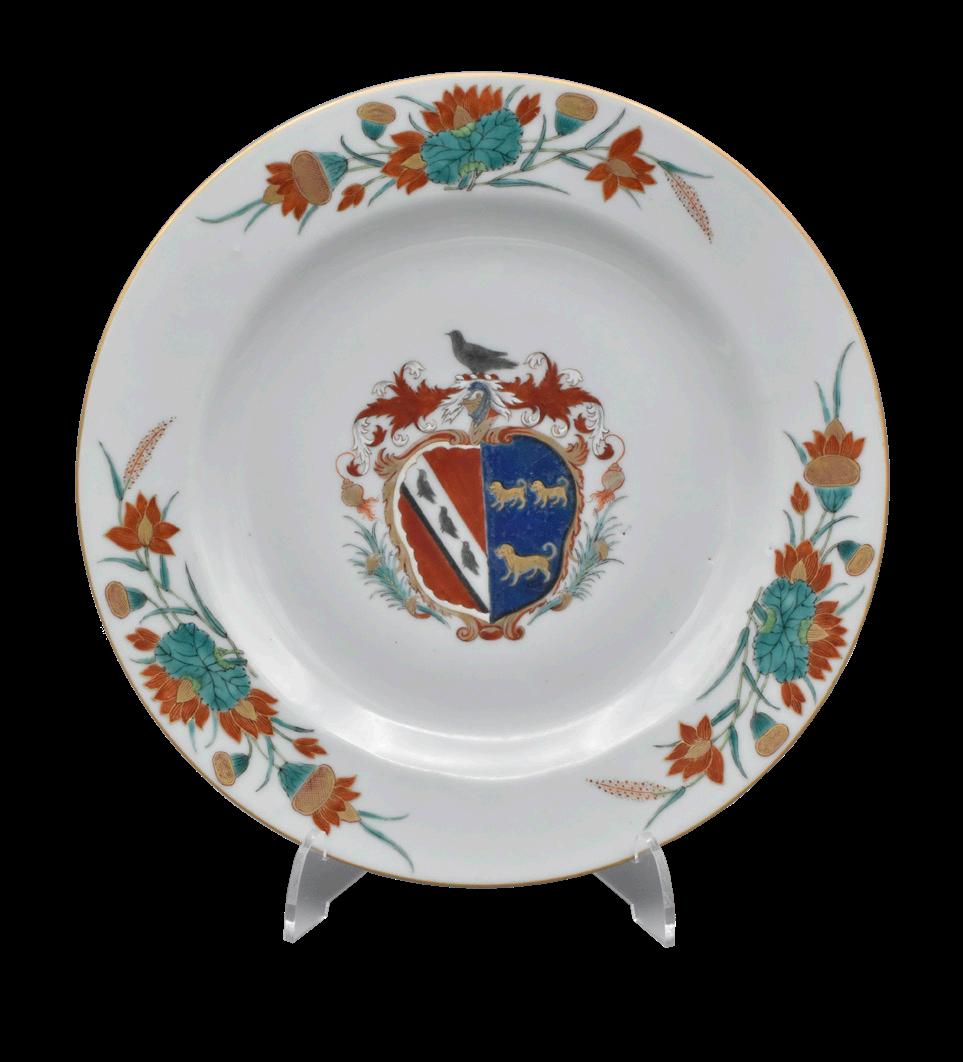

284
A CHINESE EXPORT ARMORIAL CUP AND SAUCER
QIANLONG PERIOD, CIRCA 1745
Painted with the arms of Saunders all within a grisaille Du Paquier style border, with vignettes of billing doves, highlighted in gilding
The saucer 12cm
The cup 7cm (2)
Davidson Collection no: 55
Provenance:
Cohen & Cohen, invoice no. 2066
This service is thought to have been made for Thomas Saunders, Governor of Fort St George, Madras, who married Christian, daughter of Thomas Pitt of Boconoc in Cornwall. See Chinese Armorial Porcelain, David Sanctuary Howard, London 1974, Vol I, p.349, L1
£200-300
285
A CHINESE EXPORT ARMORIAL ‘FAMILLE-ROSE’ PORCELAIN PLATE
QIANLONG PERIOD, CIRCA 1746
Painted with the arms of Bookey impaling Peake, the rim with three vibrant lotus sprigs, brown dressed rim
Diameter 22.8cm
Davidson Collection no: 27
Provenance:
Weld Collection
Heirloom & Howard, XSCW165
This service was made for Captain Mathew Bookey who married Ann, daughter of Thomas Peke. Captain Mathew Bookey commanded the Shaftesbury which reached Whampoa in early 1747, with his younger brother William Bookey as first mate. However, Mathew died while in Canton and the ship returned under the captaincy of his brother. See Chinese Armorial Porcelain, David Sanctuary Howard, London 1974, Vol I, p.396, O3
£400-500
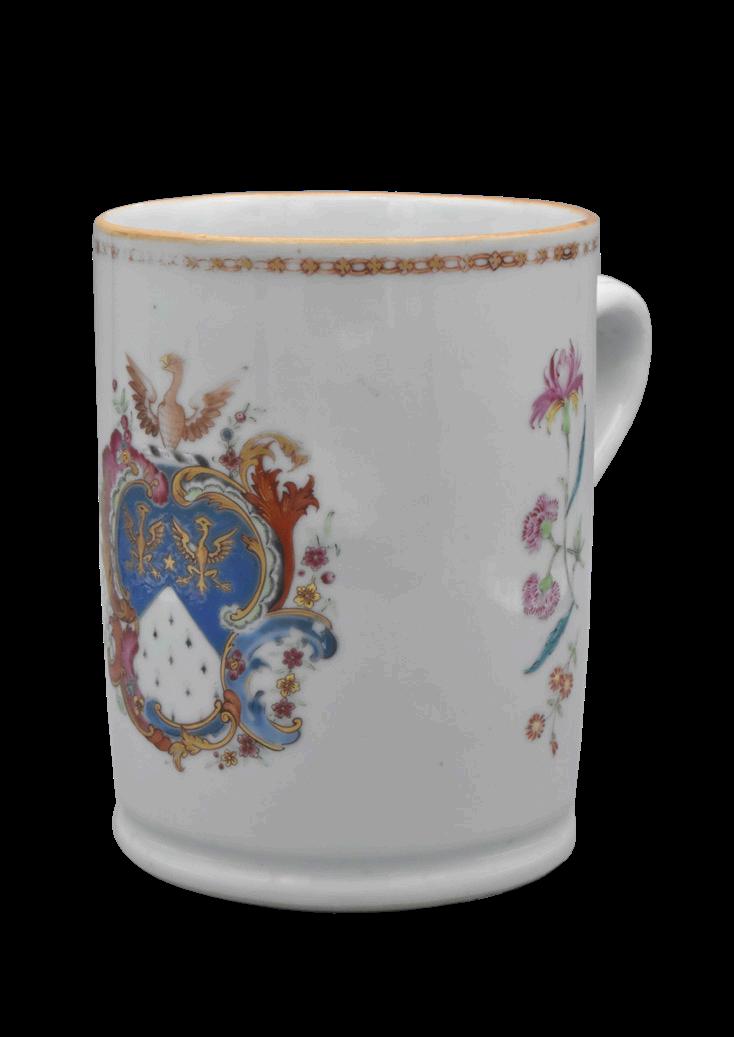
286
A CHINESE EXPORT ARMORIAL ‘FAMILLE-ROSE’ PORCELAIN TANKARD
QIANLONG PERIOD, CIRCA 1749
Painted with the arms of Stephens or Steevens, flanked by two floral sprigs, beneath a rouge-de-fer and gilt band
Height 14cm
Davidson Collection no: 49
Provenance:
Guest & Gray, invoice no. 856
Captain William Steevens appears first in the East India Company service records as the first mate of the Swift in the voyage season of 1741/2. See Chinese Armorial Porcelain, David Sanctuary Howard, London 1974, Vol I, p.559, Q6
£300-400

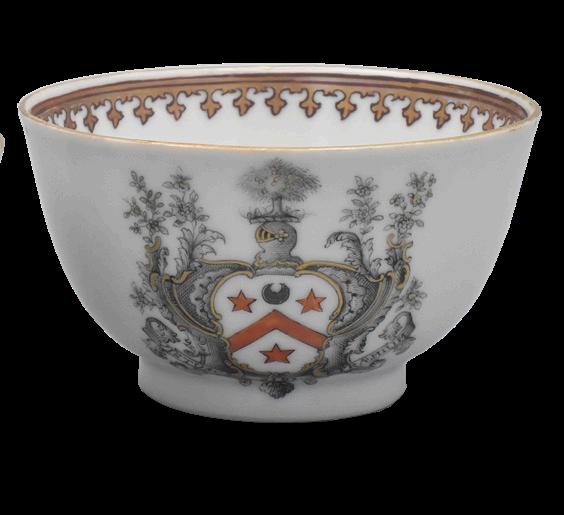
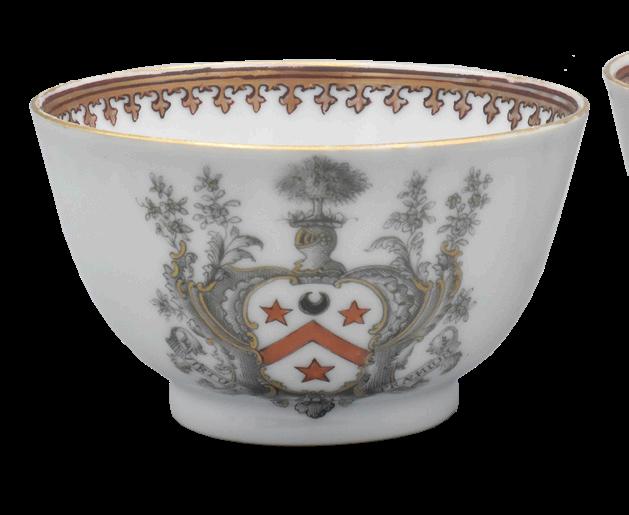
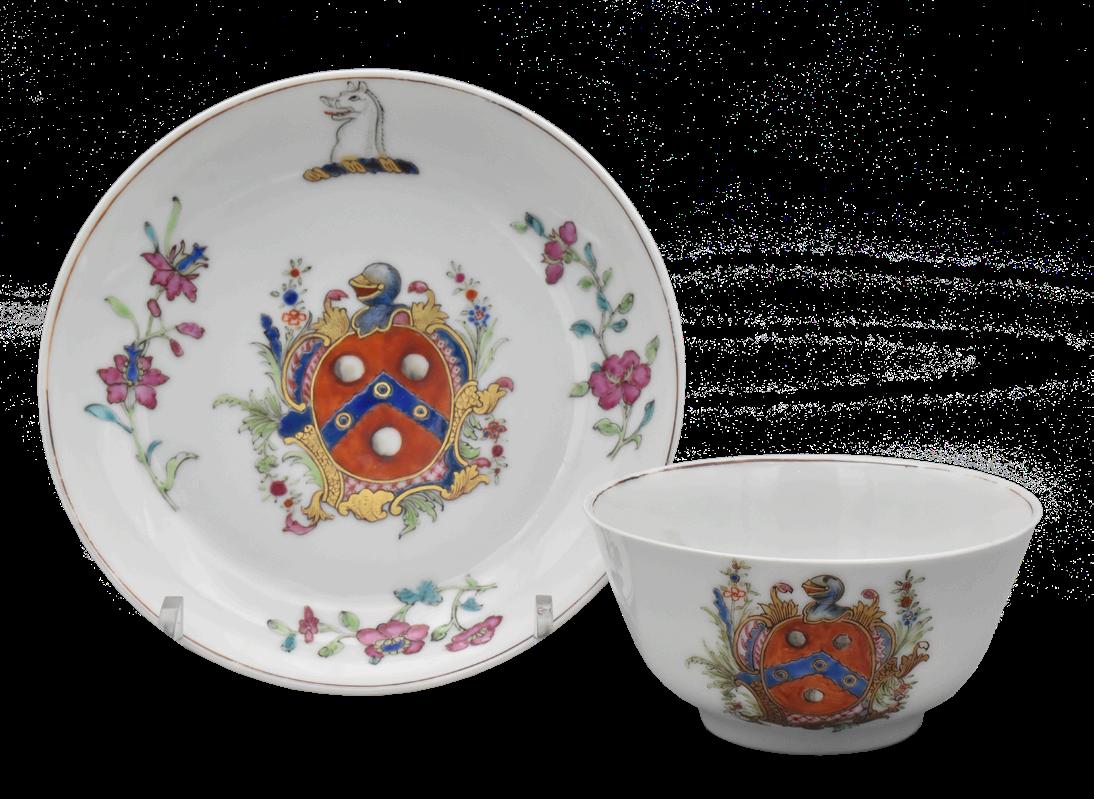
287
A CHINESE EXPORT ARMORIAL PORCELAIN SALT
QIANLONG PERIOD, CIRCA 1755
Painted with the arms of Verelst in puce enamels with a basket of flowers and a butterfly within bianco-sopra-bianco panels, rougede-fer and gilt chain-link border
Length 8cm
Davidson Collection no: 6
Provenance:
Heirloom & Howard, 42320
One of three services made for Harry Verelst, Governor of Bengal and successor to Lord Clive from 1767-69, a major figure in the British administration of India. See Chinese Armorial Porcelain, David Sanctuary Howard, London 2004, Vol II,p.205, J4
£300-500
288
A PAIR OF CHINESE EXPORT ARMORIAL PORCELAIN TEA BOWLS
QIANLONG PERIOD, CIRCA 1755
Painted en-grisaille with the arms of Wilson, the reverse with floral sprigs, rouge-de-fer and gilt spear head border
Diameter 7.2cm
Davidson Collection no: 16
Provenance:
Heirloom & Howard, 43246
This service probably ordered for Captain William Wilson, who commanded three ships at Canton at the relevant time. See Chinese Armorial Porcelain, David Sanctuary Howard, London 1974, Vol II, p.347, P20
£150-250
289
A CHINESE EXPORT ARMORIAL ‘FAMILLE-ROSE’
PORCELAIN TEA BOWL AND SAUCER
QIANLONG PERIOD, CIRCA 1755
Painted with the arms of Webber, enclosed in a rococo cartouche, with delicate scattered floral sprigs
The saucer 11.6cm
Davidson Collection no: 29
Provenance:
Weld Collection
Heirloom & Howard, XSCW299 (2)
This service was almost certainly made for Captain Wiliam Webber, HEICS, who commanded the Harcourt at Canton in the sailing season of 1753 and again in 1756. Later he was the principal managing owner of the Egmont. See Chinese Armorial Porcelain, David Sanctuary Howard, 2003, Vol II, p.275, O4
£200-300
290
A CHINESE EXPORT ARMORIAL BLUE AND WHITE PORCELAIN PLATE
QIANLONG PERIOD, CIRCA 1755
Painted in underglaze-blue with the arms of Richard Sykes of Sledmere, Yorkshire, copied exactly from a ‘Chippendale’ rococo bookplate engraved by William Stephens
Diameter 22.6cm
Davidson Collection no: 33
Provenance: Heirloom & Howard, 43384
This underglaze blue service would have been made at the porcelain factories of Jingdezhen in central China, as it requires a kiln which could fire at 1,300 C and there is no record of such kilns at Canton.
Much of this service is still at Sledmere and is on display in the dining room today. See Chinese Armorial Porcelain, David Sanctuary Howard, London 1974, Vol I, p.583, R1
£200-300
291
A CHINESE EXPORT ARMORIAL ‘FAMILLE-ROSE’ PORCELAIN SAUCER DISH
QIANLONG PERIOD, CIRCA 1755
With the arms of Foulis of Colinton all within a rouge-de-fer and gilt shell and scroll border
Diameter 26cm
Davidson Collection no: 48
Provenance:
Veritas, Lisbon, December 2018
Heirloom and Howard. A copy of the invoice is available
This service was almost certainly ordered by Captain Charles Foulis who was in Canton in 1751 and 1754 in command of the Lord Anson and was later managing owner of a number of ships between 1764-82. See Chinese Armorial Porcelain, David Sanctuary Howard, London 1974, Vol I, p.372, M4
£300-500
292
A RARE CHINESE EXPORT ARMORIAL PORCELAIN COFFEE
CUP AND SAUCER
QIANLONG PERIOD, CIRCA 1755
painted with the arms of Latham impaling Kelsall in enamels and gilt, above a Chinese landscape in underglaze-blue, the cup with the coatof-arms and crest to the base
The saucer 13cm
Davidson Collection no: 54
Provenance: Heirloom & Howard, 43954
This service was made for Captain Thomas Latham, RN (c.1720-63) and his wife Jane Kelsall. Captain Latham had a distinguished naval career, before given command of the Tyger in 1754, which was assigned to protecting British interests in the East. See Chinese Armorial Porcelain David Sanctuary Howard, London 1974, Vol 1, p.586, R3
£300-500



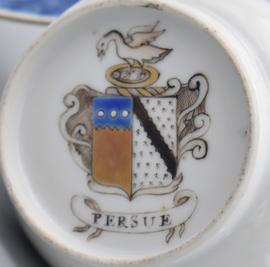
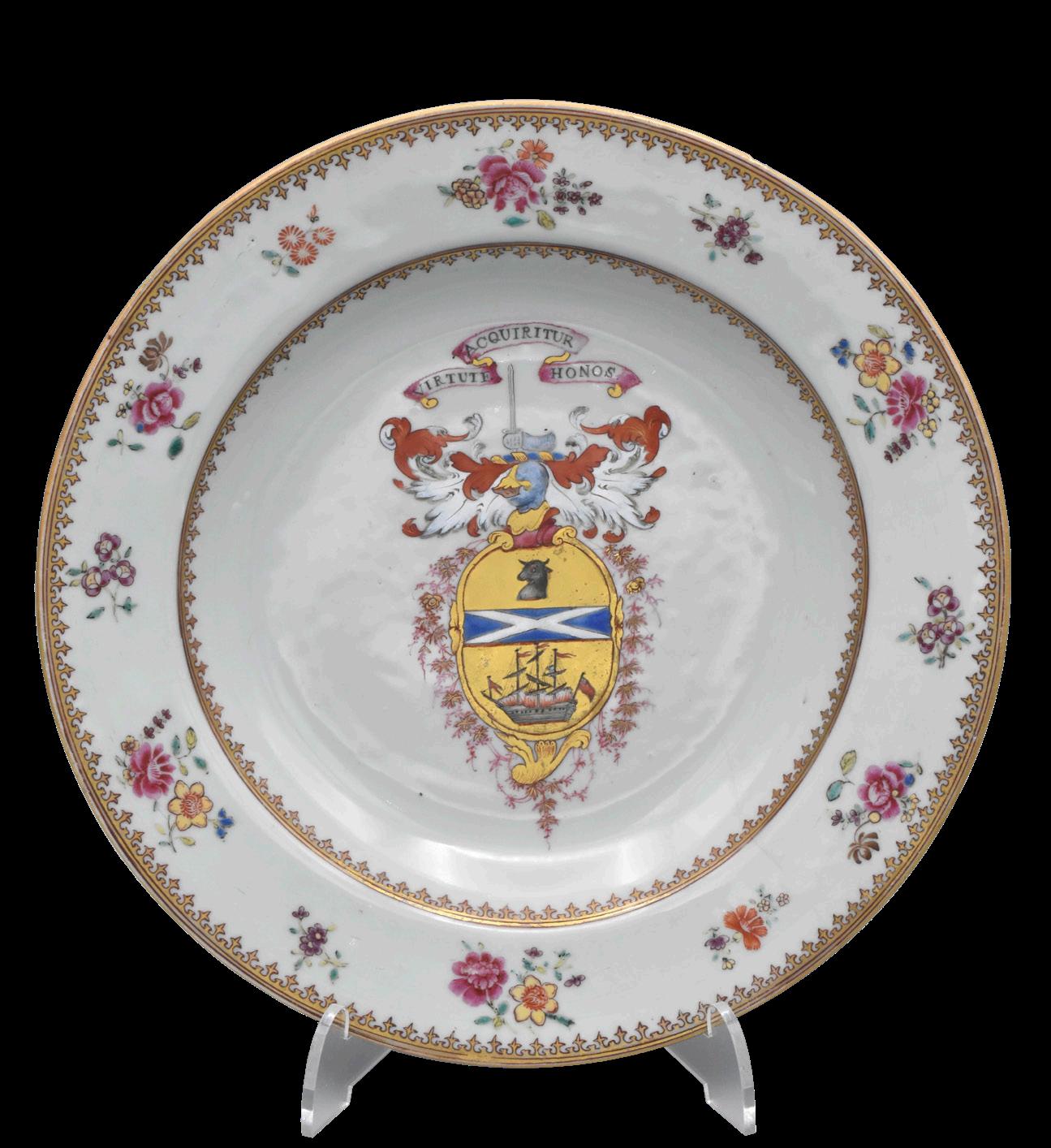

293
A CHINESE EXPORT ARMORIAL ‘FAMILLE-ROSE’ PORCELAIN COFFEE CUP
QIANLONG PERIOD, CIRCA 1760
with the arms of Crichton impaling Freke flanked by floral sprigs, beneath a rougede-fer and gilt spearhead border
Height 7cm
Davidson Collection no: 19
Provenance: Heirloom & Howard. 43317. A copy of the invoice is available
Possibly ordered by Patrick Crichton, a first officer at Canton in 1764. See Chinese Armorial Porcelain, David Sanctuary Howard, London 1974, Vol I, p.345, P16
£80-120
A CHINESE ARMORIAL SOUP PLATE
QIANLONG PERIOD, CIRCA 1760
painted with the arms of Richardson of Pentcaitland, Scotland, within floral and rouge-de-fer and gilt spearhead borders
Diameter 23cm
Davidson Collection no: 28
Provenance: Heirloom and Howard, 42747
This service was made for Captain George Richardson of the Honourable East India Company, who commanded the Pigot (1) on four voyages in the 1760’s (China route 1768/9) and the Ganges (1) in 1778/9. He succeeded his brother as 9th Baronet in 1788. See Chinese Armorial Porcelain, David Sanctuary Howard, 2003, Vol II, p.354, P21
£200-300
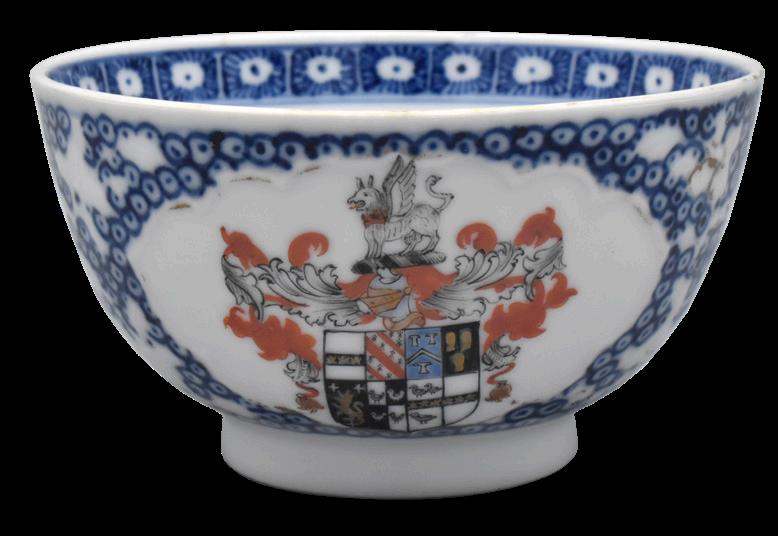
QIANLONG PERIOD, CIRCA 1760
with the arms of Clive quarterly of eight, with moulded panelled borders reserved against a blue diaper ground incised with flowers and butterflies
Diameter 8.5cm
Davidson Collection no: 36
Provenance:
Elinor Gordon Collection
Godden Reference Collection
Heirloom & Howard, 43480
Almost certainly for Robert Clive (the seventh quarter on the armorial was for his grandmother), who entered the East India Company service and was posted to Fort St George at Madras in 1744. It is thought that this service was comissioned by Clive towards the end of his second period in India, 1755-60 and before he was created a Baron after his return in 1760. See Chinese Armorial Porcelain, David Sanctuary Howard, London 1974, Vol I, p.589, R4
£200-300

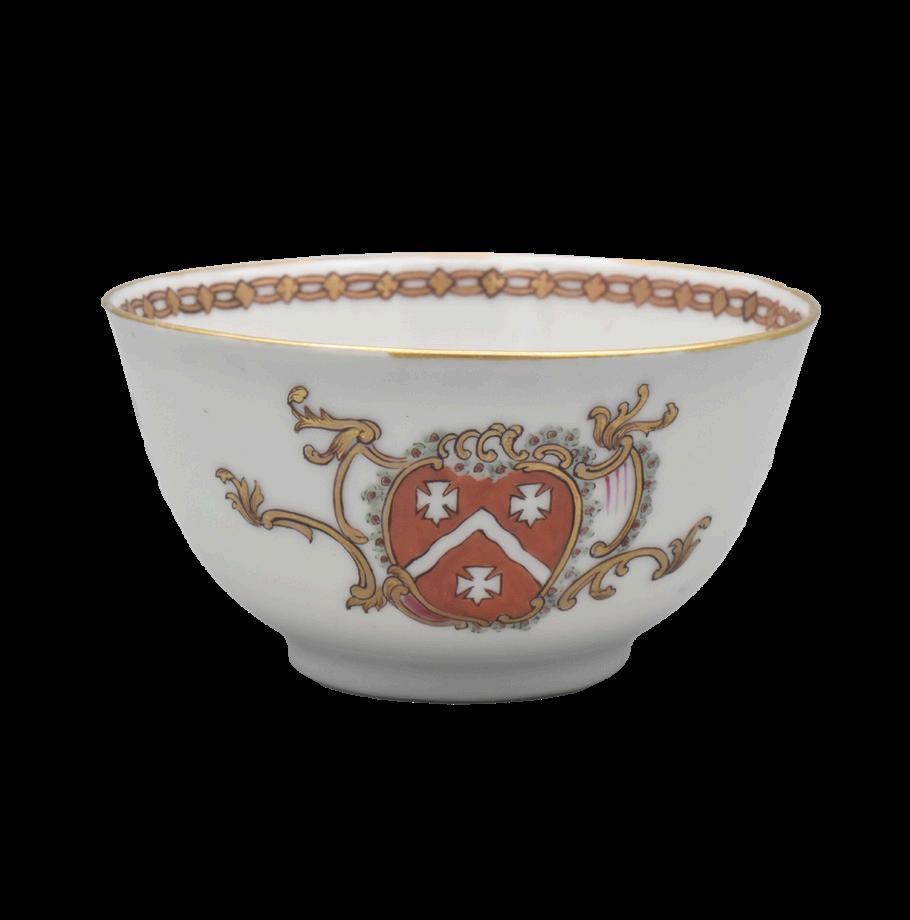

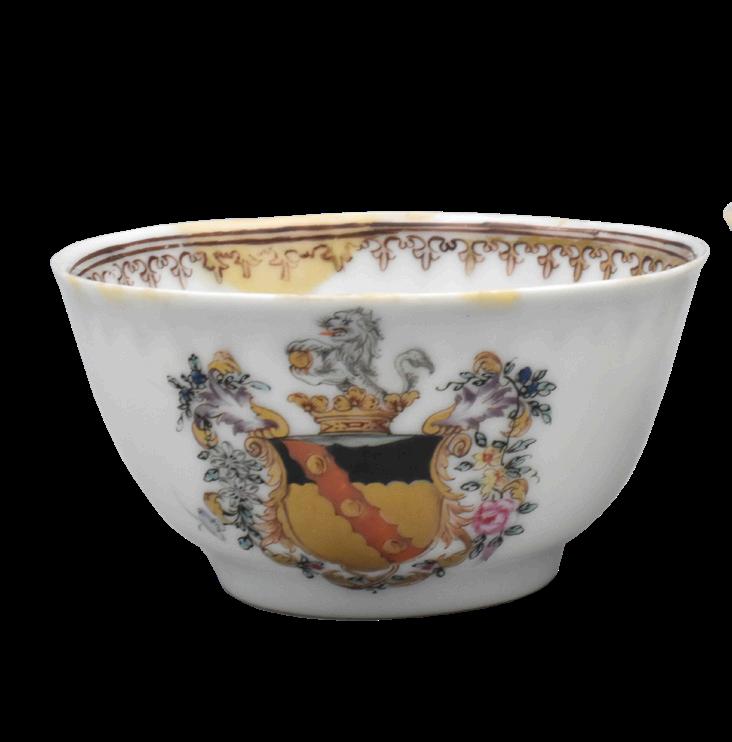
296
THREE PIECES OF CHINESE ARMORIAL ‘FAMILLE-ROSE’ PORCELAIN
QIANLONG PERIOD, CIRCA 1760
the tea bowls painted with the arms of Hallett impaling Pinnell the coffee cup with the arms of Hallet(t)
The coffee cup 6.5cm
Davidson Collection no: 51
Provenance:
Weld Collection, (coffee cup)
Heirloom & Howard, XSCW191
The coffee cup made for Captain John Hallett, HEICS. Who married in 1743 Elizabeth Pinnell, daughter of Captain Richard Pinnell, HEICS, a director of the East India Company. See Chinese Armorial Porcelain, David Sanctuary Howard, Vol I, London 1974, p. 513, P23 and Vol. II 2003, p.364, P23
£80-120

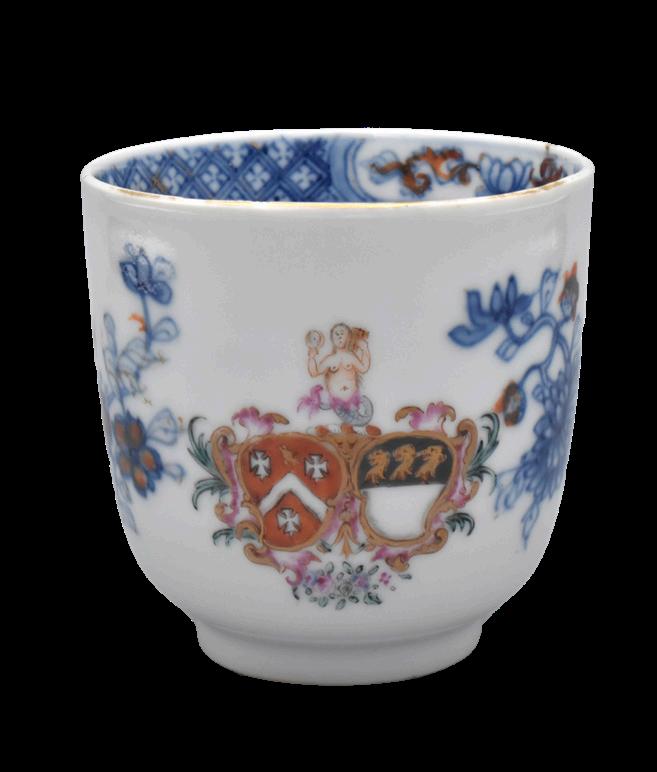
298
297
A CHINESE EXPORT ARMORIAL ‘FAMILLEROSE’ TEA BOWL
QIANLONG PERIOD, CIRCA 1761
painted with the arms of Bonham with a gilt scroll cartouche, floral sprigs and a mermaid crest
Diameter 8cm
Davidson Collection no: 17
Provenance:
Heirloom & Howard, 43291
Ordered by Captain Pinson Bonham, brother of Samuel Bonham, Master of the Norfolk at Canton in 1757. See Chinese Armorial Porcelain, David Sanctuary Howard, London 1974, Vol I, p.345, K6. The present tea service to be illustrated in CAP 3
£80-120
A CHINESE EXPORT ARMORIAL BEAKER
QIANLONG PERIOD, CIRCA 1761
painted with the arms of Bonham acollé Richardson in famille-rose enamels between underglaze-blue floral sprigs
Height 7cm
Davidson Collection no: 18
Provenance:
Heirloom & Howard, 43276
Made for Samuel, son of Captain Samuel Bonham, who married Sarah Richardson. See Chinese Armorial Porcelain, David Sanctuary Howard, London 1974, Vol I, p.345, K6. The present service to be illustrated in CAP III.
£80-120
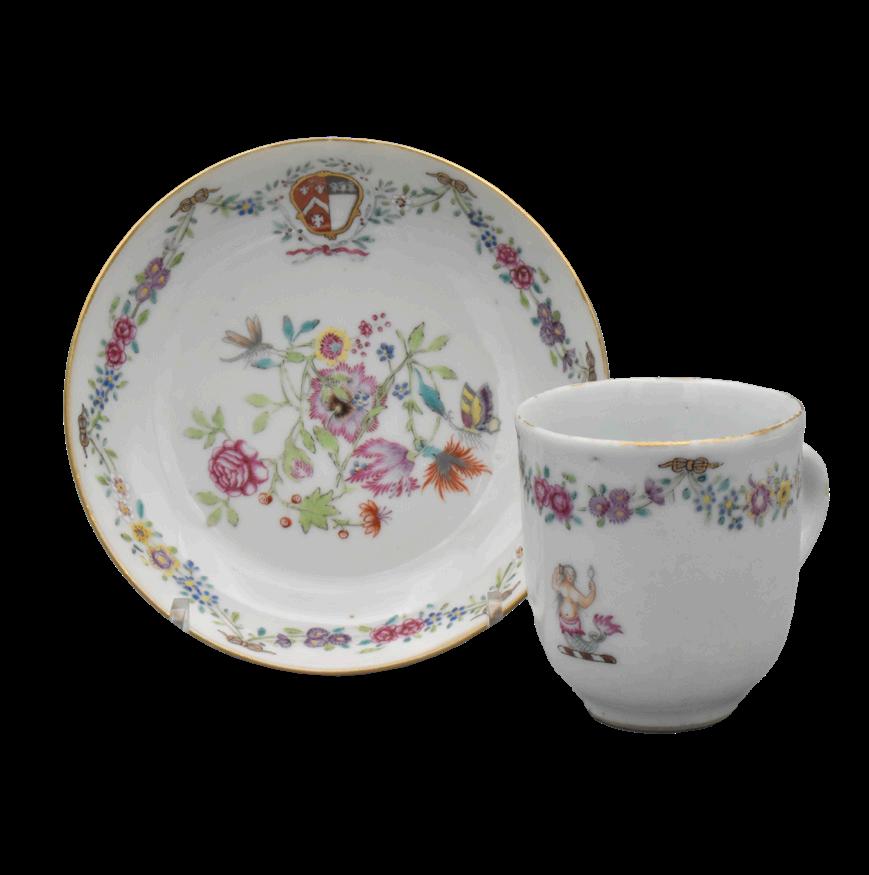
299 A CHINESE ARMORIAL ‘FAMILLE-ROSE’ COFFEE CUP AND SAUCER
QIANLONG PERIOD, CIRCA 1761
painted with the arms of Bonham impaling Richardson, the cup with the crest, the saucer with the arms, with floral swags suspended from rougede-fer and gilt ribbons
The saucer 11.6cm
Davidson Collection no: 26
This service with the arms of Bonham impaling Richardson was made for Samuel, a London merchant and ship owner, who lived at Great Warley Place, Essex. He was baptised on 4 July 1728 at St Dunstan’s, Stepney. He had married Sarah daughter of George Richardson, merchant of London.
Samuel was the third son of a Captain Samuel Bonham who had been a slave trader and had married Jane Pinson.
See Chinese Armorial Porcelain, David Sanctuary Howard, London 1974, Vol I, p.617, S2
£200-300
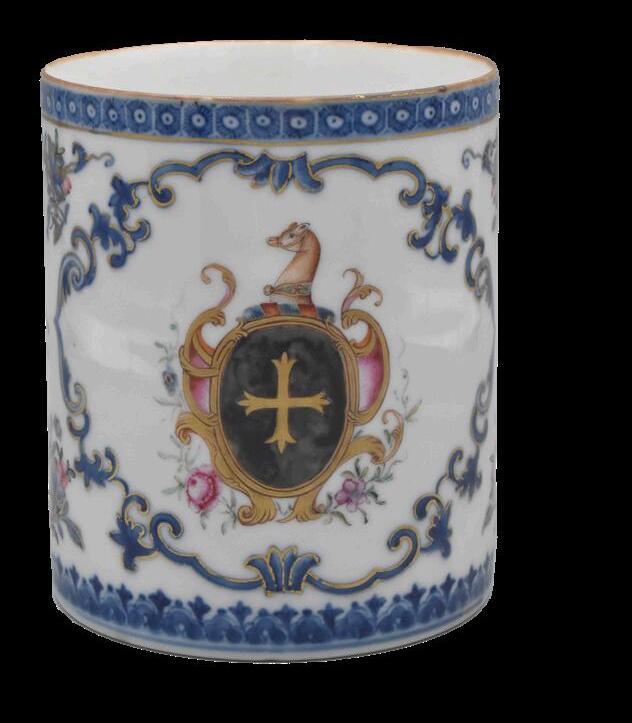
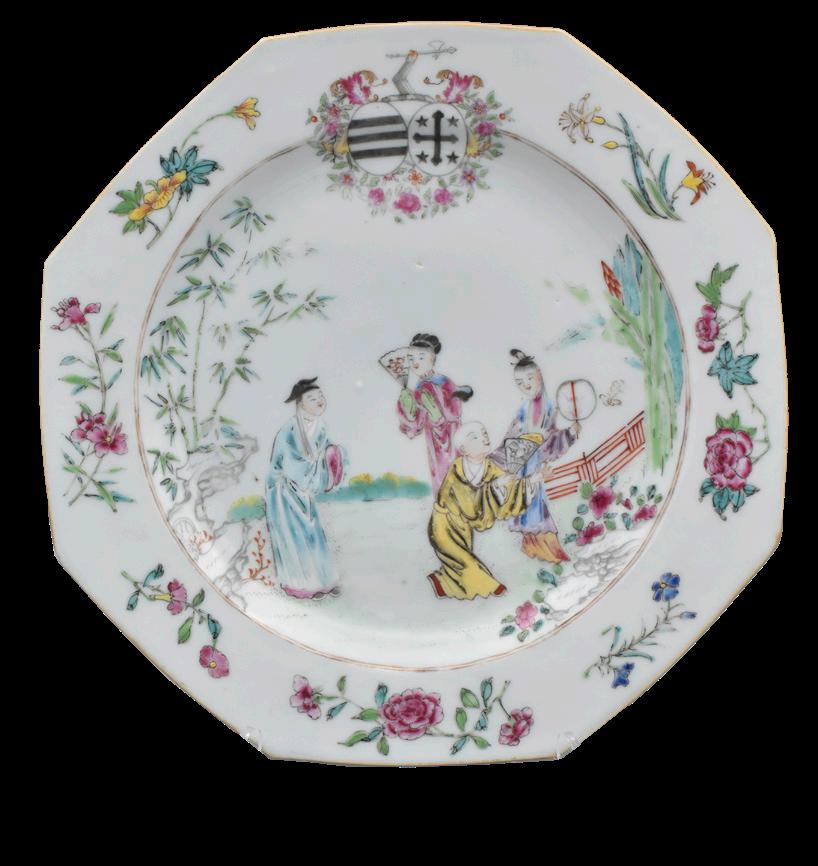
300
A CHINESE EXPORT ARMORIAL ‘FAMILLE-ROSE’ TANKARD,
QIANLONG PERIOD, CIRCA 1765
painted with the arms of Lascelles within a gilt rococo cartouche, within underglaze-blue cartouches, scattered with flowers and butterflies, highlighted in gilding Height 12cm
Davidson Collection no: 25
Provenance: Heirloom & Howard, 43403. A copy of the invoice available
Previously unrecorded. To be included in Chinese Armorial Porcelain, III. Almost certainly made for Captain Peter Lascelles, commander of the York. He was of the Lascelles family of Northallerton, Yorkshire. Several armorial services were made for close relatives, including the Lascelles family of Harewood House, of whom Henry Lascelles (1690-1753) had been a director of the East India Company. See volumes I and II for other Lascelles services.
£300-400
301
A CHINESE EXPORT ARMORIAL OCTAGONAL ‘FAMILLE-ROSE’ PLATE
QIANLONG PERIOD, CIRCA 1765
painted with the arms of Raymond with Webster accollé to the rim, the centre painted with a classical Chinese figural scene of a scholar, two court ladies and an attendant, holding fans, the rim with floral sprays
Diameter 22cm
Davidson Collection no: 60
Provenance: Heirloom & Howard, 44132. A copy of the invoice is available. This service was made for Sir Charles Raymond, Bt., of Valentine House, Essex. Raymond became the most successful Principal Managing Owner of East Indiaman in the 18th Century, responsible for well over 120 voyages to Canton over a forty-year period. See Chinese Armorial Porcelain, David Sanctuary Howard, London 1974, Vol I, p.344, K4, the information recorded there now considerably enlarged upon by more recent research.
£500-700
302
A CHINESE EXPORT ARMORIAL ‘FAMILLE-ROSE’ SALT
QIANLONG PERIOD, CIRCA 1770
painted with the arms of the Preston Baronets of Valleyfield House, Perth, with swags of flowers suspended from gilt pendants, chain-link border to the rim
Length 8cm
Davidson collection no: 1
Provenance: Heirloom & Howard, 41628. A copy of the invoice is available.
This service was ordered by the very successful Captain Robert Preston, who was in Canton in 1768 and was later a managing owner of thirty East Indiamen. See Chinese Armorial Porcelain, David Sanctuary Howard, London 1974, Vol I, p.615, S2
£300-400
303
A CHINESE EXPORT ARMORIAL OCTAGONAL SOUP PLATE
QIANLONG PERIOD, 1770
painted with the arms of the Preston Baronets of Valleyfield House, Perth, within a chain-link border and hung with floral swags suspended from rouge-de-fer and gilt bows
Diameter 21.5cm
Davidson Collection no: 2
Provenance: Lynda Willauer Antiques. A copy of the invoice is available
This service was ordered by the very successful Captain Robert Preston, who was in Canton in 1768 and was later a managing owner of thirty East Indiamen. See Chinese Armorial Porcelain, David Sanctuary Howard, London 1974, Vol I, p.615, S2
£300-400
304
A CHINESE EXPORT ARMORIAL ‘FAMILLE-ROSE’ OCTAGONAL PLATE
QIANLONG PERIOD, CIRCA 1772
painted with the arms of Lennox, the cavetto with a rouge-de-fer and gilt band, the rim with a floral and a puce-scale border
Diameter 22cm
Davidson Collection no: 4
Provenance:
Kingschina. A copy of the invoice is available
This service was commissioned for Captain John Lennox, HEIC, who was in command of the Anson in Canton in 1772. See Chinese Armorial Porcelain, David Sanctuary Howard, London 1974, Vol I, p.423, P13
£300-400
305
A CHINESE EXPORT ARMORIAL ‘FAMILLE-ROSE’ OCTAGONAL SOUP PLATE, QIANLONG PERIOD, CIRCA 1775
painted with the arms of Grant of Darlway to the rim and cavetto, a large floral spray to the centre, within rouge-de-fer and gilt spearhead borders
Diameter 21.5cm
Davidson Collection no: 24
Provenance:
Guest & Gray, Y531. A copy of the invoice is available



This service was commissioned for Charles Grant of Darlway, Scotland whilst he was a factor in Calcutta in 1775. He later became a director of the Honourable East India Company (1792-1823) and chairman in 1805, 1809 and 1815. See Chinese Armorial Porcelain, David Sanctuary Howard, London 1974, Vol I, p.523, P24
£200-300
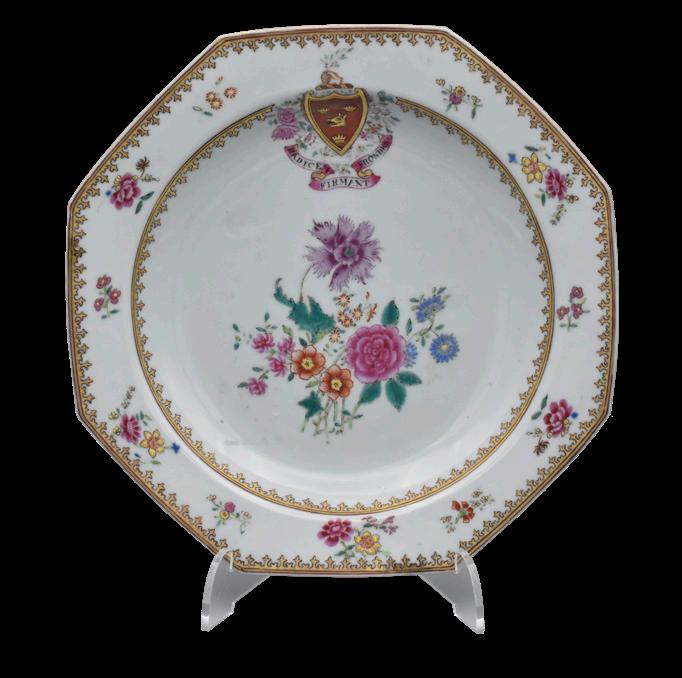

306
A CHINESE EXPORT ‘VIEW OF GUANGZHOU’ BLUE AND WHITE RECTANGULAR DISH
QIANLONG PERIOD, CIRCA 1775
painted in underglaze-blue with a view of the walled city of Canton displaying the Zhenhai tower, Guangxiao, the Bright Filial Temple, the flowery pagoda, and the Huaisheng Mosque, within a butterfly border
Length 21cm
Davidson Collection no: 31
Provenance: Heirloom & Howard, 43539. A copy of the invoice is available.
£300–400


307
A CHINESE EXPORT ‘VIEW OF GUANGZHOU’ BLUE AND WHITE RECTANGULAR DISH
QIANLONG PERIOD, CIRCA 1775
painted in underglaze-blue with a view of the walled city of Canton displaying the Zhenhai tower, Guangxiao, the Bright Filial Temple, the flowery pagoda, and the Huaisheng Mosque, within a butterfly border
Length 21cm
Davidson Collection no: 58
Provenance: Santos London, 2249. A copy of the invoice is available
£300–400
308
A CHINESE EXPORT SHIPPING-SUBJECT
‘FAMILLE-ROSE’ TEA BOWL AND SAUCER
QIANLONG PERIOD, CIRCA 1780
profusely painted with British East India Company ships at Whampoa anchorage
The saucer 12.5cm
Davidson Collection no: 21
Provenance: Guest & Gray. V156. A copy of the invoice is available.
£100-£200
309
A CHINESE EXPORT ‘DUTCH FOLLY FORT’ BLUE AND WHITE DEEP MEAT DISH
QIANLONG PERIOD, CIRCA 1780
painted in vivid tones of underglaze-blue, within butterfly and greek-key and ruji head borders
Length 36cm
Davidson Collection no: 53
Provenance: Chiswick Auctions, 11th November 2019, lot 508
The Dutch folly fort was built on a sand bank in the Pearl River close to the foreign factories in Canton (Guangzhou) in a place said to be near a memorial temple to Li Maoying (1200-1257) of the Song dynasty.
The Folly forts were a series of defensive structures set up by the Chinese in the Ming dynasty to protect Canton, (Guangzhou). By the beginning of the Qing dynasty the advances in naval weaponry made them redundant and had fallen into disrepair. Several European countries, including the French and the Dutch, used them for storage and as bases for the staff. The Dutch Folly fort was situated to the East of Canton
Porcelain and the Dutch China Trade, by C.J.A Jörg, 1982 The Hague, p. 70, cat. 18 for a saucer decorated in underglaze cobalt blue
£400 - £500
310 A CHINESE EXPORT ARMORIAL ‘FAMILLE-ROSE’ COFFEE CUP
QIANLONG PERIOD, CIRCA 1786
painted with the arms of Hodgson flanked by floral sprigs beneath a rouge-de-fer and gilt spearhead border
Height 6cm
Davidson Collection no: 52
Provenance:
Heirloom & Howard, 43381. A copy of the invoice is available
Possibly made for Captain Thomas Hodgson of the HEIC who commanded the Earl Cornwallis, visiting Canton on four occasions, the earliest in 1786. He died at sea in 1796. See Chinese Armorial Porcelain, David Sanctuary Howard, 2003, Vol II, p.374, P24
£80-120
311
A CHINESE EXPORT ARMORIAL PORCELAIN TRIO
QIANLONG PERIOD, CIRCA 1791
with the crest and motto of Lennox, ‘I’LL DEFEND’, all within blue and gilt borders
The saucer 15.5cm (3)
Davidson Collection no: 5
See Chinese Armorial Porcelain, David Sanctuary Howard, London 1974, Vol I, p.615, S2
£300-400
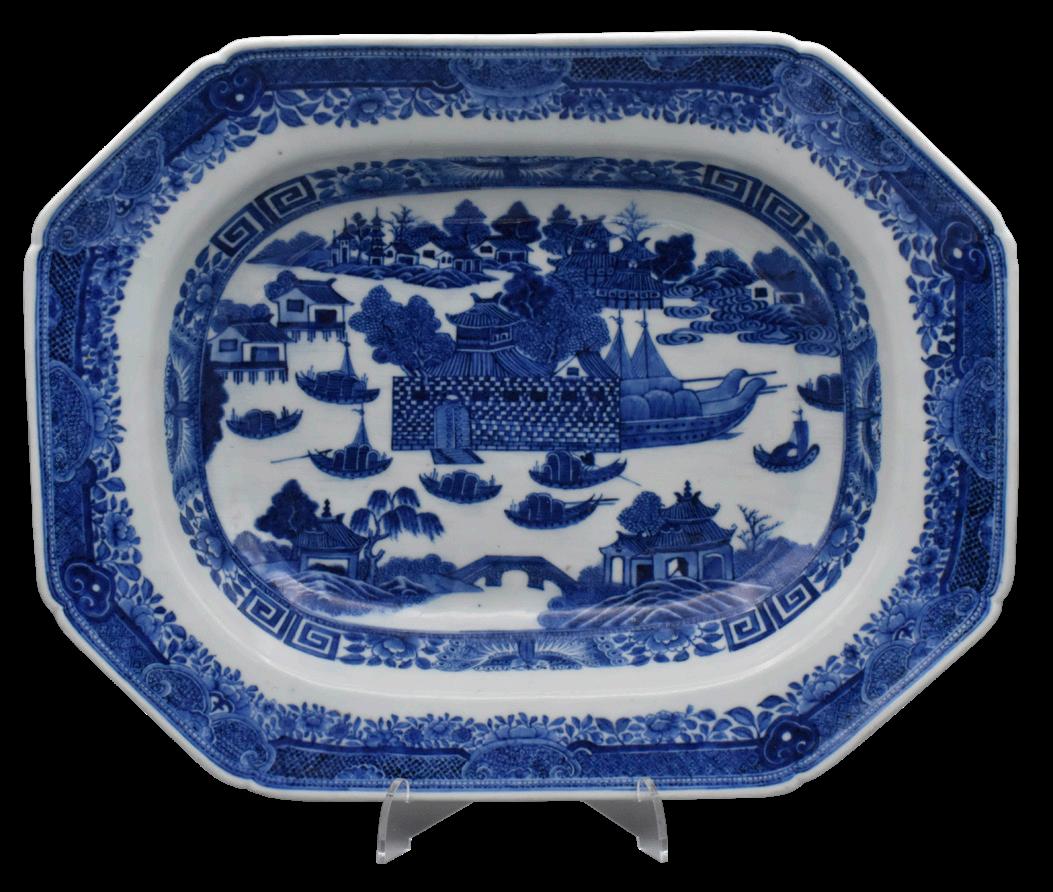

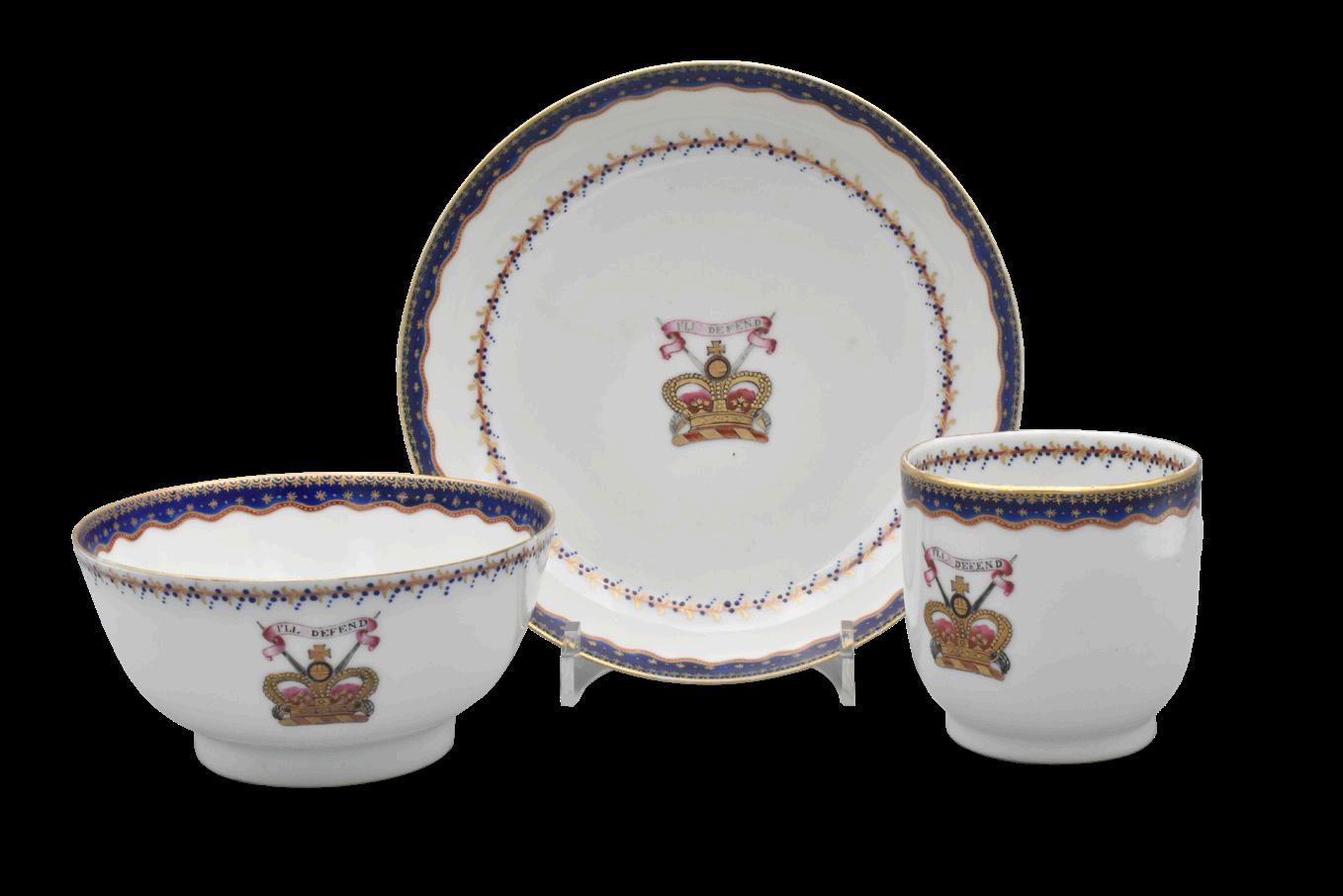
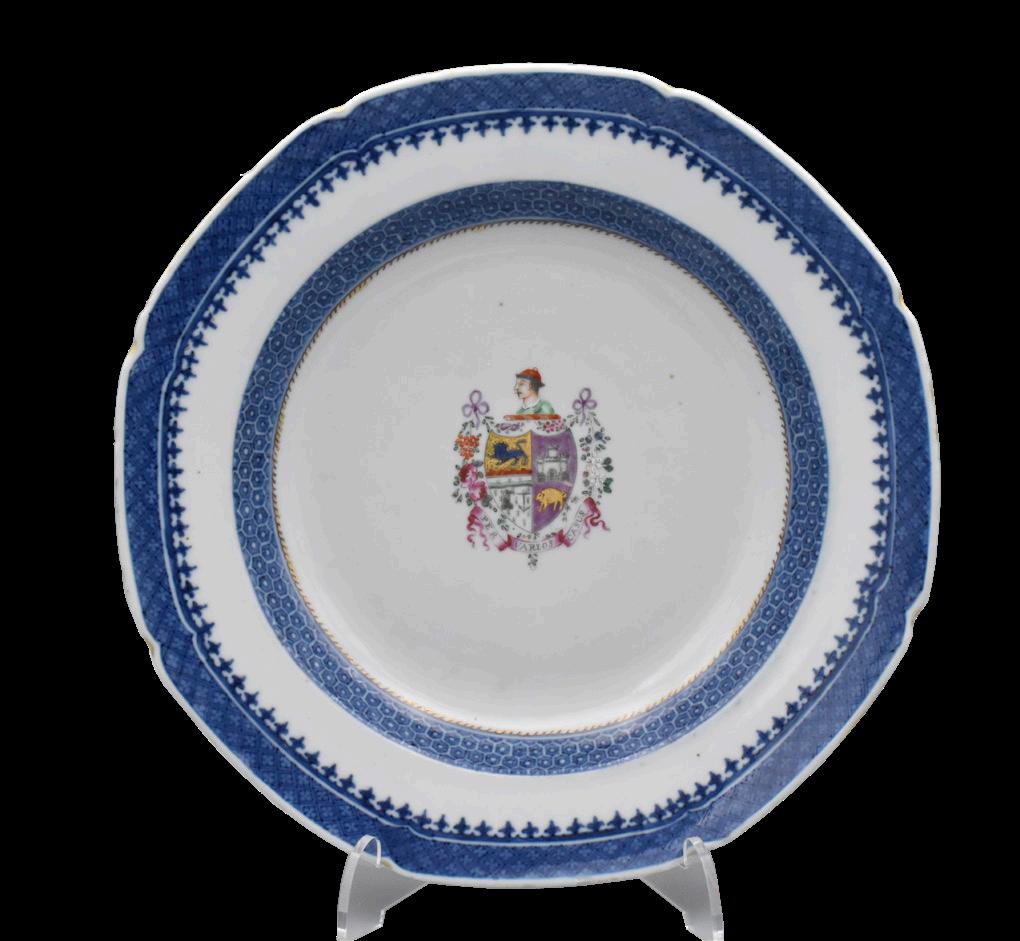
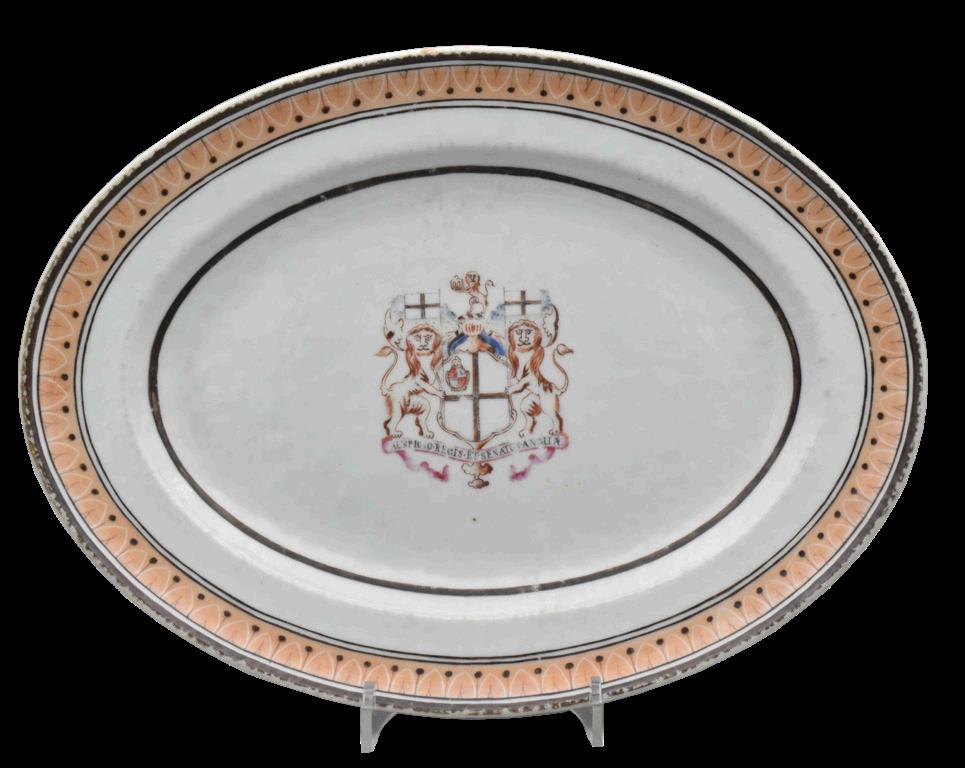
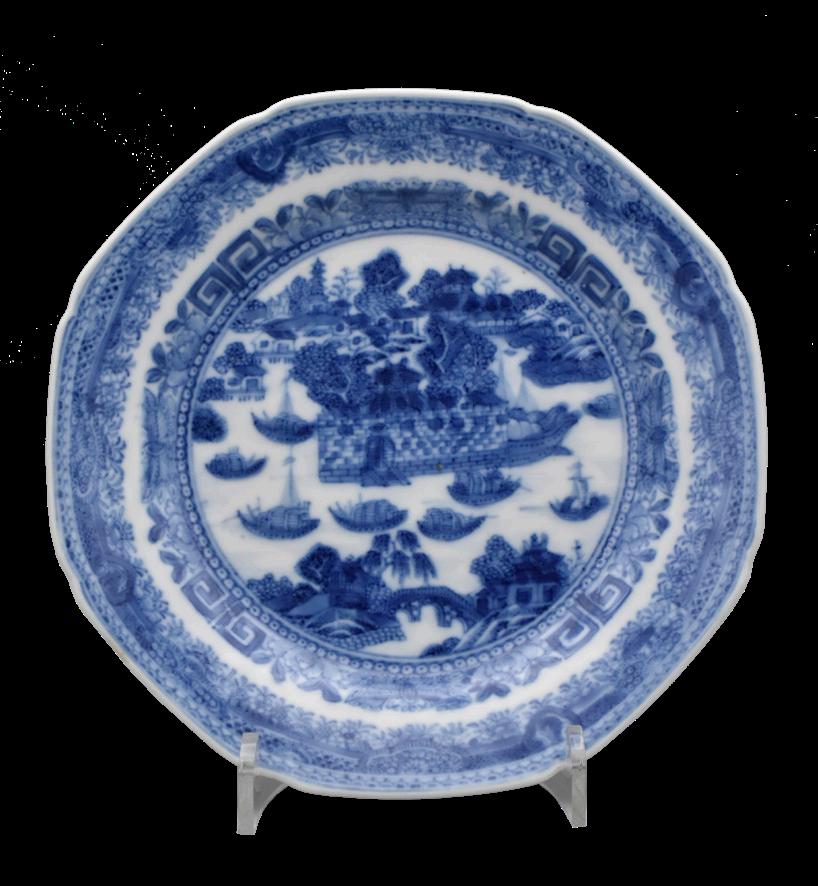
QIANLONG PERIOD, CIRCA 1792
painted with the arms of Smith impaling Cazalet with a ‘Chinaman’ crest, all within underglaze-blue borders
Diameter 23.8cm
Davidson Collection no: 14
Provenance: Kingschina. A copy of the invoice is available This service was made for Captain William Smith, who commanded the East Indiaman Dublin at Canton in 1792 and 1794. See Chinese Armorial Porcelain, David Sanctuary Howard, London 1974, Vol I, p.723, V14
£200-300
JIAQING PERIOD, CIRCA 1800
painted with the arms of the Honourable East India Company, within a salmon-pink and brown border
Length 27cm
Davidson Collection no: 12
Provenance: Chez Bill. A copy of the invoice is available. This dish features the coat of arms of the Honourable East India Company which bears the motto ‘Auspicio regis et senatus Angliae’ (‘By right of the king and the senate of England’). This coat of arms was adopted for use by the Company in 1709. The Honourable East India Company (known officially as ‘United Company of Merchants of England Trading to the East Indies’) was formed in 1708 after the merger of the first English East India Company (incorporated by royal charter in 1600) with a rival East India Company (established in 1698). According to David Sanctuary Howard (1928 - 2005), author of ‘Chinese armorial porcelain’ (1974), this dish was part of a service that was ordered for use by East India Company officers in Bombay and Madras, possibly to celebrate the bi-centenary of the ‘new’ East India Company or of the merger of the two Companies a decade later. Dishes of a similar design were recovered from The Diana, a merchant ship of the Honourable East India Company trading between Canton and India, and which had wrecked in the Malacca Strait on 4 March 1817.
A similar dish is held by the Victoria & Albert Museum, London, accession no 335J-1898 and another in the Collection of the National Museum of Singapore, 023-00254
£200 – 300
314
A CHINESE EXPORT ‘FOLLY FORT’ BLUE AND WHITE SIDE PLATE
QIANLONG PERIOD, CIRCA 1780
of octagonal form, painted in underglaze-blue with the ‘Dutch Folly Fort’, the flowery pagoda and the Zenhai Tower, butterfly border
Diameter 15cm
Davidson Collection no: 37
Provenance: Ladygrove Antiques. A copy of the invoice is available
£60 – 80

316
A CHINESE EXPORT ‘RED-ROVER’
SHIPPING SUBJECT PLATE
CIRCA 1830
Painted with a version of the ‘fitzhugh’ pattern
Diameter 24.8cm
Davidson Collection no: 22
Provenance: Kingschina. A copy of the invoice is available
This plate is from an unusual service of Chinese porcelain made about 1830 for the fast ‘country’ clipper Red Rover, built in 1829. The broad beamed East Indiamen had proved themselves unable to sail against the strong headwinds in the Winter monsoon up the China Seas, but in 1829 the enterprising Captain William Clifton built the first clipper barque on the Hugli River in India. For many years the vessel broke all records on the round trip to Canton. Red Rover made the first full journey in the unheardof time of eighty-six days, making three round trips a year possible and revolutionising the tempo of the trade. The barque carried opium to Canton and returned with Chinese silks, porcelain, furniture etc. By 1834 Jardine Matheson & Co. had acquired a half share in the vessel and later bought the other half from Captain William Clifton.
£100-150

Painted with the arms of Captain John Timins, the centre of the dish with peony and bamboo issuing from a rocky mound, together with a framed print of Captain Timins, after a painting by Samuel Drummond, A.R.A, engraved by J. Bentley
Length 25.5cm (2)
Davidson Collection no: 8
Provenance: Guest & Gray, K72. A copy of the invoice is available Captain Timins was in Canton in 1803 on the Royal George. See Chinese Armorial Porcelain, David Sanctuary Howard, London 1974, Vol I, p.782, X2
£200-300
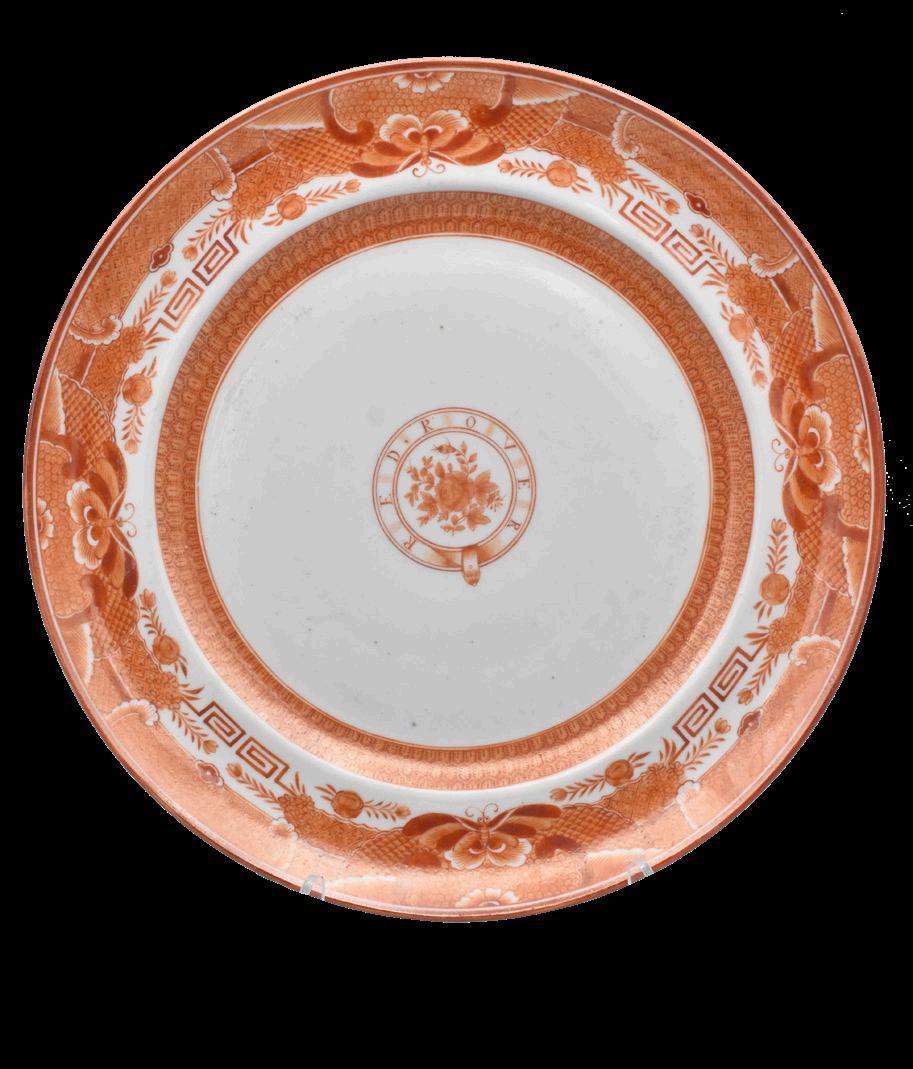
317
DATED 1865
inscribed in black ‘CHINOY FAMILY, BAC, 1865, BOMBAY’, in rose borders with figure panels and landscapes
Diameter 16cm
Davidson Collection no: 30
Provenance: Chez Bill, 1156. A copy of the invoice is available
A pair of cups and saucers from this unusual service were sold by Christies New York, The Tibor Collection, 20th January 2021, lot 3
£100 – 150


318
A PAIR OF CHINESE EXPORT FAMILLE-ROSE ‘JUDGEMENT OF PARIS’ PLATES
QIANLONG PERIOD, CIRCA 1750
Painted with a mythological scene showing the seated Paris handing Venus the golden apple while Juno, Minerva, Cupid and a dog look on, a band of gilt rocaille scrollwork at the border
Diameter 22.5cm (2)
A plate with this design was published by D.F. Lunsingh Scheuleer in Chinese Export Porcelain, Chine de Commande (Faber and Faber, 1974, pl. 216)
A teabowl and saucer were published by David S.Howard in The Choice of the Private Trader, The Private Market in Chinese Export Porcelain illustrated from the Hodroff Collection (Zwemmer,1994, p. 180, pl. 205
See also François & Nicole Hervouët in La Porcelaine des Compagnies des Indes à Décor Occidental (Flammarion, 1986, p. 310).
£800-1,000
319
A CHINESE EXPORT PORCELAIN ‘EUROPEAN-SUBJECT’
GRISAILLE-DECORATED PLATE
QIANLONG PERIOD, CIRCA 1750
Painted with the Seamstress, her dress highlighted in gilt, her lips and eyes rouged, all within a spearhead border
Diameter 22.5cm
£100-200

320
A PAIR OF CHINESE EXPORT GRISAILLE-DECORATED
PORCELAIN MYTHOLOGICAL PLATE
QIANLONG PERIOD, CIRCA 1750
Painted with Minerva, Ulysses and Venus, all within diaper borders, brown-dressed rims
22.5cm
(2)
A similar example is illustrated by Hervou Porcelaine des Compagnie des Indes 1989, pg. 304, 13.51
£400-600
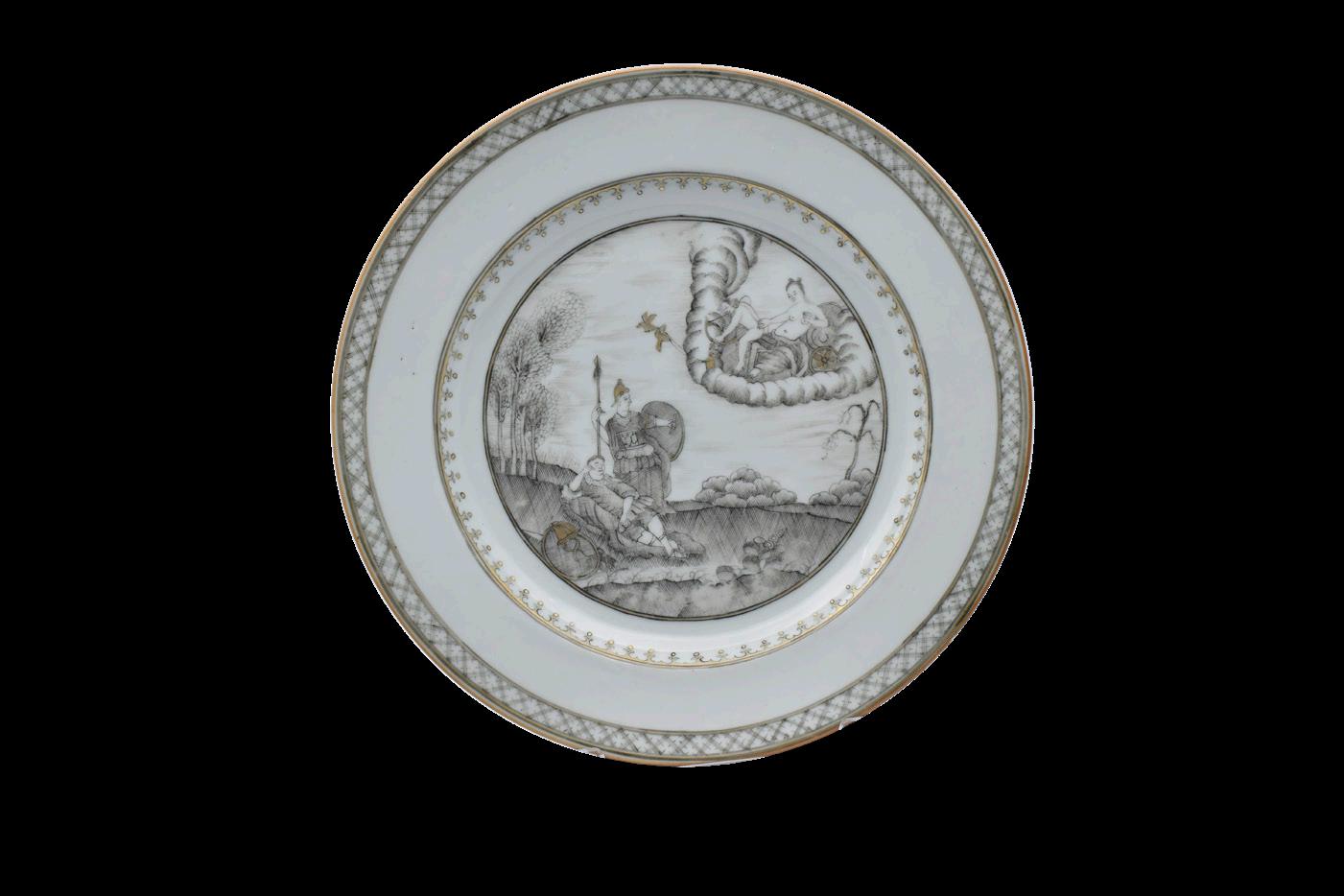

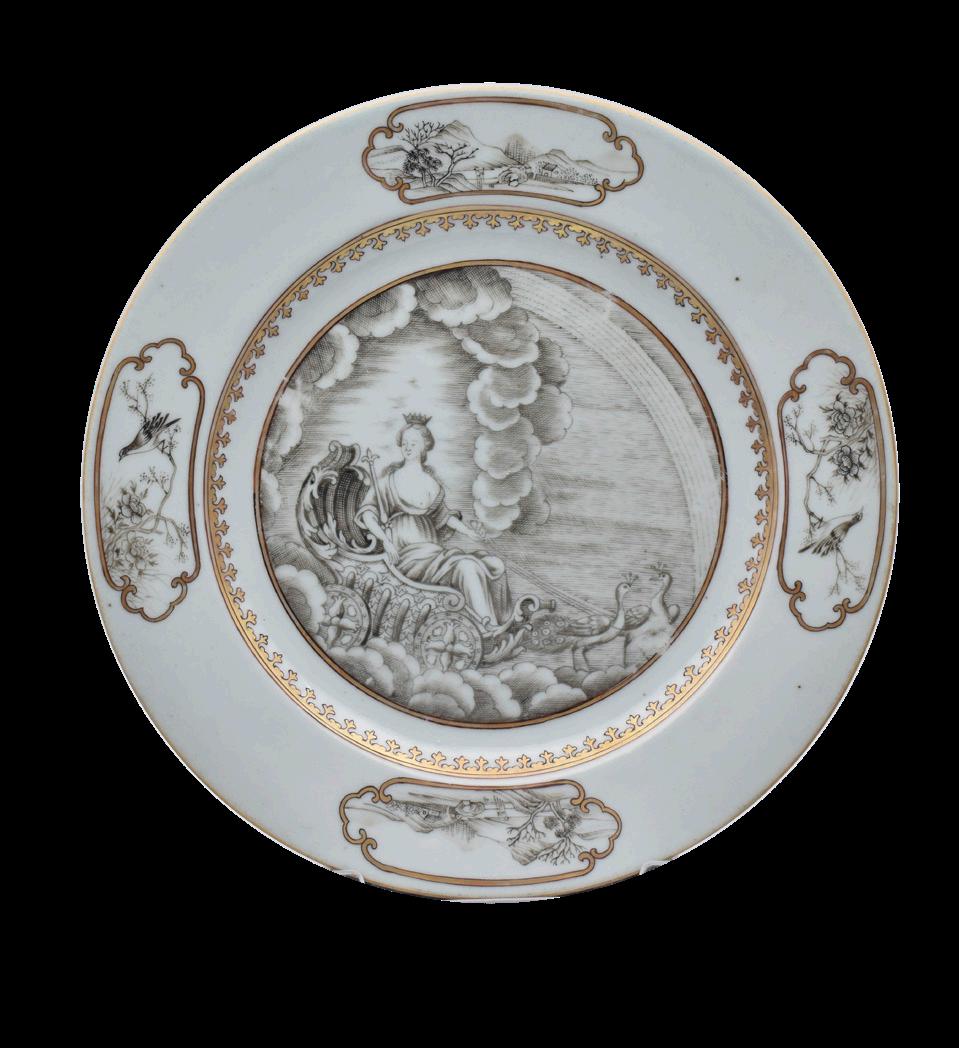
322
A CHINESE EXPORT GRISAILLE-DECORATED PORCELAIN
MYTHOLOGICAL PLATE
QIANLONG PERIOD, CIRCA 1740
Finely painted with a central scene of Zephyr and Flora gazing into a pond accompanied by cupid carrying a flaming torch, a swan nearby, all within gilt spearhead borders
Diameter 22.8cm
A similar example is illustrated by Hervouët & Bruneau in La Porcelaine des Compagnie des Indes à Décor Occidental, Paris, 1989, pg. 306, 13.56. Recorded as ‘quite rare’ by the authors
£600-800
321
A CHINESE EXPORT GRISAILLE-DECORATED PORCELAIN
MYTHOLOGICAL PLATE
QIANLONG PERIOD, CIRCA 1745
Painted with a central scene of Juno in her chariot, pulled by two peacocks, with a gilt spearhead border, the rim with four vignettes containing alternating scenes of birds and landscapes
Diameter 22.8cm
A similar example is illustrated by Hervouët & Bruneau in La Porcelaine des Compagnie des Indes à Décor Occidental, Paris, 1989, pg. 292, 13.3. Recorded as ‘quite rare’ by the authors
£400-600

323
A CHINESE EXPORT GRISAILLE-DECORATED PORCELAIN
MYTHOLOGICAL OCTAGONAL PLATE
QIANLONG PERIOD, CIRCA 1745
Finely painted with a scene of Jupiter accompanied by an eagle sitting on a cloud, a castle below them, all within a rouge-de-fer and gilt fruiting vine and floral border
Diameter 22cm
A similar example is illustrated by Hervouët & Bruneau in La Porcelaine des Compagnie des Indes à Décor Occidental, Paris, 1989, pg. 292, 13.2. Recorded as ‘quite rare’ by the authors
£600-800
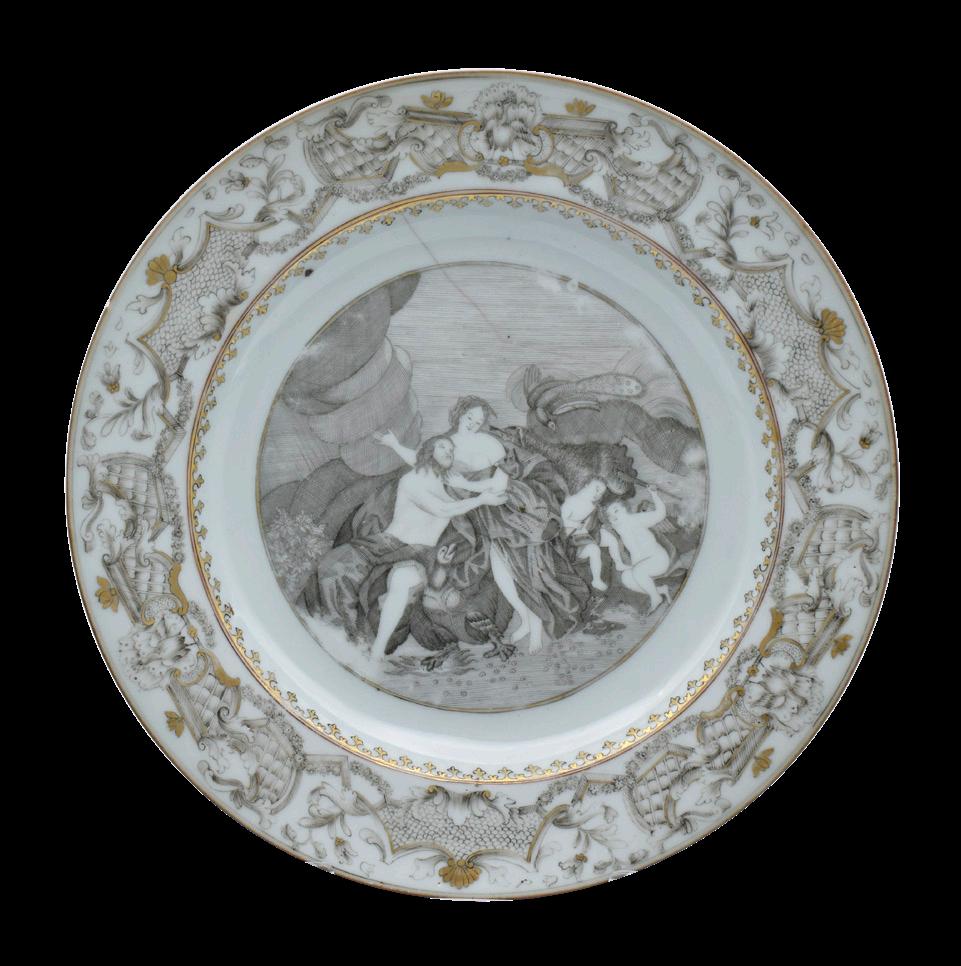
325
A CHINESE EXPORT GRISAILLE-DECORATED PORCELAIN
MYTHOLOGICAL PLATE
QIANLONG PERIOD, CIRCA 1745
Finely painted with Apollo in a chariot drawn by two flying horses within a rouge-de-fer and gilt spearhead border, the rim set with four cartouches containing allegories of love and faithfulness
Diameter 23cm
A similar example is illustrated by Hervouët & Bruneau in La Porcelaine des Compagnie des Indes à Décor Occidental, Paris, 1989, pg. 294, 13.10. Recorded as ‘rare’ by the authors
£600-800
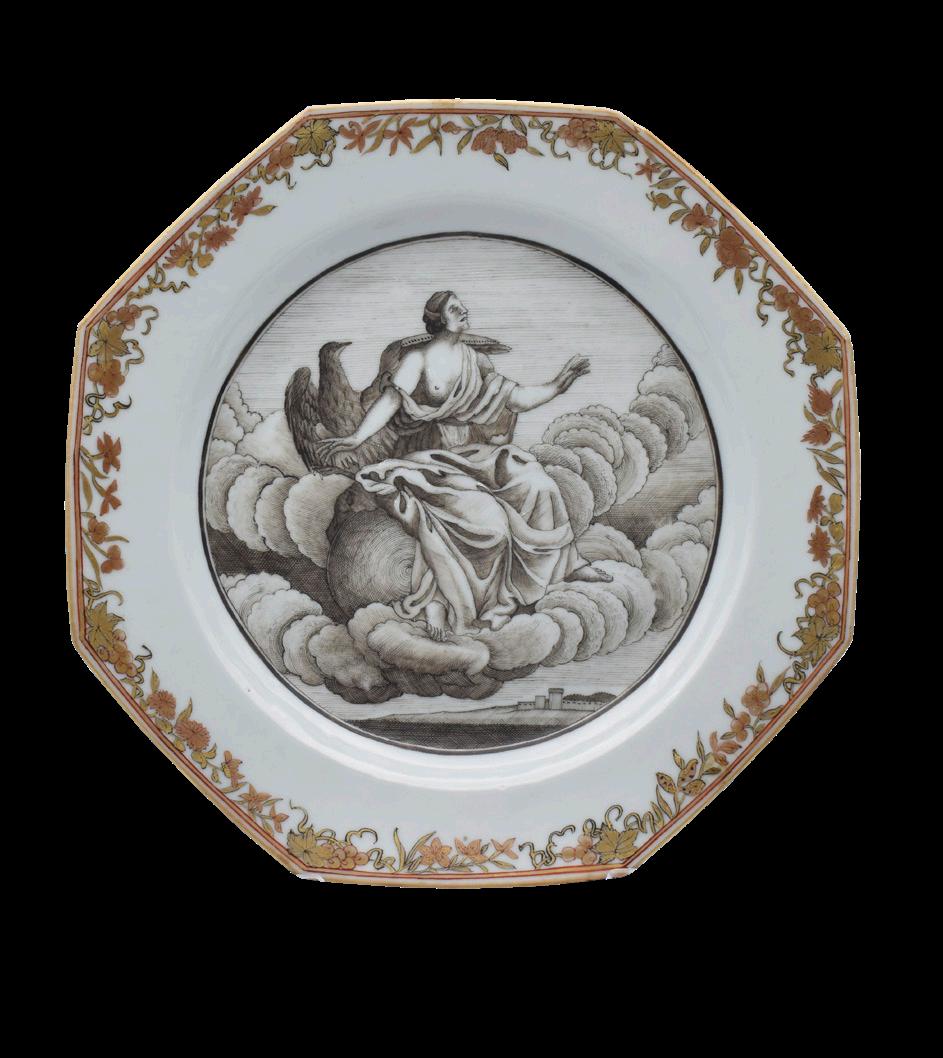
324
A CHINESE EXPORT GRISAILLE-DECORATED PORCELAIN
MYTHOLOGICAL PLATE
QIANLONG PERIOD, CIRCA 1745
Painted with Jupiter and Venus, accompanied by an eagle, peacock and two putti, all within a Du-paquier style border
Diameter 23cm
A similar example is illustrated by Hervouët & Bruneau in La Porcelaine des Compagnie des Indes à Décor Occidental, Paris, 1989, pg. 304, 13.41. Recorded as ‘quite rare’ by the authors
£200-300
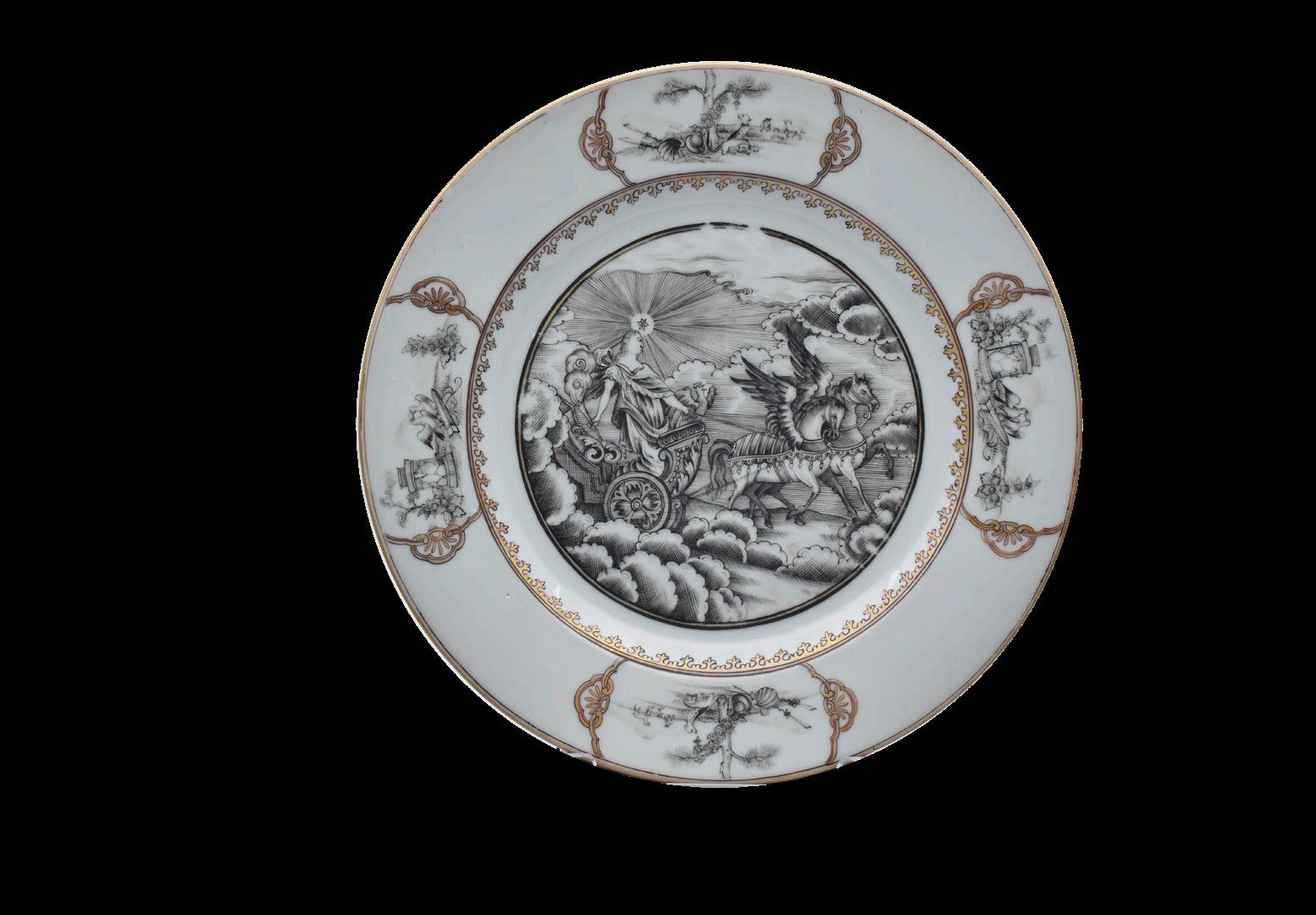

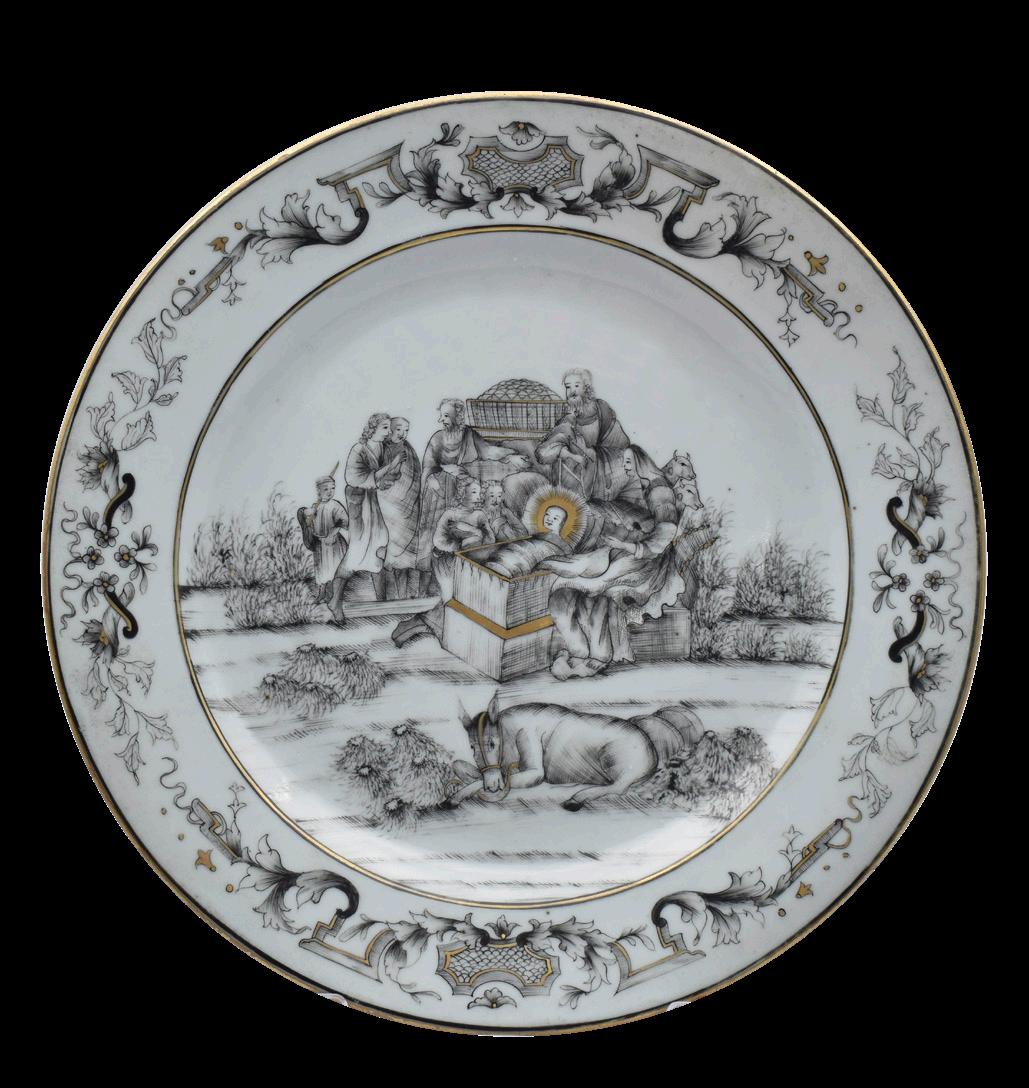

A RARE SET OF THREE CHINESE EXPORT GRISAILLE-DECORATED ‘RELIGIOUS-SUBJECT’ PLATES
QIANLONG PERIOD, CIRCA 1745
Finely painted with the Nativity, Crucifixion and Resurrection, Du-paquier style borders, highlighted in gilding
Diameter 23cm
Similar examples are illustrated by Hervouët & Bruneau in La Porcelaine des Compagnie des Indes à Décor Occidental, Paris, 1989, pg. 263-267, 11.12, 11.21,11.27 Recorded as ‘quite rare’ by the authors (3)
£3,000-5,000


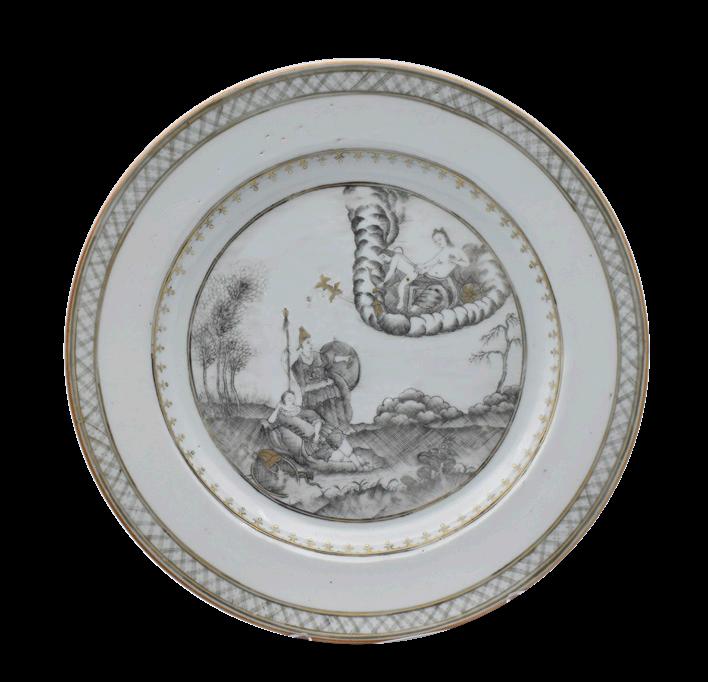
327
A RARE CHINESE EXPORT GRISAILLE-DECORATED PORCELAIN
MYTHOLOGICAL OCTAGONAL PLATE
QIANLONG PERIOD, CIRCA 1745
Finely painted with Hercules and the lion, all within a rouge-de-fer and gilt fruiting vine border
Diameter 21.5cm
A similar example is illustrated by Hervouët & Bruneau in La Porcelaine des Compagnie des Indes a Decor Occidental, Paris, 1989, pg. 298, 13.30. Recorded as ‘very rare’ by the authors
£1,000-1,500
328
A PAIR OF CHINESE EXPORT GRISAILLE-DECORATED PORCELAIN
MYTHOLOGICAL PLATE
QIANLONG PERIOD, CIRCA 1750
Painted with Minerva, Ulysses and Venus, all within diaper borders, brown-dressed rims
22.5cm
(2)
A similar example is illustrated by Hervouët & Bruneau in La Porcelaine des Compagnie des Indes à Décor Occidental, Paris, 1989, pg. 304, 13.51
£400-600
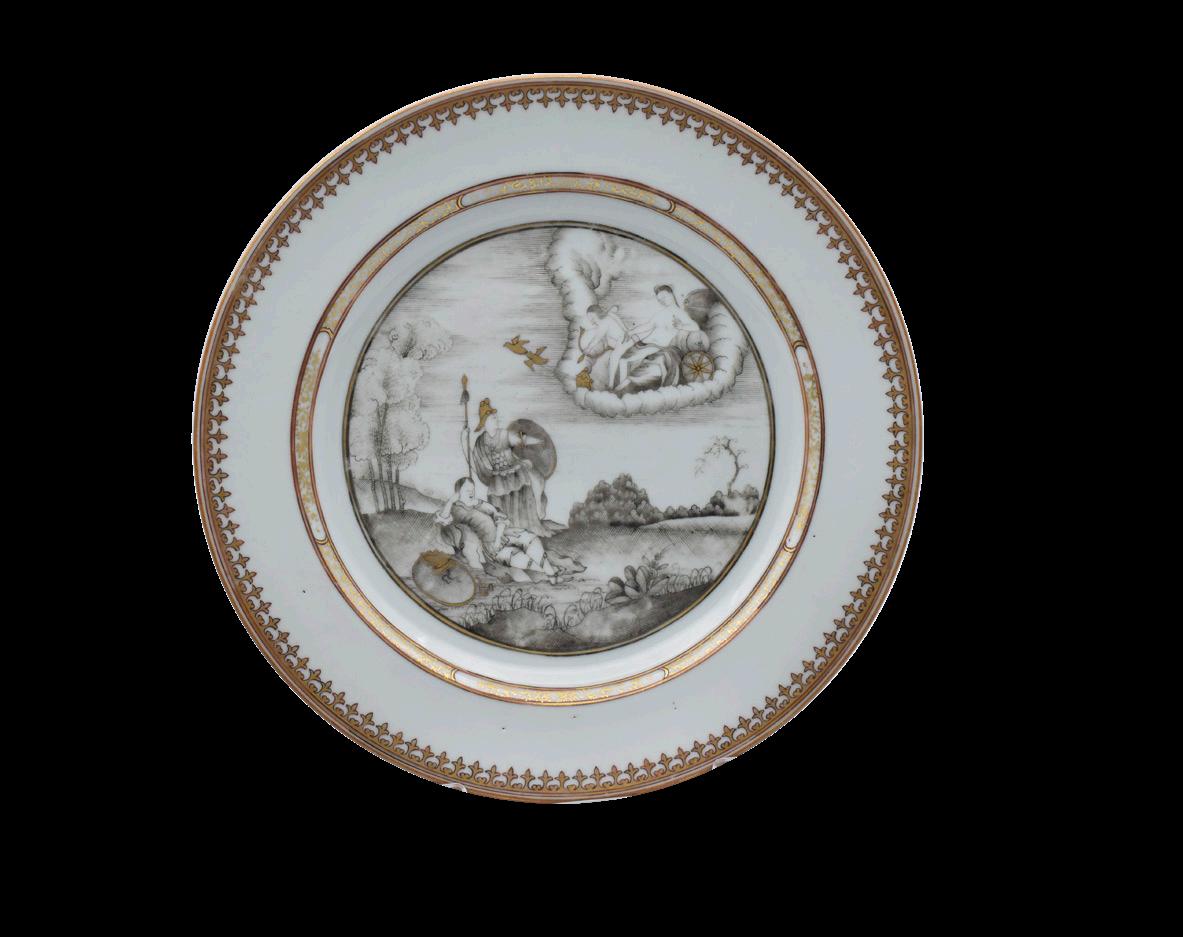
329
A CHINESE EXPORT GRISAILLE-DECORATED PORCELAIN
MYTHOLOGICAL PLATE
QIANLONG PERIOD, CIRCA 1750
Painted with Minerva, Ulysses and Venus, all within diaper borders, brown-dressed rim
22.5cm
A similar example is illustrated by Hervouët & Bruneau in La Porcelaine des Compagnie des Indes à Décor Occidental, Paris, 1989, pg. 304, 13.51
£200-300
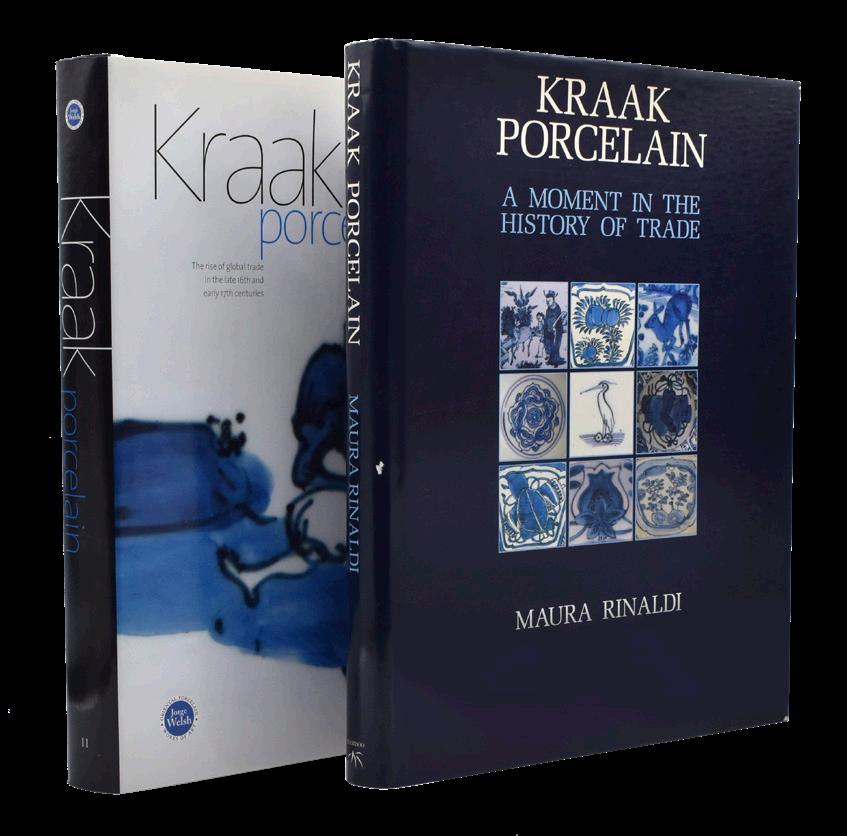
330
KRAAK PORCELAIN: TWO REFERENCE BOOKS
Comprising:
Kraak Porcelain, A MOMENT IN THE HISTORY OF TRADE, Maura Rinaldi, London 1989, hardback, dust-jacket
Kraak porcelain, The rise of global trade in the late 16th and early 17th centuries, Jorge Welsh, London 2008, hardback, dust-jacket (2)
£100-200


331
A SMALL CHINESE BRONZE TWO-HANDLED CENSER
QING DYNASTY
of oval footed form, the rim set with two chilong forming the handles, cast apocryhal Xuande mark to the base
Height 7cm
Diameter 15cm
Weight 406g.
Provenance:
From the Collection of Lt. Col. George Douglas Gray, OBE, MD RAMC (1874-1946) thence by family descent. Dr Gray was the British Legation physician, Peking, between 1904-1926
£300 – 500



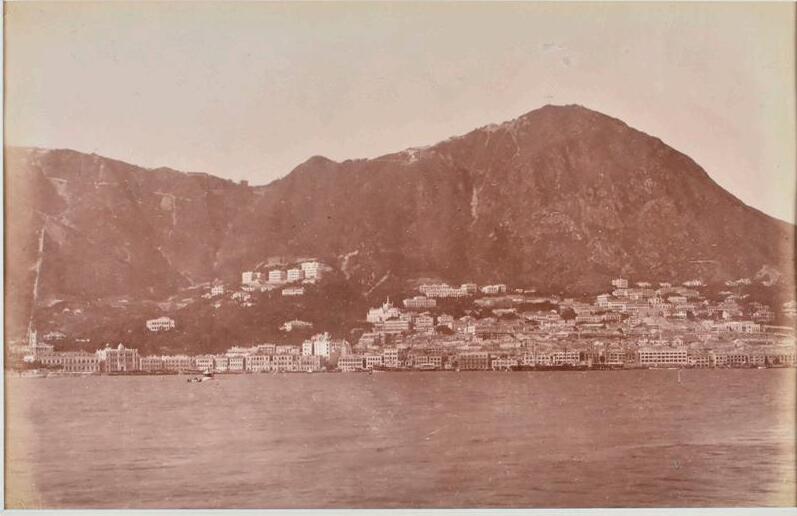
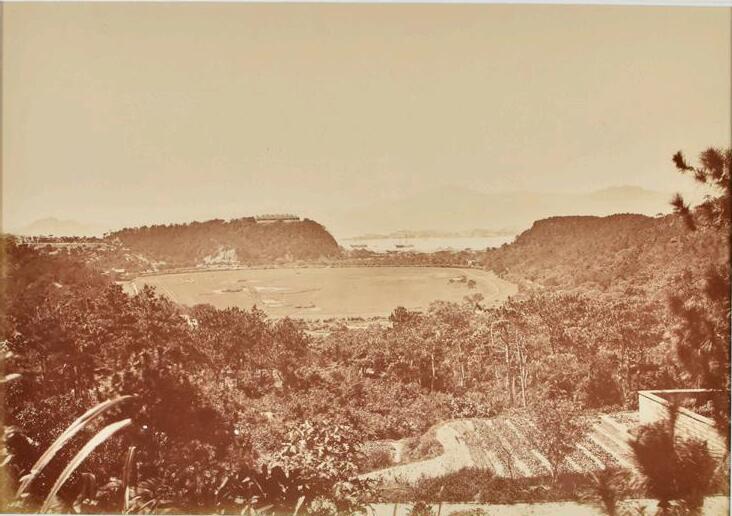
333
HONG KONG: TWO ALBUMEN PRINTS
To include:
Hong Kong, titled in ink Happy Valley, Hong Kong, untitled Laid on card and mounted, largest 18 by 27.5cm (2)
£100-200

332
HONG KONG: A GROUP OF FOUR ALBUMEN PRINTS
To include:
Hong Kong- Victoria Clock Tower from Pedlars Wharf, titled in pencil Hong Kong, NO. 277. PRAYA, printed title Hong Kong Harbour, title inscribed in ink Sampans and Hong Kong island harbour, untitled, all laid on card and mounted; largest 23cm by 29cm (4)
£400-600



334
HONG KONG: THREE ALBUMEN PRINTS
To include:
Hong Kong -Victoria, Joss House, inscribed in pencil Wellington Street, no. 955. printed titled Street view, untitled Laid on card and mounted, largest 22cm by 27cm (3)
£200-300

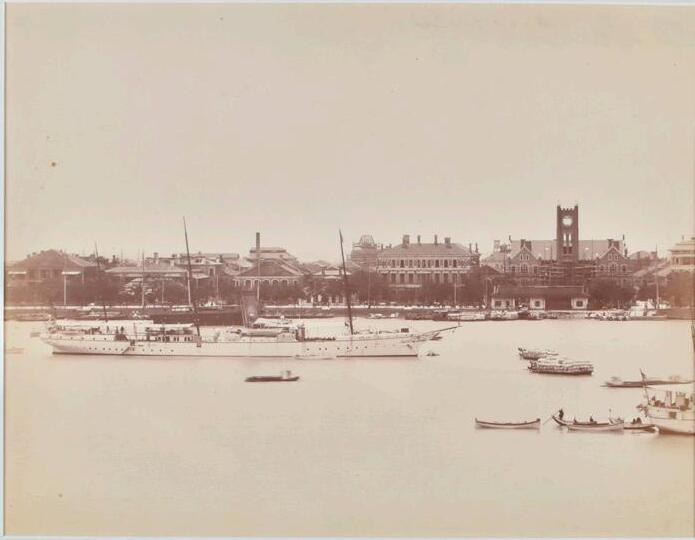

KONG & SHANGHAI: THREE ALBUMENT PRINTS
To include:
Shanghai, European Quarters, pencilled title Hong Kong, Victoria, Looking West from Morrison Hill Sampans in harbour, untitled Laid on card and mounted, largest 20 by 27cm (3)
£300-400



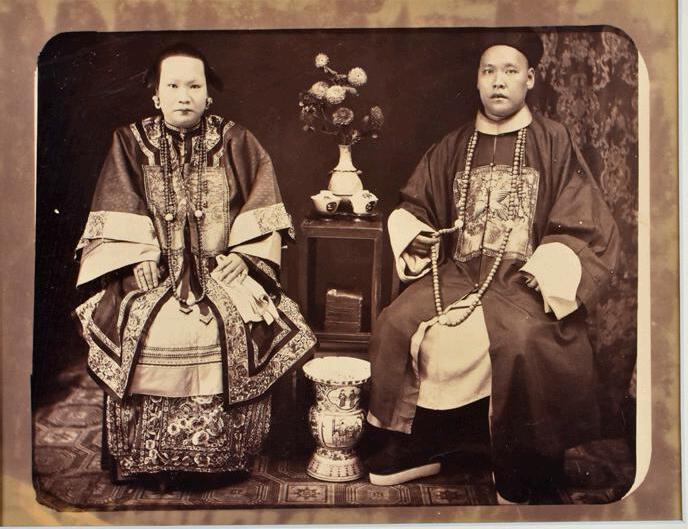
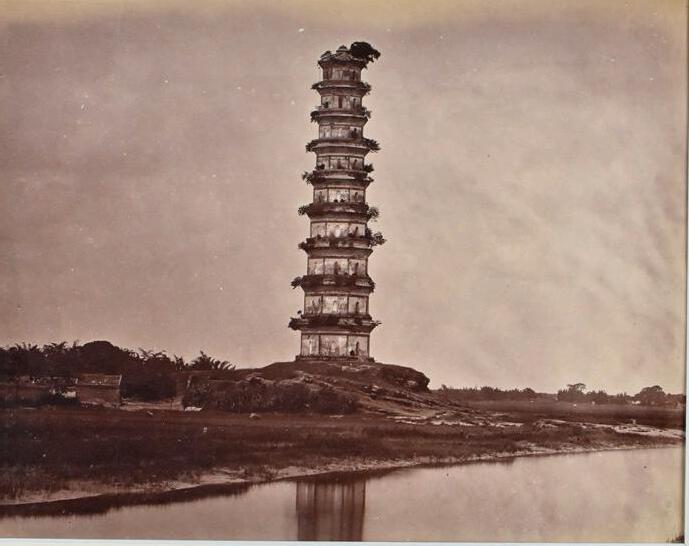
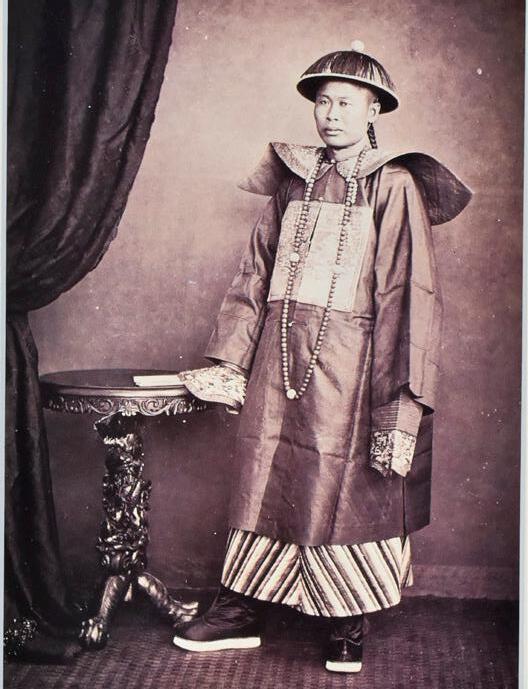
336
To include:
Canton, No. 419.-Pao-chao Pagoda. printed title Canton flower boat, penciled title Mandarin figure, no title Mandarin couple, no title Street in Canton, penciled title
Honam bridge, Canton, penciled title laid on card and mounted, largest 21cm by 27cm together with a hand coloured print, ‘View of Canton; J.S.Frigate, Potomac, Jas. Archer Sc. Boston’, framed and glazed (7)
£300-500

The sides carved with gnarled branches and foliage, the interior rim carved with a finger citron and foliage
Length: 17cm
Width: 10.5cm
Height: 8cm
A 17th century finger citron libation cup was sold at Bonhams New Bond Street, London, Fine Chinese Art, lot 295, 11th May 2017
Provenance: Acquired in the London art market prior to 1943, thence by descent within the family to the present owner
£4,000 - £6,000
Prospective purchasers are advised that several countries prohibit the importation of property containing materials from endangered species, including but not limited to coral, ivory, rhinoceros horn and tortoiseshell. Accordingly, prospective purchasers should familiarise themselves with relevant customs regulations prior to bidding if they intend to import this lot into another country
Please note that an export licence will only be granted for rhinoceros horn objects providing the hammer price meets or exceeds the value of $100 per gram of the items weight

338
A CHINESE CARVED RHINOCEROS HORN JUE SHAPED LIBATION CUP, 17TH/18TH CENTURY
The sides carved with oval cartouches of linghzi, taotie masks and bamboo leaves, the openwork handle carved with bamboo and wutong trees, the interior rim with key-fret border, raised on four legs
Length: 13cm
Width: 7cm wide
Height: 8.5cm
Provenance: Acquired in the London art market prior to 1943, thence by descent within the family to the present owner
A similar cup, dated to the Ming Dynasty, is illustrated in The Complete Collection of the Palace Museum, Bamboo, Wood, Ivory and Rhinoceros Horn carvings, page 138., cat. No. 124. Another four-legged archaistic libation cup is illustrated and discussed by Jan Chapman, The Art of Rhinoceros Horn Carving in China, Christies, London, 1999, page 136, cat no. 151. A similar Jue was sold in these rooms, 18th November 2021, lot 7., from the Collection of H.G.Beasley (1881-1939)
£6,000 - £8,000
Prospective purchasers are advised that several countries prohibit the importation of property containing materials from endangered species, including but not limited to coral, ivory, rhinoceros horn and tortoiseshell. Accordingly, prospective purchasers should familiarise themselves with relevant customs regulations prior to bidding if they intend to import this lot into another country
Please note that an export licence will only be granted for rhinoceros horn objects providing the hammer price meets or exceeds the value of $100 per gram of the items weight
339
A CHINESE EXPORT GOLD FILIGREE AND TORTOISESHELL BANGLE
QING DYNASTY, MID 19TH CENTURY
Of seven sections, finely carved and chased with phoenix ornaments and figural landscape panels, with chilong dragon clasp, original wooden and blue silk lined fitted box, with paper label ‘Lee Ching, from East Street Canton, Gold and Silversmith dealer in ivory ware tortoiseshell and mother of pearl work seal cut and engraved, Hong Kong Queens Road’ (2)
Length: 18cm, The box: 23.5cm
Lee Ching was active in Canton, Hong Kong and Shanghai, circa 1830-1895. See Adrian von Ferscht, Chinese Export Silver 17851940, 4th Edition, 2015)
£2,000 - £3,000
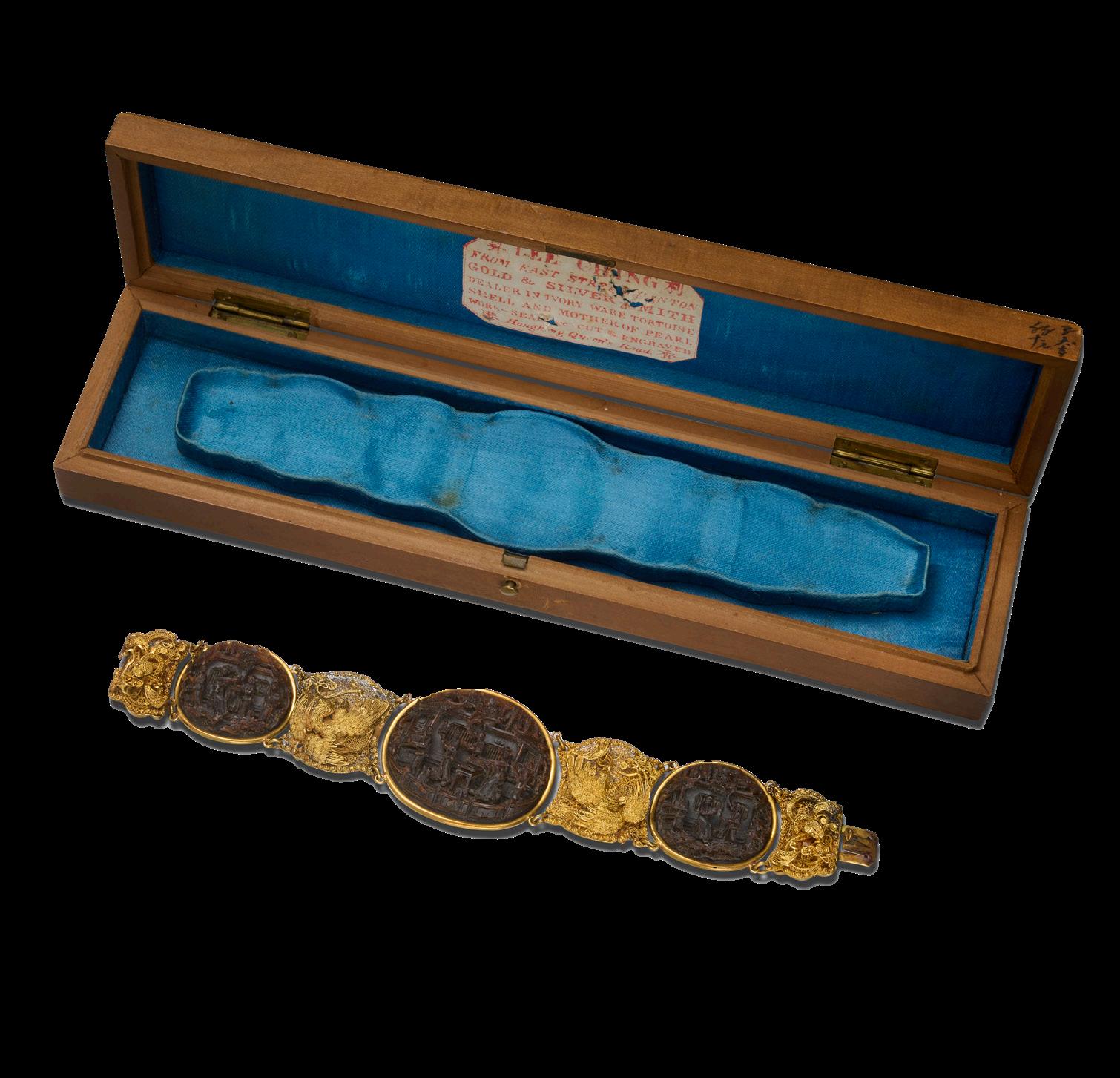
340
QING DYNASTY, 19TH CENTURY
The five petalled flower holder hung with flowerheads, chain swags and drop pendants, all set on a spring-loaded tripod base with detachable locking screw and chain (2)
Deployed height: 13cm
A similar Chinese export flower holder, labelled Cutshing (from the collection of the Peabody Essex Museum, Salem) is illustrated by H.A. Crosby Forbes, Chinese Export Silver, 1785-1885, Milton, 1975, page 239, fig. 207
£200 - £300

341
A LARGE CHINESE EXPORT PORCELAIN ‘FAMILLE-ROSE’
TABLE CENTRE PIECE
QING DYNASTY, QIANLONG PERIOD, CIRCA 1760
Of pierced oval form set with two rouge-de-fer and gilt handles, painted to the centre with tied floral bouquets including peony, chrysanthemums and day lillies, all within a simulated ‘bamboo’ border, a turquoise diaper band beneath the rim
Height 8cm
Length 38cm
Width 28cm
A similar pierced table basket is in the Collection of Ricardo do Espírito Santo Silva, Porcelanas da China, Lisbon, 2002, page 50.
£800-1,200
342
SHANGHAI BOWUGUAN CANGHUA
(PAINTINGS IN THE SHANGHAI MUSEUM COLLECTION) 1959
Coloured photographic reproductions mounted on plates with Chinese text and illustrations, original binding with blue velvet wrapping, Chinese style brocade portfolio, in a paper backed box (2)
£100 - £200
343
A PAIR OF CHINESE EXPORT ‘FAMILLE-ROSE’ PORCELAIN ROOSTER
TEA BOWLS AND SAUCER
QING DYNASTY, YONGZHENG PERIOD, CIRCA 1730
Each piece of tapering conical form, brightly painted to the centre with rooster roundels on a yellow-diaper ground, amongst pink fanshaped panels, painted with flowers (4)
The saucers diameter: 10.6cm
£400 - £600
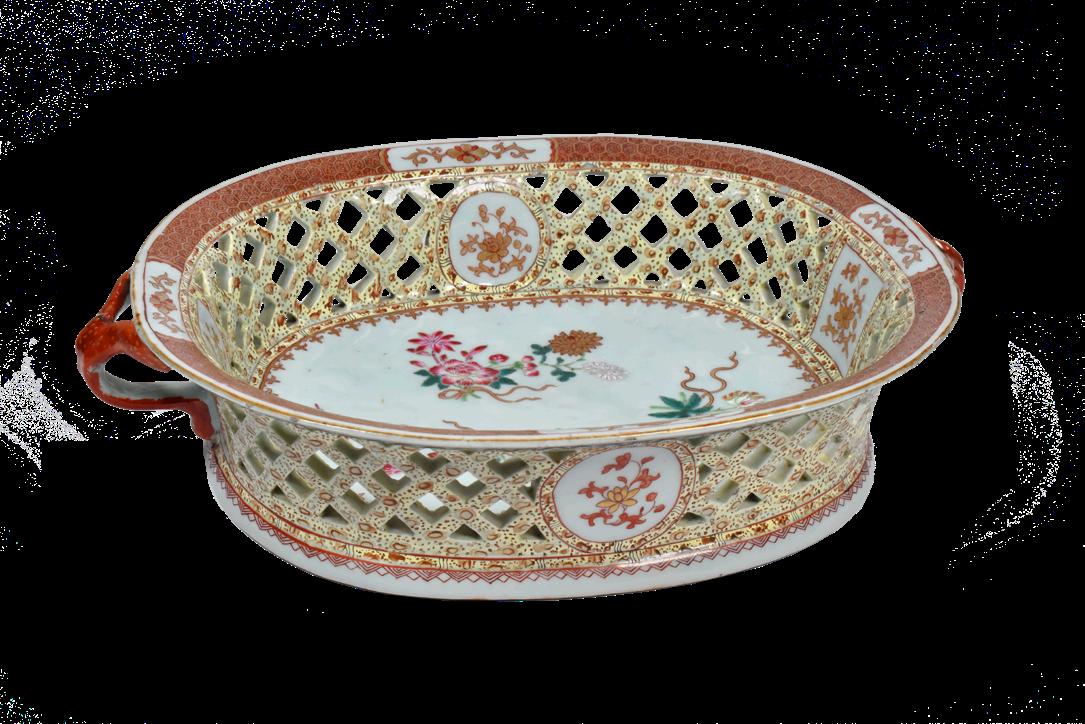
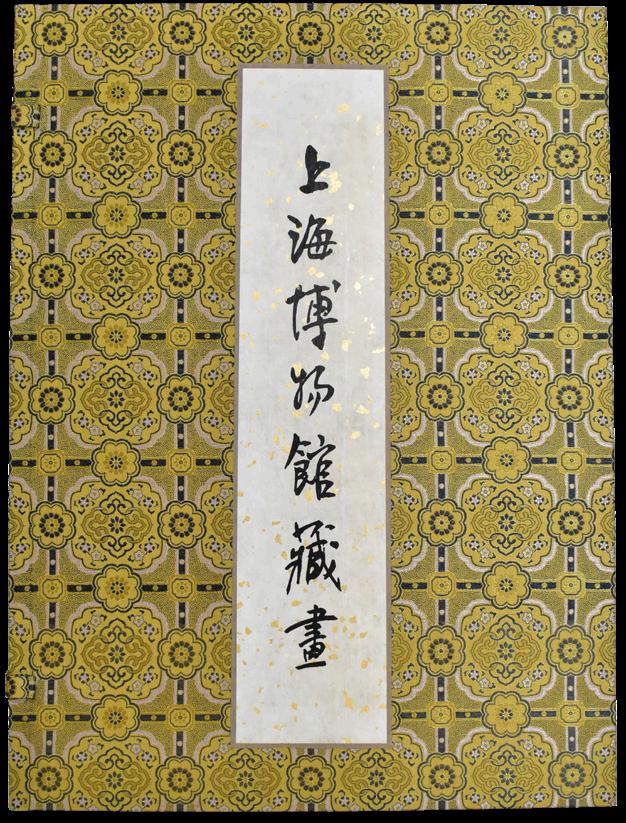

344
A GROUP OF CHINESE EXPORT ARMORIAL PORCELAINS
QING DYNASTY, LATE QIANLONG PERIOD
To include an armorial plate with the arms of Cunningham, circa 1795, a milk jug and cover, a coffee cup, five tea bowls the majority with blue line and gilt decorated borders (9)
The Cunningham plate: 24.5cm
This plate, purchased by the author in Bombay in 1970, illustrated and discussed by D. S. Howard in Chinese Armorial Porcelain, Vol. II, p.601
£100 - £200

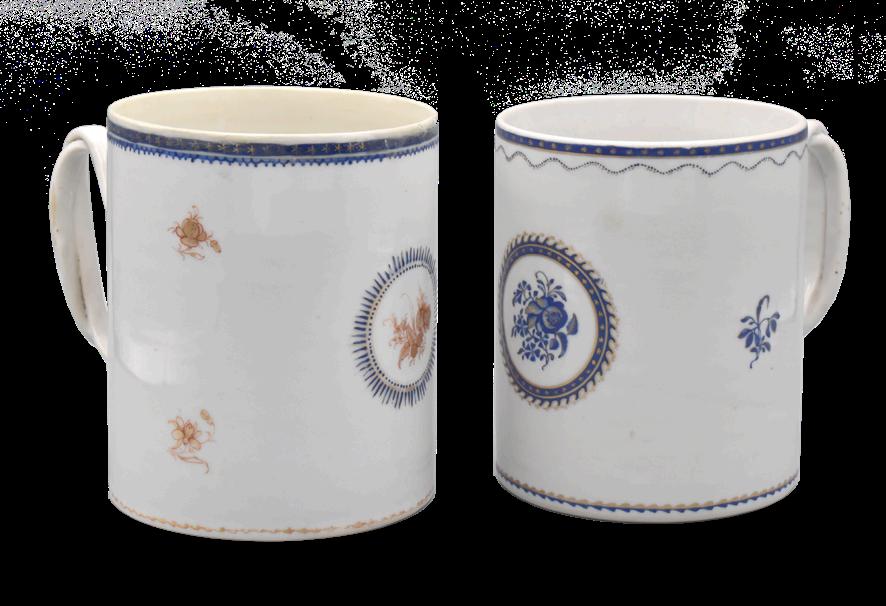
345
TWO CHINESE EXPORT PORCELAIN TANKARDS
QING DYNASTY, QIANLONG PERIOD, CIRCA 1790
Probably for the American market painted with floral roundels within blue and gilt borders (2)
Height: the tallest 12.5cm
£100 - £200
346
A CANTONESE GILT AND BLACK LACQUER RECTANGULAR BOX
QING DYNASTY, MID 19TH CENTURY
Each side decorated in gilt with Chinese court scenes within shaped cartouches, with gilt-metal handles, the interior of the hinged lid with a monogram and bamboo fronds
Height: 21.5cm
Length: 33.5cm
Depth: 28cm
£100 - £200
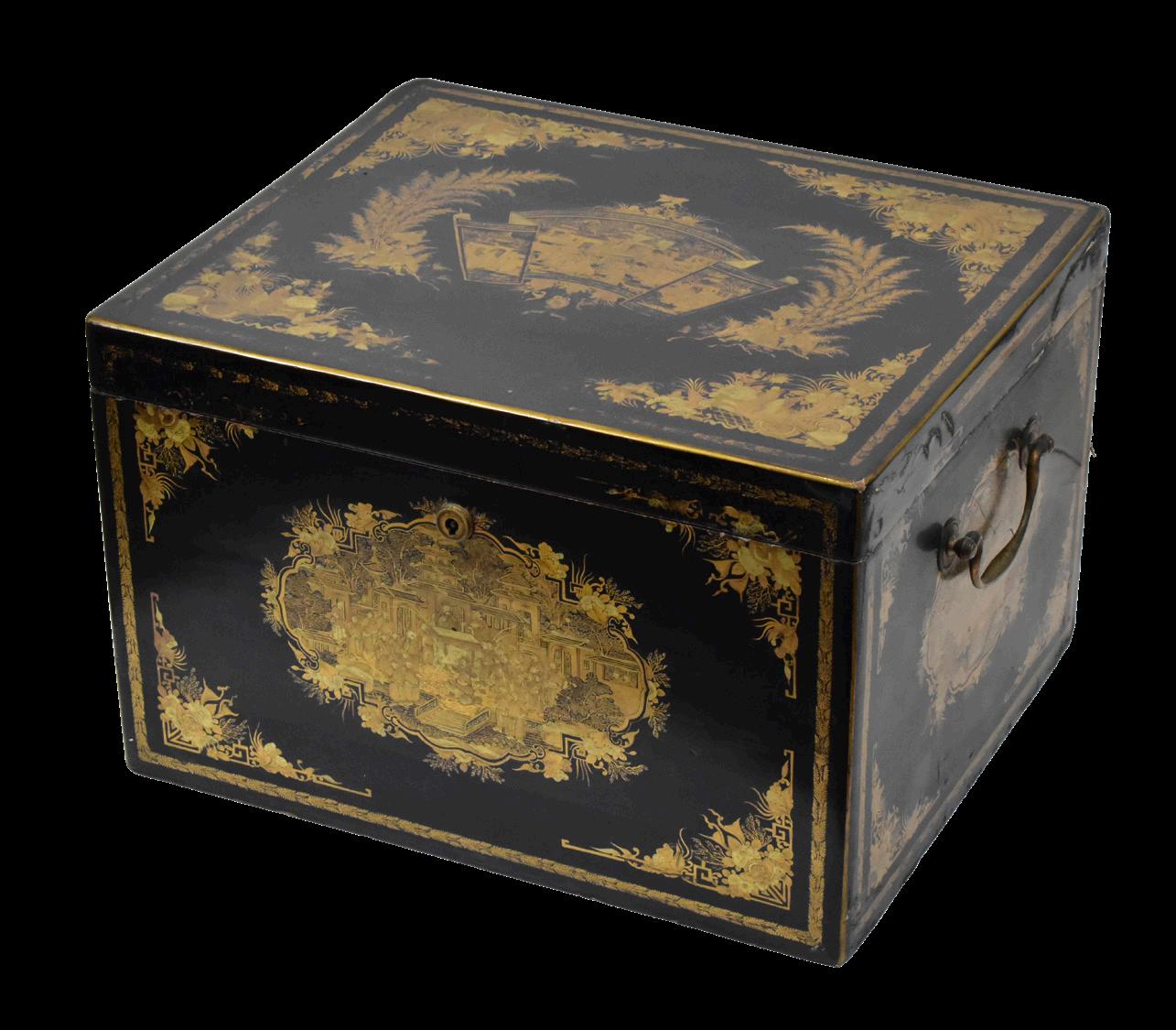

A CHINESE GREEN-GLAZED PORCELAIN BOWL
KANGXI PERIOD, 1662-1722
Of elegantly potted ogee form, covered in a slightly iridescent pea-green translucent glaze, the base with a ‘fuku’ seal mark within a double-circle in underglaze-blue
Diameter 19.2cm
Height 9cm
£2,000-3,000
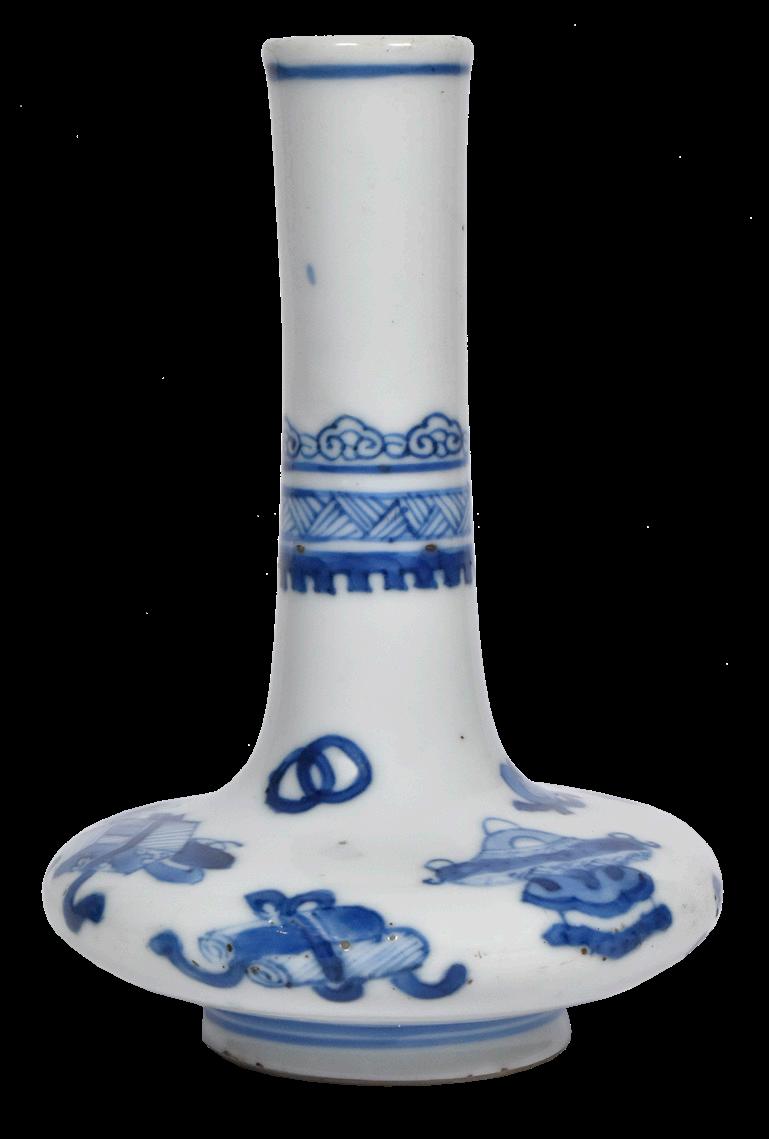
A CHINESE BLUE AND WHITE ‘ANTIQUES’ PORCELAIN BOTTLE VASE
KANGXI PERIOD, 1662-1722
Of flattened mallet form, painted with classical antiques, beneath diaper, key-fret and ruji-head bands
Height 12cm
Provenance: Etlin Collection, Veritas, 5th December 2023, lot 28
£300-600
349
A CHINESE BLUE AND WHITE ‘KRAAK PORSELEIN’ BOTTLE VASE
MING DYNASTY, WANLI PERIOD, 1595-1710
Of elegant pear shape with a slender waisted neck beneath a garlic mouth, well painted in underglaze-blue with alternating panels of two vases and a jardiniere containing flowers divided by tassels and scrolls beneath a ruyi-head band, the neck with tassled pendants
Height 28cm
Provenance:
John Alexander Pope Collection, (1906-1982) no. 370
Etlin Collection, Veritas, 5th December 2023, lot 13
A similar bottle vase is illustrated and discussed by Maura Rinaldi, Kraak Porcelain, A Moment in the History of Trade, London 1989, p.171, pl. 214.
£2,000-3,000
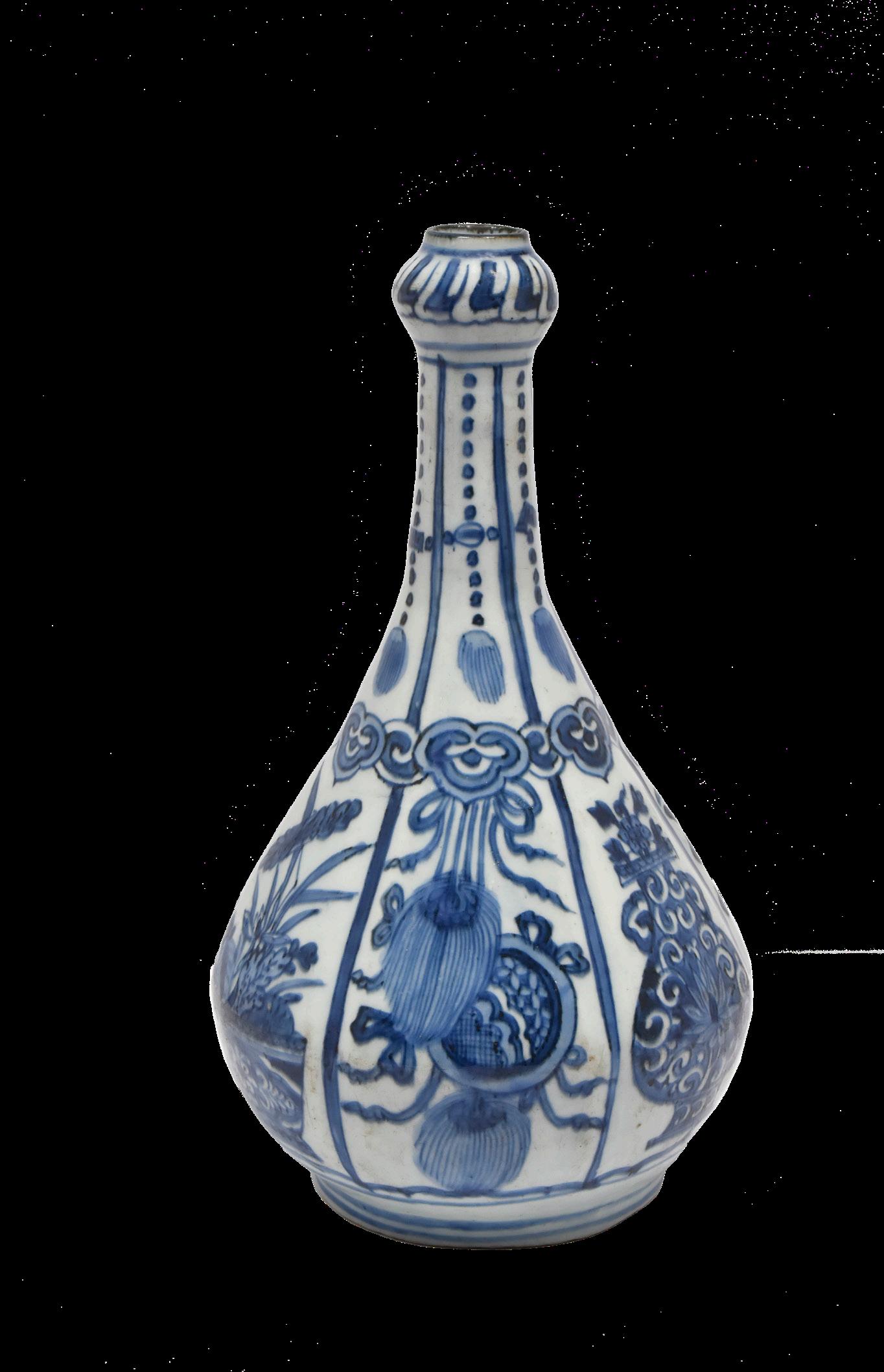

350
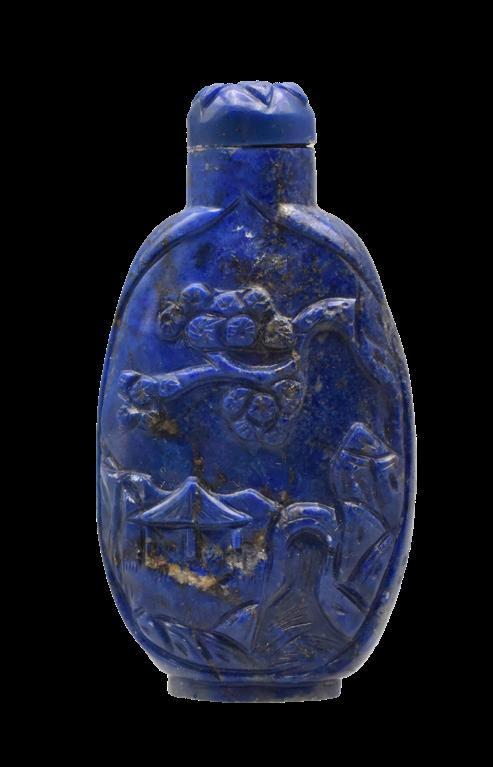
A CHINESE LAPIZ LAZULI SNUFF BOTTLE AND STOPPER
QING DYNASTY, 19TH CENTURY
Carved to one side with a pagoda beneath a pine tree, the other with a pair of mandarin ducks
Height: 6cm
£200 - £300
351
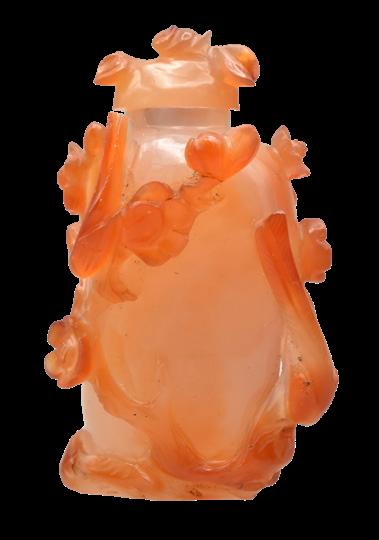
A CHINESE CARVED AGATE SNUFF BOTTLE 20TH CENTURY
Carved with birds and flowers
Height: 6.5cm
£60 - £80
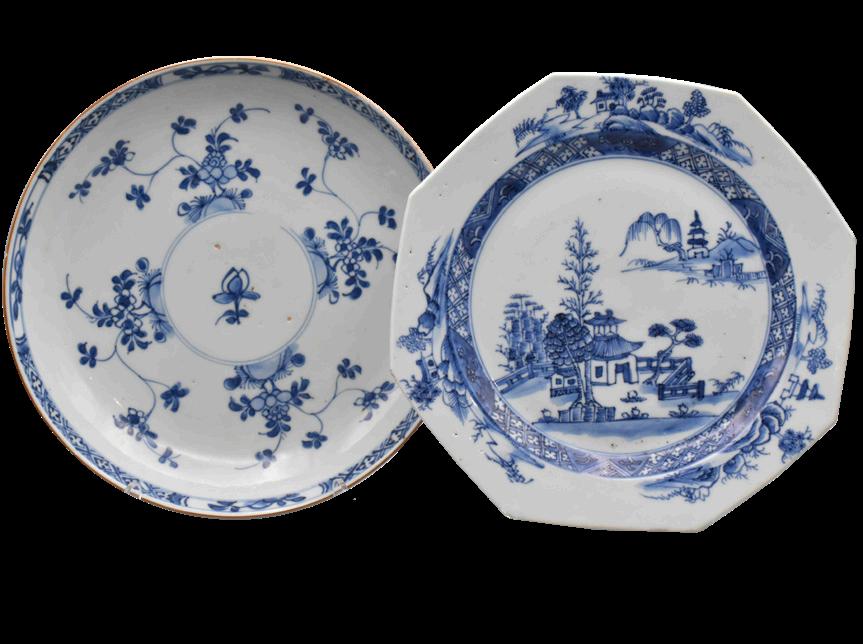
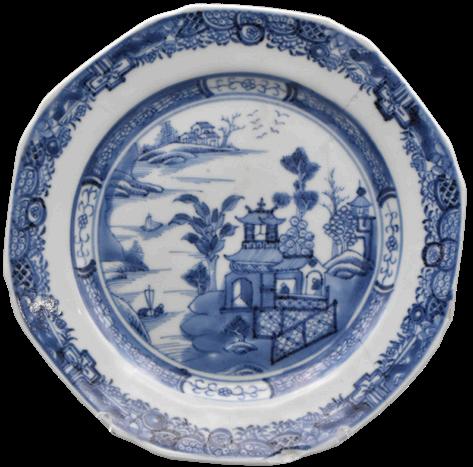
353
A GROUP OF THREE PIECES OF CHINESE EXPORT BLUE AND WHITE PORCELAIN
QING DYNASTY, 18TH CENTURY
To include a Kangxi period floral shallow dish and two octagonal plates (3)
Shallow dish diameter: 22cm
£80 - £120
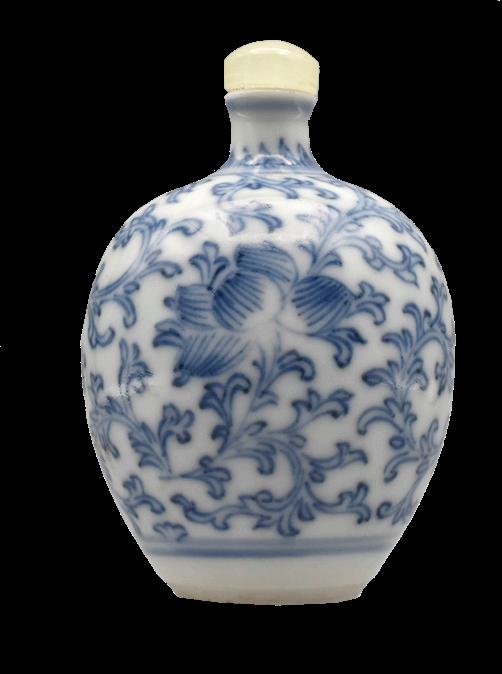
352
A CHINESE BLUE AND WHITE PORCELAIN SNUFF BOTTLE
QING DYNASTY, 19TH CENTURY
Of globular form, painted with lotus flowers and foliage
Height: 7cm
£100 - £200
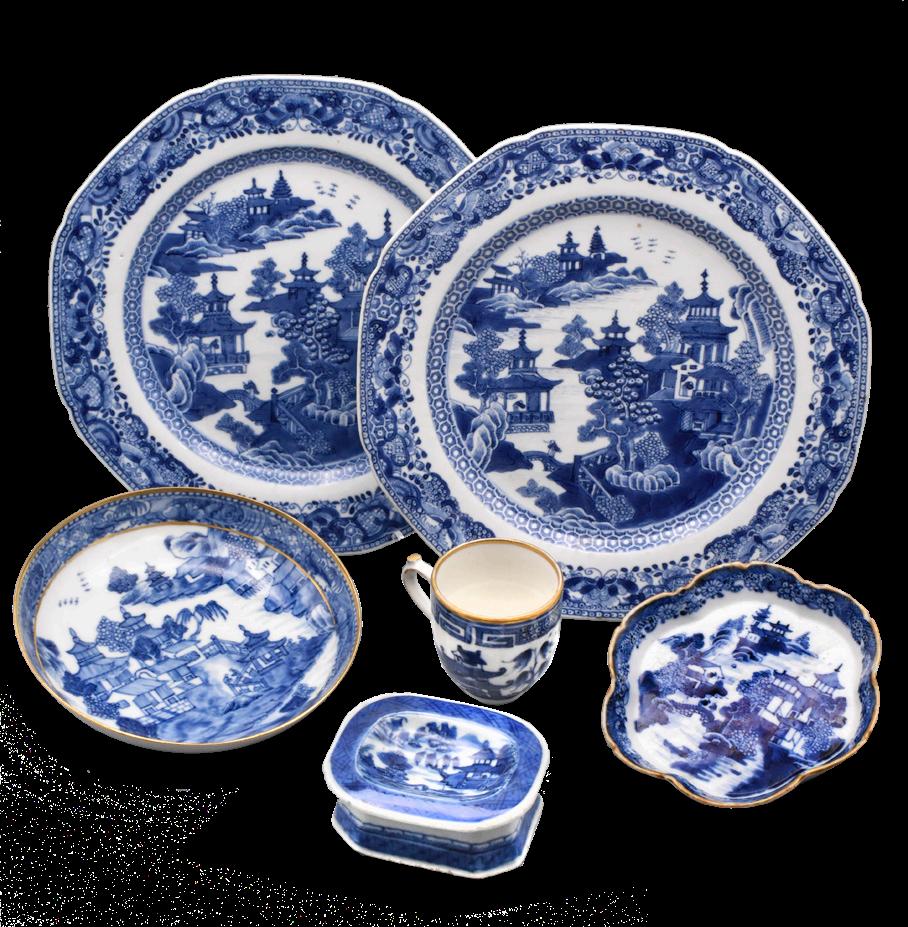
354
A COLLECTION OF CHINESE EXPORT BLUE AND WHITE PORCELAINS
QING DYNASTY, QIANLONG PERIOD
Predominantly based on a willow pattern design, to include a pair of octagonal plates, a shallow saucer dish with a gilt rim, a tea pot stand, a salt and a coffee cup (6)
Plates diameter: 23cm
£100 - £200
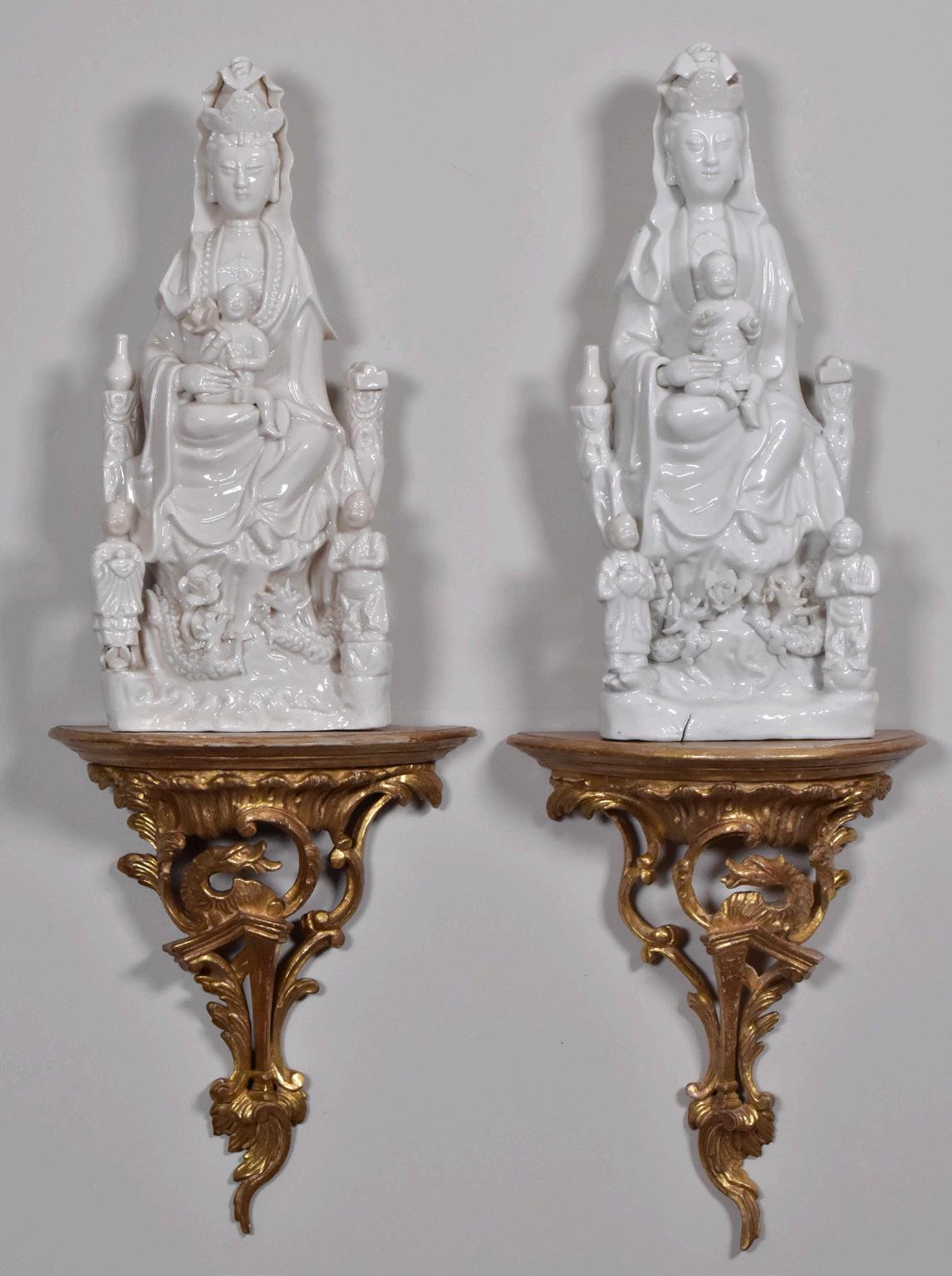
From the Dehua kilns, Fujian, each benevolent Goddess of Mercy modelled seated on a rocky mound accompanied by a boy on her lap, flanked by acolytes and a dragon at her feet, with a wave strewn base, together with a pierced giltwood carved rococo-style wall bracket, with dragons amongst foliate C-scrolls (4)
The tallest: 38cm The brackets: 30cm
Compare with a smaller blanc-de-chine figure of Guanyin, circa 1660 – 1690, illustrated by J. Ayers, Chinese and Japanese Works of Art in the Collection of Her Majesty the Queen, London, 2016, pl.303, p.156. Chinese Lobby, Windsor Castle. Another of a similar size sold at Bonhams London, New Bond Street, 27th-7th November, lot 240
£1,000 - £1,500
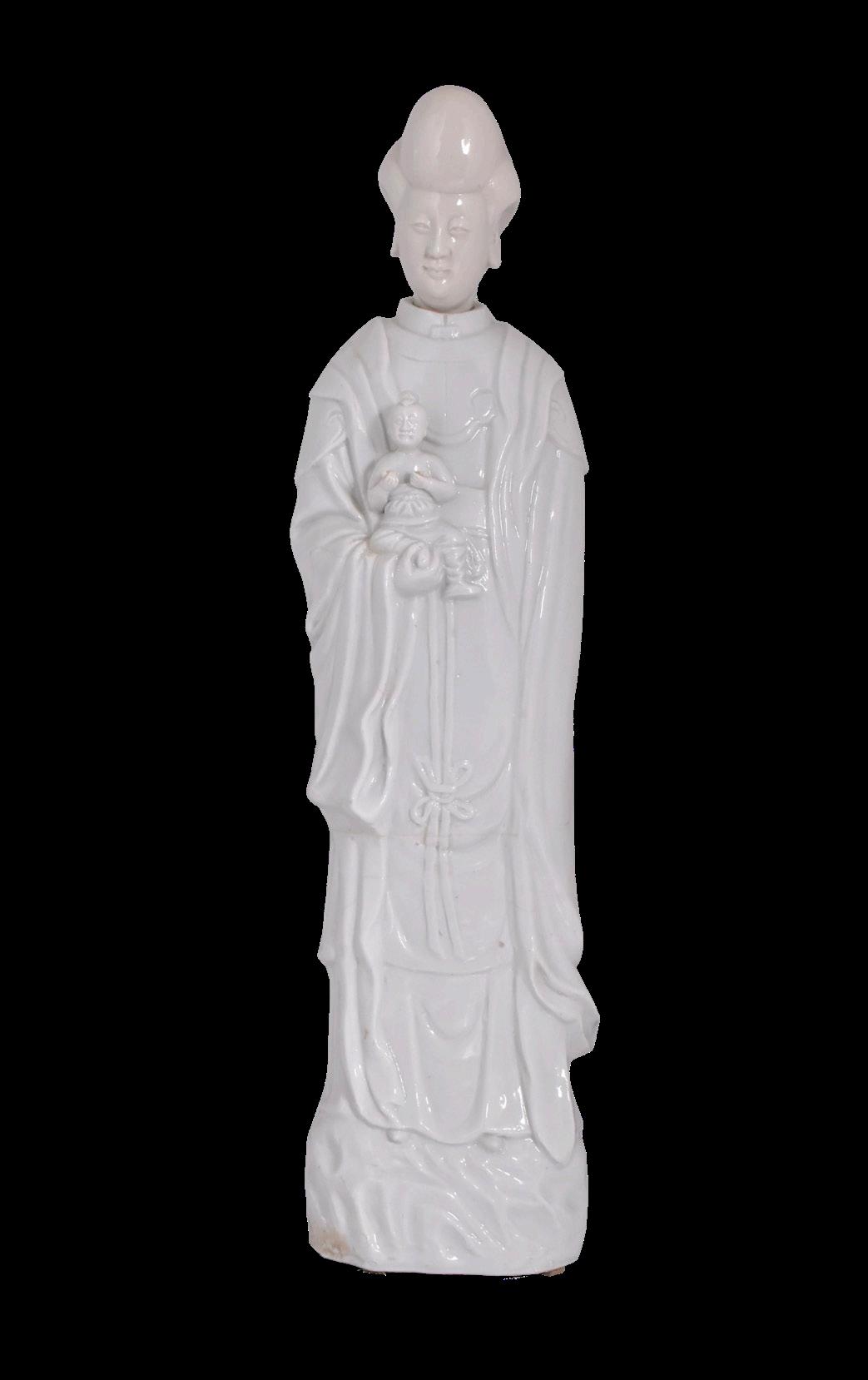
A LARGE CHINESE BLANC-DE-CHINE
FIGURE OF GUANYIN
QING DYNASTY, KANGXI PERIOD, 1662 – 1722
Modelled standing, with a detachable head, holding a small boy in her right arm, a lotus flower in his hands
Height: 65cm
£800 - £1,200 357
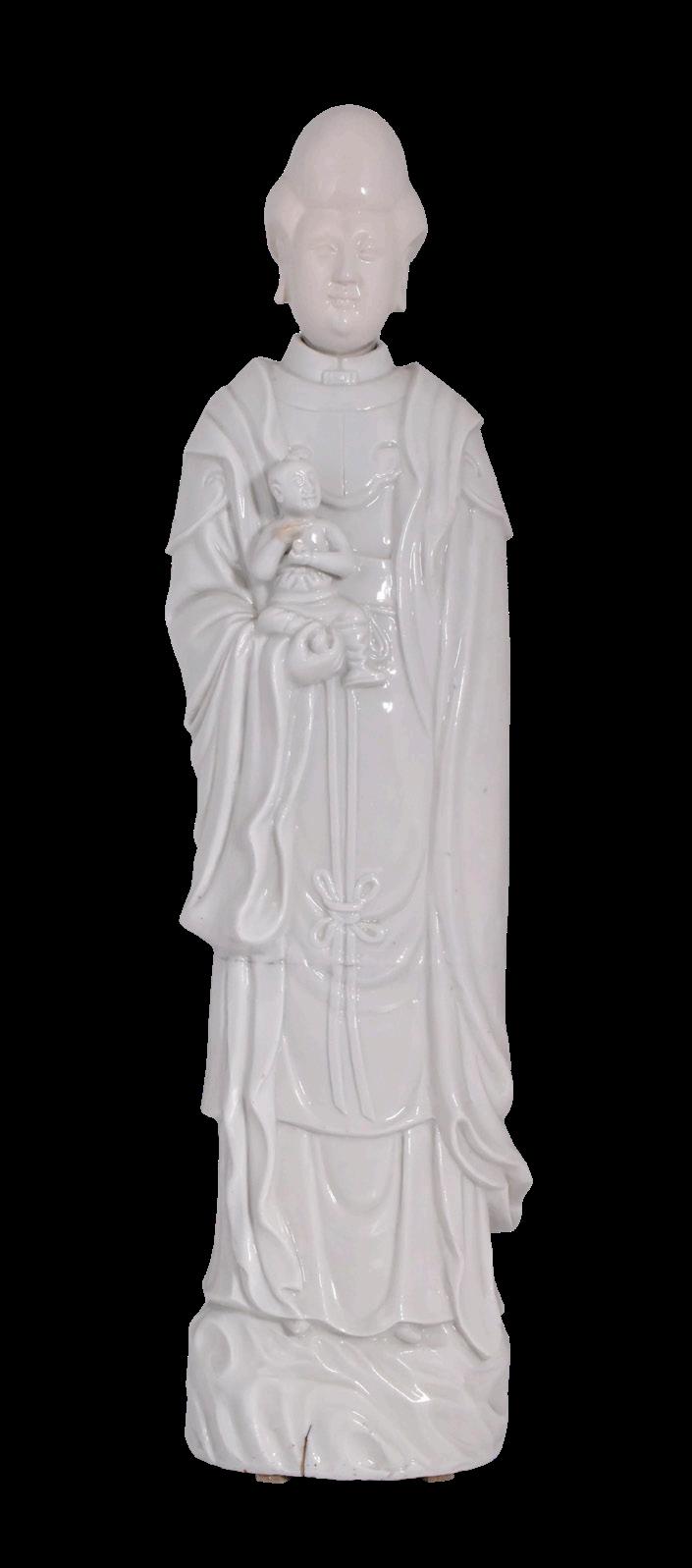
A LARGE CHINESE BLANC-DE-CHINE FIGURE OF A GUANYIN
QING DYNASTY, KANGXI PERIOD, 1662 – 1722
Modelled standing, with a detachable head, holding a small boy in her right arm, a lotus flower in his hands
Height: 65cm
£800 - £1,200
1.Introduction. The following informative notes are intended to assist Buyers, particularly those inexperienced or new to our salerooms. All sales are conducted on our printed Conditions of Sale which are readily available for inspection and normally accompany catalogues. Our staff will be happy to help you if there is anything you do not fully understand.
2. Agency. As auctioneers we usually contract as agents for the seller whose identity, for reasons of confidentiality, is not normally disclosed. Accordingly if you buy your primary contract is with the seller.
3. Estimates. Estimates are designed to help buyers gauge what sort of sum might be involved for the purchase of a particular lot. The lower estimate may represent the reserve price and certainly will not be below it. Estimates do not include the Buyer’s Premium or VAT (where chargeable). Estimates are prepared some time before the sale and may be altered by announcement before the sale. They are in no sense definitive.
4. The purchase price. The Buyer shall pay the hammer price together with a premium thereon of 25% plus VAT @20% (totalling 30% inclusive) on the first £500,000 and 12% plus VAT @20% (14.4%) inclusive thereafter.
5. VAT. (†) indicates that VAT at the current standard rate is payable by the purchaser on the hammer price as well as being an element in the buyer’s premium. This imposition of VAT is likely to be because the seller is registered for VAT within the European Union and is not operating the Dealers Margin Scheme or because VAT is due at 20% on importation into the UK. The symbol (Ω) indicates that the lot has been imported from outside the UK and the present position is that these lots are liable to a reduced rate of VAT (5%) on the gross lot price (i.e. both the hammer price and the buyer’s premium). Lots which appear without either of the above symbols indicate that no VAT is payable on the hammer price. This is because such lots are sold using the Auctioneers’ Margin Scheme and it should be noted that the VAT included within the Premium is not recoverable as input tax. (As at 31st December 2020. Please refer to SOFAA website for updates to the Terms and Conditions).
6. We are, primarily, agents for the seller. We are dependent on information provided by the seller and whilst we may inspect lots and act reasonably in taking a general view about them we are normally unable to carry out a detailed or any examination of lots in order to ascertain their condition in the way in which it would be wise for a buyer to do. Intending buyers have ample opportunity for inspection of goods and, therefore, accept responsibility for inspecting and investigating lots in which they may be interested. Please note carefully the exclusion of liability for the
condition of lots contained in the Conditions of Sale. Neither the seller nor we, as the auctioneers, accept any responsibility for their condition. In particular, mechanical objects of any age are not guaranteed to be in working order. However, in so far as we have examined the goods and make a representation about their condition, we shall be liable for any defect which that examination ought to have revealed to the auctioneer but which would not have been revealed to the buyer had the buyer examined the goods. Additionally, in specified circumstances lots misdescribed because they are ‘deliberate forgeries’ may be returned and repayment made. There is a 3 week time limit. (The expression ‘deliberate forgery’ is defined in our Conditions of Sale).
7 Electrical goods. These are sold as ‘antiques’ only and if bought for use must be checked over for compliance with safety regulations by a qualified electrician first.
8.Export of goods. Buyers intending to export goods should ascertain(a) whether an export licence is required for the goods to leave the U.K. and (b) whether there is any specific prohibition on importing the goods in question into the destination country because, e.g. they may contain prohibited materials such as ivory. Charges may be applicable for export licences. Ask us if you need help. The denial of any permit or licence shall not justify cancellation or rescission of the sale contract or any delay in payment.
9.Bidding. Bidders will be required to register before the sale commences and lots will be invoiced to the name and address on the registration form. Some form of identification will be required if you are unknown to us. Please enquire in advance about our arrangements for telephone bidding.
10.Commission bidding. Commission bids may be left with the auctioneers indicating the maximum amount to be bid excluding buyers’ premium. They will be executed as cheaply as possible having regard to the reserve (if any) and competing bids. If two buyers submit identical commission bids the auctioneers may prefer the first bid received. Please enquire in advance about our arrangements for the leaving of commission bids by telephone or fax.
11.Methods of Payment. As a general rule any cheques tendered will need to be cleared before removal of the goods is permitted. Please discuss with our Office in advance of the sale if other methods of payment are envisaged (except cash).
12.Collection and storage. Please note what the Conditions of Sale state about collection and storage. It is important that goods are paid for and collected promptly. Any delay may involve the buyer in paying storage charges.
1. Interpretation. In these Terms the words ‘you’, ‘yours’, etc. refer to the Seller and if the consignment of goods to us is made by an agent we assume that the Seller has authorised the consignment and that the consignor has the Seller’s authority to contract. Similarly the words ‘we’, ‘us’, etc. refer to the Auctioneers.
2. Commission is charged to sellers at the following rates: 15% + VAT on each lot sold for up to £999, 10% + VAT on each lot realising £1,000 and above.
3. Removal costs. Items for sale must be consigned to the sale room by any stated deadline and at your expense. We may be able to assist you with this process but any liability incurred to a carrier for haulage charges is solely your responsibility.
4. Loss and damage waiver. We are not regulated by the FSA for the provision of insurance to clients. However, we for our own protection assume liability for property consigned to us at lower pre-sale estimate. To justify accepting liability, we make a charge of 1.5% of the hammer price plus VAT or, if unsold, our mid estimate of the hammer price. If the owner of goods consigned instructs us in writing not to take such action, they then remain at owner’s risk unless and until the property in them passes to the Buyer or they are collected by or on behalf of the owner, and clause 4 is inapplicable.
5. Illustrations. The cost of any illustrations is borne by you. If we consider that the lot should be illustrated your permission will usually be asked first. The copyright in respect of such illustrations shall be the property of us, the auctioneers, as is the text of the catalogue.
6. Minimum bids and our discretion. Goods may be offered subject to a reserve agreed between us before the sale in accordance with clause 7.
7. We may sell lots below the reserve provided we account to you for the same sale proceeds as you would have received had the reserve been the hammer price. If you specifically give us ‘discretion’ we may accept a bid of up to 10% below the formal reserve. Reserves.
(a) You are entitled to place prior to the auction a reserve on any lot consigned, being the minimum hammer price at which that lot may be sold. Reserves must be reasonable and we may decline to offer goods which in our opinion would be subject to an unreasonably high reserve (in which case goods carry the storage and insurance charges stipulated in these Terms of Consignment).
(b) A reserve once set cannot be changed except with our consent.
(c) Where a reserve has been placed only we may bid on your behalf and only up to the reserve (if any) and you may in no circumstances bid personally.
8. Electrical items. These are subject to detailed statutory safety controls. Where such items are accepted for sale you accept responsibility for the cost of testing by external contractors. Goods not certified as safe by an electrician (unless antiques) will not be accepted for sale. They must be removed at your expense on your being notified. We reserve the right to dispose of unsafe goods as refuse, at your expense.
9. Soft furnishings. The sale of soft furnishings is strictly regulated by statute law in the interests of fire safety. Goods found to infringe safety regulations will not be offered and must be removed at your expense. We reserve the right to dispose of unsafe goods as refuse, at your expense. The rights of disposal referred to in clause 8 and 9 are subject to the provisions of The Torts (Interference with Goods) Act 1977, Schedule 1, a copy of which is available for inspection on request.
10. Descriptions. Please assist us with accurate information as to the provenance etc. of goods where this is relevant. There is strict liability for the accuracy of descriptions under modern consumer legislation and in some circumstances responsibility lies with sellers if inaccuracies occur. We will assume that you have approved the catalogue description of your lots unless informed to the contrary. Where we are obliged to return the price to the buyer when the lot is a deliberate forgery under Condition 15 of the Conditions of Sale and we have accounted to you for the proceeds of sale you agree to reimburse us the sale proceeds. The liability to reimburse the sale proceeds shall not arise where you are acting reasonably and honestly and are unaware of the forgery but we are or ought to have been aware of it.
11. Unsold and withdrawn items. If an item is unsold it may with your consent be re-offered at a future sale. Where in our opinion an item is unsaleable you must collect such items from the saleroom promptly on being so informed. Otherwise, storage charges may be incurred. We reserve the right to charge for storage in these circumstances at a reasonable daily rate.
12. Withdrawn and bought in items. These are liable to incur a charge of up to 10% plus VAT of the reserve or low estimate on being bought in or withdrawn after being catalogued.
13. Conditions of Sale. You agree that all goods will be sold on our Conditions of Sale. In particular you undertake that you have the right to sell the goods either as owner or agent for the owner. You undertake to compensate us and any buyer or third party for all losses liabilities and expenses incurred in respect of and as a result of any breach of this undertaking.
14. Authority to deduct commission and expenses and retain premium and interest.
(a) You authorise us to deduct commission at the stated rate and all expenses incurred for your account from the hammer price and consent to our right to retain beneficially the premium paid by the buyer in accordance with our Conditions of Sale and any interest earned on the sale proceeds until the date of settlement.
(b) You authorise us in our discretion to negotiate a sale by private treaty not later than the close of business on the day of the sale in the case of lots unsold at auction, in which case the same charges will be payable as if such lots had been sold at auction and so far as appropriate these terms apply.
15. Warehousing. We disclaim all liability for goods delivered to our saleroom without sufficient sale instructions and reserve the right to make minimum warehousing charge of £2 per lot per day. Unsold lots are subject to the same charges if you do not remove them within a reasonable time of notification. If not removed within three weeks we reserve the right to sell them and defray charges from any net proceeds of sale or at your expense to consign them to the local authority for disposal.
16. Settlement. Subject to our normal trading conditions, payment will be made by BACS or cheque five weeks after the sale unless the buyer has not paid for the goods. In this case no settlement will then be made but we will take your instructions in the light of our Conditions of Sale. You authorise any sums owed by you to us on other transactions to be deducted from the sale proceeds. You must note the liability to reimburse the proceeds of sale to us as under the circumstances provided for in Condition 10 above. You should therefore bear this potential liability in mind before parting with the proceeds of sale until the expiry of 28 days from the date of sale.
1. 簡介:本規則適用於本公司的買家,特別是對於新加入拍 賣的競買人。所有拍賣品的資訊和估價都可以在相關拍賣圖 錄中翻閱。如果您有任何疑問,本公司的工作人員將非常樂 意為您服務。本中文條款如有任何詮釋上的問題,一概以英 語版本爲準。
2. 仲介:作為拍賣行,本公司通常以代理買方的身份簽署合 同。爲了保護客戶隱私權,本公司不會公開競買人的資訊。
3. 估價:估價是爲了提供競買人一個大概的價格浮動範圍。 所有提供的拍賣品均設有賣家所定的保密的最低價,拍品不 會以低於此價出售。 圖錄上較低的估價價格即可能是該拍賣 品的底價。估價不包括競買人支付的傭金和VAT增值稅。估 價會在拍賣之前提供給競買人。
4. 買入價格:競買人需要付成交價和傭金(每件拍品的成交價 低於£500,000 取25%,超過 £500,000 上部份 取12%)+ VAT 增值稅
5. VAT增值稅:買家須以有關法律所規定的稅率及時間繳付 增值稅。增值稅會在成交價和傭金之上收取。帶有星號(*)的 拍品是從歐盟國家進口的,將徵收20%進口VAT增值稅。帶 有雙星符號(**)的拍品是從歐盟以外的國家進口的,當下的 VAT增值稅為5%。如果沒有以上敘述的兩種符號,該拍品就 不需要徵收VAT增值稅。
6. Alastair Gibson拍賣行:本公司是賣家的仲介,所有拍品 的資訊均源自於賣家,同時也會檢查拍品的情況。本公司在 關於拍品的目錄、品相報告和另外口頭與書面的所有陳述, 均只屬於意見的表述,而不應依據為事實的陳述。目錄和品 相報告中所提及的有關瑕疵和未經修復的敘述只作為對該拍 品的參考,不應被依據為拍品的真實狀況。所以競買人在拍 賣前仔細檢查拍品情況是一個明智的選擇。但如果發現拍品 存在‘ 蓄意偽造’的情況,在三個星期內可能可以被退還。 (蓄意偽造的詳細解釋可以在本公司的拍賣條款裏查閱)
7. 電器拍品:所有電器拍品都以古董的形式進行拍賣,如果 是用於日常使用請在拍賣之前與專業電器公司確認其安全性 。
8. 出口拍品:買家如果想要出口競拍所得物品需要查明:a)是 否需要出口許可證。b)要攜帶入境的國家是否對該類拍品有 禁令。比如說, 可能會禁止攜帶犀角,象牙。如有需要請詢 問本公司前臺服務。但上述的兩種情況都不作為取消交易和 推遲付款的原因。
9. 競投:競買人需要在拍賣前進行註冊,登記時需要提供姓 名,地址。新客戶需要向本公司提供身份證明。如需要電話 競投服務,請儘早與本公司進行登記。
10. 競投委託:該項服務是以書面的形式委託Alastair Gibson 在不超過其指定金額下競投拍賣品。工作人員將參考底價, 盡力以最低價進行競投,如果Alastair Gibson收到兩個或以 上相同價格的書面競投, 則以最先與本公司簽訂委託競投協 定者為成功競投者。
11. 付款方式:按照規定,成交拍品需要付清所有遺留款項以 後才能取貨。關於付款方式請提前與本公司前臺聯系。
12. 取貨和存儲:請查閱本公司拍賣條款裏關於取貨和儲存的 有關信息。所有推遲提取的拍品都會徵收相應的存儲費用。
賣家委託條件
1. 解釋: 下文中用到‘您’代表賣家或仲介機構,同樣‘我 們’代表拍賣行。
2. 傭金: 拍品成交價在£999 內收取15%的傭金 +VAT增值稅 ,超過£1,000 拍品需要徵收10% 的傭金+VAT。
3. 運輸費:所有拍品務必要在截止日期前送達我們拍賣行, 且所有費用將由您來承擔。我們可以在運送過程中幫助您但 是本公司不承擔運輸中發生任何狀況的責任。
4. 丟失和損傷保險: 我們沒有為客戶準備FSA的保險,但本公 司用拍品的最低估價作為保護承擔責任賠償。我們會收取成 交價的1.5%作為責任賠償的保險費用,如果您的拍品沒有成 交那麼我們會以估價的中間值為標準收取費用。如果您不需 要這項服務,那麼您將承擔丟失和損傷的風險,直到買家取 走該拍品。
5. 插圖: 插圖的費用由您來承擔。若我們覺得拍品需要插圖 會尋求您的允許,我們會事先通知您。但所有圖像和文字說 明的版權都屬本公司所有。
6. 底價和我們的判斷: 在拍賣會開始之前我們會和您關於拍 品的預訂價達成共識。
7. 我們可以賣出低於拍品預訂價,但我們會支付您該拍品的 保留價。但如果您給予本公司‘裁決’的權利,我們會同意 以低於預訂價10%的價格出售。
保留價:
(a) 敬請您務必在拍賣前提供給我們您需要的保留價。保留 價必須是我們認為合理的成交價格,本公司有權利下降不合 理的高保留價。
(b) 保留價確定之後不能被改動。
(c) 保留價被確定以後,您不能自己進行競投。
8. 電器拍品:這些拍品需要詳細的安全證明和防火安全證明。 若發現拍品有安全隱患,該拍品將不被進行競投,我們有權 要求您取走該拍品。
9. 室內裝飾品:室內裝飾品如果發現有防火安全隱患,根據 Provisions of The Torts (Interference with Goods) Act 1997, Schedule 1條例,我們有權要求您取走該拍品。
10. 拍品描述:請告知我們正確的拍品資訊,包括拍品來源等 等。對於拍品的描述的正確性有嚴格的責任賠償,且在很多 情況下您將承擔該責任。如果您沒有反對我們對您的拍品描 述,我們將假定您同意您已認可。若競買人發現拍品描述和 實際拍品不符我們將退還買家所付金額。我們必須引提醒您 ,即使您確實不知道拍品描述和實際不相符也必須遵循該條 例。
11. 未成交的物品:如果拍品沒有成交, 可以在您的允許下在 下一次拍賣中再次進行競投。如果我們認為該拍品無法賣出 ,請您務必儘快從本公司提貨,因為我們有權向您徵收倉庫 儲存費。
12. 撤拍和買入的物品:撤拍或自行買入的拍品若已列入圖錄 或已經開始印刷,則應支付保留價或者圖錄中最低估價的 10%的傭金加上VAT增值稅。
13. 拍賣條例:您所有同意的物品將根據拍賣條例進行出售, 您或者仲介有權出售該物品。如違反該條例您將承擔我們、 買家和第三方的所有損失和賠償。
14. 扣除賣家傭金和費用以及保留買家傭金和利息的權利: (a) 您可以授權要求我們取消傭金和所有相關費用,但是我 們有權利保留買家所支付的傭金和相關費用所產生的利息。 (b) 您可以授權我們在拍賣結束印業當天進行私下協議出售 沒有成交的拍品,但我們可以收取和拍賣成交時同樣的傭金 和費用。
15. 存儲:我們對任何不能馬上上拍的物品不負責,且我們有 權收取每天£2 儲存費。如果三個星期以後還是沒有前來領取 ,我們有權利出 售該物品並收取相關費用。
16. 結算:通常拍賣結束以後28天內可以完成款項 結算,除非 買家未付款。
Alastair Gibson Auctions carries on business with bidders, buyers and all those present in the auction room prior to or in connection with a sale on the following General Conditions and on such other terms, conditions and notices as may be referred to herein.
In these Conditions:
(a) ‘auctioneer’ means Alastair Gibson Auctions or its authorised auctioneer, as appropriate;
(b) ‘deliberate forgery’ means an imitation made with the intention of deceiving as to authorship, origin, date, age, period, culture or source but which is unequivocally described in the catalogue as being the work of a particular creator and which at the date of the sale had a value materially less than it would have had if it had been in accordance with the description;
(c) ‘hammer price’ means the level of bidding reached (at or above any reserve) when the auctioneer brings down the hammer;
(d) ‘terms of consignment’ means the stipulated terms and rates of commission on which Alastair Gibson Auctions accepts instructions from sellers or their agents;
(e) ‘total amount due’ means the hammer price in respect of the lot sold together with any premium, Value Added Tax chargeable and any additional charges payable by a defaulting buyer under these Conditions;
(f) ‘sale proceeds’ means the net amount due to the seller, being the hammer price of the lot sold less commission at the stated rate, Value Added Tax chargeable and any other amounts due to us by the seller in whatever capacity and however arising.
(g) ‘‘You’, ‘Your’, etc. refer to the buyer as identified in Condition 2.
(h) The singular includes the plural and vice versa as appropriate.
(a) Bidders are required to register their particulars before bidding and to satisfy any security arrangements before entering the auction room to view or bid;
(b) the maker of the highest bid accepted by the auctioneer conducting the sale shall be the buyer at the hammer price and any dispute about a bid shall be settled at the auctioneer’s absolute discretion by reoffering the Lot during the course of the auction or otherwise. The auctioneer shall act reasonably in exercising this discretion.
(c) Bidders shall be deemed to act as principals.
(d) Our right to bid on behalf of the seller is expressly reserved up to the amount of any reserve and the right to refuse any bid is also reserved.
Bidding increments shall be at the auctioneer’s sole discretion.
The Buyer shall pay the hammer price together with a premium thereon of 25% plus VAT @20% (totalling 30% inclusive) on the first £500,000 and 12% plus VAT @20% (14.4%) inclusive thereafter.
Value Added Tax on the hammer price is imposed by law on all items affixed with a † or Ω. Value Added Tax is charged at the appropriate rate prevailing by law at the date of sale and is payable by buyers of relevant lots. (Please refer to ‘Information for Buyers’ for a brief explanation of the VAT position).
(a) Immediately a lot is sold you will: (i) give to us, if requested, proof of identity, and (ii) pay to us the total amount due in pounds sterling
(b) Any payments by you to us may be applied by us towards any sums owing from you to us on any account whatever without regard to any directions of you or your agent, whether express or implied.
(c) In line with new legislation we reserve the right to investigate and identify the source of any funds received by us. The completion of the sale of a Lot will be postponed or cancelled at our discretion if further time is needed for investigation, or if you are in breach of your warranties as a buyer, or if we consider the sale to be unlawful or in any way cause liabilities or be detrimental to either Alastair Gibson Auctions or the Seller.
(a) The ownership of any Lots purchased shall not pass to you until you have made payment in full to us of the total amount due.
(b) You shall at your own risk and expense collect any lots that you have purchased and paid for from our premises not later than 3 working days following the day of the auction or upon the clearance of any cheque used for payment (if later) after which you shall be responsible for any collection, storage and insurance charges.
(c) No purchase may be collected and we shall not release any lot to you or your agent until it has been paid for.
(a) If any Lot is not paid for in full and taken away in accordance with these Conditions or if there is any other breach of these Conditions, we, as agent for the seller and on our own behalf, shall at our absolute discretion and without prejudice to any other rights we may have, be entitled to exercise one or more of the following rights and remedies:
(i.) to proceed against you for damages for breach of contract;
(ii.) to rescind the sale of that lot and/or any other lots sold by us to you;
(iii.) to resell the lot (by auction or private treaty) in which case you shall be responsible for any resulting deficiency in the total amount due (after crediting any part payment and adding any resale costs). Any surplus so arising shall belong to the seller;
(iv.) to remove, store and insure the lot at your expense and, in the case of storage, either at our premises or elsewhere;
(v.) to charge interest at a rate not exceeding 1.5% per month on the total amount due to the extent it remains unpaid for more than 3 working days after the sale;
(vi.) to retain that or any other lot sold to you until you pay the total amount due;
(vii.) to reject or ignore bids from you or your agent at future auctions or to impose conditions before any such bids shall be accepted;
(viii) to apply any proceeds of sale of other Lots due or in future becoming due to you towards the settlement of the total amount due and to exercise a lien (that is a right to retain possession of any of your property in our possession for any purpose until the debt due is satisfied.
(b) We shall, as agent for the seller and on our own behalf pursue these rights and remedies only so far as is reasonable to make appropriate recovery in respect of breach of these conditions
All members of the public on our premises are there at their own risk and must note the lay-out of the accommodation and security arrangements. Accordingly neither the auctioneer nor our employees or agents shall incur liability for death or personal injury (except as required by law by reason of our negligence) or similarly for the safety of the property of persons visiting prior to or at a sale.
Whilst prospective buyers are strongly advised to attend the auction and are always responsible for any decision to bid for a particular lot and shall be assumed to have carefully inspected and satisfied themselves as to its condition, we will if so instructed clearly and in writing execute bids on their behalf. Neither the auctioneer nor our employees or agents shall be responsible for any failure to do so save where such failure is unreasonable. Where two or more commission bids at the same level are recorded we reserve the right in our absolute discretion to prefer the first bid so made.
The seller warrants to the auctioneer and you that the seller is the true owner of the property consigned or is properly authorised by the true owner to consign it for sale and is able to transfer good and marketable title to the property free from any third party claims.
12. AGENCY
The auctioneer normally acts as agent only and disclaims any responsibility for default by sellers or buyers.
13. TERMS OF SALE
The seller acknowledges that lots are sold subject to the stipulations of these Conditions in their entirety and on the Terms of Consignment as notified to the consignor at the time of the entry of the lot.
14. DESCRIPTIONS AND CONDITION
(a) Whilst we seek to describe lots accurately, it may be impractical for us to carry out exhaustive due diligence on each lot. Prospective buyers are given ample opportunities to view and inspect before any sale and they (and any independent experts on their behalf) must satisfy themselves as to the accuracy of any description applied to a lot. Prospective buyers also bid on the understanding that, inevitably, representations or statements by us as to authorship, genuineness, origin, date, age, provenance, condition or estimated selling price involve matters of opinion. We undertake that any such opinion shall be honestly and reasonably held and accept liability for opinions given negligently or fraudulently. Subject to the foregoing neither we the auctioneer nor our employees or agents nor the seller accept liability for the correctness of such opinions and all conditions and warranties, whether relating to description, condition or quality of lots, express, implied or statutory, are hereby excluded. This Condition is subject to the next following Condition concerning deliberate forgeries and applies save as provided for in paragraph 6 ‘information to buyers’.
(b) Private treaty sales made under these Conditions are deemed to be sales by auction for purposes of consumer legislation.
Notwithstanding the preceding Condition, any lot which proves to be a deliberate forgery (as defined) may be returned to us by you within 21 days of the auction provided it is in the same condition as when bought, and is accompanied by particulars identifying it from the relevant catalogue description and a written statement of defects. If we are satisfied from the evidence presented that the lot is a deliberate forgery we shall refund the money paid by you for the lot including any buyer’s premium provided that (1) if the catalogue description reflected the accepted view of scholars and experts as at the date of sale or (2) you personally are not able to transfer a good and marketable title to us, you shall have no rights under this condition. The right of return provided by this Condition is additional to any right or remedy provided by law or by these Conditions of Sale.
16. We shall have the right at our discretion, to refuse admission to our premises or attendance at our auctions by any person.
17. (a) Any right to compensation for losses liabilities and expenses incurred in respect of and as a result of any breach of these Conditions and any exclusions provided by them shall be available to the seller and/or the auctioneer as appropriate.
(b) Such rights and exclusions shall extend to and be deemed to be for the benefit of employees and agents of the seller and/or the auctioneer who may themselves enforce them.
18. Any notice to any buyer, seller, bidder or viewer may be given by first class mail or Swiftmail in which case it shall be deemed to have been received by the addressee 48 hours after posting.
19. Special terms may be used in catalogue descriptions of particular classes of items in which case the descriptions must be interpreted in accordance with any glossary appearing in the catalogue.
20. Any indulgence extended to bidders buyers or sellers by us notwithstanding the strict terms of these Conditions or of the Terms of Consignment shall affect the position at the relevant time only and in respect of that particular concession only; in all other respects these Conditions shall be construed as having full force and effect.
21. English law applies to the interpretation of these Conditions. 22. Prior written consent must be sought by the buyer or any other party for the use of any images, illustrations and written materials produced by or for Alastair Gibson Auctions relating to a lot or sale, including the contents of a catalogue. Copyright for any of the aforementioned will remain the property of Alastair Gibson Auctions, subject to the provisions of the Copyright, Designs and Patents Act 1988. Alastair Gibson Auctions and the seller make no representations or warranties that the buyer of a lot will acquire any copyright or other reproduction rights to it.
PAINTINGS, DRAWINGS, LITHOGRAPHS, ENGRAVINGS AND PRINTS
In accordance with long standing practice in Fine Art Sale Rooms certain terms used in descriptions in the Catalogue have the meanings ascribed to them in the glossary below.
Glossary
Any statement as to authorship, attribution, origin, date, age, provenance and condition is a statement of opinion and is not to be taken as a statement of fact. The Company reserves the right, in forming their opinion, to consult and rely upon any expert or authority considered by them to be reliable.
(a) Edward Lear: In our opinion a work by the artist. (When the artist’s forename(s) is not known, a series of asterisks, followed by the surname of the artist, whether preceded by an initial or not, indicates that in our opinion the work is by the artist named.
(b) Attributed to Edward Lear: In our opinion probably a work by the artist but less certainty as to authorship is expressed than in the preceding category.
(c) Studio of Edward Lear: In our opinion a work by an unknown hand in the studio of the artist which may be or may not have been executed under the artist’s direction.
(d) Circle of Edward Lear: In our opinion a work by an as yet unidentified but distinct hand, closely associated with the named artist but not necessarily his pupil.
(e) Style of ...; Follower of Edward Lear: In our opinion a work by a painter working in the artist’s style, contemporary or nearly contemporary, but not necessarily his pupil.
(f) Manner of Edward Lear: In our opinion a work in the style of the artist and of a later date.
(g) After Edward Lear: In our opinion a copy of a known work of the artist.
(h) The term signed and/or dated and/or inscribed means that in our opinion the signature and/or date and/or inscription are from the hand of the artist.
(i) The term bears a signature and/or date and/or inscription means that in our opinion the signature and/or date and/or inscription have been added by another hand.
(j) Dimensions are given height before width. (k) Pictures are framed unless otherwise stated.
If, on collation, any named item in this catalogue proves defective in text or illustration, the lot may be returned within 14 days of the sale with the defects stated in writing. This proviso shall not apply to defects stated in the catalogue or announced at the time of sale; nor to the absence of blanks, half titles, tissue guards or advertisements, damage in respect of bindings, stains, spotting, marginal tears or other defects not affecting completeness of text or illustration; nor to drawings, autographs, letters or manuscripts, signed photographs, music, atlases, maps or periodicals; nor to books not identified by title; nor to books sold not subject to return.
Droit de Suite is a royalty payable to a qualifying artist or the artist’s heirs each time a work is resold during the artist’s lifetime and up to a period of 70 years after the artist’s death. Royalties are calculated on a sliding percentage scale based on the hammer price excluding the buyer’s premium. The royalty does not apply to lots selling below the sterling equivalent of £1,000 and the maximum royalty payable on any single lot is the sterling equivalent of £10,000.
Droit de Suite, which is not subject to VAT, will be added to the buyer’s purchase price and then passed on to the relevant collecting agency by the auctioneer.
Please enquire for the accepted exchange rate on the day of the sale.
Royalties for Droit de Suite are as follows: 4% Up to £50,000
3% £50,000.01 - 200,000
1% £200,000.01 - 350,000
0.5% £350,000.01 - 500,000
0.25% In excess of £500,000
Up to a maximum levy of £10,000
Lots marked with a ‡ symbol are potentially subject to the levy
拍賣條例
Alastair Gibson拍賣有限公司是與競買人、賣家和在拍賣現 場的人進行業務運作。拍賣條例可以從這裡參考查閱。
1. 定義:
a) ‘拍賣官’代表Alastair Gibson拍賣公司或他授權的拍 賣官。
b) ‘蓄意偽造’是指一件仿品試圖偽造原創作者、時期、 年紀、年代、文化或來源於圖錄中描述的不同,而在拍賣當 天拍出了與該仿品的本身價值不符的價格。
c) ‘成交(落錘)價’是指競拍價格超過了保留價,而拍賣師 落錘成交的價格。
d) ‘委託條款’是指Alastair Gibson拍賣行規定的賣家或 仲介的條約和傭金的百分比率。
e) ‘總額’是指成交價、買家傭金,VAT增值稅和其他費 用加起來買家付款的總和。
f) ‘銷售收益’指賣家的淨收益,成交價減去賣家傭金、
VAT增值稅和其他費用的餘額。
g) ‘你,你們’等等指買家請參考條例第二條。
2. 拍賣過程和買家:
a) 競買人在競投之前,必須填妥及簽注登記表格才能參加 本公司拍賣。
b) 在拍賣官的決定下,競買人出價最高且被拍賣官接受的 競買人才能成為該物品的買家。下錘則表示賣家和買家之間 的拍賣合約已經達成。
c) 競買人會被我們視作委託人。我們有權利為賣家競投到 其設定的保留價,且有權利拒絕任何競投。
3. 加價: 拍賣官有權自行決定加價幅度
4. 買入價格: 競買人需要付成交價和傭金(每件拍品的成交價 首£500,000 取25%,另外超過 £500,000 上部份收取12%)+ VAT增值稅
5. 增值稅:根據法律規定,買家所有成交的拍品的成交價上要 支付VAT增值稅。(具體信息請查閱買家須知的增值稅部份)
6. 付款:拍下拍品以後: i) 如果需要請提供我們您的身份證明 ii) 以英鎊為貨幣形式付款 iii) 買家需要付清我們計算出的應付金額,包括以您或您仲介 名義下的所有款項。
7. 所有權和領取已購買物品:
a) 物品的所有權只有在您付清全部應付金額之後才能被轉移 。
b) 您需要在拍賣結束後三個工作日付清金額,且取走物品以 後所發生的所有責任都由您來擔當。
c) 在付款之前,任何物品不能被提取。
8. 不付款或未領取已購買拍品的提醒:
a) 如果有買家沒有全部付清應付金額,根據條例我們作為賣 家仲介和拍賣行可以執行以下權利和提醒:
i) 對您的違約進行法律訴訟程式。
ii) 撤回您從本公司競投的所有成交拍品
iii) 如果重新賣出拍品(通過拍賣或私人交涉成交),您就要承 擔所有重新拍賣所造成的任何高於您的成交價的部份歸賣家 所有。
iv) 您拍品的運送、存放和投保的費用都由您承擔,至於存 放地點可以在我們的儲藏室或者其他地方。
v) 如果沒有在拍賣結束後三個工作日內付款, 我們將以每 個月1.5%的比率收取利息。
vi) 直到您付清所有的應付金額,我們才能取消利息的收取 。
vii) 在今後的任何拍賣中,不接受您做出的競投,或在接受 任競投之前加一些必要條件。
viii) 申請出售任何其他拍品的收益,或在將來您在結算的時 候,可以行使留置權。
1b) 我們作為賣家的仲介和拍賣行,我們執行以上的權利和 提醒是爲了做出合理的補償。
9. 第三方責任:所有現場的公眾人員都必須注意現場的安排和 安全隱患。拍賣官、我們的員工和都不對任何的死亡和人員 傷亡負責(除法律 認定是我們的疏忽外)。
10. 委託拍賣:雖然我們建議買家參加拍賣現場對所有競投負 責,但如果需要我們可以為買家進行競投。工作人員將參考 底價,盡力以最低價進行競投。如果Alastair Gibson收到兩 個或以上相同價格的書面競投,則以最先與本公司簽訂委託 競投協定者為成功競投者。
11. 所有權保證和有效性:賣家向拍賣行和您保證,物品的所 有權和出處是該買家,且物品不受任何第三方索賠。
12. 仲介:拍賣行通常作為仲介不履行任何買家和賣家的義務 。
13. 銷售條例:買家將在委託拍賣之時起承認履行所有委託條 款。
14. 描述和條例:
a) 在我們尋找對拍品正確的描述的時候,可能不能對每個拍 品都做到最詳盡的調查。在拍賣開始之前競買人和他們的鑒 定師會被給予對每件 拍品充分查看和調查的機會。競買人將 會對我們的描述有不同的見解。我們承諾,任何此類意見會 被相當誠實合理的接受。
b) 在這些條件下的成交的私人財產轉讓根據消費者權益法 視為交易。
15. 偽造者:儘管有之前的條件,但任何拍品被證明是蓄意偽 造,或可以在拍賣結束後21 以內原封不動的與相關證明材料 一起歸還於我們。 如果我們認可您提供的資料證據可以證明 該拍品存在蓄意偽造的事實,我們將退還您所付的傭金和成 交價。但是如果1 從成交日起,眾學者和鑒定專家都認可圖 錄中的描述。或者2 您個人無法提供一個更好的解釋給我們 ,那麼根據條例您就沒有權利要求我們退還拍品。
常規信息
16. 我們有絕對權利拒絕任何人士進入拍賣場地進行拍賣。
17.
(a) 所有損壞賠償責任和毀約所帶來的費用都應該酌情賠償 給賣家和拍賣行。
(b) 這種權利可以由拍賣行和其員工或賣家強制執行。
18. 任何對買家、賣家、競買人和觀展人的通知都會都以第 一類郵件的方式在48 時內寄到其提供給我們的地址。
19. 圖錄描述中出現的特殊名詞都會在術語表中做詳細解釋 。
20. 任何沒有節制的拖延或延長競投時間的買主或賣主我們 會合情做出一定的讓步。
21. 英國法律可以用於解釋這些條例。
圖畫、素描、平板印刷、雕刻品和印刷 任何關於作者、歸屬,出處,時期,年份,來源和情況 的敘述都是一件的聲明。不能把他當做事實敘述。公司有權 利敘述意見用來提供相對可靠的顧問資訊。
書籍
如果發現書籍收藏中的描述和插圖中被證明有一些缺陷,請 您以書面的形式解釋該收藏的問題,并在14天內退回該收藏 。在圖錄中已經提及或在拍賣該物品之前指出的缺陷都不予 接受。另外包括書中空白處、半個標題、廣告、書籍裝訂損 壞、水漬和污漬。
Customer name:
客戶名稱
Customername:
FINE ASIANART
WEDNESDAY 6TH JULY 2022 AT 10.30 AM
SATURDAY 6TH DECEMBER 2025, AT 11.00 AM GMT
WEDNESDAY 6TH JULY 2022 AT 10.30 AM
客⼾名稱
Address:
住址
Address:
住址
Postcode:
郵編
Postcode:
郵編
Telephone:
電話
Email:
Telephone: 電話
郵箱
Signed:
Email: 郵箱
簽名
Signed: 簽名
Please bid on my behalf on the lots below, up to the prices shown (excluding buyers premium and VAT)
請代表我對以下拍品出價,最高可達所示價格(不包括買家佣金以及商品稅)
Pleasebidonmybehalfonthelotsbelow,uptothepricesshown(excludingbuyerspremiumandVAT)
請代表我對以下拍品出價,最⾼可達所⽰價格(不包括買家佣⾦以及商品稅)
These bids are to be executed by the auctioneer as cheaply as possible, as permitted by the reserve price and any other bids.
委託出價將由拍賣師在其他出價允許的情況下以盡可能低的價格幫委託人竟得拍品
Thesebidsaretobeexecutedbytheauctioneerascheaplyaspossible,aspermittedbythereservepriceand anyotherbids.
委託出價將由拍賣師在其他出價允許的情況下以盡可能低的價格幫委託⼈竟得拍品
All bids placed are subject to the conditions of business, a copy of which is available on request. 所有競投均受業務條件的約束,可應要求提供副本
Allbidsplacedaresubjecttotheconditionsofbusiness,acopyofwhichisavailableonrequest.
所有競投均受業務條件的約束,可應要求提供副本
BUYERS PREMIUM
BUYERS PREMIUM
買家佣金
買家佣⾦
Each lot is subject to a buyers premium of 25% plus VAT at 20% 每件拍品收取落槌價格的25%佣金以及商品稅 20%
Eachlotissubjecttoabuyerspremiumof25%plusVATat20% 每件拍品收取落槌價格的25%佣⾦以及商品稅20%
PLEASE PRINT CLEARLY IN CAPITAL LETTERS
PLEASE PRINTCLEARLY INCAPITAL LETTERS
Lot number (numerical order)
Lotnumber (numerical order)
拍品號
拍品號
DescriptionofLot
Description of Lot 拍品描述
拍品描述
Price (excludingbuyers premium andVAT)
Price (excluding buyers premium and VAT)
價格(不包含傭⾦ 及商品稅)
價格(不包含傭金 及商品稅)
(CONTINUES OVERLEAF)
(ContinuesOverleaf)
(Continues Overleaf)
Customer name:
客戶名稱 Address:
CONTINUED.
住址
Postcode:
郵編 Telephone:
Lot number (numerical order)
拍品號
電話
Email:
郵箱
Signed:
簽名
WEDNESDAY 6TH JULY 2022 AT 10.30 AM
SATURDAY 6TH DECEMBER 2025, AT 11.00 AM GMT
Description of Lot 拍品描述
Price (excluding buyers premium and VAT)
價格(不包含傭⾦ 及商品稅)
Please bid on my behalf on the lots below, up to the prices shown (excluding buyers premium and VAT) 請代表我對以下拍品出價,最高可達所示價格(不包括買家佣金以及商品稅)
These bids are to be executed by the auctioneer as cheaply as possible, as permitted by the reserve price and any other bids.
委託出價將由拍賣師在其他出價允許的情況下以盡可能低的價格幫委託人竟得拍品
All bids placed are subject to the conditions of business, a copy of which is available on request. 所有競投均受業務條件的約束,可應要求提供副本
BUYERS PREMIUM
買家佣金
Each lot is subject to a buyers premium of 25% plus VAT at 20% 每件拍品收取落槌價格的25%佣金以及商品稅 20%
PLEASE PRINT CLEARLY IN CAPITAL LETTERS
Lot number (numerical order)
拍品號
Description of Lot 拍品描述
Price (excluding buyers premium and VAT)
價格(不包含傭金 及商品稅)
(Continues Overleaf)
